TRITON XXVIII
In Conjunction with the 53rd Annual New York International



January 14-15, 2025


In Conjunction with the 53rd Annual New York International



January 14-15, 2025

In Conjunction with the 53rd Annual New York International Numismatic Convention
January 14 – 15, 2025
Barclay Salon, Lobby Level
InterContinental New York Barclay, 111 East 48th Street, New York
Featuring:
Greek Coins from the Gerald F. Borrmann Collection
A Spectacular Syracuse Dekadrachm of Euainetos from the Gillet Collection
A Magnificent Stater of Pheneos from the Cabinet W and BCD Collections
Gold Stater of the Pharaoh Nektanebo II
Greek and Roman Coins from the Michael Rogal Collection
An Excessively Rare Pentadrachm of Eukratides
Further Selections of Alexandrian Coins from the Dr. Thomas E. Beniak Collection
Roman Republican Coins from the 1930s Collection of Robert W. Hubel
An Eid Mar Denarius
Further Selections of the Coinage of Carausius from the Dr. Malcolm Lyne Collection
A Tremissis of Romulus Augustus
An Extremely Rare Portrait Gold Tremissis of Charlemagne
World and British Coinage from the Alexander Christopher and Drewry Family Collections
An Important and Extremely Rare Boxer Rebellion Medal
Anglo-Saxon Coins from the Sidney W. Harl & Kenneth W. Harl Collection
US OFFICE
PO Box 479
Lancaster, PA 17608-0479
Phone (717) 390.9194 Fax (717) 390.9978
EU OFFICE
Noordeinde 64a 2514GK, The Hague, NL
Phone +31.851.301.541

UK OFFICE
De Morgan House, 57-58 Russell Square London WC1B 4HS, UK
EMAIL & WEBSITE
Email cng@cngcoins.com
Website www.cngcoins.com
Proof Polierte Platte
Mint State/Uncirculated Stempelglanz
Extremely Fine (EF) Vorzüglich
Very Fine (VF)
Fine
Flan Bruni Fondo Specchio
Fleur de Coin Fior di Conio
Superbe
Sehr Schön
Schön
Good/Fair Gut
AD Anno Domini
Æ Bronze
Splendido
Très Beau Bellissimo
Beau Molto Bello
Bien
Bello
BE Bithynio-Pontic Era IY Indictional Year
BI Billon MBS Mail Bid Sale
AE Actian Era CE Common Era mm Mintmark
AH Anno Hegirae
Cf. Confer (compare) PB Lead
AR Silver c/m Countermark p. Page
AV Gold CY Civic Year (Era) pl. Plate
BBS Buy or Bid Sale
EL Electrum RPE Roman Provincial Era
BC Before Christ FPL Fixed Price List RY Regnal Year
BCE Before the Common Era g Gram SE Seleukid Era
See Bibliography on our website, www.cngcoins.com, for a complete list of reference abbreviations.
Beneficiary: Classical Numismatic Group, LLC
US$ Account:
PNC Bank, N.A.
249 Fifth Ave., Pittsburgh PA 15222
Account Number: 5005069595
ABA Number: 031000053
BIC or SWIFT: PNCCUS33
€ Account:
HSBC Bank plc
60 Queen Victoria Street, London EC4N 4TR
Account Number: 84309198
Sort code: 40 12 76
IBAN: GB82HBUK40127684309198
BIC or SWIFT: HBUKGB4B
£ Account:
HSBC Bank plc
60 Queen Victoria Street, London EC4N 4TR
Account Number: 71170910
Sort code: 40 11 60
IBAN: GB45HBUK40116071170910
BIC or SWIFT: HBUKGB4B
Classical Numismatic Group, LLC is a United States limited company. Auction license number AY002406. United Kingdom Registration No. FC035702, Branch No. BR020787.
All lots in this auction were in the possession of CNG in CNG’s Lancaster, Pennsylvania office no later than 8 November 2024. This information is provided for the protection of buyers in the event that US import restrictions are introduced subsequent to that date on any of the types of coins that are included in this auction.
Coins that have been encapsulated (“slabbed”) by a grading and/or authentication service may not be returned for any reason, including authenticity, if they have been removed from the encapsulation (“slab”).
CNG would like to thank Jan Moens (jan.moens@bvdmc.com) for creating and providing the Numismatica Medievalis font used in this sale.
This is a public and Internet auction conducted by Classical Numismatic Group, LLC (CNG). Bidding in the auction constitutes acceptance of the following terms:
1. The property listed in this catalogue is offered for sale by CNG for itself and as agent for various owners and other consignors. We reserve the right to reject any bid, to determine the opening price, to set bidding increments, to vary the order of the auction, to reopen bidding in the case of a dispute, to withdraw any lot, to bid on behalf of CNG, to bid on behalf of the consignor, to permit the auctioneer to bid on his own behalf, and to permit the consignor, where reserves have been agreed, to bid on his own lots. CNG may loan or advance money to consignors or prospective bidders, and may have an interest other than commission charges in any lot. CNG may bid on its own account as an “insider” with information not available to the public.
2. A buyer’s fee will be charged to all successful bidders as follows on the hammer price:
A. 25% for written, fax, email, and telephone bids.
B. 22.5% for floor bids placed in person at the auction and electronic bids placed directly on www.cngcoins.com. All written bids, email bids, nonlive telephone bids, live internet bid registrations, and live telephone bid registrations must be received before 5PM Eastern time on the day before the auction begins. CNG reserves the right to change the format of www. cngcoins.com at any time.
3. All coins are guaranteed genuine. Attribution, date, condition, and other descriptions are the opinion of the cataloguer, and no warranty is expressed or implied. Please note that an auction sale is not an approval sale. Grading is subjective and the opinion of the cataloger. The photographs and videos (when available) of each coin provide additional information for the bidder and supplement the written description found in the catalog. It is the responsibility of the bidder to view photographs and videos and draw their own conclusion as to the quality of the coin they are bidding on. CNG expressly makes no guarantee that our grade and coin descriptions will match those provided by others. No refund will be provided due to grade or “adjectival” comments by a third-party grading service if a coin is submitted for grading after the sale. Any claim of lack of authenticity must be made in writing by the original purchaser immediately after discovery that an item is not authentic, and upon making such a claim the original purchaser must immediately return the lot to CNG in the same condition as at the time of the auction. Any coin returned as “not authentic” which CNG feels is genuine will be submitted to the International Association of Professional Numismatists Authentication Bureau (IBSCC) for final decision of authenticity. No refund shall be made on such coins until the IBSCC makes their determination. This includes coins that have been submitted to a third-party grading service after the auction. Coins that have been previously encapsulated (“slabbed”) by a grading and/or authentication service may not be returned for any reason, including authenticity, if they have been removed from the encapsulation (“slab”). If payment is made by credit card, rights of return are governed by these Auction Terms which supersede any rights of return promulgated by the card issuer. Estimates are intended as a guide only and not as a statement of opinion of value.
4. Invoices are due and payable immediately upon receipt. Interest and late fees of 2.0% per month, or at the highest rate permitted by law, whichever is less, from the date of the auction, shall be payable on invoices not settled within 30 days of the auction date. Payment may be made by check or bank wire. Credit cards (Visa or MasterCard) will be accepted; credit card payments will not be accepted more than 14 days after the sale date. Payment by credit card for printed sale auctions will be charged a 2.5% handling fee. Payment by check must be made in either US dollars ($) drawn on a US bank or British sterling (£) drawn on a British bank. All successful bidders outside North America and the United Kingdom will be charged an additional $20 fee for bank charges that are the result of international wire transfer fees; this fee will be deducted for credit card or check payment as described above. CNG may reduce or compromise any charge or fee at its discretion.
5. Bidders not known to us must provide us with satisfactory credit references or pay a deposit as determined at CNG’s discretion before bidding. Minors are not permitted to bid without written consent of a parent guaranteeing payment. CNG may require payment in full from any bidder prior to delivery of lots. Title does not pass until lots are paid in full. Upon receipt of lots, the buyer assumes full responsibility for loss or damage. Delivery to the buyer’s address of record shall constitute receipt by the buyer regardless of the identity of the person accepting delivery.
6. Estimates are in U.S. dollars ($US) and bids must be in even dollar ($) amounts. CNG will execute mail bids on behalf of mail bidders. Subject to reserves and opening prices, mail bids will be executed at one bidding increment (approximately 10%) over the next highest bid. In the case of identical bids, the earliest bid wins. A mail bid has priority over an identical floor bid. Bid by lot number. No lots will be broken. Bidders are responsible for errors in bidding. Check your bid sheet carefully.
7. All lots are subject to reserve unless otherwise indicated.
8. Bidders personally guarantee payment for their successful bids, including bidders executing commission bids from other parties and bidders representing corporations or other entities. Buyers accepting commission bids from other parties do so at their own risk and remain responsible for payment under these Auction Terms.
9. At the conclusion of bidding for each lot, the sale contract is concluded and the successful bidder becomes liable for immediate payment under these Auction Terms. In the event a successful bidder fails to make full payment within 30 days of the auction date, CNG reserves the right either: (a) to require payment as provided under these Auction Terms; or (b) to deem the sale incomplete and to re-auction the material, in which case the successful bidder agrees to pay for the reasonable cost of such a sale and also to pay any shortfall between the re-auction price and the successful bidder’s purchase price. CNG reserves all rights that it is entitled to under the Pennsylvania Uniform Commercial Code, including the right to offset any sums due from a successful bidder against any future consignment or purchase or monies or goods in possession of CNG.
10. Sales tax, postage, handling and insurance are the responsibility of the buyer and are added to all invoices where appropriate. For buyers in the United Kingdom, CNG may import lots into the United Kingdom prior to shipment and charge buyers the import Value Added Tax. On any tax not paid by the purchaser which should have been paid, even if not invoiced by CNG, the purchaser agrees to pay the same on demand together with any interest or penalty that may be assessed. It is the responsibility of the buyer to comply with foreign customs and other regulations.
11. Prices realized are published after the sale and are mailed with CNG’s next publication. Prices realized are also posted after the sale on CNG’s web site: www.cngcoins.com
12. Bidders hereby waive any claim for incidental, consequential or exemplary damages arising from this auction. The sole remedy that any participant in the auction shall have for any claim or controversy arising out of the auction shall be a refund, without interest, of all or part of the purchase price paid by the participant.
13. All rights granted by CNG or otherwise available to bidders and purchasers, under these Auction Terms or otherwise, are personal and may not be assigned or transferred to any other person or entity, whether by operation of law or otherwise. No third party may rely on any benefit or right conferred by these Auction Terms. Bidders acting as agents must disclose the agency in writing to CNG prior to the auction; otherwise rights are limited to the agent and are not transferable to the undisclosed principal.
14. Any dispute regarding this auction shall be governed by the laws of Pennsylvania and shall be adjudicated only by the Lancaster County Court of Common Pleas or the U.S. District Court for the Eastern District of Pennsylvania; all bidders submit themselves to the personal jurisdiction of these courts for this purpose, consent to service of process by registered or certified mail, and waive any contrary provisions of Articles 14 or 15 of the French Civil Code and any similar provisions in any jurisdiction. All bidders consent to the confidentiality of consignors’ identities and waive any right to require disclosure of the name of the consignor or owner of any auction lot, whether such right is based on New York GOL §5-701(a) or any other provision in any jurisdiction. In any dispute regarding this auction, the prevailing party shall be entitled to recover its reasonable costs and attorney fees.

Mike Gasvoda Managing Director Lancaster Office

Bill Dalzell Managing Numismatist Cataloging Staff
Lancaster Office

Bradley R. Nelson Senior Numismatist Lancaster Office

Tom Mullally Numismatist
Lancaster Office

Victor England Consulting Director Lancaster Office

Lance Hickman Managing Numismatist Consignment Staff Lancaster Office

D. Scott VanHorn Senior Numismatist Lancaster Office

Steve Lloyd Numismatist Islamic Specialist London Office

Eric McFadden Consulting Director London Office

Paul Hill Director, London London Office

Caroline Holmes Numismatist London Office

Julian Okun-Dubitsky Numismatist
Lancaster Office

Dave Michaels Director Shows & Consignments Lancaster Office

Max Tursi Director, EU EU Office

Jeffrey B. Rill Numismatist Lancaster Office

Daniel Burch Numismatist Lancaster Office

Katie Vint Numismatist Lancaster Office

Travis Markel Manager IT & Production Lancaster Office

Sharon Pruzinsky Accounting Lancaster Office

Dawn Ahlgren Shipping Lancaster Office

Brown Numismatist Lancaster Office

Christian Ventura Photographer Lancaster Office

Kate Rill Customer Relations Manager Lancaster Office

Lynn Gasvoda Administrative Assistant Lancaster Office

Kan Liu (Vera) Consignments and Marketing Lancaster Office

David James III Photographer Lancaster Office

Julia Motter Shipping Lancaster Office

Carrie Muller Shipping Lancaster Office

Steve Pruzinsky Chief Financial Officer Lancaster Office

Dylan Ossman Office Manager Lancaster/London Office

Jennifer Ventura Shipping Lancaster Office
With the CNG Bidding Portal, you can:

• Log on and bid at any time at auctions.cngcoins.com
• View the lots, follow the bidding, and see hammer prices as they are sold
• Hear and see the auctioneer live
• Enjoy all the advantages of an auction room bidder to win your favorite lots
To bid live in this Feature auction:
• Visit our new Bidding Portal before the auction at auctions.cngcoins.com
• Register online with your email address and a password
• Once approved, you may place pre-bids up until the moment the lot opens in the auction room
• On the auction day, login to join the auction and participate live
Please Note
• If you have not already registered for our bidding platform, you must create a new registration at auctions.cngcoins.com/register. Your old cngcoins.com handle and password will not allow you to log on or bid.
• You must register to bid before 5PM EST on Monday, January 13, 2025
• All lots won through the CNG Bidding Portal will be subject to a 22.5% buyer’s fee






Auction lots may be viewed at our Lancaster Office from December 1, 2024 until January 9, 2025, by appointment only. Lancaster Office Hours: 10 AM - 5 PM (Monday - Friday). Please note that our hours will be limited during the holiday season.
InterContinental New York Barclay Morgan Suite, Mezzanine Level
Sunday, January 12, 2025 - 1 PM until 7 PM
Monday, January 13, 2025 - 9 AM until 7 PM
Tuesday, January 14, 2025 - 8 AM until 6 PM
Wednesday, January 15, 2025 - 8 AM until Noon
Enlargements of all single lots and selected multiple lots may be viewed on the internet at

We are sorry, but photographs of individual coins in multiple lots cannot be provided
New York City - InterContinental New York Barclay Barclay Salon (Lobby Level)
New York City - InterContinental New York Barclay
The Gallery (Mezzanine Level)
Friday, January 17, 2025 - 10 AM until 6 PM
Saturday, January 18, 2025 - 10 AM until 6 PM
Session One – Tuesday Morning – January 14 – 9:00 AM
Celtic Coinage .............................................................. 1-2
Greek Coinage (part 1) ..................................................... 3-287
Session Two – Tuesday Afternoon – January 14 – 2:00 PM
Greek Coinage (part 2) 288-408
Oriental Greek Coinage 409-429
Central Asian Coinage 430-444
Roman Provincial Coinage 445-490 The Beniak Collection of Alexandrian Coinage 491-557
Session Three – Wednesday Morning – January 15 – 9:00 AM
The Robert W. Hubel Collection, Assembled 1929-1939 ........................ 558-592 Roman Republican Coinage .............................................. 593-633 Roman Imperial Coinage ................................................. 634-802
Session Four – Wednesday Afternoon – January 15 – 2:00 PM
World Coinage ......................................................... 830-999 World Medals ........................................................ 1000-1009 The Sidney W. Harl & Kenneth W. Harl Collection .......................... 1010-1061 British Coinage ....................................................... 1062-1126 British Medals ........................................................ 1127-1141 Large Lots ........................................................... 1142-1151 Antiquarian Literature .................................................. 1152-1154

Sidney Wayne Harl (January 25, 1924-September 15, 2016)
Sidney Wayne Harl, a native of Illinois and veteran of the Second World War, arrived in New York as a CPA in 1948, and he quickly became a confirmed New Yorker. A year later, he married his beloved wife Virginia Anne Harl, née Mondante (July 9, 1922-February 3, 2006), a native of Glen Cove, Long Island. Sidney began collecting coins of the British Empire in 1958, but he soon focused on the English Medieval hammered pennies after he acquired his first coin of William the Conqueror from Coin Galleries. He passionately collected and studied AngloSaxon, Norman, and Angevin pennies in tandem with his study of English history. He was a long term member, fellow, and donor of the American Numismatic Society and a member of the British Numismatic Society. In his later years of retirement in New Orleans, he commenced collecting Roman Imperial and Byzantine coins, but his first love was always the Anglo-Saxon and Norman pennies. His son, Kenneth Wayne Harl, Professor Emeritus of Classical and Byzantine History at Tulane University, inherited the collection and added many of the Viking pennies of York and the contemporary Scandinavian coins in honor of his father’s memory. Given his age and health, Professor Harl, who is still an active scholar in Roman history and numismatics, has decided to return this splendid collection to market with the assistance of Classical Numismatic Group. In his opinion, neither he nor his father really owned the coins, they were merely the guardians of the coins in their lifetimes, and so it is time to entrust the coins to new guardians who will protect, study, and enjoy them as they had.


Robert William Hubel was born in Berlin, Germany in 1891 and emigrated to the United States ca. 1903. He was educated as an architect in New York and then settled in Detroit, Michigan. In 1917 he joined the firm of Albert Kahn in Detroit and rose to the position of chief designer and partner in the firm. He participated in the design of many commercial and industrial buildings including the famous Ford Rotunda which was built for the 1933 World’s Fair in Chicago.
Robert soon became an avid coin collector, acquiring his first ancient coin in 1929. He purchased coins from Stack’s in New York and many of the leading European dealers of the time including Otto Helbing, Adolph Cahn, Adolph Hess, Leo Hamburger, and Spink. Illness curtailed his collecting, and he seems to have made his last purchase in 1939. However, he remained active, apparently attending the 1940 convention of the American Numismatic Association held in Detroit. His family still retains his 1940 convention badge.
Robert’s collection was broad in scope, incorporating high quality Greek and Roman coins in gold, silver, and bronze. But his primary focus was on the Roman Republican series. His collection of these coins was quite comprehensive, including almost 600 silver and 150 bronze coins with many in superb condition.
After Robert’s death in 1944, the collection passed to his son, Roaul Robert Hubel, who stored the collection away and added nothing to it as he was not a coin collector. Upon the death of Roaul and his wife Dorothy, the collection passed to a family trust where it has remained until the present day. This is how the collection came to CNG as we have been granted the opportunity to present this collection for auction, with the first portion of the collection appearing in this sale. Further portions of the collection will be placed in auctions through the coming year. The coins all have wonderful old cabinet toning, as expected from a collection that has sat intact for more than 85 years. We are certain the collecting community will cherish these coins as much as we have enjoyed cataloging them. We thank the Hubel family for their confidence in Classical Numismatic Group.
I was born on July 30, 1947 in Milwaukee, Wisconsin to parents Edward Beniak and Evelyn Stodola Beniak. My childhood and adolescent years were spent in Cudahy, Wisconsin, a suburb of Milwaukee on the shores of Lake Michigan. I attended Cudahy public schools through high school, graduating in June of 1965. Following in the footsteps of my grandfather and father, I matriculated to Marquette University, graduating cum laude with an A.B. degree in psychology in May of 1969. I was fortunate to be accepted into the University of Minnesota’s doctoral training program in Clinical Psychology, beginning my studies in the Twin Cities in September, 1969.

Always a responsible student, college and particularly graduate school left little time if any for the hobbies I had enjoyed beginning in early childhood. Spare time in high school was largely consumed by interscholastic athletics. During college and graduate school, athletics were very limited and purely recreational. In retrospect, it was easy for me to identify a genetic pre-disposition to collect beginning with stamps and then the US coins that could be gleaned from circulation in the 50’s and 60’s. Thanks to the Stamp and Coin Department in Gimbels’s downtown store, occasional exotic foreign coins and perhaps even an ancient coin or two made the journey from New York to downtown Milwaukee and would catch my eye.
Acquiring my first ancient coin and the story behind it remain vivid in my memory. My maternal grandparents grew up on farms near Rice Lake, Wisconsin surrounded by lakes and the north woods. The highlight of each summer was to visit relatives there especially my two great uncles. Otto, the older of the two had enlisted in the Army in 1942 at 44 years of age to prevent his younger brother from being drafted. As fortune would have it, he ended up in a combat engineering outfit and traversed much of North Africa, Sicily, and the entire Italian peninsula. In June of 1959 while looking through Uncle Otto’s penny and dime jars, he blurted out “I think I’ve got a more interesting coin for you from Italy!” It came with an interesting story. His unit was assisting a British combat engineering unit clearing debris near Rome. In doing so, a clay pot was bulldozed spewing coins all over. British soldiers filled their pockets and later shared them with their American comrades and that’s how I got my first ancient coin, a beautiful extra fine sestertius of Phillip I with elephant and mahout reverse. Of course, it took me 13 years and a visit with Harlan Berk at the 1972 Central States Show to find out what it was.
Graduate studies allowed little time for hobbies. My academic interests and professional goals drifted away from traditional clinical psychology toward a relatively new subspecialty, clinical neuropsychology. Concerns over personality disorders and psychopathology were set aside and neurological disorders/patients became my focus along with how to evaluate the cognitive effects and deficits of same. Upon completion of my doctorate, I accepted a staff position at the University of Minnesota Medical Center and remained there for 10 years, working primarily with epilepsy patients, especially surgical candidates. In April of 1987, I continued this work in private practice. I also developed an active forensic neuropsychology practice which grew considerably after retiring from the university in 2015. Complete retirement essentially came on the heels of the COVID epidemic.
Despite working many long hours at my profession, I always found time to return to and indulge in my earlier passions including a love of history, classics (fostered by my father), and of course numismatics which now focused entirely on ancient coins.
Family life was also very important to me. In August of this year, my wife, Judith and I celebrated our 51st wedding anniversary. Originally trained as a nurse, Judith retired in 2017 after a long and very productive career at the University of Minnesota Academic Health Center. Her work there ranged from staff RN on the organ transplant service to the founding director of the Health Careers Center. Judith helped lead this innovative center recruiting and coaching pre-health students in their exploration of health careers for 15 years. We have two children, Alexander and Larissa. Alexander is involved in security technologies and Larissa is a medical social worker.
My return to active coin collecting, especially ancients, dates to 1972 at which time Greek silver and Roman denarii and sesterces were the focus. As of November 1984 and owning only one billon tetradrachm, I initiated the pursuit of all things Roman Egypt, this quest lasting to the present. My efforts have provided me with enormous enjoyment, satisfaction, and a wealth of knowledge. Along the way, I have also made countless friends from the ranks of both dealers and fellow collectors. Ongoing involvement in the Twin Cities Ancient Coin Club since 1974 has also contributed significantly. All have played an important role in building my collection and most importantly enjoying it. Thanks to you all.

Gerald “Jerry” Francis Borrmann was a remarkable man by any measure. He was born on June 15, 1928 as the son of Leo and Julia Borrmann, owners of a small San Francisco moving company. As he grew up in the Sunset district of San Francisco, he watched the Bay Bridge taking shape and dreamed of becoming a builder of bridges. As a boy, he began collecting coins and books, both of which became lifelong pursuits. In 1946, he earned entry into UC Berkeley, and two years later he met and married his soulmate, Carmen Wade, an athletic beauty who shared his passion for adventure, travel and collecting. He graduated with a BA in Civil Engineering from UC Berkeley in 1950 (later earning an MA in Structural Engineering), and began a career in that field before his country called him to duty in the U.S. Army. During the Korean War, as a 24-year-old second lieutenant, Jerry was entrusted with rebuilding a strategically vital bridge over the Han River near Seoul, during which he dodged snipers’ bullets. For this he earned the Bronze Star and Legion of Merit.
After the war, he joined the Earl and Wright firm and made key contributions to the San Rafael Bridge. In 1956, he joined Chevron and began a long career as an engineer in the energy industry, specializing in offshore drilling platforms, including the huge Chevron Ninian Central Platform in the North Sea. This challenging career sent Jerry, Carmen and their growing family to live abroad in locations all over the world, including the UK, Spain, and the Middle East. They established a second home on Maui, which became another mutual passion. Somehow, he also found time to be a Boy Scout troop leader and a solid club tennis player.
Jerry was an early member of the San Francisco Ancient Numismatic Society (SFANS), and as his collection grew from the 1950s forward his contributions to the monthly “show and tell” sessions began to resemble the highlights of a major museum collection. He made many fast friends among the club membership, who viewed him as a real-life Indiana Jones and were mesmerized by the accounts of his travels to exotic (and often dangerous) corners of the world, including Leptis Magna in Libya. Inspired by his personal explorations, his many sub-collections included all types and eras of Greek coinage, Persian and early Arabic issues, Roman Imperial coins, and finally the coins, currency and exonumia of Hawaii, his adoptive home.
His interest in early illuminated and printed manuscripts led to his acquisition of several pages of a medieval “Book of Hours” in England in the 1980s. After some intense research, he discovered that these pages were the missing section of a famous early work by Jean Fouquet, one of the greatest masters of the early Renaissance. He ended up making a partial donation of this priceless work to the J. Paul Getty Museum, where it still resides.
Jerry and Carmen have six children: Dianne Borrmann Slater, Dale Borrmann Fleming, Scott Borrmann, Diana Borrmann Chesser, Eric Borrmann, and Karen Borrmann Andrews; also, many grandchildren and great-grandchildren. Carmen passed away in 2020 and, after four years of mourning, Jerry followed her on May 25, 2024, just shy of his 96th birthday. A life better lived is impossible to imagine.
Jerry Borrmann has been a friend of Classical Numismatic Group’s for more than three decades. Starting with Triton XIV in 2010, Jerry began slowly selling his collection via Classical Numismatic Group’s Feature and Electronic auctions sectionby-section, using the pedigree line “From the Collection of a Northern California Gentleman.” His coins have included some of the most impressive Greek and Roman coins CNG has brought to market, and many bidders were intrigued as to who the “Northern California Gentleman” might be. The mystery may now be revealed. We are honored that his heirs have entrusted us with the core of his holdings, including his Western Greek, Persian, and Hawaiian collections, as well as several important historical manuscripts. These are being offered in CNG Feature Auction 127, Triton XXVIII (January 2025), and related Electronic Auctions.














Session 1 – Tuesday, January 14, 2025 — 9 AM



1. EASTERN EUROPE, Imitations of Philip II of Macedon. Early 2nd century BC. AR Tetradrachm (23mm, 11.74 g, 12h). Zweigarm type. Mint in the Carpathian region. Head of Zeus right / Rider on horseback left, holding branch (or palm frond); annulet to left. OTA 291/1; Lanz 584; KMW 1207; CCCBM I 26. Golden gray toning, slight porosity, hairlines under tone. EF. ($1500)



2. EASTERN EUROPE, Imitations of Audoleon of Paeonia. 2nd century BC. AR Tetradrachm (22.5mm, 13.11 g, 6h). Uncertain mint in the lower Danube region. Head of Zeus right, wearing laurel wreath / Helmeted warrior on horseback right; · (Audoleon monogram) below, pseudo-legends around. OTA 429/1; Lanz 723; KMW 1348; CCCBM I 124-7. Lightly toned with residual luster, minor marks. EF. ($1500)


3. IBERIA, Punic Iberia. Circa 237-209 BC. AR Shekel (21mm, 7.28 g, 1h). Bare head of male left / Horse standing right; palm tree in background. MHC – (dies 88/121 [unlisted die combination]); ACIP 603; SNG BM Spain 104–5; CNG 102, lot 1 (same rev. die). In NGC encapsulation 6559216-002, graded XF, Strike: 5/5, Surface: 2/5, edge chip. ($1000)
Ex Goldberg 133 (31 January 2023), lot 2153; David Karpeles Collection; Classical Numismatic Group 63 (21 May 2003), lot 33.



4. ETRURIA, Populonia. Circa 300-250 BC. AV 25 Asses (12mm, 1.42 g). Head of lion right; cc¨ (mark of value) to left and below / Blank. EC Series 21, 43 (O1) = Vecchi I 47.14 (this coin, illustrated); Vicari 21; Sambon 2; HN Italy 128; SNG ANS 2; SNG Copenhagen 36; SNG Lloyd 10; SNG Lockett 42; Dewing 72; Hunt IV 6; Jameson 17 (all from the same die). Hairlines on reverse. Choice EF. ($5000)
From the Henry A. Sauter Collection. Ex Hess-Leu (24 March 1959), lot 2.
Like the Romans, the Etruscans of northern and central Italy were latecomers to the Greek concept of coinage. The origins of the Etruscans are still regarded as enigmatic, and their language survives only in the form of relatively short inscriptions. When they did begin striking coins in the mid 4th century BC, many of the distinct and whimsical qualities of their culture came through. Only five Etruscan cities struck coins in any quantities, with Fufluna, called Populonia by the Romans, by far the most prolific.
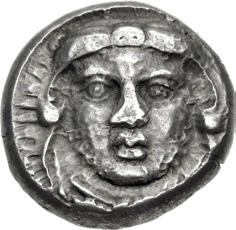


5. ETRURIA, Populonia. Circa 300-250 BC. AR 20 Asses (19.5mm, 8.59 g). Youthful head of Herakles facing, wearing lion skin; [c ≈ (mark of value) flanking neck] / Blank. EC Series 65, 96 (O1) = Vecchi II 75.40 (this coin, obv. illustrated in EC); Vicari 71; Sambon 61; HN Italy 155; SNG ANS 89–90 (same die); SNG BN 36–7 (same die); BMC 3 (same die); Dewing 76 (same die). Old cabinet tone, die wear on obverse, overstruck on uncertain type (undertype visible on reverse). Good VF. ($1500)
Ex Dr. Walter Stoecklin (†1975) Collection (Nomos Obolos 8, 2 December 2017), lot 28, purchased from Bank Leu; M. Ratto FPL III (1949), no. 89.
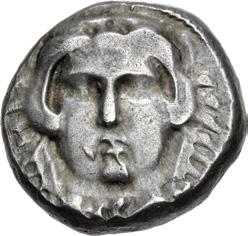


6. ETRURIA, Populonia. Circa 300-250 BC. AR 20 Asses (20mm, 8.37 g). Youthful head of Herakles facing, wearing lion skin; [c ≈ (mark of value) flanking neck] / Club. EC Series 66, 11 (O2/R1 – this coin, illustrated); Vicari 72; Sambon 62; HN Italy 156; SNG BN 38 = SNG Delepierre 106 (same dies); BMC 1 (same dies); Hunterian 3 (same dies); Pozzi 40 (same dies). Old cabinet tone, struck with worn obverse die, off center on reverse. VF. Rare. ($1000)
Ex Künker 295 (25 September 2017), lot 95; Rauch 81 (21 November 2007), lot 24; La Galerie Numismatique 14 (15 May 2010), lot 1; David Herman Collection (Classical Numismatic Group 73, 13 September 2006), lot 10; Artemide Aste (4 September 2003), lot 7.


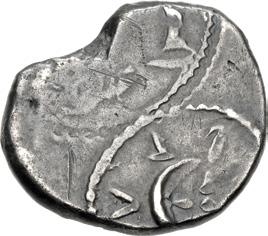
7. ETRURIA, Populonia. Circa 300-250 BC. AR 20 Asses (20mm, 8.39 g). Head of Menrva facing slightly left, wearing triple-crested Attic helmet; [c ≈ (mark of value) flanking neck] / Star with four rays within crescent; [
] (pvplvna in Etruscan) around. EC Series 67, 11 (O1/R1) = Vecchi II 79.4 = P. Petrillo Serafin, “Le serie monetarie de Populonia” in CCISN 5, pl. 18, 55 = Sambon 65.1 = Garrucci pl. 72, 31 = BMC Italy Appendix 1 (publ. 1873; this coin, illustrated in all but Sambon [as a line drawing in BMC]); Vicari 74; HN Italy 158; SNG Lloyd 8 (same dies); Hirsch 15 (same dies); McClean 133 (same dies). Old cabinet tone, a few scratches under tone, double struck on reverse. Good VF. Very rare. ($4000)
Ex David Herman Collection (Triton X, 9 January 2007), lot 21; Hagen Tronnier Collection (Künker 94, 27 September 2004), lot 42; HessLeu 24 (16 April 1964), lot 13; British Museum Collection (deaccessioned).



8. ETRURIA, Populonia. Circa 300-250 BC. AR 10 Asses (19mm, 4.23 g). Laureate head of Aplu left; c (mark of value) behind neck / Blank. EC Series 70, 237 (O3); Vicari 81; Sambon 81; HN Italy 168; SNG BN 45; SNG Copenhagen 39; SNG Fitzwilliam 64; SNG Lloyd 24; SNG Soutzos 19; Berlin 21; BMC 14; Weber 64 (all from the same obv. die). Attractive iridescent tone, minor deposits. Near EF. ($1500)
Ex Künker 216 (8 October 2012), lot 46; Hagen Tronnier Collection (Künker 94, 27 September 2004), lot 44; Kurpfälzische Münzhandlung 9 (11 December 1975), lot 1.


9. ETRURIA, Populonia. 3rd century BC. AR 20 Asses (20.5mm, 7.55 g). Diademed facing head of Metus; [c ≈ (mark of value) below] / Star with six rays; crescent, pellet, and (pvplvna in Etruscan) around. EC Series 38, 2–8 (O2/R3); Vicari 52; Sambon 59; HN Italy 143; SNG Stockholm 45 (same dies). Toned, area of weak strike. VF. Rare. ($1500)
Ex Stack’s Bowers & Ponterio 173 (8 January 2013), lot 27.
EC Plate Coin – Ex Riche Collection – Pedigreed to 1926



10. ETRURIA, Populonia. 3rd century BC. AR 20 Asses (19.5mm, 8.36 g). Diademed facing head of Metus; c/≈ (mark of value) below / Blank. EC Series 47, 138 (O13/R17) = Vecchi II 30.22 and 30.4 (this coin, illustrated in EC); Vicari 46; Sambon 48B; HN Italy 146; Hunt IV 7 (same dies); McClean 130 (same dies). Old collection tone, a few minor deposits, slight die wear. Good VF. ($1500)
Ex Künker 295 (25 September 2017), lot 107; Numismatica Ars Classica 27 (12 May 2004), lot 1; Riche Collection (R. Ratto, 25 January 1926), lot 108.




11. ETRURIA, Populonia. 3rd century BC. AR 20 Asses (20.5mm, 8.37 g). Diademed facing head of Metus; c/≈ (mark of value) below / Two kerykeia, the right inverted. EC Series 48, 1–93 (O14/R18); Vicari 51; Sambon 52; HN Italy 150; SNG ANS 81–2 (same dies); SNG Ashmolean 1 (same dies); SNG Lloyd 4 (same dies); Hunterian 1 (same dies); Kraay & Hirmer 327 (same dies). Old cabinet tone, some die wear, patches of find patina on reverse. Good VF. ($2000)
Ex Burgan (17 November 2017), lot 1.



12. ETRURIA, Populonia. 3rd century BC. AR 5 Asses (13.5mm, 1.37 g). Young male head right; ¨ (mark of value) to left / Blank. EC Series 114, 1 (O1 – this coin, obv. illustrated); otherwise, unpublished. Find patina, light roughness, a few marks on reverse. VF. Unique. ($750)
Ex Herakles Numismatics Electronic Auction (2010), lot 9129.




13. ETRURIA, Populonia. Late 3rd century BC. Æ Sextans (25mm, 13.10 g, 11h). Head of Menrva right, wearing crested Corinthian helmet and single-pendant earring; •• (mark of value) above / Owl standing right, head facing, on •• (mark of value); crescent between two stars to left, (pvplvna in Etruscan) below. EC Series 135, 21 (O4/R7); Vicari 113; Sambon 117; HN Italy 186. Dark green-brown patina, some minor deposits. VF. Rare in this condition, exceptional for type. ($500)
14. ETRURIA, Vetulonia. 3rd century BC. Æ Sextans (26.5mm, 10.19 g, 2h). Head of male right, wearing ketos headdress; •• (mark of value) to left / Ornamental trident; dolphins downward at sides; • • (mark of value) across field. EC Series 14, 16 (O12/R13) = Vecchi V 19.2 (this coin, illustrated); Vicari 164; Sambon 121A; HN Italy 203; SNG BN 58 (same dies). Dark green-brown patina, some weakness to strike. Good VF. Rare, particularly in this condition. ($500)
Ex Marchese Roberto Venturi-Ginori Collection (Santamaria, 24 January 1938), lot 26.




15. ETRURIA, Uncertain inland mint. 3rd century BC. Æ (15mm, 2.77 g, 6h). Head of Herakles right, wearing lion skin / Hound running left; (G in Etruscan) below. Vicari 241; Baglione 2b; Sambon 146b; HN Italy 70; SNG ANS 65–6; SNG Copenhagen 53. Dark green-brown patina, minor smoothing. VF. Well centered. ($500)




16. SAMNIUM, Maleventum (as Beneventum). Circa 265-240 BC. Æ Obol (20mm, 7.03 g, 7h). Head of Apollo left, wearing laurel wreath; ∫E@¨E@-toD around / Horse prancing right; pentagram above, πr-o-πo around. Campana 3; Sambon 193; HN Italy 440; SNG BN 307–8; SNG Lloyd 46; SNG Morcom –; BMC 1; McClean 158. Red-brown and dark green patina, edge splits, slight roughness. VF. ($500)
From the John Morcom Collection. Ex David Freedman Collection (Triton V, 15 January 2002), lot 11.
17. CAMPANIA, Atella. 216-211 BC. Æ (19mm, 4.67 g, 1h). Radiate head of Sol facing; star to left / Elephant advancing right; (aderl in Oscan) below. Giard, Monnaie 4; Sambon 1056; HN Italy 468; SNG BN 408; SNG Morcom –. Green and brown patina. VF. ($750)
From the John Morcom Collection, purchased from David Freedman, 13 February 2001.



18. CAMPANIA, Caiatia. Circa 265-240 BC. Æ (19mm, 6.45 g, 6h). Head of Athena left, wearing crested Corinthian helmet / Cock standing right; star to left, 1Å5Åt5@o to right. Sambon 974; HN Italy 433; SNG BN 409; SNG Morcom –; SNG München 137. Attractive green patina, minor roughness. Good VF. Very rare. ($500)
From the John Morcom Collection. Ex David Freedman Collection (Triton V, 15 January 2002), lot 18.



19. CAMPANIA, Cales. Circa 265-240 BC. AR Nomos (20mm, 7.26 g, 7h). Head of Athena left, wearing triple-crested Corinthian helmet, triple-pendant earring, and necklace; cornucopia behind neck / Nike, wearing long chiton, holding reins in both hands, driving fast biga left; CALeNO in exergue. Sambon 886; HN Italy 434; SNG ANS 170 (same dies); SNG BN 432 (same dies); SNG Lockett 64 (same dies); Dewing 83 (same dies). Attractive even gray tone, with slight iridescence around the devices. Good VF. ($750)
From the Jim Gilman Collection. Ex Pegasi Auctions XXII (20 April 2010), lot 35.


20. CAMPANIA, Capua. 216-214 BC. Æ As (37mm, 37.95 g, 1h). Reduced standard. Janiform male heads wearing laurel wreaths / Jupiter, holding thunderbolt in right hand, scepter in left, in fast quadriga galloping right; (kapu in Oscan) in exergue. Campana, Monete 8; Giard, Monnaie 3; Sambon 1023; HN Italy 496; SNG ANS –; SNG BN 479–80; SNG Morcom –; SNG München 160. Dark green patina, areas of weak strike, some smoothing and light roughness, flan flaw at edge on reverse. VF. Very rare. ($1000)
From the John Morcom Collection. Ex I. Vecchi 2 (12 September 1996), lot 73.


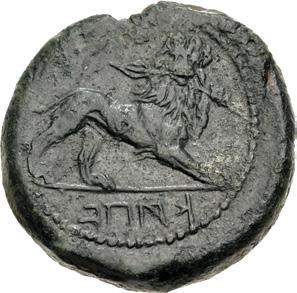
21. CAMPANIA, Capua. 216-214 BC. Æ Binux (24mm, 14.00 g, 10h). Head of Herakles right, wearing tainia, club over left shoulder / Lion standing right, head facing, breaking spear in its jaws; (kapu in Oscan) in exergue. Campana, Monete 12; Giard, Monnaie 7; Sambon 1028; HN Italy 489; SNG ANS 208–9; SNG BN 492–4; SNG Morcom –; SNG München 165. Dark green patina, slight roughness. Good VF. ($750)
From the John Morcom Collection. Ex David Freedman Collection (Triton V, 15 January 2002), lot 23.




22. CAMPANIA, Capua. 216-214 BC. Æ Uncia(?) (17mm, 3.09 g, 11h). Reduced standard. Head of Herakles right, wearing tainia, club over left shoulder / Kerberos standing right; (kapu in Oscan) in exergue. Campana, Monete 19; Giard, Monnaie 14; Sambon 1034; HN Italy 502; SNG ANS 218; SNG BN –; SNG Morcom –; SNG München –. Dark graygreen patina, faint cleaning marks, minor flan flaw on obverse. Good VF. ($500)
From the John Morcom Collection. Ex David Freedman Collection (Triton V, 15 January 2002), lot 28.



23. CALABRIA, Tarentum. Circa 510-500 BC. AR Nomos (23.5mm, 8.13 g, 12h). Taras, nude, riding dolphin right, extending left hand, right hand resting on dolphin’s back; ßʼnÅt to left, scallop shell below, dot-and-cable border around / Incuse of obverse type; [t]ÅrÅß in relief to right, radiate border. Fischer-Bossert Group 1, 12 (V6/R5); Vlasto 69 (same obv. die); HN Italy 826; SNG Lloyd 108 (same obv. die); Kraay & Hirmer 294. Toned, traces of find patina, a few hairlines, minor nick on edge. Good VF. Excellent metal for issue. ($15,000)
From the Columbus Collection. Ex Leu 86 (5 May 2003), lot 199.
The city of Tarentum was founded in the late 8th century BC by Spartan colonists on the north coast of the gulf of the same name, on a rocky islet at the entrance to the only secure harbor. It was Sparta’s only colony and maintained close relations with its mother city. The official founder of the city was believed to be the Spartan leader Phalanthos. Ancient tradition, however, tells how Taras, the son of Poseidon and a local nymph, Satyra, was miraculously saved from a shipwreck by his father, who sent a dolphin on whose back he was carried to shore, at which spot he founded a city.
Blessed with fertile land, Tarentum became famous for olives and sheep. It possessed a fine harbor, great fisheries and profitable exports of wool, purple dye, and pottery. It adopted a democratic form of government circa 475 BC, and thereafter became the leading Greek city in southern Italy. Its success led to continual difficulties with its neighbor cities, though, and on four occasions Tarentum required expeditions from Greece to help overcome its aggressors. The last of these expeditions was led by the famed Epeirote, Pyrrhos. Following his withdrawal from the city, Tarentum was occupied by the Romans.
It was not until late in the 6th century that Tarentum felt the need to produce coinage. It did so by copying the broad, thin fabric with incuse reverse type already in use by Metapontum, Sybaris, Poseidonia, Kaulonia, and Kroton. Tarentum quickly grew in power and wealth. As with many cities that began coinage at the time, the types depicted relate to the city’s foundation, both in its historical and mythological forms. Taras’ prosperity is exemplified by its vast coinage, which was continuous from circa 510 BC until the end of the Second Punic War.



24. CALABRIA, Tarentum. Circa 315 BC. AR Nomos (20mm, 7.86 g, 3h). Nude youth on horse galloping right, holding rein in right hand and extending left hand; sÅ below / Phalanthos, nude, extending right hand and cradling filleted palm frond in left arm, riding dolphin left; to right, crested Corinthian helmet left; sUÂ and [t]ÅrÅs below. Fischer-Bossert Group 67, 806 (V319/R625); Vlasto 652 (same dies); HN Italy 941; SNG Copenhagen 859 (same dies). Underlying luster, minor die wear and small edge bump on obverse. Near EF. Well centered on a broad flan, struck from dies of fine style. ($1000)



25. CALABRIA, Tarentum. Circa 280 BC. AR Nomos (21.5mm, 7.83 g, 5h). Nude youth on horse stepping right, holding rein in right hand and crowning horse with wreath in left; sÅ to left, ÅrE>QW@ in two lines below / Phalanthos, nude, holding tripod in extended right hand, left hand resting on dolphin’s back, riding dolphin left; tÅrÅs to right, 1Ås below. Vlasto 666–7; HN Italy 957; SNG ANS 1046–50; Dewing 168; Gulbenkian 39. Underlying luster, trace deposits, light hairlines. Near EF. Struck on a broad flan. ($750)



26. CALABRIA, Tarentum. Circa 280 BC. AR Nomos (22.5mm, 7.89 g, 12h). Nude youth, shield on left arm, placing right hand on head of horse he rides left; s5 to right, f5¬o˚¬˙s below / Phalanthos, nude, holding wreath in extended right hand, left hand resting on dolphin’s back, riding dolphin left; tÅrÅs to right, ¬U below. Vlasto 688–90; HN Italy 965; SNG ANS 1063; SNG BN 1877–81. Underlying luster, die break on obverse, a little die rust on reverse. EF. Well centered and struck on a broad flan. ($750)



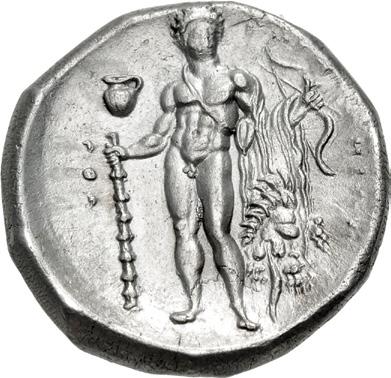
27. LUCANIA, Herakleia. Circa 330/25-281 BC. AR Nomos (21mm, 7.77 g, 7h). Head of Athena right, wearing single-pendant earring, pearl necklace, and crested Corinthian helmet decorated with Skylla hurling a stone in right hand; ^˙rÅ˚¬˙5W@ above, ˚ behind neck / Herakles standing slightly left, head facing, right hand set on grounded club to left, holding bow and two arrows in extended left hand, lion skin draped over left arm; oinochoë and ÅQÅ to left, ^˙[rÅ˚¬]˙5W@ to right. Work 62–3/78 (same obv./rev. dies); Van Keuren 84; HN Italy 1384; NAC 27, lot 29 (same dies). Slightly weak strike, a little die wear on obverse, minor flan flaw on reverse. Good VF. ($1500)
Ex MACM inventory MMoCA10C; Numismatica Ars Classica 52 (7 October 2009), lot 24.
Herakleia, located on the Gulf of Taranto, was one of the last Greek colonies to be established in Italy, with a foundation date of 432 BC. Its foundation arose from the destruction of Siris, an Ionic colony located nearby, circa 550 BC. Athens claimed the right to re-found Siris with its own colonists and is said to have briefly considered relocating Athens itself to the site after its destruction by the Persians in 480 BC. Athens did indeed found Thourioi in 443 BC across the gulf from the site of Siris, but this was resisted by Tarentum and Kroton, which sided with Sparta in the Peloponnesian War and did not want an ally of Athens so close. After a brief war, an agreement was signed whereby Athens and Tarentines would jointly found a new city on the site of Siris. This became Herakleia, named in honor of Herakles. The city’s coinage reflected its bifurcated foundation by honoring Athena (patron of Athens) on the obverse and its namesake Herakles on the reverse.
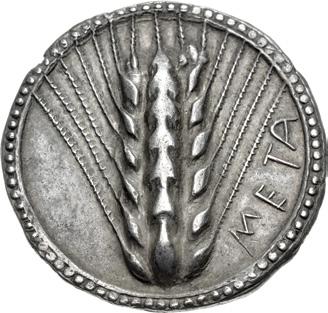


28. LUCANIA, Metapontion. Circa 540-510 BC. AR Nomos (27mm, 8.11 g, 12h). Ear of barley with seven grains; 7etå upward in right field / Incuse ear of barley with seven grains. Noe Class VI, 115 (same dies); Gorini 12; HN Italy 1479; SNG ANS 209 (same dies). Beautiful old cabinet tone. EF. An exceptional example. ($6000)
Ex Nomos 28 (22 May 2023), lot 1121; Abecassis Collection (Leu 81, 16 May 2001), lot 15; Spink Zürich 20 (6 October 1986), lot 39; Kricheldorf FPL 100 (Autumn 1975), no. 5; Leu 2 (25 April 1972), lot 30.
Metapontion, originally named Sybaris, was an Achaian colony of very early foundation, though the precise details of its origin are shrouded in uncertainty. Following the destruction of its first foundation by the Samnites, it was refounded, as Metapontion, early in the 7th century BC by settlers under the leadership of Leukippos, who was thereafter revered as the city founder. The great prosperity of the city — attested by the extent of its archaic silver coinage commencing in the mid 6th century BC — was based on agriculture. Situated on the Gulf of Tarentum, Metapontion occupied a plain of extraordinary fertility watered by the rivers Bradanos and Kasuentos. Its standard coin type is an ear of barley, a tribute to the source of Metapontine wealth, and Demeter, the goddess of grain who is the city’s most revered deity.
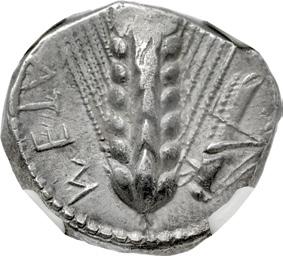


29. LUCANIA, Metapontion. Circa 470-440 BC. AR Nomos (20.5mm, 7.51 g, 12h). Ear of barley with eight grains; åtE7 up left field, grasshopper downward to right / Incuse ear of barley with seven grains. Noe Class XII, 258 (same dies); HN Italy 1486; SNG Copenhagen 1173 (same dies); SNG Lloyd 317 (same dies); BMC 26 (same dies); Bement 162 (same dies); de Luynes 458 (same dies). In NGC encapsulation 5747210-073, graded AU, Strike: 4/5, Surface: 3/5. ($1000)



30. LUCANIA, Metapontion. Circa 400-340 BC. AR Nomos (18mm, 7.63 g, 4h). Obverse die signed by Apol–. Head (of Apollo?) right, wearing laurel wreath, Åπo¬ in tiny letters on truncation of neck, s below / Grain ear [with leaf to right]; ÂEtÅ downward on left. Noe 461c (this coin, illustrated); HN Italy 1534; SNG ANS 349 (same dies); SNG Ashmolean 708 (same dies); SNG Lockett 393 = Bement 173 (same dies); SNG München 969 (same dies); Hunterian 20 (same dies); Jameson 300 (same dies); Pozzi 172 (same dies). Old cabinet tone, trace deposits, slightly off center, a few light scratches on obverse, minor flan flaw at edge on reverse. Good VF. ($750)
From the Henry A. Sauter Collection. Ex Coin Galleries (19 November 1971), lot 12; American Numismatic Society Collection (deaccessioned).
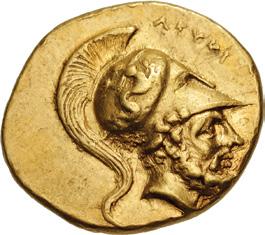


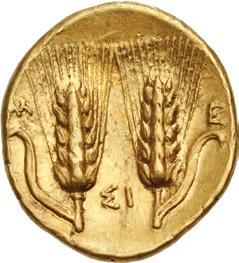
31. LUCANIA, Metapontion. temp. Pyrrhos of Epeiros. Circa 280-279 BC. AV Tetrobol – Third Stater (14.5mm, 2.80 g, 10h). Bearded head of Leukippos right, wearing crested Corinthian helmet decorated with Skylla hurling a stone; ¬EU˚5π[πos] above / Two six-grained barley ears, each with a curly leaf to outside; Â-E across outer fields, s5 between. Johnston G5.1 (same dies); HN Italy 1630; SNG ANS 397–8; SNG Lockett 404 (same rev. die); Basel 153 = Gillet 202 (same obv. die); Dewing 378; Gulbenkian 72; Jameson 1867. Faintly toned, slight die wear on obverse. Good VF. ($4000)
Ex MACM inventory MMoCA16C; Triton XIII (5 January 2010), lot 24.
Demonstrating the usual flair shown by the die engravers in the service of Pyrrhos during his military expedition in Italy and Sicily, the small gold issues of 280/279 depicting Nike and Leukippos (HN Italy 1629-1631) are of a refinement second to none. The traditional city founder is rendered in exquisite detail with the added novelty of his helmet being decorated with Skylla hurling a stone, the very embodiment of aggressive violence before the enemy in time of war.
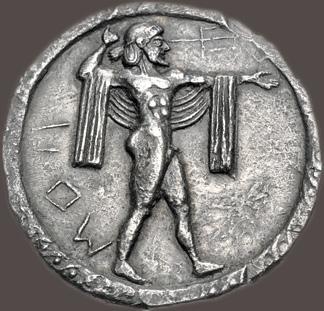





32. LUCANIA, Poseidonia. Circa 530-500 BC. AR Nomos (26.5mm, 7.09 g, 12h). Poseidon, bearded and nude but for chlamys draped over both arms, standing right, preparing to cast trident held aloft in right hand, left arm extended; ÂøP to left / Incuse of obverse type, but trident is in relief; ÂoP to right. Gorini 1 var. (obv. ethnic); HN Italy 1107; SNG ANS 614 (same dies); SNG Lloyd 428; Gillet 207. Deep old collection tone, small scuff at edge on obverse. Near EF. Well centered and struck. ($15,000)
From the Gerald F. Borrmann (Northern California Gentleman) Collection. Ex Freeman & Sear FPL 6 (Summer 2001), no. 11.
From the earliest issue of the coinage at Poseidonia. A Sybarite colony founded circa 600 BC, Poseidonia grew rapidly in the 6th century through the exploitation of its considerable agricultural resources. This was a time of extensive temple construction and, in common with the other Achaian cities of southern Italy, Poseidonia began producing silver coinage of the distinctive ‘incuse’ fabric in the final decades of the century. The fine archaic striding figure brandishing a trident is Poseidon, god of the sea and the patron deity of the city. This particular depiction of him is probably inspired by a colossal statue that stood in one of the city’s temples.
33. LUCANIA, Poseidonia. Circa 530-500 BC. AR Nomos (28mm, 6.86 g, 12h). Poseidon, beardless and nude but for chlamys draped over both arms, standing right, preparing to cast trident held aloft in right hand, left arm extended; Âoπ to left / Incuse of obverse type, but trident is in relief; ÂoP to right. Gorini 3; HN Italy 1107; SNG ANS 604 (same obv. die); SNG Copenhagen 1271; Basel 158; Regling, Antike 239. Faintly toned, small flan flaw on obverse, a few minor chips at edge. Good VF. ($15,000)
From the Columbus Collection, purchased from Harlan J. Berk, 2002.



34. LUCANIA, Poseidonia. Circa 530-500 BC. AR Half Nomos – Drachm (18.5mm, 2.93 g, 12h). Poseidon, beardless and nude but for chlamys draped over both arms, standing right, preparing to cast trident held aloft in right hand, left arm extended; πoÂ-E around; all within double dotted circular border / Incuse of obverse type, but trident is in relief; E-ÂoP around. Gorini 10 (same dies as illustration); HN Italy 1108; SNG ANS 625 (same dies); SNG Lloyd 433 = Jameson 332 (same dies). Lightly toned, traces of find patina, minor marks, a few cleaning scratches at edge on reverse. Good VF. ($1500)
From the Gerald F. Borrmann (Northern California Gentleman) Collection, purchased from Frank Kovacs, December 2000.

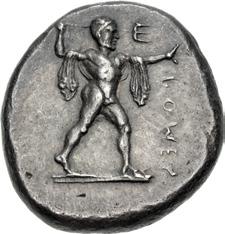


35. LUCANIA, Poseidonia. Circa 445-420 BC. AR Nomos (18mm, 7.97 g, 5h). Poseidon, bearded and nude but for chlamys draped over both arms, standing right, preparing to cast trident held aloft in right hand, left arm extended; ßEÂoP downward to right / Bull standing left; ßEÂoP above; all within circular incuse. HN Italy 1116; SNG Lloyd 436 (same obv. die); SNG München 1058. Deep old cabinet tone, with some iridescence, slight die wear on reverse. Near EF. Lovely style. ($3000)
From the Henry A. Sauter Collection. Ex Massachusetts Historical Society/John Quincy Adams Family Collection (Part I, Stack’s, 5 March 1971), lot 46.



36. LUCANIA, Sybaris. Circa 550-510 BC. AR Nomos (30.5mm, 7.57 g, 12h). Bull standing left, head right; ¨µ in exergue / Incuse bull standing right, head left. S&S Class B, pl. XLVIII, 4–8; Gorini 2; HN Italy 1729; SNG ANS 828–44; SNG Lloyd 449–50; Basel 168–9; Bement 213; Dewing 406–7; Gillet 215. Attractively toned, with slight golden iridescence around the devices, traces of find patina, ragged edge, a hint of granularity, natural void in flan, a couple of nicks in field on obverse. EF. Well centered and struck. ($3000)
From the Gerald F. Borrmann (Northern California Gentleman) Collection, purchased from Spink, March 1998.



37. LUCANIA, Sybaris. Circa 550-510 BC. AR Third Nomos – Drachm (18.5mm, 2.59 g, 12h). Bull standing left, head right; ¨µ in exergue / Incuse bull standing right, head left. S&S Class B, pl. XLVIII, 10–1; Gorini 4; HN Italy 1736; SNG ANS 847–52; SNG Lloyd 452; Bement 259; Berlin 22; Boston MFA 128–9. Deep iridescent tone, minor marks, scratch under tone on obverse. Near EF. ($750)




38. LUCANIA, Thourioi. Circa 400-350 BC. AR Nomos (22mm, 7.78 g, 2h). Head of Athena right, wearing crested Attic helmet with neck guard, the bowl decorated with Skylla holding rudder in right hand and raising left hand to head, scanning / Bull butting right, head facing, on linear ground line; QoUr5W@ above; [in exergue, fish right]. HN Italy 1802; SNG ANS 1005; SNG ANS 991 (same dies); SNG Lloyd 473–4; Morgan 76 (this coin). Old collection tone with some iridescence, slight die wear on obverse. Good VF. ($2000)
Ex Hess-Leu [9] (2 April 1958), lot 22; J. Pierpont Morgan Collection (sold privately; not in H. Schulman or Stack’s sales); Marquis Carlo Strozzi Collection (Sambon/Sangiorgi, 15 April 1907), lot 1098.
In 446 BC, with the aid of Athens, the refugee population of the destroyed city of Sybaris returned to the location of their previous home, and founded a new city, giving it the name Thourioi. The new city quickly regained the prosperity enjoyed by its former incarnation, as evidenced by the extensive series of coins it issued over the following two centuries. Although its perennial rival had been Kroton, the new city grew close to its former enemy, and Tarentum as well. Good relations with the latter were probably responsible for the weakening of Thourioi’s historical connection to Athens as she turned to Sparta during the Peloponnesian War. Although supported by Tarentum, the city suffered at the hands of the Lucanians and Brettians during the 4th century. In need of a more robust ally, the Thourians turned to Rome in 285 BC. Unlike many cities in southern Italy, Thourioi’s support of Rome was steadfast during both the time of Pyrrhos and Hannibal’s invasion, even though the Thourians suffered heavily at the hands of the latter. The coinage of Thourioi was diverse in both its denominations and metals. The primary types were the head of Athena, probably due to the city’s initial close relationship with Athens, and a standing or butting bull, which had been the civic type on the coins of Sybaris.



39. LUCANIA, Thourioi. Circa 400-350 BC. AR Dinomos – Distater (24.5mm, 15.70 g, 1h). Head of Athena right, wearing crested Attic helmet decorated on its bowl with Skylla raising left hand to head, scanning; 5d behind neck guard / Bull butting right on linear ground line; QoUr5W@ above; in exergue, fish right. Noe, Thurian F28 (same dies); HN Italy 1803; SNG Lloyd 486 (same dies); Jameson 359 (same dies); Pozzi 229 (same dies). Lightly toned, area of weak strike. Good VF. ($1000)



40. LUCANIA, Velia. Circa 400-340 BC. AR Nomos (20mm, 7.72 g, 1h). T Group. Head of nymph right, wearing a kekryphale; UE¬˙ to right / Roaring lion standing right on dotted ground line; ¬˙ below. Williams Period IV, 219 (O134/ R168); HN Italy 1278; SNG Ashmolean 1098 (same dies); SNG Copenhagen 1528 (same dies); BMC 20 (same dies); McClean 1407 (same dies); Sartiges 52 (same dies). Lightly toned, a touch of die wear, a few light marks. Good VF. Well centered. ($1500)




41. LUCANIA, Velia. Circa 300-280 BC. AR Nomos (21.5mm, 7.33 g, 1h). Philistion group. Head of Athena right, wearing crested Attic helmet decorated with griffin; d above visor, [f before neck] / Lion standing right; above, pentagram between f and 5; UE¬˙tW@ in exergue. Williams Period VII, 424 (O210/R300); HN Italy 1306; SNG ANS 1367 (same dies); SNG Copenhagen 1580 (same dies); SNG Lockett 566 (same dies); BMC 102 (same dies). Lovely old cabinet tone, some hairlines, small scrape and test cut on edge. Near EF. Perfectly centered. A very attractive coin in hand. ($3000)
Ex G. Hirsch 204 (5 May 1999), lot 98.




42. LUCANIA, Velia. Circa 280 BC. AR Nomos (21mm, 7.55 g, 12h). Lion-and-stag group. Head of Athena left, wearing a crested Attic helmet decorated with a griffin springing left; Å above visor, f before neck, 5E on incuse square behind neck guard / Lion attacking stag left; UE¬˙tW@ above. Williams Period IX, 572 (O284/R399); HN Italy 1318; Davis 21 (same dies); Dewing 473 (same dies); Sartiges 57 (same dies). Toned, with some iridescence, slight die wear on obverse. Near EF. ($1000)



43. BRUTTIUM, Kaulonia. Circa 525-500 BC. AR Nomos (29.5mm, 8.00 g, 12h). Apollo advancing right, holding branch aloft in right hand, left arm extended, upon which a small daimon, holding branch in each hand, runs right; ˚A¨Ò to left; to right, stag standing right, head reverted; dot-and-cable border / Incuse of obverse, but daimon, branch, and stag’s antlers in outline, and no ethnic; radiate border. Noe, Caulonia, Group A, 20 (same dies); Gorini 4; HN Italy 2035; SNG ANS 148 (same dies); Kraay & Hirmer 259–60. Old cabinet tone, with some iridescence around the devices, minor die break on obverse. Good VF. Excellent metal. ($5000)
From the Gerald F. Borrmann (Northern California Gentleman) Collection, purchased from Dr. Arnold R. Saslow, July 1989 (who had acquired the coin from Numismatic Fine Arts, May 1989). Reportedly ex Mossberg Collection (1946).
Kaulonia was founded in the 7th century BC by Achaean Greeks. The location, on the underside of Italy’s “toe,” has long since disappeared beneath the waves, but marine archaeologists have located more than 100 fluted columns, likely for a large shrine to Apollo, the deity depicted on the city’s beautiful coinage. On this exceptional piece, Apollo’s nude body is shown striding right, with a small winged daimon on his left arm; to his right stands a stag, sacred to both Apollo and his sister Artemis. The unusual fabric of this piece follows a style peculiar to Greek southern Italy in the archaic period: a broad, thin flan, obverse depicted in relief, the reverse repeating the obverse motif but incuse, and reversed. The reasons for the popularity of this fabric are poorly understood; some scholars have postulated a connection to the mathematician-philosopher Pythagoras, who was active in Italy during this period.




44. BRUTTIUM, Kaulonia. Circa 475-425 BC. AR Nomos (21mm, 8.16 g, 6h). Apollo advancing right, holding branch aloft in right hand, small daimon running right on extended left arm; ¬`k to left; to right, stag standing right, head reverted / Stag standing right; ¬`k above, laurel branch to right. Noe, Caulonia, Group F, 82 (same dies); HN Italy 2046; SNG ANS 175 (same dies); Ars Classica XVI, lot 315 (same dies). Lightly toned, a few typical edge splits. Near EF. ($2000)




45. BRUTTIUM, Kroton. Circa 500-480 BC. AR Nomos (23.5mm, 6.99 g, 12h). Medium incuse type. Tripod, legs surmounted by wreaths and terminating in lion’s feet, set on basis of three lines, the center dotted; crab to left, orJ to right / Incuse tripod as obverse, but wreaths in relief, and serpents in relief rising from middle foot; octopus to left; to right, outline of dolphin upward. Attianese 35 (same dies as illustration); Gorini 18 (same dies as illustration); HN Italy 2090; SNG ANS 251 (same dies); Hunterian 3 (same dies); Jameson 418 (same dies); Triton XXII, lot 85 (same dies; hammer $30,000). Old collection tone, some find patina, light roughness on reverse. Good VF. Very rare. ($6000)
As with many cities in Magna Graecia, Kroton was established by colonists from mainland Greece. Myskellos, obeying a directive of the oracle of Delphi, led a group of Achaian settlers to the site and founded the city around 710 BC. This divine sanction is represented by the tripod of the oracle, which became the civic badge of Kroton and is featured on its coinage. Kroton was among the first cities to produce coinage in Italy, its earliest being of the incuse type struck on the Achaian standard. As evidenced by its bountiful coinage, Kroton was one of the most important and wealthy cities of southern Italy. Although its fortunes rose and fell over the centuries, it maintained its production of a wide array of denominations and metals until the Roman period.




46. BRUTTIUM, Kroton. Circa 500-480 BC. AR Third Nomos – Drachm (17mm, 2.48 g, 12h). Medium incuse type. Tripod, legs surmounted by wreaths and terminating in lion’s feet, two serpents rising from the bowl; crab to left, orJ to right / Incuse tripod as obverse, but wreaths in relief and no serpents; kithara to left, orJ to right. Attianese –; Gorini –; HN Italy 2089; SNG ANS 301 (same dies). Iridescent tone, minor die wear. VF. Extremely rare third nomos with crab and kithara, this coin is the only example in CoinArchives. ($750)
Ex Classical Numismatic Group 55 (13 September 2000), lot 72.




47. BRUTTIUM, Kroton. Circa 480-430 BC. AR Nomos (19.5mm, 7.94 g, 4h). Tripod, legs terminating in lion’s feet; O®J to left / Incuse eagle flying left, leg in relief. Gorini –; Attianese 56 var. (ethnic to right); HN Italy 2108; SNG ANS 292 (same dies); SNG Lloyd 598; Gillet 290. Lightly toned, slight die wear on obverse. Near EF. Struck with fresh reverse die. ($1500)
From the JTB Collection. Ex Dr. Paul Peter Urone Collection (Nomos 30, 6 November 2023), lot 1047; Classical Numismatic Group 72 (14 June 2006), lot 158.



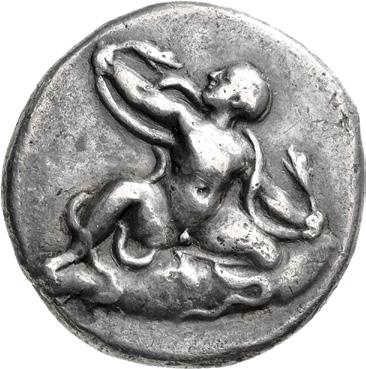
48. BRUTTIUM, Kroton. Circa 400-325 BC. AR Nomos (20mm, 7.55 g, 2h). Head of Apollo right, wearing laurel wreath; ˚rotW@5Å-tÅs around / The Herakliskos Drakonopnigon: the Infant Herakles, nude, crouching facing on rock, head left, strangling a serpent in each hand. Attianese 163; HN Italy 2157; SNG ANS 384; SNG Lloyd 618 (same obv. die); Bement 449 (this coin); Gillet 301 (same obv. die); Gulbenkian 133 (same obv. die); Kraay & Hirmer 271. Beautiful cabinet tone, a few light marks, edge marks. Good VF. ($7500)
From the Columbus Collection. Ex Nomos 9 (20 October 2014), lot 39; Naville X (15 June 1925), lot 141; Clarance S. Bement Collection (Naville VI, 28 January 1923), lot 449; Maxime Collignon Collection (Feuardent Frères, 17 December 1919), lot 62; Maddalena Collection (Sambon & Canessa, 7 May 1903), lot 520.
The figure of Herakliskos Drakonopnigon was depicted in Greek art from the first half of the 5th century BC and represents an important event in the early life of the Greek hero. The birth of Herakles, son of Zeus and Alkmene, enraged Zeus’ wife Hera, who tried to kill the infant by sending two serpents to strangle the sleeping baby in his crib. The following morning, the nurse discovered Herakles playing with the serpents’ lifeless bodies: he had strangled one in each hand.




49. BRUTTIUM, Lokroi Epizephyrioi. Circa 344-318 BC. AV Tenth Stater (10mm, 0.74 g, 7h). Head of eagle left, holding serpent in its beak; o¬ above / Vertical winged thunderbolt. Spinelli Period I, Group II.4, 21 (this coin, illustrated); HN Italy 2346; SNG ANS 498; SNG Copenhagen 1857 (same obv. die); Jameson 447; Pozzi 795 (same dies). Trace deposits, area of weak strike, slight double strike on obverse. Good VF. Rare. ($3000)
From the Gerald F. Borrmann (Northern California Gentleman) Collection. Ex James A. Ferrendelli Collection (Triton VII, 13 January 2004), lot 36; George & Robert Stevenson Collection (Classical Numismatic Group XXVI, 11 June 1993), lot 15; Classical Numismatic Group 28 (8 December 1993), lot 26; Numismatica Ars Classica A (28 February 1991), lot 1161; Münzen und Medaillen AG 68 (15 April 1986), lot 79.
Lokroi Epizephyrioi was founded by Dorian settlers in the eighth or seventh century BC. Its location in southern Italy was ideal for an agricultural center, and the city soon flourished. The nearby city of Rhegion became its chief rival, and the two poleis engaged in warfare on many occasions. In the fifth century, Lokroi sought and gained a powerful ally, Syracuse, who supported them militarily and financially in their efforts against Rhegion. This alliance impacted the development of coinage at Lokroi, who adopted the silver stater standard that was commonly used in the robust trade between Syracuse and Corinth. In the late fifth century, Lokroi reciprocated the support it had received from Syracuse by supporting the latter’s defense against the Athenian Expedition. The close relationship between the two cities continued, and the Syracusan tyrant Dionysios I gave Lokroi the nearby cities of Hipponion and Kaulonia after his forces conquered them in the early fourth century. In 282 BC, however, Lokroi received a Roman garrison, which proved so unpopular that the city quickly allied with Pyrrhos in his campaign against Rome in 280 BC. Following the cessation of hostilities, and Pyrrhos’ subsequent departure from the region, the Romans reestablished control over Lokroi. This new status quo remained until the Second Punic War, when the Lokrians again allied themselves with the enemy of Rome, this time the Carthaginians under their leader, Hannibal. Unfortunately, the Lokrians again chose the losing side, and in 205 BC, the Romans decimated the city, which had served as Hannibal’s final stronghold.




50. BRUTTIUM, Medma. 4th century BC. Æ (15.5mm, 3.35 g, 8h). Head of Persephone right; ÂEs[ÂÅ] to right / Nike advancing right, holding palm frond in both hands. Virzi 359 (this coin); otherwise, unpublished. Green patina, some encrustation on obverse, a little off center on reverse. Good VF. Extremely rare, one of two known, none in CoinArchives. ($750)
From the John Morcom Collection. Ex Numismatica Ars Classica 21 (17 May 2001), lot 35; Thomas Virzi (1881-1974) Collection.




51. BRUTTIUM, Rhegion. Circa 445-435 BC. AR Tetradrachm (26mm, 17.31 g, 1h). Facing lion mask; olive spray to lower right / Iokastos (or Aristaios?) seated left, holding kantharos in right hand, staff in left; ßo-˜51Er‰ around above; to lower right, bird standing right; all within wreath. Herzfelder 56 (D32/R46); HN Italy 2488; SNG Lloyd 681 (same dies); SNG Fitzwilliam 834 (same dies); Pozzi 322 (same dies). Find patina. Good VF. ($4000) Ex Roma XVIII (29 September 2019), lot 496, purchased by the consignor from Baldwin’s, 2003.



52. BRUTTIUM, Rhegion. Circa 420-415/0 BC. AR Tetradrachm (23.5mm, 16.60 g, 8h). Dies by “the Master of the Rhegium Apollo”. Facing lion mask / Head of Apollo right, wearing laurel wreath; olive sprig to left, r˙˝5@o@ to right. Herzfelder 102 (D60/R87); HN Italy 2494; SNG ANS 657–9; SNG Lloyd 698 (same dies); BMC 25 (same dies); Sartiges 74 (same dies). Toned, light roughness, smoothing on reverse. Good VF. ($5000)
This tetradrachm is from a series at Rhegion that is regarded as having the most finely engraved dies of all the numismatic output of the mint. The earliest phase features dies signed by the artist Kratesippos, but the later unsigned dies, such as were used here, are regarded as the pinnacle of numismatic art from this period at Rhegion. Herzfelder called the engraver of these dies “the Master of the Rhegium Apollo.” While the style of Apollo on these dies was conventionally considered to have been influenced by the “Master of the Leaf” of the slightly earlier issues of Katane, R. R. Holloway suggests that there was actually a common prototype for both issues, which served as a model for coinages as far away as the Chalkidian League. This high period of artistry at Rhegion coincides with the famed issues of the “signing artists” of Sicily and was only brought to a conclusion with the sack of the city by Dionysios I of Syracuse in 386 BC.



53. BRUTTIUM, Terina. Circa 420-400 BC. AR Nomos (20mm, 8.04 g, 3h). Head of the nymph Terina right, hair in sphendone; [tiny π behind neck], tEr5@Å5W@ to right / Nike seated left on plinth, holding out right hand upon which a small bird alights, left hand resting on plinth. Regling, Terina 65 (dies EE/δδδ); Holloway & Jenkins 62 (same obv. die as illustration); HN Italy 2617; SNG ANS 840 (same obv. die); SNG Lloyd 752 (same dies); Hunterian 16 (same obv. die); Kraay & Hirmer 277 (same obv. die). Old collection tone, with slight iridescence, minor die wear on obverse, light graffiti in field on reverse. Good VF. ($5000)
From the Gerald F. Borrmann (Northern California Gentleman) Collection, purchased from Dr. Arnold R. Saslow, October 1987.
The high artistry evident on Terina’s coinage seems out of all proportion to any historical accounts for this city atop the “toe” of Italy, which so thoroughly disappeared from record that no systematic excavations were undertaken on its site until 1997. Its coinage has been known and collected since the Renaissance, where the delicate beauty of its female heads and the graceful seated Nikes were greatly admired. As author R. R. Holloway noted, “the nymphs of Terina recalled the maidens of the Parthenon frieze and the Victories of the reverses were the numismatic counterparts of the Victories of the Nike Temple balustrade.”


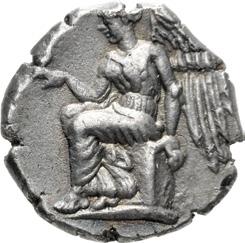
54. BRUTTIUM, Terina. Circa 400-380 BC. AR Nomos (19mm, 7.73 g, 1h). Contemporary imitation. Head of the nymph Terina right, hair in sphendone ornamented with maeander pattern; tiny π behind neck, tE-[...]@[...] around from bottom left / Nike seated left on plinth, holding out right hand [upon which a small bird alights], left hand resting on plinth. Regling, Terina 96; F. Carelli, Nummorum veterum Italiae (1912), pl. 178, 21. Deep old iridescent tone, slightly compact flan. Near EF. Lovely style. Extremely rare, only one example published (in Vienna), none in CoinArchives. ($7500)
Ex Leu 48 (10 May 1989), lot 34; Hess-Leu 45 (12 May 1970), lot 35 (there noting the coin is from a hoard discovered in 1927).
Regling placed this issue among a group of coins he considered to be imitations, and notes the dies appear to have been copied from his dies CC/ γγγ–εεε. Holloway & Jenkins appear to accept Regling’s classification of these coins, and omit them from their survey of the coinage of Terina.




55. BRUTTIUM, Carthaginian occupation. Circa 215-205 BC. AR Half Shekel (21mm, 3.81 g, 6h). Wreathed head of Tanit-Demeter left / Horse standing right; palm tree in background, tiny ˝ above. Jenkins, Some, pl. C, L1; Robinson, Second, p. 52, 1; HN Italy 2019. Light iridescent toning over lustrous surfaces, minor die wear. EF. Well struck on a broad flan. ($3000)
Ex Tradart (16 November 1995), lot 126.



56. SICILY, Agyrion. Circa 420-405 BC. Æ Hemilitron (18.5mm, 6.18 g, 6h). Head of young male (river god Chrysas?) right; Å˝Ur5@Å5o-@ around / Forepart of Acheloös Palagkaios as man-headed bull right; πÅ¬Å˝˚Å5os above. Campana 3; CNS 6/2 (same dies as illustration); MSP 7 (same dies as illustration); HGC 2, 56; SNG ANS (Pt. 5) 1303; SNG Morcom –; Rizzo pl. LIX, 10; Virzi 725 (same dies). Attractive green patina. Good VF. Rare. ($750)
From the John Morcom Collection. Ex Numismatica Ars Classica 21 (17 May 2001), lot 48.




57. SICILY, Akragas. Circa 465/0–445/0 BC. AR Tetradrachm (27.5mm, 17.19 g, 6h). Sea eagle standing left; Å˚RÅ1sotNÅ around / Crab within shallow incuse circle. Westermark, Coinage, Period II, Group III, 338.8 (O8/R28) = Prospero 119 = Gillet 346 (this coin); HGC 2, 77; SNG ANS 970 (same dies). Lightly toned, slight die wear on obverse. Superb EF. Well centered and struck on a broad flan. Excellent detail. ($15,000)
From the Georges Albert Haikel Collection. Ex Prospero Collection (The New York Sale XXVII, 4 January 2012), lot 119; Leu 30 (28 April 1982), lot 22; Charles Gillet (†1972) Collection.
Akragas, Roman Agrigentum, was situated close to the southern coastline of Sicily midway between Gela and Selinos. Founded by colonists from Gela circa 580 BC, Akragas grew to become the second most important city on the island after Syracuse, deriving much of its wealth from the export of agricultural produce to Carthage, which lay about 200 miles to the west. Its coinage commenced in the closing years of the 6th century and principally consisted of silver didrachms down to about 440 BC, after which the tetradrachm became the principal denomination. The first series of tetradrachms, though, coincided with the last period of didrachms, with all featuring the same types that had persisted since the beginning of the city’s coinage: on the obverse, an eagle, sacred to Olympian Zeus, to whom the city dedicated an immense temple, and a reverse with an overhead view of a crab, harvested from the sea as a delicacy in the region. After 440 BC, as with many of the coinages of the great Sicilian cities, the designs became more complex and artistic, with one or two eagles shown devouring a hare on the obverse, and a galloping quadriga ultimately replacing the crab on the reverse. In the final decade of the 5th century, as the artistry of its coinage reached its zenith, Akragas suffered the same fate as many of the other Greek cities of Sicily when it was stormed and sacked by the invading Carthaginians (406 BC). Though its coinage continued thereafter, the scale and beauty of its 5th century series were never attained again.




58. SICILY, Akragas. Circa 415-406 BC. AV 2 Litrai – Tetradrachm (10mm, 1.35 g, 2h). Eagle standing left, snake clasped in its talons, on rock outcropping; Å˚rÅ above, two pellets (mark of value) on rocks / Crab; below, s5¬Å/so˜ in two lines (boustrophedon). Westermark, Coinage 1011.15 (O11/R3 – this coin); HGC 2, 75; SNG Copenhagen 52 (same dies); SNG Lloyd 518 = Weber 1195 (same dies); BMC 2 (same dies); Boston MFA 237 (same dies); Dewing 570–1 (same dies); de Luynes 844 (same dies); McClean 2039 (same dies). Slightly off center on reverse. Near EF. ($5000)
From the Gerald F. Borrmann (Northern California Gentleman) Collection, purchased from Classical Numismatic Group, November 1990. Ex Numismatic Fine Arts [XXIV] (18 October 1990), lot 470; Hess-Leu 31 (6 December 1966), lot 96; Santamaria (6 April 1908), lot 136.


59. SICILY, Akragas. Circa 415-406 BC. Æ Hemilitron (32mm, 20.52 g, 6h). Eagle, wings spread and head raised, standing right on serpent / Crab; six pellets (mark of value) in upper fields; below, crawfish left; all within incuse circle. Westermark, Coinage, Series 4, 701.6 (this coin, illustrated); CNS 29 (this coin illustrated); HGC 2, 138; SNG Morcom –; Hunterian 49 (same dies); Virzi 597 (this coin). Attractive forest green patina, some faint cleaning marks. VF. Very rare, only nine examples noted by Westermark. ($1000)
From the John Morcom Collection. Ex Numismatica Ars Classica 64 (17 May 2012), lot 658; Münzen und Medaillen GmbH 17 (4 October 2005), lot 159; Kricheldorf 32 (14 November 1977), lot 362; Thomas Virzi Collection (Leu 6, 8 May 1973), lot 62; Ars Classica XVII (3 October 1934), lot 129.
A Masterpiece of Greek Coinage – Ex Gillet, Spencer-Churchill, Woodward, and Durulfé Collections – Pedigreed to 1910





60. SICILY, Akragas. Circa 410-406 BC. AR Tetradrachm (26mm, 17.43 g, 12h). Silanos, magistrate. Nike, wearing long chiton, holding kentron in extended right hand, reins in left, driving fast quadriga left; above, Å˚rÅ˝>Řt5˜-o[˜] in two lines on tablet (partially retrograde, last two letters outside tablet); in exergue, club left / Two eagles standing right on dead hare below, the closest eagle with wings closed and head raised, the further eagle with wings spread and head lowered; s5¬Å-@os along left edge. Westermark, Coinage, Period III, 595.1 (O7/R11) = Seltman, Engravers 16c (dies J/o) = Gillet 356 = SNG Spencer 30 = Seltman, Greek, pl. 26, 11 = Woodward 50 = Giesecke pl. 6, 5 (this coin); HGC 2, 86; SNG ANS 1000 (same dies); Berlin 582 (same dies); SNG Fitzwilliam 917 (same dies); Dewing 565 (same dies); Gulbenkian 170 (same dies); McClean 2041 (same dies); Rizzo pl. III, 3 (same dies). Wonderful old collection tone, slight doubling on obverse. Good VF. ($30,000)
From the Gerald F. Borrmann (Northern California Gentleman) Collection. Ex Christie’s (30 November 1990), lot 31; Charles Gillet (†1972) Collection; Capt. C. E. Spencer-Churchill Collection (Ars Classica XVI, 3 July 1933), lot 432; W. H. Woodward Collection; Ars Classica XV (2 July 1930), lot 271; Egger XLV (12 November 1913), lot 234; Gustave Durulfé Collection (Rollin & Feuardent, 9 May 1910), lot 120.
The late coinage of Akragas, struck in the years just before the Carthaginian capture of the city in 406 BC, was the most magnificent in the city’s history. It included the famous dekadrachm, gold pieces, and a variety of quadriga/two eagles tetradrachms that are all of superb quality. Seltman suggested that some of the finest engravers in Sicily made the dies for these coin, ascribing the obverse of this piece to Kimon, while the reverse is signed by the master Silanos. The symbols most associated with the coinage of Akragas are the eagle and the crab. Sometime after 420 BC, the Akragantines replaced the single eagle with a pair of eagles standing on a hare, the inspiration for which must have come from the Agamemnon of Aeschylus where men saw two eagles, representing Agamemnon and Menelaos, feasting upon a pregnant hare. It has always been believed that the city’s dekadrachms were issued to celebrate the victory of Exainetos, an Akragantine, at the Olympic Games in 412 BC. It seems more likely, however, that they were part of the war preparations of Akragas against their enemy Carthage shortly before 406 BC. This tetradrachm is every bit the equal of the dekadrachm in terms of development of the traditional Akragantine themes and fineness of their representation.




61. SICILY, Gela. Circa 480/75-475/70 BC. AR Drachm (16mm, 4.25 g, 1h). Horseman, nude, holding javelin in right hand and placing left hand on horse’s head, riding right; linear and dotted ground lines below / Forepart of man-headed bull running right; 1E¬o5o@ above; all within incuse circle. Jenkins, Gela, Group IId, 188 (O51/R109); HGC 2, 368; Basel 283 (same dies); Jameson 577 (same dies); de Luynes 949 (same dies). Attractive iridescent tone, some porosity and minor marks, a touch off center. Good VF. Very rare. ($2000)
From the collection of Major Anthony F. Milavic, USMC (Ret.). Ex G. Hirsch 173 (19 February 1992), lot 76; Numismatica Ars Classica 4 (27 February 1991), lot 38.


62. SICILY, Kamarina. Circa 425-405 BC. AR Tetradrachm (26mm, 16.58 g, 9h). Athena, wearing long chiton, holding reins in both hands, driving galloping quadriga left; above, Nike flying right, presenting to Athena an open wreath held in both hands; in exergue, heron flying left / Bearded head of Herakles left, wearing lion skin; [no5-Ån]5rÅÂÅ˚ to left. Westermark & Jenkins 138 (O32/R8 – this coin); HGC 2, 520 (same dies as illustration); SNG Lloyd 864–5 (same dies); BMC 9 (same dies); Gulbenkian 172 (same dies); Hirsch 326 (same dies); Hunterian 3 (same dies); McClean 2153 (same dies); Rizzo pl. V, 8 (same obv. die). Toned, some horn silver, cleaning scratches, some delaminations on reverse. VF. ($3000)
From the Gerald F. Borrmann (Northern California Gentleman) Collection, purchased from Baldwin’s, 9 December 2011.


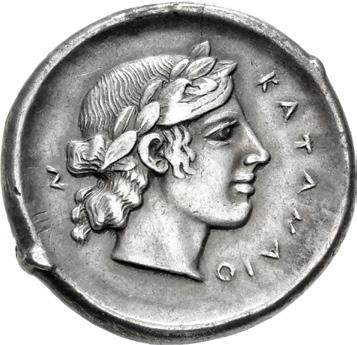
63. SICILY, Katane. Circa 450-445 BC. AR Tetradrachm (30mm, 17.03 g, 2h). Charioteer, wearing long chiton, holding kentron in right hand and reins in both, driving slow quadriga right / Head of Apollo right, wearing laurel wreath; ˚ÅtŘÅ5o-˜ around. Mirone 30–2; HGC 2, 566; SNG ANS 1241 (same obv. die); SNG Spencer 37 (same dies); Basel 326 (same rev. die); Rizzo pl. X, 11 (same obv. die). Old collection tone, hairline flan crack, minor flan flaw on obverse. Near EF. Well centered and struck from artistic dies on a broad flan. ($15,000)
From the Columbus Collection. Ex Numismatica Genevensis SA VII (27 November 2012), lot 144; Leu 77 (11 May 2000), lot 83.
The Sicilian city of Katane (modern Catania) was a Chalkidian colony founded from Naxos in 729 BC. Katane was located midway along the eastern coast of the island at the southern extremity of the slopes of Mount Aetna. Its fertile territory was coveted by neighboring Syracuse, and in 476 BC the Syracusan tyrant Hieron I removed the population of Katane to the inland city of Leontini. Katane was then given the name of Aetna and resettled with Syracusan citizens and a group of Dorian mercenaries. On the fall of the Sicilian tyrannies in the late 460s BC, the alien population was expelled and the former inhabitants of Katane returned from exile in Leontini to reclaim their city, which now reverted to its original name. It seems unlikely that any coinage was produced at Katane prior to the events of 476 BC, so any issues bearing the name of the Katanians must postdate the restoration of the original population in 461 BC.
Published by Campana, Jenkins, Burnett, Consolo Langher, and Gabrici


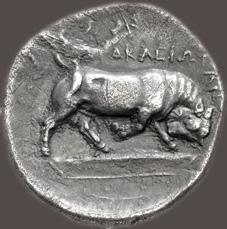

64. SICILY, Kephaloidion. Circa 307-305 BC. AR Drachm (18mm, 3.97 g, 11h). Head of Herakles right, wearing lion skin; E˚ ˚EfŬo5d5-[o@] to right and below / Bull butting right on tablet; Ò and [˙r]Å˚¬E5WtÅ@ above. Campana, Kephaloidion 1 (this coin referenced and illustrated); Jenkins, Coinages, p. 97, 1 = Basel 345 = CNS I p. 245 = Burnett, Enna 97 = S. Consolo Langher, “Gli HPAΚΛΕΙΩΤΑΝ
in Kokalos 7 (1961), 166 = E. Gabrici, “Alla ricerca della Solunto di Tucidide” in Kokalos 5 (1959), 21 (this coin); Triton XVI, lot 214 = Gemini IV, lot 33 = Leu 38, lot 23 = HGC 2, 641 ill. (same dies). Toned, some porosity, light deposits, scratches under tone, die break on reverse. Good VF. Extremely rare, one of only two known. ($10,000)
From the Michael Rogal Collection. Ex Triton XVII (7 January 2014), lot 42; A. D. Moretti Collection (Numismatica Ars Classica 13, 8 October 1998), lot 345.



65. SICILY, Leontini. Circa 476-466 BC. AR Tetradrachm (26mm, 16.88 g, 9h). Charioteer, wearing long chiton, holding kentron in right hand and reins in left, driving slow quadriga right; above, Nike flying right, crowning horses with open wreath held in both hands / Head of roaring lion right; ˜o˜5-t-˜-o[-E-¬] and four barley grains around. Maltese Period I, 17k (D4/R15) = Hermitage Sale I 56 (this coin); Boehringer, Münzgeschichte 2 (same obv. die); HGC 2, 661 (same obv. die as illustration); Dewing 619 (same dies); Gillet 436 (same obv. die); Rizzo pl. XXII, 4 (same obv. die). Old cabinet tone, a little verdigris, minor die wear on obverse. Near EF. ($4000)
From the Gerald F. Borrmann (Northern California Gentleman) Collection. Ex Peus 294 (15 March 1978), lot 146; Hermitage Museum Collection (Schlessinger 11, 26 February 1934), lot 56.



66. SICILY, Leontini. Circa 450-440 BC. AR Tetradrachm (24.5mm, 17.37 g, 10h). Head of Apollo right, wearing laurel wreath / Head of roaring lion right; 6-Eo-˜t-5-˜o-[˜] and four barley grains around. Maltese Period III, 55d (D18/ R47 – this coin); Boehringer, Münzgeschichte 35 (same obv. die); HGC 2, 667; SNG Ashmolean 1782 (same dies); Dewing 625 (same dies); Rizzo pl. XXIII, 5 (same obv. die). Toned, trace deposits, a little die wear. Near EF. ($5000)
From the Gerald F. Borrmann (Northern California Gentleman) Collection. Ex Patrick H. C. Tan Collection (Gemini VII, 9 January 2011), lot 121.
Leontini was founded in 729 BC by settlers from Naxos, the first Greek colony in Sicily, which itself had been established just a few years earlier. In the first decade of the 5th century the city was captured by the tyrant Hippocrates of Gela whose successor, Gelon, transferred his seat of government to Syracuse in 485. Thereafter, Leontini usually remained within the Syracusan sphere of influence, though its 5th century coinage was on a considerable scale attesting the independent wealth of the community. A major political change took place in the late 460s — the expulsion of the tyrants and the restoration of democracy. This was reflected on the Leontine coinage by the introduction of new types featuring the head of Apollo on obverse and a lion’s head on reverse. Apollo was especially revered at Leontini, as he was at the mother city of Naxos where there was a famous sanctuary of Apollo Archegetes. The lion apparently represents a punning allusion to the city name. The surrounding barley-grains are indicative of the exceptional fertility of the Leontine territory and doubtless refer to the local worship of Demeter, the goddess of agriculture.



67. SICILY, Leontini. Circa 450-440 BC. AR Tetradrachm (25mm, 17.04 g, 5h). Head of Apollo right, wearing laurel wreath / Head of roaring lion right; 6Eo-˜-t-5-˜o-˜ and four barley grains around. Maltese Period III, 105 (D27/ R81); Boehringer, Münzgeschichte 46 (same dies); HGC 2, 667; SNG ANS 245 (same dies); SNG Lockett 798 (same dies); Gulbenkian 218 (same dies); Rizzo pl. XXIII, 7 (same dies). In NGC encapsulation 6290602-009, graded XF★, Strike: 5/5, Surface: 5/5, Fine Style. ($4000)
Ex Mark & Lottie Salton Collection (Stack’s Bowers Galleries, 14 January 2022), lot 4119.
Collection


68. SICILY, Leontini. Circa 425-415 BC. AR Tetradrachm (28.5mm, 17.22 g, 1h). Head of Apollo left, wearing laurel wreath / Head of roaring lion left; olive branch to upper right, 6Eo˜t5-˜-o˜ and four barley grains around. Maltese Period IV, 152b (D39/R115) = Gillet 446 (this coin); Boehringer, Münzgeschichte 56 var. (lion right, no olive branch; same obv. die); HGC 2, 673 var. (symbol); SNG Ashmolean 1794 (same dies); SNG Lloyd 1061 (same dies); SNG München 557 (same dies); Ognina 109 (same dies); Rizzo pl. XXIV, 6 (same dies). Lightly toned, some porosity. Good VF. Fine style. Rare issue with branch. ($2000)
Ex Peus 349 (30 October 1996), lot 45; Charles Gillet (†1972) Collection.

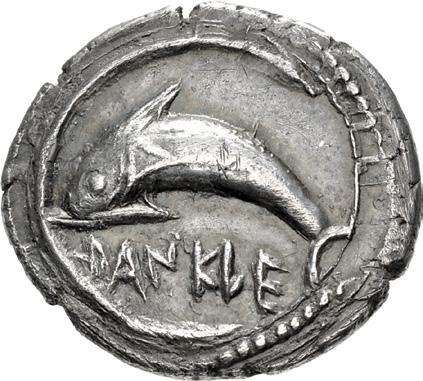

69. SICILY, Messana (as Zankle). Circa 500-493 BC. AR Drachm (23.5mm, 5.64 g). Dolphin left; Îånk63 below; all within sickle-shaped harbor / Nine-part incuse square with scallop shell in center. Gielow Group 4, 40 (same obv. die); HGC 2, 766; SNG ANS 302; SNG Lloyd 1076; Basel 359; Boston MFA 285; Kraay & Hirmer 49; Rizzo pl. XXV, 4-5. Lovely old collection tone, a few tiny deposits, some cleaning marks under tone. EF. Great metal and strike. ($7500)
From the Columbus Collection. Ex Friend of a Scholar Collection (Triton XIX, 5 January 2016), lot 40, purchased from Maison Platt, June 1987.
The colony of Zankle was founded by Cumaean and Euboean settlers in the eighth century BC on the straits of Messina. Its name, meaning “sickle”, was taken from its important sickle-shaped harbor. The colony prospered and even founded its own colonies at Mylae and Himera. Zankle was soon overshadowed by Rhegion, though, whose tyrant, Anaxilas, seized the colony around 488 BC and renamed the city Messana, after Peloponnesian Messenia, whose colonists he settled in Zankle.



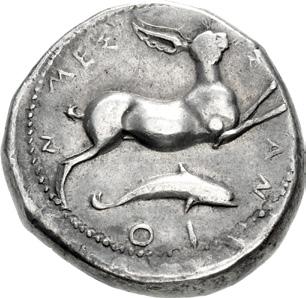
70. SICILY, Messana (as Zankle). Circa 500-493 BC. AR Drachm (21mm, 5.19 g). Dolphin left; Îånk63 below; all within sickle-shaped harbor / Nine-part incuse square with scallop shell in center. Gielow Group 4, 62 (same obv. die); HGC 2, 766; SNG ANS 302; SNG Lloyd 1076; Basel 359; Boston MFA 285; Kraay & Hirmer 49; Rizzo pl. XXV, 4–5. Iridescent tone, traces of find patina, edge split, granular surfaces. VF. ($3000)
From the JTB Collection. Ex Gorny & Mosch 297B (10 October 2023), lot 1213.
71. SICILY, Messana. 420-413 BC. AR Tetradrachm (25.5mm, 17.22 g, 11h). The nymph Messana, wearing long chiton, holding kentron in left hand and reins in both, driving slow biga of mules left; µEssŘ-[Å] above and to right, two dolphins confronted in exergue / Hare springing right; below, dolphin right; µEs-s-Ř-5o-˜ around. Caltabiano Series XIV, 514 (D205’/R213); HGC 2, 791; SNG ANS 366 (same dies); SNG Fitzwilliam 1076 (same dies); Rizzo pl. XXVI, 8 var. (rev. type; same obv. die). Toned, minor marks, a few light scratches on edge. VF. ($1500)
From the Henry A. Sauter Collection.




72. SICILY, Messana. 420-413 BC. AR Tetradrachm (25mm, 17.11 g, 6h). The nymph Messana, wearing long chiton, holding kentron in right hand and reins in both, driving slow biga of mules right; µEss-Å@Å above and before / Hare springing right; below, dolphin right; µEss-Å-˜5-o-˜ around. Caltabiano Series XIV, 518 (D206/R215); HGC 2, 792; SNG ANS 356 (same obv. die); SNG Copenhagen 399 (same obv. die); SNG Lloyd 1097 (same obv. die); McClean 2394 (same dies). Light golden toning, underlying luster, minor edge split. Near EF. Well centered. A wonderful coin in hand. ($7500)








73. SICILY, Segesta. Circa 405/2-400 BC. AR Tetradrachm (28mm, 17.40 g, 3h). The hero Egestes, nude, standing right, cap slung over shoulder and chlamys over left arm, resting left foot on rock; E˝EstÅ5W@ to left; below, two hounds standing right at his feet, one sniffing the ground; small ithyphallic herm to lower right / Head of the nymph Segesta right, hair bound in ampyx and a star embroidered sakkos, wearing triple-pendant earring and necklace with pendants; [sE˝EstÅ$5]Å to right, grain ear below. Hurter, Didrachmenprägung T8 (V4/R7); Lederer 6; HGC 2, 1108 (same dies as illustration); BMC 32 = Kraay & Hirmer 203 (same dies); Hirsch 523 (same dies); McClean 2555 (same dies); Regling, Kunstwerk 567 (same obv. die); Rizzo pl. LXII, 14 (same dies). Lightly toned, slight die shift and a little die wear on obverse, light scratch on reverse. VF. Wonderful style. Rare. ($20,000)
Segesta was the principal city of the Elymi in north-west Sicily. The Segestans wrote their Elymian language in Greek characters, as witnessed by their coins. They developed a traditional hostility with Selinos, in the pursuit of which they allied themselves with Athens in 418/7 BC (Thuc. 6. 6-8 and 46). In 409, Segesta passed into the Carthaginian sphere of influence in another attempt to combat the encroachments of Selinos. Carthage captured and sacked Selinos in that same year.
Although the most common denomination at Segesta was the didrachm, a few very rare and extremely accomplished tetradrachms were minted in about 400 with a remarkably detailed representation of a young huntsman. S. Hurter has maintained the traditional identification of this young man as Egestes, the legendary founder of the city, son of the Trojan maiden Segesta by the river-god Krimsos. Other plausible identifications are the hunter Krimsos or Pan, god of the hunt.
74. SICILY, Segesta. Circa 405/2-400 BC. AR Tetradrachm (27mm, 16.62 g, 4h). The hero Egestes, nude, standing right, cap slung over shoulder and chlamys over left arm, resting left foot on rock; E˝Es[tÅ5]W@ to left; below, two hounds standing right at his feet, one sniffing the ground; small ithyphallic herm to lower right / Head of the nymph Segesta right, hair bound in sakkos embroidered with stars. Hurter, Didrachmenprägung T9k (V4/R8) = Basel 403 (this coin); Lederer 7; HGC 2, 1108; SNG ANS 646 (same dies); SNG Lloyd 1198 (same dies); Dewing 674 (same dies); Gulbenkian 241 = BMC 31 (same dies); Hunt IV 84 (same dies); Jameson 709 (same dies); de Luynes 1120 (same dies); Rizzo pl. LXII, 15 (same dies). Attractively toned, trace deposits, faint scratches, small area of weak strike, a little off center on reverse. VF. Rare. ($7500)
Ex Peus 382 (26 April 2005), lot 73; A. D. Moretti Collection (Numismatica Ars Classica 13, 8 October 1998), lot 403.






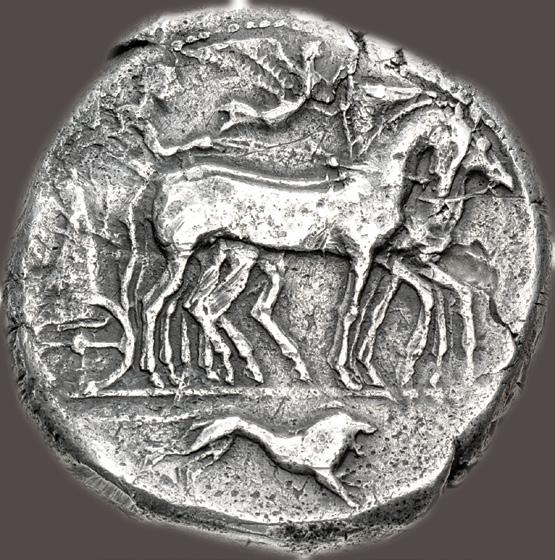






The magnificent artistic flowering in Sicily in the 5th century BC, exemplified by the matchless coinage of Syracuse, originated in times of great strife. When the first colonists from Greece arrived on the fertile island in the 8th century BC, they found competitors in both the aboriginal inhabitants, the Sicels, Sicani, and Elymi, and the Phoenician colonists who established Carthage at about the same time. The social stresses set up by these conflicts prepared the way for the establishment of various tyrannies. Hippokrates of Gela was the first of the well known tyrants, and his son Gelon founded the greatest of the Sicilian courts at Syracuse in 485 BC. By the middle of the century, the situation began to resemble that of Renaissance Italy, where the princes engaged in continual warfare between themselves, while engaging the services of the finest artists and craftsmen of their time. Such fighting required significant amounts of money to hire mercenaries, and the increasing cultural sophistication of the courts encouraged experimentation in all of the arts, including the minor ones – the result was the patronizing of some of the most talented coin engravers in history.
In Syracuse and surrounding cities, the anonymous “Damareteion Master” and the “Maestro della foglia” were followed by their students and successors who proudly signed their work, such artists as Choirion, Euainetos, Eumenos, Exakestidas, Herakleidas, and others. These masters developed new ways of viewing the world through art, breaking the static forms of Classic art and developing new methods of portraying motion and life in miniature. The silver tetradrachm was the prefered mode of expression, being large enough for the expression of freeranging talents and also being minted in vast quantities to finance the expensive operations of the Greek hegemons. Even more remarkable were the large silver dekadrachms of Syracuse, which have become universal symbols of Greek numismatic art. Despite the emphasis on the great masterpieces, even the smallest of the silver fractions received the attentions of the masters, and the infrequent issues of gold likewise.
Syracuse commenced its silver coinage at the end of the sixth century BC with an issue of tetradrachms on the Attic standard of about 17.2 grams. These coins are attributed to the Gamoroi, an oligarchic body of aristocrats who battled outsiders, and each other, for control of civic and financial affairs. The obverse features a charioteer driving a walking quadriga while the reverse originally bore an incuse square divided into four compartments, which quickly gave way to the design seen below on lot 75, a swastika-pattern incuse with a circle at its center bearing a female head to left. This is certainly the nymph Arethousa, sacred to the spring of Ortygia which provided Syracuse its pure water. These designs set the paradigm for a century of Syracusan coinage, although the head of Arethousa would soon outgrow the confines of the small incuse circle to occupy most of the reverse, surrounded by frolicking dolphins.




75. SICILY, Syracuse. The Gamoroi. Circa 500-490/86 BC. AR Tetradrachm (25mm, 16.57 g, 6h). Charioteer, holding reins in both hands, driving slow quadriga right; ߨRÅJo>ß5o˜ in two lines above / Head of Arethousa left in incuse circle in center of quadripartite incuse square. Boehringer Series I, 13 (V9/R7); HGC 2, 1301; SNG ANS 3 (same obv. die); Bement 443 (same dies); Hunterian 2 (same dies); Gillet 523 (same obv. die); Kraay & Hirmer 72 (same obv. die); Rizzo pl. XXXIV, 4 (same dies). Old collection tone, a few scrapes and scratches under tone on reverse. Good VF. ($7500)
From the Gerald F. Borrmann (Northern California Gentleman) Collection, purchased from Frank Kovacs, 1 November 1991.



76. SICILY, Syracuse. Gelon I. 485-478 BC. AR Tetradrachm (25.5mm, 17.46 g, 6h). Struck circa 480 BC. Charioteer, wearing long chiton, holding kentron in right hand and reins in both, driving slow quadriga right; above, Nike, wearing long chiton, walking right, holding wreath in right hand and placing left hand on rearmost horse’s head / Head of Arethousa left, wearing pearl tainia and linear and pearl necklaces; four dolphins and s¨-‰A-˚o-s5o˜ around. Boehringer Series IV, 48 (V27/R31); HGC 2, 1305; SNG München 922 (same dies); Jameson 1905 (same dies); Nanteuil 320 (same dies); Rizzo pl. XXXIV, 14 (same dies). Lightly toned, a little die rust on obverse. Near EF. Well centered and struck on a broad flan. Lovely archaic style. ($7500)
From the Columbus Collection. Ex Triton VI (14 January 2003), lot 105.
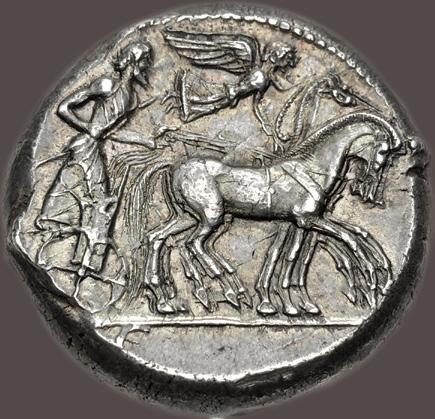

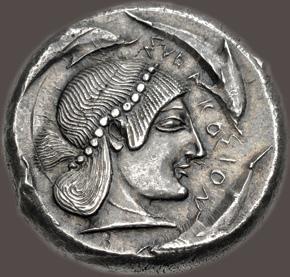

77. SICILY, Syracuse. Hieron I. 478-466 BC. AR Tetradrachm (23mm, 17.48 g, 7h). Struck circa 478-475 BC.
Charioteer, wearing long chiton, holding kentron in right hand, reins in left, driving quadriga right; above, Nike, wearing long chiton, flying right, crowning horses with open wreath held in both hands / Head of Arethousa right, wearing pearl tainia and necklace; s¨R-Akos5o˜ and four dolphins around. Boehringer Series VIIIb, 172 (V75/R120); HGC 2, 1306; Randazzo 339–41 (same dies). Beautiful old cabinet tone, with light iridescence, minor flan flaw on reverse. EF. ($10,000)
Ex Rockefeller University / Dr. Alfred E. Mirsky Collection (Gemini VII, 9 January 2011), lot 153; Ars Classica XVI (3 July 1933), lot 669; Ars Classica XV (2 July 1930), lot 327.



78. SICILY, Syracuse. Hieron I. 478-466 BC. AR Tetradrachm (25mm, 17.43 g, 3h). Struck circa 475-470 BC. Charioteer, wearing long chiton, holding kentron in right hand, reins in both, driving slow quadriga right; above, Nike, wearing long chiton, flying right, crowning horses with open wreath held in both hands / Head of Arethousa right, wearing pearl tainia and necklace; four dolphins and s¬R-a˚o-s5o˜ around. Boehringer Series XIId, 348 (V171/R244); HGC 2, 1306; SNG ANS 112. Pleasing old collection tone. In NGC encapsulation 6631349-001, graded AU★, Strike: 5/5, Surface: 4/5, die shift. ($10,000)
Ex Armand Trampitsch Collection (Vinchon, 13 November 1986), lot 90.
‘Damareteion’ Dekadrachm Ex Brand, Garrucci, and Prowe Collections – Pedigreed to 1912



79. SICILY, Syracuse. Hieron I. 478-466 BC. AR Dekadrachm (33mm, 43.07 g, 8h). ‘Damareteion’ series. Struck circa 470-466 BC. Charioteer, wearing long chiton, holding kentron in right hand and reins in both, driving slow quadriga right; above, Nike, wearing long chiton, flying right, crowning horses with open wreath held in her extended hands; in exergue, lion advancing right / Head of Arethousa right, wearing laurel wreath, hoop earring with single pendant, and pearl necklace, enclosed within linear circle; s¨-‰Å˚-[o]s5o-˜ and four dolphins swimming clockwise around. Boehringer Series XIIe, 378.3 (V193/R267); HGC 2, 1297 (same dies as illustration); Hirsch 577 (same dies); Hunt I 64 (same dies). Toned, die break and chisel cuts on reverse, minor cuts and bumps on edge. Near VF. Very rare. ($20,000)
From the Gerald F. Borrmann (Northern California Gentleman) Collection, purchased from Dr. Arnold Saslow, August 1986. Ex Virgil M. Brand Collection (Part 3, Sotheby’s Zurich, 9 June 1983), lot 30; Raffaele Garrucci Collection (J. Hirsch XXXIV, 5 May 1914), lot 186; Theodor Prowe Collection (Part III, Egger XL, 2 May 1912), lot 414.
The story of the Damareteion coinage has its source in a passage in Diodorus (XI 26.3), that relates to the events following the defeat of the Carthaginians by the Syracusans after the battle of Himera in 479 BC. In the wake of their defeat, the Carthaginians expected harsh treatment by their foes, but Gelon, tyrant of Syracuse, imposed quite favorable terms upon them, supposedly at the behest of his wife, Damarete. In response, the Carthaginians are said to have presented Damarete with a crown of gold valued (or weighing) at a hundred talents, and from this gift was struck a coin, called the Damareteion, that weighed ten drachms on the Attic standard. The identification of the coin in question was one of the great mysteries of numismatics, due to the apparent contradictions in the story: the crown was said to be of gold, but the weight of the coin struck from it was given in Attic drachms, which implied a silver, not gold, coin. We know the metal of the coin must have been silver, as Syracuse apparently had no gold until many years after the event. Among the silver coinage, however, there is a suitable candidate that is known to have been struck relative to the time frame of the battle of Himera: the dekadrachms of Quadriga/Arethusa type. The appearance of these impressive coins was unprecedented at the time, and their style of such superior quality, that it is certain that they commemorated a particular, special event. Thus, these dekadrachms came to be known as the ‘Damareteion’ coinage, and their engraver labelled the ‘Damareteion Master.’ These dekadrachms were accompanied by a series of tetradrachms that featured the exact same iconography and style and are regarded as masterpieces themselves, only on a smaller scale.
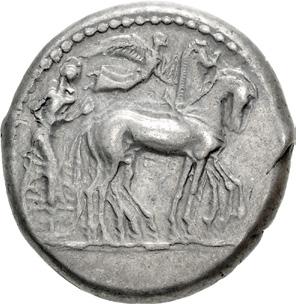


80. SICILY, Syracuse. Hieron I. 478-466 BC. AR Tetradrachm (24.5mm, 17.30 g, 4h). ‘Damareteion’ series. Struck circa 470-466 BC. Charioteer, wearing long chiton, holding kentron in right hand, reins in both, driving slow quadriga right; above, Nike, wearing long chiton, flying right, crowning horses with open wreath held in both hands / Head of Arethousa right, wearing pearl tainia, single-pendant earring, and linear necklace; four dolphins and s¬-‰Å-˚os5-o˜ around. Boehringer Series XIIe, 387 var. (V–/R275 [unlisted obv. die]); HGC 2, 1308 corr. (Boehringer 387, 388, and 391E of standard style); Du Chastel 64 (same rev. die); Gulbenkian 256 = Jameson 755 (same rev. die); Rizzo pl. XXXV, 9 (same rev. die); Auctiones AG 24, lot 76 (same dies); NAC 126, lot 38 (same rev. die [hammer CHF 85,000]) = Gemini VII, lot 157 (same rev. die [hammer $60,000]). Toned, a few light marks, minor doubling on obverse. VF. An important issue in the evolution of Syracuse tetradrachms. Extremely rare, one of only seven coins known from this reverse die, four of which are in public collections. ($10,000)
From the Jonathan K. Kern Collection, with proceeds being donated to charity.
This fascinating issue represents a landmark in the series of Syracuse tetradrachms. With the advent of the Damaretion coinage, the master engraver introduced a new style that progressed the art of the coins forward, from the static archaized style that had dominated the coinage into a more realistic classical form that was beginning to appear in coinage throughout Sicily and beyond. Although the present issue lacks the salient features of the core Damaretion coinage, the lion in the exergue on the obverse and a laureate head of Arethousa enclosed in a linear circle on the reverse, the die links that Boehringer identified in his corpus clearly links it to the end of the famed series. The obverse and reverse here reflect a return to the standard types that had been used since the early 5th century, but the style is clearly that which had been introduced by the Damaretion master, which is most notable in the presentation of Arethousa. Her static features have been replaced with a serene countenance, with a profile eye prominently displaying her pupil, and her hair flows in a natural, fluid form. This new presentation of Arethousa persisted in the coinage beyond the Damaretion series, and soon other engravers began to experiment with their own interpretations of her form, culminating in the famed period of the “signing artists,” whose work exemplified the pinnacle of classical art. In sum, this issue is the first presentation of the standard Syracuse tetradrachm type in classical style.




81. SICILY, Syracuse. Second Democracy. 466-405 BC. AR Tetradrachm (26.5mm, 17.32 g, 12h). Struck circa 466460 BC. Charioteer, wearing long chiton, driving slow quadriga right, holding kentron in right hand, reins in both; above, Nike, wearing long chiton, flying right, crowning horses with open wreath held in her extended hands; in exergue, ketos right / Head of Arethousa right, wearing pearl tainia, single-pendant earring, and necklace; s¨-[∞]-Åk-o-s5-o-@ and four dolphins around. Boehringer Series XIIIa, 408 (V211/R288); HGC 2, 1309; SNG ANS 128 (same dies); Bement 1050 (same dies); Hunterian 20 (same dies). Iridescent tone, die break on reverse. EF. Well centered on a broad flan. ($10,000)
Ex Roma XVI (26 September 2018), lot 148; Roma XIII (23 March 2017), lot 94; Ambrose Collection (Roma X, 27 September 2015), lot 199; Roma IV (30 September 2012), lot 80; Triton XV (3 January 2012), lot 1069.


82. SICILY, Syracuse. Second Democracy. 466-405 BC. AR Tetradrachm (26.5mm, 16.75 g, 11h). Struck circa 460-450 BC. Charioteer, wearing long chiton, driving slow quadriga right, holding kentron in right hand, reins in both; above, Nike, wearing long chiton, flying right, crowning horses with open wreath held in her extended hands; in exergue, ketos right / Head of Arethousa right, wearing pearl tainia, single-pendant earring, and necklace; s-U-‰Åkos-5-o˜ and four dolphins around. Boehringer Series XIVa, 470 (V253/R338); HGC 2, 1311; SNG ANS 144 (same dies); Jameson 761 (same dies); de Luynes 1172 (same dies); Pozzi 574 (same dies). In NGC encapsulation 4165633-002, graded XF, Strike: 4/5, Surface: 3/5. ($3000)



83. SICILY, Syracuse. Second Democracy. 466-405 BC. AR Tetradrachm (25mm, 17.32 g, 6h). Struck circa 466-460 BC. Charioteer, wearing long chiton, driving slow quadriga right, holding kentron in right hand, reins in both; above, Nike, wearing long chiton, flying right, crowning horses with open wreath held in her extended hands; in exergue, ketos right / Head of Arethousa right, wearing pearl tainia, single-pendant earring, and pearl necklace; sU‰Åkos5-o-˜ and four dolphins around. Boehringer Series XIVa, 481 (V256/R345); HGC 2, 1311; SNG ANS 149 (same dies); SNG Lloyd 1314 (same obv. die); SNG München 1012 (same dies); BMC 72 (same dies). Underlying luster, obverse struck a little softly. EF. ($5000)
Ex Classical Numismatic Group 97 (17 September 2014), lot 40; Nomos 6 (8 May 2012), lot 21; W.B. and R.E. Montgomery Collection (Triton XI, 8 January 2008), lot 57.



84. SICILY, Syracuse. Second Democracy. 466-405 BC. AR Tetradrachm (26mm, 17.26 g, 10h). Struck circa 460-450 BC. Charioteer, wearing long chiton, driving slow quadriga right, holding kentron in right hand, reins in both; above, Nike, wearing long chiton, flying left, crowning charioteer with open wreath held in her extended hands; in exergue, ketos right / Head of Arethousa right, hair rolled in thin tainia, wearing single-pendant earring and pearl necklace; s¨∞Å˚os5o˜ to right, four dolphins around. Boehringer Series XIVb, 498 (V263/R353); HGC 2, 1312 (this coin illustrated); SNG ANS 158 (same obv. die); BMC 87 (same dies); de Luynes 1177 (same dies); Prospero 498 (this coin). Beautiful old collection tone, with some blue iridescence around the devices, minor marks, scrapes and marks around edge. Good VF. ($5000)
Ex Roma IX (22 March 2015), lot 116; Prospero Collection (New York Sale XXVII, 4 January 2012), lot 498; Lanz 46 (28 November 1988), lot 67.



85. SICILY, Syracuse. Second Democracy. 466-405 BC. AR Tetradrachm (26mm, 17.42 g, 7h). Struck circa 440-430 BC. Charioteer, wearing long chiton, holding kentron in right hand and reins in both, driving fast quadriga left; above, Nike, wearing long chiton, flying right, crowning charioteer with open wreath held in her extended hands; in exergue, ketos left / Head of Arethousa right, hair tied back, wearing small hook earring and pearl necklace; sUrÅ˚os5o˜ to right, four dolphins around. Boehringer Series XVIII, 600 (V295/R407); HGC 2, 1315; SNG ANS 197 (same dies); Basel 444 (same obv. die); Dewing 815 (same obv. die); Gillet 579 (same obv. die); Jameson 774 (same dies). Lightly toned, minor die wear, a little off center, area of weak strike and thin die break on reverse. Good VF. ($1500)
Ex Trausnitz Collection (Nomos Obolos 18, 21 February 2021), lot 91; Nomos 19 (17 November 2019), lot 53; Schweizerische Bankverein 41 (10 September 1997), lot 16, purchased by the consignor from Münzhandlung Athena.
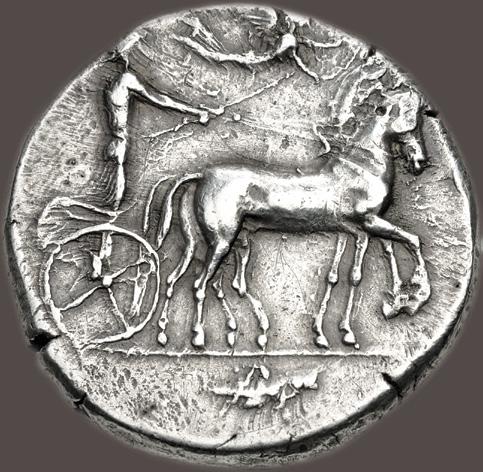



86. SICILY, Syracuse. Second Democracy. 466-405 BC. AR Tetradrachm (27mm, 17.70 g, 10h). Struck circa 420-415 BC. Charioteer, wearing long chiton, holding kentron in right hand and reins in both, driving slow quadriga right; above, Nike, wearing long chiton, flying right, crowning horses with open wreath held in her extended hands; in exergue, grasshopper right / Head of Arethousa right, hair in ornate sakkos and wearing ampyx with maeander pattern; sUrÅ˚os5-o@ and four dolphins swimming clockwise around. Boehringer Series XXV, 726 (V358/R494); HGC 2, 1324 (same dies as illustration); BMC 124 (same dies); Gillet 599 = Kunstfreund 112 = Wallenbrock fig. 2.12 (this coin); Jameson 782 (same dies); de Luynes 1188 (same dies); Pozzi 589 (same dies); Rizzo pl XL, 16 (same dies). Attractive light tone around the devices, slightly off center, minor cleaning marks and a little die wear on obverse. Near EF. ($20,000)
Ex M. L. Collection of Coins of Magna Graecia and Sicily (Numismatica Ars Classica 82, 20 May 2015), lot 60; Charles Gillet (‘Kunstfreund’) Collection (Leu & Münzen und Medaillen AG, 28 May 1974), lot 112.

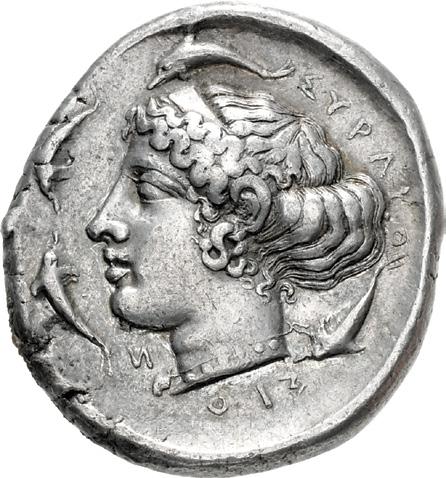

87. SICILY, Syracuse. Second Democracy. 466-405 BC. AR Tetradrachm (29mm, 17.27 g, 9h). Unsigned dies in the style of Sosion. Struck circa 415-409 BC. Charioteer, wearing long chiton, holding reins in both hands, driving fast quadriga left; above, Nike, wearing long chiton, flying right, crowning charioteer with open wreath held in her extended hands / Head of Arethousa left, wearing ampyx, earring, and pearl necklace; four dolphins and sUrÅ˚o-s5o-@ around. Fischer-Bossert, Coins 1 (V1/R1); Tudeer 1; HGC 2, 1326; SNG ANS 253 (same dies); SNG Lloyd 1362 (same dies); Boston MFA 398 = Warren 383 (same dies); Gillet 602 (same dies); Jameson 789A (same dies); de Luynes 1197–8 (same dies); McClean 2703 (same dies); Morgan 147 (same dies); Pozzi 600–1 (same dies). Lightly toned, slight doubling on obverse. Good VF. Struck on a broad flan. ($10,000)
From the Gerald F. Borrmann (Northern California Gentleman) Collection, purchased from Freeman & Sear, May 2010.



88. SICILY, Syracuse. Second Democracy. 466-405 BC. AR Tetradrachm (25.5mm, 17.10 g, 11h). Obverse die signed by Euainetos, reverse by Eu[kleidas]. Struck circa 415-409 BC. Charioteer, wearing long chiton, holding kentron in right hand and reins in both, driving fast quadriga right; above, Nike, wearing long chiton, flying left, crowning charioteer with open wreath held in her extended hands; EUÅ5@Eto in tiny letters on exergue line (only a trace visible), wheel in exergue / Head of Arethousa left, wearing earring and necklace; E¨ below, four dolphins around. Fischer-Bossert, Coins 36p (O12/ R19) = Tudeer 36i = SNG ANS 265 (this coin); HGC 2, 1330; SNG Lockett 964 (same dies); BMC 151 (same dies); Hirsch 600 (same dies); McClean 2710 (same dies); Morgan 146 (same dies); Weber 1598 (same dies). Toned, flan flaws on obverse. VF. ($2000)
Ex American Numismatic Society Duplicates (Gemini VI, 10 January 2010), lot 357 (ANS inv. 1944.100.55776); Edward T. Newell Collection; Celestino Cavedoni Collection (R. Ratto, 27 April 1911), lot 191; R. Hobart-Smith Collection (Sotheby, Wilkinson & Hodge, 20 April 1909), lot 52.

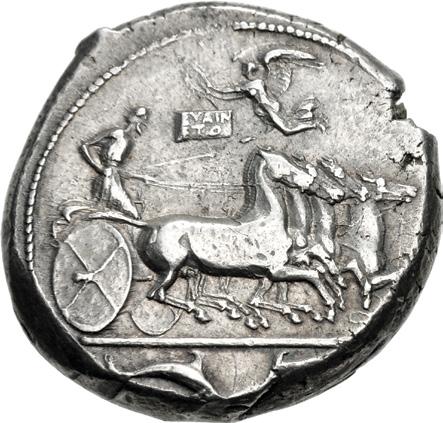

89. SICILY, Syracuse. Second Democracy. 466-405 BC. AR Tetradrachm (24mm, 17.37 g, 8h). Obverse die signed by Euainetos, reverse die signed by Eumenes. Struck circa 415-409 BC. Charioteer, wearing long chiton, holding kentron in right hand and reins in both, driving fast quadriga right; above, Nike, wearing long chiton, flying left, holding wreath in both hands, from which hangs a tablet inscribed E¨Å5@>Eto in two lines; two dolphins confronted in exergue / Head of Arethousa left, wearing hoop earring and necklace; [E¨]Â˙@o¨ below, sUrÅ-˚os5W@ and four dolphins around. Fischer-Bossert, Coins 43 (O14/R25); Tudeer 43; HGC 2, 1332; SNG ANS 270 (same dies); SNG Lloyd 1380 (same dies); SNG Lockett 967 = Pozzi 599 (same dies); BMC 148-9 (same dies); Boston MFA 408 = Warren 375 (same dies); Dewing 845 (same dies); Jameson 2428 (same dies); de Luynes 1204 (same dies); Ward 279 (same dies). Lightly toned, minor edge split. VF. ($5000)
Ex Triton XVII (7 January 2014), lot 69; Gemini VI (10 January 2010), lot 40.




90. SICILY, Syracuse. Second Democracy. 466-405 BC. AR Tetradrachm (25.5mm, 17.21 g, 1h). Dies signed by Euth– and Eum(enes). Struck circa 415-409 BC. Winged Eros as charioteer, wearing long chiton, holding reins in both hands, driving fast quadriga right; above, Nike, wearing long chiton, flying left, crowning charioteer with laurel wreath held in her extended right hand; in exergue, dolphin swimming right behind Skylla, holding trident in extended right hand, swimming right, E¨Q before / Head of Arethousa left, wearing wreath of grain ears and linear necklace with lion head pendant; E¨Â below, four dolphins and s¨rÅ˚o-s5W@ around. Fischer-Bossert, Coins 46 (V15/R28); Tudeer 47; HGC 2, 1334; SNG ANS 273 (same dies); SNG Lloyd 1381 (same dies); SNG Lockett 968 (same dies); SNG München 1058 (same dies); BMC 153 (same dies); Basel 460 (same dies); Gulbenkian 279 = Bement 498 (same dies); Gillet 621 (same dies); Hirsch 602 (same dies); Jameson 796 (same dies); de Luynes 1212 (same dies); McClean 2714 (same dies); Rizzo pl. XLIV, 6 = de Luynes 1213 (same dies). In NGC encapsulation 4241982-006, graded AU★, Strike: 5/5, Surface: 4/5, Fine Style. Well centered and struck from dies of fine style. ($30,000)
Ex Penn Collection (Heritage 3089, 20 January 2021), lot 31010; Phoenix Art Museum Collection (Triton II, 1 December 1998), lot 243; Orme Lewis Sr. Collection.
In the last two decades of the 5th century BC Syracuse was the focus of an unparalleled experiment in Greek numismatics. Its economy was fueled by the vast amount of currency required to pay the mercenaries by which the city’s hegemony expanded, and the high denomination silver coins struck at this time became canvases for the most brilliant engravers of antiquity. Two of these master engravers, Euth(ymos?) and Eumenes, signed the obverse and reverse dies of this spectacular tetradrachm during the waning years of the Second Democracy (466405 BC). The innovations in artistic style are numerous and provocative. On the obverse, the chariot is driven not by a human driver but by a winged male figure wearing a long chiton, sometimes described as Nike but more probably Eros, while Nike swoops down from above to crown him. The horses rear and strain at the reins, their forehooves pawing at the air, each horse in a slightly different pose. Below, in the exergue, is an astonishing creature: the monster Skylla, blending the upper torso of a woman with the tail of a sea serpent, hitherto unseen on a coin of Syracuse. On the reverse, the pert head of Arethousa wears her hair in a tight arrangement of plaits coiled at the top of the head, and woven through with grain ears (some specialists speculate the head represents Persephone rather than Arethousa). Both sides of this rare issue are unlike anything that had come before in the extensive Syracusan series and pointed the way toward the genre-defining work of Kimon and Euainetos in the following decades.




91. SICILY, Syracuse. Second Democracy. 466-405 BC. AV 10 Litrai – Didrachm (10mm, 0.68 g, 6h). Struck circa 406 BC. Head of Athena left, wearing crested Attic helmet; År[Us] to left / Aegis with facing gorgoneion in center. Boehringer, Münzprägungen, pl. 1, 5 (Dionysios I); HGC 2, 1290; SNG ANS 317 (same dies); SNG Copenhagen 687 (same dies); SNG Lloyd 1418; SNG Lockett 983 (same dies); Dewing 863 (same rev. die); Rizzo pl. XLVIII, 6 (same dies). Trace deposits, a little die rust, minor marks at edge, some doubling on obverse. Good VF. ($3000)
From the Ramrodivs Collection. Ex Barry Murphy inventory 21673 (August 2013).
92. SICILY, Syracuse. Dionysios I. 405-367 BC. AR Dekadrachm (36mm, 41.97 g, 9h). Reverse die signed by Euainetos. Struck circa 405-390 BC. Charioteer, wearing long chiton, holding kentron in extended right hand and reins in left, driving fast quadriga left; above, Nike, wearing long chiton, flying right, crowning charioteer with wreath held in her extended hands; below heavy exergual line, [military harness], shield, greaves, cuirass, and crested Attic helmet, all connected by a horizontal spear; [ÅQ]¬Å below / Head of Arethousa left, wearing wreath of grain ears, triple-pendant earring, and pearl necklace; sU-rÅ-k-o-s5W@ behind hair, four dolphins swimming around, EU-Å5@E along lower edge. Gallatin dies R.III/C. II; Scavino 12 (D4/R9); HGC 2, 1299; SNG ANS 363 = Pozzi 615 (same dies); SNG Copenhagen 689 (same dies); SNG Fitzwilliam 1274 (same dies); SNG Manchester 471 (same dies); Boston MFA 421 = Warren 366 = Rizzo pl. LIV, 8 (same dies); Dewing 877 (same dies); de Luynes 1248 (same dies); Nantueil 361 bis (same dies). Old cabinet tone, a little roughness, some porosity, light scratches under tone, minor chipping on edge. Near EF. Clear signature of Euainetos. ($30,000)
From the Gerald F. Borrmann (Northern California Gentleman) Collection, purchased from Margaret Amstell, 18 December 1981.
93. SICILY, Syracuse. Dionysios I. 405-367 BC. AR Dekadrachm (34.5mm, 42.91 g, 12h). Reverse die signed by Euainetos. Struck circa 405-390 BC. Charioteer, wearing long chiton, holding kentron in extended right hand and reins in left, driving fast quadriga left; above, Nike, wearing long chiton, flying right, crowning charioteer with wreath held in her extended hands; below heavy exergual line, [military harness], shield, greaves, cuirass, and crested Attic helmet, all connected by a horizontal spear; [Å]Q¬Å below / Head of Arethousa left, wearing wreath of grain ears, triple-pendant earring, and pearl necklace; sU-rÅ-ko-s5W[@] behind hair, four dolphins swimming around, EU-Å5@E along lower edge. Gallatin dies R.IV/C.XII; Scavino 11; HGC 2, 1299; SNG ANS 366 = Ward 295 (same dies); Dewing 884 (same dies); de Luynes 1250 (same dies); Gillet 658 (this coin). Magnificent deep old cabinet tone, with golden hues around the devices, small die break on obverse. EF. Boldly struck, well centered, and lacking the usual die rust. One of the finest specimens of this iconic issue. ($100,000)
Ex Leu 50 (25 April 1990), lot 69; Charles Gillet (†1972) Collection, 658. Likely from the 1890 Santa Maria di Licodia Hoard (IGCH 2123).
The dekadrachms of Syracuse are widely and properly considered to rank among the most beautiful coins ever produced, but seldom do we encounter a surviving example that is as deeply struck, attractively toned and well-preserved as this specimen. Even more importantly, very seldom in the present day market can a dekadrachm be traced to the very spot and time it was rediscovered after spending more than two millennia in the ground. Such is the case with this spectacular Euainetos dekadrachm, which was part of a remarkable find on Sicily at Santa Maria di Licodia on the slopes of Mount Etna in 1890. Consisting of at least 81 coins, the trove contained no less than 67 Syracusan dekadrachms of the Kimon and Euainetos type. No less an archeologist than the renowned Sir Arthur Evans wrote an account of the treasure’s finding in the 1891 edition of Numismatic Chronicle (pp. 213–7). His marvelous account is worth quoting at length: “In January of last year [1890] a peasant digging in his plot of land at Santa Maria di Licodia, a small town that lies on the Westernmost spurs of Etna, found a pot containing over eighty silver coins, no less than sixty-seven of which were Syracusan dekadrachms or pentekontalitra. According to the account given to me, the deposit lay beneath a layer of lava. The coins were at once taken into Catania, where I saw them a few days afterwards, and was fortunate enough not only to be able to take down a summary record of the contents, but secure at least temporary possession of some of the most interesting specimens. A portion of the coins, perhaps owing to the action of the lava, had suffered considerably ... There were, however, among them about a score of ‘medallions’ in really brilliant condition....” The coins were quickly dispersed, many via Spink & Sons, which sold them via auction and private treaty into several notable collections, including those of John Ward, who later bequeathed them to J. P. Morgan and, through him, to the Metropolitan Museum of Art; Arthur S. Dewing, whose collection now resides at Harvard; Calouste Gulbenkian, which is now housed at the Gulbenkian Museum in Lisbon, Portugal. Due to the circumstances of the burial of the hoard, the coins all have a distinctive appearance, similar to that of the Boscoreale Roman aurei. Although no full inventory of the find was produced, the present coin has this distinctive appearance, and therefore likely is from the hoard.
94. SICILY, Syracuse. Dionysios I. 405-367 BC. AR Dekadrachm (34.5mm, 43.24 g, 5h). Unsigned dies in the style of Euainetos. Struck circa 405-390 BC. Charioteer, wearing long chiton, holding kentron in extended right hand and reins in left, driving fast quadriga left; above, Nike, wearing long chiton, flying right, crowning charioteer with wreath held in her extended hands; below heavy exergual line, [military harness], shield, greaves, cuirass, and crested Attic helmet, all connected by a horizontal spear; [ÅQ¬Å below] / Head of Arethousa left, wearing wreath of grain ears, triple-pendant earring, and pearl necklace; sU-r-Å-k-os5W@ behind hair, pellet below chin, four dolphins swimming around. Gallatin dies R.XXII/J.V; Scavino 63 (D19/R34); HGC 2, 1299; SNG Lloyd 1414 (same rev. die); Morgan 164 (same dies); Prospero 181 (this coin); Rizzo pl. LIII, 18 (same dies). Deeply toned, trace deposits. Near EF. Exceptional for issue. ($50,000)
From the Georges Albert Haikel Collection. Ex Prospero Collection (New York Sale XXVII, 4 January 2012), lot 181; Foreign Amateur Collection (Glendining, 13 December 1963), lot 159.
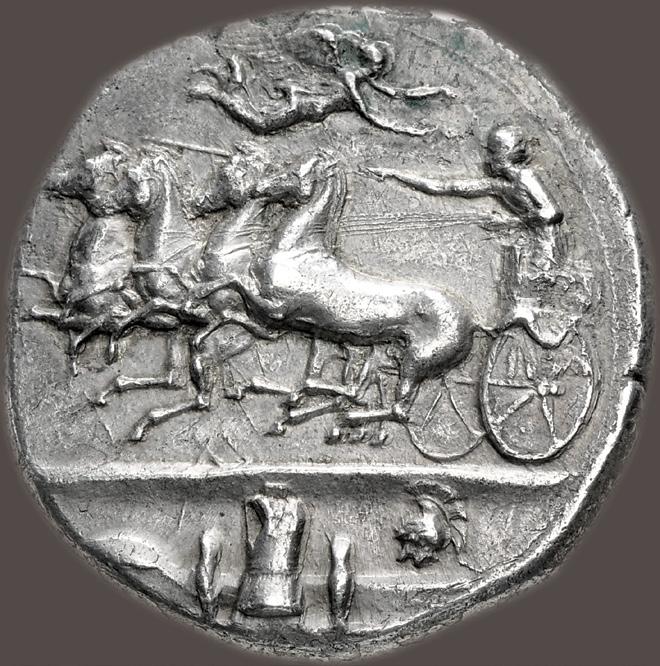








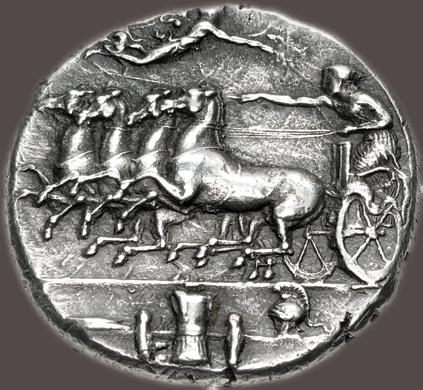






95. SICILY, Syracuse. Dionysios I. 405-367 BC. AR Tetradrachm (26mm, 17.30 g, 9h). Unsigned dies in the style of Eukleidas. Struck circa 400/395-390 BC. Charioteer, wearing long chiton, holding kentron in right hand and reins in both, driving fast quadriga left; above, Nike, wearing long chiton, flying right, crowning charioteer with wreath held in her extended hands; in exergue, dolphin left / Head of Arethousa left, hair in broad band and welling upwards in wavy locks, wearing double hoop earring and linear necklace; [s-¨-r]Å-˚os5W-[@] and four dolphins around. Fischer-Bossert, Coins 89 (V33/R61) = SNG Lockett 978 (this coin); Tudeer 89; HGC 2, 1345; SNG Ashmolean 2008 (same dies); SNG Copenhagen 681 (same dies); SNG Fitzwilliam 1251 (same dies); Dewing 855–6 (same dies); Gillet 663 (same dies); Ward 283 (same dies). Lovely old cabinet tone, slightly compact flan. Good VF. ($5000)
From the Gerald F. Borrmann (Northern California Gentleman) Collection. Ex Classical Numismatic Group inventory 788438 (May 2007); Richard Cyril Lockett Collection (Greek Part I, Glendining, 25 October 1955), lot 880; Ars Classica XV (2 July 1930), lot 383.




96. SICILY, Syracuse. Dionysios I. 405-367 BC. AV 100 Litrai – Double Dekadrachm (14mm, 5.80 g, 4h). Struck circa 400-370 BC. Head of Arethousa left, hair in sakkos adorned with a star, wearing single-pendant earring and necklace; sUrÅ˚os5o@ to left, pellet before neck, ÅÄ behind / Herakles kneeling right, strangling the Nemean Lion; rocks below. Bérend Group IV, 35 (D15/R18); HGC 2, 1275; SNG ANS 331 (same obv. die); SNG München 1089 (same obv. die); Gillet 698 (same obv. die); McClean 2730 (same obv. die); Pozzi 606 (same obv. die); Weber 1609 (same obv. die). Faintly toned, some die rust. Good VF. ($10,000)
From the Ramrodivs Collection. Ex Berk BBS 207 (13 June 2019), lot 13; Münzen und Medaillen AG FPL 389 (May 1977), no. 3.




97. SICILY, Syracuse. Dionysios I. 405-367 BC. AV 50 Litrai – Dekadrachm (11mm, 2.89 g, 11h). Struck circa 400370 BC. Head of young male (Anapos?) left; sUrÅ to left / Horse prancing right on exergue line [inscribed sUrÅ˚os5W@]; [all within shallow incuse square]. Bérend 8.1 (D4/R3 – this coin); HGC 2, 1281; SNG ANS 346 (same dies); Pozzi 607 (same dies). Compact flan, trace deposits, slight die wear on reverse. Near EF ($3000)
From the Gerald F. Borrmann (Northern California Gentleman) Collection, purchased from A. Kosoff, July 1965. Ex Hess-Leu [19] (12 April 1962), lot 106; Hess-Leu [7] (16 April 1957), lot 118; Ars Classica XVII (3 October 1934), lot 235.


98. SICILY, Syracuse. Dionysios I. 405-367 BC. Æ Drachm (27.5mm, 22.11 g, 11h). Head of Athena left, wearing Corinthian helmet with neck guard; sUrÅ to left, dolphin to right / Hippocamp left above waves. CNS 33; HGC 2, 1435 (this coin illustrated); SNG Morcom –; Basel 492 (this coin). Attractive dark green patina, some pitting, scratches. Good VF. Extremely rare, only two known to Calciati (CNS), and four in CoinArchives (including the present coin). ($3000)
From the John Morcom Collection. Ex Numismatica Ars Classica 64 (17 May 2012), lot 729; David Freedman Collection (Triton V, 15 January 2002), lot 238; A. D. Moretti Collection (Numismatica Ars Classica 13, 8 October 1998), lot 492; Classical Numismatic Group 45 (18 March 1998), lot 113.



99. SICILY, Syracuse. Timoleon and the Third Democracy. 344-317 BC. AR Stater (22mm, 8.65 g, 2h). Struck under Timoleon, 344-339/8 BC. Pegasos flying left / Head of Athena right, wearing Corinthian helmet; sUrÅkos5W@ to right. Pegasi 2; HGC 2, 1400; SNG ANS 494–507; SNG Lloyd 1442-3; Bement 528 (this coin); Dewing 930–1; Gillet 673. Lightly toned, traces of find patina, minor deposits. Near EF. ($1500)
From the Gerald F. Borrmann (Northern California Gentleman) Collection. Ex Classical Numismatic Group inventory 903239 (August 2011); Clarence S. Bement Collection (Naville VI, 28 January 1923), lot 528.
By the early 4th century BC, Syracuse had become highly factionalized, and the political turmoil was taken advantage of by the Carthaginians. Eventually a delegation was sent by the Syracusans to Corinth to appeal to their mother city for help. Timoleon, from a prominent Corinthian family, was chosen to take control of Syracuse, drive the Carthaginian-backed government from power, and restore tranquility and prosperity to the great Sicilian city. In this endeavor Timoleon was successful, and his rule sparked a cultural and political revival. In contrast to most political strongmen of the age, termed tyrants, Timoleon never abused his power and abided by the limits of the democratic constitution he helped to create. After five years in power, he retired from public life, although his opinion was frequently sought and respected by his successors. His ascendancy is reflected in the city’s coinage, including this beautiful gold quarter stater and the silver stater in the following lot. While superficially mimicking the popular Corinthian “Pegasi” circulating widely in Greece, the style, relief, and execution are all uniquely Syracusan.



100. SICILY, Syracuse. Timoleon and the Third Democracy. 344-317 BC. Æ (18mm, 3.33 g, 2h). Timoleontic Symmachy coinage. 2nd series, circa 339/8-334 BC. Head of Asklepios left, wearing laurel wreath; Ås˚¬˙π-5-o-[s] around / Hound at bay left; Ð above, sUrÅ[kos5W@] in exergue. Castrizio Series II, 4 corr. (obv. type); CNS 84; HGC 2, 1511; SNG Morcom 721. Dark green patina, some encrustation. VF. Very rare, and exceptional for issue. ($500)
From the John Morcom Collection. Ex Collection C.G (Classical Numismatic Group 76, 12 September 2007), lot 166; Coin Galleries (23 May 1990), lot 74.
Most of the standard references refer to the portrait on this issue as that of Zeus, but the reading of the legend around the portrait clearly identifies it as Asklepios.



101. SICILY, Syracuse. Agathokles. 317-289 BC. AV Drachm – Hemistater (16mm, 4.30 g, 9h). Struck circa 317-310 BC. Head of Apollo left, wearing laurel wreath / Charioteer, wearing long chiton, holding kentron in extended right hand, reins in left, driving fast biga right; triskeles below, sUr-Å-[˚o]-s5W@ around. Bérend, l’or, pl. 9, 1; BAR Issue 1; HGC 2, 1276; SNG ANS 549; Dewing 935; Gulbenkian 328; McClean 2813; Pozzi 639–40. Trace deposits, a little off center on reverse. Near EF. ($3000)
Ex Stack’s Bowers Galleries (16 August 2021), lot 42057; Auctiones AG 13 (23 June 1983), lot 94.
Agathokles was born in Himera circa 361 BC, the son of a potter who moved the family to Syracuse in the 340s BC. Tiring of his father’s trade, Agathokles became a soldier and quickly established himself as an able leader. Agathokles seized power at the head of a mercenary army in a bloody coup in 317 BC. Over the next few years, he strengthened his army and created a formidable navy, and used them to expand his power base throughout Sicily. This inevitably led him into conflict with Carthage, which still controlled territory in western Sicily. The war lasted from 311-306 BC and only resulted in each side becoming more entrenched in their respective parts of Sicily, with the border between them established along the Halycus River. In 304 BC, imitating the famous Diadochs in the east, Agathokles declared himself king of Sicily, though his power only extended across the eastern part of the island. His later years were more concerned with the consolidation of his power than with expansion. Seeing that none of his progeny could effectively rule in his place, in 289 BC, upon his death bed, Agathokles restored the Syracusan democracy.
The coinage of Syracuse during Agathokles’ reign saw a flowering of new types and denominations. While he retained some of the traditional Syracusan types, such as the head of Arethousa surrounded by dolphins, many of his coins presented new types that were more in line with the royal issues throughout the Greek kingdoms to the east. Herakles, Apollo, and Athena were commonly found on his issues, and he even issued an unprecedented series of electrum, a metal that had not been used before at Syracuse. As would be expected, his final phase of coinage saw the royal title used for the first time on coins of Syracuse, a trend that continued on many issues under the city’s subsequent monarchs.
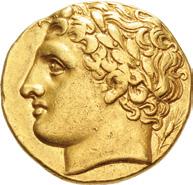


102. SICILY, Syracuse. Agathokles. 317-289 BC. AV Drachm – Hemistater (15.5mm, 4.25 g, 12h). Struck circa 317310 BC. Head of Apollo left, wearing laurel wreath; grain ear to right / Charioteer, wearing long chiton, holding kentron in extended right hand, reins in left, driving fast biga right; triskeles below, sUr-Å-˚o-s5W@ around. Bérend, l’or, pl. 9, 1 var. (no symbol on obv.); BAR Issue 1; HGC 2, 1276; SNG ANS 553; SNG Lloyd 1472; SNG München 1189–90; BMC 338; Boston MFA 457; Jameson 858; McClean 2814. Minor marks and some light scratches on obverse. Good VF. ($3000)
From the Gerald F. Borrmann (Northern California Gentleman) Collection, purchased from A. Kosoff, March 1968.
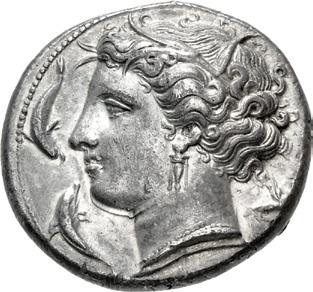


103. SICILY, Syracuse. Agathokles. 317-289 BC. AR Tetradrachm (26mm, 16.82 g, 2h). Struck circa 317-310 BC. Head of Arethousa left, wearing wreath of grain ears, triple-pendant earring, and pearl necklace; three dolphins around, 1 below neck / Charioteer, wearing long chiton, holding kentron in right hand, reins in left, driving fast quadriga left; counterclockwise triskeles above, sUrÅkos5W@ and & in exergue. Ierardi 12 (O2/R8); BAR Issue 2; HGC 2, 1348; SNG ANS 635/637 (same rev./obv. dies); SNG Ashmolean 2064 (same obv. die); SNG Lloyd 1477 (same obv. die); Boston MFA 459 = Warren 401 (same obv. die); Jameson 861 (same rev. die). Toned, minor double strike, a few marks. Near EF. ($4000)
From the Gerald F. Borrmann (Northern California Gentleman) Collection, purchased from Freeman & Sear, May 2007.



104. SICILY, Syracuse. Agathokles. 317-289 BC. AR Tetradrachm (25mm, 17.07 g, 6h). Struck circa 317-310 BC. Head of Arethousa left, wearing wreath of grain ears, triple-pendant earring, and pearl necklace; three dolphins around, f5 below neck / Charioteer, wearing long chiton, holding kentron in right hand, reins in left, driving fast quadriga left; counterclockwise triskeles above, sUrÅkos5W@ and & in exergue. Ierardi 56 (O11/R34); BAR Issue 2; HGC 2, 1348; SNG ANS 642 (same obv. die); SNG Lloyd 1480 (same obv. die); Sartiges 145 (same obv. die); Pozzi 642 (same obv. die). Lightly toned, a few marks. Good VF. ($3000)
From the Henry A. Sauter Collection. Ex Superior (29 January 1979), lot 18.
Extremely Rare Bronze – Ex Moretti Collection – Illustrated in CNS, BAR, and HGC


105. SICILY, Syracuse. Agathokles. 317-289 BC. Æ Dilitron (30mm, 21.43 g, 11h). Struck circa 310-306 BC. Head of Artemis Soteira right, hair tied in back, wearing single-pendant earring and pearl necklace, drapery at base of neck; quiver over shoulder; sWtE5rÅ to right / Winged thunderbolt; sUrÅ˚-os5W@ above and below. CNS 137 (this coin illustrated); BAR Issue 19 (this coin illustrated); HGC 2, 1437 (this coin illustrated); SNG Morcom –; Basel 519 (this coin). Beautiful dark forest green patina, slight roughness, minor die break on reverse. Near EF. Extremely rare, apparently one of two known. ($7500)
From the John Morcom Collection. Ex Numismatica Ars Classica 64 (17 May 2012), lot 745; Numismatica Ars Classica 21 (17 May 2001), lot 128; A. D. Moretti Collection (Numismatica Ars Classica 13, 8 October 1998), lot 519; Münzen und Medaillen AG 64 (30 January 1984), lot 50.

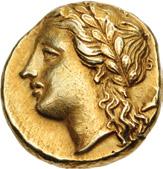


106. SICILY, Syracuse. Agathokles. 317-289 BC. EL 50 Litrai – Hemistater (13.5mm, 3.66 g, 1h). Struck circa 306/5 BC. Head of Apollo left, wearing laurel wreath; behind neck, small Corinthian helmet left / Tripod; sUrÅ˚-os5W@ around. Jenkins, Electrum, Group B, obv. die O14; BAR Issue 10; HGC 2, 1294; SNG ANS 629 (same obv. die); SNG München 1202 (same obv. die). Lightly toned, trace deposits, a few light scratches, scrape on reverse. Good VF. ($1500)
From the Gerald F. Borrmann (Northern California Gentleman) Collection, purchased in 1968.




107. SICILY, Syracuse. Agathokles. 317-289 BC. AV 100 Litrai – Double Dekadrachm (16.5mm, 5.64 g, 6h). Struck circa 304-289 BC. Head of Athena right, wearing crested Corinthian helmet decorated with a griffin, single-pendant earring, and pearl necklace / Winged thunderbolt; Å˝ÅQo˚¬Eos above, ∫Ås5¬Eos and f in two lines below. Bérend, l’or – (D5/ R2 [unlisted die combination]); BAR Issue 29; HGC 2, 1535; SNG ANS 702–3 (same rev. die) and 704 (same obv. die); SNG Copenhagen 778 (same obv. die); Gulbenkian 339 (same obv. die). Underlying luster, a few hairlines on obverse, a little die wear on reverse. EF. ($7500)
From the Gerald F. Borrmann (Northern California Gentleman) Collection, purchased from Dr. Arnold Saslow, May 1987.

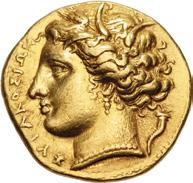


108. SICILY, Syracuse. Hiketas II. 287-278 BC. AV Hemistater – Drachm (16mm, 4.24 g, 3h). Struck circa 279/8 BC. Head of Persephone left, wearing wreath of grain ears, single-pendant earring, and pearl necklace; sUrÅkos5W@ to left, cornucopia to right / Nike, wearing long chiton, holding kentron in extended right hand and reins in left, driving fast biga right; fibula above, Q below, Eπ5 5˚EtÅ in exergue. Buttrey, Morgantina 35 (dies 4/G); BAR Issue 41; HGC 2, 1277; SNG ANS 777 (same dies); SNG Copenhagen 798 (same dies); Hunterian 184 (same dies); Prospero 192 (this coin). Light die wear on obverse, minor double strike on reverse. Good VF. ($7500)
From the Gerald F. Borrmann (Northern California Gentleman) Collection. Ex Prospero Collection (New York Sale XXVII, 4 January 2012), lot 192; Foreign Amateur Collection (Glendining, 13 December 1963), lot 181.
Little is known of Hiketas beyond his coinage, but Buttrey pieces together a history based on the numismatic evidence. Following his defeat of Phintias, tyrant of Akragas, Hiketas set out against the Carthaginians. This campaign ended in disaster at the Terias river, northwest of Syracuse. Buttrey, based on his die analysis, concludes that this gold issue was struck very hurriedly towards the end of the reign of Hiketas, and theorizes that this series was issued to pay for his Carthaginian campaign.




109. SICILY, Syracuse. Hieron II. 275-215 BC. AV Drachm – Hemistater (16.5mm, 4.27 g, 1h). Struck 269-263 or 217-215 BC. Head of Persephone left, wearing wreath of grain ears and necklace; cornucopia to right / Nike, wearing long chiton, holding kentron in right hand, reins in left, driving fast biga left; & below, 5ErW@os in exergue. Carroccio 22 (D22/ R28); BAR Issue 55; HGC 2, 1539; SNG Fitzwilliam 1388 (same dies); BMC 517 (same obv. die). Lustrous, tiny deposit on obverse, minor doubling on reverse. Superb EF. Struck from fresh dies. Among the finest known. ($10,000)
From the Gerald F. Borrmann (Northern California Gentleman) Collection, purchased from Frank Kovacs, December 2003.
Hieron II started life as the illegitimate son of a noble father, allegedly a distant descendant of the Syracusan tyrant Gelon I. Later legends claim Hieron was exposed as an infant, but swarms of bees fed him honey until his father, warned by an astrologer, came and rescued the boy. As a young man, he served as a mercenary soldier in the army of Pyrrhos of Epeiros. When his commander elected to abort his Sicilian expedition in 275 BC, Hieron stayed behind and convinced a cabal of fellow soldiers to choose him as leader and seize power in Syracuse. He went on to rule the city and much of Sicily, first as a military tyrant, later as an enlightened and successful king, for nearly 50 years. He is most famous as the king who patronized the brilliant polymath Archimedes in his “eureka!” discovery, the principle of displacement. Hieron’s coinage is widely varied, interesting, and in many ways inspired by that of his Hellenistic ally, the Ptolemaic Kingdom of Egypt.


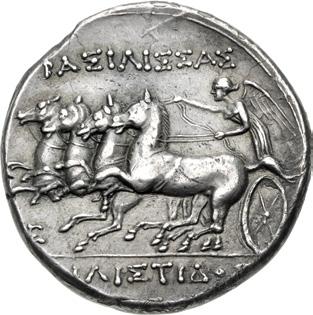
110. SICILY, Syracuse. Philistis, wife of Hieron II. 275-215 BC. AR 16 Litrai – Tetradrachm (25.5mm, 13.37 g, 11h).
Struck circa 217-215 BC. Diademed and veiled head left; torch to right / ∫Å%5¬5%%Å% [f]5¬5%t5do%, Nike, wearing long chiton, holding reins in both hands, driving fast quadriga left; E to lower left. CCO 42 (D11/R25); BAR Issue 65; HGC 2, 1553; BMC 552 (same dies); McClean 2916 (same dies); Pozzi 658 (same dies). Beautiful old cabinet tone, hairline flan cracks, minor deposits and faint cleaning marks on obverse. Near EF. Rare with quadriga left. ($3000)
From the Columbus Collection. Ex New York Sale XI (11 January 2006), lot 97.



111. SICILY, Syracuse. Philistis, wife of Hieron II. 275-215 BC. AR 16 Litrai – Tetradrachm (26mm, 13.40 g, 6h). Struck circa 217-215 BC. Diademed and veiled head left; spearhead to right / ∫Å%5¬5%%Å% f5¬5%t5do%, Nike, wearing long chiton, holding reins in both hands, driving slow quadriga right; Â5 above. CCO 181 (D19/R31); BAR Issue 65; HGC 2, 1556; Ars Classica XVII, lot 294 (same dies). Deep iridescent tone, minor scratches, flan flaw on obverse, deposits on reverse. Near EF. ($2000)
From the Gerald F. Borrmann (Northern California Gentleman) Collection, purchased, 1987.

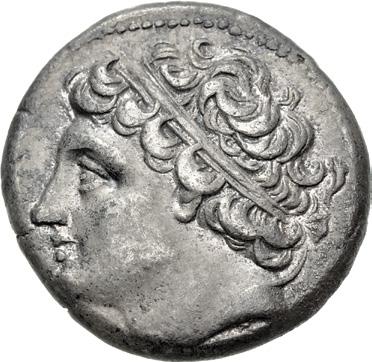

112. SICILY, Syracuse. Gelon, son of Hieron II. 275-215 BC. AR 8 Litrai – Didrachm (20mm, 6.66 g, 12h). Struck circa 217-215 BC. Diademed head left / %UrÅ˚o%[5o5] [˝]E¬W@o%, Nike, wearing long chiton, holding reins in both hands, driving slow biga right; ∫Å above, Å to right. CCO 279.4 (D5/R7 – this coin); BAR Issue 66; HGC 2, 1562; Boston MFA 481 (same dies); Hermitage Sale II 400 (same dies); Weber 1703 (same dies). Toned, some find patina, minor deposits. Good VF. Fine style. ($750)
Ex Lanz 24 (25 April 1983), lot 183.




113. SICILY, Syracuse. Hieronymos. 215-214 BC. AR 10 Litrai (24mm, 8.44 g, 10h). Diademed head left; ˚ to right / ∫Å%5¬EW% 5ErW@UÂoU, winged thunderbolt; ˚5 above. Holloway 41 (O21/R33); BAR Issue 79; HGC 2, 1567; SNG ANS 1029–30 (same dies); SNG Lloyd 1565 (same dies); Dewing 962 (same dies). Iridescent tone, traces of find patina, hairline flan crack, edge marks, minor double strike on obverse. EF. ($1500)
From the 1930’s Collection of Robert W. Hubel of Michigan.



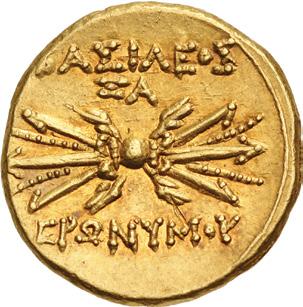
114. SICILY, Syracuse. Hieronymos. 215-214 BC. AV Quarter Stater – Hemidrachm (13mm, 2.12 g, 10h). Head of Persephone left, wearing wreath of grain ears and single-pendant earring / ∫Å%5¬EW% 5ErW@UÂoU, winged thunderbolt; $Å above. Holloway 53 (O25/R42); BAR Issue 77; HGC 2, 1565 (this coin illustrated). Lustrous. Superb EF. Extremely rare, only one other in CoinArchives. ($6000)
From the Gerald F. Borrmann (Northern California Gentleman) Collection. Ex James A. Ferrendelli Collection (Triton VII, 13 January 2004), lot 118; George & Robert Stevenson Collection (Classical Numismatic Group XXVI, 11 June 1993), lot 41.
Belonging to Hieronymos’ second issue of gold, this specimen was probably a presentation piece distributed at the beginning of Hieronymos’ move to expel the Romans from their garrisons in Syracuse. With possibly only six specimens of hemidrachms known for his gold coinage, such a small number of surviving examples would seem to indicate either a limited mintage or a subsequent recoinage by later authorities. Due to the extreme rarity of gold from the Fifth (or Syracusan) Democracy with only one undisputed gold hemistater, a limited mintage seems more likely. Hieronymos retained Persephone on the obverse but replaced the biga on the reverse with a winged thunderbolt, perhaps alluding to his Pyrrhic ancestry.



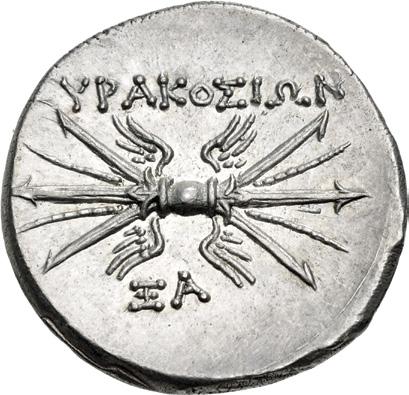
115. SICILY, Syracuse. Fifth Democracy. 214-212 BC. AR 8 Litrai (22mm, 6.77 g, 9h). Head of Athena left, wearing crested Corinthian helmet, single-pendant earring, necklace, and aegis / Winged thunderbolt; sUrÅkos5W@ above, xÅ below. Burnett, Enna 25 (dies 9/C); BAR Issue 88; HGC 2, 1414; SNG ANS 1045 (same dies); SNG Ashmolean 2122 (same dies); SNG Lloyd 1563 (same dies); BMC 654 (same dies); Jameson 893 (same dies). Faintly toned. Superb EF. ($2000)
From the Gerald F. Borrmann (Northern California Gentleman) Collection.




116. SICULO-PUNIC, “Ṣyṣ”. Circa 370-360 BC. AR Tetradrachm (23mm, 17.13 g, 11h). Likely Panormos mint. Charioteer, wearing long chiton, holding kentron in extended right hand, reins in left, driving fast quadriga left; above, Nike, wearing long chiton, flying right, crowning charioteer with wreath she holds with both hands; sign of Tanit in central field, in exergue, swan flying left / Head of Arethousa right, hair in band, wearing single-pendant earring and linear necklace; four dolphins swimming around. Jenkins, Punic 39 (O10’/R33); HGC 2, 1014 corr. (some are anepigraphic); Jameson 1070 (same dies); Weber 1486 (same dies). Iridescent tone, compact flan, a couple of light scratches on reverse. Near EF. ($5000)
Ex Vilmar Numismatics FPL II (Winter 2021), no. 14; Father & Son Collection (Classical Numismatic Group 118, 13 September 2021), lot 69; Classical Numismatic Review XLVI.1 (Winter 2021), no. 564480; Morton & Eden 108 (22 October 2020), lot 126; Aes Rude [1] (4 November 1977), lot 62.
Founded by the Phoenicians in the eighth century BC, Panormos was established along the northern coast of Sicily as a trading post with the indigenous Sicani of the region. The people of Panormos, although active traders like the other Phoenician settlers in Sicily, felt little need for striking their own coinage; instead, they relied upon the regional Greek coinages for their transactions. By the late fifth century, however, as Carthage and its Punic allies were expanding control of the western Mediterranean, it became necessary to begin striking coins in order the pay the mercenaries used to assert Punic power. As a result, cities like Panormos began striking coins which could be integrated into the existing monetary system, and which derived their types for the most part from the Greek city-states in Sicily. This coin copies Syracusan coins of the late Eukleidas style with a Punic twist added to the design.




117. SICULO-PUNIC, “Cape of Melkart”. Circa 350-310 BC. AR Tetradrachm (25mm, 16.76 g, 12h). Probably Lilybaion mint. Charioteer, wearing long chiton, holding kentron in extended right hand and reins in left, driving fast quadriga left; [teQ¬Mße (RŠMLQRT = “Raš Melqart” in Punic) in exergue] / Head of female right, wearing single-pendant earring; barley grain behind neck, two dolphins to right. Jenkins, Punic 3 (O2/R2’ – this coin referenced and illustrated); CNP 295a; HGC 2, 743; SNG Lockett 740 var. (same dies, but before barley grain added to rev. die). Old collection tone, minor marks. VF. Extremely rare; the only published example from these dies after barley grain added. ($2000) Ex Counseils Placement 1994, purchased from Bank Leu, 1965 (per Jenkins).
Lilybaion, modern day Marsala, was a Punic city in Sicily founded in the fourth century BC. The destruction of the chief Punic stronghold Motya in 397 BC by the Syracusan tyrant Dionysios I left the denizens of Motya without a home and Carthage without a primary military base on the island. In order to remedy both of these issues, the city of Lilybaion was founded by the survivors from Motya. The new port town would become a thriving trade hub and the most important military base in Sicily. The strong new walls that were built to defend the city were able to fend off both Pyrrhos of Epiros and the Romans. It was the last bastion of Punic rule in Sicily during Pyrrhos’ conquest of the island, beating back his attempts to take the city before his campaign unraveled entirely. The Romans placed the city under a nine year siege with numerous assaults during the First Punic War, but they were never able to capture the city and only gained control of it after Carthage’s surrender at the end of the war.
The issue of tetradrachms that are purportedly from Lilybaion were all struck in the later half of the fourth century BC. While many show strong affinity for Syracusan styles from the same period, Jenkins notes that this series relies heavily on prototypes from the Entella series.




118. SICULO-PUNIC, “Cape of Melkart”. Circa 330-305 BC. AR Tetradrachm (25mm, 16.65 g, 3h). Probably Lilybaion mint. Charioteer, wearing long chiton, holding kentron in extended right hand and reins in left, driving fast quadriga left; above, Nike, wearing long chiton, flying right, crowning charioteer with wreath held in extended hands; teQ¬Mße (RŠMLQRT = “Raš Melqart” in Punic) in exergue / Head of female right, wearing wreath of grain ears, ttriple-pendant earring, and pearl necklace; three dolphins swimming around. Jenkins, Punic 69 (O24/R52); CNP 344; HGC 2, 743; BMC 4 (same dies); Hirsch 821 (same dies); de Luynes 925 (same dies). Lightly toned, edge split, some die wear. Near EF. ($2000)
Ex Classical Numismatic Group 117 (19 May 2021), lot 41.

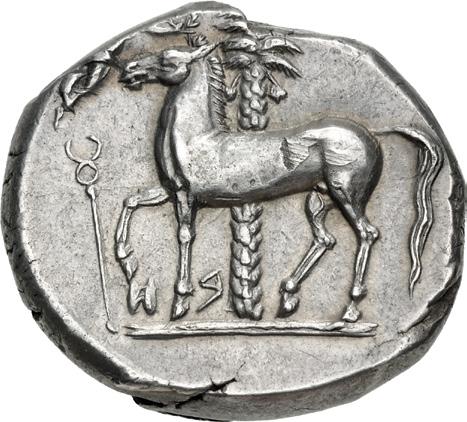
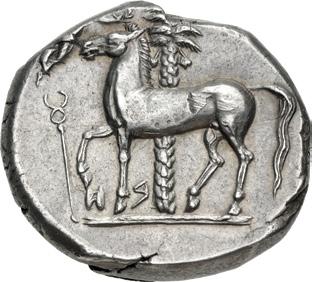
119. SICULO-PUNIC, “The Camp”. Circa 345/38-320/15 BC. AR Tetradrachm (25.5mm, 16.82 g, 11h). Possibly Entella mint. Head of Arethousa right, wearing wreath of grain ears, triple-pendant earring, and pearl necklace; thymiaterion to right / Horse stepping left; above, Nike, wearing long chiton, flying right, crowning horse with wreath held in extended hands; palm tree in background, kerykeion to left, j (Ḥ in Phoenician) below raised foreleg, b (B in Phoenician) below. Jenkins, Punic, Series 2c, 99 (O33/R90); CNP 210; HGC 2, 284; SNG Lockett 1042 (same dies); Bement 586–7 (same dies). Toned, die wear and small nick at edge on obverse, scuff on reverse. Good VF. ($3000)
Ex Gorny & Mosch 284 (7 March 2022), lot 162.

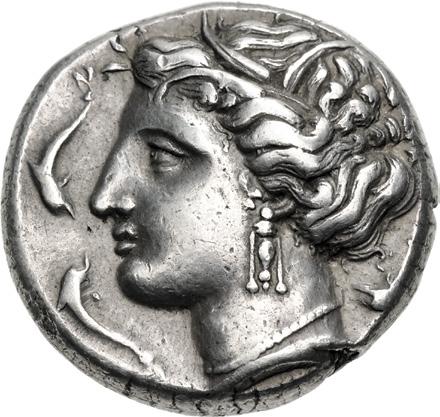

120. SICULO-PUNIC, “The Camp”. Circa 320/15-300 BC. AR Tetradrachm (23.5mm, 16.94 g, 6h). Possibly Entella mint. Head of Arethousa left, wearing wreath of grain ears, triple-pendant earring, and pearl necklace; four dolphins around / Head of horse left; palm tree to right, †nJMM` (MM = “People of the Camp” in abbreviated form, in Punic) below. Jenkins, Punic, Series 3b, 216 (O65/R188); CNP 267; HGC 2, 284; J. Hirsch XIX, lots 645–6 (same dies). Lightly toned, slightly compact flan. Good VF. ($2000)
From the Henry A. Sauter Collection.




121. SICULO-PUNIC, “The Camp”. Circa 320/15-300 BC. AR Tetradrachm (24mm, 17.47 g, 8h). Possibly Entella mint. Head of Herakles right, wearing lion skin / Head of horse left; palm tree to right, [†nJM∆M` (‘MHMḤNT = “People of the Camp” in Punic) below]. Jenkins, Punic, Series 5a, 307 (O97/R255 – this coin referenced and illustrated); cf. CNP 271; HGC 2, 295; SNG Fitzwilliam 1496 (same obv. die); SNG Lloyd 1643 (same obv. die); Hunterian 12 (same obv. die). Old cabinet tone, trace deposits, a little off center on reverse. EF. Extremely rare, the only example known from this reverse die. ($3000)
Ex American Numismatic Society Collection (per Jenkins).



122. SICULO-PUNIC, “The Camp”. Circa 320/15-300 BC. AR Tetradrachm (22.5mm, 16.91 g, 8h). Possibly Entella mint. Head of Herakles right, wearing lion skin / Head of horse left; kerykeion to left, palm tree to right, MBß∆M (MHSBM = “Paymasters” in Punic) below. Jenkins, Punic, Series 5b, 356 (O113/R290); CNP 272; HGC 2, 295; SNG Lloyd 1652 var. (symbol, same obv. die). Even gray tone with slight iridescence. Near EF. Well centered. ($2000)
From the Michael Rogal Collection. Ex Southern Pathologist Collection (Triton XVIII, 6 January 2015), lot 343, purchased from C. H. Wolfe, 14 February 1989.


123. ISLANDS off SICILY, Lipara. Circa 440-420 BC. Æ Tetras or Trionkion (30mm, 24.09 g). Head of Aiolos right, wearing pileos / Three pellets (mark of value); ¬5πÅrÅ5o@ around. Zagami 44; Manganaro, Vittoria 51–100; CNS 5/4 = SNG Copenhagen 1086 (same dies); HGC 2, 1762; SNG Morcom –; SNG München 1680; BMC 7–10; Virzi 2086 and 2088; MMAG 76, lot 263 (same dies); SKA 1, lot 60 (same dies); Sternberg XVIII, lot 48 (same dies). Attractive olive green patina, light cleaning marks on obverse. Near EF. Exceptional for issue. ($1000)
From the John Morcom Collection. Ex Numismatica Ars Classica 9 (16 April 1996), lot 278.
Aiolos was the god of the winds in Greek mythology. He was associated with the group of islands between Sicily and Italy, which were appropriately named the Aiolian Islands, of which Lipara was the largest and most important. In fact, Aiolos himself supposedly resided on the island of Lipara, hence his representation of their coins. In the Odyssey, Odysseus and his crew encountered Aiolos on their initial journey back to Ithaca. However, upon reaching their homeland, the men opened the bag of winds that Aiolos had gifted Odysseus to aid them back speedily to a disastrous result. Supposing that the bag could contain treasure, the men were dismayed to discover that, once loosed, the winds in the bag blew the Odysseus’ ship all the back to Aiolos. Upon learning the circumstances wherein his gift to Odysseus had been squandered, Aiolos refused to aid the crew a second time, thus beginning a disheartening second attempt to reach Ithaca.
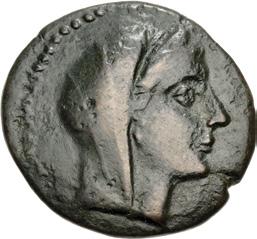


124. ISLANDS off SICILY, Melita. 150-146 BC. Æ (21mm, 4.61 g, 1h). Veiled head of female right / Tripod; ÂeLi-TAÍ at sides. Coleiro 11; Perassi 71–3; CNS 11 corr. (ethnic); SNG Copenhagen (Vol. 8) 471–2; SNG Morcom 939 (this coin). Green-brown patina, some cleaning scratches on reverse. VF. Excellent condition for the type. ($500)
From the John Morcom Collection.



125. CARTHAGE. Circa 350-320 BC. AV Stater (18mm, 9.49 g, 2h). Carthage mint. Head of Tanit left, wearing wreath of grain ears, triple-pendant earring, and necklace with nine pendants / Horse standing right; three pellets above ground line to right of forelegs. Jenkins & Lewis Group IIIf, 38–44; CNP 1.5m; MAA 4. Minor marks and nicks on reverse. Good VF. ($5000)
From the Henry A. Sauter Collection, purchased from Superior Stamp & Coin.

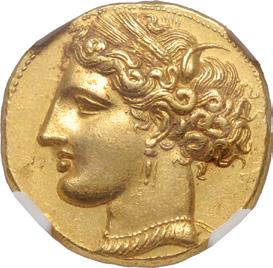


126. CARTHAGE. Circa 270-264 BC. AV 1½ Shekels – Tridrachm (21.5mm, 12.50 g, 12h). Carthage mint. Head of Tanit left, wearing wreath of grain ears, triple-pendant earring, and necklace with eleven pendants / Horse standing right, head left. Jenkins & Lewis Group IX, 388 (same dies); CNP 76d; MAA 26; SNG Copenhagen 181; Basel 569; Gulbenkian 384; Kraay & Hirmer 210; de Luynes 3749 (same obv. die). In NGC encapsulation 5771750-002, graded Ch AU, Strike: 5/5, Surface: 4/5, Fine Style. ($20,000)
Ex Edward H. Merrin Collection (noted on NGC tag).
By the third century BC, the Punic goddess Tanit and the horse had become the standard types of Carthaginian coinage and remained so for the balance of the city’s existence. Tanit was the primary deity of Carthage. A celestial divinity with some fertility aspects, she was the North African equivalent of Astarte. She is always depicted on the coinage wearing a wreath of grain, which may have been borrowed from Demeter and Persephone as the Carthaginians assimilated the Sicilian culture into their own during the various Punic excursions to the island. The use of the horse on the reverse is usually considered part of the foundation myth of Carthage. According to Virgil’s Aeneid, the Phoenician colonists who founded Carthage were told by Juno (or Tanit) to establish the new colony at the place where they discovered a horse’s head in the ground. Another theory is that the obverse head is actually Demeter or Persephone, whose worship was introduced to Carthage in 396 BC to make amends for the destruction of the goddesses’ temples outside Syracuse by the Carthaginian army.
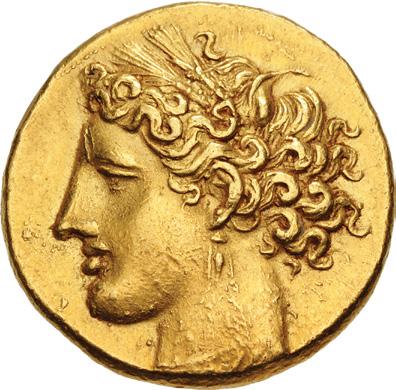



127. CARTHAGE. Circa 270-264 BC. AV 1½ Shekels – Tridrachm (22mm, 12.51 g, 12h). Carthage mint. Head of Tanit left, wearing wreath of grain ears, triple-pendant earring, and necklace with [ten] pendants / Horse standing right, head left. Jenkins & Lewis Group IX, 391–2 (same obv. die); CNP 76; MAA 26; SNG Copenhagen 181; Basel 569; Gulbenkian 384; Kraay & Hirmer 210. A little die wear and small scrape on obverse, minor nick at edge on reverse, edge bump. Near EF. ($15,000)



128. CARTHAGE, Libyan Revolt. Circa 241-238 BC. BI Shekel (25mm, 9.04 g, 11h). Head of Herakles left, wearing lion skin / Lion standing right; M (Punic M) above. Carradice & La Niece 1; CNP 433b; MAA 53; SNG Copenhagen 239–43. Toned, trace deposits, overstruck on an earlier Carthaginian issue (type: head of Tanit left / Horse standing right, pellet between hind legs, possibly CNP 51b). Near EF. Well struck for issue. ($1000)


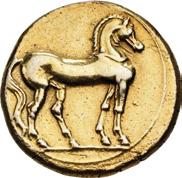

129. CARTHAGE, Second Punic War. Circa 220-205 BC. EL Three-eighths Shekel (15mm, 2.90 g, 12h). Carthage mint. Head of Tanit left, wearing wreath of grain ears, triple-pendant earring, and necklace / Horse standing right. Jenkins & Lewis Group XV, 476–7; CNP 9; cf. MAA 73. Ex-jewelry. VF. Very rare. ($1000)
From the Henry A. Sauter Collection, purchased from Superior Stamp & Coin.


130. THRACE, Abdera. Circa 450-425 BC. AR Tetradrachm (26mm, 14.91 g, 6h). Local standard. Poseo–, magistrate. Griffin springing left; anchor below / Cockle shell within linear square; Eπ5/ πo-s-EW/ around; all within shallow incuse square. May, Abdera, Period IV, unlisted issue; AMNG II –; CN Online –; HGC 3, –. Light iridescent tone around the devices. VF. Apparently unique. ($2000)

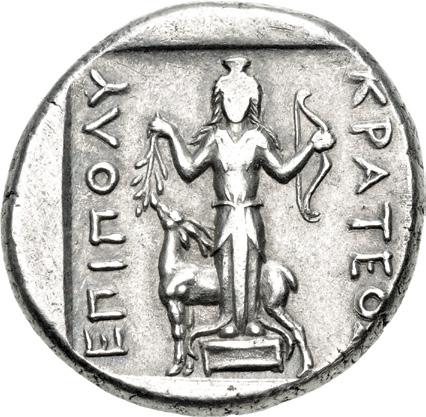

131. THRACE, Abdera. Circa 346/5-336 BC. AR Tetradrachm – Double Siglos (24mm, 11.40 g, 1h). Persic standard. Polykrates, magistrate. Griffin couchant left on linear ground line; Å∫d˙r5 above / Figure of Artemis standing facing on high base, wearing kalathos, holding laurel spray in right hand, bow in left; behind, stag standing left, nibbling at branch; Eπ5 πo¬U-KrÅtEo[s] flanking; all within shallow incuse square. May, Abdera, Period VII, 461 (A306/P365); AMNG II 136; CN Online Type 6019; HGC 3, 1209; Gillet 836 var. (no basis; same obv. die). Attractive light toning, slightly off center, a couple of light scrapes at edge on obverse. EF. Very rare. ($5000)
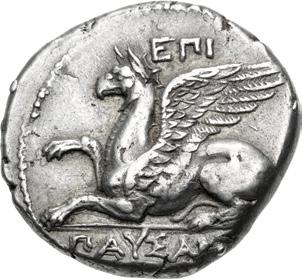


132. THRACE, Abdera. Circa 346/5-336 BC. AR Tetradrachm – Double Siglos (25mm, 11.47 g, 1h). Persic standard. Pausanias, magistrate. Griffin couchant left on linear ground line; Eπ5 πÅUsÅ[@5Ås] above and below / Laureate head of Apollo right; Å∫d˙r5-tEW@ flanking; all within shallow incuse square. May, Abdera, Period VII, 465 (A310/P369); AMNG II 139; CN Online Type 6057; HGC 3, 1210; SNG Fitzwilliam 1642 (same dies); Gillet 838 (same obv. die); Rhousopoulos 524 (same dies). Toned, light patches of horn silver, a couple of minor flan flaws on obverse. VF. ($1500)
Ex Numismatica Ars Classica Spring Sale 2020 (25 May 2020), lot 193; Thomas Bentley Cederlind Estate (Classical Numismatic Group 102, 18 May 2016), lot 178; Numismatica Ars Classica 59 (4 April 2011), lot 1616.




133. THRACE, Byzantion. Circa 260-245 BC. AV Stater (19mm, 8.49 g, 11h). In the name and types of Lysimachos. Diademed head of the deified Alexander right, with horn of Ammon / ∫Å%5¬EW% 2U%5;ÅcoU, Athena Nikephoros seated left, left arm resting on shield, transverse spear in background; no control marks. Marinescu Issue 26, 64 (O29/R61); Müller –; HGC 3, 1374; Triton XXIII, lot 165 (hammer $9500) = Rauch 74, lot 189 (same dies). A few light scratches on obverse, a couple of bumps on edge. EF. Extremely rare, only seven examples known to Marinescu. ($3000)
From the Gerald F. Borrmann (Northern California Gentleman) Collection, purchased from A. Kosoff, March 1968. Reportedly ex Jules Furthman Collection.



134. THRACE, Byzantion. Circa 260-245 BC. AR Tetradrachm (30mm, 16.76 g, 12h). In the name and types of Lysimachos. Diademed head of the deified Alexander right, with horn of Ammon / ∫Å%5¬EW% 2U%5;ÅcoU, Athena Nikephoros seated left, left arm resting on shield, transverse spear in background; Ý to inner left. Marinescu Issue 29, 72 (O32/ R68); Müller –; HGC 3, 1374. Lightly toned, traces of find patina, minor flan flaw on reverse. Good VF. Very rare, only six examples of this issue noted by Marinescu, three additional in CoinArchives. ($1000)
Ex Rauch 107 (12 November 2018), lot 95; Rauch Summer Auction 2007 (11 September 2007), lot 122; Lanz 132 (27 November 2006), lot 101.

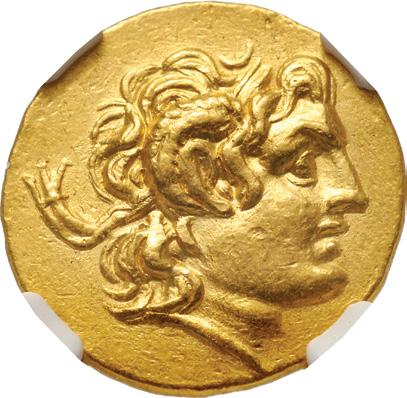

135. THRACE, Byzantion. Circa 100-96 BC. AV Stater (19.5mm, 8.38 g, 1h). In the name and types of Lysimachos. Diademed head of the deified Alexander right, with horn of Ammon / ∫Å%5¬EW% 2U%5;ÅcoU, Athena Nikephoros seated left, left arm resting on shield, transverse spear in background; O to inner left, ∫U below throne, ornate trident in exergue. Callataÿ –; Seyrig, Monnaies –; Müller –; cf. HGC 3, 1385 (for type); CNG E-355, lot 15 (same obv. die); Künker 333, lot 695 = Hess-Divo 331, lot 220 = Künker 226, lot 288 = Vinchon (Dec. 1996), lot 63. In NGC encapsulation 4165932-001, graded AU, Strike: 5/5, Surface: 3/5. Extremely rare, only three in CoinArchives (including this coin). ($2000)
Ex Classical Numismatic Group Electronic Auction 322 (12 March 2014), lot 92.
Although this issue is unpublished, it is obverse die linked to staters of Müller 171 (Callataÿ Group 2B, p. 142) type (cf. CNG E-312, lots 53 and 54).

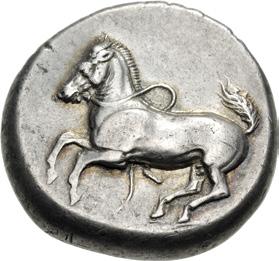
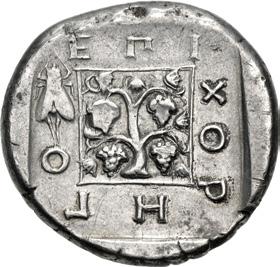

136. THRACE, Maroneia. Circa 365-330s BC. AR Stater – Double Sigloi (22.5mm, 11.38 g, 6h). Persic standard. Choregos, magistrate. Horse rearing left, trailing rein / Grape arbor in linear square; Eπ5 cor-E˝-o around, fly to upper left; all within shallow incuse square. Schönert-Geiss 434 (V15/R21); CN Online Type 495; HGC 3, 1533; SNG Copenhagen 606 (same dies); Mušmov 3905 (same dies). Toned, with some iridescence around the devices, slight weakness to strike, some light scratches, small scuff on reverse. Near EF. ($2000)
From the JTB Collection. Ex Leu Numismatik AG Web Auction 26 (8 July 2023), lot 452; Spink 23105 (30 January 2023), lot 6058; Spink 202 (25 March 2010), lot 400.



137. THRACE, Mesambria. Circa 275/50-225 BC. AR Tetradrachm (30.5mm, 16.92 g, 12h). In the name and types of Alexander III of Macedon. Head of Herakles right, wearing lion skin / ∫Å%5¬EW% ŬE$Å@dro[U], Zeus Aëtophoros seated left; in inner left field, helmet above fl. Karayotov I – (catalog no. 127); Topalov 988; HGC 3, 1567; Black Sea Hoard 192 (OF/R27 – this coin). Lightly toned, minor doubling. Near EF. Very rare issue, none seen by Karayotov, two in Pella, and only seven in CoinArchives. ($750)
Ex “Black Sea” Hoard.



138. ISLANDS off THRACE, Thasos. Circa 412-404 BC. AR Stater (21mm, 8.64 g). Ithyphallic satyr advancing right, carrying off protesting nymph; Å to upper right / Quadripartite incuse square. Le Rider, Thasiennes 6; HPM p. 99, 21; HGC 6, 334; BMC 29–30; Hirsch 147–8; Prospero 243 (this coin). Old cabinet tone, a little die rust. Good VF. ($3000)
From the Gerald F. Borrmann (Northern California Gentleman) Collection, purchased from Baldwin’s, 14 December 2014. Ex Prospero Collection (New York Sale XXVII, 4 January 2012), lot 243; Vinchon (9 December 1983), lot 95; Naville X (15 June 1925), lot 484.



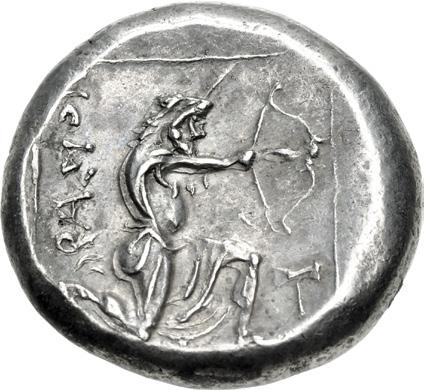
139. ISLANDS off THRACE, Thasos. Circa 390-335 BC. AR Tetradrachm (23mm, 15.43 g, 7h). Chian standard. Bearded head of Dionysos left, wearing wreath of ivy with berries / Herakles, wearing lion skin, kneeling right, drawing bow; QÅs5o@ to left, labrys to lower right; all in linear square. Pixodarus 30a = Hunt IV 182 (this coin, illustated); West 32bis; Le Rider, Thasiennes 23; HGC 6, 342 (unlisted symbol). Lightly toned, a couple of die breaks, small flan flaw and area of weak strike on obverse, minor doubling on reverse. Good VF. Very rare issue with labrys. ($2000)
Ex Rauch 86 (12 May 2010), lot 277; Berk BBS 109 (20 July 1999), lot 165; Berk BBS 107 (18 March 1999), lot 155; Nelson Bunker Hunt Collection (Part IV, Sotheby’s New York, 19 June 1991), lot 182; Münzen und Medaillen AG 72 (6 October 1987), lot 550; Numismatic Fine Arts X (17 September 1981), lot 88; Pixodarus Hoard (CH IX, 421).




140. ISLANDS off THRACE, Thasos. Circa 390-335 BC. AR Drachm (15.5mm, 3.54 g, 10h). Chian standard. Bearded head of Dionysos left, wearing wreath of ivy with berries / Herakles, wearing lion skin, kneeling right, drawing bow; QÅs5o-@ to left and above, kantharos to lower right; all in linear square within shallow incuse square. West 16b (same dies as illustration); Le Rider, Thasiennes 19; HGC 6, 343; Boston MFA 862 = Warren 502. Find patina, minor marks. Good VF. Well centered. ($750)
Ex Peus 431 (27 April 2022), lot 3096; Münz Zentrum 105 (10 January 2001), lot 130.




141. KINGS of THRACE, Macedonian. Lysimachos. 305-281 BC. AR Tetradrachm (28mm, 17.04 g, 2h). Lampsakos mint. Struck 297/6-282/1 BC. Diademed head of the deified Alexander right, with horn of Ammon / ∫Å%5¬EW% 2U%5;ÅcoU, Athena Nikephoros seated left, left arm resting on shield, transverse spear in background; to inner left, forepart of lion left. Thompson 40; Müller 37; HGC 3, 1750b; SNG BN – (but same obv. die as 2547); Armenak 672 (same obv. die). Underlying luster, short flan crack, a touch off center. Near EF. ($1500)
Struck from the same obverse die as the following lot.
142. KINGS of THRACE, Macedonian. Lysimachos. 305-281 BC. AR Tetradrachm (28mm, 17.17 g, 6h). Lampsakos mint. Struck 297/6-282/1 BC. Diademed head of the deified Alexander right, with horn of Ammon / ∫Å%5¬EW% 2U%5;ÅcoU, Athena Nikephoros seated left, left arm resting on shield, transverse spear in background; torch to outer left, å on throne. Thompson 41; Müller 442; HGC 3, 1750b; SNG BN 2547 var. (torch to inner left; same obv. die); Armenak 673 (same rev. die). Underlying luster, a little die rust on obverse, minor deposits on reverse. Near EF. ($1500)
Struck from the same obverse die as the previous lot.
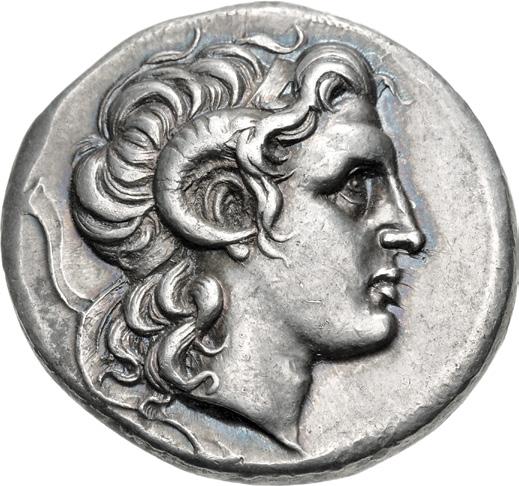
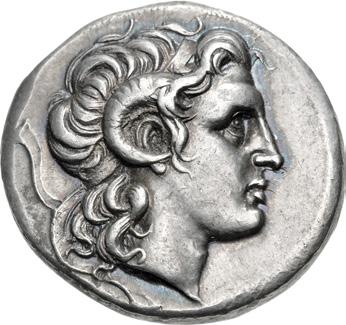

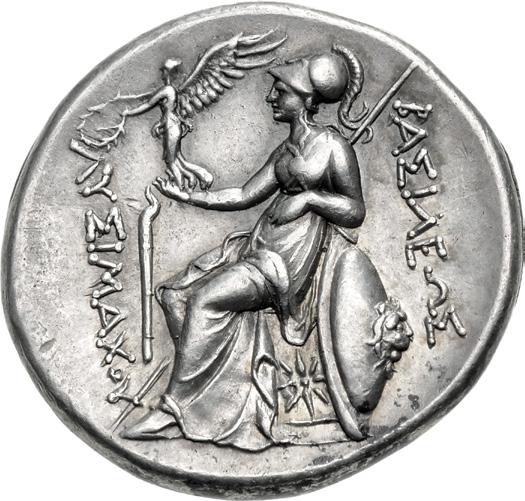
143. KINGS of THRACE, Macedonian. Lysimachos. 305-281 BC. AR Tetradrachm (28.5mm, 17.38 g, 12h). Lampsakos mint. Struck 297/6-282/1 BC. Diademed head of the deified Alexander right, with horn of Ammon / ∫Å%5¬EW% 2U%5;ÅcoU, Athena Nikephoros seated left, left arm resting on shield, transverse spear in background; torch to inner left, star on throne. Thompson 43; Müller 381; HGC 3, 1750b; SNG BN 2538–9 (same obv. die). Gorgeous iridescent tone, trace of find patina, a few minor marks. EF. ($3000)
From the Gerald F. Borrmann (Northern California Gentleman) Collection. Ex Classical Numismatic Review XXIII.2 (Fall/Winter 1998), no. 28; Leu 72 (12 May 1998), lot 153.



144. KINGS of THRACE, Macedonian. Lysimachos. 305-281 BC. AR Tetradrachm (30.5mm, 17.03 g, 6h). Lampsakos mint. Struck 297/6-282/1 BC. Diademed head of the deified Alexander right, with horn of Ammon / ∫Å%5¬EW% 2U%5;ÅcoU, Athena Nikephoros seated left, left arm resting on shield, transverse spear in background; B to inner left, crescent in exergue. Thompson 49; Müller 399; HGC 3, 1750b; SNG BN 2548–9. A few hairlines, slight die shift on obverse. Near EF. High relief. ($1500)




145. KINGS of THRACE, Macedonian. Lysimachos. 305-281 BC. AV Stater (17.5mm, 8.51 g, 12h). Alexandreia Troas mint. Struck circa 297/6-282/1 BC. Diademed head of the deified Alexander right, with horn of Ammon / ∫Å%5¬EW% ¬Us5ÂÅcoU, Athena Nikephoros seated left, left arm resting on shield, transverse spear in background; in inner left field, È above bee; R in exergue. Thompson 146 (same dies as illustration); Meadows, Earliest 43b, dies A10/P27 (this coin); Müller 429; HGC 3, 1743e; Rhousopoulos 696 (same dies). Underlying luster, minor marks. Good VF. Rare. ($3000)
Ex Lanz 34 (25 November 1985), lot 118.



146. KINGS of THRACE, Macedonian. Lysimachos. 305-281 BC. AR Tetradrachm (31mm, 16.86 g, 7h). Amphipolis mint. Struck circa 288/7-282/1 BC. Diademed head of the deified Alexander right, with horn of Ammon / ∫Å%5¬EW% ¬Us5ÂÅcoU, Athena Nikephoros seated left, left arm resting on shield, transverse spear in background; race torch to inner left, bee to outer right. Thompson 187; Müller 445a; HGC 3, 1750l. Toned, a couple of faint scratches, light scuff on edge. Near EF. Bold portrait. ($1500)
Ex Classical Numismatic Group 97 (17 September 2014), lot 68.




147. KINGS of THRACE, Macedonian. Lysimachos. 305-281 BC. AR Tetradrachm (29mm, 17.09 g, 8h). Amphipolis mint. Struck 288/7-282/1 BC. Diademed head of the deified Alexander right, with horn of Ammon / ∫Å%5¬EW% 2U%5;ÅcoU, Athena Nikephoros seated left, left arm resting on shield, transverse spear in background; ˇ to inner left, Ÿ in exergue. Cf. Thompson 210 & 211; cf. Müller 536 & 544; HGC 3, 1750l; Meydancikkale 2675 (same obv. die). Lightly toned, underlying luster. Superb EF. Attractive style. ($4000)
Ex Triton VIII (11 January 2005), lot 262.


148. KINGS of THRACE, Macedonian. Lysimachos. 305-281 BC. AR Tetradrachm (28mm, 17.12 g, 1h). Pella mint. Struck circa 288/7-282/1 BC. Diademed head of the deified Alexander right, with horn of Ammon / ∫Å%5¬EW% ¬Us5ÂÅcoU, Athena Nikephoros seated left, left arm resting on shield, transverse spear in background; A to inner left, ornament on throne. Thompson 247 var. (no ornament noted); Müller –; HGC 3, 1750l. Deep cabinet tone, very minor die shift on obverse, small scuff on edge. EF. Extremely rare with ornament. ($1500)
Ex Classical Numismatic Group 99 (13 May 2015), lot 57; Sotheby’s (20 April 1970), lot 115.
Thompson notes (p. 176, n. 1) that this particular ornament on the throne is commonly seen on coins of Magnesia, but it also occurs on rare issues of Mytilene and Ephesos. Unbeknownst to Thompson, however, it appears to also occur on rare issues of Pella (cf. Bourgey, March 1975, lot 30 [a variety of Thompson 248], CNG 81, lot 253 [a variety of Thompson 250], and Knobloch FPL 21, no. 67 [a variety of Thompson 252]).




149. THRACO-MACEDONIAN TRIBES, Mygdones or Krestones. Circa 480-470 BC. AR Stater (23mm, 9.24 g). Goat kneeling right, head reverted, on dotted ground line; z above / Quadripartite incuse square. Lorber, Goats, Issue 8; HPM pl. I, 5 = BMC Macedon p. 37, 1 (same obv. die); AMNG III/2, 6; HGC 3, 366 (‘Aigai’); SNG ANS 58 (same obv. die [Aegae]); Gillet 737; Locker-Lampson 152 (same dies); Raymond p. 52 (this coin referenced [Hirsch 1933]); Weber 1840 (same dies). Lovely deep old cabinet tone, minor edge marks. Near EF ($10,000)
From the Columbus Collection. Ex New York Sale III (7 December 2000), lot 118; R. de St. Marceaux Collection (Ars Classica XVI, 3 July 1933), lot 968. Reportedly also ex H. Herzfelder and P. Strauss collections.



150. THRACO-MACEDONIAN REGION, Berge. Circa 525-480 BC. AR Stater (21mm, 9.90 g). Ithyphallic satyr standing right, right hand grasping right wrist of nymph fleeing right, his left hand supporting her chin; three pellets around / Rough incuse square divided diagonally. Smith Group 5 (Lete); Peykov A0020 (Siris); HPM pl. VIII, 4; AMNG III/2, 14 (Lete); SNG ANS 954–61 (“Lete”); Kunstfreund 40 (Uncertain mint); Traité I 1568 (Lete). Beautifully toned. Superb EF. ($10,000)
From the Columbus Collection. Ex Triton XVIII (6 January 2015), lot 430; LHS 100 (23 April 2007), lot 211; Leu 38 (13 May 1986), lot 58; Christitch Collection (Egger XLI, 18 November 1912), lot 340; Dr. Fenerly Bey du Phanar Collection.
The satyr/centaur and nymph type represents a common theme in Greek mythology: the juxtaposition of the wildly monstrous and sexuallycharged with the human. Kraay’s view (ACGC pp. 148-9) that the coins where the satyr and nymph are both standing show the nymph seducing the satyr, while the coins where the nymph is in the satyr’s arms show the nymph is protesting her being carried off, is contradicted by a close inspection of the coins themselves. In similar scenes of this event depicted elsewhere, the satyr clearly manhandles the nymph, forcibly grasping one of her arms, while the nymph appears in a posture of apparent flight (see, e.g., HPM pl. VII-VIII). Clearly, in both scenes the nymph is protesting the actions of the satyr or centaur, who, in the role of the wild, libidinous creature that he is, is seizing the nymph for his own purposes, driven by his sexual arousal.
This particular issue has previously been given to Lete and Siris, but S. Psoma has persuasively argued against both of these attributions, and suggests that the city of Berge is the most likely in light of the historical and numismatic evidence. (See S. Psoma, “The ‘Lete’ Coinage Reconsidered” in Agoranomia.)



151. MACEDON, Akanthos. Circa 525-470 BC. AR Tetradrachm (28mm, 17.13 g). Attic standard. Lion attacking right, biting into the hindquarter of a bull kneeling left, head right, biting the leg of the lion; Q above, three ground lines below, the middle composed of pellets; floral ornament in exergue / Quadripartite incuse square. Desneux 69–79 (unlisted dies); AMNG III/2, 5; HGC 3, 383; SNG ANS 10 var. (bull head left); SNG Spencer 109; SNG Lockett 1282; Boston MFA 520 = Warren 536. Attractive light toning, deposits on reverse. Good VF. Well struck on a broad flan. ($3000)


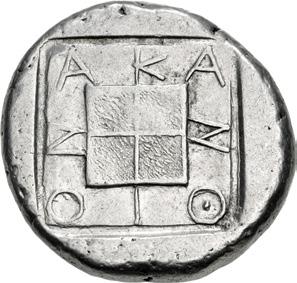

152. MACEDON, Akanthos. Circa 430-390 BC. AR Tetradrachm (22mm, 14.07 g, 8h). Thraco-Macedonian standard. Lion attacking right, biting into the hindquarter of a bull kneeling left, head raised / Å˚Å-˜-Q5o-@ in shallow incuse around quadripartite square, the quarters raised and granulated. Desneux 117 (D113/R105); AMNG III/2, –; HGC 3, 391; Boston MFA 529 (same dies). Lightly toned. Good VF. Very rare early Thraco-Macedonian standard issue. ($3000)
From the Michael Rogal Collection. Ex Triton XVIII (6 January 2015), lot 435; RAJ Collection (Triton XVII, 7 January 2014), lot 118. Akanthos was founded on the easternmost “finger” of the Chalcidice in the seventh century BC. Huge silver deposits were discovered in close proximity during the sixth century BC, leading to Akanthos becoming a prolific mint, with its coinage circulating widely in northern and mainland Greece. Of the Archaic Greek coinages, the imagery of Akanthos is one of the most influential, depicting a lion attacking a bull. Lions still prowled the hinterlands of Thrace and Macedon in this era. Herodotus recounts an episode in The Histories when the baggage camels of the army of the Persian King Xerxes was set upon by lions during its march from Asia Minor into Greece proper (Herodotus 7.125-126).
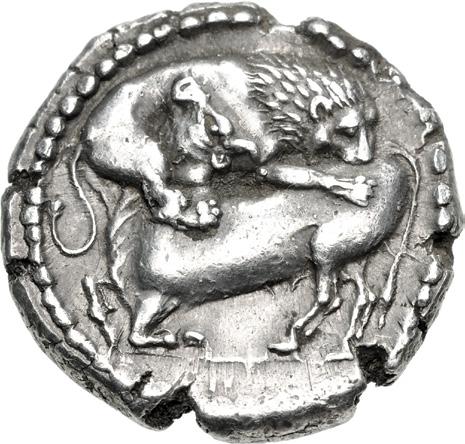

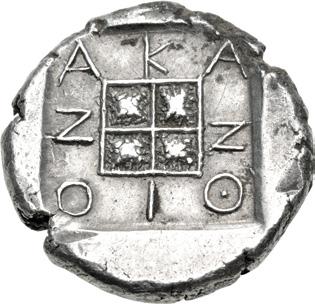

153. MACEDON, Akanthos. Circa 430-390 BC. AR Tetradrachm (25.5mm, 14.11 g, 10h). Thraco-Macedonian standard. Lion attacking right, biting into the hindquarter of a bull kneeling left, head raised; ˝ in exergue / Å˚Å-n-Q5o-n in shallow incuse square around quadripartite square with stippled quarters in relief. Desneux 123a (D118/R110 [erroneous pedigree listed]) = Hunt IV 194 (this coin); cf. AMNG III 29; HGC 3, 391; SNG ANS 12 (same rev. die). Lightly toned, trace deposits, minor marks. Good VF. ($4000)
Ex Leu 18 (5 May 1977), lot 107; Nelson Bunker Hunt Collection (Part IV, Sotheby’s New York, 19 June 1991), lot 194; Robert Allatini Collection (Sotheby, Wilkinson & Hodge, 9 May 1904), lot 24.
Referenced by Desneux – Ex Hoskier and Smith Collections – Pedigreed to 1905



154. MACEDON, Akanthos. Circa 430-390 BC. AR Tetradrachm (25mm, 13.76 g, 6h). Thraco-Macedonian standard. Lion attacking right, biting into the hindquarter of a bull kneeling left, head raised; ŬEx5s in exergue / Å˚Å-n-Q5o-n in shallow incuse square around quadripartite square with stippled quarters in relief. Desneux 140a (D132/R126 – this coin); AMNG III 29; HGC 3, 391; SNG ANS 15; Hirsch 955 (same obv. die). Lightly toned, trace deposits, granular surfaces. Good VF. ($2000)
Ex Leu 71 (24 October 1997), lot 125; Hess-Leu 45 (12 May 1970), lot 115; H. C. Hoskier Collection (J. Hirsch XX, 13 November 1907), lot 228; Harlan P. Smith Collection (Sotheby, Wilkinson & Hodge, 5 June 1905), lot 139.



155. MACEDON, Akanthos. Circa 430-390 BC. AR Tetradrachm (25mm, 14.37 g, 11h). Thraco-Macedonian standard. Lion attacking right, biting into the hindquarter of a bull kneeling left, head raised; ŬEx5s in exergue / Å˚Å-n-Q5o-n in shallow incuse square around quadripartite square with stippled quarters in relief. Desneux 147–8 var. (D139/R– [unlisted rev. die]); AMNG III 29; HGC 3, 391; SNG ANS 15; SNG Copenhagen 14 (same obv. die); BMC 25 (same obv. die). In NGC encapsulation 5771750-005, graded AU, Strike: 5/5, Surface: 4/5, Fine Style. ($3000)
Ex Edward H. Merrin Collection (noted on NGC tag); Leu 45 (26 May 1988), lot 106.




156. MACEDON, Amphipolis. 369/8 BC. AR Drachm (15.5mm, 3.51 g, 5h). Head of Apollo facing slightly right, wearing laurel wreath, drapery around neck / ÅÂf-5πo-¬5t-EW@ on raised linear square enclosing race torch; all within shallow incuse square. Lorber 55 (Od3/Rd2); HGC 3, 413; SNG Soutzos 271 (same dies); SNG Stockholm 873 = SNG Lockett 1301 = Bement 672 (same dies); McClean 3207 (same dies). Faintly toned, trace of find patina, typical light granularity. Good VF. ($3000)
Ex Spink 212 (28 March 2012), lot 21; Classical Numismatic Group 79 (17 September 2008), lot 139.



157. MACEDON, Chalkidian League. Circa 383/2 BC. AR Tetradrachm (25mm, 14.45 g, 12h). Olynthos mint. Head of Apollo right, wearing laurel wreath / Kithara; c-Å-¬-˚5d-EW@ around; all within incuse square. Robinson & Clement Group H, 26–7 var. (A22/P– [unlisted rev. die]); AMNG III/2, 5; HGC 3, 498; SNG ANS 474 (same obv. die); SNG Copenhagen 242 (same obv. die). Bright surfaces, even light die wear on obverse. EF. ($3000)



158. MACEDON, Chalkidian League. Circa 383/2 BC. AR Tetradrachm (24mm, 14.42 g, 12h). Olynthos mint. Head of Apollo right, wearing laurel wreath / Kithara; c-Å-¬-˚5d-EW@ around; all within incuse square. Robinson & Clement Group H, 28 (A23/P25); AMNG III/2, 5; HGC 3, 498; SNG Lockett 1308 (same dies). Faintly toned, light cleaning marks on obverse. EF. Attractive style. ($2500)



159. MACEDON, Chalkidian League. Circa 352 BC. AR Tetradrachm (23mm, 14.41 g, 2h). Olynthos mint; Olympichos, magistrate. Head of Apollo right, wearing laurel wreath / Kithara; c-Å-¬-˚5d-EW@ around, [Eπ5 o¬UÂπ5cos below]. Robinson & Clement Group T, 116 (A74/P99); HGC 3, 499; SNG ANS 509; Boston MFA 581 = Warren 564 (same obv. die); Kraay & Hirmer 413 (same dies). Lightly toned, trace deposits. Good VF. ($2000)



160. MACEDON, Neapolis. Circa 500-480 BC. AR Stater (20mm, 9.83 g). Facing gorgoneion with protruding tongue / Quadripartite incuse square. AMNG III/2, 6; HGC 3, 583; SNG ANS 406–19; Dewing 1604; Kraay & Hirmer 433; Traité I 1740. Attractive old collection tone. Choice EF. Well centered and struck from fresh dies. ($10,000)
From the Columbus Collection. Ex Edward J. Waddell inventory C29932 (c. 1990).
Neapolis, which is well known for its apparently large issues of silver in the 5th-early 4th centuries BC, is relatively unknown outside of numismatics. Its exact location is unknown, though a city that has been under excavation near modern Polychronon may be Neapolis. The city was likely founded as a settlement by colonists from Mende in the 6th century BC. Like many of the other cities in the region, Neapolis supplied troops and ships to Xerxes during the Greco-Persian Wars, and afterward became a member of the Delian League. Its coinage consists of two large series of silver coins, both featuring the facing head of a gorgoneion on the obverse. The first series, with a simple quadripartite incuse reverse, began late in the Archaic period, circa 500 BC, and lasted until circa 480 BC. This is followed by a dual-sided coinage of drachms and hemidrachms featuring a female head on the reverse, which ran from the late 5th century BC until the early 4th century BC.
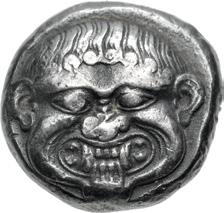

161. MACEDON, Neapolis. Circa 500-480 BC. AR Stater

gorgoneion with protruding tongue /



162. MACEDON,
Circa 500-480 BC. AR Stater (19mm, 9.95 g). Facing gorgoneion with protruding tongue / Quadripartite incuse square. AMNG III/2, 6; HGC 3, 583; SNG ANS 406–19; Dewing 1604;
under tone, a hint of porosity, scrapes on edge. VF.
Ex Peus 432 (1 November 2022), lot 1142; Nomos Obolos 1 (8 February 2015), lot 149.




163. MACEDON, Neapolis. Circa 375-350 BC. AR Hemidrachm (13mm, 1.82 g, 12h). Facing gorgoneion with protruding tongue / Head of nymph right, hair in thin band and wearing necklace; @-E-o-π clockwise around. AMNG III/2, 11; HGC 3, 586; SNG ANS 439; Boston MFA 565 = Perkins 105 (this coin). Old cabinet tone, minor marks on edge. Good VF. ($500)
Ex Museum of Fine Arts, Boston Collection [acc. no. 00.139] (Numismatic Fine Arts VIII, 6 June 1980), lot 104; Catharine Page Perkins Collection (acquired for the museum by E. P. Warren from Perkins in 1900).
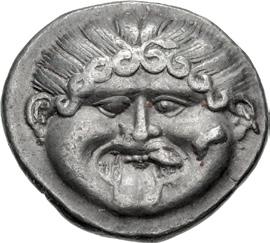



164. MACEDON, Neapolis. Circa 375-350 BC. AR Hemidrachm (15mm, 1.83 g, 9h). Facing gorgoneion with protruding tongue / Head of nymph right, hair in thin band and wearing necklace; @-E-o-π clockwise around. AMNG III/2, 11; HGC 3, 586; SNG ANS 439; Boston MFA 566 = Perkins 107 (this coin). Old cabinet tone. Near EF. ($500)
Ex Museum of Fine Arts, Boston Collection [acc. no. 00.135] (Numismatic Fine Arts VIII, 6 June 1980), lot 103; Catharine Page Perkins Collection (acquired for the museum by E. P. Warren from Perkins in 1900).



165. MACEDON, Sermyle. Circa 500-470 BC. AR Tetradrachm (28mm, 16.61 g). Attic standard. Warrior, holding spear aloft in right hand, on horseback right; ßE∞-µ¨Ò-5-Ao˜ around, pellet to left; below, hound running right; all on three ground lines, the middle composed of pellets / Quadripartite incuse square. AMNG III/2, 1 var. (no hound); Liampi pl. 24, 24; HGC 3, 661 var. (same); SNG ANS 721 var. (no pellet); SNG Spencer 125; Asyut 219. Lightly toned, traces of find patina, patches of granularity. Near EF. Very rare, and exceptional for issue. ($10,000)
Ex Leu 71 (24 October 1997), lot 131.
Very little is known of the early history of Sermyle. During the Greco-Persian Wars, the city supplied troops and ships to the Persians, and afterward became a member of the Thracian District of the Delian League. During the Peloponnesian War, many of their citizens were killed by the Peloponnesians, and Sermyle was turned over to the Chalkidians until the Peace of Nikias, whereafter the city appears under Athenian control. In the 4th century BC, Sermyle joined the Chalkidian League, and was apparently one of the cities destroyed by Philip II, as it disappears from the historical record after 348 BC. The coinage of the city was small, with a short issue of silver tetradrachms and fractions in the early 5th century, and a limited issue of bronze in the early 4th BC.
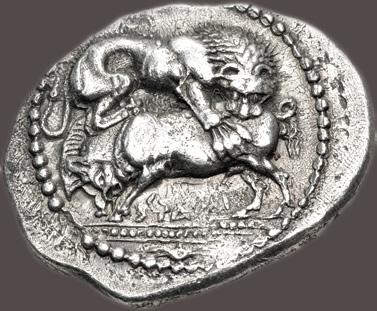


166. MACEDON, Stagira. Circa 500-480 BC. AR Tetradrachm (31mm, 16.87 g). Attic standard. Lion attacking right, on the back and biting into the hindquarter of a boar standing left below; ßtÅ©5 and three ground lines, the middle composed of pellets, below; floral ornament in exergue / Quadripartite incuse square. Cahn, Skione 10 var. = Cahn, Tetradrachmon 1 var. = Käpelli F12 var. (pellets, no ornament, ethnic above); otherwise, unpublished. Lightly toned, granular surfaces, minor doubling on obverse. Near EF. Struck on a broad flan. Apparently unique with ethnic below and floral ornament. ($20,000)




167. KINGS of MACEDON. Philip II. 359-336 BC. AR Drachm (15.5mm, 3.56 g, 9h). Pella mint. Struck circa 359355/4 BC. Head of Herakles right, wearing lion skin / f5¬5ππoU, Philip, wearing kausia, chlamys, tunic, and boots, raising right hand and holding rein in left, on horseback left; below, spearhead left above '. Le Rider Group IA, 45 (D28/R37); SNG Copenhagen 567 (same rev. die); Traité pl. CCCIX, 18 (same obv. die). Typical granular surfaces, a few minor scrapes, a little off center on reverse. Good VF. Very rare, five noted by Le Rider, this coin the only example in CoinArchives. ($750)
Ex Numisfitz 2 (4 June 2023), lot 70 (hammer €1300).
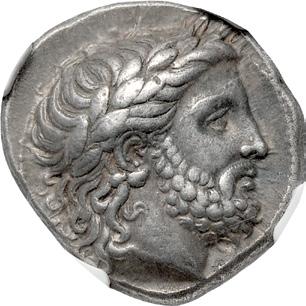

168. KINGS of MACEDON. Philip II. 359-336 BC. AR Tetradrachm (24mm, 14.41 g, 1h). Pella mint. Struck circa 342/1337/6 BC. Head of Zeus right, wearing laurel wreath / f5¬5π-πoU, nude youth, holding palm frond in right hand, rein in left, on horseback right; thunderbolt below, @ in exergue. Le Rider Group II.A.2, 238 (D133/R192); SNG ANS 385–95; Boston MFA 649 (same dies). In NGC encapsulation 6557416-004, graded Ch VF, Strike: 5/5, Surface: 4/5, Fine Style. ($1000)
Ex Sovereign Rarities 7 (21 September 2022), lot 33; Baldwin’s 33 (6 May 2003), lot 9.



169. KINGS of MACEDON. temp. Philip II – Alexander III. Circa 340/36-328 BC. AV Stater (17mm, 8.60 g, 12h). In the name and types of Philip II. Amphipolis mint. Head of Apollo right, wearing laurel wreath / f5¬5ππoU, charioteer, wearing long chiton, holding kentron in right hand, reins in left, driving fast biga right; barley grain below. Le Rider Group II, 26 (D10/ R18); SNG ANS 244; Ars Classica XVI, 1013 = Locker Lampson 157 (same rev. die). Tiny deposit on obverse, minor scratch on reverse. Near EF. ($2000)
From the 1930’s Collection of Robert W. Hubel of Michigan.



170. KINGS of MACEDON. Alexander III ‘the Great’. 336-323 BC. AV Stater (19mm, 8.52 g, 5h). Lampsakos mint. Struck under Kalas or Demarchos, circa 328/5-323 BC. Head of Athena right, wearing crested Corinthian helmet decorated with coiled serpent, single-pendant earring, and necklace / ŬE$Å@droU, Nike, wearing long chiton, standing left, holding wreath in extended right hand and cradling stylis in left arm; conjoined horse foreparts in left field, ∂ below left wing. Price 1358; ADM II Series V, 103a–c (same obv. die); SNG Saroglos 121. A few light marks and scratches, a little die rust on obverse, minor die shift on reverse. Good VF. ($2000)
Ex Classical Numismatic Group Electronic Auction 330 (9 July 2014), lot 15.



171. KINGS of MACEDON. Alexander III ‘the Great’. 336-323 BC. AV Stater (18mm, 8.59 g, 12h). Miletos mint. Struck under Philoxenos, circa 325-323 BC. Head of Athena right, wearing crested Corinthian helmet decorated with coiled serpent; thunderbolt below neck / ŬE$Å@droU, Nike, wearing long chiton, standing left, holding wreath in extended right hand and cradling stylis in left arm; M in left field. Price 2077; ADM I Series I, 3b (same dies); ANS inv. 1944.100.31783 (same dies); Berlin obv. no. 18250115 (same dies); Hermitage Sale II 664 (same dies). In NGC encapsulation 5771640-004, graded AU, Strike: 5/5, Surface: 3/5, edge marks. ($2500)



172. KINGS of MACEDON. Alexander III ‘the Great’. 336-323 BC. AV Stater (17.5mm, 8.60 g, 6h). Sardes mint. Struck under Menander, circa 330/25-324/3 BC. Head of Athena right, wearing crested Corinthian helmet decorated with coiled serpent, single-pendant earring, and pearl necklace / ŬE$Å@droU, Nike, wearing long chiton, standing left, holding wreath in extended right hand and cradling stylis in left arm; in left field, coiled serpent left. Price 2532; ADM I Series III, 15 (same dies); SNG Berry 166; SNG Copenhagen 649. Underlying luster, minor marks, small scrape on reverse. Near EF. ($3000)
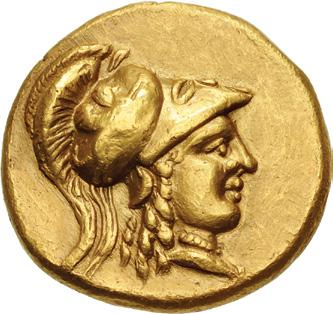



173. KINGS of MACEDON. Alexander III ‘the Great’. 336-323 BC. AV Stater (18mm, 8.55 g, 11h). Tyre mint. Struck under Menes. Dated RY 24 of Azemilkos (326/5 BC). Head of Athena right, wearing crested Corinthian helmet decorated with griffin, and pearl necklace / ŬExÅ@d-roU, Nike, wearing long chiton, standing left, holding wreath in extended right hand and cradling stylis in left arm; ‹‹‹‹( (date) and )o (Phoenician ‘K [for ‘Ozmilk]) below right wing. Price 3259 (Ake; same dies as illustration); Newell, Dated 19 (dies E/α); Rouvier –; HGC 10, 1 (Ake); DCA2 934; ANS Inv. 1944.100.35268 (same dies). Toned, a few edge marks, fields smoothed. Good VF. Extremely rare, only two noted by Newell (BM and Vienna), one additional in Pella database (ANS), none in ANS photofile, and this is the only example in CoinArchives. ($2000)
From the Michael Rogal Collection. Ex Dr. Patrick H. C. Tan Collection (Triton XX, 10 January 2017), lot 109; G. Hirsch 267 (5 May 2010), lot 165; G. Hirsch 264 (25 November 2009), lot 177.




174. KINGS of MACEDON. temp. Alexander III – Philip III. Circa 325-319 BC. AV Stater (18.5mm, 8.61 g, 9h). In the name and types of Alexander III. Amphipolis mint. Struck under Antipater. Head of Athena right, wearing crested Corinthian helmet decorated with coiled serpent, and pearl necklace / ŬE$Å@droU, Nike, wearing long chiton, standing left, holding wreath in extended right hand and cradling stylis in left arm; thunderbolt in left field. Price 164; Troxell, Studies, p. 127 and pl. 25, M; SNG Saroglos 96–8. Lustrous. EF. Struck from fresh dies. ($4000)




175. KINGS of MACEDON. temp. Alexander III – Kassander. Circa 325-310 BC. AV Stater (18mm, 8.60 g, 4h). In the name and types of Philip II. Uncertain mint in Macedon. Head of Apollo right, wearing laurel wreath; pellet behind neck / f5¬5ππoU, charioteer, wearing long chiton, holding kentron in extended right hand, reins in left, driving galloping biga right; thunderbolt below. Le Rider 628 (D260/R245 [Pella mint]); SNG ANS 205 (same obv. die); SNG Lockett 1402 (same obv. die). Minor mark on edge. EF. Attractive style. Rare. ($4000)
From the Michael Rogal Collection. Ex Patrick H.C. Tan Collection (Classical Numismatic Group 97, 17 September 2014), lot 92; Gemini VII (9 January 2011), lot 250; Classical Numismatic Group 69 (8 June 2005), lot 146.
Le Rider’s attribution of his Group IIIC gold to Pella was tentative. He noted that the overall style was unlike other Pella issues, and the lack of these staters in hoards of other Pella issues was troubling. These gold issues find parallels in the tetradrachm coinage of Alexander that Price assigned to Pella, but he did not provide any analysis to support their attribution to that mint. As noted by N.J. Moore (The Lifetime and Early Posthumous Coinage of Alexander the Great from Pella [Princeton University, 1984], Appendix I), Newell placed these coins at an “uncertain mint in Macedon.” Moore’s analysis of the hoards of the parallel Alexanders is most persuasive in discounting both Pella and Amphipolis as a possible mint. Noting the overall “Macedonian” style of many of these coins, she preferred a return to Newell’s original attribution.
Rare



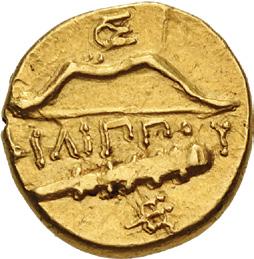
176. KINGS of MACEDON. Philip III Arrhidaios. 323-317 BC. AV Quarter Stater (10mm, 1.75 g, 3h). In the name and types of Philip II. Pella mint. Head of Herakles right, wearing lion skin / f5¬5ππoU, bow and club; – above; below, trident head right. Le Rider Group III, 129–30 var. (unlisted dies); SNG ANS 236. Slight die wear, minor doubling on reverse, mark on edge. Good VF. Very rare issue with monogram, only four noted by Le Rider, this coin the only example in CoinArchives. ($1000)
From the Ramrodivs Collection. Ex Berk BBS 202 (26 October 2017), lot 15.




177. KINGS of MACEDON. Philip III Arrhidaios. 323-317 BC. AR Tetradrachm (26.5mm, 17.20 g, 3h). In the name and types of Alexander III. Pella mint. Struck under Antipater or Polyperchon, circa 323-318/7 BC. Head of Herakles right, wearing lion skin / ŬE$Å@droU, Zeus Aëtophoros seated left; in left field, rose surmounted by bee right. Price 206; Moore 27–8 var. (dies 10/– [unlisted rev. die]); SNG Berry 204; SNG Copenhagen 709; ANS inv. 1944.100.29322 (same obv. die). Attractive light iridescent tone over lustrous surfaces, a few light marks on reverse. EF ($2000)
Ex Collection of an Aesthete; Gemini XI (12 January 2014), lot 35.

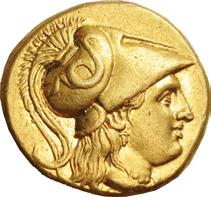


178. KINGS of MACEDON. Philip III Arrhidaios. 323-317 BC. AV Stater (18mm, 8.49 g, 12h). In the types of Alexander III. Abydos mint. Struck under Leonnatos, Arrhidaios, or Antigonos I Monophthalmos. Head of Athena right, wearing crested Corinthian helmet decorated with coiled serpent, and pearl necklace / f5¬5ππoU, Nike, wearing long chiton, standing left, holding wreath in extended right hand and cradling stylis in left arm; in left field, 9 above pentagram; cornucopia below left wing. Price P36; ADM II Series XI, 162 (same dies); SNG Saroglos 865. Underlying luster, tiny bump on obverse, minor mark and light scrape on edge. EF. Well centered and struck. ($3000)

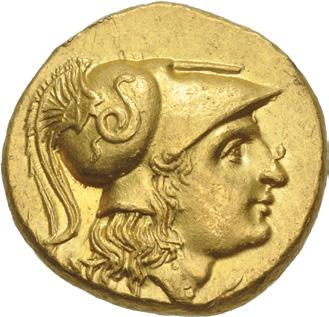

179. KINGS of MACEDON. Philip III Arrhidaios. 323-317 BC. AV Stater (18mm, 8.56 g, 11h). In the name and types of Alexander III. Abydos mint. Struck under Leonnatos, Arrhidaios, or Antigonos I Monophthalmos. Head of Athena right, wearing crested Corinthian helmet decorated with coiled serpent, and pearl necklace / ŬE$Å@droU, Nike, wearing long chiton, standing left, holding wreath in extended right hand and cradling stylis in left arm; in left field,  (sic) above pentagram; shell below left wing. Price 1525 var. (monogram above pentagram); ADM II Series XVII, 335a–d var. (same; same obv. die); Dewing 1149 var. (same; same obv. die). A few marks, minor die break and a couple of light scrapes at edge on obverse. Near EF. ($2000)



180. KINGS of MACEDON. Philip III Arrhidaios. 323-317 BC. AV Stater (18mm, 8.56 g, 11h). In the types of Philip II. Magnesia on the Maeander mint. Struck under Menander or Kleitos, circa 322-319 BC. Head of Apollo right, wearing laurel wreath / f5¬5ππoU, charioteer, wearing long chiton, holding kentron in right hand, reins in left, driving fast biga right; bee below, spear head in exergue. Thompson, Philip 3; Le Rider –; SNG ANS 310 corr. (Thompson 3, not 2; same obv. die); SNG München 98; CNG 106, 193 = CNG 43, 230 = Ponterio 86, 1230 (same dies). Iridescent tone, a few light scratches and minor marks. Near EF. ($2500)
From the 1930’s Collection of Robert W. Hubel of Michigan.



181. KINGS of MACEDON. Philip III Arrhidaios. 323-317 BC. AV Stater (17.5mm, 7.82 g, 12h). In the types of Philip II. Magnesia on the Maeander mint. Struck under Menander or Kleitos, circa 323-319 BC. Head of Apollo right, wearing laurel wreath, with the features of Alexander III / f5¬5ππoU, charioteer, wearing long chiton, holding kentron in right hand, reins in left, driving fast biga right; cornucopia below. Thompson, Philip 6 (same dies as illustration); Le Rider p. 278, 24; SNG ANS 316 (same dies). Scrapes and marks, edge filed (likely to fit a bezel). Good VF. ($4000)
From the Henry A. Sauter Collection.

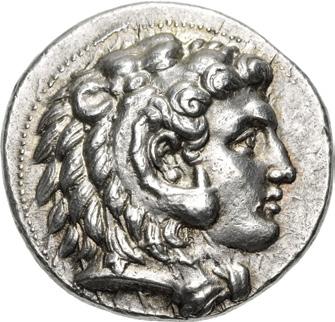


182. KINGS of MACEDON. Philip III Arrhidaios. 323-317 BC. AR Tetradrachm (27mm, 17.12 g, 8h). In the name and types of Alexander III. Uncertain mint in Cilicia. Struck under Philotas or Philoxenos. Head of Herakles right, wearing lion skin / ∫Ås5¬EWs ŬE$Å@droU, Zeus Aëtophoros seated left; wreath in left field, d5 below throne. Price 2949 (Side[?] mint); ANS inv. 1944.100.33295 (same dies). Lovely iridescent tone over lustrous surfaces, tiny die break on obverse, slightly off center on reverse. EF. High relief with excellent detail throughout. A wonderful coin in hand. ($2000)



183. KINGS of MACEDON. Philip III Arrhidaios. 323-317 BC. AV Stater (18mm, 8.53 g, 3h). In the types of Alexander III. Babylon mint. Struck under Archon, Dokimos, or Seleukos I, circa 323-318/7 BC. Head of Athena right, wearing crested Corinthian helmet decorated with a coiled serpent / ∫Ås5¬EWs f5¬5-ππoU, Nike, wearing long chiton, standing left, holding wreath in extended right hand and cradling stylis in left arm; wheel and ‰ below left wing. Price P193 var. (position of wheel); CNG 90, lot 468 (same dies); Lanz 144, lot 156 (same dies). Underlying luster. EF. Very rare variety. ($3000)
From the Michael Rogal Collection. Ex Triton XVII (7 January 2014), lot 157; Semon Lipcer Collection; CNG Inventory 783950 (January 2007).

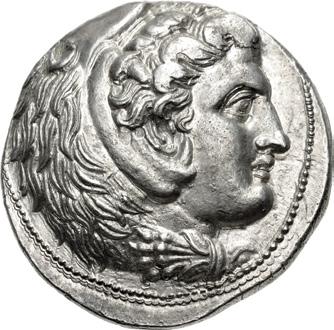


184. KINGS of MACEDON. Antigonos I Monophthalmos. As Strategos of Asia, 320-306/5 BC. AR Tetradrachm (26mm, 17.11 g, 7h). In the name and types of Alexander III. Susa mint. Struck under Aspesias, Satrap of Susiana, circa 316311 BC. Head of Herakles right, wearing lion skin / ∫Å%5¬EW% ŬE$Å@droU, Zeus Aëtophoros seated left; wreath in left field; below throne, Å5 above strut, Z below. Price 3857. Underlying luster, slight doubling. Superb EF. Impressively high relief and fine style. ($1500)




185. KINGS of MACEDON. Kassander. As regent, 317-305 BC. AR Tetradrachm (23mm, 14.23 g, 1h). In the name and types of Philip II. Amphipolis mint. Struck circa 316-311 BC. Head of Zeus right, wearing laurel wreath / f5¬5π-πoU, nude youth, holding palm frond in left hand and rein in right, on horseback right; aphlaston below, À below raised foreleg. Troxell, Studies, Group 9, 323-5; Le Rider pl. 46, 17–8; HGC 3, 988; SNG ANS 738-46. Lustrous, a little die rust on obverse. EF. ($1000)



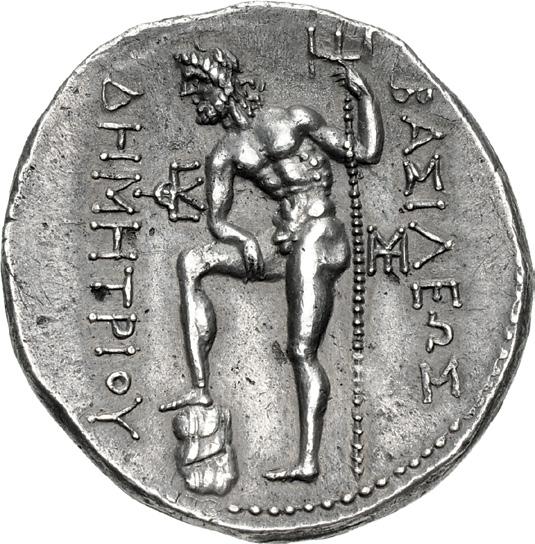
186. KINGS of MACEDON. Demetrios I Poliorketes. 306-283 BC. AR Tetradrachm (29mm, 16.98 g, 12h). Amphipolis mint. Struck circa 289-288 BC. Diademed and horned head right / ∫Ås5¬EWs d˙µ˙tr5oU, Poseidon Pelagaios, nude, standing left, right foot propped on rock, holding trident in left hand, right arm resting on leg; : to inner left, M to inner right. Newell 115, dies CV/196; HGC 3, 1014b. Old collection tone with slight iridescence, light scuff and minor doubling on obverse. Near EF. ($2000)


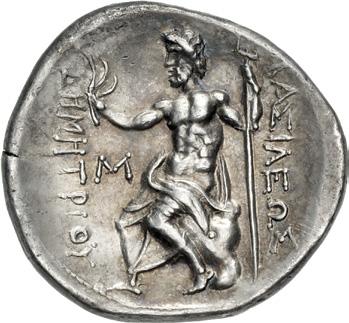

187. KINGS of MACEDON. Demetrios I Poliorketes. 306-283 BC. AR Tetradrachm (28.5mm, 16.87 g, 10h). Uncertain mint in Macedon. Struck circa 291-290 BC. Diademed and horned head right / ∫Ås5¬EWs d˙µ˙tr5oU, Poseidon Pelagaios, draped from the waist, seated left on rock, holding aphlaston in extended right hand and grounded trident in left;  to inner left. Newell 135, dies CXXXII/– (unlisted rev. die); HGC 3, 1013; Jameson 1006 (same obv. die). Iridescent tone, underlying luster, minor marks, tiny spot of die rust on obverse. EF. ($1500)
Ex Heritage 3088 (6 November 2020), lot 34029.



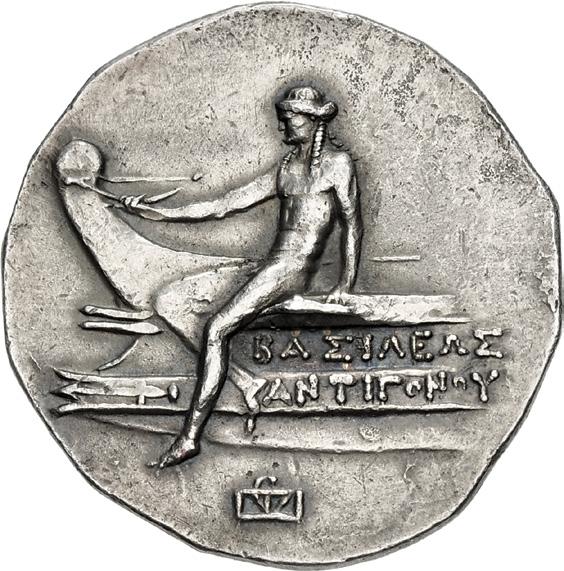
188. KINGS of MACEDON. temp. Antigonos II Gonatas – Demetrios II Aitolikos. 246/5-229 BC. AR Tetradrachm (31mm, 17.02 g, 12h). Amphipolis or Pella mint. Head of Poseidon right, wearing wreath of marine plants / Apollo, testing bow in extended right hand, seated left on prow left inscribed ∫Å%5¬EW% Å@t5˝o@oU; f below. TEA Period III, Group 44, 220 (O33/R210); HGC 3, 1051 (Antigonos Doson); SNG Alpha Bank 1047 (same obv. die); SNG Lockett 1257 (same obv. die); SNG München 1123 (same obv. die). Attractively toned, slight die wear, minor marks. Near EF. ($4000)
From the Columbus Collection. Ex Warden Numismatics inventory 1923W3978D4 (2002).
Antiogonos Gonatas was the son of Demetrios Poliorketes and grandson of Antigonos Monophthalmos (“one-eyed”). During the wars of succession, he participated with his father on campaign in Greece and Macedon. Upon his father’s death in 283 BC, Antigonos assumed the royal title and resolved to retake the Macedonian throne. Before he was able to invade Macedonia, in 279 BC, a huge wave of Galatians moved into the region from the north and ravaged as far south as Delphi. In 277 BC, Antigonos took his army north and decisively defeated the Celts in a victory that brought him recognition and acclaim across the Aegaean. Antigonos now seized the empty Macedonian throne and reigned successfully for nearly 30 years.



189. KINGS of MACEDON. Antigonos III Doson. 229-221 BC. AR Tetradrachm (32mm, 17.04 g, 11h). In the types of Antigonos II Gonatas. Amphipolis mint. Struck circa 271/68-260/55 BC. Horned head of Pan left, lagobolon over shoulder, in the center of a Macedonian shield / ∫Ås5¬EWs Å@t5˝o@oU, Athena Alkidemos advancing left, shield decorated with aegis on left arm, preparing to cast thunderbolt held aloft in right hand; crested Macedonian helmet to inner left, t5 to inner right. TEA Period IV, Group 7, 33 (O11/R31); HGC 3, 1042; SNG Berry 359 (same dies). Lightly toned, trace deposits, indications of undertype. Good VF. ($750)
From the Henry A. Sauter Collection, purchased from Superior Stamp & Coin.



190. KINGS of MACEDON. Perseus. 179-168 BC. AR Tetradrachm (31mm, 16.75 g, 1h). Attic standard. Amphipolis mint. Struck circa 174-171 BC. Diademed head right / ∫Å%5-¬EW% ∏Er-%EW%, eagle standing right on thunderbolt; Q above, · to right, Å@ between legs; all within oak wreath; below, plow left. De Luca, Tetradrachms 86b (O22/R77 – this coin); Mamroth, Perseus 17; HGC 3, 1093. In NGC encapsulation 6642240-004, graded Ch AU, Strike: 5/5, Surface: 3/5, Fine Style. Well struck and high relief. Very rare issue with these control marks, struck from one obverse and three reverse dies. ($2000)
Ex Giessener Münzhandlung 56 (7 October 1991), lot 192.
The last independent king of Macedon, Perseus was the eldest son of the dynamic but disastrous Philip V. Inheriting the throne in 179 BC, Perseus skillfully rebuilt the Macedonian army and a network of marriage alliances during the first years of his reign, which the Romans watched with rising alarm. In 172 BC the Romans sent a commission to Macedon and demanded that Perseus essentially end Macedonian independence and become a Roman vassal. Perseus angrily rebuffed their demands, sparking the outbreak of the Third Macedonian War in 171 BC. For a time, Perseus employed guerrilla tactics which gave him the initiative and kept the Romans on their heels. An initial battle at Callinicus in Thessaly was a narrow Macedonian victory, leading Perseus to become overconfident of Macedonian arms and his own generalship. Like his father, Perseus chose to risk all in a single pitched battle at Pydna in 168 BC but lost badly to the Roman general Lucius Aemilius Paullus. With his army shattered, Perseus surrendered and was taken to Rome, where he was led in chains in Paullus’ triumph. Accounts of his remaining life differ; according to one account, he remained imprisoned until he died after two years of abuse and neglect. But another tradition holds that he was allowed to live in comfortable exile at Alba Fucens outside of Rome, where his son Alexander became a metalworker and a Roman public notary. The Macedonian Kingdom was divided into four theoretically autonomous Republics which were soon subsumed into direct Roman rule.
The coinage of Perseus is one of the more attractive of the Hellenistic series, with strong portraiture depicting Perseus as a determined ruler with a piercing gaze and a stubbly beard. The reverse depicts the Macedonian eagle on a thunderbolt. Two weight standards are recorded, with the weight of the tetradrachm being reduced by about 10% after the war with Rome commenced, likely to stretch the silver supply.



191. KINGS of MACEDON. Perseus. 179-168 BC. AR Tetradrachm (32mm, 15.47 g, 12h). Reduced Attic standard. Amphipolis mint. Struck circa 171-168 BC. Diademed head right / ∫Å%5-¬EW% ∏Er-%EW%, eagle standing right on thunderbolt; 9 above, Q to right, Y between legs; all within oak wreath; below, plow left. De Luca, Tetradrachms 219f (O46/R201 – this coin); Mamroth, Perseus 25; HGC 3, 1094; SNG Ashmolean 3276 (same dies). Faintly toned, typical minor marks. EF. ($1500)
Ex Peus 434 (24 April 2023), lot 165; Gorny & Mosch 152 (9 October 2006), lot 1338.


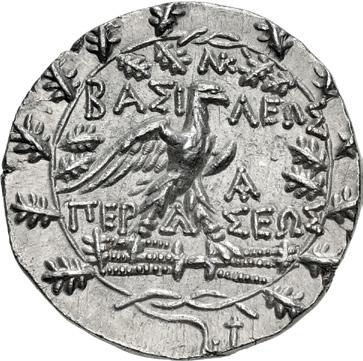

192. KINGS of MACEDON. Perseus. 179-168 BC. AR Tetradrachm (30mm, 15.37 g, 12h). Reduced Attic standard. Amphipolis mint. Struck circa 171-168 BC. Diademed head right / ∫Å%5-¬EW% ∏Er-%EW%, eagle standing right on thunderbolt; 1 above, Q to right, h between legs; all within oak wreath; below, plow left. De Luca, Tetradrachms 303 (O63/R258); Mamroth, Perseus 20b; HGC 3, 1094; SNG Ashmolean 3277 (same obv. die). Some die wear on obverse. EF. ($2000)
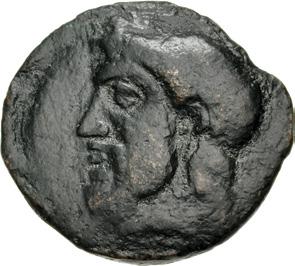

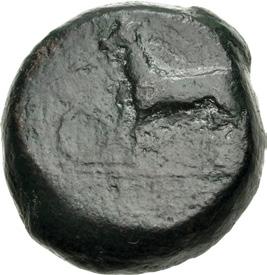
193. ISLANDS off ILLYRIA, Pharos. Pharos. Circa 350-320 BC. Æ (24mm, 14.01 g, 8h). Bearded head of Zeus left, wearing laurel wreath / Goat standing left; coiled serpent to left, [fÅr5W@ in exergue]. Visonà, Greek-Illyrian Ph9 (same dies); HGC 6, 18; SNG Morcom 949 (this coin). Dark green-brown patina. Near VF. Very rare. ($750)
From the John Morcom Collection.


194. KINGS of ILLYRIA. Monounios. Circa 280-270 BC. AR Stater (20mm, 10.64 g, 3h). Dyrrhachion mint. Cow standing right, looking back at suckling calf standing left below; „ (monogram of Monounios) laterally above / Double stellate pattern divided by two lines, all in double linear square; d-U-r and club around; all within linear circle. Meta Series II, dies D104/R161; Meadows, CH (forthcoming), 187 (this coin); Gjongecaj em. 1, 165-8 (same dies); Maier –; HGC 3, 66 (same obv. die as illustration); SNG Copenhagen 425 (same dies); BMC 21 (same dies); Weber 2977 (same dies). Slight die wear, a touch off center on obverse. Good VF. Very rare. ($1000)
From the Michael Rogal Collection. Ex Classical Numismatic Group 91 (19 September 2012), lot 160.




195. EPEIROS, Federal coinage (Epirote Republic). Circa 148-50 BC. AR Drachm (21.5mm, 5.05 g, 7h). Bearded head of Zeus right, wearing laurel wreath; i to left / Eagle, with closed wings, standing right on thunderbolt; Å∏E5-rWtÅ@ at sides; all within wreath. Franke Group II, Series 2, 52–3 var. (V–/R38 [unlisted obv. die]); HGC 3, 171; BM 1866,1201.1458 (same rev. die). Bright surfaces, minor flan flaw on reverse. Superb EF. ($750)




196. THESSALY, Ainianes. Circa 80s-40s BC. AR Trihemidrachm or Stater (23mm, 7.47 g, 12h). Zenarchos, magistrate. Head of Athena Parthenos right, wearing triple crested Attic helmet decorated with tendril, Pegasos, and four horse foreparts; $(@Årco% to left / The hero Phemios, wearing scabbard with sword, standing left, head right, shooting sling to right; two spears in background to left, Å5@5-Å@W@ at sides. Callataÿ, Argent, Type 2, 68–9 var. (O4/R– [unlisted rev. die]); BCD Thessaly –; HGC 4, 41; BM inv. 1947,0406.206 (same obv. die); de Luynes 1824 (same obv. die). Lightly toned, slightly off center on reverse. Near EF. Extremely rare with this magistrate, only two examples noted by Callataÿ. ($2000)
Ex Peus 393 (31 October 2007), lot 172.


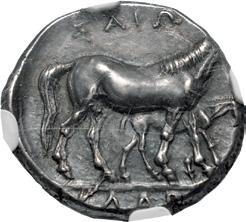
197. THESSALY, Larissa. Circa 380-365 BC. AR Drachm (19mm, 6.16 g, 11h). Head of the nymph Larissa facing slightly left, wearing ampyx, triple-pendant earring, and necklace / Mare standing right; below, in background to right, foal standing right; ¬År[5]-sÅ5W[@] above and below. L&S Series 6, Type C, dies O22/R1; BCD Thessaly II 297; HGC 4, 444; SNG Blackburn 599 (same dies); Jameson 1093 (same dies). In NGC encapsulation 6290605-018, graded AU, Strike: 4/5, Surface: 5/5, Fine Style. ($1000)
Ex Mark & Lottie Salton Collection (Stack’s Bowers Galleries, 14 January 2022), lot 4218.
Ex BCD Collection


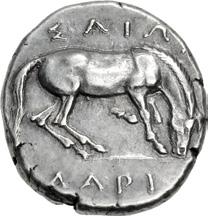
198. THESSALY, Larissa. Circa 365-356 BC. AR Drachm (19mm, 6.07 g, 5h). Head of the nymph Larissa facing slightly left, hair in ampyx, wearing linear necklace / Horse standing right, preparing to lie down; sÅ5W@/¬År5 above and below. Lorber, Beginning, Series 6, Head Type 10, dies O20/R2; BCD Thessaly II 312 (this coin); HGC 4, 452; ANS inv. 1944.100.16971–2 (same dies). Attractive light toning, slight die shift on reverse. EF. Well centered strike from dies of fine style. ($1000)
From the Columbus Collection. Ex Rauch 105 (16 November 2017), lot 77; BCD Collection (Triton XV, 3 January 2012), lot 312.



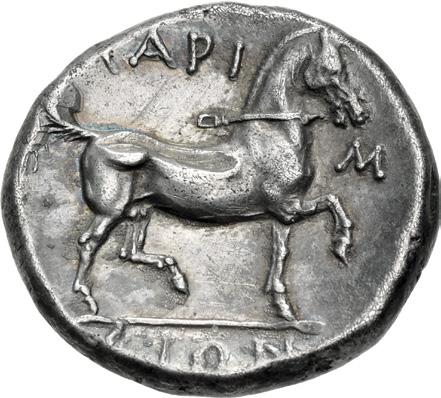
199. THESSALY, Larissa. Circa 356-342 BC. AR Stater (24mm, 12.20 g, 11h). Head of the nymph Larissa facing slightly left, hair in ampyx, wearing necklace / Bridled horse prancing right; ¬År5-s-[Å5W@] around. L-S Type 2, Series A, dies O3/R4; BCD Thessaly II 306 (same obv. die); HGC 4, 409; Jameson 1092 = Rhousopoulos 1320 (same dies). Iridescent tone, traces of horn silver, some minor scratches, flaw on reverse. Near EF. ($3000)
From the Gerald F. Borrmann (Northern California Gentleman) Collection, purchased from Dr. Arnold Saslow, 1987.
Referenced in Lavva




200. THESSALY, Pharsalos. Late 5th-mid 4th century BC. AR Hemidrachm (15mm, 3.07 g, 5h). Obverse die signed by Telephantos. Head of Athena right, wearing crested Attic helmet with raised cheek guard; behind neck, tiny t above 5 π / Head of horse right; f-Å-r-s around; all within incuse circle. Lavva 121b (V57/R69 – this coin); BCD Thessaly II 668.3 (same dies); HGC 4, 635. Lovely old iridescent tone, slight double strike on reverse. Near EF. ($1000)
Ex Tradart (12 December 1991), lot 108.



201. AKARNANIA, Anaktorion. Circa 350-300 BC. AR Stater (18mm, 8.52 g, 5h). Pegasos flying left; 5 below / Head of Athena left, wearing Corinthian helmet with neck guard; ¬Us5 above; tiny ¬, 5, and thymiaterion to right. ImhoofBlumer, Akarnaniens –; Pegasi 70 corr. (tiny ¬ not noted; same obv. die); BCD Akarnania 106 var. (no tiny ¬); HGC 4, 763. In NGC encapsulation 6290626-009, graded Ch XF★, Strike: 5/5, Surface: 5/5. ($1500)
From the Michael Rogal Collection. Ex Triton XXVI (10 January 2023), lot 149; Mark & Lottie Salton Collection (Stack’s Bowers Galleries, 14 January 2022), lot 4218.



202. AKARNANIA, Argos Amphilochikon. Circa 340-300 BC. AR Stater (20.5mm, 8.46 g, 5h). Pegasos flying left; Å below / Head of Athena left, wearing Corinthian helmet with neck guard; År˝E5 above, to right, crested Corinthian helmet left. Pegasi 11; Imhoof-Blumer, Akarnaniens 12; BCD Akarnania 132–3; HGC 4, 783. A couple of minor flan flaws, hairlines. Near EF. ($750)


203. AKARNANIA, Argos Amphilochikon. Circa 340-300 BC. AR Stater (21mm, 8.35 g, 12h). Pegasos flying left; Å below / Head of Athena left, wearing Corinthian helmet with neck guard; d5 and shield with strap to right. Pegasi 19; ImhoofBlumer, Akarnaniens 16; BCD Akarnania –; HGC 4, 756. Hairlines. Good VF. ($750)




204. AKARNANIA, Leukas. Circa 440-400 BC. AR Trihemiobol (10mm, 0.64 g, 12h). Pegasos flying right; ¬ below / Facing gorgoneion with protruding tongue; t-r-[5]-˙ (mark of value) around; all within incuse square. Imhoof-Blumer, Akarnaniens 12; BCD Akarnania –; HGC 4, 848; Traité IV 94. Lightly toned, granular surfaces, slightly off center. EF. Exceptional for issue. Extremely rare early issue, missing from the BCD Collection. ($500)

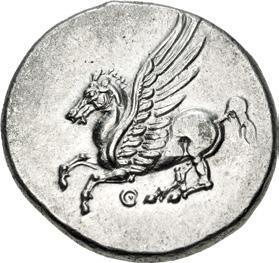


205. AKARNANIA, Thyrrheion. Circa 320-280 BC. AR Stater (23mm, 8.37 g, 11h). Pegasos flying left; Q below / Head of Athena left, wearing Corinthian helmet with neck guard, and pearl necklace; Q-U flanking neck, earring with pendants to right. Pegasi 10; Imhoof-Blumer, Akarnaniens 5; BCD Akarnania 371; HGC 4, 919. Bright surfaces, hairlines. EF. Well centered and struck. ($1000)

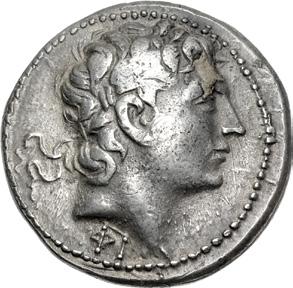


206. AITOLIA, Aitolian League. Circa 220-205 BC. AR Didrachm (24.5mm, 10.51 g, 4h). Head of Apollo right, wearing laurel wreath; f5 below / Aitolos standing left, kausia hung around neck and sword slung at waist, holding spear in right hand, right foot set on rock, leaning on raised right knee; Ó to left. Tsangari 698a (D18/R47 – this coin, illustrated); BCD Akarnania 440; HGC 4, 942; SNG Berry 567; Hunterian 3; Weber 3123. Toned, underlying luster, some die wear, deposit and light scuff on obverse, minor die shift on reverse. Good VF. ($1000)
Ex Lanz 36 (21 April 1986), lot 259.


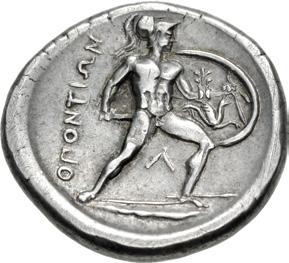
207. LOKRIS, Lokri Opuntii. Circa 360-350 BC. AR Stater (24mm, 12.12 g, 6h). Head of Persephone left, wearing wreath of grain ears, triple-pendant earring, and pearl necklace / Ajax, nude but for crested Corinthian helmet, holding sword in right hand, shield decorated with palmette and griffin on left arm, advancing right on rocks; oπo@t5W@ to left, ¬ and broken spear below. H&D Group 16, 131b (O20A/R44) = BCD Lokris 456.4 (this coin); HGC 4, 992; BMC 32 (same dies). Old collection tone, with iridescence around the devices, die rust on obverse. Good VF. ($2000)
From the Gerald F. Borrmann (Northern California Gentleman) Collection. Ex BCD Collection (Numismatica Ars Classica 55, 8 October 2010), lot 456.4; Spink & Gallerie des Monnaies (10 October 1977), lot 177.



208. BOEOTIA, Federal Coinage. Circa 395-387 BC. AR Stater (22mm, 12.25 g). Boeotian shield / Amphora; above, club right; ∫o-5W across field. BCD Boiotia 17; HGC 4, 1163; SNG Copenhagen 169; BMC 45. In NGC encapsulation 6290616-003, graded AU, Strike: 5/5, Surface: 5/5, flan flaw. ($1500)
Ex Mark & Lottie Salton Collection (Stack’s Bowers Galleries, 14 January 2022), lot 4237.



209. BOEOTIA, Thebes. Circa 425-395 BC. AR Stater (20mm, 12.12 g). Boeotian shield / Bearded head of Dionysos right, wearing ivy wreath; Q-E downward to left; all within shallow incuse square. BCD Boiotia 436 var. (club on obv.); Myron Hoard pl. A, 35 var. (same); HGC 4, 1326; CNG E-166, lot 37 (same rev. die). Faintly toned, tiny flan flaw on obverse. Near EF. Well struck on a broad flan. ($3000)
From the Michael Rogal Collection. Ex Triton XVII (7 January 2014), lot 206; G. Hirsch 280 (8 February 2012), lot 4255.

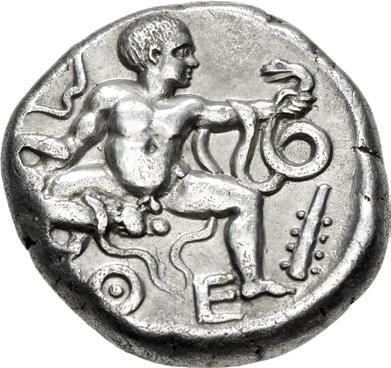

210. BOEOTIA, Thebes. Circa 425-395 BC. AR Stater (21.5mm, 11.78 g). Boeotian shield / The Herakliskos Drakonopnigon: The infant Herakles seated facing, head right, strangling two serpents, one held in each hand; bow to left, club to right, Q-E below; all within concave incuse. BCD Boiotia 455 (same rev. die); HGC 4, 1327; SNG Copenhagen 303 (same rev. die); Gulbenkian 503 (same rev. die); McClean 5582 (same rev. die); Prospero 361 (this coin). Banker’s mark on obverse. Near EF. Rare. ($7500)
Ex Nomos 17 (26 October 2018), lot 124; Prospero Collection (New York Sale XXVII, 4 January 2012), lot 361; G. Hirsch 167 (26 September 1990), lot 334.

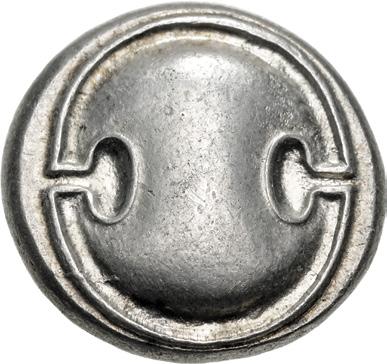

211. BOEOTIA, Thebes. Circa 368-364 BC. AR Stater (20mm, 12.29 g). Arka–, magistrate. Boeotian shield / Amphora, two ivy leaves on each handle; År-˚Å across central field; all within concave circle. BCD Boiotia 537; Hepworth 14; Myron Hoard –; HGC 4, 1332; BMC 117-9; Traité III 267. Lightly toned. EF. Struck from fresh dies. ($1000)
From the Michael Rogal Collection. Ex Triton XVII (7 January 2014), lot 208.



212. BOEOTIA, Thebes. Circa 364-362 BC. AR Stater (22mm, 12.21 g). Epa(minondas), magistrate. Boeotian shield / Amphora; Eπ-πÅ across central field; all within concave circle. BCD Boiotia 540 = Hepworth, Epaminondas pl. 3, 2 (this coin); HGC 4, 1332; SNG Lockett 1755. Toned, minor flan crack, slight die shift on reverse. Good VF. Rare. ($1500)
From the Columbus Collection. Ex BCD Collection (Triton IX, 10 January 2006), lot 540.



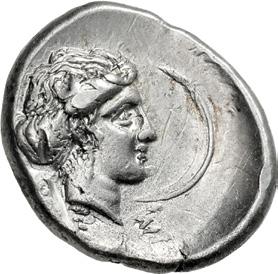
213. BOEOTIA, Thespiai. Early-mid 4th century BC. AR Hemidrachm (16.5mm, 2.91 g). Boeotian shield / Head of Aphrodite Melainis right; to right, vertical crescent facing left; QEs below. BCD Boiotia 607 (same rev. die); HGC 4, 1400; BMC 10 (same rev. die); SNG Copenhagen 404 (same rev. die); Weber 3316 (same rev. die). Underlying luster, light graffito in field on reverse. Near EF. Struck on a broad flan. ($1000)
Ex Triton XIII (5 January 2010), lot 137.
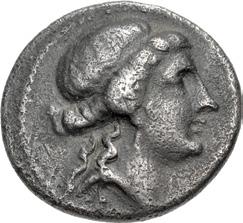


214. EUBOIA, Chalkis. Circa 180-146 BC. AR Oktobol (20mm, 5.35 g, 1h). Aristeides, magistrate. Head of the nymph Chalkis right / Eagle, wings spread, standing right on serpent coiling upward to right; cŬ˚5 to left, År5%tE5d˙% to right. Picard Em. 61, dies 1/A, 1 = BCD Euboia 240 (this coin); HGC 4, 1472. Toned, light roughness and porosity, faint cleaning scratches. VF. Apparently unique with this magistrate; this coin the only example known to Picard, and in CoinArchives. ($1000)
Ex Noble 133 (25 July 2023), lot 3636; BCD Collection (Lanz 111, 25 November 2002), lot 240, purchased from Alex G. Malloy; Knobloch FPL 33 (April 1968), no. 828; J. Schulman 239 (5 April 1965), lot 1310; Gustav Philipsen Collection (J. Hirsch XXV, 29 November 1909), lot 930.




215. ATTICA, Athens. Circa 485/0 BC. AR Tetradrachm (22mm, 17.31 g, 10h). Head of Athena right, wearing crested Attic helmet and round earring / Owl standing right, head facing; olive sprig to left, [A]QE to right; all within incuse square. Seltman Group E, unlisted dies; Asyut Group VI; Svoronos, Monnaies, pl. 2, 10; HGC 4, 1591. Faintly toned, minor porosity. Good VF. Well centered obverse, showing full crest. ($5000)
From the JTB Collection. Ex Warden Numismatics inventory 6176K6552C75 (ND); Bucephalus 7 (30 September 2022), lot 136.


216. ATTICA, Athens. Circa 465/2-454 BC. AR Tetradrachm (24mm, 17.16 g, 1h). Head of Athena right, with frontal eye, wearing earring, necklace with pendants, and crested Attic helmet decorated with three olive leaves over visor and a spiral palmette on the bowl / Owl standing right, head facing, spread tail feathers; olive sprig and crescent to left, AQE to right; all within incuse square. Starr Group V.B, 199 (O171/R188); Svoronos, Monnaies, pl. 10, 9 (same dies); HGC 4, 1596; Kraay & Hirmer 360–1. Faintly toned, a couple of tiny bumps on obverse, minor flan flaw on reverse. EF. Well centered on a broad flan. ($1000)
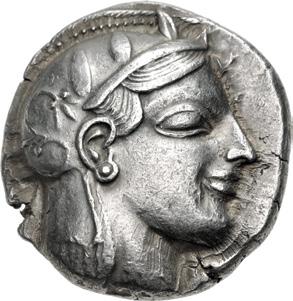



217. ATTICA, Athens. Circa 465/2-454 BC. AR Tetradrachm (23mm, 17.11 g, 9h). Head of Athena right, with frontal eye, wearing earring, necklace with pendants, and crested Attic helmet decorated with three olive leaves over visor and a spiral palmette on the bowl / Owl standing right, head facing, spread tail feathers; olive sprig and crescent to left, AQE to right; all within incuse square. Starr Group V.B, unlisted dies; Svoronos, Monnaies, pl. 10, 3–8; HGC 4, 1596; Kraay & Hirmer 360–1. Lightly toned, minor marks under tone, slight die wear on obverse. Near EF. ($1000)
From the JTB Collection.
218. ATTICA, Athens. Circa 465/2-454 BC. AR Tetradrachm (24mm, 17.18 g, 12h). Head of Athena right, with frontal eye, wearing earring, necklace with pendants, and crested Attic helmet decorated with three olive leaves over visor and a spiral palmette on the bowl / Owl standing right, head facing, spread tail feathers; olive sprig and crescent to left, AQE to right; all within incuse square. Starr Group V.B, unlisted dies; Svoronos, Monnaies, pl. 10, 3–8; HGC 4, 1596; Kraay & Hirmer 360–1. Lightly toned, underlying luster, some die rust on obverse. Near EF. ($1000)




219. ATTICA, Athens. Circa 454-404 BC. AR Tetradrachm (23.5mm, 17.21 g, 2h). Head of Athena right, with frontal eye, wearing earring, necklace, and crested Attic helmet decorated with three olive leaves over visor and a spiral palmette on the bowl / Owl standing right, head facing; olive spray and crescent to left, AQE to right; all within incuse square. Starr pl. XXIII, 1’–3’; Kroll 8; HGC 4, 1597; Dewing 1593; Gulbenkian 518. Lightly toned, underlying luster, slight die wear on obverse, trace deposits on reverse. Near EF. Well centered. Early post-454 issue. ($750)
The certain elements of the style of this and the following three tetradrachms, particularly the palmette on Athena’s helmet and the stance of the owl, suggest that this coin was among the earliest issues in the ubiquitous “frontal eye”/classical tetradrachms of the mid-late 5th century at Athens, as these features more closely resemble those found on the later groups of early-mid 5th century issues analyzed by Chester Starr.
220. ATTICA, Athens. Circa 454-404 BC. AR Tetradrachm (22.5mm, 17.18 g, 2h). Head of Athena right, with frontal eye, wearing earring, necklace, and crested Attic helmet decorated with three olive leaves over visor and a spiral palmette on the bowl / Owl standing right, head facing; olive spray and crescent to left, AQE to right; all within incuse square. Starr pl. XXIII, 1’–3’; Kroll 8; HGC 4, 1597; Dewing 1593; Gulbenkian 518. Lightly toned, underlying luster. Near EF. Well centered. Early post-454 issue. ($750)




221. ATTICA, Athens. Circa 454-404 BC. AR Tetradrachm (24mm, 17.20 g, 4h). Head of Athena right, with frontal eye, wearing earring, necklace, and crested Attic helmet decorated with three olive leaves over visor and a spiral palmette on the bowl / Owl standing right, head facing; olive spray and crescent to left, AQ[E] to right; all within incuse square. Starr pl. XXIII, 1’–3’; Kroll 8; HGC 4, 1597; Dewing 1593; Gulbenkian 518. Edge split, slightly off center on reverse. Near EF. Early post-454 issue. ($750)
222. ATTICA, Athens. Circa 454-404 BC. AR Tetradrachm (22mm, 17.18 g, 11h). Head of Athena right, with frontal eye, wearing earring, necklace, and crested Attic helmet decorated with three olive leaves over visor and a spiral palmette on the bowl / Owl standing right, head facing; olive spray and crescent to left, AQE to right; all within incuse square. Starr pl. XXIII, 1’–3’; Kroll 8; HGC 4, 1597; Dewing 1593; Gulbenkian 518. Faintly toned, underlying luster, a little die wear on obverse. EF. Well centered. Early post-454 issue. ($750)


223. ATTICA, Athens. Circa 454-404 BC. AR Tetradrachm (23.5mm, 17.20 g, 9h). Head of Athena right, with frontal eye, wearing earring, necklace, and crested Attic helmet decorated with three olive leaves over visor and a spiral palmette on the bowl / Owl standing right, head facing; olive spray and crescent to left, AQE to right; all within incuse square. Kroll 8; HGC 4, 1597; SNG Copenhagen 31; Dewing 1611–22; Gulbenkian 519–21. In NGC encapsulation 6555701-006, graded MS, Strike: 5/5, Surface: 4/5. ($1000)
Ex Roma XXV (22 September 2022), lot 236.



224. ISLANDS off ATTICA, Aegina. Circa 456/45-431 BC. AR Stater (17.5mm, 12.31 g, 4h). Land tortoise with segmented shell / Large square incuse with heavy skew pattern. Meadows, Aegina, Group IIIb; Milbank Period IV, pl. II, 12; HGC 6, 437; SNG Copenhagen 517; SNG Delepierre 1535–40; Boston MFA 116; Dewing 1683; Gillet 948; Jameson 1200; Pozzi 1635. Old cabinet tone, with some iridescence. Near EF. ($3000)




225. ISLANDS off ATTICA, Aegina. Circa 350-338 BC. AR Stater (22mm, 12.19 g, 7h). Ni–, magistrate. Tortoise with segmented shell; Å-5 flanking / “Thin skew” incuse pattern; @-5 in upper incuses, dolphin in lower left. Milbank p. 51, a; cf. HGC 6, 445 (drachm); SNG Copenhagen 526; SNG Lockett 1998; BMC 190; Hunt II 433; Pozzi 1639. Attractively toned, with light golden hues around the devices, a little die wear. Near EF. ($4000)



226. CORINTHIA, Corinth. Circa 525/10-490 BC. AR Stater (22.5mm, 7.91 g). Pegasos flying left; J below / Quadripartite incuse square with swastika pattern. Ravel Period I, 89 (P63/T61); Pegasi 39 (same dies as illustration); BCD Corinth 3; HGC 4, 1815; BMC 18 (same dies). Toned, a little die rust on obverse. VF. ($2000)
From the JTB Collection. Ex Gorny & Mosch 297B (10 October 2023), lot 1059.
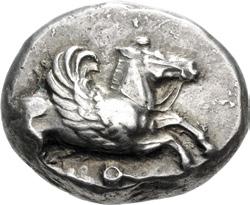


227. CORINTHIA, Corinth. Circa 490-450 BC. AR Stater (20mm, 8.66 g, 3h). Pegasos flying right; J below / Head of Athena right, wearing Corinthian helmet, within incuse square. Ravel Period II, Class 2 or 3 (unlisted dies); Pegasi 75; BCD Corinth 22; HGC 4, 1825. Attractively toned, underlying luster, compact flan, some die wear. Good VF. ($2000)
From the JTB Collection. Ex Dr. Paul Peter Urone Collection; Friend of a Scholar Collection (Classical Numismatic Group 100, 7 October 2015), lot 1390, purchased from Maison Platt, October 1987. Reportedly also ex Comte de la Closerie des Lilas Collection.
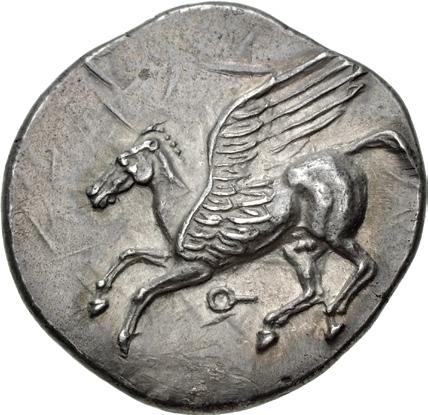




228. CORINTHIA, Corinth. Circa 400-350/45 BC. AR Stater (23mm, 8.46 g, 10h). Pegasos flying left; J below / Head of Athena left, wearing Corinthian helmet with neck guard; to right, hound seated right. Ravel Period IV, Series 2, 412 (P202/ T304); Pegasi 135; BCD Corinth 65; HGC 4, 1832; Sartiges 278 (same dies). Deep iridescent tone, minor cleaning marks in field on obverse. EF. ($1000)


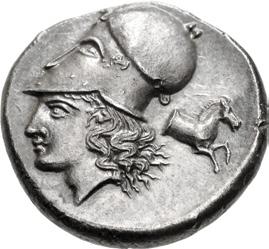
229. CORINTHIA, Corinth. Circa 400-350/45 BC. AR Stater (21mm, 8.46 g, 1h). Pegasos flying left; J below / Head of Athena left, wearing Corinthian helmet; to right, forepart of horse right. Ravel Period IV, Series 3, 432 var. (P211/T–[unlisted rev. die]); cf. Pegasi 142 (text, not photos); cf. BCD Corinth 54; HGC 4, 1832; Pozzi 1665 (same obv. die). Toned, a little die wear and off center on obverse. EF. Fine style head of Athena. Rare variety. ($750)
From the JTB Collection. Ex Pegasos Collection (Nomos 25, 20 November 2022), lot 134.



230. CORINTHIA, Corinth. Circa 350/45-285 BC. AR Stater (21.5mm, 8.59 g, 10h). Pegasos flying left; J below / Head of Athena left, wearing Corinthian helmet; d-5 flanking; to right, Zeus seated right, hurling thunderbolt held aloft in his right hand; all within concave circle. Ravel Period V, 1075; Pegasi 450; BCD Corinth 131; HGC 4, 1848. Attractive deep iridescent tone. Superb EF. ($1500)
From the Michael Rogal Collection. Ex Triton XX (10 January 2017), lot 174.



231. SIKYONIA, Sikyon. Circa 431-400 BC. AR Stater (25.5mm, 12.13 g, 10h). Lion standing right, raising forepaw; bow above, sE below / Dove flying right; s above and 5 below tail; all within wreath. BCD Peloponnesos 194 (same dies); HGC 5, 189; Traité III 797, pl. CCXXI, 21 = Pozzi (Boutin) 4064 (same dies). Faint iridescent tone, slight die shift on obverse, a touch off center. Near EF. Very rare, and finer than the BCD Peloponnesos example. ($1000)
From the Michael Rogal Collection. Ex Triton XIII (5 January 2010), lot 147; BCD Collection (not from previous BCD sales).
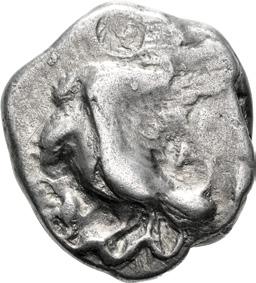


232. ELIS, Olympia. 87th Olympiad. 432 BC. AR Stater (21mm, 11.70 g, 1h). Eagle, wings spread, standing left on serpent that strikes upward; [V]-Å across central field; c/m: quadruped(?) at bay right within incuse circle / Upright winged thunderbolt, with volutes below; V-Å across upper field; all in linear square within shallow incuse square. Seltman, Temple 124 (dies BH/βχ); BCD Olympia 49 (same dies); HGC 5, 333 (same dies as illustration); SNG Copenhagen 363 (same dies); SNG Delepierre 2081 (same dies); BMC 25 (same dies); McClean 6609 (same dies); Pozzi 1829 (same dies). Lightly toned, compact flan, some granularity, light scratches struck with somewhat worn obverse die. Near VF. Very rare. ($1500)




233. ELIS, Olympia. 89th-90th Olympiad. 424-420 BC. AR Stater (24.5mm, 12.03 g, 10h). Obverse die signed by Da–. Eagle, wings spread, standing right on, and holding the neck of, a serpent, while the serpent strikes at its head; d-Å across central field / Upright thunderbolt, with wings above and volutes below; V-Å across central field; all in dotted circle within shallow incuse circle. Seltman, Temple 140d (dies BN/γκ) = Jameson 1228 (this coin); BCD Olympia 58 (same dies); HGC 5, 341 (same dies as illustration); Boston MFA 1202 = Warren 918 (same dies). Lovely old cabinet tone, with a hint of iridescence, slightly off center on obverse. Good VF. ($20,000)
Ex Mark & Lottie Salton Collection (Stack’s Bowers Galleries, 14 January 2022), lot 4310 (hammer $46,000); Robert Jameson Collection (publ. 1913); J. Hirsch XVI (5 December 1906), lot 557.
Located near the northwestern coast of the Peloponnesos, the sacred shrine of Olympia became established as the site of the most important Greek festival of athletics in the eighth century BC. The first Olympic Games were held in 776 BC, consisting solely of a foot race, or stadion, won in that year by Koroibus of Elis. As time went on, more events were added, including wrestling, boxing, long jump, javelin, discus, and chariot races. The contests became so important that Greek cities at war would declare a truce for the duration. Soon a permanent complex was built to house the games, and a magnificent temple of Zeus containing a statue ranked as one of the Seven Wonders of the World was completed in 463 BC. The first coins of Olympia date to the games of 468 BC, and new types were issued at four year intervals (to coincide with the games) thereafter. Three basic types were struck, depicting a head of Zeus, Hera, or an eagle. The finest die engravers were employed in their production and coins of Olympia rank as some of the greatest masterpieces of Greek coinage.

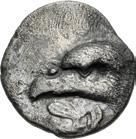


234. ELIS, Olympia. 91st-94th Olympiad. 416-404 BC. AR Obol (11mm, 0.86 g, 4h). Head of eagle left; leaf below / Thunderbolt with volutes above and wings below; V-Å across field; all within wreath. Cf. BCD Olympia 79 (hemidrachm); BCD Peloponnesos –; BCD Peloponnesos II 2221; HGC 5, –; SNG Copenhagen 370. Toned, granular surfaces. VF. Very rare. ($1000)




235. ELIS, Olympia. 134th-143rd Olympiad. Circa 244-208 BC. AR Drachm (18mm, 4.73 g, 10h). Eagle flying right, tearing at hare held in its talons / Vertical thunderbolt with volute above, wings below; V-Å flanking. Elis Hoard Group I, 1 (same dies); BCD Olympia 231 (this coin); cf. SNG Copenhagen 426; Dewing 1902; Pozzi 4145. Toned. Good VF. ($750)
From the Michael Rogal Collection. Ex Triton XVII (7 January 2014), lot 235; BCD Collection (Leu 90, 10 May 2004), lot 231.
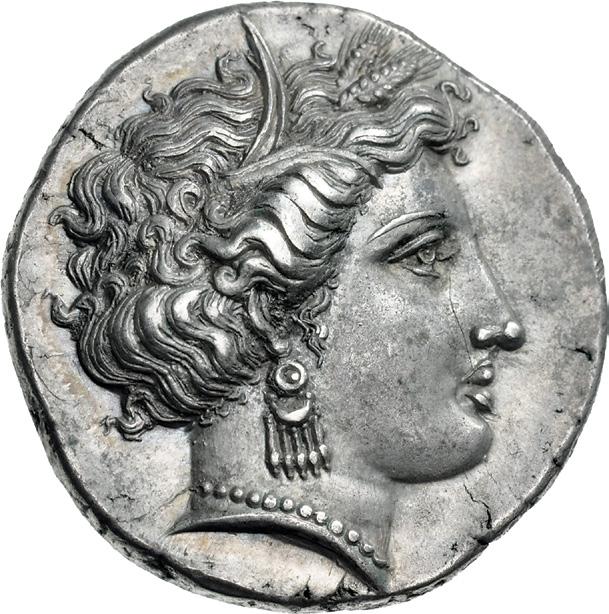


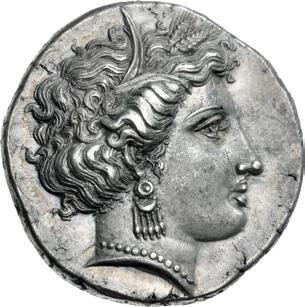


236. ARKADIA, Pheneos. Circa 360-350/40 BC. AR Stater (25mm, 11.95 g, 2h). Head of Demeter to right, wearing grain wreath, elaborate disc and crescent earring with pendants, and pearl necklace / Hermes, nude but for his petasos and for a cloak over his shoulders, partially facing and moving to the left, holding a kerykeion in his right hand; his head is turned back to right to gaze at the infant Arkas, whom he holds on his left arm with his left hand and who raises his right hand towards Hermes’ face; Q between Hermes’ legs, fE-@E-W@ around lower right edge. Schultz 2 (V2/R1); BCD Peloponnesos 1615 (same dies); HGC 5, 975; Boston MFA 1266 (same dies); Du Chastel 243 (same dies). Toned, trace deposits on reverse, minor edge mark. Choice EF. Very rare. A magnificent, sharply struck coin of great freshness and beauty, one of the finest known examples. ($300,000)
From the Columbus Collection. Ex Cabinet W (Triton XV, 3 January 2012), lot 1013, purchased privately from the BCD Collection in 2005. The stater coinage of Pheneos was likely a rather limited series, being struck from only three obverse and seven reverse dies, with the first obverse die breaking almost immediately. These coins were probably created to pay mercenaries in the tumultuous years around 360 BC, when war raged across Greece. The beautiful, artistic style and fine engraving highlights the civic pride that was core to the design and production of classical Greek coinage. Here, the head of Demeter is rendered in particularly elegant style, accentuated by the remarkable strike and preservation of the present example. On the reverse, the figure of Hermes with the infant Arkas is reminiscent of the famous Hermes of Praxitiles, carved around 343 BC in nearby Olympia.




237. ARKADIA, Stratos(?). Mid 5th century BC. AR Trihemiobol(?) (9mm, 0.97 g, 9h). Hydria / Kantharos or kylix within incuse square. NAC 133, lot 80; Nomos 26, lot 297; Nomos 33, lot 1158; otherwise, unpublished. Faintly toned, light roughness. Good VF. Well centered. Extremely rare, apparently the fourth known. ($1000)
The attribution of this issue is uncertain, with the suggestion of possibly Stratos based on a private comment by BCD (see the note on the Nomos 26 example).




238. ARKADIA, Thelpusa. Circa 370-350 BC. AR Obol (12mm, 0.75 g, 3h). Bare head of Demeter Erinys right, wearing single-pendant earring; Q below chin / The horse Areion prancing right; Er5W@ above, Q below. BCD Peloponnesos 1757; Traeger, Arkadien 679; HGC 5, 1083; Traité III 935; Pozzi 1961. Toned, minor deposits, a few marks, flan flaw on reverse. VF. Very rare. ($500)

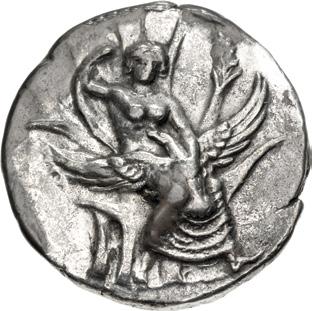


239. CRETE, Gortyna. Circa 330-270 BC. AR Stater (25.5mm, 11.42 g, 3h). Europa seated half-right in tree, lifting her veil in her right hand, left hand resisting an eagle as it ravages her / Bull standing right, head reverted. Svoronos, Numismatique 83 (same dies as illustration); Le Rider, Crétoises pl. V, 16 (same obv. die); SNG Copenhagen 443 (same obv. die); BMC 29; Dewing 1022 (same obv. die). Toned, underlying luster, traces of find patina, overstruck on uncertain type as usual, cleaning marks. EF. Well centered and struck for type. ($10,000)
From the Columbus Collection. Ex Classical Numismaitc Group 100 (7 October 2015), lot 1399 (conserved since).
While the myth of Europa as one of Zeus’ numerous trysts is well-known and has been the subject of literature and art since at least the fifth century BC, certain portions of the entire episode received more attention than others. What occurred when Zeus brought Europa to Crete is one such part. According to the later authors Theophrastos (371-ca. 287 BC) and Pliny the Elder (AD 23-79), Zeus consummated his abduction of Europa in a plane-tree (ἡ πλάτανος), an event commemorated on a series of silver and bronze issues from the Cretan city of Gortyna, traditional site of that event.
According to the traditional account, Europa was the daughter of Agenor, king of Tyre, the sister of Kadmos, the legendary founder of Corinth, and Kilix, for whom Cilicia was named, and was a descendant of Io, one of Zeus’ numerous other mortal female trysts. Europa, too, attracted the eye of Zeus, who, transforming himself into a white bull, seduced the young girl, carrying her across the Aegean Sea to the region of Gortyna on Crete, where she was made the first queen of Crete. Gortyna’s special involvement in this myth - it was claimed the plane-tree was still extant centuries after the event - made its depiction on the civic coinage an important reminder of the city’s role in Crete’s early history.



240. CRETE, Knossos. Circa 360-320 BC. AR Stater (24mm, 10.80 g). Head of Demeter right, wearing wreath of grain ears, single-pendant earring, and [necklace]; ˚@ below neck truncation / Cruciform labyrinth, with pellet in center, within dotted circle border. Svoronos, Numismatique 44 (same dies as illustration); Le Rider, Crétoises pl. VII, 8 (same dies). Old collection tone, minor cleaning marks. Good VF. ($5000)
From the Henry A. Sauter Collection, purchased from Superior Stamp & Coin.
According to the Greek myth, Minos was the first king of Crete. Although he gave the island its first constitution, ordered the construction of the palace at Knossos, and was the first to build a navy, he was a cruel tyrant and imperialist. One of his subject cities was Athens. He demanded from its citizens as payment every nine years seven youths and seven virgins. Minos would feed them then to the Minotaur, a halfman, half-bull who was held in the Labyrinth, a large walled maze. To stop this brutal tribute, the Athenian hero, Theseus, had himself sent as part of the required tribute. With the assistance of Ariadne, the daughter of Minos, Theseus was able to navigate the Labyrinth successfully and kill the Minotaur.



241. CRETE, Lyttos. Circa 320-270 BC. AR Stater (23.5mm, 10.82 g, 4h). Eagle flying left / Head of boar left; ¬Utt5/5¬o in two lines above; all in dotted square within incuse square. Svoronos, Numismatique 36 var. (ethnic); Le Rider, Crétoises, pl. VII, 16; BMC 12 var. (same). Toned, smoothed. VF. Rare variety. ($1000)
From the Henry A. Sauter Collection. Ex Superior (26 July 1979), lot 1896.



242. CRETE, Phaistos. Circa 300-270 BC. AR Stater (25mm, 11.47 g, 11h). Herakles, nude but for lion skin draped over left arm, standing left, his left hand extended and holding one head of the Hydra, which he strikes at with club held aloft in his right hand; fÅ5st5W[@] to right / Bull standing left. Svoronos, Numismatique 53 (same dies as illustration); Le Rider, Crétoises, pl. XXIII, 19–20 (same dies); SNG Lockett 2592 (same obv. die); BMC 13; Mionnet II p. 291, 255. Lightly toned, typical die wear, a few flan flaws on reverse. Good VF. Rare. ($5000)
The Lernaean Hydra, the offspring of Typhon and Echidna, was said to be the sibling of the Nemean Lion, the Chimaera, and Cerberus. Inhabiting the swamp near Lake Lerna in the Argolid, the creature possessed numerous mortal and one immortal head on its single body; should one head be removed, two more would grow in its place. When Herakles reached the swamp where the Hydra dwelt, he drew it out of its lair near the spring of Amymone. Thereupon, wielding a harvesting sickle, he attempted to decapitate the creature. When this proved unsuccessful, because of the Hydra’s regenerative ability, Herakles enlisted the assistance of his nephew Iolaus, who devised a plan: once Herakles had cut off one of the creature’s heads, Iolaus would cauterize the stump with a burning firebrand. The plan succeeded, and the Hydra was destroyed. Herakles placed its one immortal head under a large rock on the sacred way between Lerna and Elaius and dipped his arrows in its poisonous blood.


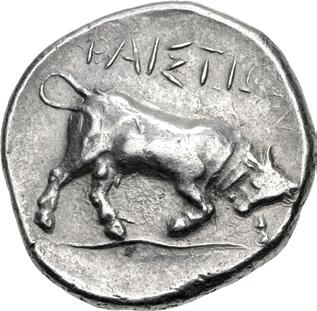

243. CRETE, Phaistos. Circa 300-270 BC. AR Stater (25.5mm, 11.79 g, 12h). Herakles, nude but for lion skin draped over left arm, standing left, his left hand extended and holding one head of the Hydra, which he strikes at with club held aloft in his right hand; crab between his legs below / Bull advancing right; fÅ5st5W@ above. Svoronos, Numismatique 64 (same dies); Le Rider, Crétoises, pl. XXIII, 24 var. (rev. type left; same obv. die); Mionnet II p. 291, 253 (same obv. die). Faintly toned, traces of find patina, slightly weak strike. Good VF. ($7500)
Ex Roma X (27 September 2015), lot 381 (hammer £13,000).



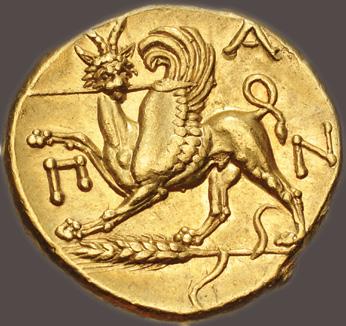
244. CIMMERIAN BOSPOROS, Pantikapaion. Circa 340-325 BC. AV Stater (19mm, 9.09 g, 12h). Bearded head of Pan left, wearing ivy wreath / Griffin, holding spear in its mouth, standing left, head facing, forepaw raised, on grain ear; ∏-Å@ around. Anokhin 1021; MacDonald 54; HGC 7, 20; SNG BM Black Sea 864; Gulbenkian 588–90; Jameson 1361; Pozzi 1150; Sartiges 1580. Lustrous. Choice EF. ($50,000)
From the Georges Albert Haikel Collection. Ex Prospero Collection (New York Sale XXVII, 4 January 2012), lot 214, purchased from Spink, London, 22 April 1986.
Situated on the west side of the Cimmerian Bosporos, in what is now called the Crimea, Pantikapaion achieved great prosperity through its exploitation of the abundant fisheries of the straits and the export of wheat from the Crimea. This wealth is attested by its splendid gold coinage, which commenced in the mid-4th century BC, and by the magnificently furnished rock tombs of its principal citizens in the same period. Later, it was to become a regional capital of the kingdom of Mithradates VI of Pontos (120-63 BC) and later still the seat of the kings of Bosporos (first century BC – fourth century AD). The coinage of Pantikapaion seems to have commenced with silver issues in the latter part of the fifth century BC, but it is for its beautiful gold staters that the mint is chiefly noted. They depict the head of the god Pan (a pun on the name of the city) and on the reverse, the griffin that Herodotos describes as being the guardian of the remote sources of gold.




245. CIMMERIAN BOSPOROS, Pantikapaion. Circa 340-325 BC. AR Drachm (16mm, 3.42 g, 12h). Bearded head of satyr facing slightly left / Head of ox left; π-Å-@ around. Anokhin 1034; MacDonald 57; HGC 7, 87; SNG BM Black Sea 880; SNG Stancomb 548; SNG Copenhagen 321. Toned, much find patina, some roughness. Good VF. ($1000)




246. CIMMERIAN BOSPOROS, Pantikapaion. Circa 90-79 BC. AR Didrachm (20mm, 8.72 g, 12h). Head of young Dionysos right, wearing ivy wreath / Grape bunch above ∏Å@t5/˚Å∏Å5/tW@ in three lines; all within ivy wreath; [Ë above]. Frolova & Ireland dies I/i; Anokhin 1116; MacDonald 168; HGC 7, 98; SNG Lockett 1102 = Bement 884 (this coin). Old collection tone, minor doubling on reverse, minor deposits. Good VF. ($1500)
Ex Richard Cyril Lockett Collection (Greek Part II, Glendining, 12 February 1958), lot 1017; Clarence S. Bement Collection (Naville VI, 28 January 1923), lot 884.

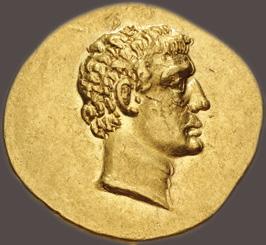


247. KINGS of BOSPOROS. Asander. As archon, circa 47-43 BC. AV Stater (22mm, 8.14 g, 12h). Pantikapaion mint. Dated RY 4 (44/3 BC). Bare head right / Årco@to% Å%Å@droU ∫o%∏oroU, Nike, holding wreath in extended right hand and palm frond in left, standing left on prow left; (t d (date) across upper field, ≤ to inner left. Frolova & Ireland § 6, 5 (O3/ R4) = Natwoka 3; Anokhin 1312 corr. (date); MacDonald 189/2 corr. (date); RPC I 1842.1 corr. (date); HGC 7, 199 corr. (date); DCA2 515; SNG BM Black Sea 961 = GPCG pl. 51, 1 (same dies); Adams III 2046 (same dies). Underlying luster, a few minor metal flaws on obverse. EF. Well centered. Extremely rare, one of only 6 examples published (the others: Adams III 2046; BM 961; CNG 72, lot 692; Morton & Eden 86, lot 14 = CNG 84, lot 575; and Frolova & Ireland pl. LXI, 3). ($15,000)
Ex Jonathan P. Rosen Collection (Triton XXIII, 14 January 2020), lot 285; Numismatica Ars Classica 23 (19 March 2002), lot 1230.
The date of this issue has long been debated, with some numismatists reading the delta as an alpha, but the die studies of Natwoka and Frolova & Ireland conclusively show that this issue must be dated year 4.




248. KINGS of PONTOS. Mithradates VI Eupator. Circa 120-63 BC. AV Stater (19.5mm, 8.42 g, 12h). Pergamon mint. Dated CY 4 (85 BC). Diademed head right / Stag grazing left; ∫Å%5¬EW% above, Â5QrÅdÅtoU>EU∏Åtoro% in two lines below; star-in-crescent to left; d (year) to right, n in exergue; all within Dionysiac wreath of ivy and fruit. Callataÿ dies D11/R2, b (this coin); HGC 7, 334; DCA2 557; Hirsch 1414 (same dies). Some light marks, scrape on reverse, edge marks and bumps. VF. Very rare. ($7500)
From the Gerald F. Borrmann (Northern California Gentleman) Collection. Ex Olga H. Knoepke Collection (Glendining’s, 10 December 1986), lot 236; J. Hirsch XX (13 November 1907), lot 362; Theodor Prowe Collection (Egger XVII, 28 November 1904), lot 959; ‘Late Collector’ [Rothschild Collection] (Sotheby, Wilkinson and Hodge, 28 May 1900), lot 305.
Mithradates was a fascinating Hellenist at a time when Roman power was ascendent. His career, driven by megalomaniacal ambitions, led to murderous assaults upon family and followers alike and disastrous foreign adventures against superior forces. His portraiture attempts to mimic the gods with its bold staring gaze and unruly, free-flowing hair, but at its most extreme is a personification of hysteria in its Dionysiac sense.
At the age of 18, Mithradates overthrew his mother’s regency and embarked on a career of conquest, bringing most of the lands around the Black Sea into his domain. His expansionist aims inevitably brought him into conflict with Rome, and in preparation for the coming war he built up the largest army in Asia, unleashing it in 88 BC in what would be the First Mithradatic War. He sought to undermine the Roman power base by ordering the massacre of every Roman citizen in Asia in which nearly 80,000 people perished.
The Romans were not intimidated, and when Mithradates crossed over to Greece proper as ‘Liberator’, the Roman legions under Sulla smashed his army. Mithradates retreated to Pontus, from where he continued to skirmish with the Romans, suffering more defeats to the general Lucullus. In 63 BC, having suffered a final defeat by Pompey and facing a revolt by his own son Pharnakes, the elderly king tried to commit suicide by taking poison, but he had inured himself to its affects by years of small counterdoses, and so had to be stabbed to death by one of his mercenaries.
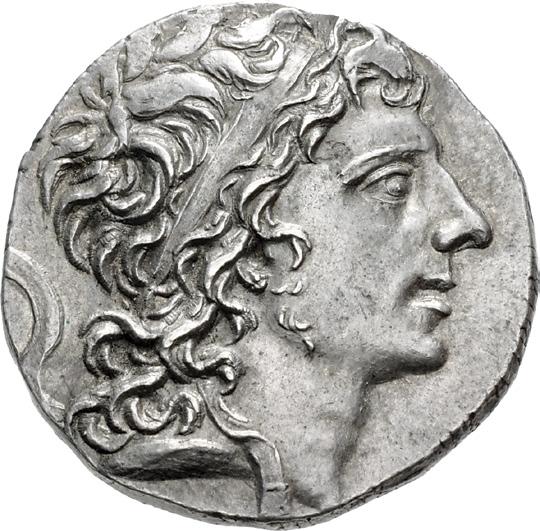



249. KINGS of PONTOS. Mithradates VI Eupator. Circa 120-63 BC. AR Tetradrachm (30mm, 16.80 g, 12h). Pergamon mint. Dated month 5, year 210 BE (February 87 BC). Diademed head right / Pegasos grazing left; ∫Å%5¬EW% above, Â5QrÅdÅtoU>EU∏Åtoro% in two lines below; star-in-crescent to left; to right, 5s (year) above Ú; E (month) in exergue; all within Dionysiac wreath of ivy and fruit. Callataÿ p. 12, dies D62/R3, a (this coin); HGC 7, 338; DCA2 555. Toned, area of slightly weak strike, slight die shift. Near EF. ($3000)
From the Gerald F. Borrmann (Northern California Gentleman) Collection, purchased from Dr. Arnold Saslow, 1988. Ex Christie’s New York (8 June 1988), lot 65; Sternberg VIII (16 November 1978), lot 89.



250. KINGS of PONTOS. Mithradates VI Eupator. Circa 120-63 BC. AR Tetradrachm (29.5mm, 16.56 g, 12h). Pergamon mint. Dated month 5, year 210 BE (February 87 BC). Diademed head right / Pegasos grazing left; ∫Å%5¬EW% above, Â5QrÅdÅtoU>EU∏Åtoro% in two lines below; star-in-crescent to left; to right, 5s (year) above Ú; E (month) in exergue; all within Dionysiac wreath of ivy and fruit. Callataÿ p. 12, dies D62/R2; HGC 7, 338; DCA2 555. Deep iridescent tone, a hint of porosity, small mark on obverse. Good VF. ($2500)
From the JTB Collection. Ex Leu Numismatik AG Web Auction 24 (3 December 2022), lot 71.



251. PAPHLAGONIA, Sinope. Circa 425-410 BC. AR Drachm (15mm, 6.12 g). Aeginetic standard. Head of sea-eagle left; below, dolphin left / Quadripartite incuse square with two opposing quarters filled, ˚ in one unfilled quarter. RG 11; HGC 7, 388 corr. (pellets not always present); SNG von Aulock 6837 (same dies). Old cabinet tone, compact flan. EF. Well centered. ($1000)

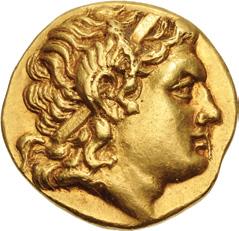


252. BITHYNIA, Kalchedon. Circa 260-230s BC. AV Stater (19.5mm, 8.41 g, 1h). In the name and types of Lysimachos of Thrace. Diademed head of the deified Alexander right, with horn of Ammon / ∫Å%5¬EW% 2U%5;ÅcoU, Athena Nikephoros seated left, left arm resting on shield, transverse spear in background; ˚ to inner left, ZW∏U in exergue. Marinescu Issue 35, 78 (O34/R72); Seyrig, Monnaies, pl. 25, 29 (same dies); Müller 468; Türkoğlu L01; HGC 7, 505. Minor deposits, minor marks and scratches, some die breaks on obverse, minor flan flaw in field on reverse. Good VF. Very rare. ($2000)
Second Known



253. MYSIA, Kyzikos. Circa 600-550 BC. EL Hekte – Sixth Stater (11.5mm, 2.71 g). Tail of tunny right on raised disk / Quadripartite incuse square. Cf. Hurter & Liewald III 27.1 (hemihekte); cf. Von Fritze I 18 (unlisted denomination); Greenwell –; Boston MFA –; SNG BN –; Leu Numismatik AG Web Auction 19, lot 996. Irregular flan. VF. Extremely rare, apparently the second known hekte of this issue. ($1000)


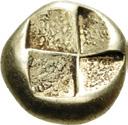
254. MYSIA, Kyzikos. Circa 550-450 BC. EL Hekte – Sixth Stater (10mm, 2.44 g). Bearded head of male left, wearing helmet, of archaic style / Quadripartite incuse square. Unpublished. Trace deposits, slightly compact flan. Near EF. Apparently unique. ($1000)
From the Dr. Adrian Carr Collection. Ex Gorny & Mosch 257 (15 October 2018), lot 456 (attributed to Phokaia).
This intriguing hekte was attributed to Phokaia by Gorny & Mosch based on a similarity of type with issues of Bodenstedt emission 44. However, the style of the helmeted head is quite consistent across all of the dies identified by Bodenstedt, and the style here is quite dissimilar. Moreover, though, the type of incuse on this example is an exact match for issues at Kyzikos. The type is not known, but, as evidenced by the articles by Hurter & Liewald, new types of Kyzikene coins have been coming to light.
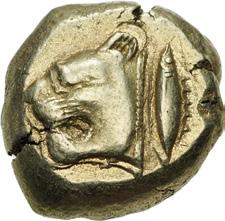


255. MYSIA, Kyzikos. Circa 550-450 BC. EL Stater (18mm, 16.23 g). Head of lion left; to right, tunny upward / Quadripartite incuse square. Von Fritze I 39; Greenwell 115; Boston MFA 1414 = Warren 1537; SNG BN 178. A couple of edge splits, minor double strike on obverse. VF. Well centered. ($2000)
Ex Siren Collection (Classical Numismatic Group Electronic Auction 532, 8 February 2023), lot 168.

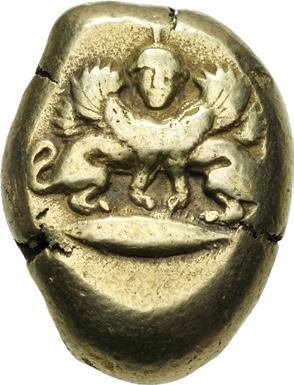

256. MYSIA, Kyzikos. Circa 550-450 BC. EL Stater (15.5mm, 16.10 g). Double-bodied sphinx, with one head facing, wearing ouraios, atop a tunny left / Quadripartite incuse square. Cf. Von Fritze I 128 (unlisted denomination); cf. Greenwell 101 (same); Boston MFA –; cf. SNG BN 280 (hekte). Edge splits. Near VF. ($2000)
Ex Siren Collection (Classical Numismatic Group Electronic Auction 520, 20 July 2022), lot 108.


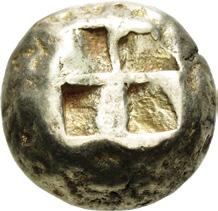
257. MYSIA, Kyzikos. Circa 550-450 BC. EL Stater (17mm, 16.06 g). Heads of lion and ram, conjoined, back-to-back; below, tunny left / Quadripartite incuse square. Von Fritze I 54; Greenwell 118; Boston MFA 1422 = Warren 1543; SNG BN –. Triple struck. Near VF. Very rare. ($2000)
Ex Siren Collection (Classical Numismatic Group Electronic Auction 516, 18 May 2022), lot 218.
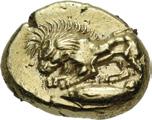
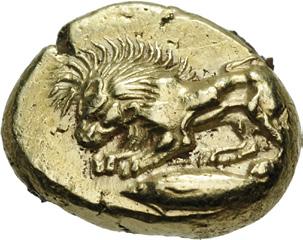

258. MYSIA, Kyzikos. Circa 550-450 BC. EL Hekte – Sixth Stater (12mm, 2.72 g). Lion at bay left on tunny left / Quadripartite incuse square. Von Fritze I 83; Greenwell 107; Boston MFA 1443 = Warren 1531; SNG BN 212. Trace deposits, minor marks, slightly off center on obverse. Near EF. ($1500)
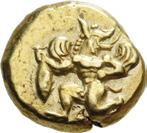


259. MYSIA, Kyzikos. Circa 550-450 BC. EL Hekte – Sixth Stater (11mm, 2.66 g). Winged male mythological creature running-kneeling left, head right, holding tunny by its tail in left hand / Quadripartite incuse square. Von Fritze I 123; Greenwell 57; Boston MFA 1459; SNG BN 272. Hairlines, minor edge split. Near EF. ($1500)
From the Dr. Adrian Carr Collection, purchased from Vilmar Numismatics, July 2016.
While the identification of this creature, certainly of local significance, is unknown today, it has traditionally been referred to as “Phobos” or “Daimon.” In his catalog of the Gulbenkian collection, Jenkins sees an Egyptian or near-Eastern influence, while Bivar, in his article on Mithra (“Mithra and Mesopotamia,” Mithraic Studies [Manchester, 1975], pp. 275-89), suggests that the creature corresponds to the Mithraic Areimanios (Ahriman). One also may see an assimilation of the ubiquitous Persian lion-headed griffin, adapting the head, wings, and tail to a human body. Although some references note the head as being that of a wolf, other examples clearly show a mane that is directly influenced by the lion heads on the common early Lydian electrum, supporting Bivar’s (and others’) contention that it is a lion head. At the same time, the ear is not fully visible on most examples, but on some, such as the present piece, it clearly is that of a griffin (compare to its depiction on the coins of Teos and Abdera). The wings and posture of the creature are mythological archetypes, commonly found on displays of various deities and creatures on pottery and coins. An excellent example of an archaic representation of a local deity of Asia Minor.



260. MYSIA, Kyzikos. Circa 550-450 BC. EL Hekte – Sixth Stater (11mm, 2.63 g). Boar standing left on tunny left / Quadripartite incuse square. Von Fritze I 90; Greenwell 135; Boston MFA 1465 = Warren 1561; SNG BN 225-6. Lightly toned, minor edge splits, tiny deposit on obverse. Near EF. ($1000)

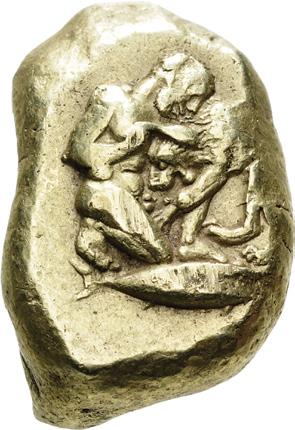

261. MYSIA, Kyzikos. Circa 450-330 BC. EL Stater (15mm, 16.05 g). Herakles kneeling right, strangling the Nemean Lion; below, tunny left / Quadripartite incuse square. Von Fritze I 161; Greenwell 69; Boston MFA 1493–4; SNG BN 308. Hairlines, scrape on obverse. Good VF. ($5000)
From the Gerald F. Borrmann (Northern California Gentleman) Collection, purchased from Youngerman Inc., 20 August 1983.



262. MYSIA, Kyzikos. Circa 450-330 BC. EL Stater (17mm, 16.02 g). Herakles kneeling right, strangling the Nemean Lion; below, tunny left / Quadripartite incuse square. Von Fritze I 161; Greenwell 69; Boston MFA 1493–4; SNG BN 308 (this coin); Gulbenkian 628; Jameson 2197 (same obv. die). Lightly toned. VF. ($5000)
Ex Edoardo Levante Collection (Triton XVIII, 6 January 2015), lot 576; deaccessioned from the Départment des Monnaies, Médailles et Antiques, Bibliothèque Nationale de France.



263. MYSIA, Kyzikos. Circa 450-330 BC. EL Hekte – Sixth Stater (10.5mm, 2.65 g). Herakles kneeling right, strangling the Nemean Lion; below, tunny left / Quadripartite incuse square. Von Fritze I 161; Greenwell 69; cf. Boston MFA 1493–4 (stater); cf. SNG BN 308–9 (stater). Minor marks. Good VF. Very rare as a hekte, only three in CoinArchives. ($1000)



264. MYSIA, Kyzikos. Circa 450-330 BC. EL Hekte – Sixth Stater (9.5mm, 2.69 g). Helios, radiate and nude, crouching right, arms spread, holding in his hands the reins of two horse foreparts facing left and right in background / Quadripartite incuse square. Von Fritze I 148; Greenwell 23; cf. Boston MFA 1515 (stater); cf. SNG BN 297 (stater). Lustrous, slightly compact flan. EF. Extremely rare. ($7500)
From the Dr. Adrian Carr Collection. Ex Roma XX (29 October 2020), lot 221.



265. MYSIA, Kyzikos. Circa 450-330 BC. EL Stater (17mm, 15.71 g). Bearded head right, wearing laurel wreath; below, tunny right / Quadripartite incuse square. Von Fritze I 197; Greenwell 81; Boston MFA 1561 = Warren 1500; SNG BN 337 (this coin); Jameson 2207 = Pozzi 2177; Kraay & Hirmer 721. Lightly toned. VF. Well centered. ($5000)
From the Dr. Adrian Carr Collection. Ex Jonathan P. Rosen Collection (Triton XXIV, 19 Jan 2021), lot 645; Berk BBS 202 (26 October 2017), lot 7; Edoardo Levante Collection (Triton XVIII, 6 January 2015), lot 577; deaccessioned from the Départment des Monnaies, Médailles et Antiques, Bibliothèque Nationale de France.
J. P. Six (NC 1898, pp. 197-198) first suggested that the bearded male portrait on this stater was that of the Athenian general Timotheos (d. 354 BC), who had raised the siege of Kyzikos in 363 BC (Diod. Sic. 15.81.6), noting a similarity between the coins and a marble portrait in the Capitoline Museum (no. 46). Other authors subsequently took different views. However, in “The Cyzicenes: A Reappraisal,” AJN 5-6 [1993-1994], pp. 9-11, Mildenberg defended Six’s hypothesis. He noted that Kyzikos was under Persian control from 540 BC until 445 BC, and then from 387 BC until the end of the Achaemenid Empire. During the almost sixty-year interval, Kyzikos was allied with Athens as a member of the Delian League. Kyzikos, however, was not banned from continuing to strike electrum staters (per League rules), because Athens saw the coinage as a valuable means of payment and in its best interest. Thus, when Athenian forces under the command of Timotheos successfully raised the Persian siege of Kyzikos in 363 BC (Diod. Sic. 15.81.6), the citizens placed the portrait of the victorious general, complete with laurel wreath, on this issue of staters to show their appreciation of his services and subtly honor him in an already-accepted Athenian-associated context.
Timotheos was the son of Konon and a Thracian mother (Ath. 13.577a). A prominent citizen, Timotheos was an associate of both the philosopher Plato and the Athenian orator Isokrates. Between 378 BC and 356 BC he frequently served as strategos, in which capacity he was able to secure an Athenian alliance with Kephallenia, and friendship with the Akarnanians and the Molossians. In 373 BC he was assigned command of a fleet to relieve Korkyra from Spartan control. Because the expedition was underfunded, the relief was delayed, prompting Timotheos to be brought to trial. Through the intervention of his allies, including Jason, the ruler of Pherai and the tagos (ταγός) of the Thessalian League, Timotheos was acquitted. Following his acquittal, and with the assistance of Amyntas III of Macedon, Timotheos took Korkyra (Diod. Sic. 15.47). For this, a statue was raised in his honor in Athens (Aeschin. In Ctes. 243). In 363 BC, Timotheos raised the siege of Kyzikos, for which these staters may have been issued (Diod. Sic. 15.81.6). In 366 BC, Timotheos was sent to aid Ariobarzanes, the satrap of Phrygia, but when he discovered that the satrap was in revolt against the Great King, Timotheos turned his attention to the northern Aegean. There, he captured Samos after a siege of 10 months, followed by similar conquests along the Thraco-Macedonian coast. A legal action brought against him by Apollodoros (the speech of which is attributed to Demosthenes), is noteworthy for illustrating the reversal of fortune of the once-great and honored general. Timotheos was once again in command during the Social War (357-355 BC), but competing personalities among the leadership again brought Timotheos to trial. Found guilty and unable to pay the heavy fine imposed on him, Timotheos retreated to Chalkis in Euboia, where he died. In remorse for their treatment of the once-favored general, the Athenians forgave a greater part of the debt that had passed on to his son, Konon. They also brought his ashes back to Athens, burying them in the Keramikos and erecting statues to him in the Agora and on the Akropolis.



266. MYSIA, Kyzikos. Circa 390-341/0 BC. AR Tetradrachm (24mm, 15.19 g, 1h). Head of Kore Soteira left, wearing single-pendant earring, hair in sphendone covered with a veil, two grain ears in hair; %WtE5rÅ above / Head of lion left, mouth open with tongue protruding; to lower right, cock standing right; below, tunny left; ˚U-z5 around. Pixodarus Type 2, Group D, 7–9; SNG BN 396–402 var. (symbol on rev.). Toned, minor marks, some die rust on obverse, minor deposits on reverse. VF. Very rare with this symbol. ($2000)
Ex Mercury Group Collection (Classical Numismatic Group 118, 13 September 2021), lot 257; Waddell EAuction 54 (27 June 2002), lot 54.




267. MYSIA, Lampsakos. Circa 394-350 BC. AV Stater (16.5mm, 8.47 g, 1h). Head of maenad left, wearing wreath of ivy, single-pendant earring, and necklace / Forepart of Pegasos flying right within shallow incuse square. Baldwin, Lampsakos 11 var. (unlisted dies); SNG BN –; SNG von Aulock 7393; Gulbenkian 682; Jameson 1438 = Traité II 2556, pl. CLXXI, 23. Minor marks, slight die shift on reverse. EF. Very rare, one of only two in CoinArchives. ($15,000)
From the Gerald F. Borrmann (Northern California Gentleman) Collection. Ex Kovacs XV (1 October 2003), lot 93; Triton II (1 December 1998), lot 411.
Lampsakos depended upon the traffic between the Aegean and the Black Sea and possessed an excellent harbor in a strategic position guarding the eastern entrance to the Hellespont opposite Gallipolis. The city was known to have existed under the name of Pityusa before it received colonists from the Ionian cities of Phokaia and Miletos (Strabo xiii, p. 589). In the sixth and fifth centuries BC, Lampsakos passed successively under Lydian, Persian, Athenian, and Spartan control. Its tribute of twelve talents, as a member of the Delian League, and production of electrum staters in the fifth century BC, attest to its commercial wealth. Following the example and standard of the Persic daric, Lampsakos was the first Greek city to make regular issues of gold coinage, which enjoyed an international circulation from Sicily to the Black Sea. As at Kyzikos, the quality of engraving was very high, and types changed frequently: about forty types were produced in a period of about sixty years. Many of the types featured Chthonic deities, those whose powers came from the earth, such as Demeter and Dionysos.




268. MYSIA, Lampsakos. Circa 394-350 BC. AV Stater (15.5mm, 8.54 g, 6h). Head of Hermes left, wearing petasos / Forepart of Pegasos flying right within shallow incuse square. Baldwin, Lampsakos 13b (dies II/β) = Sartiges 345 (this coin, illustrated); SNG BN 1143 = Traité II 2546, pl. CLXXI, 13; Boston MFA 1589 = Warren 1013; Jameson 1436. Struck with slightly worn obverse die. Good VF. ($30,000)
From the Georges Albert Haikel Collection. Ex Prospero Collection (New York Sale XXVII, 4 January 2012), lot 466; Münzen und Medaillen AG 64 (30 January 1984), lot 141; Vicomte de Sartiges Collection (publ. 1910); H. Osborne O’Hagan Collection (Sotheby, Wilkinson & Hodge, 17 July 1908), lot 535.
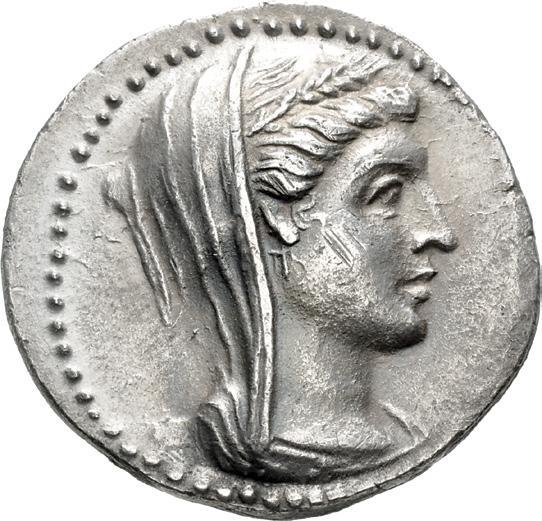

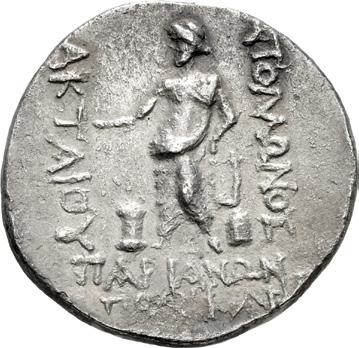

269. MYSIA, Parion. Circa 130s-50 BC. AR Tetradrachm (29.5mm, 15.77 g, 12h). Polykles, magistrate. Draped bust of Demeter right, veiled, and wearing grain ears in hair / Apollo Aktaios, drapery hanging from waist, standing left, holding patera in extended right hand, left hand placed on top of kithara to right, which is standing on omphalos; lit altar to inner left; Å∏o¬¬W@o% Å˚t&5oU to right and left, ∏&r5&@W@>∏o¬U˚¬˙[%] in two lines in exergue. Ellis-Evans, Late, Group 2, dies O4/R– (unlisted rev. die); Meadows, Parion 3 = SNG Lewis 829 (same obv. die); Meadows, Parion 3 = SNG BN 1401 (same obv. die). Lightly toned, small scuff on cheek, minor roughness on reverse. Near EF. Extremely rare, the fourth and finest known, the other three in public collections (BM, BN, and Berlin). ($7500)
From the Michael Rogal Collection. Ex Triton XX (10 January 2017), lot 247.




270. KINGS of PERGAMON. Eumenes I. 263-241 BC. AR Tetradrachm (28mm, 16.76 g, 12h). In the name of Philetairos. Pergamon mint. Struck circa 255/50-241 BC. Head of Philetairos right, wearing laurel wreath / f5¬EtÅ5roU, Athena enthroned left, left elbow resting on shield to right, crowning dynastic name with wreath held in her extended right hand and cradling transverse spear in left arm, ivy leaf to outer left, v to inner left, bow to right. Westermark Group IVA, obv. die unlisted; SNG BN 1614–5; SNG von Aulock 1356–7; SNG Copenhagen 335; Dewing 2208. In NGC encapsulation 6763170-014, graded AU, Strike: 5/5, Surface: 3/5, brushed. ($1000)
Ex Classical Numismatic Group Electronic Auction 523 (7 September 2022), lot 167; Demetrios Armounta Collection (Classical Numismatic Group Electronic Auction 304, 12 June 2013), lot 85.
271. TROAS, Assos. Circa 210-200 BC. AR Tetradrachm (32mm, 17.03 g, 12h). In the name and types of Alexander III of Macedon. Head of Herakles right, wearing lion skin / ŬE$Å@droU, Zeus Aëtophoros seated left; boukranion in left field. Unpublished. In NGC encapsulation 3762485-012, graded AU, Strike: 4/5, Surface: 4/5. Extremely rare. ($750)
Although this coin is unpublished, its style is identical to other issues at Assos, and the facing boukranion was a civic badge used on many of Assos’ own coins in the 4th-3rd centuries BC.

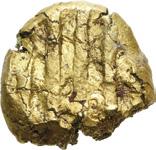

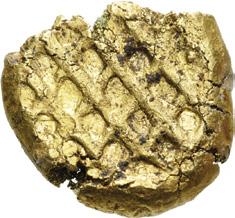
272. TROAS, Dardanos. 5th century BC. AV Hemistater – Half Daric (12mm, 3.90 g). Persic standard. Parallel lines across field / Cross-hatch pattern. Unpublished. Trace deposits, faint cleaning marks, edge loss. As made. Unique. ($3000)
From the Dr. Adrian Carr Collection. Ex Classical Numismatic Review XLV.2 (Summer 2020), no. 539239; Jonathan P. Rosen Collection (Classical Numismatic Group 114, 13 May 2020), lot 324; Roma XIII (23 March 2017), lot 146.
This archaic issue had originally been offered as an electrum coin, but a recent thorough metal analysis of the coin by ANSTO in Australia has conclusively shown that it has a gold content of approximately 91.7% (this analysis is included with this lot). A connection to Dardanos had been proposed since the coin appeared, based on the cross-hatch pattern on the reverse, an unusual feature that is only known on an archaic issue that has been attributed to Dardanos featuring a cock on the obverse (cf. SNG Ashmolean 1119). This attribution has been strengthened by the metal analysis, which has found a minute amount of the rare element iridium, which has also been found in silver coins of Dardanos, but not in Lydian gold, which was the main source for gold coinage at the time. Although the weight of the coin is a little low for a Persic hemistater, there is clear evidence of some edge loss, which could account for the discrepancy of 0.2–0.3 grams. Interestingly, the cross-hatch silver coins, of which there is a unit (~0.65 grams) and half (~0.32 grams), appear to also have been struck on the 5th century Persic standard (with the silver siglos increased to 5.55 grams), equating to 1/8th and 1/16th sigloi, respectively. If this is correct, it implies a slightly later dating to the silver than the traditional late 6th/early 5th centuries, but if this gold coin is linked to the silver, a 5th century date would be more plausible.
The “Wreath


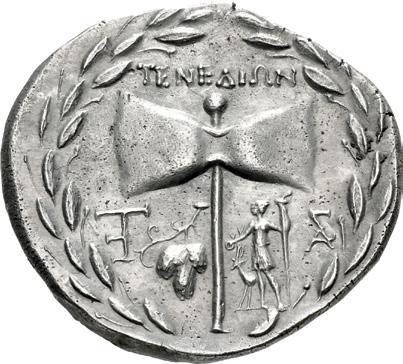

273. ISLANDS off TROAS, Tenedos. Circa 100-70 BC. AR Tetradrachm (33.5mm, 16.87 g, 12h). Stephanophoric type. Janiform head of a male left, laureate, and female right, wearing stephane / Labrys; tE@Ed5W@ above, Þ and grape bunch on vine to left of handle; to right of handle, Artemis standing left, holding phiale in right hand and long torch in left, forepart of stag left behind her, and Ā; all within wreath. Callataÿ, Tenedos 5 var. (no monogram beside Artemis); HGC 6, 390. Minor porosity. EF. Well centered. Unpublished variety. ($6000)
With the collapse of Seleukid authority in Asia Minor in 189 BC, many communities of northwestern Asia Minor celebrated their liberation from regal authority by issuing series of large and impressive tetradrachms. All of these coins were struck on the reduced Attic standard, and were struck on broad, thin flans that were influenced by the Athenian New Style coinage. These series also copied a feature on their reverses, a large laurel wreath that formed the border encompassing the entire reverse type. We know from the Delos inventory lists that these coins were referred to as stephanophoroi (“wreath-bearers”), attesting to the ubiquity of these series. The types appearing on the coins clearly indicated their civic nature, depicting the city’s patron deity on the obverse and various aspects of the city’s culture on the reverse.
Regardless of the particular city of issue, the stephanophoric coinage is regarded among the more artistic of the Hellenistic period. This is no surprise as nearly all of the issuing cities were located in western Asia Minor, an area whose numismatic artistry is well attested in the preceding Classical period. While the stephanophoroi represent a benchmark in coin design, the reason for their introduction is not certain, and there is little consensus among numismatists. On one extreme, C. Boehringer argued that their appearance and consistency represented an “Aegean Münzunion” (Boehringer, Chron., pp. 38-9), while at the other O. Mørkholm argued that the wreaths were not indicative of any political or economic significance, but merely the result of a design that gained popularity throughout the northern Aegean (“Chronology and Meaning of the Wreath Coinages of the early 2nd. Cent. B.C.,” QT 9 [1980], pp. 145-54).



274. ISLANDS off TROAS, Tenedos. Circa 100-70 BC. AR Tetradrachm (30.5mm, 15.73 g, 12h). Stephanophoric type. Janiform head of a bearded male left, laureate, and female right, wearing stephanos / Labrys; tE@Ed5W@ above, c and grape bunch to left of handle; to right, Eros standing right, holding wreath in both hands; all within wreath. Callataÿ, Tenedos 78 var. (D15/R– [unlisted rev. die]); HGC 6, 390; SNG Berry 988. Toned, struck with worn obverse die, die break at edge on reverse. VF. Well centered. Very rare issue, only five examples recorded by Callataÿ, and four additional in CoinArchives (including this coin). ($5000)
From the JTB Collection. Ex Peus 431 (27 April 2022), lot 3206.




275. AEOLIS, Elaia. Circa 450-400 BC. AR Diobol (9.5mm, 1.30 g, 12h). Head of Athena left, wearing crested Attic helmet / Laurel wreath; E-¬-Å-5 clockwise around from lower left; all within incuse square. SNG Arikantürk 284; SNG Ashmolean 1432 = Pozzi 2304. Old cabinet tone, minor edge marks. Good VF. ($1000)
Ex Sheikh Saud Al-Thani Collection (Part IV, Numismatica Ars Classica 126, 17 November 2021), lot 214; Morton & Eden 51 (24 October 2011), lot 136; Spink & Galerie des Monnaies (15 February 1977), lot 119; Münzen und Medaillen AG 41 (18 June 1970), lot 163; Hess-Leu 31 (6 December 1966), lot 418; Gustav Philipsen Collection (J. Hirsch XXV, 29 November 1909), lot 1973.
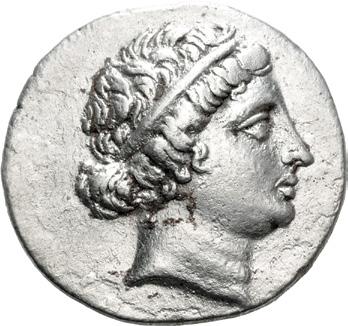



276. AEOLIS, Kyme. Circa 151/0-143/2 BC. AR Drachm (18.5mm, 3.73 g, 12h). Stephanophoric type. Kallias, magistrate. Head of the Amazon Kyme right, wearing tainia / Horse prancing right; one-handled cup below raised foreleg, ˚UÂÅ5W@ to right, ˚Ŭ¬5Ås below; all within wreath. Numismatic Fine Arts VIII, lot 222 (same dies); otherwise, unpublished. Bright surfaces, trace deposits, a little porosity. VF. Extremely rare. ($750)



277. AEOLIS, Myrina. Circa 155-143 BC. AR Tetradrachm (33mm, 16.65 g, 11h). Stephanophoric type. Head of Apollo right, wearing laurel wreath / Apollo Grynios standing right, holding phiale in right hand and laurel branch in left; æ and ÂUr5@ Å5o@ to left, omphalos and amphora at feet; all within laurel wreath. Sacks Issue 31, dies 59/b; Hermitage Sale I 288 (same dies). Toned, light roughness on obverse, minor die shift at periphery on reverse. Near EF. Very rare issue. ($750)


278. LESBOS, Unattributed Koinon mint. Circa 510-480 BC. BI Stater (19mm, 11.01 g). Confronted calves’ heads; olive tree between / Small incuse square punch. Lazzarini, Contribution, Series III; HGC 6, 1076; SNG Copenhagen 285; SNG von Aulock 1682; Rosen 540. Deeply toned, edge split. VF. ($1000)
From the Henry A. Sauter Collection. Ex Superior (13 June 1977), lot 2637.




279. LESBOS, Mytilene. Circa 521-478 BC. EL Hekte – Sixth Stater (10mm, 2.57 g, 4h). Forepart of bull right / Incuse head of lion left; rectangular punch behind. Bodenstedt Em. 5; HGC 6, 929; SNG von Aulock 7720 = SNG Lockett 2751 = Pozzi 2311. In NGC encapsulation 2078750-004, graded Ch XF, Strike: 5/5, Surface: 4/5. ($1000)




280. LESBOS, Mytilene. Circa 377-326 BC. EL Hekte (10mm, 2.55 g, 12h). Head of Kabeiros right, wearing pileos; two stars flanking / Head of Persephone right within linear square. Bodenstedt Em. 99; HGC 6, 1025; Boston MFA 1735; BMC 98. A few tiny die breaks on reverse. EF. Well struck. ($750)
From the Michael Rogal Collection. Ex Triton XVII (7 January 2014), lot 290; Triton IX (10 January 2006), lot 916.




281. IONIA, Ephesos. Phanes. Circa 625-600 BC. EL Hekte – Sixth Stater (9mm, 2.33 g). Forepart of stag right, head left / Incuse square with raised lines within. Fischer-Bossert, Phanes 20α (O14/R17αL); Weidauer –; Linzalone LN1103 (same obv. die). Lightly toned. Near EF. ($3000)
From the JTB Collection. Ex Numisfitz 2 (4 June 2023), lot 252.



282. IONIA, Ephesos. Circa 390-325 BC. AR Tetradrachm (24mm, 15.29 g, 12h). Menekrates (II), magistrate. Class C, circa 380-370 BC. Bee with straight wings, seen from above; E-f flanking head / Forepart of stag right, head left; palm tree to left, ÂE@E˚rÅt˙s to right. Karwiese II, Series 11.1, 417, dies O18/R2 (this coin referenced and illustrated); Pixodarus obv. die 18; Jameson 1497 (this coin). Beautiful light cabinet tone, minor die break on obverse. Good VF. Well struck on a broad flan, exceptional for type. ($4000)
From the Michael Rogal Collection. Ex Classical Numismatic Group 100 (7 October 2015), lot 1445; Roma 6 (29 September 2013), lot 618; Gorny & Mosch 190 (11 October 2010), lot 256; Triton XIII (5 January 2010), lot 182; Robert Jameson Collection (publ. 1913).



283. IONIA, Ephesos. Circa 390-325 BC. AR Tetradrachm (24.5mm, 15.18 g, 12h). Demokrates, magistrate. Class G, circa 350-340 BC. Bee with straight wings, seen from above; E-f flanking head / Forepart of stag right, head left; palm tree to left, d˙Âo˚rÅt˙s to right. Karwiese II, Series 11.1, 292, dies O125/R3 (this coin referenced, obverse illustrated); Pixodarus obv. die 123 (this coin referenced); Rhousopolos 3669 (this coin (?)); CNG 109, lot 150 (same rev. die). Deeply toned, a little off center on obverse. EF. ($5000)
From the Gerald F. Borrmann (Northern California Gentleman) Collection. Ex Classical Numismatic Group Electronic Auction 470 (17 June 2020), lot 103; Gasvoda Collection (Triton XXII, 9 January 2019) lot 245; Antiqua inventory 3031 (January 2013); Lanz 70 (21 November 1994), lot 115; G. Hirsch 161 (22 February 1989), lot 243. Reportedly ex Athanasios Rhousopoulos Collection (J. Hirsch XIII, 15 May 1905), lot 3669 (not illustrated).



284. IONIA, Ephesos. Circa 390-325 BC. AR Tetradrachm (23.5mm, 14.75 g, 12h). Aristagoras, magistrate. Class I, circa 340-325 BC. Bee with straight wings, seen from above; E-f flanking head / Forepart of stag right, head left; palm tree to left, År5stÅ˝orÅs to right. Karwiese II, Series 11.1, 256 var., dies O166/R1 (unlisted die combination, obv. die unlisted for issue); Waddington 1525 (same rev. die). Dark iridescent toning, some light scratches under tone. VF. Rare. ($2000)
From the Michael Rogal Collection. Ex Classical Numismatic Group 97 (17 September 2014), lot 180.
Although Aristagoras was not previously known on a reverse used with this obverse die, O166, he is known on dies paired with both the preceding and succeeding obverses, O165 and O167.
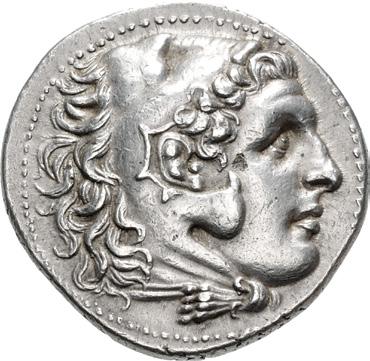

285. IONIA, Ephesos. Circa 300-290 BC. AR Tetradrachm (31mm, 17.19 g, 12h). In the name and types of Alexander III of Macedon. Head of Herakles right, wearing lion skin / ŬE$Å@droU, Zeus Aëtophoros seated left; in left field, bee right above EfE. Price 1876; Berlin obj. no. 18252333 (same obv. die). Lightly toned, small flan flaw on obverse. EF. Well centered. ($1000)
From the Michael Rogal Collection. Ex GTP Collection (Triton XXVI, 10 January 2023), lot 222; Hess-Divo 327 (22 October 2014), lot 21; Giessener Münzhandlung 58 (9 April 1992), lot 242.




286. IONIA, Ephesos. Circa 245-202 BC. AR Didrachm (20mm, 6.29 g, 1h). Grylis, magistrate. Draped bust of Artemis right, wearing stephane; bow and quiver over shoulder / Forepart of stag right; E-f across field, ˝rU¬5s to left, bee to right. SNG Copenhagen 270–5 var. (magistrate); BMC 94. Toned, hairline flan crack. EF. Very rare magistrate. ($750)
From the Michael Rogal Collection. Ex Classical Numismatic Group 100 (7 October 2015), lot 1446.



287. IONIA, Ephesos. Circa 123-119 BC. AV Stater (19mm, 8.40 g, 12h). Draped bust of Artemis right, wearing stephane and single-pendant earring, hair drawn together and tied in the back, bow and quiver over shoulder / Cult statue of Artemis of Ephesos facing, arms outstretched horizontally at sides, fillet hanging from each; E-f across upper field, thymiaterion to inner right. Jenkins, Hellenistic, pl. B, 6 = BM 1896,0601.67 = Montagu I 567 (same dies); Head p. 69, 2–6 var. (control mark); Gulbenkian 985 var. (same); CNG E-460, lot 242 (same dies); Münzen und Medaillen AG 41, lot 191 (same dies). Obverse struck with evenly worn die. Good VF. Rare. ($3000)
End of Session 1
Session 2 – Tuesday, January 14, 2025 — 2 PM


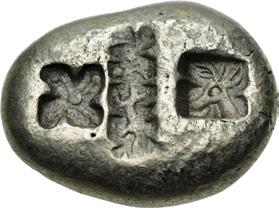

288. IONIA, Miletos. Circa 600-546 BC. EL Stater (22.5mm, 14.06 g, 12h). Lion reclining left, head reverted, within rectangular frame divided into smaller rectangular compartments / Central oblong punch, containing three pellets connected in Λ shape and a quadruped standing left, flanked by two punches containing, respectively, a stellate pattern and the head of a stag right. Hilbert Phase 2, S41.3 (dies A22/Hk8-F15-X3 – this coin); Weidauer 126 = Traité I 18 = BMC 2 (same die and punches); ANS inv. 1957.138.1 (same die and punches). Minor flan flaws, light scratches and cleaning marks. VF. ($3000)
From the Gerald F. Borrmann (Northern California Gentleman) Collection. Ex Classical Numismatic Group inventory 729965 (January 2002).


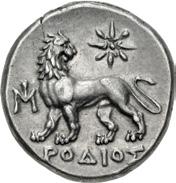

289. IONIA, Miletos. Circa 340-325 BC. AR Drachm (14.5mm, 3.68 g, 12h). Rhodios, magistrate. Head of Apollo left, wearing laurel wreath / Lion standing left, head right; star above, Û (civic) monogram to left, rod5o% in exergue. D-L Period I, Series III, 175 (V8/R14); SNG Copenhagen 964; BMC 66 (same dies). Attractive light tone. Superb EF. Perfectly centered and struck. ($500)

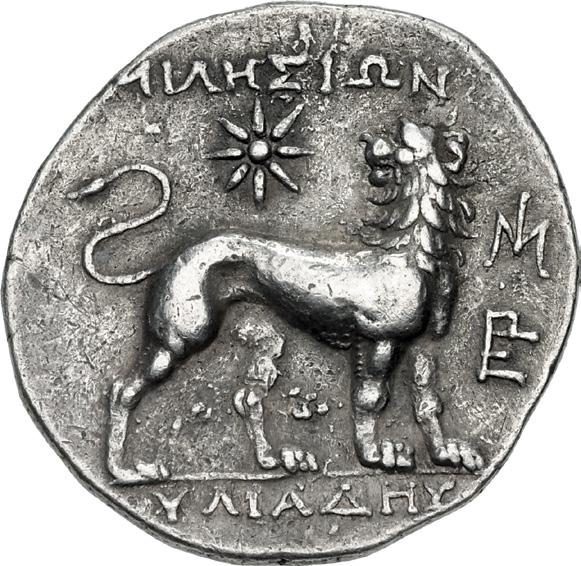

290. IONIA, Miletos. Circa 170-160 BC. AR Tetradrachm (32.5mm, 16.90 g, 1h). Oyliades, magistrate. Head of Apollo right, wearing laurel wreath / Lion standing right, head left; Â5¬˙%5W@ and star above; to right, Ÿ above Û (civic) monogram; [o]¬UÅd˙% in exergue. D-L 757 (V2/R6); Demetrius I Hoard 305. Lightly toned, struck from somewhat worn dies. VF. Very rare. ($1000)


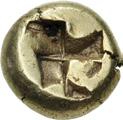
291. IONIA, Phokaia. Circa 625/0-522 BC. EL Hekte (10mm, 2.59 g). Lion couchant left; above, small seal left / Quadripartite incuse square. Bodenstedt Em. 27; Boston MFA 1902. Minor edge splits, a couple of light scrapes. Near EF. Rare. ($1500)
Ex Roma V (23 March 2013), lot 321.

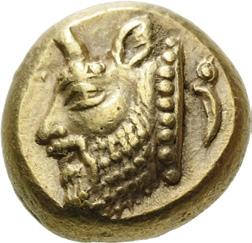

292. IONIA, Phokaia. Circa 521-478 BC. EL Hekte – Sixth Stater (10mm, 2.56 g). Horned head of river god left; to right, small seal upward / Quadripartite incuse square. Bodenstedt Em. 35; BMC 4; Kraay & Hirmer 597. Faintly toned. EF. Well centered and struck. ($1000)
From the Dr. Adrian Carr Collection. Ex Roma XV (5 April 2018), lot 150.
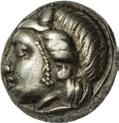


293. IONIA, Phokaia. Circa 478-387 BC. EL Hekte – Sixth Stater (10mm, 2.53 g). Head of Io left; below, small seal left / Quadripartite incuse square. Bodenstedt Em. 96; Bement 1476; BMC 57; Boston MFA 1918; Gulbenkian 930; Weber 6081. Lightly toned, minor die rust on obverse. Good VF. ($750)



294. IONIA, Phokaia. Circa 387-326 BC. EL Hekte – Sixth Stater (10.5mm, 2.54 g). Head of Omphale left, wearing lion skin; club behind neck; below, small seal left / Quadripartite incuse square. Bodenstedt Em. 107; SNG von Aulock 2133; Boston MFA 1917. Trace deposits, some cleaning scratches on edge. Good VF. Well centered. ($750)
In expiation for his murder of Iphitos at Tiryns, Herakles was ordered by the Delphic oracle to serve Omphale, the queen of Lydia, for one year. During this time, he performed a number of labors, similar to those which he undertook while serving Eurystheus, including the capture of the Kerkopes, the killing of the Syleus, and the conquest of the city of the Itones. At the same time, he was forced to wear women’s clothing and spin wool and, according to the poet Ovid (Fasti 2.305), at one point during this time Omphale even wore Herakles’ lion skin and carried his club while ordering him about. However, these actions seemed to have little ill-effect on the hero; after his year’s service was completed, Herakles married Omphale.



295. IONIA, Teos. Circa 500-450 BC. AR Stater (19.5mm, 11.75 g). Griffin with curled wings seated right, raising forepaw; grape bunch on vine to right / Quadripartite incuse square. Matzke Series Ca1; Balcer Group VII, 15, dies A15/P26; SNG von Aulock 2254 (same dies); SNG Fitzwilliam 4587 (same obv. die); SNG Lockett 2851 = Pozzi 2517 (same obv. die); Jameson 1516 (same obv. die); Nanteuil 613 (same obv. die). Faintly toned. Good VF. Well centered. ($1500)
Ex La Galerie des Monnaies IV (2 July 2022), lot 6.


296. IONIA, Teos. Circa 450-425 BC. AR Stater (22mm, 11.99 g). Griffin seated right, raising left forepaw, on ground line; below forepaw, head of female right; t-˙-o-˜ clockwise around from lower left / Quadripartite incuse square. Matzke Series Cb1; Balcer –; Mattingly, New 1 (same dies); CH VIII, pl. V, Hoard 47, 1 (same dies); Triton XIX, lot 236 (same dies); CNG 88, lot 354 (same dies). Light iridescent tone, area of flat strike, some light scratches on reverse. Near EF. ($1000)
From the Hesiod Collection. Ex Classical Numismatic Group Electronic Auction 539 (31 May 2023), lot 170; Lady’s Winged Horse Collection (Roma XXIII, 24 March 2022), lot 275; VAuctions 335 / Triskeles 27 (15 March 2019), lot 48; Pegasi Numismatics XXXIV (24 May 2016), lot 178; iNumis 25 (3 June 2014), lot 38.



297. IONIA, Uncertain. Circa 650-600 BC. EL Hekte – Sixth Stater (9.5mm, 2.39 g). Lydo-Milesian standard. Flattened striated surface / Two incuse squares. Weidauer Group II, 6–8; Artemision 29; Elektron II 11–2; Traité I 12; SNG Kayhan 680. Light scuff on reverse. Good VF. ($2000)
From the MM Collection. Ex Triton XIX (5 January 2016), lot 238.



298. IONIA, Uncertain. Circa 650-600 BC. EL Hekte – Sixth Stater (8mm, 2.42 g). Lydo-Milesian standard. Flattened striated surface / Two incuse squares. Weidauer Group II, 6–8; Artemision 29; Elektron II 11–2; Traité I 12; SNG Kayhan 680 (same punches); Boston MFA Supp. 161 (same punches). VF. ($1000)
From the Gerald F. Borrmann (Northern California Gentleman) Collection. Ex Classical Numismatic Group 70 (21 September 2005), lot 273.

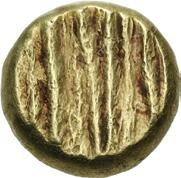

299. IONIA, Uncertain. Circa 650-600 BC. EL Hemihekte – Twelfth Stater (7mm, 1.30 g). Lydo-Milesian standard. Flattened striated surface / Incuse square. Weidauer Group II, 9; cf. Artemision 29 and 4 (hekte and myshiemihekte); Elektron II 13–4; Traité I 13; SNG Kayhan 681. Trace deposits. Near EF. ($1000)
From the MM Collection. Ex Heritage 231923 (6 June 2019), lot 81034.



300. IONIA, Uncertain. Circa 650-600 BC. EL Hemihekte – Twelfth Stater (7mm, 1.16 g). Lydo-Milesian standard. Flattened striated surface / Incuse square. Weidauer Group II, 9; cf. Artemision 29 and 4 (hekte and myshiemihekte); Elektron II 13–4; Traité I 13; SNG Kayhan 681. Tiny nick on edge. Good VF. ($1000)
From the JTB Collection. Ex Heritage 3098 (18 January 2022), lot 33130.



301. IONIA, Uncertain. Circa 650-600 BC. EL Trite – Third Stater (12mm, 4.64 g). Lydo-Milesian standard. Globular surface with cluster of pellets / Two incuse squares. Weidauer –; Artemision –; Elektron –; Traité I 3; SNG Kayhan –; SNG von Aulock 7761; Boston MFA 1749; Pozzi 2350; Rosen 253. Minor edge splits. As made. ($1000)



302. IONIA, Uncertain. Circa 650-600 BC. EL Trite – Third Stater (12.5mm, 4.58 g). Lydo-Milesian standard. Globular surface with cluster of pellets / Incuse rectangle. Weidauer –; Artemision –; Elektron –; Traité I 3 var. (incuse); SNG Kayhan –; SNG von Aulock 7761 var. (same); CNG 127, lot 222 (same die and punch). Minor edge splits. As made. ($1000)



303. IONIA, Uncertain. Circa 650-625 BC. EL Trite – Third Stater (13.5mm, 4.77 g). Lydo-Milesian standard. Pegasos walking left / Two incuse squares. Fischer-Bossert, Horses, Series II, 3b (dies P3/P3-P4) = Prospero 501 (this coin); Weidauer 149; Linzalone 1129; SNG Kayhan 1560. Some marks, die wear on obverse. VF. ($2000)
From the Gerald F. Borrmann (Northern California Gentleman) Collection. Ex Prospero Collection (The New York Sale XXVII, 4 January 2012), lot 501; Sternberg XXI (14 November 1988), lot 124.




304. IONIA, Uncertain. Circa 625-600 BC. EL Hemihekte – Twelfth Stater (7.5mm, 1.15 g). Lydo-Milesian standard. Geometric figure resembling a star, composed of a cross centered upon a polygon of eight sides / Quadripartite incuse square with a pellet in the center; each quarter contains a diagonal line radiating from the central pellet. McFadden 3; Elektron –; Traité –; Zhuyuetang 4; SNG von Aulock –; SNG Kayhan 699–700. Toned. Near EF. ($750)
From the MM Collection. Ex L. Shea Collection (Triton XX, 9 January 2017), lot 290; Classical Numismatic Group Electronic Auction 330 (9 July 2014), lot 74.

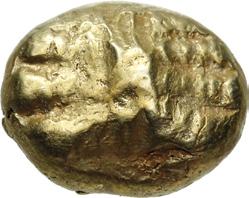

305. IONIA, Uncertain. Circa 600-550 BC. EL Hekte – Sixth Stater (10mm, 2.34 g). Lydo-Milesian standard. Thunderbolt / Two incuse squares. Linzalone 1143 = CNG 66, lot 465; CNG 99, lot 246; otherwise unpublished in the standard references. VF. Extremely rare. ($750)
From the MM Collection. Ex Classical Numismatic Group 105 (10 May 2017), lot 344.



306. IONIA, Uncertain. Circa 600-550 BC. EL Hekte – Sixth Stater (10.5mm, 2.35 g). Lydo-Milesian standard. Schematic head of lion right / Rough incuse square. Weidauer 119; cf. Elektron II 24 (hemihekte); Traité –; SNG von Aulock –; cf. SNG Kayhan 708–10 (myshemihektai); SNG Berry 1029. Trace deposits, minor die wear. Good VF. Rare. ($1500)
From the MM Collection. Ex Gorny & Mosch 199 (10 October 2011), lot 25 (hammer £2200).


307. ISLANDS off IONIA, Samos. Circa 600-570 BC. EL Stater (21.5mm, 17.27 g). Mosaic of varying bulges / Two parallel incuse rectangles. Konuk, Electrum, Type 1; Barron pl. XXX, 1; Weidauer 196; HGC 6, 1164. Trace deposits. Good VF. Extremely rare. ($7500)
From the MM Collection. Ex Nomos FPL (Winter/Spring 2016), no. 419160 (priced $17,500); Numismatica Ars Classica 88 (8 October 2015), lot 594.




308. ISLANDS off IONIA, Samos. Circa 408/4-380/66 BC. AR Tetradrachm (24.5mm, 15.12 g, 7h). Leos, magistrate. Facing lion scalp / Forepart of bull right; ¬Eos above, olive branch to left, g and sÅ below; all within shallow incuse square. Barron Class X, 133–4 var. (unlisted dies); HGC 6, 1218; Hecatomnus 45 = CNG E-399, lot 190 = Lanz 26, lot 250 (same dies?); Hirsch 1530; Weber 6305. A touch of porosity, some die wear. Near EF. Rare with this magistrate. ($3000)
From the Michael Rogal Collection. Ex Classical Numismatic Group 106 (13 September 2017), lot 404.



309. KINGS of LYDIA. Alyattes. Circa 620/10-564/53 BC. EL Hekte – Sixth Stater (10mm, 2.35 g). Lydo-Milesian standard. Sardes mint. Confronted heads of roaring lions, “sun” on foreheads (die positioned to feature the left side lion); traces of letters to left / Two incuse squares. Cf. Weidauer Group XVII (for other signed issues, but letters between lion heads); otherwise, unpublished. Tiny scuff on obverse. Near EF. Apparently unique. ($1500)



310. KINGS of LYDIA. Kroisos. Circa 564/53-550/39 BC. AV Stater (17.5mm, 8.00 g). Light standard. Sardes mint. Confronted foreparts of lion and bull / Two incuse squares. Berk 3; Kurth G51; Le Rider, Naissance, pl. V, 8; Traité I 401–3; SNG von Aulock 2875; BMC 31; Boston MFA 2073; Gulbenkian 757. Minor deposits, some die wear and a few marks on obverse. VF. ($10,000)
From the Gerald F. Borrmann (Northern California Gentleman) Collection, purchased from Superior, 27 May 1986.



311. KINGS of LYDIA. Kroisos. Circa 564/53-550/39 BC. AV Twelfth Stater (7mm, 0.87 g). Heavy standard. Sardes mint. Confronted foreparts of lion and bull / Two square punches. Walburg Group V; Berk 9; Kurth G55. Weakly struck on obverse. Good VF. Rare. ($1000)



312. KINGS of LYDIA. Kroisos. Circa 564/53-550/39 BC. AR Hemistater (17mm, 5.26 g). Sardes mint. Confronted foreparts of lion and bull / Two incuse squares. Berk 23; Kurth S3; SNG Ashmolean –; SNG Kayhan 1024–6; Boston MFA –; Rosen 665. Typical granular surfaces, a few minor marks. Near EF. Exceptional for issue, with complete type visible on the flan. ($1000)
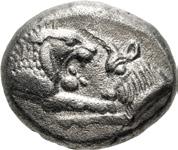


313. KINGS of LYDIA. Kroisos. Circa 564/53-550/39 BC. AR Third Stater (14mm, 3.49 g). Sardes mint. Confronted foreparts of lion and bull / Two incuse squares. Berk 24; Kurth S5; SNG Ashmolean 772 (Persian period); Boston MFA 2071 = Warren 1291; Rosen 666. Typical light granularity, minor scuff on obverse. Good VF. Well centered on a broad flan. ($750)



314. KINGS of LYDIA. Kroisos. Circa 564/53-550/39 BC. AR Sixth Stater (11mm, 1.78 g). Sardes mint. Confronted foreparts of lion and bull / Two incuse squares. Berk 25; Kurth S6–7; SNG Ashmolean 773 (Persian period); SNG Lockett 2982 = Bement 1569; Boston MFA –; Rosen 667. Faintly toned. Near EF. Well centered on excellent metal. ($750)

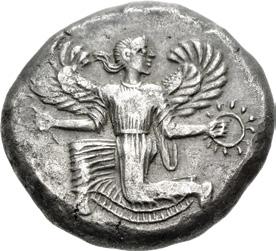


315. CARIA, Kaunos. Circa 450-430 BC. AR Stater (21.5mm, 11.80 g, 12h). Winged female figure, wearing long chiton, in kneeling-running stance left, head right, holding kerykeion in right hand and wreath in left / Baetyl(?); clusters of pellets around; all within incuse square. Konuk Period III, 86 (O30/R27); HN Online 787; SNG Ashmolean 37 = ACGC 994 (same obv. die); SNG Delepierre 2784 (same obv. die). Toned, granular surfaces. Near EF. ($4000)
From the JTB Collection. Ex Gorny & Mosch 240 (10 October 2016), lot 239; Lanz 153 (12 December 2011), lot 277.



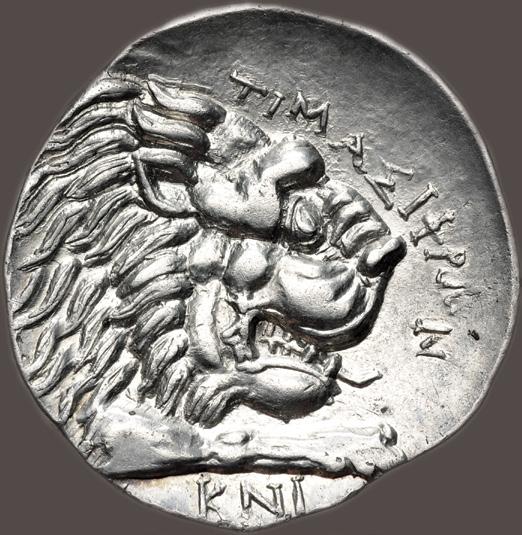
316. CARIA, Knidos. Circa 350-330/20 BC. AR Tetradrachm (28mm, 15.01 g, 12h). Chian standard. Timasiphron, magistrate. Head of Aphrodite right, hair tied in the back, wearing single-pendant earring and pearl necklace / Forepart of lion right; t5ÂÅs5frW@ above, ˚@5 below. Unpublished, but cf. Ashton, Late 5–6 (for an issue of similar style). Attractive light iridescent tone over lustrous surfaces, die wear and a couple of minor scratches on obverse. Good VF. Wonderful Hellenistic style. ($7500)
Ex Künker 236 (7 October 2013), lot 98; Triton X (9 January 2007), lot 340.
An important city which comprised settlements on both the mainland and an adjoining island that was bridged by a causeway, Knidos was a partner in the Dorian Hexapolis, a federation of six regional cities of Doric colonization, which included Kos, Halikarnassos, Lindos, Ialysos, and Kamiros. Because of its connection with the trading routes along the Ionian coast, Knidos became an important and affluent trading center, and the city was adorned with numerous impressive public buildings, both within the city itself and in the surrounding countryside. Among these buildings were the Temple of the Triopian Apollo, where the members of the Hexapolis met and whose symbol was the lion; hence, the use of the lion as one of the civic badges on the coinage.
Because Knidos had been originally settled by Phoenicians prior to its Doric colonization, it also possessed a large temple dedicated to Aphrodite Euploia – the Phoenician Asherar-yam. As a result of the godessess’s importance to the city, the head of Aphrodite was included on the coinage. Because of the city’s connection with Aphrodite, in the fourth century BC, Knidos acquired a cult-statue of the goddess by the sculptor Praxitiles. After it was rejected by the citizens of Kos – for whom it had been commissioned – because it showed Aphrodite nude for the first time, Knidos purchased the statue, erecting it in an open air temple so that it could be viewed from all angles. As a result, it became a popular tourist attraction and the subject of numerous tales of all types.


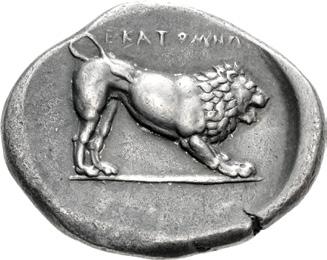

317. SATRAPS of CARIA. Hekatomnos. Circa 392/1-377/6 BC. AR Tetradrachm (22mm, 15.09 g, 3h). Chian standard. Mylasa mint. Struck circa 380 BC. Zeus Labraundos standing right, wearing chiton and himation wrapped around his left arm, holding labrys in right hand, left hand on staff set on ground to right / Lion at bay right; EkÅtoµ@W above; all within incuse circle. Hecatomnus 49 (A6/P20); Konuk, Identities 15; Babelon, Perses –; HN Online 223; SNG von Aulock 2354; SNG Kayhan 868–9; Traité II 82. Old cabinet tone. Good VF. Exceptional for issue. ($3000)
From the Gerald F. Borrmann (Northern California Gentleman) Collection, purchased from Dr. Arnold Saslow, 13 April 1985.



318. SATRAPS of CARIA. Maussolos. Circa 377/6-353/2 BC. AR Tetradrachm (23.5mm, 14.55 g, 12h). Halikarnassos mint. Struck circa 370-360 BC. Head of Apollo facing slightly right, wearing laurel wreath, drapery around neck / Zeus Labraundos standing right, wearing chiton and himation wrapped around his left arm, holding labrys in right hand, left hand on staff set on ground to right; ÂÅUssW¬¬o to right. Konuk, Identities 21; Babelon, Perses 397; HN Online 228; SNG von Aulock –; SNG Kayhan 1683; Traité II 91. Toned, minor deposits, some light scratches under tone. Near EF. Well centered. ($1500)
From the Gerald F. Borrmann (Northern California Gentleman) Collection, purchased from Dr. Arnold Saslow, April 1986.
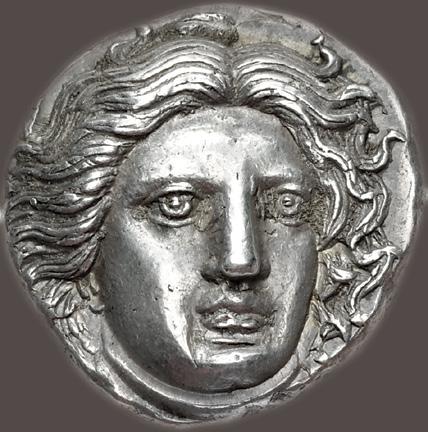



319. ISLANDS off CARIA, Rhodos. Rhodes. Circa 408/7-404 BC. AR Tetradrachm (23.5mm, 15.15 g, 12h). Head of Helios facing slightly right / Rose in profile, with bud to left; rod5o@ above; f and facing boukranion to right; all within incuse square. Hecatomnus 106a (A70/P76) = Bérend, Tétradrachmes 75 = HN Online 1034.4 = Prospero 560 (this coin); Ashton 42; HGC 6, 1417; SNG Ashmolean 539; SNG von Aulock –; SNG Fitzwilliam 4778 = Weber 6715; SNG Keckman –; Karl –. Beautiful even gray tone, with some iridescence around the devices, a little die rust on obverse, a couple of minor scratches in field on reverse. Superb EF. Fine style, and the finest 5th century Rhodian tetradrachm in CoinArchives. ($20,000)
From the Georges Albert Haikel Collection. Ex Prospero Collection (New York Sale XXVII, 4 January 2012), lot 560, purchased from Spink, 10 February 1983; Numismatic Fine Arts VIII (6 June 1980), lot 300; 1971 Marmaris Hoard (IGCH 1209).
The polis of Rhodes was created out of a synoecism of the cities of Ialysos, Kamiros, and Lindos in 408/7 BC, and immediately began to issue a series of coinage that endured until the Roman era. The rose was chosen as the perennial reverse type, a punning allusion to the city’s name. The obverse type was usually the head of Helios, the patron deity of the new polis, but occasionally the nymph Rhodos appeared. Until the end of the Rhodian series, these types adorned the coins, with a few exceptional issues that featured novel designs. The Chian standard was employed, although after a reduction in the late 340s, the standard is commonly called ‘Rhodian.’ The first issue of Rhodian coinage was a brief, yet large issue of tetradrachms, that stand among the finest pieces of Classical Greek art. On the obverse, the head of Helios is displayed in a nearly frontal position. Such facing head coins were not novel by this time, but the boldness of the design and the particularly high relief of the dies sets the Rhodian coinage apart from all others. Moreover, this facing head type was the standard obverse type for most of the Rhodian issues. The tetradrachm was the primary denomination until the later 4th century, when the didrachm became preeminent. Both of these denominations were supplemented by a wide variety of fractions, in both silver and bronze, and the tetradrachm was also issued on occasion after the 4th century. Around 190 BC, the coinage system was completely reorganized, with the primary denomination being the drachm, struck on a standard called ‘plinthophoric’ for the square incuse around the reverse type (plinthos = brick or ingot). Gold coinage was issued only on very rare occasions, and not until the 2nd century BC. As noted by Ashton, the coinage was issued fairly regularly, with occasional spikes in production that correlate to either construction work (e.g. the building of the Colossus) or military necessity. As a primary trading center in the Mediterranean, it is not surprising that the bulk of the coinage of Rhodes appears to have been used for regular state expenditure, such as maintaining its fleet, paying mercenaries, making contributions to the Nesiotic League (revived by Rhodes circa 200 BC), paying state officials, and maintaining a system that cared for its needy citizens (Ashton, pp. 96-7). The massive amount of coinage struck by Rhodes is evidenced by the adoption of the Rhodian weight standard by many other cities in the Hellenistic period, as well as the large amounts of Rhodian coins found in hoards today.



320. ISLANDS off CARIA, Rhodos. Rhodes. Circa 229-205 BC. AR Tetradrachm (23.5mm, 13.29 g, 12h). Ameinias, magistrate. Radiate head of Helios facing slightly right / Rose in profile, with bud to right; rod5o@ above; to left, prow right; ÅÂE5@5Å% flanking stem. Ashton 212; HN Online 387; HGC 6, 1432; SNG von Aulock 2799; SNG Copenhagen 759; SNG Keckman 542; Boston MFA 2054. Lightly toned. Good VF. Exceptional strike in high relief. ($3000)
Ex Hunter Collection (Goldberg 72, 5 February 2013), lot 4080; Sunrise Collection (Triton X, 9 January 2007), lot 363.
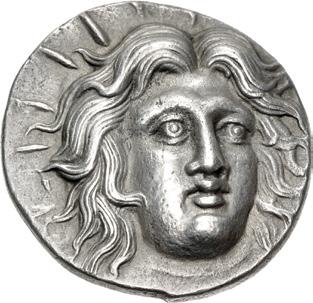

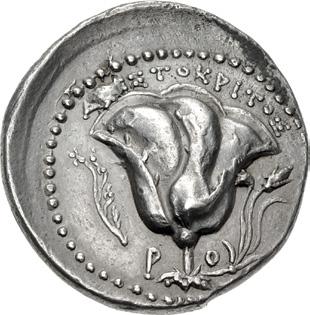
321. ISLANDS off CARIA, Rhodos. Rhodes. Circa 205-190 BC. AR Tetradrachm (26mm, 13.00 g, 1h). Aristokritos, magistrate. Radiate head of Helios facing slightly right / Rose in profile, with bud to right; Å[r]5%to˚r5to% above, aphlaston to left, r-o flanking stem. Ashton 213; HN Online 670; HGC 6, 1422; SNG Delepierre 2762; SNG Keckman 545; Boston MFA 2055; de Luynes 2723. Lovely old collection tone, small patch of find patina, a couple of minor die breaks and a little off center on reverse. EF. Struck from a fresh obverse die, with an expressive face of Helios. ($2000)
From the Columbus Collection. Ex Triton IV (5 December 2000), lot 280; Münzen und Medaillen AG 53 (29 November 1977), lot 115.



322. ISLANDS off CARIA, Rhodos. Rhodes. Circa 205-190 BC. AR Tetradrachm (26mm, 13.41 g, 12h). Aristoboulos, magistrate. Radiate head of Helios facing slightly right / Rose in profile, with bud to right; År5%to∫oU¬o% above, thunderbolt to left, r-o flanking stem. Ashton 263; HN Online 1249.2 (this coin); HGC 6, 1422; SNG Copenhagen 755; SNG Keckman –. Attractive light gray tone with faint golden hues around the devices. Superb EF. Perfectly centered and struck. Very rare issue, one of only two in HN Online, three additional in CoinArchives. ($5000)
From the Michael Rogal Collection. Ex Classical Numismatic Group 100 (7 October 2015), lot 1511; J.J. Grano Collection (Numismatica Genevensis SA VIII, 24 November 2014), lot 54; Numismatica Genevensis SA V (3 December 2008), lot 127; Nomos FPL (Winter-Spring 2008), no. 58a.
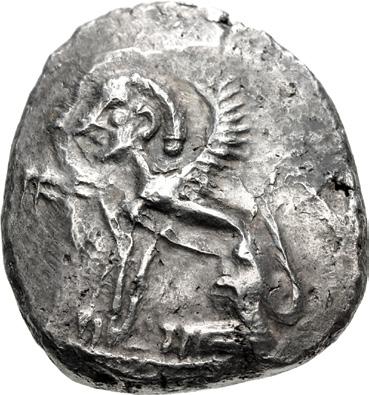



323. DYNASTS of LYCIA. Uncertain (Ãmartite?). Circa 480-460 BC. AR Stater (19.5mm, 9.48 g, 10h). Sphinx seated left, raising right forepaw / Crab; g (ē in Lycian) above; all within incuse square. Müseler III, 22 var. (no letter on rev.); Falghera 53 = SNG von Aulock 4084 (same dies); SNG Copenhagen Supp. 398 var. (sphinx right, no letter). Lightly toned, minor double strike and a few flan flaws on obverse. Good VF. Very rare. ($1500)
From the Hesiod Collection.




324. DYNASTS of LYCIA. Uncertain (Kuprilli or contemporary). Circa 480-440 BC. AR Stater (20.5mm, 8.88 g). Lion standing left, eating leg of prey / Triskeles in dotted square within incuse square. Müseler IV, 62 = Reuter 22 (this coin); Falghera –; Weber 7219. Lightly toned, a couple of light scratches and area of weak strike on obverse. Good VF. Extremely rare. ($1000)
Ex Reuter Collection (Peus 360, 27 April 1999), lot 22.



325. DYNASTS of LYCIA. Vekhssere I. Circa 450-430/20 BC. AR Stater (18mm, 8.50 g). Uncertain mint (Telmessos?). Figure of Herakles, nude but for lion skin headdress hanging behind him, advancing left, head right, holding club over shoulder in right hand / Triskeles; Ffe-ßßj-r-j (WEXSSERE in Lycian) around, diskeles to lower left; all in dotted square border within incuse square. MAL I Type VII, 27 (D2/R1); Müseler V, 19–20 (same rev. die); Falghera –; SNG Copenhagen Supp. 434 (same dies); BMC 116 (same dies); Traité II 427. Attractively toned, a few faint cleaning marks in field on obverse. Good VF. Artistic obverse type. Very rare, one of only three in CoinArchives. ($3000)
Ex A. F. Collection (Roma XVI, 26 September 2018), lot 315 (hammer £4200).
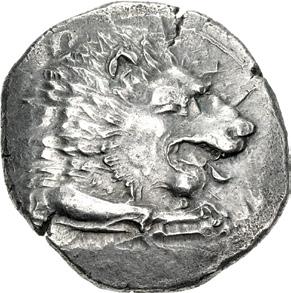


326. DYNASTS of LYCIA. Mithrapata. Circa 390-370 BC. AR Stater (25.5mm, 9.64 g, 9h). Forepart of lion right / Head of Mithrapata left; µEtR-®-π-®T® (MITHRAPATA in Lycian) around, triskeles to lower right; all within incuse square. Mildenberg, Mithrapata 6 (dies 3/5); Podalia 60–7 (A3/P5); Müseler VII, 71 (same dies); Falghera –; Reuter 98–9; SNG Copenhagen Supp. 472 (same dies); Boston MFA Supp. 229 (same dies); Kraay & Hirmer 658 (same dies). Lightly toned, some die wear on obverse. EF. Well centered. Excellent portrait. ($3000)
The portraits on coins in the later Lycian series are among the finest of the Classical period. Among the earliest to attempt depictions of their rulers on coinage, the Lycians’ first portraits in the later 5th century BC were innovative, but static, idealized forms lacking individual characterization. Over the next half-century, however, the style progressed significantly toward realism, culminating in the issues of the dynasts Mithrapata and Perikles in the early-mid 4th century BC. The coins of Mithrapata came first, depicting on their reverse the profile portrait of a man with distinctive elderly features. Through the relative chronology established in L. Mildenberg’s die study, one can even see the portrait become more aged as time progressed, reflecting the realism that had been captured in these issues. The coins of Perikles, Mithrapata’s successor, continue this trend, but also have two innovations that set them at the pinnacle of classical portraiture. First, the portrait is moved to the obverse of the coin, emphasizing the importance of the individual. Second, and most prominently, the portrait is not in the traditional profile, but in a dramatic facing state. Obviously influenced by Kimon’s facing Arethusa-head coinage at Syracuse, these depict Perikles looking out from the surface of the coin with a serene countenance and his hair flowing around him as if blown by the wind. This depiction captures the essence of the earlier idealized portraits, conveying to the viewer a sense that Perikles was more than a mere man, but retaining the realism in its individualized features. Interestingly, both Mithrapata and Perikles are depicted without any sort of satrapal headgear, which was always included in earlier Lycian portraits, perhaps indicating that they had declared their independence from the Persian king. Unfortunately, these astonishing developments in portraiture came to an abrupt end in Lycia when Maussollos of Caria invaded the region circa 360 BC.



327. PAMPHYLIA, Aspendos. Circa 400-380 BC. AR Stater (23.5mm, 10.80 g, 11h). Two wrestlers grappling; pellet between / Slinger in throwing stance right; [Est]VEd55U[s] to left, clockwise triskeles to right; all in dotted square border within shallow incuse square. Tekin Series 3; SNG BN 74; SNG von Aulock 4536–7 var. (counterclockwise triskeles). Attractive light iridescent tone, minor die wear, a few small flan flaws on reverse. Good VF. ($1000)
From the collection of Major Anthony F. Milavic, USMC (Ret.), purchased from Bank Leu, December 1991.



328. PAMPHYLIA, Aspendos. Circa 380/75-330/25 BC. AR Stater (21.5mm, 10.92 g, 3h). Two wrestlers grappling; dr between / Slinger in throwing stance right; EstVEd55U[s] to left, counterclockwise triskeles to right; all in dotted square border. Tekin Series 4; SNG BN 90; SNG von Aulock 4550–2. Beautiful old collection tone, with underlying luster and iridescence, minor doubling on reverse. EF. Struck from fresh dies. ($1500)
From the collection of Major Anthony F. Milavic, USMC (Ret.), purchased from Dr. Arnold Saslow, May 1988.



329. PAMPHYLIA, Aspendos. Circa 330/25-300/250 BC. AR Stater (23.5mm, 10.58 g, 12h). Two wrestlers grappling; ∏o between, below / Slinger in throwing stance right; EstVEd55U to left; to right, forepart of horse right above Ă; all within dotted square border. Tekin Series 5; SNG BN 110 (same dies); SNG von Aulock 4571 var. (monogram). Faintly toned. Near EF. ($1000)
Ex Classical Numismatic Group inventory 926179 (May 2012); Heritage 3019 (26 April 2012), lot 23162.


330. PAMPHYLIA, Aspendos. Circa 330/25-300/250 BC. AR Stater (25mm, 10.40 g, 1h). Two wrestlers grappling; ∏o between, below / Slinger in throwing stance right; EstVEd55Us to left; to right, forepart of horse right above Phrygian helmet right; all within dotted circular border. Tekin Series 5; SNG BN 110 var. (symbol below horse, ethnic); SNG von Aulock 4571 var. (same); SNG Lockett 3020 var. (ethnic). Faintly toned, light porosity. Near EF. ($1000)
From the Gerald F. Borrmann (Northern California Gentleman) Collection. Ex Triton XVI (8 January 2013), lot 514.


331. PAMPHYLIA, Side. Circa 205-100 BC. AR Tetradrachm (28mm, 16.90 g, 12h). Attic standard. Die–, magistrate. Head of Athena right, wearing crested Corinthian helmet / Nike advancing left, holding wreath in extended right hand; to left, pomegranate above @E. Seyrig, Side 12; SNG BN 670–3; SNG von Aulock 4785; SNG Copenhagen 391. Underlying luster, a couple of small die breaks, tiny flan flaw on obverse. Near EF. ($750)
From the JTB Collection, purchased from Warden Numismatics.



332. PISIDIA, Selge. Circa 400-325 BC. AR Stater (21mm, 10.88 g, 11h). Two wrestlers grappling / Slinger in throwing stance right; [E]st¬E˝EUs to left; to right, clockwise triskeles above astragalos; all in dotted square border within shallow incuse square. SNG BN 1915; SNG von Aulock 5243; SNG Copenhagen 232. Toned, small scrape on reverse. Near EF. ($1000)
From the collection of Major Anthony F. Milavic, USMC (Ret.). Ex Frank J. Novak Collection (Classical Numismatic Group XXXI, 9 September 1994), lot 760.
Ex Gillet Collection



333. CILICIA, Mallos. Circa 390-385 BC. AR Stater (22mm, 10.18 g, 12h). Persian king, wearing kidaris and kandys, in kneeling-running stance right, holding spear in right hand, bow in left; barley grain to left / Herakles wrestling with the Nemean Lion; µ[Å2] and club to left. Casabonne Type 7; SNG BN 398; SNG Levante Supp. 24 = Waddington 4358 (same rev. die); SNG von Aulock 5718 (same dies); Gillet 1165 (this coin); Pozzi 2825 (same dies); Weber 7566 (same dies). Toned, some die wear and marks, a little off center on reverse. Good VF. ($3000)
Ex Leu 76 (17 October 1999), lot 211; Charles Gillet (†1972) Collection.



334. CILICIA, Mallos. Circa 385-375 BC. AR Stater (21mm, 10.56 g, 10h). Herakles kneeling left, strangling the Nemean Lion on horizontal club below / Bearded head left, wearing laurel wreath; µÅ2 to left. Casabonne Type 10; SNG BN –; SNG Levante 154, SNG von Aulock –; Athena Fund II 776 (this coin); Sunrise 89 = Athena Fund II 777 (same obv. die). Faint iridescent tone, struck with worn obverse die, a little off center on reverse. Near EF. Very rare. ($1000)
Ex Athena Fund (Part II, Sotheby’s Zurich, 27 October 1993), lot 776.



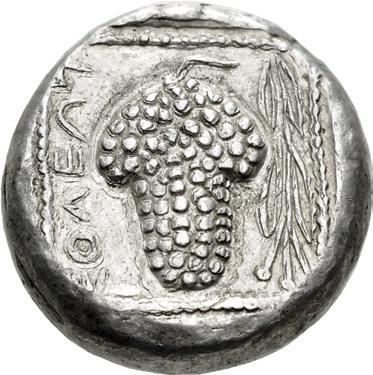
335. CILICIA, Soloi. Circa 440-410 BC. AR Stater (19.5mm, 11.02 g, 11h). Amazon, wearing pointed cap and nude to her waist, kneeling left, holding bow in both hands, quiver on left hip; ivy leaves to left; to right, Corinthian helmet left / Grape bunch on vine; so¬EWn to left, laurel branch to right; all in dotted square within incuse square. Casabonne Type 1; SNG BN –; SNG Levante 37 var. (orientation of leaves); SNG von Aulock 5857 var. (same). Toned, slight doubling on reverse. Near EF. ($1000)
From the JTB Collection. Ex Nomos 21 (21 November 2020), lot 226.


336. CILICIA, Soloi. Circa 410-375 BC. AR Stater (20mm, 10.72 g, 11h). Head of Athena right, wearing crested Attic helmet decorated with a griffin on the bowl / Grape bunch on vine tendril with leaf to right; so¬EW@ to left, A to lower right. Casabonne Type 5; SNG BN –; SNG Levante –; SNG von Aulock –; Triton XXVII, lot 313 (same dies); Triton XXV, lot 296 (same dies). In NGC encapsulation 6558877-010, graded Ch XF, Strike: 4/5, Surface: 4/5. ($750)
Ex Davissons 41 (16 March 2022), lot 55; Leu Numismatik AG Web Auction 18 (18 December 2021), lot 1346.



337. CILICIA, Soloi. Circa 410-375 BC. AR Stater (22mm, 9.88 g, 5h). Head of Athena right, wearing triple-crested Corinthian helmet, single-pendant earring, and necklace / Grape bunch on vine tendril with leaf; rose in profile and Âos to left; to right, owl standing right, head facing; so¬EW@ below. Casabonne Type 7; SNG BN –; SNG Levante 51 var. (no rose); SNG von Aulock 5871 var. (same); Traité II 1442; M&M AG FPL 126 (1953), no. 15 (same obv. die); Triton V, lot 1470 (same obv . die). Iridescent tone, light porosity, a couple of green deposits, a few light marks on obverse. Good VF. Very rare variety. ($750)
Ex Kleinkunst Collection (Leu Numismatik AG 6, 23 October 2020), lot 247; Leu 79 (31 October 2000), lot 706; Kastner FPL 8 (November 1975), no. 87.


338. CILICIA, Tarsos. Circa 389-375 BC. AR Stater (22mm, 10.45 g, 6h). Herakles kneeling left, strangling the Nemean Lion on horizontal club below / Head of Hera left, wearing stephane decorated with palmette between two circles containing large pellets, single-pendant earring, and pearl necklace; tErs5˚o[@] to left. Casabonne Group J1; SNG BN 235; SNG Levante 63; SNG von Aulock –; Athena Fund II 795 (same obv. die); Gillet 1166. Faintly toned, some porosity, area of die rust on obverse. Good VF. Fine style. ($1000)
Ex G. Hirsch 275 (22 September 2011), lot 3974; Sternberg XXXV (29 October 2000), lot 295.
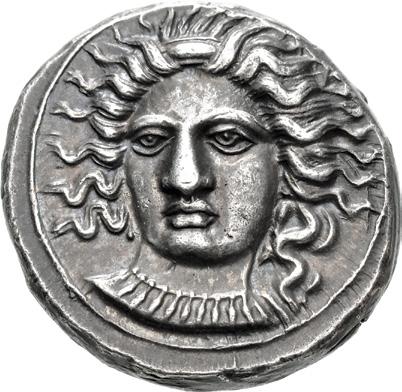
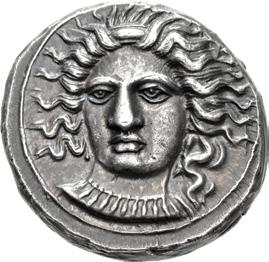


339. CILICIA, Tarsos. Pharnabazos. Persian military commander, 380-374/3 BC. AR Stater (20mm, 10.65 g, 11h). Struck circa 380-379 BC. Head of Arethousa facing slightly left, hair in ampyx, wearing single-pendant earrings and necklace with pendants / Bearded head left, wearing crested helmet with raised earflap and floral motif, drapery around neck; wzbnRp (FRNBZW in Aramaic) to left. Casabonne Series 3; Moysey Issue 3, 27a (same dies); SNG BN –; SNG Levante –; SNG von Aulock 5920-1; Leu 7, lot 264 = Hess-Leu (March 1959), lot 283 (same dies). Deep iridescent tone. EF. ($1500)
From the Michael Rogal Collection. Ex Triton XVI (8 January 2013), lot 530.



340. CILICIA, Tarsos. Mazaios. Satrap of Cilicia, 361/0-334 BC. AR Stater (23mm, 10.66 g, 1h). Baal of Tarsos seated left, head and torso facing, holding eagle, grain ear, and grape bunch in extended right hand, lotus-tipped scepter in left; rt (TN in Aramaic) to left, M (M in Aramaic) below throne, zRtL`b (B’LTRZ in Aramaic) to right / Lion left, attacking bull left; ydzM (MZDY in Aramaic) above, å below. Casabonne Series 2, Group C; SNG BN –; SNG Levante 106 (same dies). In NGC encapsulation 6060767-006, graded MS, Strike: 4/5, Surface: 3/5, die shift. ($1500)



341. ASIA MINOR, Uncertain. Early-mid 5th century BC. AR Diobol or Eighth Stater(?) (10mm, 1.24 g). Two wrestlers grappling; aryballos(?) between / Incuse square punch. Lanz 151, lot 501; cf. A. Milavic, “Research and analysis reveal the first Greek wrestler-type coin” in The Celator 7.2 (February 1993), pp. 6–12 = A. Milavic, “The First Greek Wrestler-Type Coin” in The International Journal of the History of Sport 10 (December 1993), pp. 409–17 (obol); otherwise, unpublished in the standard references. Toned, granular surfaces. VF. Extremely rare. ($750)
From the collection of Major Anthony F. Milavic, USMC (Ret.). Ex Classical Numismatic Group Electronic Auction 319 (29 January 2014), lot 101; Münzen und Medaillen AG FPL 538 (November 1990), no. 98 (as Aspendos).
Although this obverse type is featured prominently on the staters of Aspendos and Selge, this fraction does seem not fit into the scheme of either city’s coinage. This type was not used on their coins until late in the 5th century, certainly too late for this issue. Also, the weights of the known pieces do not seem to comport with the weights of the other denominations at either city during the early-mid 5th century.



342. KINGS of ARMENIA. Tigranes ‘the Younger’. 77/6-66 BC. AR Tetradrachm (31mm, 15.83 g, 1h). Tigranocerta mint. Struck circa 71 BC. Diademed and draped bust right, wearing tiara decorated with comet / ∫Å%5¬EW% t5˝rÅ@oU, Tyche of Antioch seated right on rock, holding laurel branch; below, river-god Orontes swimming right; ∏ to inner right, d˙Âo below rock; all within wreath. SCADA Group 1, dies A4/P2; Kovacs 152 (same dies as illustration); M&D 32; CAA 11; AC – (all but Kovacs as Tigranes II). Lightly toned, area of weak strike. VF. Very rare. ($5000)

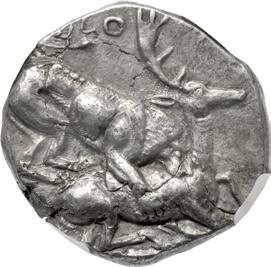
343. CYPRUS, Kition. Baalmelek II. Circa 425/0-400 BC. AR Stater (20mm, 11.09 g, 9h). Herakles, nude but for lion skin tied around neck, in fighting stance right, holding club overhead in right hand and bow in extended left hand; e to right / Lion attacking stag crouching right; [kÒ]MÒoB [Ò] ([L] B’LM[LK] = “of king Baalmelek” in Aramaic) above; all in dotted square within incuse square. Zapiti & Michaelidou 12; Tziambazis 19. In NGC encapsulation 6327036-007, graded AU, Strike: 4/5, Surface: 4/5, flan flaw. An attractive example of the type. ($1000)



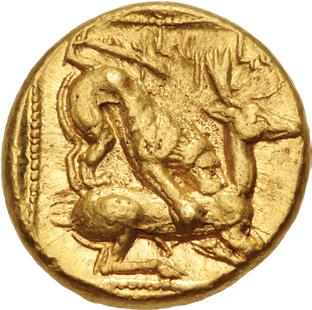
344. CYPRUS, Kition. Melekiathon. Circa 392-362/1 BC. AV Hemistater (13mm, 4.12 g, 5h). Herakles, nude, in fighting stance right, holding club overhead in right hand and bow in extended left hand, lion skin draped over arm; e to right / Lion right, biting into the back of a stag couchant right; [n†]˙lM kl[Ml] (L MLK MLKYTN = “of king Melekiathon” in Aramaic) above; all in dotted square border. Markou, L’or 12–6 var. (unlisted dies); Zapiti & Michaelidou 23; Tziambazis 29; CNG 126, lot 293 (same dies). Struck with worn dies. Good VF. Very rare. ($5000)


345. CYPRUS, Salamis. Euelthon (or successors). Circa 530/15-500 BC. AR Stater (20mm, 11.35 g). Ram couchant left; [náv/z]ìó (e-u-[we-le-to-ne] = “Euelthon” in Cypriot) in two lines, above and below / Blank. McGregor Group B.I, 43a (o18) = Asyut 798 (this coin); Zapiti & Michaelidou 1–3; Tziambazis 95 var. (ankh on obv.); SNG Copenhagen 31. Toned, test cut on obverse. VF. ($1500)
Ex Jonathan H. Kagan Collection, purchased from Bank Leu; 1968/9 Asyut Hoard (IGCH 1644 = CH 2, 17 = CH 4, 11 = CH 8, 44 = CH 9, 680).

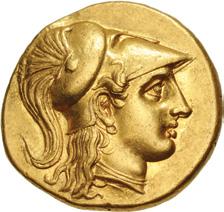


346. SELEUKID EMPIRE. Seleukos I Nikator. Second satrapy and kingship, 312-281 BC. AV Stater (17.5mm, 8.54 g, 10h). In the name and types of Alexander III of Macedon. Babylon I mint. Struck circa 311-300 BC. Head of Athena right, wearing triple-crested Corinthian helmet adorned with a pellet / ∫Ås5[¬EWs] ŬE$Å@droU, Nike standing left, holding wreath and stylis; [µ5 in left field], ü below left wing. SC 81.3 var. (helmet ornament); Price 3749 var. (same); HGC 9, 3a; CNG 102, lot 590 (same obv. die). A touch off center on reverse. EF. ($4000)



347. SELEUKID EMPIRE. Seleukos I Nikator. Second satrapy and kingship, 312-281 BC. AV Stater (18mm, 8.49 g, 11h). In the name and types of Alexander III of Macedon. Babylon I mint. Struck circa 311-300 BC. Head of Athena right, wearing crested Corinthian helmet decorated with coiled serpent, single-pendant earring, and pearl necklace / ∫Ås-5¬EWs ŬExÅ@droU, Nike, wearing long chiton, standing left, holding wreath in extended right hand and cradling stylis in left arm; A below left wing, © below right wing. SC 81.8 corr. (monogram in wreath); Price 3715 corr. (same); Wahl 37; HGC 9, 3a; ANS inv. 1944.00.35510. Underlying luster, mark on edge. Good VF. ($2000)



348. SELEUKID EMPIRE. Seleukos I Nikator. Second satrapy and kingship, 312-281 BC. AR Tetradrachm (26.5mm, 17.04 g, 11h). Susa mint. Struck circa 300-295 BC. Head of hero (Alexander or Seleukos?) right, wearing helmet covered with panther skin and adorned with the ear and horns of a bull / ∫Ås5¬EWs sE¬EU˚oU, Nike standing right, holding in both hands a wreath that she places on trophy to right; ∫E to lower left, Boeotian shield in lower middle field, ( to lower right. SC 173.1; ESMS Tr.1–4 var. (unlisted dies); Marest-Caffey Group 1.1; ESM –; HGC 9, 20; CSE 1022. Lightly toned, some light scratches and marks, spot of die rust and minor flan flaw on reverse. Good VF. ($1500)
The Trophy coinage of Susa began circa 300 BC, in the aftermath of the pivotal Battle of Ipsos, ending the Fourth Diadoch War, which saw the final defeat of Seleukos’ most formidable enemy, Antigonos I Monophthalmos, whose power in Asia Minor posed the greatest threat to the nascent Seleukid empire. Traditionally, this coinage was thought to have begun slightly earlier, marking the successful end of Seleukos’ Indian campaign in 305 BC, but a recent analysis of the iconography recognized that the details of the trophy indicated that a Macedonian enemy was defeated; the star on the shield was an Argead device, which clearly identifies the vanquished opponent as the Antigonid enemy that fell at Ipsos (see P. Iossif, “Les monnaies de Suse frappées par Séleucos Ier: Une nouvelle approche” in QT XXXIII [2004], pp. 249–71). The portrait on the obverse has long been the subject of debate, with numismatists identifying him as Dionysos, Alexander, or Seleukos. The arguments for each identification have merit, and indeed they are probably all correct; the image is an assimilation of all three into a singular portrait, as Iossif argues. In contrast to the reverse, which relates to the western victory of Seleukos, the obverse portrait relates to Seleukos’ eastern victory and ties his mythology to that of both Dionysos, the first conqueror of India, and Alexander, the second conqueror of India. Thus, this issue celebrates the totality of Seleukos’ victories in the east and west, solidifying his new empire, and also further establishes his dynastic heritage by tying his exploits to that of the great conqueror, Alexander, in an effort to legitimize Seleukos’ right to rule over these vast lands.


349. SELEUKID EMPIRE. Seleukos I Nikator. Second satrapy and kingship, 312-281 BC. AR Tetradrachm (28mm, 17.03 g, 7h). Susa mint. Struck circa 300-295 BC. Head of hero (Alexander or Seleukos?) right, wearing helmet covered with panther skin and adorned with the ear and horns of a bull / ∫Ås5¬EWs sE¬EU˚oU, Nike standing right, holding in both hands a wreath that she places on trophy to right; ' to lower left, ( in lower middle field. SC 173.4; ESMS Tr.7 (A4/ P1); Marest-Caffey Group 1.4; ESM 426; HGC 9, 20; CSE 1023 (same dies). Attractive old collection tone, with golden hues around the devices, minor flan flaw on edge. Near EF. ($1500)
Ex Roma XXV (22 September 2022), lot 500.



350. SELEUKID EMPIRE. Seleukos I Nikator. Second satrapy and kingship, 312-281 BC. AR Tetradrachm (26.5mm, 15.68 g, 6h). Contemporary imitation of Susa mint issue struck circa 300-295 BC. Head of hero (Alexander or Seleukos?) right, wearing helmet covered with panther skin and adorned with the ear and horns of a bull / ∫Ås5¬EWs sE¬EU˚oU, Nike standing right, holding in both hands a wreath that she places on trophy to right; c (Aramaic shin) above, g to lower left, ( in lower middle field. CNG 572, lot 382 (same dies); otherwise, unpublished. For prototype: cf. SC 173.5b; cf. HGC 9, 20. Faintly toned. Near EF. Well struck on a broad flan. Extremely rare. ($2000)



351. SELEUKID EMPIRE. Seleukos I Nikator. Second satrapy and kingship, 312-281 BC. AR Tetradrachm (27mm, 17.00 g, 7h). Susa mint. Struck circa 300-295 BC. Head of hero (Alexander or Seleukos?) right, wearing helmet covered with panther skin and adorned with the ear and horns of a bull / ∫Ås5¬EWs sE¬EU˚oU, Nike standing right, holding in both hands a wreath that she places on trophy to right;  to lower left, Åc in lower middle field. SC 173.14; ESMS Tr.92–105 var. (unlisted dies); Marest-Caffey Group 1.10; ESM 420; HGC 9, 20; CSE 1025. Lightly toned. Near EF. Attractive style. Well centered and struck on a broad flan. ($2000)



352. SELEUKID EMPIRE. Seleukos I Nikator. Second satrapy and kingship, 312-281 BC. AR Tetradrachm (25mm, 17.09 g, 6h). Susa mint. Struck circa 300-295 BC. Head of hero (Alexander or Seleukos?) right, wearing helmet covered with panther skin and adorned with the ear and horns of a bull / ∫Å%5¬EW% %E¬EU˚oU, Nike standing right, holding in both hands a wreath that she places on trophy to right; År to lower left; in lower middle field, radiate head of Helios facing; Z to lower right. SC 173.16; ESMS Tr.107 (A64/P1); Marest-Caffey Group 1.12; ESM 301; HGC 9, 20. Toned, minor graffiti in fields. VF. Rare. ($2000)



353. SELEUKID EMPIRE. Antiochos I Soter. 281-261 BC. AR Tetradrachm (29.5mm, 17.18 g, 8h). Seleukeia on the Tigris mint. Diademed head right / ∫Å%5¬EW% Å@t-5ocoU, Apollo, nude, testing two arrows in his right hand, left hand holding tip of bow set on ground to right, seated left on omphalos; Z to outer left, A to outer right. SC 378.3a; ESM 140; HGC 9, 128g; McClean 9255 (same obv. die). Lightly toned, with some iridescence. EF. Superb portrait. ($2500)
Ex Long Valley River Collection (Roma XX, 29 October 2020), lot 300; Hess-Divo 328 (22 May 2015), lot 66; Gorny & Mosch 151 (9 October 2006), lot 212.


354. SELEUKID EMPIRE. Antiochos I Soter. 281-261 BC. AR Tetradrachm (28mm, 17.09 g, 5h). Seleukeia on the Tigris mint. Diademed head right / ∫Å%5¬EW% Å@t-5ocoU, Apollo, nude, testing arrow in his right hand, left hand holding tip of bow set on ground to right, seated left on omphalos; • to outer left, t to outer right. SC 379.3c; ESM 155μ (same dies); HGC 9, 128g. Attractively toned, minor doubling on reverse. Good VF. Well centered and high relief. ($500)




355. SELEUKID EMPIRE. Andragoras. Seleukid governor, circa 280-275 BC. AV Stater (17.5mm, 8.58 g, 6h). Diademed head right, drapery around neck; ” to left / Nike, holding kentron in extended right hand, reins in left, driving fast quadriga right; behind her, warrior standing right; ∴ below horses’ forelegs, Å@drÅ˝oroU in exergue. SC –; MIG Type 19; HGC 9, –; BMC Arabia p. 193, 2; Triton XX, lot 341 = NAC 78, lot 337 = Triton XVI, lot 550 (same dies). In NGC encapsulation 6672715-001, graded Ch AU, Strike: 4/5, Surface: 4/5, Fine Style. Extremely rare. ($50,000)
At least six gold staters of Andragoras are known, struck from one obverse die and two reverse dies. No. 1 below is struck from the same obverse die but a different reverse die as the present coin. Nos. 2-6 are struck from the same obverse and reverse dies as the present coin, which is no. 7:
1. London. British Museum (acquired 1879): BMC Arabia, North East Persia No. 1, p. 193 (pl, xxviii, 1); NC 1879, p. 1, pl. I, 1; Head, Historia Numorum (2nd ed.), p. 825, fig. 361; Mitchiner Type 19 (illustrated on the right); ex Oxus Treasure.
2. London. British Museum (acquired 1888): BMC Arabia, North East Persia No. 2, p. 193; Mitchiner Type 19 (illustrated on the left); ex Cunningham collection.
3. Berlin. H. Dressel, ZfN 21 (1898), 231 (see http://www.smb.museum/ikmk/object.php?objectNR=0&size=0&content=0&side=1)
4. Numismatica Ars Classica 59 (4 April 2011), lot 652; Paris Match magazine, 15-22 June 2005, p. 73.
5. Private Collection, unpublished.
6. Triton XX (9 January 2017), lot 341 = Numismatica Ars Classica 78 (26 May 2014), lot 337; Triton XVI (8 January 2013), lot 550.
7. Present coin.
The identification of Andragoras has been a matter of debate. Justin mentions two people by that name: (1) a noble Persian appointed by Alexander the Great as governor of Parthia (xii.4.12), and (2) a Seleukid governor of Parthia about the middle of the 3rd century who was defeated by Arsakes (xli.4.7). Both extremely rare gold staters and scarce silver tetradrachms are known in his name, neither of which bear the royal title Basileos. What literary evidence exists derives from the later Greco-Roman historians of Alexander (Arrian and Curtius), as well as the first century AD historian, Pompeius Trogus (known later through Justin). One possible contemporary piece of evidence – a Greek inscription from Gurgan – mentions Andragoras as a high official under Antiochos I (see J. Wolski, “Andragoras était-il Iranien ou Grec?” Studia Iranica 4 [1975], pp. 166-69). B. Kritt, in his recent work, Andragoras, Double Darics, and the coinage of Alexandria on the Oxus (Lancaster, PA: Classical Numismatic Group, 2022), reassessed the totality of the evidence, and persuasively argues that the coinage was struck earlier than previously thought, circa 280-275 BC, rather than circa 249-239/8 BC. As such, our Andragoras must be the one mentioned in the Gorgan inscription (SEG 20.325), which is dated to the time of Antiochos I. Andragoras could not have been the later satrap of Parthia. In fact, he was the governor of Alexandreia on the Oxus, appointed by Antiochos I shortly after his accession to the throne, circa 280 BC. Andragoras, who was in his late sixties when appointed, ruled over the Seleukid colony until his death, circa 275 BC.


356. SELEUKID EMPIRE. Antiochos II Theos. 261-246 BC. AR Tetradrachm (29.5mm, 16.99 g, 12h). Sardes mint. Diademed head right / ∫Å%5¬EW% Å@t5-ocoU, Apollo, nude, testing arrow in his right hand, left hand holding tip of bow set on ground to right, seated left on omphalos; Y and D in exergue. SC 519 (same obv. die as illustration); WSM 1406β (same obv. die); HGC 9, 238h. Lightly toned, minor die wear on obverse. Near EF. Attractive style. ($750)


357. SELEUKID EMPIRE. Antiochos Hierax. Circa 242-227 BC. AR Tetradrachm (28.5mm, 17.10 g, 1h). Lampsakos mint. Diademed head right / ∫Å%5¬EW% Å@t5ocoU, Apollo, nude, testing arrow in his right hand, left hand holding tip of bow set on ground to right, seated left on omphalos; in exergue, forepart of Pegasos left and q. SC 849.2; Houghton, Lampsacus, Series 4, dies A8/P13; HGC 9, 403c; CSE 653 (same dies). Lightly toned. Good VF. High relief. ($1000)
Ex John L. Cowan Collection (Classical Numismatic Group 114, 13 May 2020), lot 324; Heritage 3044 (3 January 2016), lot 30018.


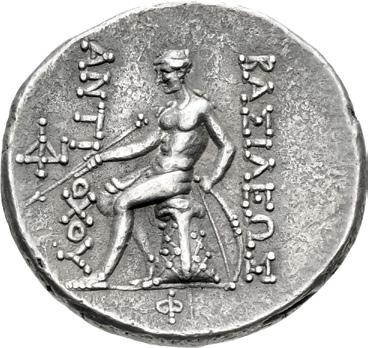
358. SELEUKID EMPIRE. Antiochos III ‘the Great’. 222-187 BC. AR Tetradrachm (29mm, 16.96 g, 12h). Antioch on the Orontes mint. Struck circa 204-197 BC. Diademed head right / ∫Å%5¬EW% Å@t5-ocoU, Apollo, nude, testing arrow in his right hand, left hand holding tip of bow set on ground to right, seated left on omphalos; $ to outer left, f in exergue. SC 1044.4b; Le Rider, Antioche, Series III-IV, 136–53 (obv. die A10); HGC 9, 447u; Sunrise 190 (this coin). Attractively toned, tiny scuff at edge on obverse. Near EF. Well struck. ($1500)
Ex Sunrise Collection (Triton XVIII, 6 January 2015), lot 148.


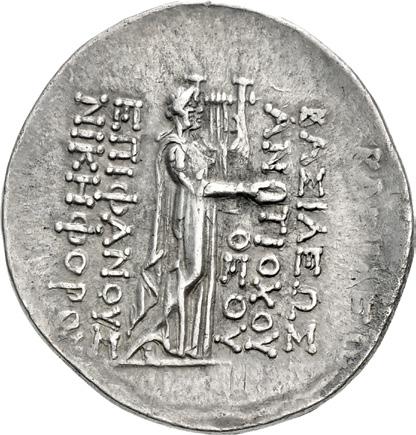

359. SELEUKID EMPIRE. Antiochos IV Epiphanes. 175-164 BC. AR Tetradrachm (34.5mm, 16.46 g, 12h). Antioch on the Orontes mint. Series 3, struck circa 166 BC. Laureate head of Apollo right / ∫Å%5¬EW% Å@t5ocoU QEoU E∏5fÅ@ oU% @5˚˙foroU, Apollo, wearing laurel wreath and long chiton, standing right, holding phiale in his extended right hand and cradling kithara in his left arm. SC 1401; Le Rider, Antioche 560 (A57/P389); Mørkholm Series III, 24, dies A54/P205; SMA 64; HGC 9, 622; Babelon, Rois 547 (same dies); CSE 110 (same obv. die). Lightly toned, some roughness and die wear on obverse, minor double strike on reverse. VF. Very rare. ($4000)
Ex Harlan J. Berk inventory (NN, ND); Nelson Bunker Hunt Collection (Sotheby’s New York, 22 June 1990), lot 591; Leu 28 (5 May 1981), lot 195.
Newell and Mørkholm associated this extraordinary type with the great panhellenic festival celebrated at Daphne. The authors of Seleucid Coins state that “only ten specimens of this exceptional coinage survive, and four or five of them show traces of overstriking.”



360. SELEUKID EMPIRE. Demetrios II Nikator. Second reign, 129-125 BC. AR Tetradrachm (28mm, 16.69 g, 1h). Antioch on the Orontes mint. Struck 129-128 BC. Diademed head right / ∫Å%5¬EW% d˙µ˙tr5oU QEoU @5˚Åtoro%, Zeus Nikephoros seated left; $ to outer left, o below throne. SC 2166.2c; Schwei Group 7, 55 (A3/P26) = Sunrise 214 (this coin); SMA 320; HGC 9, 1117b. Toned. Near EF. ($2000)
From the Michael Rogal Collection. Ex Sunrise Collection (Triton XVIII, 6 January 2015), lot 214; Giessener Münzhandlung 89 (5 May 1998), lot 273.


361. SELEUKID EMPIRE. Antiochos VIII Epiphanes (Grypos). 121/0-97/6 BC. AR Tetradrachm (29mm, 16.74 g, 1h). Tarsos mint. Second reign at Tarsos, circa 112-96 BC. Diademed head right / ∫Å%5¬EW% `@t5oco¨ E∏5f`@o¨%, Sandan standing right on back of horned and winged lion standing right upon garlanded altar with baldachin; to outer left, 8 above /. SC 2288.1d; HGC 9, 1198; CSE 489 (same dies). Old collection tone. VF. ($1000)
From the Henry A. Sauter Collection. Ex Massachusetts Historical Society/John Quincy Adams Family Collection (Part I, Stack’s, 5 March 1971), lot 287.




362. PHOENICIA, Byblos (Gebal). Uncertain king. Circa 433-425 BC. AR Shekel (26mm, 13.67 g, 12h). Galley with three hoplites left; below, hippocamp left / Vulture standing left on incuse ram lying left, head right. E&E-B Group III.1, 102 (O1/ R1 – this coin, illustrated); Betlyon 5; Rouvier 630; HGC 10, 126. Lightly toned, minor granularity, a few light scuffs on obverse, a few small bumps on edge. Near EF. An exceptional example of this very rare issue with all details clear. ($5000)
Ex Peus 361 (3 November 1999), lot 244.
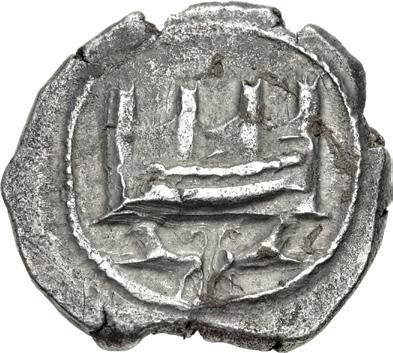

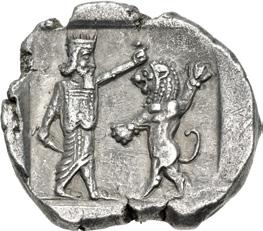

363. PHOENICIA, Sidon. temp. Ba`alšillem (Sakton) I-Ba’ana. Circa 425-401 BC. AR Half Shekel (21.5mm, 7.00 g, 12h). Phoenician galley left before city wall with four towers; two lions standing outward in exergue / Persian king or hero, holding dagger in right hand, standing right, fighting lion standing left on its hind legs; all within incuse square. E&E-S Group III.2.n, 320 (D21/R27 – this coin, illustrated); Betlyon 9; Rouvier 1085; HGC 10, –. Toned, a little porosity, struck with worn obverse die. EF. Well centered and struck on a broad flan. ($5000)
Ex Peus 361 (3 November 1999), lot 246; Triton II (1 December 1998), lot 491.



364. PHOENICIA, Sidon. `Abd`aštart (Straton) I. Circa 365-352 BC. AR Dishekel (26mm, 25.77 g, 11h). Dated RY 3 (363/2 BC). Phoenician galley left; zzz (3 in Phoenician [date]) above, waves below / Persian king, raising right hand, and driver, holding reins, in chariot left; to right, king of Sidon, in Egyptian style garments, holding cultic scepter in right hand, walking left; bo (‘B in Phoenician) above. E&E-S Group IV.2.1.c, 1248–50 var. (D8/R– [unlisted rev. die]); Betlyon 23; Rouvier 1103; HGC 10, 242; DCA2 820. Toned, minor flan flaws on obverse, even die wear on reverse. Good VF. ($1500)
From the Gerald F. Borrmann (Northern California Gentleman) Collection, purchased from Tom Cederlind, 17 May 2013.



365. PHOENICIA, Tyre. 126/5 BC-AD 65/6. AR Shekel (29mm, 14.31 g, 12h). Dated CY 35 (92/1 BC). Bust of Melkart right, wearing laurel wreath, [lion skin around neck] / Eagle standing left on prow; palm frond in background; to left, E¬ (date) above club; d to right; b (Phoenician B) between legs; tUroU 5Er&% ˚&5 &%U¬oU around. DCA-Tyre 122 (same obv. die as illustration); Rouvier 2021 var. (left field control); HGC 10, 357; DCA2 946; BMC 126–7. In NGC encapsulation 4164834-001, graded AU, Strike: 5/5, Surface: 4/5. ($1500)
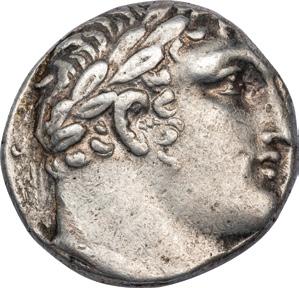


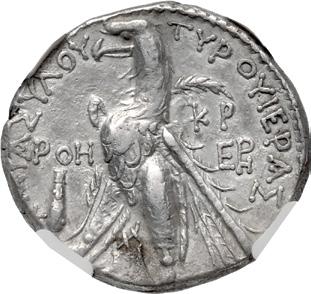
366. PHOENICIA, Tyre. 126/5 BC-AD 65/6. AR Shekel (24.5mm, 14.19 g, 12h). Dated CY 160 (AD 34/5). Head of Melkart right, wearing laurel wreath, [lion skin around neck] / Eagle standing left on prow; palm frond in background; to left, r$ (date) above club; to right, ˚r above Ģ; Å (Phoenician A) between legs; tUroU 5Er&% [˚&5 &%U¬oU] around. DCATyre 586; Rouvier –; HGC 10, 357; DCA2 947; BMC –. In NGC encapsulation 6557577-004, graded Ch XF, Strike: 5/5, Surface: 4/5. ($1000)
367. PHOENICIA, Tyre. 126/5 BC-AD 65/6. AR Shekel (25mm, 13.96 g, 12h). Dated CY 178 (AD 52/3). Head of Melkart right, wearing laurel wreath, lion skin around neck / Eagle standing left on prow; palm frond in background; to left, ro˙ (date) above club; to right, ˚r above Eõ; Å (Phoenician A) between legs; tUroU 5Er&% [˚&5] &%U¬oU around. DCA-Tyre 664 var. (PK above monogram); Rouvier –; HGC 10, 357; DCA2 947; BMC –. In NGC encapsulation 8229026-002, graded Ch XF, Strike: 4/5, Surface: 3/5, brushed. Extremely rare, only four in CoinArchives, this variety not in DCA Tyre. ($1000)
Ex Jess Peters 114 (19 January 1984), lot 55.




368. JUDAEA, Achaemenid Province (Yehud). Anonymous. Circa 400-370 BCE. AR Rb‘ – Shekel / Drachm (14mm, 3.28 g, 1h). Uncertain mint in Philistia. Head of Athena right, with profile eye, wearing earring, necklace, and crested Attic helmet decorated with two olive leaves over visor and a spiral palmette on the bowl / Owl standing right, head facing; olive spray, crescent, and Q to left; to right, hy (YH in Aramaic) within [Å]QE; all within incuse square. GLF Type 3, dies O1/R3; Hendin 6049; Meshorer –; HGC 10, –. Dark find patina, slight roughness, cleaning marks, small area of granularity on reverse. VF. Very rare, only fifteen examples noted in GLF; this coin is the third known from this die pair. ($3000)
GLF Types 1-3 are the earliest issues of coins struck for use in Judaea, though they were minted at an uncertain location in Philistia. It is hypothesized that the Type 3 coins, the largest of the three series, were struck in conjunction with the muster of troops at Ake by Pharnabazos for the invasion of Egypt (c. 379–373 BC).




369. JUDAEA, Jewish War. 66-70 CE. AR Shekel (23.5mm, 13.77 g, 11h). Jerusalem mint. Dated year 1 (66/7 CE). Omer cup; ! (“1” in Hebrew [date]) above, pellets flanking; L!Rc¥ LQc (“Shekel of Israel” in Hebrew) around / Sprig of three pomegranates; YcrQ 2Lcur¥ (“Jerusalem [the] holy” in Hebrew) around. Deutsch 10 (O4/R8); Kadman 2; Hendin 6383; Meshorer 184a; Bromberg 57; Meshorer, Masada 1310 (same dies); Shoshana I 20196; Sofaer 1; Spaer 164 (same obv. die). Lightly toned, a few minor marks. Good VF. ($5000)
Struck during the Jewish War against Rome, which lasted for at least part of five calendar years, these silver Shekels demonstrate a separation from Roman authority. Unlike Roman coins, they bore no human portrait, in order to keep the commandment that “thou shalt not make a graven image.” Legends were written in the language of Jews, Hebrew; the lettering, however, was an archaic form known as “proto-Hebrew,” a form close to the Phoenician script from which it derived. Important religious imagery was the central design on either side; namely, the Omer cup, which held the “first fruits,” the measure of barley during Passover, and the sprig of three pomegranates, used as decoration on many religiously significant items.




370. JUDAEA, Jewish War. 66-70 CE. AR Shekel (21mm, 14.32 g, 12h). Jerusalem mint. Dated year 2 (67/8 CE). Omer cup; @c (“Y[ear] 2” in Hebrew) above, L!Rc¥ LQc (“Shekel of Israel” in Hebrew) around / Sprig of three pomegranates; YcurQY 2¥Lcur¥ (“Jerusalem the holy” in Hebrew) around. Deutsch 4 (O1/R4); Kadman 8; Hendin 6388; Meshorer 193; Bromberg I 63 (same dies); Shoshana I 20202–3; Sofaer 7–8; Spaer 167–8. Even gray tone with some golden hues, die break on obverse. Near EF. ($4000)

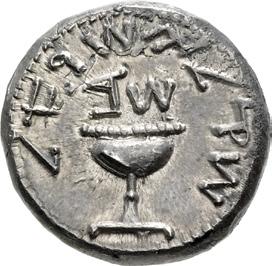


371. JUDAEA, Jewish War. 66-70 CE. AR Shekel (22.5mm, 14.06 g, 12h). Jerusalem mint. Dated year 2 (67/8 CE). Omer cup; @c (“Y[ear] 2” in Hebrew) above, L!Rc¥ LQc (“Shekel of Israel” in Hebrew) around / Sprig of three pomegranates; YcurQY 2¥Lcur¥ (“Jerusalem the holy” in Hebrew) around. Deutsch 101 (O7’/R96); Kadman 8; Hendin 6388; Meshorer 193; Bromberg I 63; Shoshana I 20202–3; Sofaer 7–8; Spaer 167–8. Toned, minor deposits. Choice EF. ($5000)



372. JUDAEA, Bar Kochba Revolt. 132-135 CE. AR Sela – Tetradrachm (25mm, 13.95 g, 1h). Undated, attributed to year 3 (134/5 CE). Façade of the Temple at Jerusalem; showbread table within, star above, 3∑o2C (“Shim‘on” in Hebrew) at sides / Bundle of lulav; etrog to left, 2LC∑R¥ ¡∑RHL (“For the freedom of Jerusalem” in Hebrew) around. Mildenberg –(O12/R49 [unlisted die combination]); Kaufman –; Hendin 6439; Meshorer 267; Bromberg 114–22 (same obv. die); Shoshana I 20360 corr. (same dies; incorrect Mildenberg number); Sofaer 107–13; Spaer 194 (same obv. die). Overstruck on an Antioch tetradrachm of Vespasian, struck circa CE 70–71 (cf. McAlee 334–6; the outline of a Flavian style portrait is visible on the reverse, the outline of the eagle and palm frond is visible on the obverse). Near EF. ($4000)
Here we have the interesting case of a coin of the second great Jewish revolt against Rome overstruck on a coin of the general, and later emperor, Vespasian, who led the Roman response to the first revolt. As David Hendin notes, Bar Kochba’s historically important coins would mark an end to the minting of Jewish coins in antiquity. Though there was little financial incentive for the Jews to strike their own coins during the revolt as all of the Bar Kochba coinage was overstruck on a motley mix of coins already in circulation, Judaean coinage from this period played an integral role in the dissemination of political propaganda. As Meshorer notes: “Not only did [Bar Kochba] deface the portraits of despised emperors by this technique [of overstriking], he was also able to depict Jewish symbols and nationalistic inscriptions.”



373. JUDAEA, Bar Kochba Revolt. 132-135 CE. AR Zuz – Denarius (17mm, 3.32 g, 1h). Undated, attributed to year 3 (134/5 CE). 3∑o2C (“Shim‘on” in Hebrew, irregularly distributed) in two lines within wreath of thin branches wrapped around eight almonds / Fluted jug and branch; 2lc∑R¥ ¡∑Rjl (“For the freedom of Jerusalem” in Hebrew) around. Mildenberg 85 (O15/R52); Hendin 6449; Meshorer 283a; Bromberg 163 (same dies); Shoshana I 20398 (same dies); Sofaer 118; Spaer 221. Toned, areas of light roughness and delaminations. Good VF. ($750)
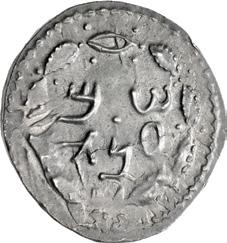


374. JUDAEA, Bar Kochba Revolt. 132-135 CE. AR Zuz – Denarius (19mm, 3.24 g, 1h). Undated, attributed to year 3 (134/5 CE). 3∑o2C (“Shim‘on” in Hebrew, irregularly distributed) in two lines within wreath of thin branches wrapped around eight almonds / Fluted jug and branch; 2lc∑R¥ ¡∑Rjl (“For the freedom of Jerusalem” in Hebrew) around. Mildenberg 134 (O19/R94); Hendin 6449; Meshorer 283a; Bromberg 503 (same dies); Shoshana II 20240 (same dies); Sofaer 117 (same obv. die); Spaer 221. Old cabinet tone, overstruck on a denarius of Domitian (RIC II 719 or 720, Rome mint, 90-91 CE). EF. ($1000)
From the CLA Collection.




375. JUDAEA, Bar Kochba Revolt. 132-135 CE. AR Zuz – Denarius (19mm, 3.75 g, 1h). Undated, attributed to year 3 (134/5 CE). Grape bunch on vine tendril; 3∑o2C (“Shim‘on” in Hebrew) around / Two upright trumpets; pellet between, 2LC∑R¥ ¡[∑]RHL (“For the freedom of Jerusalem” in Hebrew, a few letters retrograde) around. Mildenberg 166 (O21/R86); Hendin 6458; Meshorer 277; Bromberg 517 (same dies); Shoshana II 20257 (same dies); Sofaer 138 (same obv. die); Spaer 230 (same dies). Iridescent tone, overstruck on a denarius of Domitian (RIC II 773, Rome mint, 95–96 CE). Near EF. ($1000)



376. JUDAEA, Bar Kochba Revolt. 132-135 CE. AR Zuz – Denarius (19mm, 331 g, 6h). Undated, attributed to year 3 (134/5 CE). Grape bunch on vine tendril; 3∑o2C (“Shim‘on” in Hebrew) around / Elongated kithara; 2LC∑R¥ ¡∑RHL (“For the freedom of Jerusalem” in Hebrew) around. Mildenberg 174 (O22/R109); Hendin 6462; Meshorer 275; Bromberg 199 (same dies); Shoshana I 20476 (same dies); Sofaer 127 (same obv. die); Spaer 223–4. Find patina, overstruck on an uncertain denarius of Trajan. Near EF. ($750)
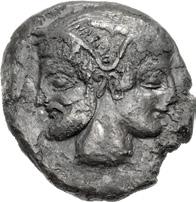


377. PHILISTIA (PALESTINE), Gaza (‘Azah). Mid 5th century-333 BC. AR Drachm (16mm, 3.60 g, 2h). Janiform head of male, bearded, left, and female, right / Owl standing right, head facing; grain ears flanking, HZo (AZH in Aramaic) to lower right; all within incuse square. Gitler & Tal V.3Da–d (same dies); SNG ANS 31 (same dies); Svoronos, Monnaies, pl. 110, 8 and 10 (both same dies). Rough dark find patina. Good VF. Extremely rare, only four noted by Gitler & Tal (includes the ANS and Svoronos coins), none in CoinArchives. ($1500)

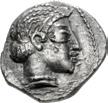


378. PHILISTIA (PALESTINE), Uncertain mint. Mid 5th century-333 BC. AR Obol (8mm, 0.53 g, 5h). Bare head of male right, with eastern hairstyle / Head of a horned animal and the forepart of a horse right in dotted square within incuse square. Gitler & Tal XXVII.6O; otherwise, unpublished. Toned. Good VF. Excellent metal. Extremely rare, only one example noted by Gitler & Tal (who note the denomination as unpublished), none in CoinArchives. ($750)




379. NABATAEA. Obodas II, with Hagaru I. Circa 30-9 BC. AR Sela’ – “Drachm” (19.5mm, 4.53 g, 12h). Petra mint. Dated RY 10 (21/0 BC). Jugate diademed and draped busts of Obodas and Hagaru right / AB¬m tr∫a (‘BDT MLKA in Nabataean = Obodas King), diademed head of Obodas right; r!a tn! (ŠNT ‘ŠR in Nabataean = year ten [date]) at end of legend to left. Barkay, King 27A; CN 46a; Al-Qatanani 38 t7; Meshorer, Nabataea 30; DCA2 1015. Toned, a little off center, slight doubling on obverse, some horn silver and minor scuff at edge on reverse. Good VF. Clear date. ($750)



380. PERSIA, Achaemenid Empire. temp. Xerxes I to Darios II. Circa 485-420 BC. AV Daric (15mm, 8.31 g). LydoMilesian standard. Sardes mint. Persian king or hero, wearing kidaris and kandys, quiver over shoulder, in kneeling-running stance right, holding spear and bow / Incuse punch. Carradice Type IIIb, Group A/B (pl. XIII, 27); Meadows, Administration 321; BMC Arabia pl. XXIV, 26; Sunrise 24. Edge scuff. Superb EF. ($3000)
Ex MACM inventory MMoCA1C; Patrick H. C. Tan Collection (Classical Numismatic Group 84, 5 May 2010), lot 748.
The Achaemenid series began in the late sixth century BC, deriving from the famous Kroiseid coinage, and lasted until the conquest of Persia by Alexander the Great in the 330s BC. The term “daric” dates from the fifth century BC, and was used by the Greeks as a term for Persian coinage, particularly the gold (see Herodotus 7.28). Its name derives from that of the Persian king Darios I, under whom the Persian coinage began. Ian Carradice’s study, “The ‘Regal’ Coinage of the Persian Empire” in: Coinage and Administration in the Athenian and Persian Empires (BAR International Series 343 [Oxford. 1987]) forms the modern basis for our understanding of this interesting coinage.

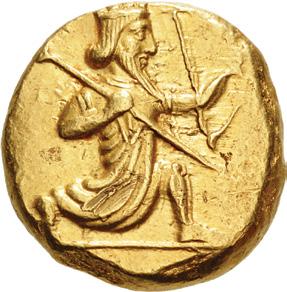

381. PERSIA, Achaemenid Empire. temp. Darios II to Artaxerxes II. Circa 420-375 BC. AV Daric (15mm, 8.37 g).
Lydo-Milesian standard. Sardes mint. Persian king or hero, wearing kidaris and kandys, quiver over shoulder, in kneelingrunning stance right, holding spear and bow / Incuse punch. Carradice Type IIIb, Group C (pl. XIV, 42); cf. Meadows, Administration 323; BMC Arabia pl. XXV, 12; Sunrise 28. Trace deposits, slight die shift and small scuff on obverse. EF. Well centered and sharp details. ($2000)
From the Michael Rogal Collection. Ex RCM Collection (Triton XVI, 8 January 2013), lot 579; Forestier I (8 June 2007), lot 52.



382. PERSIA, Achaemenid Empire. temp. Darios II to Artaxerxes II. Circa 420-375 BC. AV Daric (15mm, 8.33 g). Lydo-Milesian standard. Sardes mint. Persian king or hero, wearing kidaris and kandys, quiver over shoulder, in kneelingrunning stance right, holding spear and bow / Incuse punch. Carradice Type IIIb, Group C (pl. XIV, 42); cf. Meadows, Administration 323; BMC Arabia pl. XXV, 12; Sunrise 28. Underlying luster, slight die wear on obverse. EF. ($1500)
From the Gerald F. Borrmann (Northern California Gentleman) Collection.



383. PERSIA, Achaemenid Empire. temp. Artaxerxes II to Darios III. Circa 375-336 BC. AV Daric (15mm, 8.33 g). Lydo-Milesian standard. Sardes mint. Persian king or hero, wearing kidaris and kandys, quiver over shoulder, in kneelingrunning stance right, holding spear and bow / Patterned incuse punch. Carradice Type IIIb Late (pl. XV, 50); Meadows, Administration –; BMC Arabia pl. XXV, 24; Sunrise 39 corr. (references). A little die rust, minor marks on reverse. Good VF. Well centered. ($1500)




384. PERSIA, Achaemenid Empire. Autophradates. Satrap of Sparda (Lydia and Ionia), circa 380s-350s BC. AR Drachm (13mm, 3.38 g, 1h). Uncertain mint in Ionia. Bearded head left, wearing satrapal cap / Forepart of horse left; oÅtÅ above, † below. Cf. Winzer 11.1; cf. Meadows, Administration 344; cf. Traité II 67; cf. BMC 20 (diobol, with this monogram); otherwise, unpublished. Lightly toned, a hint of porosity, a few minor marks on edge. VF. Apparently unique as a drachm. ($1000)
Autophradates distinguished himself in the Great Satraps Revolt (365-360 BC) by supporting Artaxerxes II and imprisoning the satrap of Lydia and Ionia, Artabazos (Dem. Aristoc. 671). In 333 BC, Autophradates, along with his fellow-commander, Pharnabazos, took over the Persian fleet and completed the siege of Mytilene, which had been begun by Memnon. In the Greek revolts which arose in the Aegean and western Asia Minor as a result of Alexander III’s victories, Autophradates tried to return these areas to Persian control (Arr. Anab. 2.1; Arist. Pol. 2.4.10). Little else is known of his subsequent career, although it is possible that he was among those satraps who presented themselves before Alexander at Zadracarta (Arr. Anab. 3.23).



385. PERSIA, Alexandrine Empire. temp. Stamenes – Seleukos. Satraps of Babylon, circa 328/3-311 BC. AV Double Daric (18mm, 16.72 g). Babylon mint. Persian king or hero, wearing kidaris and kandys, quiver over shoulder, in kneelingrunning stance right, holding spear in right hand, bow in left; ¬U to left, [q to lower right] / Patterned incuse punch. NicoletPierre 1; cf. Babelon, Perses 120 (daric); cf. Traité II 768 (same); EHC pl. II, 29; SNG Berry 1455. Minor flan flaw on obverse, edge marks. VF. ($5000)
From the Gerald F. Borrmann (Northern California Gentleman) Collection, purchased from Dr. Arnold Saslow, February 1987.



386. PERSIA, Alexandrine Empire. temp. Stamenes – Seleukos. Satraps of Babylon, circa 328/3-311 BC. AV Daric (13.5mm, 8.33 g). Babylon mint. Persian king or hero, wearing kidaris and kandys, quiver over shoulder, in kneelingrunning stance right, holding spear in right hand, bow in left; ¬U to left, [q to lower right] / Patterned incuse punch. Nicolet-Pierre 1; Babelon, Perses 120 = de Luynes 2786; Traité II 768. Compact flan, area of weak strike on obverse. EF. Very rare. ($3000)
From the Gerald F. Borrmann (Northern California Gentleman) Collection. Ex Buddy Ebsen Collection (Superior, 7 June 1987), lot 4230.




387. EGYPT, Pharaonic Kingdom. Nektanebo II. 361-343 BC. AV Stater (17mm, 8.31 g, 10h). Horse prancing right / Hieroglyphic representation of “good gold”: pectoral necklace (nebew = “gold”) crossing horizontally over a windpipe and heart (nefer = “good”). FF-BD 4b (D2/R2) = H. W. Müller & E. Thiem, Gold of the Pharaohs (Cornell UP, 1999), p. 49, figs. 86–87 (this coin); SNG Copenhagen 1 (same rev. die); ACGC 1064 (same rev. die); BM inv. 1954,1006.1 = Jameson 2618 (same obv. die); Zhuyuetang 121 (same rev. die). In NGC encapsulation 5771748-001, graded XF★, Strike: 3/5, Surface: 5/5. ($100,000)
Ex Edward H. Merrin Collection; Eberhard Thiem Collection; Sotheby’s Geneva (with Roland Michel, 11 November 1990), lot 42; Hans Wolfgang Müller Collection, sold to a private German collector, 1968 (attested by E. Thiem, in correspondence with Samuel Merrin [inlcuded with lot]).
One of the great (and very popular) rarities for ancient gold coinage collectors is the gold stater (or daric?) issued by the Egyptian Pharaoh Nektanebo II. The authors of the die study cited above could account for only 42 examples struck from 3 obverse and 3 reverse dies with 5 die combinations. They also listed 5 examples from the Mit Rahineh hoard (IGCH 1658) that they could not examine for their die study. The attribution to Nektanebo II is based primarily on circumstantial historical evidence and not the coins themselves, which do not bear any specific ethnic or monogram.
Nekht-har-hebi, or Nektanebo II as he was known to the Greeks, was the nephew of the Pharaoh Tachos (Djedhor). Placed in command of the Egyptian army in Syria during the Satrapal Revolt, he turned his troops against his own king, and uncle, and took Egypt by force. In 351-350 BC, he repelled a Persian invasion but was driven from his throne in 344-343 by a second assault. He then fled Egypt and found refuge in Ethiopia and retained control of Upper Egypt for another few years.
Nektanebo most likely would have issued his gold staters to pay the mercenaries in his army. What makes the coinage of Nektanebo stand out is the adoption of a purely Egyptian design. This is the only known ancient coinage to employ a hieroglyph – a purely Egyptian coin.




388. PTOLEMAIC KINGS of EGYPT. Ptolemy I Soter. As satrap, 323-305/4 BC. AR Tetradrachm (26.5mm, 17.18 g, 12h). In the name and types of Alexander III of Macedon. Memphis mint. Struck circa 323-321/0 BC. Head of Herakles right, wearing lion skin / ŬE$Å@droU, Zeus Nikephoros seated left; rose in left field, d5o below throne. CPE 18; Svoronos –; Zervos Issue 2B, dies 212/a; Price 3971 var. (position of letters on rev.); ANS inv. 1944.100.35580 (same dies). Lightly toned, underlying luster, trace deposits. Near EF. ($1500)
Ex Heritage 61332 (6 August 2023), lot 25112.



389. PTOLEMAIC KINGS of EGYPT. Ptolemy I Soter. As satrap, 323-305/4 BC, or king, 305/4-282 BC. AR Tetradrachm (25mm, 15.75 g, 1h). Ptolemaic standard. In the name of Alexander III of Macedon. Alexandreia mint. Struck circa 306-300 BC. Diademed head of the deified Alexander right, wearing elephant skin, aegis around neck with tiny d in scales / ŬE$Å@droU, Athena Alkidemos advancing right; to right, ’, Corinthan helmet right, and eagle standing right on thunderbolt. CPE 70; Svoronos 164; Zervos Issue 29, dies 518/c; SNG Copenhagen –; Noeske –; SNG Lockett 3393; Weber 8226. Toned, traces of undertype. EF. Well centered. ($3000)
From the JTB Collection. Ex North River Collection (Triton XXVI, 10 January 2023), lot 424; RCM Collection (Triton XVI, 8 January 2013), lot 587; Triton VII (13 January 2004), lot 372.
Ptolemy I Soter, the son of a Macedonian nobleman, was a friend and intimate of Alexander III the Great from boyhood and accompanied him on his great career of conquest, from 333-323 BC. Upon Alexander’s death in 323 BC, Ptolemy was granted the prized satrapy of Egypt, the richest of the formerly Persian provinces. Alone among the Diadochi (”successors”), he was content with his sphere of influence and did not risk all to succeed Alexander. However, he was not above using the great conqueror’s image and reputation to secure his own position. He hijacked Alexander’s funeral cortege as it was proceeding back to Macedon and had his embalmed corpse formally interred at Memphis in Egypt; later the body was relocated to a splendid mausoleum in Alexandria. Ptolemy’s early coinage is modeled on that of Alexander and carries the conqueror’s image and name, as seen on this remarkable tetradrachm, which shows Alexander wearing an elaborate elephant-skin headdress in honor of his victories in India, backed with a striking image of Athena in a fighting stance. Ptolemy declared his own kingship in 305/4 BC and was the only one of Alexander’s Successors to die peacefully, in his bed, in 282 BC, having founded a dynasty that would last three centuries.
Ex 1932 Chiliomodi Hoard – Published in 1938


390. PTOLEMAIC KINGS of EGYPT. Ptolemy I Soter. As satrap, 323-305/4 BC, or king, 305/4-282 BC. AR Tetradrachm (27mm, 15.55 g, 11h). Ptolemaic standard. In the name of Alexander III of Macedon. Uncertain mint 1 in Egypt (Pelusion?). Struck circa 306-300 BC. Diademed head of the deified Alexander right, wearing elephant skin, aegis around neck / ŬE$Å@droU, Athena Alkidemos advancing right; to right, ëand eagle standing right on thunderbolt. CPE 77; Svoronos 107; Zervos Issue 55, dies 583/b (this coin referenced); O. Ravel, “Corinthian Hoard from Chiliomodi” in Transactions of the International Numismatic Congress 1936 (London, 1938), 7 and pl. VIII, 2 (this coin); SNG Copenhagen –. Attractively toned, some die wear and banker’s mark on obverse. VF. ($1500)
Purchased by the consignor from James Murray Coins and Antiques, in the 1990s. Ex Chiliomodi, 1932 Hoard (IGCH 85).
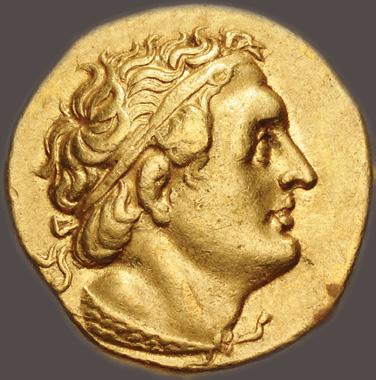



391. PTOLEMAIC KINGS of EGYPT. Ptolemy I Soter. 305/4-282 BC. AV Stater (17.5mm, 7.08 g, 12h). Alexandreia mint. Struck early 290s BC. Diademed head right, wearing aegis around neck / ∏to¬EÂÅ5oU ∫Å%5¬EW%, Alexander, holding thunderbolt in right hand, standing left in chariot drawn by four elephants left; .!( in exergue. CPE 93; Svoronos 147; Zervos Type VI, Issue 91; SNG Copenhagen –; Hirsch 1793. Faint graffito (¬Ås) in field on obverse, light scratch and minor doubling on reverse. Good VF. Very rare, only five examples noted by Zervos, five additional in CoinArchives (including the present coin). ($20,000)
Ex MACM inventory MMoCA14C; Classical Numismatic Group 84 (5 May 2010), lot 751.



392. PTOLEMAIC KINGS of EGYPT. Ptolemy I Soter. 305/4-282 BC. AR Tetradrachm (25.5mm, 14.25 g, 12h). Alexandreia mint. Struck circa 294-285 BC. Diademed head right, wearing aegis around neck, tiny d behind ear / ∫Å%5¬EW% πto¬EµÅ5oU, eagle, with closed wings, standing left on thunderbolt; to left, r above O. CPE 168; Svoronos 255; SNG Copenhagen 70–1; Boston MFA 2264; Noeske 41–2. Toned, traces of find patina. Near EF. ($1000)
From the JTB Collection. Ex Triton XII (6 January 2009), lot 382.




393. PTOLEMAIC KINGS of EGYPT. Ptolemy I Soter. 305/4-282 BC. AR Quarter Ma’ah – Tetartemorion (7mm, 0.22 g, 12h). Jerusalem mint. Struck circa 294-282 BC. Diademed head right, wearing aegis around neck / Eagle, with open wings, standing left on thunderbolt; dhy (YHD in Aramaic) to left. CPE 252; GLF Type 37, dies O1/R2; Meshorer 32a (same dies as illustration); Hendin 6079. Lightly toned, slightly off center on obverse, as usual. Good VF. Exceptional for issue. Rare. ($1000)

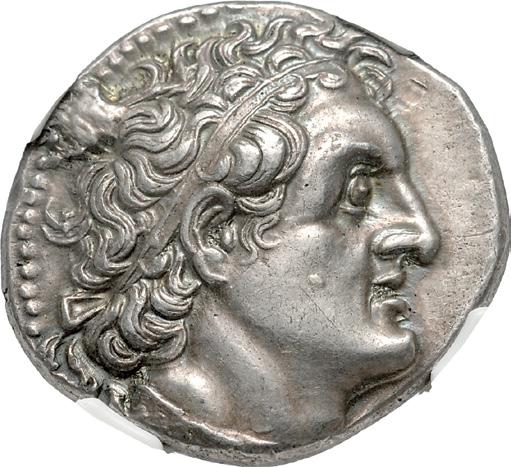

394. PTOLEMAIC KINGS of EGYPT. Ptolemy II Philadelphos. 285-246 BC. AR Tetradrachm (27.5mm, 14.08 g, 11h). Alexandreia mint. Struck circa 282–275/4 BC. Diademed head of Ptolemy I right, aegis around neck; tiny d behind ear / ∫Å%5¬EW% πto¬EµÅ5oU, eagle, with closed wings, standing left on thunderbolt; Ï to left. CPE 277; Svoronos 548; SNG Copenhagen –; Meydancikkale 3732–813. In NGC encapsulation 3987307-013, graded AU★, Strike: 5/5, Surface: 5/5. ($1500)
Ex WTR Collection (Heritage 3094, 19 August 2021), lot 34145; Heritage 3038 (13 January 2015), lot 33141; Stack’s (24 August 1976), lot 1603.


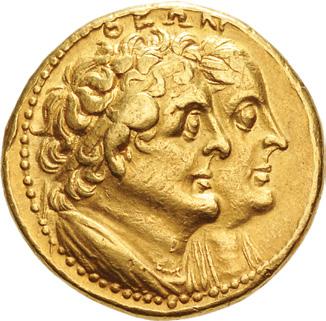

395. PTOLEMAIC KINGS of EGYPT. Ptolemy II Philadelphos, with Arsinöe II, Ptolemy I, and Berenike I. 285246 BC. AV Mnaïeion – ‘Oktadrachm’ (27mm, 27.70 g, 12h). Alexandreia mint. Struck circa 272-261/0 BC. Conjoined busts of Ptolemy II and Arsinöe II right; Ptolemy is diademed and draped, Arsinöe is diademed and veiled; ÅdE¬fW@ above, shield to left / Conjoined busts of Ptolemy I and Berenike I; Ptolemy is diademed and draped, Berenike is diademed and veiled; QEW@ above. CPE 313; Svoronos 603; Olivier & Lorber dies 10/34; SNG Copenhagen 132; Adams III 2083; ANS inv. 1977.158.112 (same dies); BMC 40 (same obv. die); Boston MFA 2274; Dewing 2752; Kraay & Hirmer 801; Noeske 37. A few light marks, minor marks on edge. Good VF. ($10,000)
From the 1930’s Collection of Robert W. Hubel of Michigan.



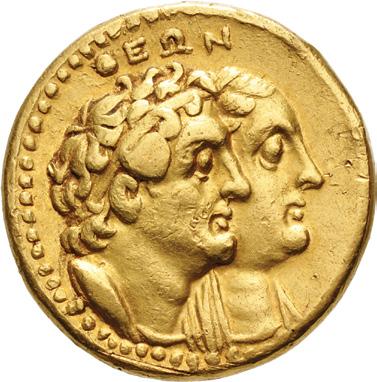
396. PTOLEMAIC KINGS of EGYPT. Ptolemy II Philadelphos, with Arsinöe II, Ptolemy I, and Berenike I. 285-246 BC. AV Half Mnaïeion – ‘Tetradrachm’ (20mm, 13.74 g, 1h). Alexandreia mint. Struck circa 272-261/0 BC. Conjoined busts of Ptolemy II and Arsinöe II right; Ptolemy is diademed and draped, Arsinöe is diademed and veiled; ÅdE¬fW@ above, shield to left / Conjoined busts of Ptolemy I and Berenike I; Ptolemy is diademed and draped, Berenike is diademed and veiled; QEW@ above. CPE 314; Svoronos 604; Olivier & Lorber dies 28/– (unlisted rev. die); SNG Copenhagen 133; Adams III 2084; Boston MFA 2275; Dewing 2753-4; Noeske 38. Trace deposits, marks around edge from prior mount. Good VF. ($4000)
From the 1930’s Collection of Robert W. Hubel of Michigan.



397. PTOLEMAIC KINGS of EGYPT. Arsinoe II Philadelphos. Died 270/268 BC. AR Dekadrachm (35.5mm, 34.72 g, 12h). Alexandreia mint. Struck under Ptolemy II, circa 253/2-250/49 BC. Head right, with ram’s horn, veiled and wearing stephane; lotus-tipped scepter in background, oo to left / År%5@o˙% f5¬ÅdE¬foU, double cornucopia with grape bunches hanging at sides, bound with fillet. CPE 357 (Ptolemy II); Svoronos 950; Troxell, Arsinoe, Group 3, p. 44; SNG Copenhagen –; Meydancikkale 4006 (same obv. die). Toned, areas of roughness and porosity, some cleaning scratches and edge marks, graffito in field on reverse. Good VF. Very rare with these letters on obverse, none in PTO, nor CoinArchives. ($10,000)



398. PTOLEMAIC KINGS of EGYPT. Arsinoe II Philadelphos. Died 270/268 BC. AV Mnaïeion – ‘Oktadrachm’ (28mm, 27.73 g, 11h). Alexandreia mint. Struck under Ptolemy II, circa 252/1-250/49 BC. Head right, with ram’s horn, veiled and wearing stephane; lotus-tipped scepter in background, ˚ to left / År%5@o˙% f5¬ÅdE¬foU, double cornucopia, grape bunches hanging at sides, bound with fillet. CPE 390; Svoronos 475; Olivier & Lorber dies 1/5, 233 (this coin); Troxell, Arsinoe, Group 3, p. 44, and pl. 7, 3 (same obv. die); SNG Copenhagen –; Adams –; Boston MFA 2268 (same obv. die); BMC 10 (same dies); Pozzi 3223 (same dies). In NGC encapsulation 3819009-005, graded Ch AU, Strike: 5/5, Surface: 4/5. ($10,000)
Arsinoe II, daughter of Ptolemy I and Berenike I, was born in 316 BC. Her early life saw her married off to Lysimachos of Thrace at the age of 15 and then to her half-brother, the brutal Ptolemy Keraunos. She conspired against the latter and was forced to flee circa 280 BC to the protection of Egypt, ruled by her younger full brother, Ptolemy II. Her beauty, charm and intelligence utterly captivated Ptolemy, and, after eliminating his previous wife with an accusation of treason, Arsinoe married her brother, probably about 276 BC. Sibling marriage was traditional among Egyptian royalty, but among the Greeks it was known only between deities; thus their union advanced the concept of rulers being worshipped as divinities. Though unscrupulous, Arsinoe proved a capable queen and co-ruler, taking charge of Egypt’s foreign affairs. Her death in 270 or 268 BC was marked by her full deification and a huge outpouring of gold and silver coinage bearing her veiled portrait. The ram’s horn just visible emerging from the veil is a further symbol of her deification, reminiscent of the horn of Ammon on images of the deified Alexander.



399. PTOLEMAIC KINGS of EGYPT. Arsinoe II Philadelphos. Died 270/268 BC. AV Mnaïeion – ‘Oktadrachm’ (28mm, 27.80 g, 12h). Alexandreia mint. Struck under Ptolemy II, circa 252/1-250/49 BC. Head right, with ram’s horn, veiled and wearing stephane; lotus-tipped scepter in background, Q to left / År%5@o˙% f5¬ÅdE¬foU, double cornucopia, grape bunches hanging at sides, bound with fillet. CPE 388; Svoronos 460; Olivier & Lorber dies 1/25, 127 (this coin); SNG Copenhagen 134; Noeske 39; Hirsch 1808; Jameson 1811; Pozzi 3221–2 (all from same obv. die). Underlying luster, minor marks and scuffs. Near EF. ($7500)

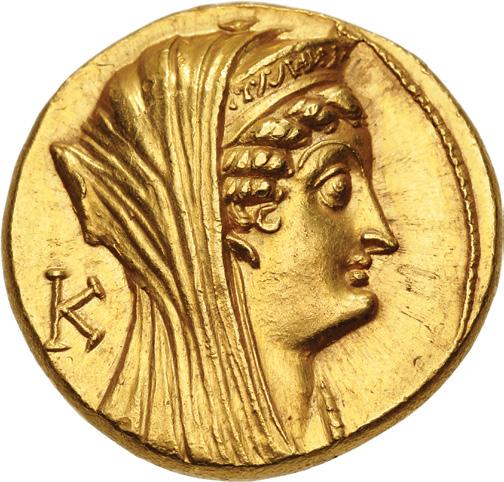

400. PTOLEMAIC KINGS of EGYPT. Arsinoe II Philadelphos. Died 270/268 BC. AV Mnaïeion – ‘Oktadrachm’ (27.5mm, 27.75 g, 11h). Alexandreia mint. Struck under Ptolemy VI or Ptolemy VIII, circa 180-145 or 145-116 BC. Head right, with ram’s horn, veiled and wearing stephane; lotus-tipped scepter in background, ˚ to left / År%5@o˙% f5¬ÅdE¬foU, double cornucopia, grape bunches hanging at sides, bound with fillet. Olivier Group 5, 3504–6 (obv. die D41); Svoronos 1499β; SNG Copenhagen 322; BMC 45; Boston MFA 2298; Hermitage Sale II 1577–8; Pozzi 3247. Minor die break on obverse, edge scuffs and marks. EF. ($7500)
Purchased by the consignor from Joel L. Malter.


401. PTOLEMAIC KINGS of EGYPT. Ptolemy III Euergetes. 246-222 BC. Æ Drachm (43mm, 74.93 g, 12h). Alexandreia mint. Series 5B. Horned head of Zeus-Ammon right, wearing tainia with basileion / ∫Å%5¬EW% πto¬EµÅ5oU, eagle with closed wings standing left on thunderbolt; filleted cornucopia to left, ^ between legs. CPE B395; Svoronos 964; SNG Copenhagen 171–2; BMC –; Boston MFA –; Dewing –; Noeske 117–9. Attractive dark brown surfaces. EF. ($2000)
Ex CNG inventory 581658 (March 2022); Triton XIV (4 January 2011), lot 391.


402. PTOLEMAIC KINGS of EGYPT. Ptolemy VI Philometor. First sole reign, 180-170 BC. AR Tetradrachm (27mm, 14.13 g, 12h). Uncertain mint in Cyprus. Dated year 102 of an uncertain era (171/0 BC). Diademed head of Ptolemy I right, aegis around neck / ∏to¬EÂÅ5oU %Wt˙ro%, eagle with closed wings standing left on winged thunderbolt; Á (date, in monogram form) to left. Svoronos 1208; Olivier 219–23 var. (obv. die unlisted); DCA2 1161; SNG Copenhagen 556 var. (no E); BMC –; Boston MFA –; Noeske –; ANS inv. 1944.100.77215. Attractive even gray tone, with golden hues around the devices. EF. Rare, only five examples noted in Olivier, nine others in CoinArchives. ($1500)
Ex Lugdunum 23 (14 December 2023), lot 82; Leu 45 (26 May 1988), lot 290.
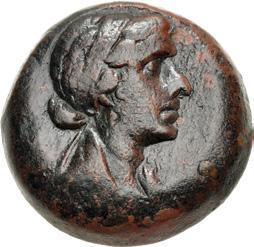


403. PTOLEMAIC KINGS of EGYPT. Kleopatra VII Thea Neotera. 51-30 BC. Æ Obol – 40 Drachmai (21mm, 9.40 g, 12h). Alexandreia mint. Diademed and draped bust right / ∫Å45¬544˙4 ˚¬Eo∏ÅtrÅ4, eagle standing left on thunderbolt; cornucopia to left,  to right. Svoronos 1872; SNG Copenhagen 422–4; BMC 6–11; Boston MFA –; Noeske 383; Weiser 184. Beautiful dark red-brown surfaces. Good VF. An ecxceptional example of the type, with a bold portrait of Kleopatra. ($3000)



404. KYRENAICA, Kyrene. Circa 490-475 BC. AR Drachm (12.5mm, 3.37 g). Asiatic standard. Two silphion fruits set base-to-base; pellet between, leaves at sides between / Facing head of lion within incuse square. Buttrey, Coins, Period I, Group 2, 87; SNG Copenhagen 1172; BMC 38. Find patina, deposits. Good VF. Well struck on a broad flan. ($1000)
Kyrene was the capital city of Kyrenaika on the North African coast immediately west of Egypt. Dorian Greek colonists founded Kyrene in 631 BC. The region played host to a wild-growing plant called silphion (or silphium), with a thick, striated and hollow stalk, broad horizontal branches, and yellow flowers that grew in bunches. The Greeks ascribed near magical properties to both the plant itself and its sap, called laserpicium by the Romans. Silphion had countless uses: a salve for burns, a treatment for hemorrhoids, cure for tetanus, and a seasoning for food, and was also described as having various properties associated with love and sex. From its earliest coinage, circa 525 BC, Kyrene featured the silphion plant and its heart-shaped fruit on its coin designs. Ancient sources state that the Kyreneans found silphion impossible to cultivate and could only gather it from the fields where it grew wild. In the late Hellenistic and early Roman periods, over-harvesting and grazing by domesticated animals allegedly drove it to extinction. Pliny reported that the last known stalk of silphion was given to the Emperor Nero “as a curiosity.” A close relative of silphion likely exists today in the giant fennel plant, ferula communis, which still grows in North Africa and elsewhere.




405. KYRENAICA, Kyrene. Circa 475-435 BC. AR Tetradrachm (24mm, 15.82 g, 12h). Silphion plant / Head of ZeusAmmon right; ˚¨rÅ to right; all in dotted circle within incuse circle. Cf. Buttrey, Coins, Period II, Group 2, 96 (didrachm); Müller, Afrique 119; SNG Copenhagen –; BMC 41b = Boston MFA 1308 = Warren 1340 (same obv. die). Some granularity, test cut and some weakness to strike on obverse. Good VF. ($3000)

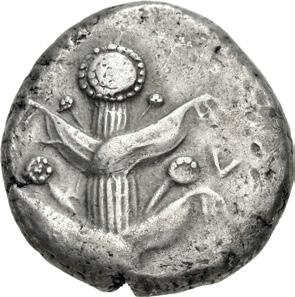


406. KYRENAICA, Kyrene. Circa 435 BC. AR Tetradrachm (24mm, 17.13 g, 5h). Alliance issue with Euhesperides. Silphion plant; [E]-¨ across field / Head of Zeus-Ammon right; ˚¨rÅ to right; all in dotted circle within incuse circle. Buttrey, Coins –; Müller, Afrique 334A; SNG Copenhagen 1182 var. (position of ethnic on obv.); BMC 60c–d var. (same). Lightly toned, minor marks, slightly weak strike, a little off center on obverse. Good VF. Attractive Classical style. Very rare alliance issue. ($5000)
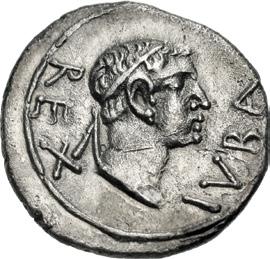



407. KINGS of MAURETANIA. Juba II, with Ptolemy. 25 BC-AD 24. AR Denarius (15mm, 2.03 g, 9h). Caesarea mint. Dated RY 48 (AD 23/4). ∞Ec 5¨∫Å, diademed head of Juba right / Diademed and draped bust of Ptolemy right; r • xx-xx-uiii (date) around. Spoerri-Butcher Group 60.a, dies C38/R1; Mazard 387 (same dies as illustration); MAA 133; SNG Copenhagen –. Toned, light roughness, minor marks. Good VF. Extremely rare issue from the final year of Juba’s reign, only five known (including the one example in CoinArchives). ($1500)




408. KINGS of MAURETANIA. Ptolemy. AD circa 20/1-40. AR Denarius (16mm, 1.89 g, 6h). Caesarea mint. Dated RY 1 (circa AD 20/1 or 21/2). rex pTOLeÂAeuÍ, diademed head right, drapery around neck / Winged kerykeion; r• A•i (date) across lower field; all within wreath. Mazard 487; MAA 250; SNG Copenhagen 634. Lightly toned, slight roughness, some faint cleaning marks, small delamination on obverse, areas of weak strike on reverse. Good VF. Very rare, four in CoinArchives. ($500)




409. KINGS of CHARACENE. Bellaios, with Amatbene. Circa 85/4 BC. AR Tetradrachm (29mm, 15.62 g, 12h). Uncertain mint. Dated SE 228 (85/4 BC). Conjoined busts of Bellaios, diademed and wearing short beard, and Amatbene, draped and wearing stephane, right / [∫Å]%5GE∑[%]/∫EGGÅ5oU above, ∫Å%5G5%%˙%/ÅÂÅt∫˙@o% to right, [f]5¬o∏ÅtEr∑@ in exergue; ˚Å5 EUEr˝Et[∑@] to left, radiate Apollo standing left, quiver over shoulder, holding wreath in extended right hand and bow in lowered left; to left, y above ˙˚% (date). Cf. O. Callot, “Catalogue des monnaies du musée de Sharjah (Émirats Arabes Unis). Essai sur les monnayages arabes préislamiques de la péninsule d’Oman” in Collection de la maison de l’Orient et de la Mediterranée 30 (Lyon, 2004), 110 (Æ); otherwise unpublished. Toned, with iridescence, traces of deposits, some porosity, die rust and horn silver. Good VF. Extremely rare. ($7500)
Due to the Seleukid Empire’s inability to maintain its vast empire, several small kingdoms arose in the Persian Gulf, striking coinage to proclaim their autonomy. Much of what is known about them derives from these issues, although there appear to be periods during which no issues were minted. Such lacunae have been interpreted mostly as the back-and-forth control by their regional overlords, first the Seleukids and, later, the Parthian Empire. These gaps may also be explained by potential new rulers who are heretofore unknown. Since the coinage of these rulers are dated according to the prevailing Seleukid Era, it is easy to establish – with minor tweaking – a general chronology for each of their reigns. The appearance of new coin types from time to time can help supplement the evidence, while posing new challenges to what is already known. Such is the case, especially, with the kingdom of Characene, where a decade-long break occurs between two already-known kings, Tiraios I (95/94-88/7 BC) and Tiraios II (79/78-49/48 BC). One example of a new discovery is a heretofore unrecorded tetradrachm that appeared on the market in 2023. Dated SE 232 (81/80 BC), it is an issue of a king Hippokrates Autokrator Nikephoros and published by G.R.F. Assar (A New Hellenistic Ruler from Early 1st century BC: King Hippokrates Autokrator Nikephoros in Andreas Pangerl (ed.), 400 years of Hellenistic Portraits [Munich, 2020]).
The present coin is a newly recorded tetradrachm of another Hellenistic ruler, previously known only from a few poorly preserved bronze coins. In 2004, Olivier published an example in the Sharjah Museum [UAE] that discovered in trade in the UK. First published by R.C Senior in 1994 (Trade and Coinage in Eastern Arabia c. 100 BC-100 AD, A3) and in later by E. Haerinck (“International contacts in the southern Persian Gulf in the late 1st century B.C./1st century A.D.: numismatic evidence from ed-Dur [Emirate of Umm al-Qaiwain]” in Iranica Antiqua XXXIII [1998], no. 5), this coin shows male and female conjoined busts on the obverse, and on the reverse, the prow of a galley right. Senior attributed the coin to Sidon in Phoenicia, while, Haerinck hypothesized a Characene origin. Before this, an earlier specimen, acquired by the British Museum was published by G.F. Hill (“Greek coins acquired by the British Museum in 1927” in NC 1928, 41) in the hope that more information might be learned about it. He did note a strongly bevelled edge to the flan, which he associated with a Seleukid influence, but he doubted a Mesoptamian source because of the maritime reverse. A third and still unpublished example, found at ancient Ikaros (mod. Failaka in the Persian Gulf), now resides in the Kuwait National Museum (Inv. no. 1790). The published examples appear to be struck from the same dies. While the name of the king – BEΛΛAIOY – is clear, the queen’s name was not. What was visible led Haerinck and Callot to interpret the name tentatively as Kleopatra (Callot p. 79). The present tetradrachm, however, with AMATBHNOΣ following BAΣIΛIΣΣHΣ, confirms the queen’s name as Amatbene.
Dated SE 228 (85/4 BC), this tetradrachm shows the conjoined busts of king Bellaios and queen Amatbene, in a style reminiscent of the nearcontemporary rulers of Elymais, Kamnaskires III and Anzaze. Indicated by the use of the genitive plural which refers to both, Bellaios and Amatbene are loving of their father (ΦΙΛOΠATEPΩN), as well as benefactors (EYEPΓETΩN). That such epithets apply to both individuals has precedent in other Hellenistic royal coinage (see, for example, Ptolemy IV and his sister-wife Arsinoe III), while the use of these particular words reflects their parental devotion and beneficence to the state.
The portrait of Bellaios with short hair and beard is reminiscent of Tiraios I, and is similar to the small bronzes, suggesting that these issues are connected. Moreover, the y monogram on this tetradrachm can be linked to a tetradrachm of Tiraios II, dated SE 234 (78/7 BC). Both Haerinck and Callot tentatively attributed the bronzes to a Characene origin. Based on the style of the portraits and the control, the present coin should be included there, providing a new ruler in the decade between Tiraios I and II.

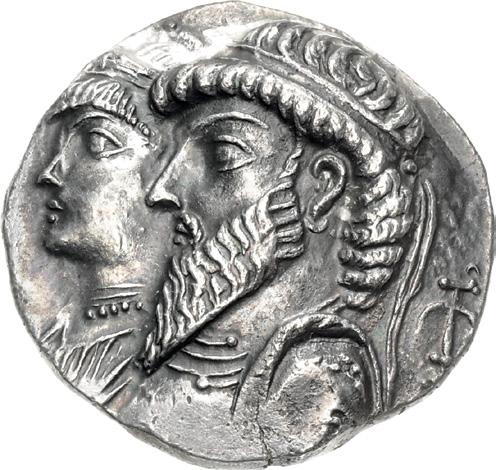

410. KINGS of ELYMAIS. Kamnaskires III, with Anzaze. Circa 82/1-73/2 BC. AR Tetradrachm (29mm, 16.19 g, 12h). Seleukeia on the Hedyphon mint. SE date not visible, but possibly SE 232 (81/80 BC). Conjoined busts of Kamnaskires III, diademed and draped bust and wearing long beard and torque, and Anzaze, draped and wearing stephane and necklace, left; anchor symbol to right / 5G45GE∑4 above, [˚]G;@G4˚55o[U] to right, ˚G5 5G45G544˙[4] to left, 2@Z2Z˙5, Zeus-Belos enthroned left, holding in outstretched right hand Nike, standing right and holding wreath, and scepter in left; traces of ;G˚4d∑@ to inner left; [date in exergue]. Cf. van’t Haaff Type 7.1.1-2; Alram 454 (date unlisted); Sunrise –; Zeno #330023 (this coin); GoMo 302, lot 266 (same dies). Toned, with iridescence, traces of find patina, hint of cleaning marks, hairline flan crack, slight peripheral weakness. EF. ($1000)

411. KINGS of PERSIS. Vahbarz (Oborzos). 3rd century BC. AR Tetradrachm (27mm, 17.07 g, 4h). Istakhr (Persepolis) mint. Diademed head right, wearing kyrbasia / Figure in Achaemenid royal attire, with bow and quiver over shoulder, standing right, holding in his left hand the hair of a Greek hoplite kneeling right, wearing military attire and with shield on left arm, who he is preparing to slay with a dagger held in his right hand; zrbºhº (whwbrz in Aramaic) to left; ynrk (krny in Aramaic) to right; ywtnw (wnwbrz in Aramaic) in exergue. Cf. van’t Haaff, Persis, Type 532Aab (for drachm); otherwise unpublished. Lightly toned with iridescence, scattered obverse deposits, light marks. Near EF. Bold reverse. Unique. ($75,000)
412. KINGS of PERSIS. Vahbarz (Oborzos). 3rd century BC. AR Drachm (17mm, 4.29 g, 3h). Istakhr (Persepolis) mint. Diademed head right, wearing kyrbasia / Figure in Achaemenid royal attire, with bow and quiver over shoulder, standing right, holding in his left hand the hair of a Greek hoplite kneeling right, wearing military attire and with shield on left arm, who he is preparing to slay with a dagger held in his right hand; zrbºhº (whwbrz in Aramaic) to left; ynrk (krny in Aramaic) to right; ywtnw (wnwbrz in Aramaic) in exergue. van’t Haaff, Persis, Type 532Aa = K&M 2/16a = Alram, Neue = Peus 316, lot 259 (same dies); van’t Haaff, Persis, Type 532Ab = K&M 2/16b = New York Sale XXXVIII, lot 241 = Sunrise 567 = Zeno #163856 = Müseler, Dating, Fig. 13 (same dies); Alram –. Lightly toned, with iridescence, hint of deposits, uncertain Aramaic graffiti on reverse. Near EF. Extremely rare, the third example known. ($15,000)
Among the issues of Vahbarz (Oborzos) are the extremely rare drachms – and now, tetradrachm – showing an Achaemenid-style ruler slaying a captive Greek hoplite. So far, only three examples of the drachms are known, all struck from the same pair of dies. The tetradrachm of the same type, the reverse design of which shares stylistic affinities with the drachms, indicates a particularly special issue and that a single engraver – a master craftsman – was responsible for the reverse dies of both denominations. The obverse of our tetradrachm is die linked with those of Ardaxšir (Artaxerxes) I (see, for example, CNG 123, lot 334), placing the two rulers in close chronology.
The legend here calls Vahbarz (Oborzos) ynrk (krny), rather than the more usual àKR†RP (prtrk’), a title that appears on his later coinage. Vahbarz (Oborzos) is the only ruler of Persis to have coins with this title on them. Other examples his coins with krny include two tetradrachms (van’t Haaff, Persis, Type 562A, examples a and b), and a unique drachm in a private collection (Müseler, Dating Fig. 13), all with the firealtar reverse. None of these coins have the royal standard that normally appears in the design. A probable explanation is that Vahbarz’s status as commander-in-chief, and not ruler in his own right, would account for the absence of the standard. In addition, one of these tetradrachms, as well as the drachm, includes a ¡ in the exergue (cf. SC 241-243[for monogram]). This monogram is similar to Seleukid issues of the coregency of Seleukos I and Antiochos I, attributed in SC to an uncertain mint in Drangiana or Western Arachosia, and dated to 294-281 BC. All together, the krny coinage of Vahbarz forms a compact group.
The reverse design has been the subject of interest since the first drachm showing an Achaemenid style ruler slaying a captive Greek hoplite came onto the market almost four decades ago. That coin, discovered by the late Wilhelm Müseler in 1986, was sold in Peus 316 (lot 259). Michael Alram, in his publication of the coin the following year (“Eine neue Drachme des Vahbarz [Oborzos] aus der Persis?,” in Litteratae Numismaticae Vindobonenses 3 [1987], p. 149) was quick to note the unusual subject, arguing that the coinage of Persis was conservative in design, with ideologically predetermined elements, and lacking the influence of foreign ideas. While true in most respects, the coronation-type coinage of Baydād (Bagadat) provides a visible counterpoint: an innovative design that is of indigenous, rather than foreign ideas (see the reliefs of the enthroned Achaemenid king Dareios I from the Apadana at Persepolis which served as the model for Baydād [Bagadat]). For Vahbarz (Oborzos), the trope has a long history, both in the ancient Near East, as well as in Persian art. Two seals of the Achaemenid period showing potential prototypes of the victor slaying the captive (J. Boardman, Persia and the West, p. 160, figs. 5.6 and 5.7). One of these shows Artaxerxes III Ochos slaying the rebellious pharaoh Nektanebo I, while the other depicts one Greek hoplite spearing another. Among the tombs in Necropolis II at Limyra in Lykia is a tomb relief of one hoplite about to slay another. All three examples demonstrate that this scene was a well-known eastern motif.
Other than the coins themselves, very little is known about the career of Vahbarz, or the events commemorated on this particular issue. An anecdote in the Strategmata, or Stratagems in War, by Polyainos, a Macedonian author and rhetorician, has since been recognized to be referring to Vahbarz. Written in AD 163, during the Roman-Parthian War of AD 161-166, and dedicated to Marcus Aurelius and Lucius Verus, it is a collection of narratives describing various stratagems, in particular, those involving various military leaders. In Book VII, which describes the actions of a number of non-Greeks, Polyainos relates the murder and secret burial of 3000 Greek military settlers by Oborzos, whom he considered to be plotting against him (Chapter 40). This tale, however, contains an underlying sense of deception that would seem hardly appropriate for such a prestige issue. Given the Achaemenid association, the design rather recalls the Greco-Persian Wars of the early 5th century BC and the subsequent events that resulted in the disintegration of the Persian Empire and the rise of the Macedonian kingdoms. The kingdom of Persis, which until the third century BC had been a quasi-vassal state of the Seleukid Empire, may have taken the defeat of Antiochos III at Thermopylai in 191 BC to exploit its autonomy. This change was short-lived, however, as the Seleukids seemed to recover as Antiochos is recorded as being present in the area. Vahbarz appears to have submitted his independence and been installed as a frataraka, as his subsequent coinage is of the fire-altar type. It is quite possible that the anecdote about his treachery may have been spread to undercut any future rebellion and assuage Seleukid sensibilites. All that remains is the extremely rare numismatic evidence of Persian glory.





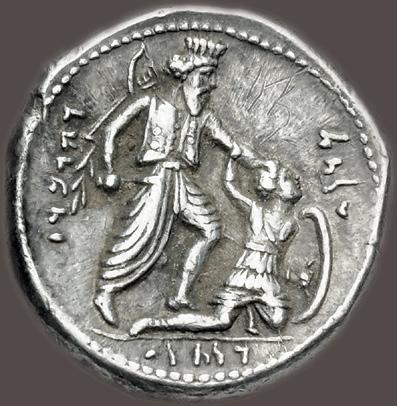








413. KINGS of PERSIS. Vādfradād (Autophradates) I. 3rd century BC. AR Tetradrachm (30mm, 16.68 g, 12h). Istakhr (Persepolis) mint. Diademed head right, wearing kyrbasia / Fire temple of Ahura-Mazda; to left, Vādfradād standing right, raising hand; standard to right; ®†PrD† (wtprdt in retrograde Aramaic) to outer right; Y‹ !KR†RP (prtrk’zy in Aramaic) in exergue; bR (br in retrograde Aramaic) to left of altar. van’t Haaff, Persis, Type 540/542g; K&M –; cf. Alram 540 and 542 (for type); CNG 127, lot 305 (same rev die). Slight iridescence, traces of deposits and die rust, slight porosity, overstruck on a coronation type tetradrachm of Baydād (Bagadat), itself overstruck on an Alexandrine tetradrachm. EF. ($2000)



414. BAKTRIA, Greco-Baktrian Kingdom. Euthydemos I Theos Megas. Circa 225-200/195 BC. AR Tetradrachm (28mm, 16.51 g, 12h). Mint B (“Baktra”). Struck circa 210-206 BC. Diademed head right / ∫Å%5¬EW% to right, EUQUd˙;oU to left, Herakles seated left on rock, holding club set on rocks; } to right of rock. MPHB B Group V, 430 (O121/R300); Kritt B15; Bopearachchi 10A; Bopearachchi & Rahman 112; MIG Type 96; SNG ANS 138; HGC 12, 42. Iridescent tone. Good VF. ($1000)
From the Gerald F. Borrmann (Northern California Gentleman) Collection, purchased from Classical Numismatic Group, May 1993.
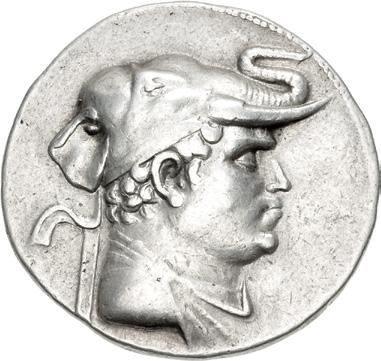
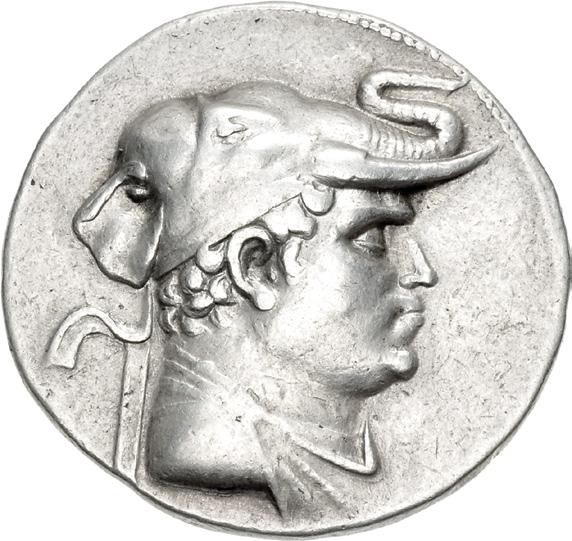

415. BAKTRIA, Greco-Baktrian Kingdom. Demetrios I Aniketos. Circa 200-185 BC. AR Tetradrachm (32mm, 16.99 g, 12h). Diademed and draped bust right, wearing elephant skin headdress / ∫Å%5¬EW% to right, d˙;˙tr5oU to left, Herakles standing facing, crowning himself, holding club and lion skin; D to inner left. MPHB Group IIB, 57–8 (O17/R43); Bopearachchi 1F; cf. Bopearachchi & Rahman 124 (fourrée); MIG Type 103c; SNG ANS 190; HGC 12, 63. Lightly toned, light hairlines. Good VF. ($2000)




416. BAKTRIA, Greco-Baktrian Kingdom. Agathokles Dikaios. Circa 185-175 BC. AR Tetradrachm (33mm, 15.70 g, 12h). Commemorative issue struck for Alexander III of Macedon. ÅGE$Å@d[roU] to right, toU f5GG5∏oU to left, head of Herakles right, wearing lion skin / ∫Å%5¬EUo@to% to right, Å˝ÅQo˚2EoU% to left, d5˚Å5oU in exergue, Zeus Aëtophoros enthroned left; D to inner left. MPHB Series III, 113 (O18/R57); Bopearachchi 12B; Bopearachchi & Rahman 163 (same dies); MIG type 142 var. (unlisted monogram); SNG ANS –; HGC 12, 83; Triton XI, lot 358 (same dies); Triton VIII, lot 633 (same dies). Lightly toned, edge deposit, die rust and horn silver, slight doubling, cleaning marks. VF. Extremely rare. ($10,000)
The “pedigree” coins issued by Agathokles copy the coin types of his predecessors, with the predecessor’s name and cult epithet on the obverse, and Agathokles’ name and titles on the reverse. Agathokles’ intent was clearly to advertise the line of succession from Alexander the Great to himself, presumably as an aspect of his civil war propaganda. The commemorative coins in the name of Alexander the Great are of particular importance to the interpretation of this series, because the first specimen, published in 1881, definitively disproved earlier speculations that all the kings were contemporaries (A. von Sallet, “Alexander der Grosse als Gründer der baktrischen-indischen Reiche,” ZfN VIII [1881], pp. 279-80). It is perhaps significant that Alexander alone, of all the kings portrayed in this series, does not have a cult epithet but is merely characterized as “the son of Philip.”



417. BAKTRIA, Greco-Baktrian Kingdom. Agathokles Dikaios. Circa 185-175 BC. AR Tetradrachm (32mm, 16.53 g, 12h). Commemorative issue struck for Diodotos II Soter. d5odotoU to right, traces of %∑t˙ro% to left, diademed head of Diodotos right / ∫Å%5¬EUo@to% to right, Å˝ÅQo˚2EoU% to left, d5˚Å5oU in exergue, Zeus Bremetes, seen from behind, advancing left, aegis draped over outstretched left arm, and brandishing thunderbolt in right hand; in inner left field, wreath above eagle standing left; D to inner right. MPHB Group I, 152–4 (O27bis/R79); Kritt, New, p. 81; Bopearachchi 14A; Bopearachchi & Rahman 165–6; MIG Type 144a; SNG ANS 259; HGC 12, 85; CNG 108, lot 416 (same obv. die). Toned, with slight iridescence, porosity, traces of horn silver, marks, slight peripheral weakness on obverse. VF. Very rare. ($2000)



418. BAKTRIA, Greco-Baktrian Kingdom. Antimachos I Theos. Circa 180-170 BC. AR Tetradrachm (33.5mm, 16.88 g, 12h). Diademed and draped bust right, wearing kausia / ∫Å%5¬EW% QEoU to right, Å@t5;ÅcoU to left, Poseidon, laureate, standing facing, holding trident in right hand and cradling filleted palm in left arm; } to inner right. MPHB Group I, 36–9 var. (O8/R– [unlisted rev. die]); Bopearachchi 1B; Bopearachchi & Rahman 175; MIG Type 124c; SNG ANS –; HGC 12, 106. Attractive iridescent toning, light roughness. Near EF. ($1000)
Ex Roma XXIX (9 November 2023), lot 244.

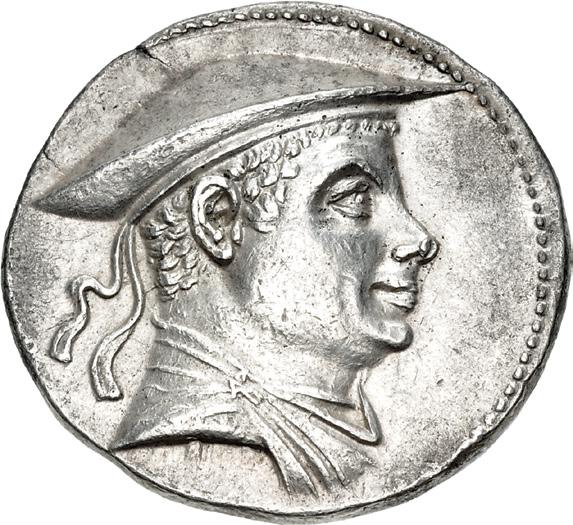
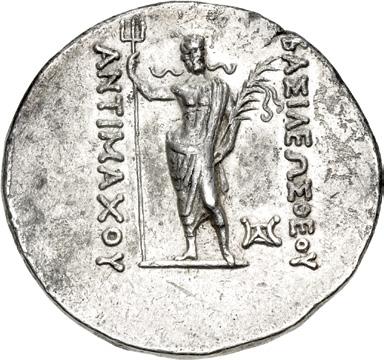
419. BAKTRIA, Greco-Baktrian Kingdom. Antimachos I Theos. Circa 180-170 BC. AR Tetradrachm (32mm, 16.84 g, 12h). Diademed and draped bust right, wearing kausia / ∫Å%5¬EW% QEoU to right, Å@t5;ÅcoU to left, Poseidon, laureate, standing facing, holding trident in right hand and cradling filleted palm in left arm; à to inner right. MPHB Group IV, 354 (O55/R166 – this coin); Bopearachchi 1E; Bopearachchi & Rahman 179; MIG Type 124a; SNG ANS –; HGC 12, 106; BM inv.1888,1208.124 (same dies). Iridescent toning, tiny flan split, cleaning marks, areas of find patina on edge. Near EF. ($1000)
From the Useless Miwa Collection. Ex Kyrios Collection (Spink 289, 3 October 2023), lot 139; Spink 206 (1 December 2010), lot 1277; Spink 198 (19 March 2009), lot 371.




420. BAKTRIA, Greco-Baktrian Kingdom. Eukratides I Megas. Circa 170-145 BC. AR Pentadrachm (34mm, 21.12 g, 12h). Diademed and draped bust right / ∫Å%5GE∑% above, EUkrÅt5doU in exergue, the Dioskouroi, holding palm fronds and spears, on horses rearing right; E above horse’s rump; R in lower right field. Zeng, Brief, Fig. 3 (same dies); Bopearachchi –, but cf. 2E (drachm); Bopearachchi & Rahman –; Qunduz –, but cf. 115-6 (tetradrachm with different control); SNG ANS –, but cf. 434-5 (same) and 442 (drachm); HGC 12, –. In NGC encapsulation 6675146-001, graded Choice AU★, Strike: 5/5, Surface: 4/5. Obverse struck with tetradrachm die. Second known example with these controls, and the fifth known of this denomination. ($50,000)
Ex Roma XXIX (9 November 2023), lot 245 (hammer £85,000); Roma XXV (22 September 2022), lot 571.
In late 2019, a large hoard of coins was reportedly discovered in Qunduz, the same area where a large hoard of similar coins was found in 1946 (Zeng, p. 3). According to its composition, this new hoard contained, in addition to already known issues and types, several previously unknown coins. It included five coins of Eukratides I that combined monograms with Greek letters on their reverse. The four larger denominations by weight have the letter E, and the smaller one a Г. Previously known coins of Eukratides I with the combined reverse monogram and Greek letter included a larger one with the letter Δ, and a smaller one with the letter A. In his 1991 catalog of the coins of Baktria, Bopearachchi hypothesized that these letters represented alphanumeric letters, indicating the denomination of that coin (pp. 66-72). The five new coins recorded in the hoard support this hypothesis: the four coins with the letter E being pentadrachms and the one with the Г a tridrachm. Including the present coin (as well as a previously misattributed tridrachm [see CNG E-409, lot 334]), these new issues help with understanding this coinage.
Bopearachchi assigned the tetradrachms of this type to his Série 1 and the drachms to Série 2. These are included with other issues of the same type, but without the additional Greek letter. The inclusion of the newly discovered pentadrachms and tridrachms suggests a revision of his original schema, with these new coins suggesting a compact issue early in his reign when his coinages lacked the reverse epithet MEГAΛOY. The denominations occur across three controls (}, à, and R), suggesting a broad minting of this type, rather than a special issue relegated to one or two mints. Why this system was instituted, and when it ceased (with the pentadrachms and tridrachms disappearing completely), is less clear and requires further study.




421. BAKTRIA, Greco-Baktrian Kingdom. Eukratides I Megas. Circa 170-145 BC. AR Tetradrachm (35mm, 16.11 g, 12h). Diademed and draped bust right, wearing crested helmet adorned with bull’s horn and ear; bead-and-reel border / ∫å%5GE∑% ÂE˝ÅGoU around, EUkrÅt5doU in exergue, the Dioskouroi, holding palm fronds and spears, on horses rearing right; Í in lower right field. Bopearachchi 6E; Bopearachchi & Rahman 240-2; MIG Type 177ee; SNG ANS 465; HGC 12, 131. Toned, areas of find patina, slightly worn at high points, minor porosity, light marks under tone. Near EF. ($750)
422. BAKTRIA, Greco-Baktrian Kingdom. Eukratides I Megas. Circa 170-145 BC. AR Tetradrachm (35mm, 16.80 g, 12h). Diademed and draped bust right, wearing crested helmet adorned with bull’s horn and ear; bead-and-reel border / ∫å%5GE∑% ÂE˝Å¬oU above, EUKr~t5doU in exergue, the Dioskouroi, holding palm fronds and spears, on horses rearing right; T in lower right field. Bopearachchi 6W; Bopearachchi & Rahman 245; MIG Type 177f; SNG ANS 469–71; HGC 12, 131. Deeply toned, with traces of iridescence, some light pitting and edge marks. EF ($1000)
From the Columbus Collection. Ex Leu 72 (12 May 1998), lot 378.
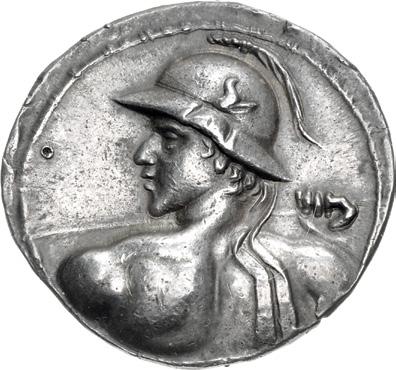


423. BAKTRIA, Greco-Baktrian Kingdom. Eukratides I Megas. Circa 170-145 BC. AR Tetradrachm (33mm, 16.96 g, 12h). Diademed and helmeted heroic bust left, seen from behind, brandishing spear in right hand / ∫å%5GE∑% ÂE˝ÅGoU around, EUkrÅt5doU in exergue, the Dioskouroi, holding palm fronds and spears, on horses rearing right; D to lower right. Bopearachchi 8B; Bopearachchi & Rahman 255; MIG Type 179a; SNG ANS 485; HGC 12, 132. Deeply toned, with traces of iridescence, some porosity, possible shroff mark or potential piercing on obverse, edge marks and evidence of possible prior mounting. Good VF. ($5000)
From the Columbus Collection. Ex Leu 72 (12 May 1998), lot 379.


424. BAKTRIA, Greco-Baktrian Kingdom. Eukratides II Soter. Circa 145-140 BC. AR Tetradrachm (32mm, 16.96 g, 12h). Diademed and draped bust right / ∫Å%5¬EW% to right, EU˚rÅt5doU to left, Apollo, holding arrow in hand, standing left and leaning on bow set on ground; à to inner left. Bopearachchi 1I; Bopearachchi & Rahman –; MIG –; SNG ANS 623; HGC 12, 161. Iridescent toning, areas of deposits, hint of underlying luster. EF. Attractive example. ($1000)




425. BAKTRIA, Indo-Greek Kingdom. Menander I Soter. Circa 155-130 BC. AV Stater (20mm, 8.46 g, 11h). Draped bust of Athena right, wearing crested helmet adorned with wing; all within bead-and-reel border / Owl standing right on ground line, head facing; ~ to left; all within bead-and-reel border. Bopearachchi 1A; MIG Type 211a; Zeno –; HGC 12, 494; Boston MFA Supp. 312; Treasures of Ancient Bactria (Miho Museum), 46a (same obv. die). Lightly toned, traces of deposits, numerous marks, edge marks. Near EF. Very rare. ($50,000)
Unlike his silver and bronze issues, the gold coinage of Menander I Soter is very rare (as is the case with Baktrian gold issues in general). This stater, with the helmeted head of Athena on the obverse and an owl on the reverse, is among the rarest. Mitchiner questioned the authenticity of some of the examples he recorded (noted below), but did not doubt the 1888 British Museum specimen, which is struck from the same obverse die as the present coin (at a later die state). Bopearachchi, in a note on the series, repeated Mitchiner’s reservation without further elucidation. Some examples, such as the two in the ANS, have been condemned, but twelve of the known pieces remain as likely genuine. Notably, none of the pieces published from obverse die A, below, have been questioned.
1. A/a a) Triton XXVIII, lot 425 (this coin)
2. A/b a) Bombay, Price of Wales Museum [A.S. Altekar, JNSI 11 (1949), pp. 45–6, pl. I, 2] b) Private collection
3. A/c a) Koka, Miho Museum [Treasures of Ancient Bactria 46a] b) CNG 102, lot 706
4. A/d a) London, British Museum, inv. 1888,1208.283 [MIG Type 211a (top photo)]
5. B/e a) Oxford, Ashmolean Museum [Haughton Collection 395 (questioned by Mitchiner)]
b) London, British Museum, inv. 1939,0512.1 [R. B. Whitehead, NC 1940, 5 (questioned by Mitchiner)]
c) Private collection [Haughton Collection 396 (questioned by Mitchiner)]
d) Private collection
6. C/f a) Boston, Museum of Fine Arts [Boston MFA Supp. 312; Haughton Collection 397]
7. Unseen a) Varanasi, Banaras Hindu University [A.S. Altekar, JNSI 11 (1949), p. 46]




426. BAKTRIA, Indo-Greek Kingdom. Antialkidas Nikephoros. Circa 130-120 BC. AR Tetradrachm (26mm, 9.85 g, 12h). ∫å%5GE∑% @5k˙foroU å@t5åGk5doU, diademed and draped bust right / sdKLAˇA sr@yj sjrhm (Maharajasa jayadharasa Amtialikidasa in Kharosthi), Zeus standing facing slightly left, holding in his right hand Nike, who stands right on a globe and holding wreath, and cradling scepter in his left arm; behind, elephant standing slightly raised right with trunk raised; n to left. Bopearachchi 6A; Bopearachchi & Rahman –; MIG Type 273a; SNG ANS 1057; HGC 12, 252. Iridescent toning, hint of deposits, light porosity and marks. Good VF. ($2000)
Ex Gorny & Mosch 297 (9 October 2023), lot 331.

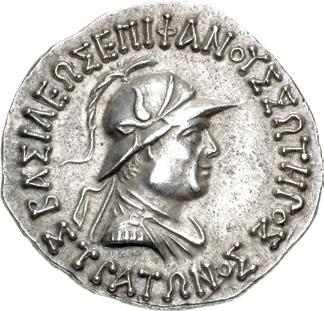


427. BAKTRIA, Indo-Greek Kingdom. Strato I Soter. Circa 105-85/0 BC. AR Tetradrachm (27.5mm, 9.83 g, 12h). ∫å%5GE∑% E∏5få@oU% %∑t˙ro% %tråt∑@o%, diademed and draped bust right, wearing crested helmet adorned with bull’s horn and ear / st— srt{ sçcÒ sjrhµ (Maharajasa pracachasa tratarasa Stratasa in Kharosthi), Athena Alkidemos standing left, brandishing thunderbolt and aegis; G to inner left. Bopearachchi 28A; Bopearachchi & Rahman 430-1; MIG Type 332a; SNG ANS –; Zeno 321221 (this coin); HGC 12, 335. Light iridescent toning, slight double strike and slightly off center on reverse. EF. Rare. ($5000)
Ex Gorny & Mosch 297 (9 October 2023), lot 383.
Like most Indo-Greek rulers, Strato I is unknown to history apart from his coins, which suggest his rule encompassed Gandhara and the Punjab. His earliest coins show a youthful bust conjoined with that of a woman named Agathokleia, possibly his mother. His solo portraits show a somewhat older visage, some sporting a broad-rimmed helmet like that of Eukratides. Athena appears in several poses on the reverses of his coins, here in the traditional stance of Athena Alkidemos, preparing to hurl a thunderbolt.



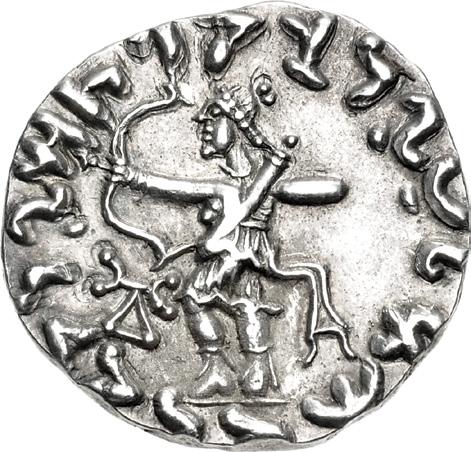
428. BAKTRIA, Indo-Greek Kingdom. Artemidoros Aniketos. Circa 100-80 BC. AR Tetradrachm (26mm, 9.62 g, 12h). ∫å%5GE∑% å@5k˙toU årtE;5d∑roU, diademed and draped bust right; straight diadem ties / srDMˇA sthˇpA sjrhm (Maharajasa apadihatasa Amtialikidasa in Kharosthi), Artemis standing left, quiver at shoulder, drawing bow; § to left. Bopearachchi 2A; Bopearachchi & Rahman 498 var. (one diadem tie angled); MIG Type 398a; SNG ANS –; HGC 12, 352. Iridescent toning, hint of deposits. Near EF. Very rare monogram. ($2000)

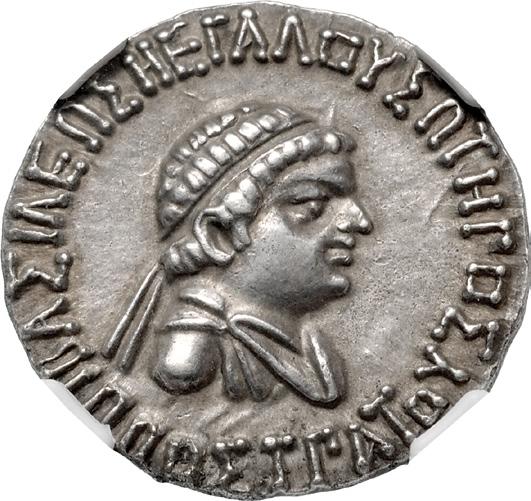

429. BAKTRIA, Indo-Greek Kingdom. Hippostratos Soter. Circa 65-55 BC. AR Tetradrachm (29mm, 9.50 g, 12h). ∫~%5GE∑% %∑t˙rä% 5∏∏ä%tr~täU, diademed and draped bust right / st—π˙ srt{ sjrhm (Maharajasa tratarasa Hipustratasa in Kharosthi), Hippostratos, in military attire, on horse rearing right on ground line; 2 below. Bopearachchi 3A; Bopearachchi & Rahman 662-3; MIG Type 441a; SNG ANS 1622-3; HGC 12, 449. In NGC encapsulation 6763169-008, graded XF★, Strike: 4/5, Surface: 4/5. ($1000)


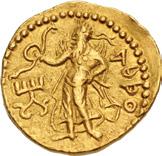

430. INDIA, Kushan Empire. Kanishka I. Circa AD 127-151. AV Quarter Dinar (13mm, 2.01 g, 12h). Main mint in Baktria (Balkh?). Early phase. s aonanosao ˚anIs˚i ˚OsanO, diademed and crowned half-length bust of Kanishka left on clouds, holding spear; flames at shoulder / aœso to right, Athsho standing left, holding diadem in extended right hand and resting left hand on hilt; 8 to left. MK 41 (O1/R10α [unlisted die combination]); ANS Kushan 376 (same dies); Donum Burns 122 (same dies); Zeno 197596 (this coin). Light reddish toning, tiny edge ding, struck from worn obverse die. Good VF. Very rare. ($1500)
From the JTB Collection. Ex Dr. D. Löer Collection (Leu Numismatik AG Web Auction 28 (9 December 2023), lot 2060; Heritage Europe 58 (15 May 2018), lot 7027.




431. INDIA, Kushan Empire. Kanishka I. Circa AD 127-151. AV Dinar (20mm, 7.89 g, 12h). Main mint in Baktria (Balkh?). Late phase. sa[on]anosao ka nIs˚i ˚osan[o], Kanishka, diademed and crowned, standing facing, head left, holding goad and scepter, sacrificing over altar to left; flame at shoulder / Ma˜aoßago to left, Manaobago, nimbate and helmeted, with lunar horns at shoulders, seated facing on raised stool, cushioned and with curving legs, feet on footstool, head right and with four arms: lower right on hip, upper right holding coins or fruit, upper left holding mace-scepter, and lower left holding torque; 9 to right. MK 59 (O13/R2); ANS Kushan 385; Donum Burns 129; Triton XXIII, lot 554; Spink 248 lot 124; CNG 100, lot 1662; Baldwin’s 91, lot 3831; Goldberg 75, lot 2541 = Goldberg 69, lot 3206; Heritage 3020, lot 25059 (same rev. die, but later die state). Toned, deposits in devices, evidence of prior mounting. VF. Extremely rare, Göbl cites four examples, eight in CoinArchives (including this coin). ($3000)
Ex Spink 248 (25 September 2017), lot 124 (hammer £6,000).




432. INDIA, Kushan Empire. Huvishka. Circa AD 151-190. AV Quarter Dinar (13.5mm, 1.96 g, 12h). Main mint in Baktria (Balkh?). Early phase. saO˜a˜Osa[O] ooIs˚i ˚Os[ŘO], diademed and crowned half-length bust left on clouds, holding mace-scepter and goad / c˚ a˜Do ˚oM a ro bizag o, Skando-Komaro and Bizago, both nimbate, standing facing, heads vis-à-vis; Skando-Komaro holding spear in right hand, left hand on hilt; Bizago with right hand on hip, holding spear in left hand; 7 between. MK 166 (O22/R3); ANS Kushan –; Donum Burns –; Zeno –. Lightly toned. EF. Very rare. ($3000)




433. INDIA, Kushan Empire. Huvishka. Circa AD 151-190. AV Quarter Dinar (13mm, 1.98 g, 12h). Main mint in Baktria (Balkh?). Early phase. saO˜[a˜OsaO] ooIs˚i ˚Osa˜O, diademed and crowned half-length bust left on clouds, holding mace-scepter and goad / ˜a˜a oIs O, Nana, nimbate, and Siva standing facing, heads vis-à-vis; Nana holding scepter and box; Siva pouring water from flask and holding vajra (thunderbolt), trident, and he-goat; 7 between. MK 167 (O20/R1); ANS Kushan –; Donum Burns –; Zeno –; CNG 117 (Archytas Collection), lot 377. Lightly toned, hint of deposits, obverse struck with worn die. Good VF. Extremely rare, two examples cited by Göbl, only the Archytas coin in CoinArchives. ($2000)




434. INDIA, Kushan Empire. Huvishka. Circa AD 152-192. AV Dinar (21mm, 7.91 g, 12h). Subsidiary mint in Gandhara (Peshawar?). Early phase. sIo˜a˜osao o oIs˚i ˚osa˜[o] crowned and diademed bust left on clouds, holding mace-scepter in right hand and goad in left; flames over shoulder / Miiro to right, Miiro (Mithra) standing facing, head left, extending hand in benediction, cradling filleted scepter, and holding hilt of sword; 7 to left. MK 291 (O30/R10); ANS Kushan 755; Donum Burns –. Lightly toned. EF. ($2000)
Ex Sovereign Rarities inventory #EM13453 (ND); Classical Numismatic Group 87 (18 May 2011), lot 779.




435. INDIA, Kushan Empire. Huvishka. Circa AD 151-190. AV Quarter Dinar (13mm, 1.99 g, 12h). Subsidiary mint in Gandhara (Peshawar?). Early phase. saO˜a˜OsaO o oIs˚i ˚Osa˜O, diademed and crowned half-length bust left on clouds, holding mace-scepter in right hand and goad in left / naNa to left, Nana, nimbate, wearing fillet and crescent, standing right, holding scepter and box; 8 to right. MK 314 (O40/R32); ANS Kushan –; Donum Burns 281 (same dies); Zeno –. Struck with worn reverse die. EF. Rare. ($1500)



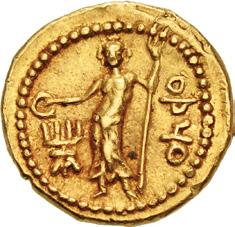
436. INDIA, Kushan Empire. Vasudeva I. Circa AD 190-230. AV Quarter Dinar (13mm, 1.94 g, 12h). Subsidiary mint in Gandhara (Peshawar?). Middle phase. sÅo˜Å˜osÅo b ÅzoÅ IosŘo, Vasudeva, nimbate, helmeted, and diademed, standing facing, head left, holding trident, sacrificing over altar to left / oISo to right, ithyphallic Siva standing facing, diadem and trident; ^ to left. MK 505 (O11/R1); ANS Kushan –; Donum Burns –; Zeno #244725 (this coin). Toned, deposits in devices, flaw at edge of reverse. VF. Very rare. ($1500)
Ex Roma E-Sale 82 (15 April 2021), lot 829; Roma E-Sale 68 (27 February 2020), lot 829.

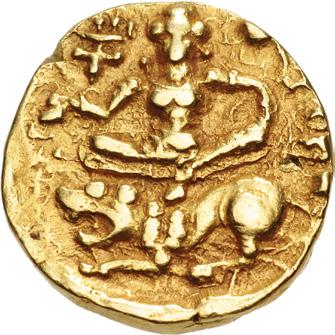

437. INDIA, Gupta Empire. First Dynasty. Chandragupta II Vikramaditya. Circa AD 380-413. AV Dinar (18mm, 7.73 g, 12h). Lion-slayer type. Nr4C4.[...]Ve,. (narendrachandraḥ [...]vikramaḥ in Brahmi), Chandragupta, nimbate, standing facing left, drawing his bow upon a lion, which falls over backwards / &XVe,. (siṁhavikramaḥ in Brahmi), Lakshmi, nimbate, seated facing on lion sleeping left, holding diadem and cornucopia; 0 to upper left. Kumar (2nd ed.) 12.7, Class III, Variety A.4.2, 467 (same dies); Sunrise –; BKB 114; BMC Guptas 112; Altekar Class II, Variety F; Bayana 1177. Toned, worn dies, small test cut on edge. VF. Very rare. ($2000)
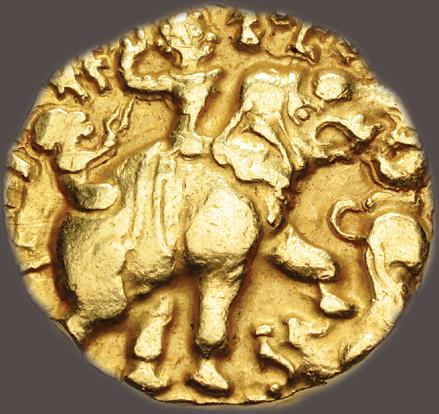



438. INDIA, Gupta Empire. First Dynasty. Kumaragupta I Mahendraditya. Circa AD 413-455. AV Dinar (18mm, 7.95 g, 12h). Elephant-rider/Lion-trampler type. Ft Y,r[...] (kṣhataripu Kumāra[...] in Brahmi), Kumaragupta seated right on caparisoned elephant advancing right and stepping on lion with left foreleg; behind Kumaragupta, an attendant holding a parasol / &X Lt ,h4gj (simhanihaṁtā mahendragaja in Brahmi), Lakshmi, nimbate, standing facing, head left, holding lotus and making benedictional gesture to peacock to left, standing right. Kumar (2nd ed.) 13.6, 630 (same dies); BKB 187; BMC Guptas –; Altekar, pp. 195-7; Bayana 1795-8. Toned. Good VF. Very rare, one of fifteen specimens known. ($30,000)



439. INDIA, Gupta Empire. First Dynasty. Kumaragupta I Mahendraditya. Circa AD 413-455. AV Dinar (19mm, 8.11 g, 12h). Tiger-slayer type. %, L, k§,. (srimam vygāhrabalaparākramaḥ in Brahmi), Kumaragupta, nimbate, standing facing left, drawing his bow upon a tiger, which falls over backwards; k (ku in Brahmi) below left arm / rGzrj. (kumāragupto’dhirajaḥ in Brahmi), Lakshmi, nimbate, standing right on mākāra (the goddess Gānga), holding lotus and feeding a peacock; 0 to upper left. Kumar (2nd ed.) 13.15, Variety A.1; BKB 181-2; BMC Guptas 244; Altekar Variety A; Bayana 1719. Toned, slight peripheral weakness. Good VF. Rare. ($3000)


440. SASANIAN KINGS. Šābuhr (Shahpur) I. AD 240-272. AV Dinar (21mm, 7.24 g, 3h). Mint I (“Ctesiphon”). Phase 2, circa AD 260-272. !000 NM 0000X 0NM N! 00!!00M N!00 M 00j000j! 4 †0000µ (mzdysn bgy šhpwhry MRK’n MRK’ ’yr’n MNW ctry MN yzd’n in Pahlavi), bust right, wearing diadem and mural crown with korymbos; pellet above between merlon and korymbos / bj100) (nwr’zy in Pahlavi) to right, )00jojç (šhpwhry in Pahlavi) to left, fire altar; flanked by two attendants wearing mural crown. SNS type IIc/1b, style P, group d/1; Saeedi AV4 var. (no pellet); Sunrise 739 var. (same). Lightly toned, slight peripheral weakness. EF. ($2500)
From the JTB Collection. Ex Leu Numismatik AG Web Auction 16 (22 May 2021), lot 1676.


441. SASANIAN KINGS. Šābuhr (Shahpur) I. AD 240-272. AV Dinar (21mm, 7.36 g, 3h). Mint I (“Ctesiphon”). Phase 2, circa AD 260-272. !000 NM 0000X 0NM N! 00!!00M N!00 M 00j000j! 4 †0000µ (mzdysn bgy šhpwhry MRK’n MRK’ ’yr’n MNW ctry MN yzd’n in Pahlavi), bust right, wearing diadem and mural crown with korymbos; one pellet above and two pellets below diadem ties / bj100) (nwr’zy in Pahlavi) to right, )00jojç (šhpwhry in Pahlavi) to left, fire altar; flanked by two attendants wearing mural crowns; > to left of flames. SNS type IIc/1b, style P, group d/1; Saeedi AV5; Sunrise 740. Lightly toned, traces of underlying luster, light die rust on obverse. EF. ($2500)




442. SASANIAN KINGS. Ohrmazd (Hormizd) I. AD 272-273. AV Dinar (22mm, 7.41 g, 3h). Style Abis. Uncertain mint. 00 No jWo 0100 0100100 1[...]KRo 00UZoRRjRA 4 NsYdRo (mzdysn bgy ’hrmzdy MRK’n MRK’ ’yr’n W ’n’yr’n MNW ctry MN yzd’n in Pahlavi), bust right, wearing diadem and crown with korymbos; two pellets between upper and lower ribbons; crown and korymbos decorated with pellets / U jL00 (’wḥrmzdy in blundered Pahlavi) to left, YZ1oLN00 (NWR’ zy in blundered Pahlavi) to right, fire altar; flanked by two attendants, left wearing crown with korymbos, right wearing mural crown and holding diadem. SNS type Ib(1)/2b(1) and pl. 2, A9 = Saeedi AV 10; Sunrise –; Zeno –. Toned, edge flaw. Good VF. Extremely rare denomination for this ruler, only the second known dinar of this particular variety for Ohrmazd I (the other being the Saaedi coin). ($75,000)
The third son of the conquering monarch Šābuhr (Shahpur) I (AD 240-270), Ohrmazd I first comes to historical light as one of his father’s commanders during the Sasanian invasion of the Roman east in AD 253-256. Legend has it he was advanced in the succession due to a prophecy. His name is recorded on an inscription in Persepolis as “Great King of the Armenians,” a title granted to the royal heir much as “Prince of Wales” is used nowadays to designate the heir to the British throne. He was raised to the Persian throne upon the death of his father, either in AD 270 or 272. Very little is known about his brief reign. His coins bear his title “King of Kings of the Iranians” but also add “and non-Iranians,” an innovation carried on by succeeding Sasanian monarchs. His coins also differ from those of his father in that the fire attendants on the reverse are usually shown facing inward toward the altar, as opposed to facing away. Unlike his father’s long and consequential rule, Ohrmazd I’s reign was only about a year, and the cause of his death is unrecorded. Although he is known to have had a son, he was succeeded by his brother, Bahram I (AD 273-276). While his silver coins are scarce, gold issues of Ohrmazd I are exceedingly rare, with four dinars recorded in total, only two of this variety.




443. SASANIAN KINGS. Āzarmīg-duxt (Āzarmīdokht). AD 631. AR Drachm (32mm, 3.57 g, 9h). WYHC (Weh-azAmid-Kavad) mint. Dated RY 1 (AD 631). Bearded bust right, wearing mural crown with frontal crescent, two wings, and starin-crescent, ribbons and crescents on shoulders; stars flanking crown; G (GDH monogram) and 02∑§ (’pzwt’ in Pahlavi) to left, 02V0ˆRˆM0¨Lfi (’wtwrmigduht in Pahlavi) to right; star-in-crescents in margin / Fire altar with ribbons; flanked by two attendants; star and crescent flanking flames; %kKUV (’ywky [RY date] in Pahlavi) on left, ¨HfiK (WYHC [mint signature] in Pahlavi) downward to right; star-in-crescents in margin. SC Tehran –; Mochiri 443 = 508; Sunrise –; SNS Schaaf 702: Zeno #100488. Lightly toned, with iridescence, areas of find patina/deposits, cleaning marks. VF. Extremely rare. ($10,000)
Because of the loss of his power and prestige due to the victories of the Byzantine emperor Heraclius, in AD 628, Husrav (Khosrau) II (and eighteen of his sons) was assassinated by his son and successor, Kavad (Kvadh) II. Over the next few months, Kavad attempted to initiate peace negotiations with the Byzantine emperor, but the Sasanian king’s death only a few months into the new reign precipitated a period of civil war. Kavad’s son and co-ruler, the seven-year-old Ardaxšīr (Ardashir) III, was killed by the Husrav’s former general, Shahrbaraz, but he too was soon removed. This vacancy on the throne was filled by two daughters of Husrav II, each of whom ruled for about a year, whether on their own, or as possible regents for Husrav (Khosrau) III. The first, Boran, attempted to restore stability to the Sasanian empire by making peace with the Byzantines, reducing taxation, and revitalizing the governmental infrastructure, including restoring a general sense of justice. All of these moves did little to restrore the power of the central government. Her sister and successor, Āzarmīg-duxt (Āzarmīdokht), reigned for only a few months. According to the ninth-century Persian historian, al-Tabari, the general Farrokh sought her hand in marriage (and, thus, a link to the throne), but she had him murdered. In retaliation, Farrokh’s son, thought to be Rostam Farrokhzad, had her blinded and subsequently killed after she was captured at Ctesiphon.




444. HUNNIC TRIBES, Alchon Huns (Eastern). Toramana. Circa 490-515. AV Dinar (19mm, 9.38 g, 12h). Horseman Slaying Lion type. pr˙tk´rjV5◊zFjyfi ≥ A◊ñhfixrh[-nVut-] (parahitkari raja vijitya vasudham divam jayati avanipati torama[no vijitya] in Brahmi), male figure wearing Hunnic-style crown on horseback right, bow slung across torso, spearing lion that stands left on its hind legs; ® (ru in Brahmi) below horse / %]πkSD5 (śri prakaśaditya in Brahmi) to right, Lakshmi, nimbate, seated facing on lotus, holding diadem in extended right hand and lotus in left; 0 to upper left. Kumar (2nd ed.) 17.8.2, Variety C, 952; P. Tandon, “The Identity of Prakāśāditya”in Journal of the Royal Asiatic Society 25.4 (October 2015), pp. 647–68 (reattributing the issue to Toramana), and fig. 1; BKB 222; BMC Guptas 552 corr. (tamgha); Altekar 2; Bayana 13; Sunrise 555. Lightly toned, traces of deposits, multiple strikes on obverse. VF. Very rare variety with ru below horse. ($7500)



445. THRACE, Perinthus. Septimius Severus. AD 193-211. Æ Medallion (41mm, 40.59 g, 1h). AV • K • Λ • CЄΠTI
CЄVHPOC • [ΠЄ], laureate, draped, and cuirassed bust right, seen from behind / ΦΙΛAΔЄΛΦЄIA Π–ЄPINΘIΩN NЄ/ ΩKOPΩN, Herakles, wearing lion’s skin, standing right, holding the Erymanthean Boar over his shoulder, displaying it to Eurystheus, who stands left in a krater at Herakles’ feet, his arms raised in terror. Schönert-Geiss, Perinthos 521.2 = Stoll, Herakles, 28 (this coin); Voegtli type 3b; Varbanov 201 (same dies as illustration). Attractive dark brown patina with tan highlights, edge split and short flan crack, spots of verdigris. EF. Extremely rare, one of five known. ($10,000)
Ex Triton XX (10 January 2017), lot 444; Triton XI (7 January 2008), lot 439; Aufhäuser (7 October 1986), lot 234a and cover coin.
In his Fourth Labor, Herakles was charged with capturing the Erymanthean Boar. The beast resided in a grove sacred to Artemis near Mount Erymanthus in Arcadia, and would descend from the wilderness to wreck havoc on the surrounding farms and groves.
During his hunt for the Boar, Herakles visited his friend, the centaur Pholus, who lived in a cave on the mountain. The centaur provided the hungry and thirsty hero with food, but shied from offering him the wine he had because it did not belong to him, and was for the use of all the centaurs. Herakles nevertheless opened the jar, and, smelling the wine’s aroma, the other centaurs became excited and intoxicated. A fight soon ensued, and Herakles slew a number of centaurs with arrows poisoned by the blood of the Hydra. During the melee, another of Herakles’ friends, the kindly centaur Chiron, was accidentally wounded. Although Chiron did not die, as he was immortal, he did experience great pain. Herakles attempted to medicate the wound, but his ministrations were of little avail. In return for his kindness, however, Chiron offered advice to the hero as to how he could capture the Boar.
Now back on task after his disastrous dawdling, Herakles easily trapped the Boar by pursuing it through the mountain snows until the creature collapsed from exhaustion. Netting the animal, he carried it back to Tiryns and presented it to Eurystheus.
RPC Plate Coin - Extremely Rare


446. THRACE, Perinthus. Elagabalus. AD 218-222. Æ Octassarion (43mm, 40.25 g, 11h). AYT K M AYPH ANTΩNEINOC, laureate, draped, and cuirassed bust right, seen from the front / ΠEPINΘIΩN ΔIC NEΩKO/PΩN, two octastyle temples seen in perspective; AKTIA ΠYΘIA above; in upper field, two prize baskets, each containing two palm fronds. Schönert, Perinthos 714; RPC VI Online 991.3 (this coin); Varbanov 405. Green-brown patina, slight roughness, scrapes and scratches. Near VF. Extremely rare, one of only three recorded in RPC, with this coin illustrating the type. ($750)
From the collection of Major Anthony F. Milavic, USMC (Ret.). Ex Gorny & Mosch 134 (11 October 2004), lot 1857.
Originally founded as one of four Panhellenic Games during the sixth century BC, the first Pythian Games were said to have been held by Apollo in penance for the killing of Python at Delphi. With gymnastic, athletic, music, and poetry competitions, the games evolved to display the very best of Graeco-Roman culture and traditionally drew visitors from across the empire. Illustrated on the reverse of this coin are the two temples of the neokorate as well as two victory baskets, representing the Actian and Pythian Games, the two local contests held in the city of Perinthus.



447. THRACE, Philippopolis. Elagabalus. AD 218-222. Æ (36mm, 23.79 g, 7h). Struck AD 219. AYT K M
AYPHΛ ANTΩNEINOC CEB, radiate and cuirassed bust right, seen from behind / KENΔPEICEIA ΠVΘIA EN ΦIΛIΠ
ΠOΠOΛI(NE)Ω KOPΩ, octastyle temple seen in perspective left, with shield and spear in pediment. Varbanov, Philippopolis XVII.11.2.2 (O1/R1); Mouchmov, Philippopolis 470; RPC VI Online 505; Varbanov 1658 (R7, same dies as illustration). Green patina with light earthen highlights, scratches, edge chipping. Good VF. ($1000)

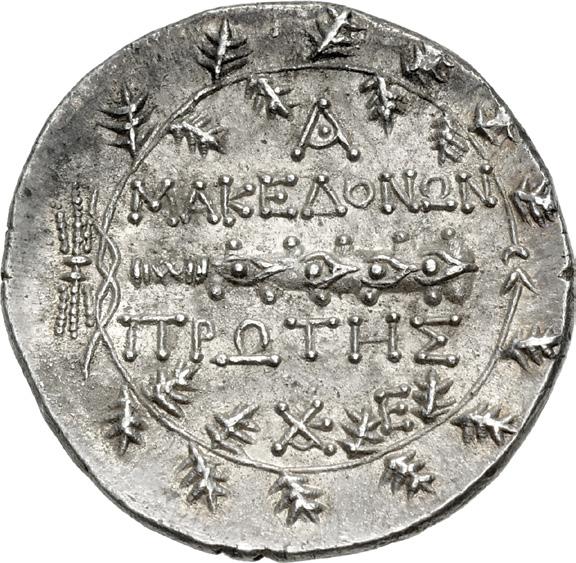

448. MACEDON, Roman Republican period. First Meris Circa 174/3-149 BC. AR Tetradrachm (32.5mm, 16.84 g, 9h). Amphipolis mint. Struck circa 174/3-158 BC. Diademed and draped bust of Artemis right, bow and quiver over shoulder, in the center of a Macedonian shield ornamented with stars within crescents, ≥ between each set / Club right; v and µÅkEdo@W@ above; below, ∏rWt˙% above  and E; all within oak wreath, thunderbolt to left. Prokopov, Silver, Group I.A, 15-23 & 26-34 var. (unlisted dies); HGC 3, 1103. Iridescent tone, light porosity. Near EF. Struck from fresh dies. ($750)



449. MACEDON, Roman Republican period. First Meris Circa 174/3-149 BC. AR Tetradrachm (30mm, 16.77 g, 9h). Amphipolis mint. Struck circa 158-149/8 BC. Diademed and draped bust of Artemis right, bow and quiver over shoulder, in the center of a Macedonian shield ornamented with stars within crescents, ≥ between each set / Club right; 1 and µÅkEdo@W@ / ∏rWt˙% below; all within oak wreath, thunderbolt to left. Prokopov, Silver, Group I.B, 155 (O45/R132); HGC 3, 1103. Lightly toned. Near EF. ($750)



450. MACEDON, Roman Republican period. Aesillas. Quaestor, circa 95-70 BC. AR Tetradrachm (31mm, 16.84 g, 12h). Uncertain mint. MAKЄΔONΩN, head of the deified Alexander the Great right; # below chin / AESILLAS, Q, money chest, club, and chair; all within wreath, [B at lower knot of wreath]. Bauslaugh Group III, obv. die O14; HGC 3, 1110. Toned, minor scratches. EF. ($1000)
From the JTB Collection. Ex Triton XXVI (10 January 2023), lot 537.

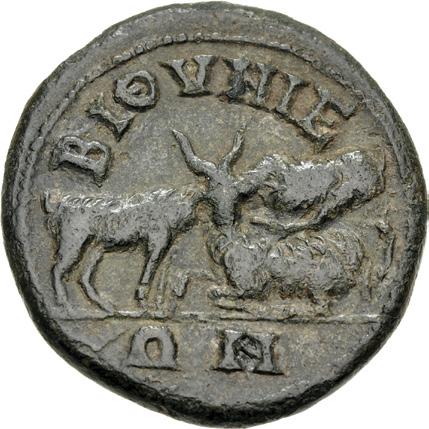

451. BITHYNIA, Claudiopolis (as Bithynium). Elagabalus. AD 218-222. Æ Assarion (22.5mm, 6.15 g, 6h). M AYP ANT ΩNINOC A, laureate head right / BIΘYNIЄΩN, three goats playing. RG 57; RPC VI Online 3665 corr. (obv. legend); BMC 13. Brown patina, some roughness. Near VF. Extremely rare, only three recorded in RPC, none in CoinArchives. ($750)
From the CLA Collection, purchased from John Jencek.



452. BITHYNIA, Heraclaea Pontica. Septimius Severus. AD 193-211. Æ (31mm, 18.23 g, 6h). AVT • K • Λ • CЄΠ • CЄVHPOC Π, laureate, draped, and cuirassed bust right, seen from behind / HPAKΛHAC ЄN ΠONTΩ, Herakles advancing right, carrying the Erymanthean boar on far shoulder over which is draped his lion’s skin. RG 107bis = Voegtli type 3, pl. 3, a; SNG von Aulock –; Mionnet Supp. V 300. Dark green patina that is slightly chipped in a few areas around the edge, slight porosity. Good VF. Fine style mythological scene. Very rare. ($3000)
Ex Triton XVI (8 January 2013), lot 693; Cornelius C. Vermeule III Collection.
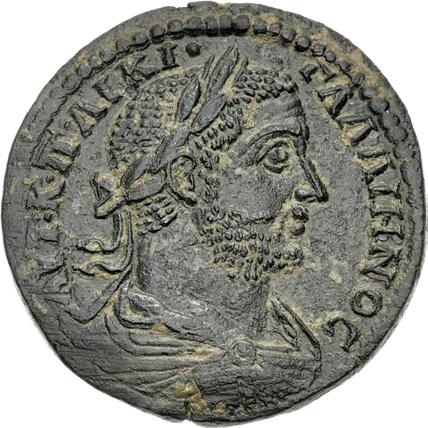

453. MYSIA, Pergamum. Gallienus. AD 253-268. Æ (36mm, 23.50 g, 6h). Sextus Claudius Silanus, magistrate. AYT • K • Π ΛIKI • ΓAΛΛIHNOC, laureate, draped, and cuirassed bust right, seen from behind / ЄΠ CЄΞ KΛ CЄIΛIANOY ΠЄPΓAMHN/ΩN ΠPΩTΩN Γ N/ЄΩKOP, wreath with OΛ/YMΠ/IΛ in three lines, flanked by two prize crowns, each containing a palm frond; all set on prize table seen in perspective; below, two purses and whips with vase between them; in upper field, A. Weisser 2533; RPC X Online 62141.3 (this coin); SNG BN 2299 (same dies). Dark brown patina with light earthen deposits, slight roughness, die shift on reverse. Near EF. Extremely rare, only three recorded in RPC. ($2000)
From the collection of Major Anthony F. Milavic, USMC (Ret.). Ex Leu 48 (10 May 1989), lot 406.
By the mid second century BC, Pergamum had become the the most important center of sport and physical education in the Hellenistic east. Its Nikephoria games, held every three years, had nearly the prestige and appeal of great Panhellenic games, including the Olympics, upon which they were modeled. By the second century AD, the Olympic name had even been “franchised,” in a manner still poorly understood, for use at sporting contests far removed from the original quadrennial festival still held at the ancestral home of Olympia. The contests at Pergamum now honored the Roman emperors and bore the name Olympic, as attested by the reverse of this remarkable medallion, which shows the prizes awarded to the victors in the various athletic, equestrian and artistic contests, all arrayed on and around a table. The laurel wreath enclosing the name “Olympia” was likely for the winner of the premier event of the games, possibly the “stadion” foot race. The A in the upper field of this coin commemorates Pergamum as the first city to be honored as the first thrice neokorate.




454. IONIA, Ephesus. Circa 1st-3rd centuries AD. Æ Tessera (17mm, 3.16 g, 12h). KHPIΛICωAЄΠPOCΠAΛYPIN, bee / Stag kneeling left, head right; Є Φ flanking, CKOΠI in exergue. Cf. SNG Copenhagen 355; cf. BMC 186; cf. SNG von Aulock 1875 (all with legend variations). Dark brown patina, minor marks. Choice EF. A superb example of the type, with exceptionally detailed engraving. ($1000)
From the Michael Rogal Collection. Ex Triton XXVII (9 January 2024), lot 466.
A number of bronze tesserae of the bee/stag type were struck at the cult center of Ephesus, likely during the 1st-3rd centuries AD, and are distinct from the widely varied lead issues from the same city. The legends on these bronzes cannot be translated and are, for the most part, meaningless mystical formulae, but are most likely related to the apotropaic and healing properties attributed to Artemis of Ephesus. (J. Obermajer, “The Tesserae of Ephesos in the History of Medicine,” in Medical History Vol. 12, No. 3 [1966], pp. 292–4).


455. IONIA, Ephesus. Gordian III. AD 238-244. Æ (36mm, 25.81 g, 6h). Homonoia with Alexandria in Egypt. AYT K M ANTΩ ΓOPΔIANOC, laureate and cuirassed bust right, seen from the front, gorgoneion on breastplate / OMONOIA EΦECIΩN K AΛЄΞANΔPЄΩN, cult statue of Artemis Ephesia, wearing kalathos, with supports, flanked by stags standing outward, looking up; to left, Isis standing facing, holding sistrum in right hand, situla in left; to right, Serapis standing facing, wearing kalathos, raising right hand and holding scepter in left; in upper field, crescent and star. Karwiese, MvE 5, 901 (V32/ R74, this coin illustrated); Franke & Nollé 546-8 (VsQ/Rs54); RPC VII.1 401.6 (this coin). Earthen brown patina, some roughness. Near VF. Rare. ($500)
From the CLA Collection. Ex Freeman & Sear 7 (22 February 2002), lot 282; G. Hirsch 189 (7 February 1996), lot 762.


456. LYDIA, Sardis. Caracalla. AD 198-217. Æ (38mm, 27.80 g, 6h). Antonius Rufus, first archon for the third time. AYT KAI M AYP CЄYH ANTΩNЄINOC, laureate and cuirassed bust right, seen from the front, wearing balteus over shoulder / ЄΠI AN POYΦOY APX A TO Γ CAPΔIANΩN B NЄKOPΩN, three agonistic prize crowns, each containing a palm frond, two purses between them; all set on prize table seen in perspective; below, vase with two whips flanking. Hochard 2010 (D223/ R500); Kurth 502; BMC 166. Dark green patina with spots of red, light roughness. Good VF. Very rare. ($1000)
From the collection of Major Anthony F. Milavic, USMC (Ret.). Ex Münzen und Medaillen GmbH 12 (11 April 2003), lot 208; Mozelt 34 (November 1985), lot 176.


457. LYDIA, Sardis. Philip I. AD 244-249. Æ (34mm, 26.06 g, 11h). Aurelius Herakleidianos, strategos. AYT K M IOYΛ ΦIΛiΠΠOC AYΓ, laureate, draped, and cuirassed bust right, seen from the front / ЄΠ CTP AYP HPAKΛЄIΔIANOY CAPΔIANΩN B NЄΩK, Chrysanthina wreath enclosing XPYCANΘINA A. Hochard 2133 (D309/R653); Kurth 681; RPC VIII Online 20239 (this coin cited). Brown patina, some smoothing and cleaning marks. VF. Very rare. ($750)
From the collection of Major Anthony F. Milavic, USMC (Ret.). Ex Gorny & Mosch 122 (10 March 2003), lot 1795; Gorny & Mosch 107 (2 April 2001), lot 311.
The Chrysanthina flower, modern Mediterranean Strawflower, gave its name to the Chrysanthian Games, founded between 150 and 175 AD. The games honor Persephone, who was said to be picking these flowers in a field near Sardis when she was abducted by Hades and taken to be his wife as queen of the underworld. The prize wreath given to the winners of these games was made of these flowers.


458. LYDIA, Sardis. Gallienus. AD 253-268. Æ (38mm, 26.78 g, 6h). Domitius Rufus, asiarch for the second time, and Kratistos, first archon. AYT K Π ΛIK ΓAΛΛIHNOC AY, radiate, draped, and cuirassed bust right, seen from behind / ЄΠI ΔOM POYΦOY ACIAPX K YIOY B APX K KPATICT APX A CAPΔIA/NΩN Γ NЄKOP/ΩN, three agonistic prize crowns, each containing a palm frond, set upon table, seen in perspective. Hochard 2157 corr. (obv. legend; D324/R686); Kurth 719 corr. (same); RPC X Online 84190 corr. (same; this coin the second listed, and illustrating the type); SNG von Aulock 8262. Green patina, die shift on reverse. Good VF. Extremely rare, one of three listed in RPC (including the two known to Hochard); this the finest of the three. ($500)
From the collection of Major Anthony F. Milavic, USMC (Ret.). Ex Aufhäuser 7 (8 October 1990), lot 660.



459. CARIA, Stratonicaea. Septimius Severus, with Geta as Caesar. AD 193-211. Æ (37mm, 28.32 g, 5h). Damnatio Memoriae. Philon, prytanis. AY K Λ CЄ CЄYHPOC ΠЄ AY CЄΠ ΓЄTAK C K, laureate, draped, and cuirassed bust of Septimius vis-à-vis [laureate, draped, and cuirassed bust of Geta]; c/ms: helmeted bust of Roma within circular incuse, and ΘEOY within rectangular incuse / ЄΠ ΠPY ЄΠI[TYNXANO]NTOC Γ ΦIΛΩNOC CTPATONIKЄΩN, Hecate standing facing, head left, wearing kalathos, holding patera in right hand and torch in left; at feet left, lighted altar. BMC 71; SNG von Aulock 2678. For c/ms: Howgego 188 and 536. Brown patina, flan adjustment marks. Good VF. Rare. Portrait of Geta erased, Caracalla’s Damnatio Memoriae of Geta applied after his murder in AD 211. ($500)
Upon Septimius’ passing in AD 211, his sons Caracalla and Geta assumed joint rule of the empire. Their joint rule was a failure, the Imperial Palace was separated into two sections and they threatened to divide the empire between them. During the Festival of Saturnalia, December 211, Caracalla tried unsuccessfully to have his brother assassinated. But a week later, at an arranged meeting in their mother’s quarters, Geta was murdered by Caracalla’s centurions.
Caracalla immediately ordered a damnatio memoriae of his brother’s image: statues were removed, paintings were destroyed or, like the Severan Tondo erased, and coins were recalled to have his image carved out. This damnatio was especially apparent on the provincial coinage of Pergamum in Mysia and Stratonicaea in Caria. It is estimated that approximately 95% of the dual bust types at Stratonicea have had the portrait of Geta erased, many of them having a countermark of Roma or Caracalla stamped over his bust.


460. CARIA, Stratonicaea. Septimius Severus, with Julia Domna. AD 193-211. Æ (34mm, 19.34 g, 12h). Flavius Leon Lena, archon. Struck circa AD 205-209. [AY] KAI CЄY[HPOC] IOYΛI[A ΔOMNA], laureate, draped, and cuirassed bust of Septimius vis-à-vis draped bust of Domna; c/ms: helmeted head of Roma within circular incuse, and ΘEOY within rectangular incuse / ЄΠI ΦΛ ΛЄONTOC ΛЄN A APX CTPATO[NIKЄΩN], Hecate standing facing, head left, wearing kalathos, holding patera in right hand and torch in left; at feet left, dog standing left, looking right. BMC 54; SNG von Aulock 2675. For c/ms: Howgego 188; 536. Dark brown patina with green highlights, minor marks. Near EF ($500)
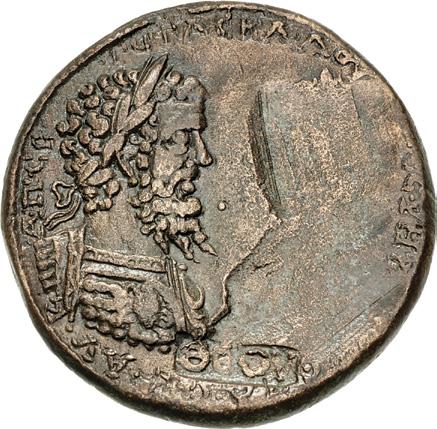


461. CARIA, Stratonicaea. Septimius Severus, with Geta as Caesar. AD 193-211. Æ (36mm, 27.43 g, 6h). Damnatio Memoriae. Iouliades, son of Hierokles, prytanis. AY K Λ Π CЄ ΓЄTAC KAI ΛOY CЄΠ CЄYHPOC, laureate and cuirassed bust of Septimius, gorgoneion on breastplate vis-à-vis [laureate, draped, and cuirassed bust of Geta]; c/m: ΘEOY within rectangular incuse / ЄΠI ΠP IOYΛIAΔOY TOY IЄPOKΛЄOYC CTPATONIK/ЄΩN, Zeus Panamaros, draped, on horseback right, holding transverse scepter in left hand; at feet right, lighted altar. SNG von Aulock 2679. For c/m: Howgego 536. Redbrown surfaces, light porosity, slight die shift on reverse. Near EF. Portrait of Geta erased, Caracalla’s Damnatio Memoriae of Geta applied after his murder in AD 211. ($750)



462. CARIA, Stratonicaea. Caracalla, with Plautilla. AD 198-217. Æ (37.5mm, 27.06 g, 12h). Claudius Nikephoros, son of Dionysios, prytanis. Struck circa AD 202-203. AY K AN KAI ΘЄ CЄB NЄ ΠΛAYTIΛΛAN, laureate, draped, and cuirassed bust of Caracalla vis-à-vis draped bust of Plautilla; c/ms: helmeted head of Roma within circular incuse, and ΘEOY within rectangular incuse / ЄΠI TΩN NЄΠ ΠЄP TB KΛ ΔIOИYCIO И CTPATOИЄIKЄΩИ, Hecate standing facing, head left, wearing kalathos, holding patera in right hand and torch in left; at feet left, dog standing left, looking right. Cf. BMC 65 (different magistrate, same obverse); cf. CNG E-563, lot 461 (same magistrate, different obverse). For c/ms: Howgego 188; 536. Dark brown patina with green highlights, minor marks and scratches, slight die shift on reverse. VF. Presently unique. ($500)
Three Carian cities - Alinda, Alabanda, and Stratonicaea - commemorated the marriage between Caracalla and Plautilla by issuing coins with dual portraits proclaiming the young empress as “the new goddess Hera.” As Ken Harl notes (Civic Coins and Civic Politics in the Roman East: A.D. 180-275 [Berkeley, CA: University of California Press], p. 41): “By implication, Caracalla was envisioned as a youthful Zeus, so that the imperial marriage became a symbolic reenactment of the celestial one.”
The obverse die used for this coin is known for a similar type struck by the grammateus Tiberius Claudius Dionysios, but not Claudius Nikephoros. Another unique feature of this coin is the reverse legend beginning at 10:00 o’clock, the legend typically begins at 7:00.


463. CARIA, Stratonicaea. Caracalla, with Plautilla. AD 198-217. Æ (38.5mm, 24.59 g, 12h). Claudius Nikephoros, son of Dionysios, prytanis. Struck circa AD 202-203. ANTΩ NINOC NЄA Θ HP ΠΛAYTIΛΛA [AYΓO]Y, laureate, draped, and cuirassed bust of Caracalla vis-à-vis draped bust of Plautilla; c/ms: helmeted head of Roma within circular incuse, and ΘEOY within rectangular incuse / ЄΠI KΛ NЄIKHΦOPOY ΔIONYCIOY CTPATONIKЄΩN, Hecate standing facing, head left, wearing kalathos, holding patera in right hand and torch in left; at feet left, dog standing left, looking right. CNG E-563, lot 461; CNG E-306, lot 255, otherwise unpublished. For c/ms: Howgego 188; 536. Red-brown surfaces, light porosity, flan adjustment marks. Near EF. Very rare, one of the finest known. ($750)



464. CARIA, Stratonicaea. Caracalla, with Geta as Caesar. AD 198-217. Æ (34mm, 29.29 g, 7h). Damnatio Memoriae. Iouliades, son of Hierokles, prytanis. [A]NTΩI KA ΠO CЄ [ΓЄTAN], [laureate, draped, and cuirassed bust of Geta] visà-vis laureate, draped, and cuirassed bust of Caracalla; c/ms: helmeted head of Roma within circular incuse, and ΘEOY within rectangular incuse / ЄΠ ΠPY IOY[ΛIAΔOY TOY IЄPO]KΛЄ CTPATONIKЄ/ΩN, Hecate standing facing, head left, wearing kalathos, holding patera in right hand and torch in left; at feet left, lighted altar. Cf. SNG Leypold 849 (Geta on left, different magistrate); unpublished for this magistrate. For c/ms: Howgego 188; 536. Red-brown surfaces, light porosity. Near EF. Extremely rare, presently unique. Portrait of Geta erased, Caracalla’s damnatio memoriae of Geta applied after his murder in AD 211. ($1000)



465. CARIA, Stratonicaea. Caracalla, with Geta as Caesar. AD 198-217. Æ (38mm, 22.61 g, 12h). Damnatio Memoriae. Flavius Leon Lena, archon. Struck under Septimius Severus, circa AD 205-209. AY KAI MAP AY AИ TΩИ[...], laureate, draped, and cuirassed bust of Caracalla vis-à-vis [bareheaded, draped, and cuirassed bust of Geta]; c/ms: helmeted head of Roma within circular incuse, and ΘEOY within rectangular incuse / ЄΠI APXON ΛЄONT OC ΛЄ CTPATONIKЄ/И-Ω, Hecate standing facing, head left, wearing kalathos, holding patera in right hand and torch in left; at feet left, dog standing left, looking right. SNG von Aulock 2686 var. (legends); Sternberg 10, lot 467 (same dies). For c/ms: Howgego 188, 536. Brown patina with green highlights, minor marks, edge bump. Good VF. Portrait of Geta erased, Caracalla’s damnatio memoriae of Geta applied after his murder in AD 211. ($500)
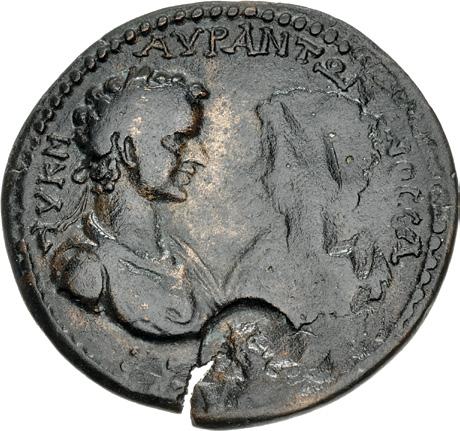
Unpublished and Presently Unique
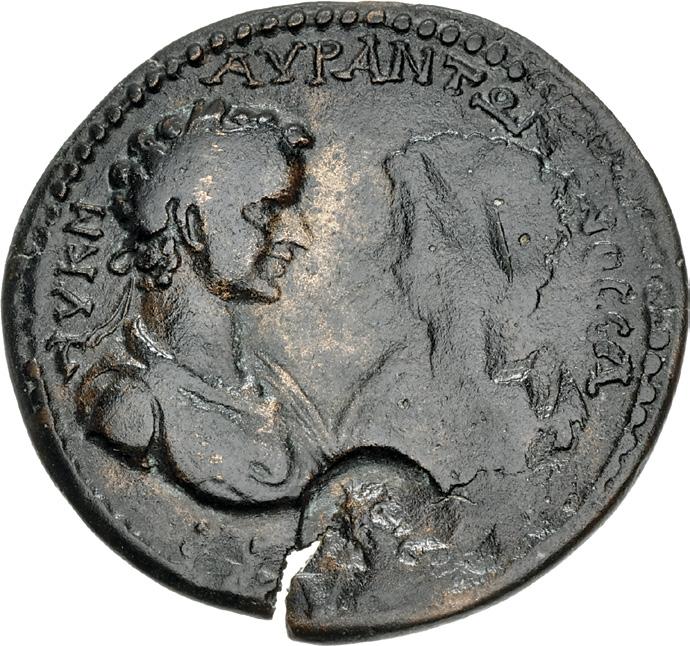

466. CARIA, Stratonicaea. Caracalla, with Geta as Caesar. AD 198-217. Æ (38mm, 16.68 g, 12h). Damnatio Memoriae. Zosimos II, grandson of Posittos, prytanis. Struck under Septimius Severus, circa AD 198-202. AY K M AYP ANTΩN INOC C Λ [CЄ ΓЄTA]C K, laureate, draped, and cuirassed bust of Caracalla vis-à-vis [bareheaded and draped bust of Geta]; c/m: laureate bust of Caracalla right within circular incuse / ΠPY ZΩCIMOY TOY ΠPOCIC TOY B CTPATONIKЄΩN, Hecate standing facing, head left, wearing kalathos, holding patera in right hand and torch in left; at feet left, dog standing left, looking right. SNG von Aulock 2692 var. (Geta on right, rev. legends). For c/m: Howgego 84. Red-brown surfaces, scratches, flan crack. VF. Extremely rare, presently unique. Portrait of Geta erased, Caracalla’s Damnatio Memoriae of Geta applied after his murder in AD 211. ($750)
This combination of obverse die, with Geta on the right, and reverse legend, is unrecorded with the Hecate reverse type. This obverse is previously only known on a reverse with Zeus Panamaros, from the same magistrate, the reverse legend is unrecorded.



467. CARIA, Stratonicaea. Caracalla, with Geta as Caesar. AD 198-217. Æ (34mm, 17.69 g, 12h). Damnatio Memoriae. Iason, son of Cleoros, grammateus. Struck under Septimius Severus, circa AD 205-209. AY KAI MAP AY AИ[...], laureate, draped, and cuirassed bust of Caracalla vis-à-vis [bareheaded, draped, and cuirassed bust of Geta]; c/m: ΘEOY within rectangular incuse / ЄΠI ΓPA IACON[OC TOY KΛЄOPOY] CTPATON[IKЄΩN], Zeus Panamaros, draped, on horseback right, holding transverse scepter in left hand; at feet right, lighted altar. SNG von Aulock 2685. For c/m: Howgego 536. Brown patina, light roughness, spots of verdigris. Good VF. Rare. Portrait of Geta erased, Caracalla’s damnatio memoriae of Geta applied after his murder in AD 211. ($500)



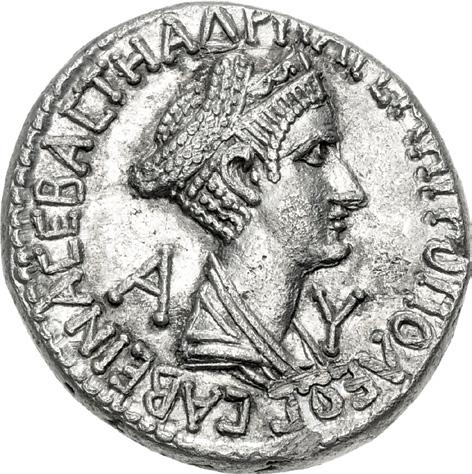
468. CILICIA, Tarsus. Hadrian, with Sabina. AD 117-138. AR Tetradrachm (25mm, 13.74 g, 1h). Struck AD 128136. AYT KAI ΘE TPA ΠAP YI ΘE NEP YI TPAI AΔPIANOC CE, laureate and draped bust of Hadrian right, club below; to right, ΠΠ monogram / CABEINA CEBACTH AΔPI TAPC MHTPOΠOΛEOC, draped bust of Sabina right, wearing stephane; A Y across field. RPC III 3275A; SNG BN –; Prieur –. Toned, light roughness, trace deposits. Near EF. The second known specimen. Two fine portraits. ($1500)
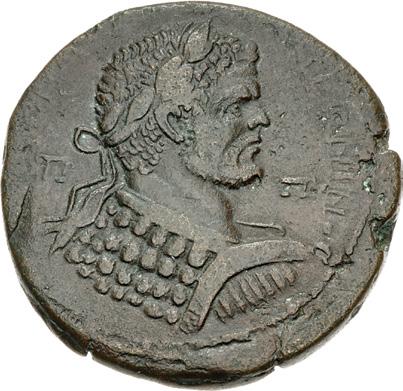


469. CILICIA, Tarsus. Caracalla. AD 198-217. Æ (33.5mm, 20.50 g, 11h). [AYT KAI M AYP CЄYHPOC] ANTΩNЄINOC, Π Π, laureate and cuirassed bust right, seen from behind / ANTΩNIANHC CЄYH AΔP MYT TAPCOY; A/M/K|Δ/ЄZ/K, Artemis kneeling right, grabbing stag by its antlers with her knee in its back, about to plunge a dagger into its throat. SNG BN –; SNG Levante –; SNG Tahberer 1508. Brown patina, slight roughness, edge flaws. Near VF. Extremely rare. ($2000)
Ex Roma 7 (22 March 2014), lot 875 (hammer £4,000).




470. CAPPADOCIA, Caesarea-Eusebia. Divus Augustus, with Divus Julius Caesar. Died AD 14. AR Didrachm (24.6mm, 6.97 g, 1h). Struck circa AD 32-65 (Tiberius to Nero). DIVVS AVG, radiate head of Divus Augustus right / [...] CAES, laureate head of Divus Julius Caesar right; below left, star. Ganschow, Münzen –; RPC I –; Sydenham, Caesarea –. Unpublished. Lightly toned, some porosity, minor marks and scratches, edge filing, banker’s mark. Near VF. Overstruck, undertype not visible but most likely on the Artaxias/Germanicus type. ($5000)
This unique didrachm combines two divus types not previously known; not just unrecorded for Caesarea, but unrecorded in the entire Roman provincial series. It is unique for a number of reasons: the Divus Augustus types at Caesarea are all left facing, are only known as drachms, and they all use the longer AVGVSTVS form of his name. A coin, of any denomination, is not known for Divus Julius Caesar from Caesarea struck by any emperor. We can date this coin with certainty from the reign of Tiberius to Nero; all of the Divus Augustus coins were struck by Tiberius in the name of Germanicus but in the smaller drachm denomination. The first didrachms struck in Caesarea are dated by Ganschow as early as Tiberius’ Germanicus issues (AD 32-34) whereas the last divus types were Nero’s Divus Claudius didrachms (AD 63-65).

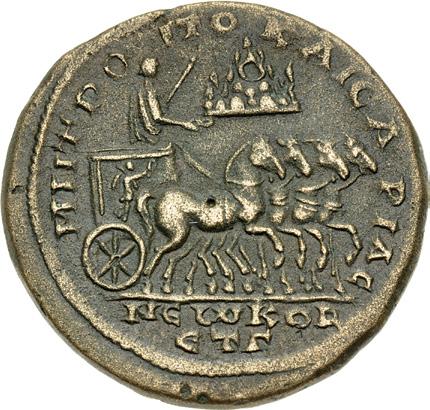
471. CAPPADOCIA, Caesarea-Eusebia. Severus Alexander. AD 222-235. Æ Double Unit (35.5mm, 25.37 g, 12h). Dated RY 3 (AD 223/4). AY K CЄOYH AΛЄΞANΔ, laureate and cuirassed bust right, seen from the front, gorgoneion on breastplate, left hand holding scepter over shoulder / MHTPOΠO KAICAPIAC NЄωKOP, Severus Alexander, in military dress, holding scepter in left hand and patera in right, driving slow quadriga right, decorated with crowning Nike; in upper field, Mount Argaeus; ЄT Γ (date) in exergue. Ganschow, Münzen 740; RPC VI Online 6744; Sydenham, Caesarea 546. Yellow-brown surfaces, light porosity. VF. Very rare, only three specimens known to Ganchow and RPC. ($750)


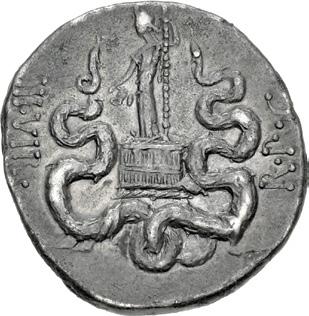
472. ASIA MINOR, Uncertain. Mark Antony and Octavia. Summer-autumn 39 BC. AR Cistophorus (26mm, 11.87 g, 12h). Ephesus mint(?). Conjoined heads right of Mark Antony, wearing ivy wreath, and Octavia, slight drapery; Â • ANTONiuÍ iÂp • COÍ • DeÍig • iTer eT • TerT • around / Dionysus, holding cantharus in right hand and thyrsus in left, standing left on cista mystica, flanked by interlaced serpents; iii • uir • downward to left, r • p • C upward to right. Hiltmann, Type 2; RPC I 2202 (Cistophoric Mint); CRI 263; Sydenham 1198; RSC 3. Toned, with hints of iridescence and luster, graffito in field on obverse. Good VF. ($1000)
From the Michael Rogal Collection. Ex Goldman Collection (Triton XVI, 8 January 2013), lot 950; Classical Numismatic Group Electronic Auction 156 (17 January 2007), lot 136.



473. ASIA MINOR, Uncertain. Augustus (as Octavian). 27 BC-AD 14. AR Cistophorus (26mm, 11.82 g, 1h). Ephesus mint(?). Struck 28 BC. iÂp • CAeÍAr • Diui • F • COÍ ui LiBerTATiÍ • p • r • uiNDex, laureate head right / Pax, draped, standing left, holding caduceus with her right hand; behind her, in right field, a snake emerging from cista mystica; all within laurel wreath; pAx in left field. Sutherland Group I, 69 var. (O48/R– [rev. die unrecorded]); CRI 433; RPC I 2203 (Cistophoric mint); RSC 218. Toned, with hints of iridescence and luster, minor scratches and porosity on reverse. Good VF. ($750)


474. ASIA MINOR, Uncertain. Augustus. 27 BC-AD 14. AR Cistophorus (27mm, 12.08 g, 12h). Ephesus mint(?). Struck circa 25-20 BC. iÂp • CAe ÍAr, bare head right / Au2uÍTuÍ, garlanded and filleted altar decorated with stags standing vis-à-vis. Sutherland Group VIγ, 366 (O123/R22, this coin illustrated); RPC I 2215 (Cistophoric Mint); RSC 33. Deeply toned, minor porosity, die flaws, a few light scratches. Near EF. ($1000)
Ex Neal Archer Collection (Noble Numismatics 122, 19 November 2019), lot 3193; Münzhandlung Basel 10 (15 March 1938), lot 513; A. Hess 207 (1 December 1931), lot 918.




475. ASIA MINOR, Uncertain. Augustus. 27 BC-AD 14. AR Cistophorus (28mm, 11.38 g, 12h). Ephesus mint(?).
Struck circa 25-20 BC. imp • CAe ÍAr, bare head right / Au2uÍTuÍ, capricorn right, head left, cornucopia on its back; all within laurel wreath. Sutherland Group VIα 417 var. (O156/R– [rev. die unlisted]); RPC 2213 (Cistophoric mint); RSC 16. Toned, minor marks. Near EF. ($750)
Ex Naville Numismatics 71 (13 February 2022), lot 370.
The capricorn represents Augustus’ birth sign and appeared often as a coin type during his reign. Adding the cornucopia, or horn of plenty, to the back of the capricorn symbolizes the prosperity brought about by the emperor, whose victories are symbolized by the laurel wreath.




476. CYPRUS, Koinon of Cyprus. Diva Faustina Senior, with Galerius Antoninus. Died AD 140/1 and before AD 138, respectively. Æ As or Dupondius (27mm, 10.56 g, 12h). Dies likely produced in Rome. Struck AD 140/1. ΘЄA ΦAYCTЄINA, veiled and draped bust of Diva Faustina right / M ΓAΛЄPIOC ANTωNINOC AYTOKPATOPOC ANTωNINOY YIOC, bareheaded and draped bust of Galerius Antoninus right. Overbeck, Galerius 9-16 (Vs:9/Rs:1); Parks 22; RPC IV.3 Online 8345. Brown patina, smoothing. EF. Very rare. ($2000)
Marcus Galerius Aurelius Antoninus was the son of Antoninus Pius and Faustina Senior. He died in infancy or childhood, before Antoninus became emperor in AD 138; a sepulchral inscription for him is in the Mausoleum of Hadrian. This provincial issue is the only coin naming him.
Of the sixteen specimens illustrated in RPC, a third of the museum pieces are casts or outright forgeries, illustrating how difficult it was for the major museums to acquire authentic specimens for their permanent collections. Of the remaining sales records, most have been tooled to some degree. While this coin shows evidence of smoothing there are no signs of tooling; this is the finest known example.

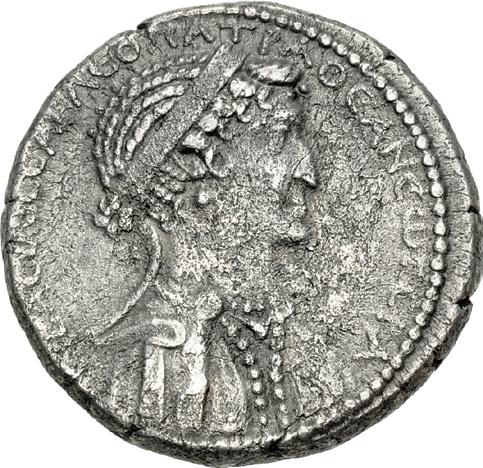

v 477. SELEUCIS and PIERIA, Antioch. Mark Antony & Cleopatra VII of Egypt. 36 BC. AR Tetradrachm (27mm, 15.25 g, 1h). Struck circa 36-34 BC. BACIΛICCA KΛЄOΠATPA ΘЄA NЄωTЄPA, diademed bust of Cleopatra right, wearing earring, necklace, and embroidered dress / ANTωNIOC AVTOKPATωP TPITON TPIωN ANΔPωN, bare head of Antony right. McAlee 174; RPC I 4094; Prieur 27; HGC 9, 1361. Toned, porosity, surface cracks and scratches. VF. ($5000)

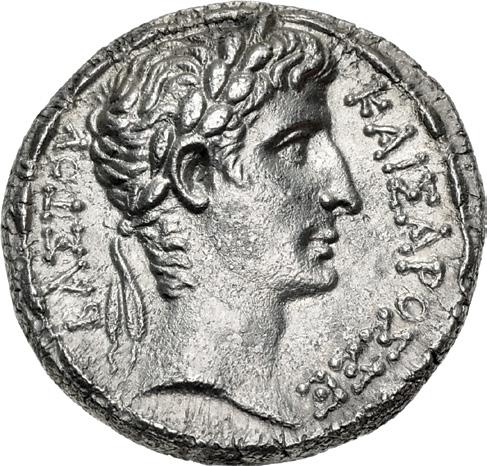

478. SELEUCIS and PIERIA, Antioch. Augustus. 27 BC-AD 14. AR Tetradrachm (27mm, 15.08 g, 12h). Dated year 30 of the Actian Era (with Cos. XIII, 2 BC). KAIΣAPOΣ ΣE BAΣTOY, laureate head right / ETOVΣ Λ (Actian era date) NIKHΣ, Tyche seated right on rocky outcropping, holding palm frond in right hand; below, half-length figure of river-god Orontes swimming right; in right field, i (=ΥΠΑTOY) and IΓ (consular iteration) above |(=ANTIOXIEΩN?). McAlee 185; RPC I 4156; Prieur 55; DCA2 288. Lightly toned, with slight porosity. Superb EF. Well centered and struck. ($750)
From the CLA Collection, purchased from Jonathan Kern.




479. JUDAEA, Herodians. Herod IV Philip. 4 BCE-34 CE. Æ (13mm, 2.08 g, 11h). Caesarea Panias mint. Dated RY 34 (CE 30/1). Head right / l¬d (date) within wreath. Meshorer 108; Hendin 6263; RPC I 4950; Sofaer 143. Dark brown surfaces, slight roughness. VF. Very rare. Finer than any specimen in CoinArchives. ($1000)


480. JUDAEA, Herodians. Agrippa I. 37-43 CE. Æ (20.5mm, 8.00 g, 12h). Caesarea Maritima mint. Dated RY 7 (43/4 CE). [BAΣIΛEYΣ] MEΓAΣ A[ΓPIΠΠAΣ ΦIΛOKAIΣA], laureate head right / [KAIΣAPIA H ΠPOΣ TΩ] CE BACTΩ ΛI MENI, Tyche Soterios standing left, holding rudder in right hand and palm frond in left; L Z (date) to right. Meshorer 126; Hendin 6280; RPC I 4985 corr. (palm frond not cornucopia); Sofaer 165-6. Earthen brown surfaces, smoothing, cleaning marks. Near VF. Rare. ($1500)
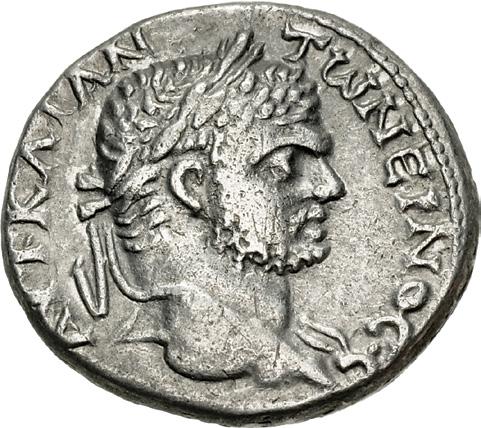



481. JUDAEA, Aelia Capitolina (Jerusalem). Caracalla. AD 198-217. BI Tetradrachm (26.5mm, 13.53 g, 6h). Struck circa AD 215-217. AVT KAI AN TωNЄINOC C, laureate bust right, slight drapery / ΔHMAPX Є Ξ VΠATOCTO Δ, laureate head of Caracalla right above eagle standing facing, head and tail right, with wings displayed; to right, filleted thyrsus. Meshorer, Aelia 87a corr. (bust); Prieur 1613 corr. (same); Sofaer –. Lightly toned, light porosity, minor marks and scratches. Good VF. Extremely rare, two known to Bellinger and Prieur. ($2000)
The Finest Known


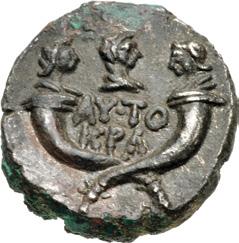

482. EGYPT, Alexandria. Claudius, with Britannicus, Antonia, and Octavia. AD 41-54. BI Didrachm (19mm, 6.48 g, 12h). Dated RY 3 (AD 42/3). TI KΛAY KAI CEBAC ΓEPM, laureate head right; L Γ (date) before / AYTO/KPA in two lines, crossed cornucopias, each surmounted by female bust (Antonia and Octavia), vis-à-vis; between them, bust of a young boy right (Britannicus). Köln –; Dattari (Savio) 118; K&G 12.24; RPC I 5135; Emmett 75.3 (R3); B. Lichocka, “Claudius’s Issue of Silver Didrachms in Alexandria: Emperor’s Children and Crossed Cornucopias” in Ètudes et Travaux XXVI (Institute of Mediterranean and Oriental Cultures, Polish Academy of Sciences, Warsaw, 2013), pp. 428-45. Toned, small spots of verdigris. Near EF. Very rare. Nine specimens known to RPC, all in well worn condition; this is the finest known. ($3000)
An extremely rare coin, and the only collectible didrachm (billon or otherwise) issued in Alexandria during the Roman period. (Erik Christiansen in The Roman Coins of Alexandria lists two unique didrachms for Nero, regnal years 3 and 4, the first in Athens, the second in Berlin). Claudius also issued a billon drachm (RPC I 5136), which is of equal rarity


483. EGYPT, Alexandria. Vespasian, with Titus as Caesar. AD 69-79. Æ Drachm (33.5mm, 19.13 g, 12h). Dated RY 9 (AD 76/7). AYTOK KAIΣ ΣEBA OYEΣΠAΣIANOY, Laureate head of Vespasian right; L ENAT (date) in legend / • AYTOKRATOPOΣ • TITOY • KAIΣAPOΣ, laureate head of Titus right. Köln 313; Dattari (Savio) 352; K&G 20.65; RPC II 2456; Emmett 209.1. Dark brown surfaces, slight roughness, trace deposits, scrapes. Near EF. Rare. Superior to any recorded in RPC. ($1500)



484. EGYPT, Alexandria. Hadrian. AD 117-138. Æ Hemidrachm (27mm, 13.52 g, 11h). Dated RY 11 (AD 126/7).
AYT KAI TPAI AΔPIA CЄB, laureate, draped, and cuirassed bust right, seen from behind / Pharos of Alexandria surmounted by two Tritons, each blowing a buccinum (trumpet), lantern surmounted by statue holding situla in right hand and scepter in right, entryway at bottom right; L EN∆E KATOV (date) around. Köln 975; Dattari (Savio) 1932 & 7856; K&G 32.423; RPC III 5673; Emmett 1103.11 (R3). Brown surfaces, some roughness and scrapes, smoothing. Good VF. ($500)
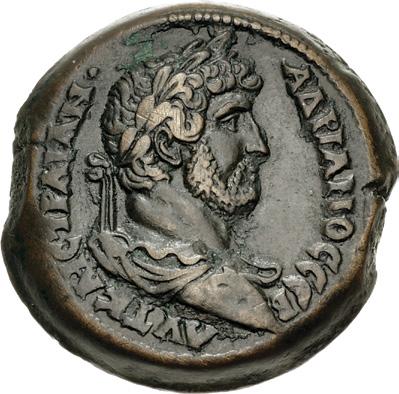


485. EGYPT, Alexandria. Hadrian. AD 117-138. Æ Drachm (32.5mm, 26.87 g, 12h). Dated RY 18 (AD 133/4). AYT
KAIC TPAIAN • AΔPIANOC CЄB, laureate, draped, and cuirassed bust of Hadrian right, seen from behind / Beardless sphinx standing left on serpent, wearing crown of solar disk, horns and feathers, crocodile emerging from its chest, with Uraeus tail; on its back, griffin seated left, right paw on wheel; L IH (date) above. Köln 1132; Dattari (Savio) 2004; K&G 32.597; RPC III 5912; Emmett 1056. Brown patina, minor deposits, scrapes and minor metal flaws on reverse. Good VF. Very rare beardless sphinx variety. RPC notes the variety but does not separate them from the others of this entry, only one beardless variety recorded. ($2000)
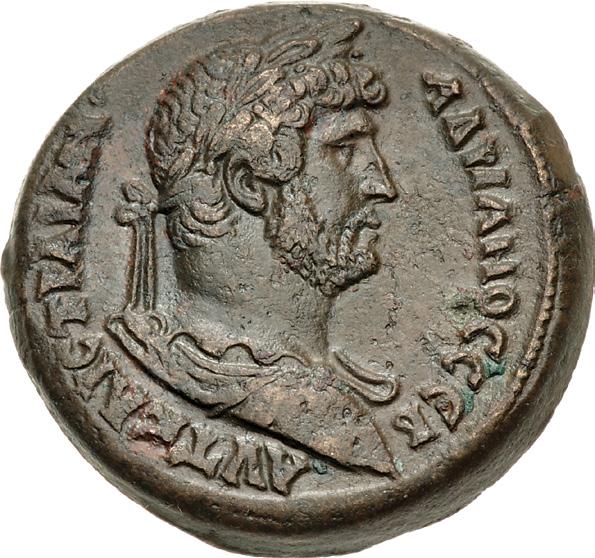



486. EGYPT, Alexandria. Hadrian. AD 117-138. Æ Drachm (33mm, 27.59 g, 12h). Dated RY 18 (AD 133/4). AYT KAIC TPAIAN AΔPIANOC CЄB laureate, draped, and cuirassed bust right, seen from behind / Tabernacle of the Canopic Jars: Distyle temple, each capital topped with lotus blossoms, solar disk with two Uraei in pediment; within, two Canopic jars set upon pillows; jar on left wears an Atef crown, body adorned with drapery and pearl necklaces; jar on right wears a crown with ram’s horns, solar disk, and feathers, body adorned with breastplate; L I H (date) across field. Köln 1141-2 var. (placement of date); Dattari (Savio) 1951; K&G 32.605; RPC III 5917; Emmett 935.18. Dark brown patina, minor marks and pits. Near EF. Well detailed, superb. None finer in RPC or CoinArchives, easily the finest to appear on the market in at least 20 years. ($3000)



487. EGYPT, Alexandria. Antoninus Pius. AD 138-161. Æ Drachm (35mm, 25.40 g, 12h). Dated RY 10 (AD 146/7). AYT K T AIΛ A∆P ANTωNINOC CЄB ЄYC, laureate head right / Herakles and the Stymphalian Birds – Herakles standing right, wearing lion’s skin over his head and down his shoulders, quiver at his hip, drawing arrow back in bow and pointing it slightly upward; before, two of the Stymphalian birds falling from the sky; L ΔЄKA TO Y (date) around. Köln 1538; Dattari (Savio) 2587; K&G 35.353; RPC IV.4 996.16 (this coin); Emmett 1543.10. Dark green patina with red, small edge splits, smoothed with details enhanced. Near VF. ($2000)
Ex Helios 8 (13 October 2012), lot 77.
The Stymphalian Birds were man-eating birds that had claws of brass, sharp metallic feathers they could launch at their victims, and highly toxic dung. Driven to the heavily wooded area around Lake Stymphalia by a pack of wolves, they bred quickly and took over the countryside, destroying local crops and fruit trees. They were also favorites of Ares. To complete this Labor, Athena and Hephaestos assisted Herakles by forging crotala, or large bronze clappers, by which the birds could be frightened into flight; then, Herakles shot them down with his arrows, as depicted on the coin type.


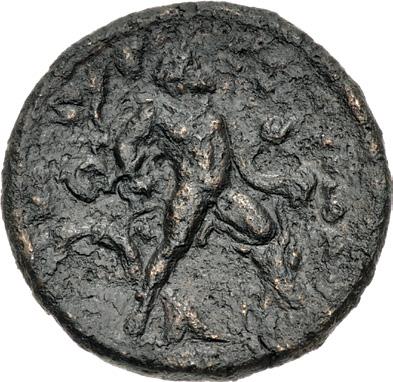
488. EGYPT, Alexandria. Antoninus Pius. AD 138-161. Æ Drachm (32mm, 26.53 g, 12h). Dated RY 18 (AD 154/5).
AYT K T AI AΔP ANTωNINOC CЄB ЄYC, laureate bust right, slight drapery on left shoulder / Lykurgos and the Vines of Dionysos – King Lykurgos right, his left knee kneeling on a vine stump, his arms pulled behind him by the vines, his head tilted up and his axe between his legs; [L I H (date) across field]. Köln –; Dattari (Savio) 8842; K&G 35.650; RPC IV.4 1700; Emmett 1603.18 (R5). Dark brown patina, roughness, scratches, scrape on obverse. Good Fine. Extremely rare. ($1500)
A rather obscure myth, in one version King Lykurgos is credited with defeating the army of Dionysos when the god invaded Thrace. Dionysos escaped by plunging into the sea and sought refuge in Thetis’ grotto. Dionysos’ mother, Rhea, upset by her son’s misfortune, drove Lykurgos mad and then helped her son’s army to escape. Lykurgos, in his madness, killed his own son Dryas with an axe (believing he was cutting down a vine, hence the coin type), and then pruned the corpse of its nose, ears, fingers, and toes. Dionysos, returning from the sea, told the people of Thrace that Lykurgos would have to be killed or the land would remain barren as punishment for Lykurgos’ crime. King Lykurgos was then killed by being drawn and quartered by wild horses.



489. EGYPT, Alexandria. Lucius Verus. AD 161-169. Æ Hemidrachm (28mm, 9.78 g, 12h). Dated RY 3 (AD 162/3). Λ AYPHΛIOC OYHPOC CЄB, laureate bust right, slight drapery on left shoulder / Sphinx reclining right; above, draped bust of Serapis right, wearing kalathos; L Γ (date) across field. Köln –; Dattari (Savio) 9501; K&G –; RPC IV.4 2521; Emmett 2454.3 (R5). Mottled green and brown patina, some roughness. VF. Very rare. ($1000)
Ex Dattari Collection – Featured Coin in RPC Online



490. EGYPT, Alexandria. Lucilla. Augusta, AD 164-182. BI Tetradrachm (23mm, 12.14 g, 12h). Dated RY 9 of Marcus Aurelius and Lucius Verus (AD 168/9). ΛOVKIΛΛA C ANT ΘV, draped bust right / Asclepius standing facing, head left, sacrificing from patera in right hand over lighted altar, leaning on serpent-entwined staff to right; L Θ (date) across field. Köln –; Dattari (Savio) 9533 = RPC IV.4 Online 3113.4 = Figari & Mosconi 927 (this coin); K&G –; Emmett 2471.9 (R5). Toned, light roughness, minor deposits. Good VF. Extremely rare, one of four in RPC, with this coin illustrating the type. ($2000)
Ex Dr. Thomas E. Beniak Collection (Triton XXVII, 9 January 2024), lot 538; CNG inventory 736102 (October 2003); Nomisma 25 (21 September 2003), lot 144; Giovanni Dattari Collection, no. 9533.



491. EGYPT, Alexandria. Claudius. AD 41-54. Æ Diobol (25mm, 9.32 g, 12h). Dated RY 3 (AD 42/3). TI KΛAV KAI
CЄBAC ΓЄPMA, laureate head right; to right, star / AYTOKPA, hippopotamus standing right; L Γ (date) in exergue. Köln 78-9; Dattari (Savio) 166; K&G 12.28; RPC I 5140; Emmett 82.3 (R3). Brown patina, light porosity, minor marks. Good VF. Rare. ($400)
From the Dr. Thomas E. Beniak Collection, purchased from Ephesus Coins, 25 November 2007.


492. EGYPT, Alexandria. Nero. AD 54-68. Æ Diobol (25.5mm, 9.29 g, 12h). Dated RY 9 (AD 62/3). NEPΩ KΛAY KAIC CEB ΓEP AYTO, laureate head right / Eagle standing right on palm frond, head left, with wings displayed; L ЄNA TOY(date) around. Köln –; Dattari (Savio) 6663; K&G –; RPC I 5272A; Emmett 150.9 (R5). Green patina, edge chip. Good VF. Extremely rare, only one recorded in RPC. The second and finest known. ($500)
From the Dr. Thomas E. Beniak Collection, purchased from Nilus Coins, 10 July 2014.


493. EGYPT, Alexandria. Nero. AD 54-68. Æ Hemidrachm (30mm, 15.14 g, 12h). Dated RY 10 (AD 63/4). NEPΩ KΛAY KAIΣ ΣE[B ΓEP], laureate head right / AYTO KPA, bust of Nilus right, wearing taenia, slight drapery on left shoulder; reed and lotus behind; cornucopia and L I (date) to right. Köln –; Dattari (Savio) 277; K&G 14.79; RPC I 5276; Emmett 142.10 (R5). Green patina with red deposits, some smoothing, cleaning scratches. Near VF. Extremely rare, only three recorded in RPC. ($750)
From the Dr. Thomas E. Beniak Collection, purchased from Nilus Coins, 21 December 2009.



494. EGYPT, Alexandria. Nero. AD 54-68. Æ Diobol (25.5mm, 10.64 g, 12h). Dated RY 14 (AD 67/8). NEPΩ KΛ[AY KAIΣ Σ]EB ΓEP AV, laureate head right / Apis bull standing right, crescent on flank, solar disk between horns; before, lighted altar; L IΔ (date) above. Köln 209; Dattari (Savio) 293; K&G 14.122; RPC I 5323; Emmett 146.14 (R3). Brown patina, slight weakness on reverse. VF. Very rare. ($500)
From the Dr. Thomas E. Beniak Collection, purchased from Nilus Coins, 21 December 2009.


495. EGYPT, Alexandria. Galba. AD 68-69. Æ Hemidrachm (32mm, 15.30 g, 12h). Dated RY 2 (AD 68/9). ΣEPOYI ΓΑΛΒΑ AYTO ΚΑΙΣ ΣΕΒA, laureate head right / Bust of Nilus right, wearing taenia, slight drapery on left shoulder; cornucopia behind his right shoulder; L B (date) to right. Köln –; Dattari (Savio) –; K&G 17.25; RPC I 5348; Emmett 178.2 (R4). Brown patina, cleaning scratches. VF. Struck on an oversized flan. Very rare, this coin finer than any specimen published in RPC or in CoinArchives. ($600)
From the Dr. Thomas E. Beniak Collection, purchased from Roma Numismatics, 30 July 2011.
Galba continued Nero’s emphasis on the production of billon tetradrachms at the Alexandrian mint. His bronze coinage, while not quite as rare as Nero’s, is known only from his second regnal year. The authors of RPC cite only five examples for this hemidrachm type, with an additional four in CoinArchives.


496. EGYPT, Alexandria. Otho. AD 69. Æ Hemidrachm (30.5mm, 12.90 g, 12h). Dated RY 1 (AD 69). AYTOK MAPK
OΘΩNOΣ KAIΣ ΣEB, laureate head right / Bust of Nilus right, wearing taenia, slight drapery on left shoulder; cornucopia behind his right shoulder; L A (date) to right. Köln 257; Dattari (Savio) 336 = RPC I 5364.1 (this coin, illustrated); K&G 18.13; Emmett 189.1 (R4). Red-brown patina, light porosity, scratches, edge splits. VF. Extremely rare, one of only four recorded in RPC. Rare denomination for Otho. ($500)
From the Dr. Thomas E. Beniak Collection. Ex Giovanni Dattari Collection (Naville Numismatics 29, 26 February 2017) lot 363.



497. EGYPT, Alexandria. Otho. AD 69. Æ Obol (20mm, 2.73 g, 12h). Dated RY 1 (AD 69). MAPK OΘΩN KAIΣ ΣEB AYT, laureate head right / Canopic jar of Osiris right, ornamented and wearing Atef crown; L A (date) to right. Köln 252-3; Dattari (Savio) 331 = RPC I 5371.1 (this coin); K&G 18.19; Emmett 192.1 (R4). Red-brown patina, flan crack, off center on reverse, edge flaws. Near VF. Rare. ($300)
From the Dr. Thomas E. Beniak Collection, purchased from Praefectus Coins, 18 November 2016. Ex Giovanni Dattari Collection (Naville Numismatics 26, 23 October 2016) lot 130.
Canopic jars were used to store the organs that were removed from the body during the mummification process, specifically the lungs, liver, stomach, and intestines. The term “canopic” to describe such vessels is a misnomer, being derived from the port city of Canopus, where the god Osiris was worshipped in the form of a jar.




498. EGYPT, Alexandria. Vitellius. AD 69. Æ Diobol (26mm, 9.64 g, 12h). Dated RY 1 (AD 69). ΩΛOY OYIT KAIΣ
ΣEB ΓEPM AYT, laureate head right / Draped bust of Isis right, wearing headdress of solar disk and horns; L A (date) to right. Köln 263; Dattari (Savio) 341; K&G 19.5; RPC I 5377.5 (this coin); Emmett 199.1 (R3). Brown patina, some roughness. Good VF. Very rare, all Alexandrian bronzes of Vitellius are rare. Among the finest known. ($750)
From the Dr. Thomas E. Beniak Collection. Ex Naville Numismatics 45 (9 December 2018), lot 204.
499. EGYPT, Alexandria. Vespasian. AD 69-79. Æ Diobol (25mm, 7.47 g, 12h). Dated RY 1 (AD 68/9). AYT TIT
ΦΛAYI OYEΣΠAΣIAN KAIΣ, laureate head right / Draped bust of Isis right, wearing headdress of solar disk and horns; L A (date) to right. Köln 270; Dattari 380; K&G 20.8; RPC II 2409; Emmett 210.1 (R5). Brown patina, short flan crack, edge chip. Good VF. Very rare. ($400)
From the Dr. Thomas E. Beniak Collection. Ex Classical Numismatic Group 70 (21 September 2005), lot 603.


500. EGYPT, Alexandria. Vespasian. AD 69-79. Æ Hemidrachm (29mm, 15.99 g, 12h). Dated RY 2 (AD 69/70). AYTOK KAIΣ ΣEBA OYEΣ[ΠAΣIANOY], laureate head right / Bust of Nilus right, wearing taenia, slight drapery on left shoulder; cornucopia behind his right shoulder; L B (date) to right. Köln –; Dattari –; K&G 20.19; RPC II 2418.4 (this coin, illustrated); Emmett 211.2 (R5). Brown patina with some green, a few pits, edge splits. VF. Extremely rare, one of only five recorded by RPC. ($400)
From the Dr. Thomas E. Beniak Collection. Ex Greenpoint Collection (Classical Numismatic Group 91, 19 September 2012), lot 709; Elsen 64 (2 December 2000), lot 829.

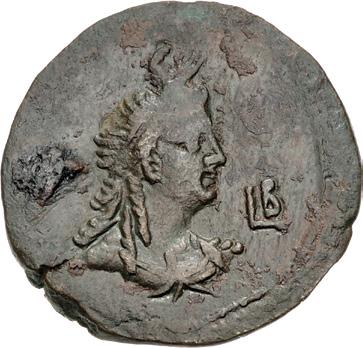


501. EGYPT, Alexandria. Vespasian. AD 69-79. Æ Hemidrachm (30mm, 15.23 g, 12h). Dated RY 2 (AD 69/70). AYTOK KAIΣ ΣEBA OYEΣΠAΣIANOY, laureate head right / Draped bust of Isis right, wearing headdress of solar disk and horns; L B (date) to right. Köln 280-1 (diobol); Dattari 378 (same); K&G 20.20 (same); RPC II 2420; Emmett 210.2 (R5). Red-brown patina, scratches, patches of encrustations. VF. Very rare as a hemidrachm. ($500)
From the Dr. Thomas E. Beniak Collection, purchased from Classical Numismatic Group, 13 November 2008. Ex Dix, Noonan, Webb A6 (29 September 2008), lot 5799.
502. EGYPT, Alexandria. Vespasian. AD 69-79. Æ Hemidrachm (28mm, 16.03 g, 12h). Dated RY 9 (AD 76/6). AYTOK KAIΣ ΣEBA OYEΣΠAΣIANOY, laureate head right / ZEYΣ ΣAPAΠIΣ, Zeus-Serapis enthroned left, wearing kalathos, extending right hand over Kerberos seated at his feet to left and holding long scepter in right hand; L ENAT (date) in legend. Köln 314; Dattari 406; K&G 20.66; RPC II 2547; Emmett 214.9. Dark green patina with earthen highlights. VF. ($400)
From the Dr. Thomas E. Beniak Collection. Ex Group CEM (Classical Numismatic Group 91, 19 September 2012), lot 712.




503. EGYPT, Alexandria. Domitian. AD 81-96. Æ Diobol (25.5mm, 9.77 g, 12h). Dated RY 4 (AD 84/5). AVT ΚΑΙΣΑΡ
laureate head right / Draped bust of Isis right, wearing headdress of solar disk and horns; ΕΤΟΥΣ TETAPTOY (date). Köln 339; Dattari (Savio) 504; K&G 24.30; RPC II 2502; Emmett 296.4 (R5). Brown surfaces, light roughness, small edge splits. VF. Extremely rare, only three known to RPC. ($300)
From the Dr. Thomas E. Beniak Collection, purchased from Praefectus Coins, 15 December 2017.
RPC Plate Coin – One of Two Known
504. EGYPT, Alexandria. Domitian. AD 81-96. Æ Diobol (23mm, 8.68 g, 12h). Dated RY 7 (AD 87/8). AVT ΚΑΙΣΑΡ ΔΟΜΙΤΙΑΝΟΣ ΣΕΒ ΓEPM, laureate head right / Draped bust of Serapis right, wearing kalathos; ETOYΣ EBΔOMOY (date) around. Köln –; Dattari (Savio) –; K&G 24.70; RPC II 2536.2 (this coin, illustrated); Emmett 297.7 (R5). Dark brown patina, small edge splits. Good VF, choice. Extremely rare, one of two recorded in RPC. ($750)
From the Dr. Thomas E. Beniak Collection. Ex Classical Numismatic Group 76 (12 September 2007), lot 1145.
RPC Plate Coin – Unique



505. EGYPT, Alexandria. Trajan. AD 98-117. BI Tetradrachm (24.5mm, 12.80 g, 12h). Dated RY 9 (AD 105/6). AYT TPAIAN ΣEB ΓΕΡΜ ΔAKIK, laureate head right / Harpocrates standing left, wearing pschent, raising right finger to lips and holding cornucopia in left; to right, lotus plant; L ENATOY (date) around. Köln –; Dattari (Savio) –; K&G –; RPC III 4183.2 (this coin, illustrated); Emmett –. Deeply toned, minor marks. VF. Unique, one of two of this type recorded in RPC, but only this coin with lotus to right. Emmett does not record any tetradrachms with Harpocrates as a reverse type; all tetradrachms for RY 9 are extremely rare. ($750)
From the Dr. Thomas E. Beniak Collection, purchased from Holyland Numismatics, 12 January 2009.


506. EGYPT, Alexandria. Trajan. AD 98-117. Æ Diobol ( 24mm, 8.59 g, 11h). Dated RY 14 (AD 110/1). AYT TPAIAN C ЄB ΓЄPM ΔAKIK, laureate head right / Eagle standing right with wings gathered, L IΔ (date) across field. Köln –; Dattari (Savio) 7300; K&G –; RPC III 4561; Emmett 651.14 (R5). Brown patina with light earthen highlights, minor roughness. VF. Very rare. ($500)
From the Dr. Thomas E. Beniak Collection, purchased from Schick Coins, 16 July 2015.
Ex Dattari Collection – RPC Plate Coin

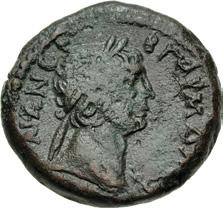


507. EGYPT, Alexandria. Trajan. AD 98-117. Æ Obol (18mm, 3.99 g, 12h). Dated RY 14 (AD 110/1). AYT TPAIAN C ЄB ΓЄPM ΔAKIK, laureate head right / Elephant standing right, L IΔ (date) above. Köln –; Dattari (Savio) 1205 = RPC III 4565.5 (this coin); K&G 27.363; Emmett 672.14 (R5). Green-brown patina, light porosity. VF. Very rare and the finest of six recorded by RPC. ($500)
From the Dr. Thomas E. Beniak Collection. Ex Giovanni Dattari Collection (Naville Numisatics 26, 23 October 2016), lot 143.




508. EGYPT, Alexandria. Hadrian. AD 117-138. Æ Hemidrachm (27mm, 12.78 g, 12h). Dated RY 5 (AD 120/1). AVT KAI TPAI A∆P[IA CЄB], laureate bust right, slight drapery on left shoulder / Hadrian, holding branch in right hand and eagletipped scepter in left, driving quadriga right; L Є (date) above. Unpublishd as a hemidrachm; for a drachm of this type: cf. Köln 819; cf. Dattari (Savio) 1588; cf. K&G 32.166; cf. RPC III 5278; Emmett 1083.4 (year unrecorded). Red-brown surfaces, slight porosity. VF. Apparently unique. ($750)
From the Dr. Thomas E. Beniak Collection, purchased from Frank L. Kovacs, 18 June 2001. Ex Henry Clay Lindgren Collection.




509. EGYPT, Alexandria. Hadrian. AD 117-138. Æ Diobol (25mm, 10.25 g, 12h). Dated RY 11 (AD 126/7). AVT KAI TPAI A∆PIA CЄB, laureate bust right, slight drapery on left shoulder / Bull butting right; L ENΔEKA TO V (date) above and around. Köln 977; Dattari (Savio) 2046; K&G 32.428; RPC III 5675; Emmett 1116.11. Dark brown patina. Near EF. ($500)
From the Dr. Thomas E. Beniak Collection. Ex CNG inventory 730494 (4 May 2002).
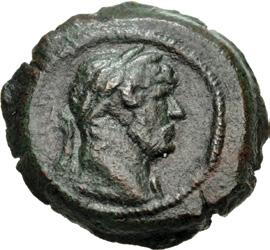



510. EGYPT, Alexandria. Hadrian. AD 117-138. Æ Dichalkon (14mm, 1.44 g, 12h). Dated RY 11 (AD 126/7). Laureate bust right, slight drapery on left shoulder / Canopus of Osiris left; [L] IA (date) across field. Köln 953 var. (canopus right); Dattari (Savio) 7588; K&G 32.441 var. (same); RPC III 5694.2 (this coin); Emmett 1175.11 var. (same) (R5). Dark brown patina, slight porosity. VF. Very rare, especially with a left facing canopus. ($500)
From the Dr. Thomas E. Beniak Collection. Ex Classical Numismatic Group 91 (19 September 2012), lot 110.



511. EGYPT, Alexandria. Hadrian. AD 117-138. Æ Diobol (24mm, 10.49 g, 11h). Dated RY 16 (AD 131/2). AVT KAI TPAI AΔPIA CЄB, laureate, draped, and cuirassed bust right, seen from behind / Isis enthroned right, wearing crown of solar disc, horns, and plumes, on knee, young Harpocrates, crowned with pschent and holding lotus, raising right hand; to left, oinochoe; to right, palm frond; L Iς (date) across field. Köln 1045; Dattari (Savio) 1750; K&G 32.530; RPC III 5815; Emmett 1138.16. Brown patina, minor marks, metal flaws on reverse. Good VF. ($500)
From the Dr. Thomas E. Beniak Collection. Ex CNG inventory 954597 (July 2013); Robert O. Ebert Collection (Part I, Stack’s Bowers & Ponterio 174, 11 January 2013), lot 5347 (part of).


512. EGYPT, Alexandria. Hadrian. AD 117-138. Æ Diobol (24mm, 11.03 g, 11h). Dated RY 21 (AD 136/7). AVT KAIC TPAIA A∆PIA[NOC CЄB], laureate, draped, and cuirassed bust right, seen from behind / Serpent Uraeus coiled and erect right, wearing crown of solar disk and horns; L K A (date) across field. Köln –; Dattari (Savio) 2051 = RPC III 6241.4 (this coin); K&G – Emmett 1146.21 (R5). Brown patina, minor marks. VF. Very rare. ($500)
From the Dr. Thomas E. Beniak Collection. Ex Giovanni Dattari Collection (Naville Numismatics 26, 23 October 2016), lot 163.


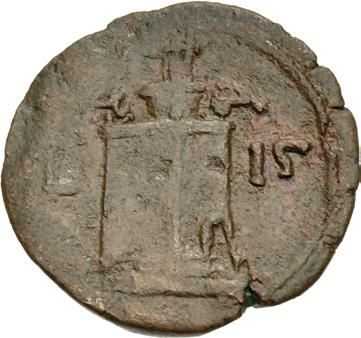
513. EGYPT, Alexandria. Sabina. Augusta, AD 128-136/7. Æ Hemidrachm (29.5mm, 14.47 g, 12h). Dated RY 16 of Hadrian (AD 131/2). CABINA [CЄBACTH], draped bust right, wearing stephane / Pharos of Alexandria surmounted by two Tritons, each blowing a buccinum (trumpet), lantern surmounted by statue holding situla in right hand and scepter in right, entryway at bottom right; L Iς (date) across field. Köln –; Dattari (Savio) 2072; K&G 33.8; RPC III 5809; Emmett 1343.16 (R5). Brown patina, some roughness, weakness on obverse. Good Fine. Extremely rare, only three recorded by RPC. ($500)
From the Dr. Thomas E. Beniak Collection, purchased from Nilus Coins, 31 March 2010.


514. EGYPT, Alexandria. Antinoüs. Died AD 130. Æ Hemidrachm (28.5mm, 13.91 g, 12h). Struck RY 19 of Hadrian (AD 134/5). ANTINOOY HPωOC, draped bust right, wearing hem–hem crown / Antinoüs (as Hermes), cloaked and holding caduceus in right hand, on horseback right; L/I Θ (date) in field. Köln –; Dattari (Savio) 8007-9; K&G 34a.2; RPC III 6073; Blum 10; Emmett 1347.19 (R3). Dark brown patina, smoothed, details enhanced. Near VF. ($750)
From the Dr. Thomas E. Beniak Collection, purchased from Grove Coin Company, 15 March 2008.

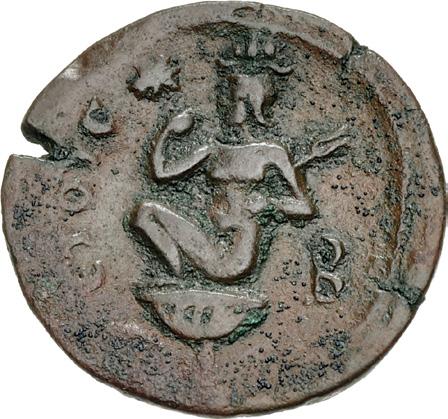

515. EGYPT, Alexandria. Antoninus Pius. AD 138-161. Æ Diobol (24mm, 8.86 g, 1h). Dated RY 2 (AD 138/9). AYT K T AIΛ AΔP ANTωNЄINOC CЄB ЄVC, laureate bust right, slight drapery on left shoulder / Harpocrates seated left on lotus flower, wearing hem-hem crown, rising right hand to mouth, holding flail in left hand; above left, star; ЄTOYC B (date) around. Köln 1305 var. (no star, different crown); Dattari (Savio) 2571; K&G 35.44 var. (same); RPC IV.4 146.12 (this coin); Emmett 1751.2 (R3). Red-brown patina with spots of verdigris, porosity. Near VF. Rare variety with the star in left field. ($500)
From the Dr. Thomas E. Beniak Collection. Ex Classical Numismatic Group 69 (8 June 2005), lot 1291; Kerry K. Wetterstrom Collection (Classical Numismatic Auctions XIII, 4 December 1990), lot 86; Coin Galleries (23 August 1989), lot 419.



516. EGYPT, Alexandria. Antoninus Pius. AD 138-161. Æ Obol (19.5mm, 6.10 g, 12h). Dated RY 5 (AD 141/2). AYT K T AIΛ AΔP ANTωNЄINOC, laureate head right / Eros riding dolphin left, holding chelys(?) in raised right hand; L Є across field. Köln 1590; Dattari (Savio) –; K&G 35.179; RPC IV.4 604; Emmett 1770.5 (R5). Brown patina with earthen highlights, light roughness. Near VF. Extremely rare, five known to RPC, none in CoinArchives, the first in private hands. ($500)
From the Dr. Thomas E. Beniak Collection, purchased from Nilus Coins, 14 January 2006.


517. EGYPT, Alexandria. Antoninus Pius. AD 138-161. Æ Hemidrachm (28mm, 13.89 g, 12h). Dated RY 10 (AD 146/7). AYT K T AIΛ AΔP ANTωNЄINOC CЄB ЄVC, laureate head right / Dikaiosyne seated left, holding scales in outstretched right hand and cornucopia in left; L ∆ЄK A TOV (date) around. Köln –; Dattari (Savio) 2516; K&G 38.370; RPC IV.4 1012; Emmett 1718.10 (R4). Brown patina, short edge splits, edge flaw. VF. Very rare, eight known to RPC, two in CoinArchives. ($500)
From the Dr. Thomas E. Beniak Collection, purchased from Edward J. Waddell, 15 August 2019.



518. EGYPT, Alexandria. Antoninus Pius. AD 138-161. Æ Diobol (23mm, 8.20 g, 12h). Zodiac series. Dated RY 11 (AD 147/8). AYT K T AIΛ AΔP ANTωNЄINOC, laureate head right / Sun in Leo: Lion leaping right, head left; star to upper left; L IA (date) below. Köln 1582; Dattari (Savio) 3130bis; K&G 35.414; RPC IV.4 1077; Emmett 1756.11. Brown patina with green highlights, light porosity, cleaning scratches. VF. ($500 )
From the Dr. Thomas E. Beniak Collection. Ex CNG inventory 736103 (October 2003); Nomisma S.p.A. 25 (21 September 2003), lot 142. With the star in the field, the lion is a representation of the constellation Leo.


519. EGYPT, Alexandria. Antoninus Pius. AD 138-161. Æ Obol (19mm, 5.86 g, 12h). Dated RY 17 (AD 153/4). ANTωNЄINOC CЄB ЄVCЄB, laureate bust right, traces of drapery on left shoulder / Serpent Uraeus coiled and erect left, wearing crown of solar disk and horns; L I Z (date) across field. Köln 1585 corr. (date); Dattari (Savio) –; K&G –; RPC IV.4 1628; Emmett 1784.17 (RY17 not recorded). Dark brown patina, light porosity. Near VF. Extremely rare, only three recorded in RPC, none in CoinArchives. ($500 )
From the Dr. Thomas E. Beniak Collection, purchased from Nilus Coins, 10 June 2009.



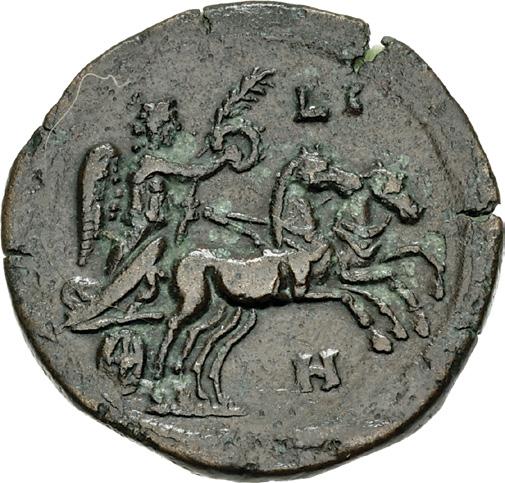
520. EGYPT, Alexandria. Marcus Aurelius. As Caesar, AD 139-161. Æ Hemidrachm (27.5mm, 17.42 g, 12h). Dated RY 18 of Antoninus Pius (AD 154/5). M AVPHΛIOC KAICAP, bareheaded, draped, and cuirassed bust right, seen from behind / Nike, holding wreath in right hand and palm frond and reins with left, driving galloping biga right; L I H (date) above and below. Köln –; Dattari (Savio) 9053 = RPC IV.4 1739.1 = Figari & Mosconi 824 (this coin); K&G –; Emmett 1907.18 (RY18 not recorded). Brown patina, some peripheral roughness, die flaw on obverse. Near VF. Unique. ($1000)
From the Dr. Thomas E. Beniak Collection, purchased from Malter Galleries, 12 February 2006. Ex Giovanni Dattari Collection.




521. EGYPT, Alexandria. Commodus. AD 177-192. Æ Diobol (24mm, 6.88 g, 11h). Dated RY 19 of Marcus Aurelius (AD 178/9). Λ AVPHΛIOC KOMMOΔOC CЄB VΠAT B, laureate, draped, and cuirassed bust right, seen from behind / Apis bull standing right, crescent on flank, solar disk between horns; before, lighted altar; L IΘ (date) above. Köln –; Dattari (Savio) –; K&G 41.16; RPC IV.4 3353; Emmett 2499.19 (R5). Brown patina, some pitting, traces of verdigris. VF. Very rare, only five recorded in RPC, none in CoinArchives. ($750)
From the Dr. Thomas E. Beniak Collection. Ex Gorny & Mosch 196 (7 March 2011), 2323.
Ex Dattari Collection
522. EGYPT, Alexandria. Septimius Severus. AD 193-211. Æ Diobol (23mm, 8.85 g, 11h). Dated RY 8 (AD 199/200). [AYT K Λ] CЄΠ CЄYH ЄYCЄ ΠЄPT CЄB APA AΔI [ΠAP MЄΓ], laureate head right / Eagle standing right, head left, with wings displayed, wreath in beak; L H (date) across field. Köln –; Dattari (Savio) 9724 = Emmett 2724.8 (this coin, R5); K&G –. Brown patina with green, edge flaws. VF. Extremely rare, the finest of two known. ($1000)
From the Dr. Thomas E. Beniak Collection. Ex Berk BBS 216 (27 July 2021), lot 592; Philip DeVicci Collection (Classical Numismatic Group 53, 15 March 2000), lot 1227; Classical Numismatic Group 41 (19 March 1997), lot 1298; Classical Numismatic Auctions II (7 November 1987), lot 353; Giovanni Dattari Collection.


523. EGYPT, Alexandria. Geta. As Caesar, AD 198-209. Æ Diobol (25mm, 11.20 g, 12h). Dated RY 6 of Septimius Severus (AD 197/8). Λ CЄΠTIMIOC ΓЄTAC KAICAP, bareheaded, draped, and cuirassed bust right, seen from behind / Eagle standing right on thunderbolt, head left, with wings gathered, wreath in beak; L ς (date) across field. Köln –; Dattari (Savio) –; K&G –; Emmett 2809.6 (RY 6 not recorded); Demetrio 2313 var. (obv. legend, date arrangement). Dark green-brown patina with light earthen highlights, some roughness, cleaning scratches. Near VF. Extremely rare and presently unique. ($1500)
From the Dr. Thomas E. Beniak Collection, purchased from Schick Coins, 31 March 2015.
The only other similar specimen is in the Demetrio collection housed in the Numismatic Museum of Athens; it has a shorter obverse legend and the date on the reverse is in the lower left field.
The Alexandrian nome series provides a fascinating glimpse into the religious worship and every day life in ancient Egypt. Nomes were administrative districts, either towns or small regions, which presented their own cultural identities on coins and local art. There were 55 coin-producing nomes, many with their own unique cult deities or sacred animals. For example, the Coptite nome always featured the Dorcas gazelle; being held by Sobek-geb (Kronos) on the larger denominations, or simply standing by itself on the smallest coin. Other motifs include more common Roman or Egyptian deities such as Athena or Hermanubis. Other Egyptian themes are also popular, such as the crocodile, hippopotamus, ibis, cynocephalus (a dog-headed baboon sacred to Thoth), and Canopic jars.
The first nomes coinage was issued by Domitian in his regnal year 11 (AD 91/2) and continued in certain years through Antoninus Pius and Marcus Aurelius, as Caesar, year 8 (AD 144/5). The largest production came under Hadrian’s year 11 (AD 126/7) with over 110 types recorded. The nomes coinage produced only bronze denominations, no tetradrachms, with the larger denominations being rarer. Alexandria’s economic system was closed to the Roman currency of the day, denarii and aurei were not allowed beyond the port. The nomes coinage mirrors the Roman provincial coinage of the rest of the empire. With the billon tetradrachms circulating for larger purchases, there was a need for smaller bronze coinage at a local level.
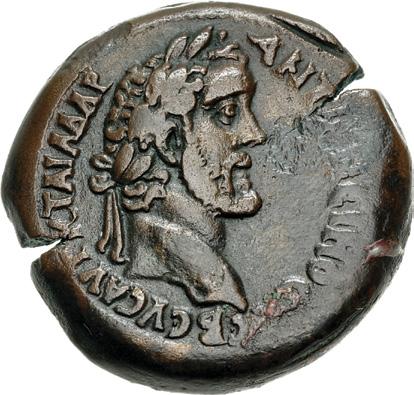


524. EGYPT, Alexandria. Antoninus Pius. AD 138-161. Æ Drachm (34mm, 25.39 g, 12h). Apollonopolites nome Dated RY 8 (AD 144/5). AYT K T AIΛ AΔP ANTωNЄINOC CЄB ЄVC, laureate head right / AΠOΛΛ ω NO ΠOΛIT, Horus-Behedeti/Apollo standing facing, head right, crowned with skhent, holding long scepter in right hand, hawk standing right, crowned with skhent, in extended left hand; L H (date) in lower field. Köln 3432; Dattari (Savio) 6203; K&G N4.6; RPC IV.4 774.9 (this coin); W&G III; Emmett 1823.8 (R3). Red-brown patina, light porosity, edge splits, patch of corrosion on obverse. VF. One of the finest known. ($1500)
From the Dr. Thomas E. Beniak Collection, purchased from Frank L. Kovacs, 18 June 2001. Ex Classical Numismatic Auctions XIV (20 March 1991), lot 568; Henry Clay Lindgren Collection.




525. EGYPT, Alexandria. Hadrian. AD 117-138. Æ Obol (20mm, 4.43 g, 12h). Arabia nome. Dated RY 11 (AD 126/7). AVT KAI TPAI AΔPIA CЄB, laureate bust right, slight drapery on left shoulder / APABIA, Isis-Hathor-Chensit standing facing, head right, wearing crown with feathers and an uraeus, peplos knotted under breast, right hand lowered and holding long scepter in left; L IA (date) to right. Köln 3380; Dattari (Savio) 6205; K&G N5.2; RPC III 6520.18 (this coin); W&G II.1; Emmett 1224.11. Dark brown patina, slight roughness. VF. ($500)
From the Dr. Thomas E. Beniak Collection, purchased from Classical Numismatic Group, 8 December 2000. Ex Karl de Geus 10 (16 October 2000), lot 2344; Kerry K. Wetterstrom Collection (Classical Numismatic Auctions XIII, 4 December 1990), lot 234; Harvey J. Hoffer Collection (Harmer Rooke, 12 December 1986), lot 1031 (part of).

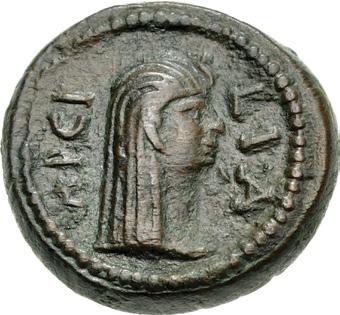

526. EGYPT, Alexandria. Hadrian. AD 117-138. Æ Obol (18mm, 5.24 g, 12h). Arsinoite nome. Dated RY 11 (AD 126/7). AVT KAI TPAI AΔPIA CЄB, laureate bust right, slight drapery on left shoulder / APCI, head of the pharaoh Premarres (Amenemhet III) right, wearing nemes with uraeus; L IA (date) to right. Köln 3381-2; Dattari (Savio) 6210, 10876-80; K&G N6.6; RPC III 6296; W&G III.2; Emmett 1221.11. Green patina, slight roughness, minor deposits. VF. ($500)
From the Dr. Thomas E. Beniak Collection. Ex Classical Numismatic Group 61 (25 September 2002), lot 1080.




527. EGYPT, Alexandria. Hadrian. AD 117-138. Æ Dichalkon (13.5mm, 2.10 g, 11h). Arsinoite nome. Dated RY 11 (AD 126/7). Laureate bust right, slight drapery on left shoulder / APC, crocodile standing right, wearing solar disc crown; L IA (date) above. Köln 3383-4; Dattari (Savio) 6212, 10884-6; K&G N6.7; RPC III 6297; W&G III.3; Emmett 1291.11. Redbrown patina, slight roughness, minor deposits. Near VF. ($500)
From the Dr. Thomas E. Beniak Collection, purchased from Antioch Associates, 15 February 2002.


528. EGYPT, Alexandria. Trajan. AD 98-117. Æ Drachm (35mm, 24.3 g, 11h). Athribite nome. Dated RY 13 (AD 109/10). AYT TPAIAN CЄB ΓЄPM ΔAKIK, laureate bust right, aegis on left shoulder / AΘPIBI THC, Chuit-Hathor standing facing, head left, holding hawk, facing right and wearing pschent in extended right hand, and long scepter in left; LI Γ (date) across field. Köln –; Dattari (Savio) 6214; RPC III 6463.10 = W&G p. 298, I.2a, pl. XXI, 208 (this coin); K&G N7.2; Emmett 739.13 (R3). Red and brown patina, some roughness, flan crack, edge splits. Near VF. Rare. ($1000)
From the Dr. Thomas E. Beniak Collection, purchased from Frank L. Kovacs. Ex Jean-Pierre Righetti Collection (Münzen und Medaillen GmbH 12, 11 April 2003), lot 717; M. Jungfleisch Collection; Dürr & Michel (16 November 1998), lot 732.



529. EGYPT, Alexandria. Trajan. AD 98-117. Æ Drachm (35mm, 21.56 g, 12h). Diospolis Magna nome. Dated RY 12 (AD 108/9). AYT TPAIAN CЄ B ΓЄPM ΔAKIK, laureate bust right, aegis on left shoulder / ΔIOCΠOΛIC H MEΓAΛH, young Zeus Ammon-Ra standing facing, head right, wearing ram’s horns surmounted by two feathers, holding long scepter in right hand, holding ram wearing crown with feathers in extended left hand; at feet left, ram standing left, wearing crown with feathers; LI B (date) across field. Köln –; Dattari (Savio) 10908 = RPC III 6298.3 = Geissen & Weber, ZPE 144, pl. II, 17 =. Figari & Mosconi 1944 (this coin); K&G N10.1; Emmett 798.12 (Mareote nome - RY12 not recorded). Brown patina, some pitting, metal flaw on obverse. VF. Extremely rare, only three recorded in RPC. ($1000)
From the Dr. Thomas E. Beniak Collection. Ex Münzen und Medaillen GmbH 1 (16-17 September 1997), lot 584; Kunst und Münzen AG XXII (2 April 1981), lot 291.




530. EGYPT, Alexandria. Hadrian. AD 117-138. Æ Obol (20.5mm, 5.08 g, 12h). Heliopolite nome. Dated RY 11 (AD 126/7). AVT KAI TPAI AΔPIA CЄB, laureate bust right, slight drapery on left shoulder / HΛI O Π, Ra-Atum-Harakhte/Helios standing facing, radiate head left, holding Mnevis bull in outstretched right hand, whip in left; L IA (date) to right. Köln 33923; Dattari (Savio) 6246; K&G N14.1; RPC III 6487; W&G I.1; Emmett 1234.11 (R3). Brown patina with green highlights, light porosity, edge splits. VF. Well centered on an oversized flan. ($500)
From the Dr. Thomas E. Beniak Collection, purchased from Harlan J. Berk, 29 May 2021.


531. EGYPT, Alexandria. Antoninus Pius. AD 138-161. Æ Drachm (34mm, 28.76 g, 12h). Heliopolite nome. Dated RY 8 (AD 144/5). A[YT K T AIΛ] AΔP ANTωNЄINOC CЄB ЄVC, laureate head right / [HΛI] O ΠO ΛЄIT, Ra-Atum-Harakhte/ Helios standing facing, radiate head left, holding Mnevis bull in outstretched right hand, whip in left; L H (date) in lower field. Köln –; Dattari (Savio) 6248; K&G N14.3; RPC IV.4 777.5 (this coin); W&G II; Emmett 1820.8 (R4). Green patina, minor marks, spot of corrosion on reverse. Near VF. Very rare, only seven known to RPC, two in CoinArchives. ($750)
From the Dr. Thomas E. Beniak Collection. Ex Stein A. Evensen Collection (Classical Numismatic Group 115, 16 September 2020), lot 497; Triton XI (8 Janaury 2008), lot 533.

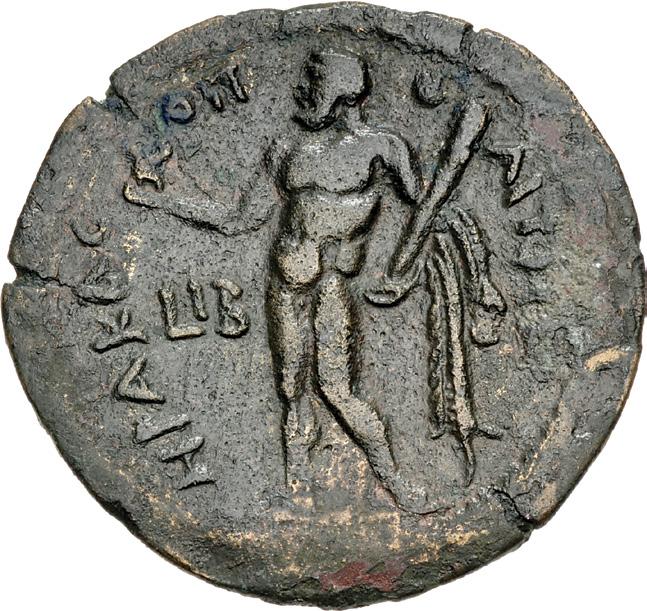

532. EGYPT,. Alexandria. Trajan. AD 98-117. Æ Drachm (35.5mm, 22.22 g, 12h). Herakleopolite nome. Dated RY 12 (AD 108/9). AYT TPAIAN CЄB ΓЄPM ΔAKIK, laureate, draped, and cuirassed bust right, seen from behind / HPAKΛEωΠ O ΛEITHC, Herishef-Herakles standing left, holding griffin left in his outstretched right hand and club in left, lion’s skin draped over left arm; L IB (date) to left. Köln –; Dattari (Savio) 6251 var. (rev. legend); K&G N16.2 var. (same); RPC III 6360; W&G p. 181, II.1, pl. VII, 81 corr. (rev. legend, this coin); Emmett 752.13 (R5). Brown patina with red, short flan crack, light roughness, scrape on reverse. Near VF. Extremely rare, presently unique. ($1500)
From the Dr. Thomas E. Beniak Collection, purchased from Frank L. Kovacs, 8 December 1999. Ex Dürr & Michel (16 November 1998), lot 749.


533. EGYPT, Alexandria. Trajan. AD 98-117. Æ Drachm (34mm, 16.26 g, 12h). Herakleopolite nome. Dated RY 13 (AD 109/10). AYT TPAIAN CE B ΓEPM ΔAKIK, laureate bust right, aegis on left shoulder / HEAPΛEω [OΠOΛITHC], Athena standing left, holding a griffin in her outstretched right hand, left hand on grounded shield; to right, column; [L IΓ (date) in legend]. Köln –; Dattari (Savio) 10950 = RPC III 6361A (this coin, illustrated); K&G –; W&G –; Emmett 734 (R5). Brown patina with some green, minor roughness, double struck and slightly off center on reverse, edge split. Near VF. Unique. ($1000)
From the Dr. Thomas E. Beniak Collection, purchased from Harlan J. Berk, inventory cc97697 (ND). Ex Classical Numismatic Group 43 (24 September 1997), lot 1156.

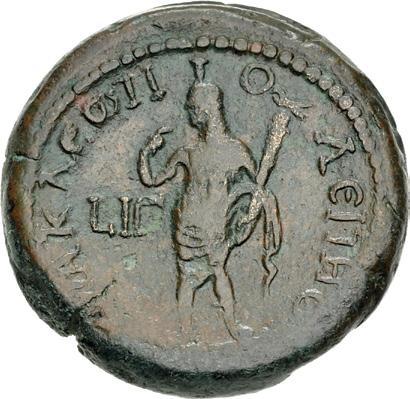
534. EGYPT, Alexandria. Trajan. AD 98-117. Æ Drachm (34mm, 26.84 g, 12h). Herakleopolite nome. Dated RY 13 (AD 109/10). AYT TPAIAN CЄ B ΓЄPM ΔAKIK, laureate, draped, and cuirassed bust right / HPAKΛEωΠ O ΛEITHC, young Harsomtous-Herakles standing facing, head left, wearing kalathos with lotus flower, right hand to mouth, holding club topped with hawk in left hand; L IΓ (date) to left. Köln –; Dattari (Savio) 10943; RPC III 6464.7 (this coin); K&G N16.6; W&G II.2c; Emmett 749.13 (R4). Red and brown patina, a few small pits and deposits, flan crack. VF. Rare. ($1000)
From the Dr. Thomas E. Beniak Collection. Ex Kovacs MBS XI (19 June 1993), lot 211.




535. EGYPT, Alexandria. Hadrian. AD 117-138. Æ Obol (19mm, 5.20 g, 11h). Herakleopolite nome. Dated RY 11 (AD 126/7). AVT KAI TPAI AΔPIA CЄB, laureate bust right, slight drapery on left shoulder / HPA K, Herishef-Herakles standing left, holding griffin in outstretched right hand, holding club in left, lion’s skin draped over left arm; L IA (date) to right. Köln 3397; Dattari (Savio) 6259; K&G N16.17; RPC III 6374.16 (this coin); W&G III.2a; Emmett 1237.11. Greenbrown patina. VF. ($500)
From the Dr. Thomas E. Beniak Collection, purchased from Harlan J. Berk, 29 May 2021. Ex Thomas O. Mabbott Collection (H. Schulman, 6 June 1969), lot 3724.



536. EGYPT, Alexandria. Hadrian. AD 117-138. Æ Obol (19.5mm, 5.18 g, 12h). Herakleopolite nome. Dated RY 11 (AD 126/7). AVT KAI TPAI AΔPIA CЄB, laureate bust right, slight drapery on left shoulder / HPAK, laureate head of Herishef-Herakles right; L IA (date) in right field. Köln 3395; Dattari (Savio) 6257; K&G N16.15; RPC III 6375; W&G III.2b; Emmett 1236.11. Dark brown patina. Good VF. ($500)
From the Dr. Thomas E. Beniak Collection. Ex Triton III (30 November 1999), lot 801.
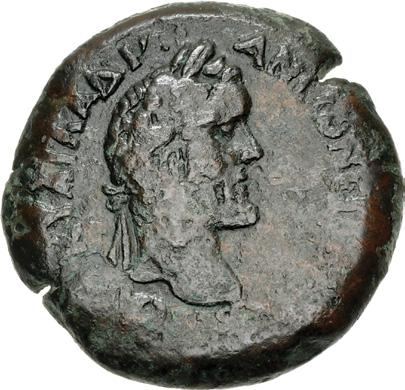



537. EGYPT, Alexandria. Antoninus Pius. AD 138-161. Æ Drachm (34mm, 19.86 g, 12h). Herakleopolite nome Dated RY 8 (AD 144/5). AYT K T AIΛ AΔP ANTωNЄINOC CЄB ЄVC, laureate head right / HPAKΛEωΠ O ΛEITHC, Herishef-Herakles standing left, holding griffin left in his outstretched right hand and club in left, lion’s skin draped over left arm; L H (date) in lower field. Köln –; Dattari (Savio) 6262; K&G N16.19; RPC IV.4 778.10 (this coin); W&G IV; Emmett 1822.8 (R3). Brown and red patina, porosity, smoothing, details enhanced. Good Fine. Rare. ($500)
From the Dr. Thomas E. Beniak Collection. Ex Münzen und Medaillen GmbH 12 (11 April 2003), lot 721.
538. EGYPT, Alexandria. Trajan. AD 98-117. Æ Drachm (34.5mm, 27.24 g, 12h). Hermopolite nome. Dated RY 13 (AD 109/10). AYT TPAIAN CЄ B ΓЄPM ΔAKIK, laureate bust right, aegis on left shoulder / ЄPMOΠΟ ΛITHC, ThotHermes standing left, wearing atef crown with ram’s horns, holding cynocephalus right wearing solar disk seated right in outstretched left hand and winged caduceus in right; LI Γ (date) across field. Köln –; Dattari (Savio) 6267; RPC III 6280.9 (this coin); K&G N18.3; W&G I.1 var. (date); Emmett 755.13. Dark brown patina, slight roughness. VF. Very rare. ($1000)
From the Dr. Thomas E. Beniak Collection. Ex Classical Numismatic Auctions XXI (26 June 1992), lot 542.
A cynocephalus is a creature with the body of a baboon and head of a dog. In ancient Egypt the cynocephalus was sacred to Thoth. 537 538
W&G and RPC Plate Coin – Ex Dattari Collection

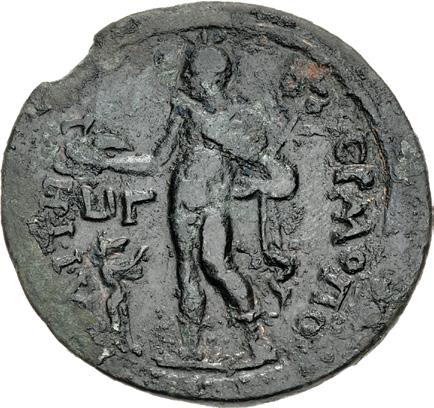
539. EGYPT, Alexandria. Trajan. AD 98-117. Æ Drachm (36mm, 25.06 g, 11h). Hermopolite nome. Dated RY 13 (AD 109/10). AYT TPAIAN CЄB ΓЄPM ΔAKIK, laureate bust right, aegis on left shoulder / ЄPMOΠΟ ΛITHC, Thot-Hermes standing left, wearing atef crown with ram’s horns, holding ibis left in outstretched right hand and winged caduceus in left; to left, cynocephalus standing right with arms raised; LI Γ (date) to left. Köln –; Dattari (Savio) 10923.3 = RPC III 6281.3 = W&G p. 153, I.2b, pl. VI, 55 (this coin); K&G N18.3; Emmett 755.13. Dark brown patina, some roughness, a few deposits, edge chip. Near VF. Extremely rare, one of three known to RPC. ($1000)
From the Dr. Thomas E. Beniak Collection. Ex Münzen und Medaillen GmbH 4 (19 March 1999), lot 258; Dürr & Michel (16 November 1998), lot 755; Giovanni Dattari Collection.

RPC Plate Coin



540. EGYPT, Alexandria. Hadrian. AD 117-138. Æ Dichalkon (14mm, 2.08 g, 11h). Hermopolite nome. Dated RY 11 (AD 126/7). Laureate bust right, slight drapery on left shoulder / EPMO, dog-headed baboon (cynocephalus) seated right, wearing solar disk headdress; L IA (date) to right. Köln 3400; Dattari (Savio) 6270; K&G N18.7; RPC III 6288.21 (this coin, illustrated); W&G II.3a; Emmett 1294.11. Dark brown patina, off center on obverse. VF. ($500)
From the Dr. Thomas E. Beniak Collection. Ex Berk BBS 216 (27 July 2021), lot 572.
RPC Plate Coin – Ex Mabbott Collection




541. EGYPT, Alexandria. Hadrian. AD 117-138. Æ Dichalkon (13mm, 1.88 g, 12h). Leontopolite nome. Dated RY 11 (AD 126/7). Laureate bust right, slight drapery on left shoulder / ΛEONT, lion leaping right; L IA (date) below. Köln –; Dattari (Savio) 6283; K&G N24.4; RPC III 6471.17 (this coin, illustrated); W&G II.2; Emmett 1320.11. Brown patina with green and earthen deposits. Near VF. ($400)
From the Dr. Thomas E. Beniak Collection. Ex Berk BBS 216 (27 July 2021), lot 573; Thomas O. Mabbott Collection (H. Schulman, 6 June 1969), lot 3737.
Ex Dattari & Wetterstrom Collections – K&G, RPC, and W&G Plate Coin


542. EGYPT, Alexandria. Antoninus Pius. AD 138-161. Æ Drachm (35mm, 26.15 g, 11h). Mareotis nome. Dated RY 8 (AD 144/5). AYT K T AIΛ AΔP ANTωNЄINOC CЄB ЄVC, laureate head right / MA PЄ ωTHC, Zeus Ammon-Ra standing facing, head left, crowned with solar disk, holding ram left and long scepter; H/L (date) to left. Köln –; Dattari (Savio) 6293 = K&G N28.5 = RPC IV.4 783.4 = W&G p. 280, III, pl. XIX, 191 (this coin); Emmett 1831.8 (R4). Red-brown patina with some green, minor roughness, die flaws. VF. Very rare, the finest of the four recorded in RPC. ($1000)
From the Dr. Thomas E. Beniak Collection, purchased from Frank L. Kovacs, 28 May 2019. Ex Kerry K. Wetterstrom Collection (Classical Numismatic Auctions XIII, 4 December 1990), lot 282; Johns Hopkins University Collection [inv. 83.199] (Part I, Numismatic Fine Arts & Leu, 16 October 1984), lot 1011 (part of); Giovanni Dattari Collection.



543. EGYPT, Alexandria. Antoninus Pius. AD 138-161. Æ Drachm (33.5mm, 25.01 g, 12h). Menelaites nome. Dated RY 8 (AD 144/5). AYT K T AIΛ AΔP ANTωNЄINOC CЄB ЄVC, laureate head right / MЄNЄ ΛAЄITH[C], Harpokrates of Canopus: as a youth, nude from the waist up with the lower body of a crocodile, wearing pschent and standing left, right hand raised to his mouth, holding cornucopia with his left arm; lit altar to left; L H (date) in exergue. Köln 3435-8; Dattari (Savio) 6315-9; K&G N31.8; RPC IV.4 Online 13971.44 (this coin); W&G III.1b; Emmett 1819.8. Dark brown patina with spots of green, slight porosity. VF. ($1500)
From the Dr. Thomas E. Beniak Collection. Ex Stein A. Evensen Collection (Classical Numismatic Group 115, 16 September 2020), lot 498; Collection CR (Classical Numismatic Group 85, 15 September 2010), lot 717.


544. EGYPT, Alexandria. Antoninus Pius. AD 138-161. Æ Drachm (35mm, 23.97 g, 12h). Naukratis nome. Dated RY 8 (AD 144/5). AYT K T AIΛ AΔP ANTωNЄINOC CЄB ЄVC, laureate head right / NAY K P ATIC, Isis standing facing, head left, wearing basileion, holding the serpent Agathodaemon right in outstretched right hand and long scepter in left; L H (date) in lower field. Köln 3439; Dattari (Savio) 6409; RPC IV.4 789.14 = W&G p. 258, III.1a, pl. XVI, 160 (this coin); K&G N33.6; Emmett 1815.8 (R3). Green patina, slight roughness, edge splits. VF. Rare. ($1500)
From the Dr. Thomas E. Beniak Collection. Ex Dürr & Michel (16 November 1998), lot 772.
RPC Plate Coin


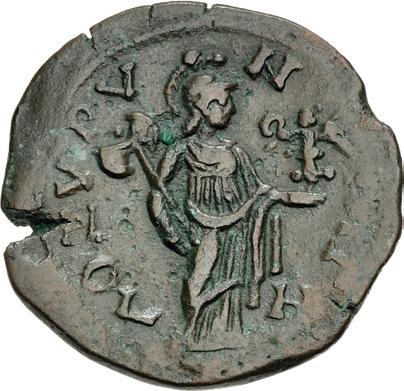
545. EGYPT, Alexandria. Antoninus Pius. AD 138-161. Æ Drachm (34mm, 22.66 g, 11h). Oxyrhynchite nome. Dated RY 8 (AD 144/5). AYT K T AIΛ AΔP ANTωNЄINOC CЄB ЄVC, laureate head right / OΞVPV N XITHC, Thoeris-Athena standing facing, head right, holding labrys in right hand and Nike left in outstretched left hand; L H (date) in lower field. Köln 3440-1; Dattari (Savio) 6340; K&G N38.7; RPC IV.4 790.19 (this coin, illustrated); W&G IV.1a; Emmett 1811.8 (R3). Dark brown patina with green, light porosity, edge split. VF. ($750)
From the Dr. Thomas E. Beniak Collection. Ex Classical Numismatic Auctions XXI (26 June 1992), lot 558.
Ex Dattari Collection – W&G Plate Coin


546. EGYPT, Alexandria. Antoninus Pius. AD 138-161. Æ Drachm (34mm, 24.98 g, 11h). Oxyrhynchite nome. Dated RY 8 (AD 144/5). AYT K T AIΛ AΔP ANTωNЄINOC CЄB ЄV, laureate head right / OΞVPV N XITHC, Thoeris-Athena standing facing, head left, holding Nike right in outstretched right hand and labrys in left; L H (date) in lower field. Köln 34401 var. (Athena right); Dattari (Savio) 6341 = RPC IV.4 790.28 = W&G p. 171, IV.1b, pl. VIII, 77 (this coin); K&G N38.6; Emmett 1812.8 (R3). Dark brown and red patina, edge split, smoothing with cleaning scratches, details enhanced. VF. Rare with left facing Athena. ($1000)
From the Dr. Thomas E. Beniak Collection. Ex Numismatica Ars Classica N (26 June 2003), lot 2004.
Plate



547. EGYPT, Alexandria. Hadrian. AD 117-138. Æ Obol (19mm, 5.68 g, 12h). Pelusion nome. Dated RY 11 (AD 126/7). AVT KAI TPAI AΔPIA CЄB, laureate bust right, slight drapery on left shoulder / [ΠΗ]ΛΟV, head of young Horus of Mount Kasion-Zeus Kasios right, wearing taenia and hem-hem crown; L IA (date) to right. Köln 3418; Dattari (Savio) 6346-7; K&G N40.2; RPC III 6532.40 = W&G p. 380, II.1, pl. XXX, 289 (this coin); Emmett 1231.11. Dark green-brown patina, light roughness on obverse. Good VF. ($500)
From the Dr. Thomas E. Beniak Collection, purchased from Harlan J. Berk, 29 May 2021. Ex Kerry K. Wetterstrom Collection (Classical Numismatic Auctions XIII, 4 December 1990), lot 270, purchased from Edward J. Waddell.



548. EGYPT, Alexandria. Hadrian. AD 117-138. Æ Obol (19mm, 5.62 g, 12h). Prosopite nome. Dated RY 11 (AD 126/7). AVT KAI TPAI AΔPIA CЄB, laureate bust right, slight drapery on left shoulder / ΠPOCω, bust of young HarsomtousHerakles right, wearing nemes and hem-hem crown, raising right hand to mouth; L IA (date) to right. Köln 3422; Dattari (Savio) 6355 = RPC III 6398.18 (this coin); W&G II.1a; K&G N44.2; Emmett 1232.11. Dark brown patina with green. Good VF. ($500)
From the Dr. Thomas E. Beniak Collection. Ex Giovanni Dattari Collection (Naville Numisatics 31, 14 June 2017), lot 275.




549. EGYPT, Alexandria. Hadrian. AD 117-138. Æ Obol (19mm, 5.34 g, 12h). Prosopite nome. Dated RY 11 (AD 126/7). AVT KAI TPAI AΔPIA CЄB, laureate bust right, slight drapery on left shoulder / ΠPOCω, young HarsomtousHerakles standing facing, head left, wearing nemes and hem-hem crown, right hand to mouth, holding club topped with hawk in left hand; L IA (date) to left. Köln 3423-5; Dattari (Savio) 6356; K&G N44.3; RPC III 6399.42 (this coin); W&G II.1b; Emmett 1236.11. Brown patina, small edge flaw, scratches. Near VF. ($500)
From the Dr. Thomas E. Beniak Collection, purchased from Classical Numismatic Group, 28 April 2001. Ex Karl de Geus 10 (16 October 2000), lot 2409.



550. EGYPT, Alexandria. Antoninus Pius. AD 138-161. Æ Drachm (35.5mm, 26.18 g, 11h). Prosopite nome. Dated RY 8 (AD 144/5). AYT K T AIΛ AΔP ANTωNЄINOC CЄB ЄVC, laureate head right / ΠPOCω ΠITHC, young HarsomtousHerakles standing facing, head left, wearing nemes and hem-hem crown, raising right hand to mouth and club in left; L H (date) in lower field. Köln –; Dattari (Savio) 6360; K&G N44.5; RPC IV.4 791.11 (this coin); W&G III; Emmett 1817.8 (R3). Dark brown patina with patches of verdigris, some porosity. VF. Rare. ($1500)
From the Dr. Thomas E. Beniak Collection. Ex Thomas O. Mabbott Collection (H. Schulman, 6 June 1969), lot 3775.


551. EGYPT, Alexandria. Trajan. AD 98-117. Æ Drachm (38mm, 24.44 g, 12h). Saite nome. Dated RY 13 (AD 109/10). AYT TPAIAN CЄ B ΓЄPM ΔAKIK, laureate bust right, aegis on left shoulder / CAITHC NOMOC, Neith-Athena standing facing, head left, holding owl right in outstretched right hand, left hand holding spear; at feet left, lighted altar; LI Γ (date) across field. Köln –; Dattari (Savio) 6367; RPC III 6406; K&G N45.4; W&G II.2a; Emmett 732.13 (R5). Red-brown patina, roughness, edge splits. Near VF. Extremely rare, only three recorded in RPC. ($1000)
From the Dr. Thomas E. Beniak Collection, purchased from Frank L. Kovacs, 20 October 1998.



552. EGYPT, Alexandria. Trajan. AD 98-117. Æ Drachm (35mm, 30.34 g, 12h). Saite nome. Dated RY 13 (AD 109/10). AYT TPAIAN CЄ B ΓЄPM ΔAKIK, laureate bust right, aegis on left shoulder / CAI THC, Neith-Athena standing facing, head left, holding spear in left hand, right hand on grounded shield; LI Γ (date) across field. Köln –; Dattari (Savio) –; RPC III 6408.1 = W&G p. 245, II.2b, pl XIV, 136 (this coin); K&G –; Emmett 733.13 (R5). Red-brown patina, minor deposits. Good VF. Unique. ($2000)
From the Dr. Thomas E. Beniak Collection. Ex Triton II (1 December 1998), lot 654.


553. EGYPT, Alexandria. Marcus Aurelius. As Caesar, AD 139-161. Æ Drachm (33mm, 25.64 g, 12h). Saite nome. Dated RY 8 of Antoninus Pius (AD 144/5). M AVPHΛIOC [KAICAP], bareheaded and draped bust right / CAITHC NOMOC, Neith-Athena standing facing, head left, holding owl left in outstretched right hand, left hand resting on grounded shield; H/L (date) to left. Köln –; Dattari (Savio) 6375; RPC IV.4 876; K&G N45.16; W&G IV; Emmett 1923.8 (R4). Red-brown patina, smoothing. Near VF. Rare. ($1000)
From the Dr. Thomas E. Beniak Collection, purchased from Frank L. Kovacs. Ex Henry Clay Lindgren Collection.
RPC and W&G Plate Coin
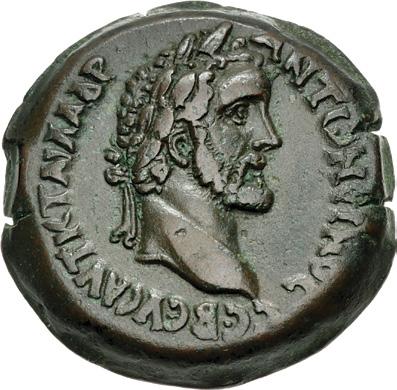


554. EGYPT, Alexandria. Antoninus Pius. AD 138-161. Æ Drachm (33mm, 23.92 g, 12h). Sebennyte nome. Dated RY 8 (AD 144/5). AYT K T AIΛ AΔP ANTωNЄINOC CЄB ЄVC, laureate head right / CЄBЄN NV THC, Onuris-Shu/Ares standing facing, head left, wearing helmet and military dress, holding spear in right hand and parazonium in left; L H (date) in lower field. Köln –; Dattari (Savio) 6383; K&G N46.5; RPC IV.4 794.14 = W&G p. 514, III, pl. XXV, 237 (this coin); Emmett 1810.8 (R4). Dark brown patina, trace deposits. Good VF. One of the finest known. ($1500)
From the Dr. Thomas E. Beniak Collection. Ex Classical Numismatic Auctions XXI (26 June 1992), lot 560.


555. EGYPT, Alexandria. Trajan. AD 98-117. Æ Drachm (36mm, 22.01 g, 12h). Sethroite nome. Dated RY 13 (AD 109/10). AYT TPAIAN CЄB ΓЄPM ΔAKIK, laureate bust right, aegis on left shoulder / CЄΘP ωITHC, young Horus of Mesen standing left, wearing pschent and military dress, holding spear in right hand and holding chlamys with left; to left and behind, lion advancing left; LI Γ (date) across field. Köln –; Dattari (Savio) 6387; RPC III 6490.3 (this coin); K&G N48.4; W&G II.2a; Emmett 785.13 (Male, Ares - R4). Dark green-brown patina, some roughness, edge splits, scrapes on reverse. Near VF. Very rare. ($750)
From the Dr. Thomas E. Beniak Collection. Ex Berk BBS 216 (27 July 2021), lot 553; Thomas O. Mabbott Collection (H. Schulman, 6 June 1969), lot 3787.



556. EGYPT, Alexandria. Antoninus Pius. AD 138-161. Æ Drachm (36mm, 23.87 g, 11h). Sethroite nome. Dated RY 8 (AD 144/5). AYT K T AIΛ AΔP ANTω[NЄINOC] CЄB ЄVC, laureate head right / CЄΘPO ЄI T HC, Horus of Mesen standing facing, head right, wearing pschent and military dress, holding spear in right hand and hawk, standing left and wearing pschent in left; L H (date) across lower field. Köln –; Dattari (Savio) 6390; K&G N48.6; RPC IV.4 796; W&G IV; Emmett 1824.8. Brown-green patina, minor marks, edge splits with flan crack. VF. ($1000)
From the Dr. Thomas E. Beniak Collection. Ex Berk BBS 218 (10 February 2022), lot 339.


557. EGYPT, Alexandria. Trajan. AD 98-117. Æ Drachm (35mm, 24.70 g, 12h). Xoite nome. Dated RY 13 (AD 109/10). AYT TPAIAN CЄ B ΓЄPM ΔAKIK, laureate bust right, aegis on left shoulder / [Ξ]OI THC, Zeus Ammon-Ra standing facing, head left, wearing solar disk and ram’s horns, holding long scepter in left hand, and ram in extended right hand; L IΓ (date) across field. Köln –; Dattari (Savio) 6400; RPC III 6429; K&G 52.6; W&G –; Emmett 741.13 (var. legend - R5); Curtis, “The Coinage of Roman Egypt: A Survey” (reprinted from The Numismatist, January-August 1956), pl. XLIV (this coin’s reverse illustrated, there attributed to the Ombite nome). Dark green patina, slight roughness, edge flaw. VF. Extremely rare. ($1500)
From the Dr. Thomas E. Beniak Collection, purchased from Harlan J. Berk, 20 July 2004.
End of Session 2
Session 3 – Wednesday, January 15, 2025 — 9 AM




558. Anonymous. Circa 300/280-276 BC. Fourrée Didrachm (18mm, 6.21 g, 6h). Imitating the uncertain mint (Neapolis?). Helmeted head of Mars left; oak spray to right / Horse’s head right, wearing bridle, on base inscribed rOÂANO; stalk of grain to left. Cf. Crawford 13/1; Burnett 27 (Oz/Rz - this coin); cf. Sydenham 1; cf. RSC 4; cf. BMCRR RomanoCampanian 1-4; cf. Kestner 2-3; cf. HN Italy 266; cf. RBW 3. Toned, with iridescence, minor pitting exposing the base metal core. VF. ($750)
From the 1930’s Collection of Robert W. Hubel of Michigan. Ex Ars Classica XV (2 July 1930), lot 36.
The first Roman silver coins were produced about the time of King Pyrrhus’ invasion of Italy at the behest of the Tarentines (280 BC) and were struck on a weight standard derived from the currency of the Campanian city of Neapolis. This initial issue (Mars/horse’s head) seems to have been produced at the Greek mint of Metapontum, an attribution strongly suggested by the ear of barley appearing behind the horse’s head on the reverse. The dies for this first issue of Roman didrachms display the fine Greek style for which the Metapontine coinage was renowned. The head of Mars on the obverse is inspired by the portrait of Leukippos, the founder of Metapontum when it was resettled from Sybaris, which had appeared regularly on the Metapontine coinage in the latter part of the 4th century.




559. Anonymous. Circa 269-266/4 BC. AR Didrachm (20mm, 7.29 g, 12h). Uncertain mint. Laureate head of Apollo left, rOÂANO to left / Horse galloping right; star with sixteen rays above. Crawford 15/1b; Burnett, Second 6; Sydenham 4; RSC 6a; BMCRR Romano-Campanian 19-20; Kestner 12; RBW 9. Toned, with iridescence, find patina, scratches and edge scrape. Near EF. ($3000)
From the 1930’s Collection of Robert W. Hubel of Michigan. Ex Ernst Justus Haeberlin Collection (Cahn [83], with A. Hess, 17 July 1933), lot 16.

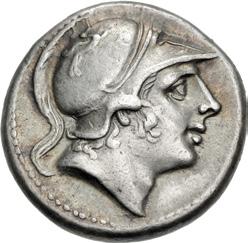

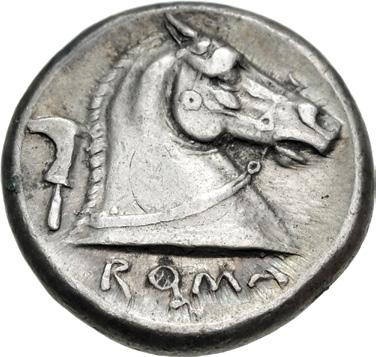
560. Anonymous. Circa 240 BC. AR Didrachm (19mm, 6.70 g, 6h). Sickle series. Rome mint. Head of Mars right, wearing crested Corinthian helmet decorated with a griffin / Head of horse right, wearing bridle, bit, and reins; sickle to left; rOÂA below. Crawford 25/1; Sydenham 24; HN Italy 297; RSC 34; BMCRR Romano-Campanian 57-60; Kestner 47; RBW 38. Toned, with light iridescence, minor marks. Good VF. Well centered. ($2000)
From the 1930’s Collection of Robert W. Hubel of Michigan. Ex Cahn 75 (30 May 1932), lot 478.



561. C. Maianius. 153 BC. AR Denarius (17mm, 3.96 g, 12h). Rome mint. Head of Roma right, wearing winged helmet, ornamented with griffin’s head, the visor in three pieces, single-pendant earring, and pearl necklace, hair arranged in three symmetrical locks; x (mark of value) behind / Victory, holding whip in right hnad and reins in left, driving galloping biga right; C ÂAiANi below, rOÂA in exergue. Crawford 203/1a; Sydenham 427; Maiania 1; BMCRR Italy 434; Kestner 1948-9; RBW 870. Iridescent toning, remnants of collector’s inventory number and metal flaws on obverse, slight doubling in legend on reverse. EF. ($500)
From the 1930’s Collection of Robert W. Hubel of Michigan.



562. Q. Marcius Libo. 148 BC. AR Denarius (20mm, 3.95 g, 3h). Rome mint. Head of Roma right, wearing winged helmet, ornamented with griffin’s head, the visor in three pieces, single-pendant earring, and pearl necklace, hair arranged in three symmetrical locks; LiBO downwards to left; x (mark of value) below chin / The Dioscuri, each holding couched spear in right hand, and wearing chlamys, cuirass, and pileus surmounted by star, on horseback riding right; below horses, œ • VrC; rOÂa on tablet in exergue. Crawford 215/1; Sydenham 395; Marcia 1; BMCRR Rome 700-1; Kestner 2029-31; RBW 915. Toned, with iridescence, minor marks and edge flaws, collector’s inventory number 705 in ink in field on obverse. Near EF. ($500)
From the 1930’s Collection of Robert W. Hubel of Michigan.



563. C. Augurinus. 135 BC. AR Denarius (20mm, 3.95 g, 9h). Rome mint. Head of Roma right, wearing winged helmet, ornamented with griffin’s head, the visor in three pieces, single-pendant earring and pearl necklace, hair arranged in three symmetrical locks; rOÂA downwards to left, x (mark of value) below chin / Ionic column, surmounted by a figure holding scepter in right hand and grain ears in left; the shaft is formed of torus-shaped blocks; to the capital is attached a tinnabulum (bell) on either side; at base of column are two lion heads, each surmounted by a stalk of grain; on left, togate figure of L. Minucius Augurinus, togate, holding a dish and a loaf, left foot on modius; on right, togate figure of M. Minucius Faesus, holding lituus in right hand; C • A ug above. Crawford 242/1; Sydenham 463; Minucia 3; BMCRR Rome 952-4; Kestner 21956; RBW 999. Vivid iridescence on old cabinet toning. Near EF. ($500)
From the 1930’s Collection of Robert W. Hubel of Michigan.
The Columna Minucia is the first architectural representation on a Roman coin. The monument was erected in honor of the praefect L. Minucius Augurinus, who in 439 BC averted a famine by placing price controls on grain coming into the city. The two figures flanking the column are probably either P. or M. Minucius, consuls in 492 and 491 BC, and M. Minucius Faesus, one of the first plebian augurs in 300 BC. In later years a grain market, the Porticus Minucia grew up around the monument.


564. Publius Calpurnius. 133 BC. AR Denarius (19.5mm, 3.97 g, 9h). Rome mint. Head of Roma right, wearing winged helmet, ornamented with griffin’s head, the visor in three pieces, earring in the shape of a grape bunch, and pearl necklace, hair falling in three locks; • (mark of value) to left / Venus, holding reins in right hand and whip in left, driving galloping biga right, being crowned with wreath by Victory flying left above, star on flank of nearest horse; p • CALp below, rOÂA in exergue. Crawford 247/1; Sydenham 468; Calpurnia 2; BMCRR Rome 968-9; Kestner 2240-1; RBW 1017. Toned, with iridescence, minor marks and surface cracks. EF. ($500)
From the 1930’s Collection of Robert W. Hubel of Michigan.



565. C. Malleolus, A. Albinus Sp.f., and L. Caecilius Metellus. 96 BC. AR Denarius (17mm, 3.85 g, 11h). Laureate head of Apollo right; [A • ALB • Í • F upwards to left], L • ÂeTeL downwards to right / Roma seated left on pile of shields, holding spear and parazonium, being crowned by Victory to right, standing left; C • ÂAL L downwards to left, rOÂA in exergue. Crawford 335/1a; Sydenham 611; Caecilia 46a; RBW 1200. Toned, with iridescence, light porosity, scrape on obverse. EF. ($500)
From the 1930’s Collection of Robert W. Hubel of Michigan.




566. C. Vibius C.f. Pansa. 90 BC. AR Denarius (18mm, 3.98 g, 9h). Rome mint. Laureate head of Apollo right; pANÍA to left, star below chin; all within bead and reel border / Minerva, holding trophy in left hand, and spear and reins in right, driving galloping quadriga left; C • uiBiuÍ • C • F below. Crawford 342/4b; Sydenham 685; Vibia 3; BMCRR 2301; Kestner 2966-7; RBW 1285 var. (control). Toned, with iridescence, some find patina, light porosity, scrape on obverse. Good VF. ($400)
From the 1930’s Collection of Robert W. Hubel of Michigan.
567. L. Rubrius Dossenus. 87 BC. AR Denarius (17.5mm, 4.04 g, 11h). Rome mint. Diademed and veiled head of Juno right, wearing pearl necklace; scepter over shoulder; behind, DOÍ downward / Triumphal quadriga right, side-panel decorated with eagle standing right on thunderbolt; above, Victory flying right, holding wreath; L • ruBri below. Crawford 348/2; Sydenham 706; Rubria 2; BMCRR 2452; Kestner 3044-5; RBW 1323. Toned, with iridescence, light porosity, die flaw on obverse. Near EF. ($400)
From the 1930’s Collection of Robert W. Hubel of Michigan.



568. L. Sulla and L. Manlius Torquatus. 82 BC. AR Denarius (19mm, 4.03 g, 1h). Military mint moving with Sulla. Head of Roma right, wearing winged helmet, ornamented with griffin’s head, the visor in three pieces and peaked, singlependant earring, and ornate necklace; prO • œ to left, L • ÂANLi-i to right / Sulla, holding branch in right hand and reins in left, driving triumphal quadriga right; above, Victory flying left, crowing him with wreath; L • ÍuLLA • iÂp in exergue. Crawford 367/3; Sydenham 759; Manlia 8; BMCRR East 13-15; Kestner 3171-3; RBW –. Lustrous with traces of iridescence, some die rust. Superb EF. ($1000)
From the 1930’s Collection of Robert W. Hubel of Michigan.
As consul for the year 88 BC, Sulla was awarded the coveted assignment of suppressing the revolt of Mithradates VI of Pontus, but political maneuvers resulted in this assignment being transferred to Marius. In response, Sulla turned his army on Rome, captured it, and reclaimed his command against Mithradates. His prosecution of the first Mithradatic War was successful, but he spared the Pontic king for personal gain. In 83 BC, Sulla returned to Italy as an outlaw, but he was able to win the support of many of the leading Romans. Within a year he fought his way to Rome, where he was elected dictator. It was during this campaign to Rome that this denarius was struck. The reverse shows Sulla enjoying the highest military honor to which a Roman could aspire, the celebration of a triumph at Rome.


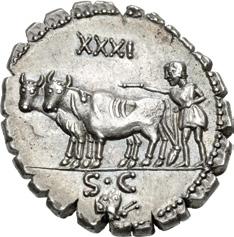
569. C. Marius C.f. Capito. 81 BC. AR Serrate Denarius (20mm, 3.85 g, 11h). Rome mint. Wreathed and draped bust of Ceres right; CApiT • xxxi downward to right / Husbandman with yoke of oxen plowing left; xxxi above, Í • C above butterfly in exergue. Crawford 378/1b; Sydenham 744a; Maria 8; BMCRR Rome 2853-4 var. (control); Kestner 3207-9 var. (controls); RBW 1402 corr. (symbol on rev.). Deeply toned, with iridescence, minor flan flaws. Choice EF. ($500)
From the 1930’s Collection of Robert W. Hubel of Michigan.

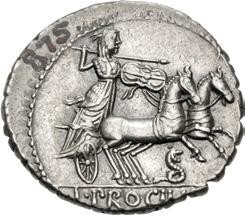


570. L. Procilius. 80 BC. AR Serrate Denarius (19mm, 3.65 g, 6h). Rome mint. Head of Juno Sospita right, wearing goatskin headdress tied at neck; Í • C to left / Juno Sospita, hurling spear in right hand, and holding shield and reins in left, driving galloping biga right; erect serpent right below horses; L • prOCiLi • F in exergue. Crawford 379/2; Sydenham 772; Procilia 2; BMCRR Rome 3150–1; Kestner 3218–9; RBW 1407. Toned, with hints of iridescence, minor marks, collector’s inventory number 875 in margin on reverse. Near EF. ($400)
From the 1930’s Collection of Robert W. Hubel of Michigan.
Here, the goddess is shown in the guise of Juno Sospita, the Preserver accompanied on the reverse by a serpent, symbol of health. Her temple was in the Forum Holitorium in Rome.
571. C. Piso L.f. Frugi. 61 BC. AR Denarius (18mm, 3.86 g, 6h). Rome mint. Head of Apollo right, hair bound with taenia; club to left / Horseman, holding palm frond and reins, galloping right; C piÍO L F Fru/F • in two lines below. Crawford 408/1b; Hersh, Piso 330 (O266/R2091); Sydenham 851h; Calpurnia 24d; cf. BMCRR Rome 3779-83; cf. Kestner 3334-5; RBW 1470 var. (controls). Toned, with hints of iridescence, light porosity, small scrape on reverse. Near EF. Struck in high relief. ($500)
From the 1930’s Collection of Robert W. Hubel of Michigan. Ex Ars Classica XV (2 July 1930), lot 1249. Pedigreed to 1929

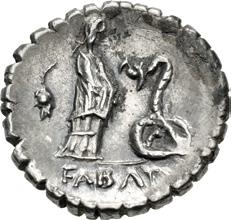
572. L. Roscius Fabatus. 59 BC. AR Serrate Denarius (18mm, 3.96 g, 5h). Rome mint. Head of Juno Sospita right, wearing goat-skin headdress; unidentified control mark to left; [ below] / Female standing right, feeding from her dress a serpent, erect, left; unidentified control mark to left, FABATi in exergue. Crawford 412/1 (symbol pair 215); Sydenham 915; Roscia 3; BMCRR Rome cf. 3394-3510; cf. Kestner 3394-3406; RBW 1491-2 var. (controls). Lightly toned, patches of find patina, a few light scratches. EF. Extremely rare control marks, only four in Schaefer’s photofile. ($400)
From the 1930’s Collection of Robert W. Hubel of Michigan. Ex Helbing 57 (20 June 1929), lot 4065.




573. M. Plaetorius M.f. Cestianus. 57 BC. AR Denarius (18.5mm, 3.97 g, 4h). Rome mint. Draped bust of Ceres(?) right, wearing necklace and her hair in net (saccus) and decorated with poppies; uncertain control mark to left / Upright winged caduceus; CeÍT ex • Í • C downward to left, Â pLAeTOri downward to right. Crawford 405/3b; Sydenham 805; Plaetoria 6; cf. BMCRR Rome 3544-53; cf. Kestner 3305; cf. RBW 1449-50. Toned, with slight iridescence, scratches, off center on obverse, collector’s inventory number 815a on reverse, tiny mark at edge. Near EF. ($500)
From the 1930’s Collection of Robert W. Hubel of Michigan.




574. M. Valerius Messalla. 53 BC. AR Denarius (17.5mm, 3.96 g, 5h). Rome mint. Bust of Roma right, wearing Corinthian helmet, seen from behind, with long flowing hair; spear to left; ÂeÍÍAL downward to right / Curule chair; scepter with royal diadem below; pATre • COÍ above, Í C flanking. Crawford 435/1; Campana, Messalla 33-40 (O3/R3); Sydenham 934; Valeria 13; BMCRR Rome 3927; Kestner 3494; RBW 1547. Lightly toned, with hints of iridescence, scratches, trace deposits, areas of flatness. Good VF. Rare. ($1000)
From the 1930’s Collection of Robert W. Hubel of Michigan. Ex Ars Classica XV (2 July 1930), lot 1292; Theodor Prowe Collection (Hess 137, 20 May 1912), lot 1471; Hirsch V (20 May 1901), lot 664.

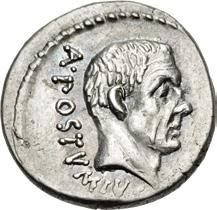


575. Moneyer issues of Imperatorial Rome. Albinus Bruti f. 48 BC. AR Denarius (17mm, 3.89 g, 5h). Rome mint. Bare head of consul Aulus Postumius Albinus right; A pOÍTuÂiuÍ • around / in two lines within grain-ear wreath. Crawford 450/3b; CRI 27; Sydenham 943a; Postumia 14; BMCRR Rome 3967–71; Kestner 3555; RBW –. Iridescent toning with luster, scratches, slightly off center on obverse, die breaks on reverse. EF. Excellent portrait. ($750)
From the 1930’s Collection of Robert W. Hubel of Michigan.
Interesting Human Headed Owl





576. Moneyer issues of Imperatorial Rome. L. Valerius Acisculus. 45 BC. AR Denarius (18mm, 3.94 g, 9h). Rome mint. Diademed head of Apollo Soranus right, surmounted by star; and downwards to left; all within laurel wreath / Human-headed owl, wearing crested Corinthian helmet, advancing right, carrying two nearly parallel spears and shield; [L • uALeriuÍ in exergue]; all within laurel wreath. Crawford 474/2b; CRI 91a; Sydenham 999a; Valeria 18; BMCRR Rome 4106-7; Kestner 3664; RBW 1660. Deeply toned, with iridescence, light marks and scratches, scrape on obverse, off center and collector’s inventory number 1006 in margin on reverse, test cut on edge. Good VF. ($1000)
From the 1930’s Collection of Robert W. Hubel of Michigan.


577. The Pompeians. Q. Caecilius Metellus Pius Scipio. 47- Spring 46 BC. AR Denarius (18mm, 3.65 g, 6h). Military mint traveling with Scipio in Africa. Laureate head of Jupiter right; Â]eTeL around right, piuÍ below / Elephant advancing right; ÍCipiO above, iÂp below. Crawford 459/1; CRI 45; Sydenham 1050; Caecilia 47; BMCRR Africa 1-3; Kestner 3580-1; RBW 1601. Toned, roughness. Good VF. ($500)
From the 1930’s Collection of Robert W. Hubel of Michigan.
Pedigreed to 1932




578. The Pompeians. Sextus Pompey. 42-38 BC. AR Denarius (20mm, 3.94 g, 1h). Massilia (Marseilles) mint; Q. Nasidius, commander of the fleet. Bare head of Pompey the Great right; trident to right; below, dolphin right; NepTuNi to left / Galley with bank of rowers right, under full sail, helmsman steering rudder, hortator standing on prow; star to upper left; œ • NAÍiDiuÍ below. Crawford 483/2; CRI 235; Sydenham 1350; RSC 20 (Pompey the Great); BMCRR Sicily 21; Kestner 3697-8; RBW 1698. Toned, with light iridescence, a few minor marks. Good VF. ($3000)
From the 1930’s Collection of Robert W. Hubel of Michigan. Ex Cahn 75 (30 May 1932), lot 751.
Sextus Pompey came of age during the ascendancy of his father, Gnaeus Pompeius Magnus (Pompey the Great), as the leading general of Rome and the most powerful man in the Republic. After Pompey’s defeat by Julius Caesar at Pharsalus in August of 48 BC, and his treacherous murder in Egypt later that year, Sextus joined the Pompeian resistance to Caesar in Spain. Caesar’s assassination on March 15, 44 BC brought a brief revival of Senatorial control, during which Sextus relocated to Massalia in southern Gaul. In April of 43 BC, the Senate appointed him commander of the Roman fleet. Although the promotion was rescinded three months later, Sextus wasted no time in seizing Sicily and spent the next months building an impregnable power base on the island even as Rome fell under the sway of Caesar’s political heirs, the Triumvirs Antony, Octavian and Lepidus.
This denarius belongs to the brief interval between Caesar’s murder and Sextus’ appointment as Praefect of the Fleet, during his sojourn at the Gallic port city of Massilia. The obverse portrait is clearly recognizable as Pompey the Great, although the legend identifies him as “son of Neptune” (an epithet won by Magnus after his defeat of the Cilician Pirates, and later claimed by Sextus himself) and provides him appropriate attributes - a dolphin and trident. The warship on the reverse appears to be a hemiola, a fast ramming vessel with two banks of oars totaling 52 a side. Interestingly, Sextus himself is not named; instead the moneyer is identified as Quintus Nasidius, a loyal Pompeian commander of naval forces who backed Sextus in his early career, only to later defect to Mark Antony.



579. The Caesarians. Julius Caesar. April-August 49 BC. AR Denarius (17mm, 3.96 g, 4h). Military mint traveling with Caesar. Elephant advancing right, trampling on horned serpent; CAeÍAr in exergue / Emblems of the pontificate: simpulum, aspergillum, securis, and apex. Crawford 443/1; CRI 9; Sydenham 1006; RSC 49; BMCRR Gaul 27-30; Kestner 3515-8; RBW 1557. Toned, with iridescence, traces of find patina, collector’s inventory number 543 on obverse. Near EF. ($1000)
From the 1930’s Collection of Robert W. Hubel of Michigan.



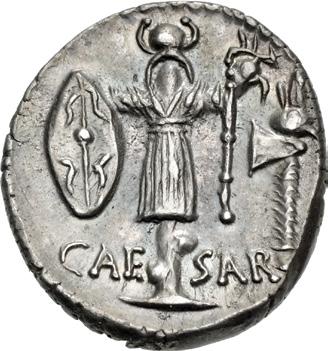
580. The Caesarians. Julius Caesar. Late spring-early summer 48 BC. AR Denarius (18mm, 3.71 g, 12h). Military mint traveling with Caesar. Diademed female head (Clementia?) right, wearing oak wreath; %ii (= 52, Caesar’s age) to left / Gallic trophy, holding oval shield and carnyx surmonted by wolf’s head; securis to right; CAe ÍAr across lower field. Crawford 452/2; CRI 11; Sydenham 1009; RSC 18; DCA2 20; BMCRR Rome 3955; Kestner 3558-9; RBW –. Iridescent tone, minor marks, edge bump, collector’s inventory number 551a on obverse. EF. Well centered and struck. ($750)
From the 1930’s Collection of Robert W. Hubel of Michigan.
The letters LII behind the female head have long been recognized as representing Caesar’s age, thereby placing this issue firmly within the year 48 BC. Caesar’s fifty-second birthday was on 13 July 48 BC; the battle at Pharsalus, the final major conflict between the Caesarian and Pompeian forces, occurred one month later.



581. The Caesarians. Julius Caesar. Late 48-47 BC. AR Denarius (19mm, 3.91 g, 6h). Military mint traveling with Caesar in North Africa. Diademed head of Venus right / Aeneas advancing left, holding palladium and bearing Anchises on his shoulder; CAeÍAr downward to right. Crawford 458/1; CRI 55; Sydenham 1013; RSC 12; BMCRR East 31; Kestner 3577-9; RBW 1600. Toned, with iridescence, graffito on obverse. Good VF. Well centered reverse. ($750)
From the 1930’s Collection of Robert W. Hubel of Michigan.
Julius Caesar traced his descent all the way back to the Trojan hero Aeneas, legendary founder of the Romans. Aeneas, in turn, was the product of a liaison between the goddess Venus and Anchises, a herdsman who was related to the Trojan royal family. In a scene recounted by Virgil in the Aeneid, when the Greeks torched Troy, Aeneas escaped from the burning city carrying the aged Anchises on his shoulder and the sacred Palladium, a cult statue of Pallas Athena rescued from the household shrine. The scene is depicted on the reverse of this denarius of Caesar, struck in 48-47 BC, at least two decades before the Aeneid was composed. Venus, the mother of Aeneas (and thus the divine antecedent of Caesar) appears on the obverse.
Cited in Molinari – Pedigreed to 1931 – Likely ex Boscoreale Hoard of 1895
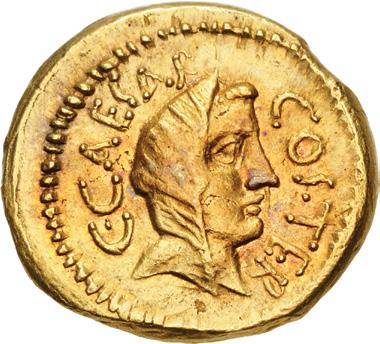



582. The Caesarians. Julius Caesar. Early 46 BC. AV Aureus (19mm, 8.14 g, 3h). Rome mint; A. Hirtius, praetor. Veiled head of female (Vesta or Pietas?) right; C • CAeÍAr COÍ Ter around / Emblems of the augurate and pontificate: lituus, capis, and securis; A • hirTiuÍ • pr around from lower left. Crawford 466/1; Molinari 282 (D37/R245 – this coin); CRI 56; Sydenham 1018; Bahrfeldt 19; Calicó 37; Biaggi –; BMCRR Rome 4052; Kestner 3634-6; RBW 1634. Vibrant orange and red toning, characteristic of the Boscoreale Hoard aurei, minor marks. Near EF ($5000)
From the 1930’s Collection of Robert W. Hubel of Michigan. Ex Cahn 66 (6 May 1930), lot 546. Likely ex Boscoreale Hoard of 1895.
Aulus Hirtius, friend and confidant of Julius Caesar, was praetor in 46 BC, and thus charged with the distribution of the first truly large issue of Roman gold coins to date. The aurei were for distribution to the general’s successful troops after their final victory over the Pompeians in Africa at Thapsus. Each legionary received 5000 denarii (200 aurei), centurions twice that. Since Caesar had at least 40,000 legionnaires at Thapsus, the amount of coin needed was immense. But the amount of booty collected from Caesar’s many campaigns was also colossal, and Hirtius seems to have been able to supply the need. Hirtius later finished the dictator’s memoirs after his assassination and was himself killed at the Battle of Mutina in 43 BC.

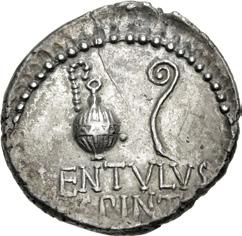
583. The Republicans. C. Cassius Longinus. Spring 42 BC. AR Denarius (19mm, 3.62 g, 6h). Military mint, probably at Smyrna; P. Cornelius Lentulus Spinther, legatus. Diademed head of Libertas right; C • CAÍÍi • iÂp upward to left, LeiBerTAÍ upward to right / Capis and lituus; LeNTuLuÍ/ÍpiNT in two lines below. Crawford 500/3; CRI 221; Sydenham 1307; RSC 4; BMCRR East 77; Kestner 3767; RBW 1762. Iridescent tone, slight roughness, flan crack. Near EF. ($500)
From the 1930’s Collection of Robert W. Hubel of Michigan. Ex Baranowsky (25 February 1931), lot 1268.
Libertas was a prominent feature on the coinage of the assassins of Caesar, who designated themselves liberatores, those who freed Rome from the indignity of monarchial rule.
Ex Evans Collection – Pedigreed to 1934

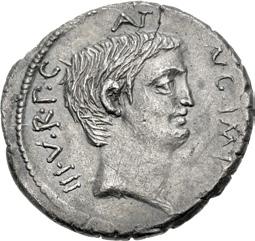


584. The Triumvirs. Mark Antony. Early 41 BC. AR Denarius (20mm, 3.75 g, 9h). Military mint traveling with Antony in Asia Minor. Bare head right; M ég • iÂp iii • u • r • p • C around / Fortuna Redux standing left, holding rudder with right hand and cradling cornucopia in left arm; at feet to left, stork standing left; pieTAÍ • COÍ below. Crawford 516/2; CRI 241; Sydenham 1174; RSC 77; BMCRR Gaul 70-2; Kestner –; RBW 1795; CNR II 123/1 (this coin). Deep cabinet toning, light porosity, scratches and scrapes, flan crack, minor horn silver. Near EF. ($2000)
From the 1930’s Collection of Robert W. Hubel of Michigan. Ex Sir Arthur Evans Collection (Ars Classica XVII, 3 October 1934), lot 1127.


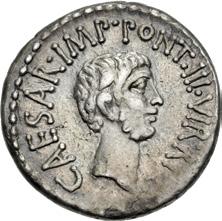

585. The Triumvirs. Mark Antony and Octavian. Spring-early summer 41 BC. AR Denarius (18mm, 3.87 g, 10h). Ephesus mint; M. Barbatius Pollio, quaestor pro praetore. Bare head of Mark Antony right; Â ANT • if Yg iii uir r
p C  BArBAT œ p around / Bare head of Octavian right, with slight beard; CAeÍAr • iÂp • pONT
around. Crawford 517/2; CRI 243; Sydenham 1181; RSC 8a; BMCRR East 100; Kestner 3793-5; RBW 1798. Toned, with hints of iridescence, minor edge surface and marks. Good VF. ($500)
From the 1930’s Collection of Robert W. Hubel of Michigan.



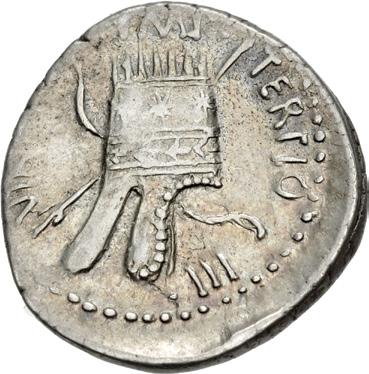
586. The Triumvirs. Mark Antony. Autumn 37 BC. AR Denarius (20mm, 3.68 g, 6h). Antioch or military mint traveling with Canidius Crassus in Armenia. Bare head right; ANTONiuÍ • Augur • COÍ • DeÍ • iTer • eT • TerT around / Sevenpointed Armenian tiara right, decorated with three stars; crossed bow and arrow to left, iÂp • TerTiO • iii • uir • [
p
C] around. Crawford 539/1; CRI 297; Sydenham 1205; RSC 19; BMCRR East 172; Kestner –; RBW 1828. Toned, with iridescence, slightly off center on reverse. VF. Wonderful portrait of Mark Antony. ($2000)
From the 1930’s Collection of Robert W. Hubel of Michigan. Ex Cahn 75 (30 May 1932), lot 815.


587. The Triumvirs. Mark Antony. Summer 32 BC. AR Denarius (20mm, 3.80 g, 11h). Athens mint; M. Junius Silanus, proconsul. Bare head right; small p (signature) in hair below ear; ANTON • Aug iÂp iii COÍ DeÍ iii • iii u r p C around /  • ÍiLANuÍ • Aug/œ • prO • COÍ in two lines. Crawford 542/1; CRI 346; Sydenham 1208; RSC 71; BMCRR East 175-6; Kestner –; RBW 1830. Deep cabinet tone with light iridescence, minor porosity, small scrapes. Good VF. ($750)
From the 1930’s Collection of Robert W. Hubel of Michigan. Ex Cahn 75 (30 May 1932), lot 825.




588. The Triumvirs. Mark Antony. Autumn 32-spring 31 BC. AR Denarius (18mm, 3.49 g, 6h). Legionary type. Patrae(?) mint. Praetorian galley right; ANT • Aug above, iii • uir • r • p • C below / Aquila between two signa; Leg uii across field. Crawford 544/20; CRI 357; Sydenham 1224; RSC 34; BMCRR East 198; Kestner 3849; RBW 1842. Toned, trace deposits, scrapes in field on reverse and edge. EF. ($750)
From the 1930’s Collection of Robert W. Hubel of Michigan.


589. The Triumvirs. Mark Antony. Autumn 32-spring 31 BC. AR Denarius (16.5mm, 3.64 g, 6h). Legionary type. Patrae(?) mint. Praetorian galley right; ANT • Aug above, iii • uir • r • p • C below / Aquila between two signa; Leg xii across lower field. Crawford 544/26; CRI 365; Sydenham 1230; RSC 41; BMCRR East 204; Kestner 3855; RBW –. Toned, with bright iridescence, banker’s mark. EF. ($750)
From the 1930’s Collection of Robert W. Hubel of Michigan.




590. The Triumvirs. Octavian and Mark Antony. Late 39 BC. AR Quinarius (15mm, 1.97 g, 12h). Military mint traveling with Octavian in Gaul. Veiled and diademed head of Concordia right; iii • uir • downward on left, r • p • u • upwards on right / Clasped right hands holding caduceus; Â • ANTON C • CAeÍAr around. Crawford 529/4b; CRI 304; Sydenham 1195; King 81; RSC 67a (Mark Antony); BMCRR East 130; Kestner 3813; RBW 1818. Deep cabinet toning with vibrant iridescence, scrapes and off center obverse. Near EF. ($500)
From the 1930’s Collection of Robert W. Hubel of Michigan.
Wonderful Portrait of Octavian



591. The Triumvirs. Octavian. Summer 37 BC. AR Denarius (20mm, 3.93 g, 12h). Mint in southern or central Italy. Bare head right, wearing beard; iÂp • CAeÍAr • Diui • F
iii • uir • iTer
p • C around / Emblems of the augurate and pontificate: simpulum, aspergillum, guttus, and lituus; COÍ • iTer • eT • Ter • DeÍig around and to right. Crawford 538/1; CRI 312; Sydenham 1334; RSC 91; BMCRR Gaul 116-8; Kestner 3831; RBW 1826. Toned, with iridescence, minor marks, areas of weak strike, scratch and collector’s inventory number 599 on obverse. Good VF. ($500)
From the 1930’s Collection of Robert W. Hubel of Michigan.



592. The Triumvirs. Octavian. Autumn 31 BC. AR Denarius (19mm, 3.43 g, 12h). Cyrene mint. L. Pinarius Scarpus, moneyer. Open right hand left; iÂp • CAeÍAri above, ÍCArpuÍ • iÂp below / Victory standing right on globe, holding wreath tied with fillet in extended right hand and palm frond over left shoulder in left hand; Diui • F downward to right, AuC • pONT downward to left. Crawford 546/6; CRI 413; Sydenham 1282; RIC I 534; RSC 500; BMCRR Cyrenaica 5 = BMCRE 689; BN 894; Kestner –; RBW 1855. Deep cabinet tone with bright blue and red iridescence, roughness, a few scrapes. Near VF. ($750)
From the 1930’s Collection of Robert W. Hubel of Michigan. Ex Sir Arthur Evans Collection (Ars Classica XVII, 3 October 1934), lot 1068. L. Pinarius Scarpus had been appointed by Antony to command his four legions in Cyrenaica against Octavian’s African army, under the command of Cornelius Gallus. After learning of Antony’s defeat at Actium, Scarpus transferred his allegiance to Octavian. This issue was struck shortly after the battle of Actium, the open hand signaling a gesture of friendship toward Octavian.



593. Anonymous. Circa 300/280-276 BC. AR Didrachm (19mm, 7.13 g, 6h). Uncertain mint (Neapolis?). Helmeted head of Mars left; oak spray to right / Horse’s head right, wearing bridle, on base inscribed rOÂANO; stalk of grain behind. Crawford 13/1; Burnett (OB/R2); Sydenham 1; RSC 4; HN Italy 266; BMC RR Romano-Campanian 1; Kestner 2-3; RBW 3. Cabinet toning, slight roughness, small scrapes. VF. ($1000)


594. Anonymous. Circa 230-220 BC. Æ Aes Grave Dupondius (60mm, 123.2 g, 6h). Volterrae (Etruria) mint. Janiform head of Culsans, wearing pointed petasus / Club; (mark of value) to left, around. HN Italy 109a; ICC 136; Haeberlin p. 83, 1-6. Rough green patina, light scuff on reverse. VF. ($750)
From the John Morcom Collection. Ex Numismatica Ars Classica K (30 March 2000), lot 1391.


595. Anonymous. Circa 225-217 BC. Æ Aes Grave As (62mm, 260.75 g, 12h). Sickle series. Rome mint. Head of bearded Janus; – (mark of value) below; all on a raised disk / Prow of galley right; | (mark of value) above; all on a raised disk. Crawford 35/1; ICC 74; Sydenham 71; HN Italy 337; RBW 83. Dark green patina, some small casting pits and minor cleaning scratches. Good VF. A wonderful example with a clear mark of value on the obverse. ($1500) Ex Cayón (24 June 2010), lot 1135.



596. Anonymous. Circa 225-212 BC. AR Didrachm – Quadrigatus (24.5mm, 6.61 g, 6h). Rome mint. Laureate head of Janus, curved truncation / Jupiter, hurling thunderbolt with right hand and holding scepter in left, in galloping quadriga driven right by Victory, holding reins in both hands; rOÂa incuse on raised tablet in exergue. Crawford 28/3; Sydenham 64; HN Italy 334; RSC 23; BMCRR Romano-Campanian 83; Kestner 89–90 and 94; RBW 65–6. Toned, with luster, flan crack, minor marks, scrape on reverse. EF. ($1500)
Ex Bertolami Fine Arts 44 (20 April 2018), lot 185; Numismatic Fine Arts inventory 62226 (ND).



597. M. Aburius M.f. Geminus. 132 BC. AR Denarius (19mm, 3.93 g, 12h). Rome mint. Head of Roma right, wearing winged helmet, ornamented with griffin’s head, the visor in three pieces and peaked, single-pendant earring, and pearl necklace, hair falling in three locks; ge downward to left, • (mark of value) below chin / Sol, radiate, wearing cloak, driving galloping quadriga right, holding whip in right hand and reins in left;  • äœi below, rOÂA in exergue. Crawford 250/1; Sydenham 487; Aburia 6; BMCRR Rome 995-7; Kestner 2260-3; RBW 1027. Attractive vibrant iridescent toning. Superb EF. ($750)
Ex Áureo & Calicó 319 (7 November 2018), lot 65; Numismatica Ars Classica 21 (17 May 2001), lot 201; Numismatica Ars Classica 11 (29 April 1998), lot 190.


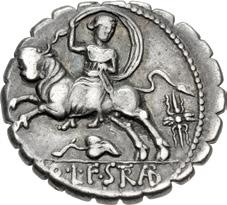
598. L. Volteius L.f. Strabo. 81 BC. AR Serrate Denarius (18.5mm, 3.98 g, 3h). Rome mint. Laureate head of Jupiter right; F to left / Europa, holding veil over her head, seated on bull galloping left; thunderbolt to right, vine leaf on tendril below, [L • u]O • L • F • Í7ä in exergue. Crawford 377/1; Campana, Strabo 77 (O9/R9 – this coin); Sydenham 743; Volteia 6; BMCRR Rome 3144; Kestner 3204; RBW 1400 var. (control). Toned. VF. Rare. ($750)
Ex New York Sale III (7 December 2000), lot 398.



599. Cn. Lentulus. 76-75 BC. AR Denarius (19mm, 3.86 g, 6h). Mint in Spain(?). Diademed and draped bust of Genius Populi Romani right, scepter over shoulder; g • p • r • above / ex Í • C divided by scepter with wreath, globe, and rudder; CN • LeN • œ below. Crawford 393/1a; Sydenham 752; Cornelia 54; BMCRR Spain 52–6; Kestner 3279–80; RBW 1432. Lightly toned, with iridescence and luster, small die flaws. EF. ($750)
Ex Scipio Collection (Roma XXIII, 24 March 2022), lot 589; Numismatica Ars Classica 2 (21 February 1990), lot 356.



600. Q. Fufius Calenus and Mucius Cordus. 68 BC. AR Serrate Denarius (21mm, 3.88 g, 6h). Rome mint. Jugate heads right of Honos, laureate, and Virtus, wearing crested helmet; hO to left, uiÛ to right; kALeNi below / Italia standing right, holding cornucopia in left hand, vis-à-vis Roma standing left, foot on globe and holding scepter in left hand, clasping right hands; to left, winged caduceus above ië; rO to right, COrDi in exergue. Crawford 403/1; Sydenham 797; Fufia 1; BMCRR Rome 335863; Kestner 3299-300; RBW 1445. Deep cabinet tone with iridescence, small scrape on obverse. EF. ($500)
From the CLA Collection.




601. L. Torquatus. 58 BC. AR Denarius (18.5mm, 3.99 g, 6h). Rome mint. Head of Sibylla right, wearing ivy wreath; [ÍiBULLA below] / Tripod surmounted by amphora between two stars; L • TOrœuAT downward to left, iii • uir upward to right; all within ornamented torque. Crawford 411/1a-b var. (border on obv.); Sydenham 836; Manlia 12a; BMCRR Rome 3514 corr. (no border on obv.); Kestner –; RBW –. Toned and lustrous with hints of iridescence, light scratches, a few spots of find patina. EF. From dies of fine style. ($1500)
Ex Bertolami Fine Arts 67 (11 July 2019), lot 288.
The moneyer Lucius Manlius Torquatus, later famous as a champion of Cicero and enemy of Caesar, was a member of the Quindecimviri Sacris Faciundis, a religious collegium responsible for consulting the Sibylline Books in times of crisis. The three books were allegedly the work of a prophetess, the Sibyl of Cumae, whose cryptic pronouncements predicted the future of Rome for those able to properly interpret them. The Sibyl (here named Sibylla) is depicted on the obverse of this attractive silver denarius. According to Ovid, the Sibyl was a beautiful young woman who captivated the god Apollo (represented by the tripod on the reverse). The god offered to grant her any wish in return for her virginity. She scooped up a handful of sand and asked to live as many years as the number of grains within it. However, she had neglected to ask for eternal youth, and so, over 1,000 years, her body withered away until only her voice remained.
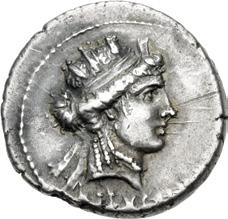

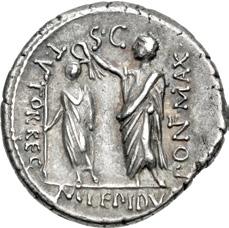
602. M. Aemilius Lepidus. 58 BC. AR Denarius (18mm, 4.07 g, 12h). Rome mint. Head of Alexandria right; wearing mural crown, triple-pendant earring, and pearl necklace; ALexANDreA below / M. Lepidus standing left, crowning the young Ptolemy V with his right hand, who stands facing, holding staff with his right hand; T • uTOr • reg to left; Í • C above, pOá • ÂAx • to right; Â • LepiDuÍ in exergue. Crawford 419/2; Sydenham 831; Aemilia 23; BMCRR Rome 3648; Kestner 34301; RBW 1511 var. (rev. legend arrangement). Toned, with some iridescence, minor marks, scrapes and slightly off center on obverse. Good VF. ($1000)

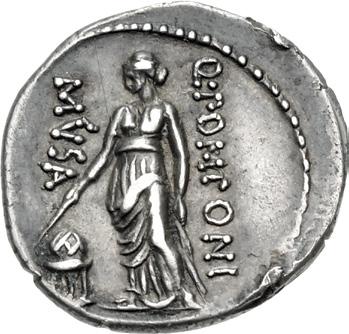

603. Q. Pomponius Musa. 56 BC. AR Denarius (19mm, 3.81 g, 2h). Rome mint. Head of Apollo right, wearing laurel wreath, hair rolled back and in loose locks over forehead; star of nine rays to left / Urania, the Muse of Astronomy, wearing long flowing tunic and peplum, standing left, touching with wand held in right hand a globe set on base; œ • pOÂpONi downward to right, ÂuÍA downward to left. Crawford 410/8; Sydenham 823; Pomponia 22; BMCRR Rome 3628-32; Kestner 3385-6; RBW 1488. Deeply toned, faint scratches under tone, edge marks. Good VF. ($500)
From the CLA Collection.



604. Faustus Cornelius Sulla. 56 BC. AR Denarius (19mm, 3.77 g, 3h). Rome mint. Diademed and draped bust of Diana right, wearing cruciform earring, necklace of pendants, and her hair collected into a knot at back of head, which is decorated with jewels; lituus to left, FAuÍTuÍ downward to right / Sulla, togate, seated left on raised seat; on left, Bocchus, king of Mauretania, kneeling right, offering an olive branch; to right, Jugurtha, king of Numidia, kneeling left, his hands tied behind him; FeLix downward to upper right. Crawford 426/1; Sydenham 879; Cornelia 59; BMCRR Rome 3824; Kestner 3455; RBW 1525. Toned, porosity, flan crack. Good VF. ($500)
From the CLA Collection, purchased from Tom Cederlind.
Faustus was the son of Lucius Cornelius Sulla, the famous general and dictator of Rome (138-78 BC). The coin portrays Sulla’s first great victory, in which he ended the Jugurthine War. Jugurtha, grandson of Massinissa of Numidia, had claimed the entire kingdom of Numidia and divided it between several members of the royal family, in defiance of Roman decrees. Rome declared war on Jugurtha in 111 BC, but for five years the wily king frustrated all efforts to bring him to heel. Finally, in 106 the popular general Marius was assigned command, with Sulla as quaestor in charge of cavalry. Before Marius could take to the field against the enemy, however, Sulla arranged with his ally Bocchus of Mauretania to have Jugurtha ambushed and captured. Sulla was acclaimed for the bloodless end of the war, gaining his first victory and the eternal enmity of Marius.




605. C. Coelius Caldus. 53 BC. AR Denarius (18mm, 3.93 g, 7h). Rome mint. Bare head of the consul C. Coelius Caldus right; to left, tablet inscribed L • D (Libero : Damno); C • COeL • CALDuÍ downward to right; COÍ below / Radiate head of Sol right; to left, Í above oval shield decorated with thunderbolt; downward to right, [CALDu]Í • iii uir and Macedonian shield. Crawford 437/1b; Sydenham 892; Coelia 5; BMCRR Rome 3835; Kestner 3499; RBW 1550. Lustrous, traces of die rust, slightly off center on reverse. EF. ($750)



606. Moneyer issues of Imperatorial Rome. L. Hostilius Saserna. 48 BC. AR Denarius (19.5mm, 3.77 g, 4h). Rome mint. Head of Gallic captive (Vercingetorix?) right, wearing hair flowing back and long, pointed beard, and a chain around his neck; Gallic shield to left / Two warriors in biga right: one driving, holding whip in right hand and reins in left, and the other, facing backward, holding shield in left hand and brandishing spear in right; L • hOÍTiLiuÍ above, ÍAÍerN below. Crawford 448/2a; CRI 18; Sydenham 952; Hostilia 2; BMCRR Rome 3994-5; Kestner 3538-40; RBW 1569. Lightly toned, bankers’ marks. VF. Well centered. ($1000)
The portrait on the obverse has sometimes been identified as the famous chief of the Arverni, Vercingetorix, whom Julius Caesar captured in 52 BC in Alesia. It is difficult to imagine anyone placing such a dramatic portrait of a defeated foe on their coinage, but it is clear from surviving sources of the period that the Romans had a good deal of respect for the Gauls as honorable warriors. Crawford and Sear believe this identification is unlikely, but the large, distinctive, and carefully engraved head suggests the die cutter worked with an eye toward creating an individualized portrait, rather than a stylized personification of a Gaul. The reverse is also of particular historical interest, in that it depicts the manner in which chariots were used in Celtic Gaul, and perhaps in Britain as well.


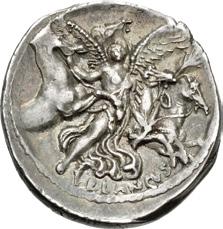
607. Moneyer issues of Imperatorial Rome. L. Plautius Plancus. 47 BC. AR Denarius (18mm, 3.86 g, 6h). Rome mint. Facing mask of Medusa with disheveled hair; L • pLAuTiuÍ below / Aurora, draped and winged, flying right, head facing slightly left, holding palm frond in left hand, conducting four rearing horses of the sun; pLANCuÍ below. Crawford 453/1c; CRI 29a; Sydenham 959b; Plautia 14; BMCRR Rome 4009-10; Kestner 3563; RBW 1585. Toned, with iridescence, minor weakness. Near EF. ($750)
Ex Bertolami Fine Arts 109 (4 May 2022), lot 420 (hammer €1700).




608. A. Licinius Nerva. 47 BC. AR Sestertius (10mm, 0.69 g, 10h). Rome mint. Laureate head of Apollo right; [NeruA downward to left] / Victory advancing right, holding wreath in right hand and palm frond in left over left shoulder; A LiCiNi to right. Crawford 454/4; CRI 32; Sydenham 957; Licinia 26; BMCRR Rome 4003; Kestner –; RBW 1592. Toned, porosity, scratches, delaminations, off center on obverse. VF. Extremely rare, only two in CoinArchives. ($1000)



609. The Pompeians. Cnaeus Pompeius Magnus (Pompey the Great). Spring 48 BC. AR Denarius (19mm, 3.73 g, 6h). Mint moving with Pompey in Greece; Cn. Calpurnius Piso, proquaestor. Head of Numa Pompilius right, wearing diadem inscribed NuÂA; CN • piÍO • prO • œ to left / Prow of galley right; ÂAgN above, prO • COÍ below. Crawford 446/1; CRI 7; Sydenham 1032; RSC 4 (Pompey the Great); BMCRR Spain 62; Kestner 3533; RBW 1565. Deeply toned, small die flaw on reverse. EF. Good metal. ($1000)
From the Michael Rogal Collection. Ex Archer M. Huntington Collection, HSA 1001.1.10492 (Triton XX, 10 January 2017), lot 560.




610. The Pompeians. Q. Caecilius Metellus Pius Scipio and Eppius. 47- Spring 46 BC. AR Denarius (17mm, 3.82 g, 12h). Military mint traveling with Scipio in Africa. Small head of Africa right, wearing elephant skin headdress; ÍCipiO • iÂ[p] upward to left, grain ear and œ • ÂeTeLL downward to right, plow below / Hercules standing facing, right hand on hip, leaning on club draped with lion skin and set on rock; [Leg • F • C upward to left], eppiuÍ downward to right. Crawford 461/1; CRI 44; Sydenham 1051; Caecilia 50; BMCRR Africa 12; Kestner 3586; RBW 1605. Residual luster. EF. Well struck. ($750)
Ex Tauler & Fau 118 (22 November 2022), lot 45.


611. The Pompeians. Sextus Pompey. 42-38 BC. Æ As (31mm, 22.96 g, 12h). Uncertain Sicilian mint. Laureate janiform head of Pompey the Great; VgN / Prow of galley right, galley decorated with star and eye on side; piuÍ above; iÂp. Crawford 479/1; Martini, Sextus Emission III, Group 1, Series D, 453-4 (D6/R71); CRI 336; Sydenham 1044; BMCRR Spain 101; Kestner 3679-80, 3682-3; RBW 1675–6. Green patina, light porosity, flan adjustment marks. Good VF. ($750)
After the defeat of his father and brother by Julius Caesar, Sextus Pompey set up shop in Sicily and carried on as a pirate king, raiding Roman commerce and making a nuisance of himself to Octavian, Caesar’s successor as ruler of Italy. Repeated attempts by Octavian to corral Sextus failed ignominiously, once nearly costing Octavian his life. In 39 BC, Sextus entered into a power-sharing agreement with Octavian and his fellow Triumvirs, Mark Antony and Lepidus. But he continued to serve as a magnet for Senatorial resistance and disaffection, so Octavian renewed hostilities the following year. The brilliant admiral Agrippa finally defeated Sextus at Naulochos in 36 BC, but he escaped, fleeing to Antony, who kept him alive as a bargaining chip for awhile, then executed him. The as coinage in the name of Pompey the Great is catalogued sequentially by Martini according to the obverse bust. First a traditional head of Janus, then a janiform head of Pompey the Great, followed by successive series of “mature” and “juvenile” imitative portraits.



612. The Caesarians. Julius Caesar. April-August 49 BC. AR Denarius (19mm, 3.85 g, 1111h). Military mint traveling with Caesar. Elephant advancing right, trampling on horned serpent; CAeÍAr in exergue / Emblems of the pontificate: simpulum, aspergillum, securis, and apex. Crawford 443/1; CRI 9; Sydenham 1006; RSC 49; BMCRR Gaul 27-30; Kestner 3515-8; RBW 1557. Iridescencent toning, minor marks, trace deposits. EF. ($1500)
From the Michael Rogal Collection. Ex Kallman Collection (Triton XX, 10 January 2017), lot 570; Gorny & Mosch 164 (17 March 2008), lot 342; G. Hirsch 245 (4 May 2006), lot 354.
Despite being the most widespread of all Caesar’s coins, the design of this type, the first issue in the dictator’s name, is still somewhat mysterious. Authorities have even debated which side is which: Crawford describes the elephant as the obverse, but other experts dispute this. The symbolism is commonly held to show the triumph of good (elephant) over evil (serpent or dragon). Alternatively, the “horned serpent” may be intended to represent a carnyx, a serpent-shaped horn used by the Celtic tribes in Gaul, whom Caesar had recently overcome in his epic eight-year conquest. In this case, the elephant could represent Caesar himself, or the unstoppable juggernaut of Rome.


613. The Caesarians. Julius Caesar. April-August 49 BC. AR Denarius (19mm, 4.07 g, 3h). Military mint traveling with Caesar. Elephant advancing right, trampling on horned serpent; CAeÍAr in exergue / Emblems of the pontificate: simpulum, aspergillum, securis, and apex. Crawford 443/1; CRI 9; Sydenham 1006; RSC 49; BMCRR Gaul 27-30; Kestner 3515-8; RBW 1557. In NGC encapsulation 2482400-014, graded XF, Strike: 3/5, Surface: 5/5. ($750)




614. The Caesarians. Julius Caesar. Late 46-early 45 BC. AV Quinarius (15mm, 3.97 g, 7h). Rome mint; L. Munatius Plancus, praefectus urbi. Draped and winged bust of Victory right; C • CAeÍ DiCT • Ter around / Praefericulum; L • pLANC up left, prAeF • 9B down right. Crawford 475/2; CRI 61; Sydenham 1020; Bahrfeldt 22; Biaggi 31; King 68; BMCRR Rome 4123; Kestner 3671; RBW 1665-6. Lightly toned, scratches and scrapes. Good Fine. Very rare. ($2000)



615. The Caesarians. Julius Caesar. February-March 44 BC. AR Denarius (18mm, 3.63 g, 6h). Lifetime issue. Rome mint; P. Sepullius Macer, moneyer. Wreathed head right; CAeÍAr downwards to right, DiCT perpeTuO upwards to left / Venus Victrix standing left, holding Victory in extended right hand and vertical scepter in left; shield set on ground to right; p ÍepuLLiuÍ downwards to right, ÂACer downwards to left. Crawford 480/10; Alföldi Type VIII, 24-25 (A12/R3); CRI 107a; Sydenham 1073; RSC 38; BMCRR Rome 4169–71; Kestner –; RBW –. Toned, with light iridescence, weakness at the periphery, scrape on reverse. VF. ($1500)
From the CLA Collection. Ex Berk BBS 63 (13 June 1990), lot 316.
When Crassus was killed in the Parthian campaign in 53 BC, the two remaining members of the First Triumvirate were Julius Caesar and Pompey the Great. The rivalry between them increased tremendously. In 51 and 50 BC, as Caesar’s appointment in Gaul was nearing an end, the Senate also became fearful, and moved increasingly towards Pompey and his army. Caesar’s legions, full of battle-hardened veterans, felt their loyalty was first to Caesar, and second to Rome. Also, Caesar became very popular with the common people in Rome, who were always a danger to the aristocratic Senate. On January 1, 49 BC, the Senate demanded that Caesar disband his army before returning to Italy. The problem with this was that if Caesar went to Rome defenseless, he would be vulnerable to prosecution by his political enemies. Thus, Caesar fatefully crossed the Rubicon River, famously proclaiming “alea iacta est”- “the die is cast.” With his veteran 13th Legion at his back, he faced no challengers in Italy. Pompey was unable to muster sufficient forces and was forced to flee to Greece where Caesar defeated him at Pharsalus on August 9, 48 BC. Caesar then began subduing Rome’s enemies, one after another. The Senate, in response, began heaping honors and praise upon him. On February 14, 44 BC, the Senate awarded him the title of dictator perpetuus (dictator for life), indicated on this coin in the legend – DICT PERPETVO. Concurrently, a conspiracy had been in the works for several months to eliminate Caesar and return power to the Senate, headed by Brutus and Cassius. This came to fruition when Caesar was killed on the Ides of March (March 15), 44 BC. Therefore, this coin can be attributed to that one-month period between the time Caesar was given the title of dictator perpetuus and his death.

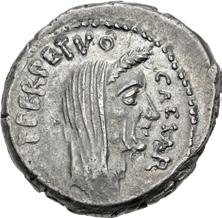


616. The Caesarians. Julius Caesar. February-March 44 BC. AR Denarius (18mm, 4.05 g, 10h). Lifetime issue. Rome mint; P. Sepullius Macer, moneyer. Wreathed and veiled head right; CAeÍAr downward to right, DiCT perpeTuO upward to left / Venus Victrix standing left, holding Victory in extended right hand and vertical scepter in left; shield set on ground to right; p • ÍepuLLiuÍ downward to right, ÂACer downward to left. Crawford 480/13; Alföldi Type IX, 91-2 (A48/R56); CRI 107d; Sydenham 1074; RSC 39; BMCRR Rome 4173-4; Kestner 3688-9; RBW 1685. Toned, with hints of iridescence, some luster, minor marks, area of weak strike. Near EF. Superior to either specimen plated in Alföldi. ($3000)
Ex Paulo Leitão Collection (Numismatica Ars Classica 59, 4 April 2011), lot 836; Numismatic Fine Arts X (17 September 1981), lot 290 (conserved since).


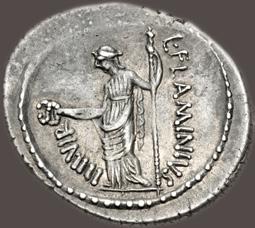

617. The Caesarians. Julius Caesar. 41 BC. AR Denarius (19mm, 3.77 g, 3h). Rome mint. L. Flaminius Chilo, moneyer. Wreathed head right / Pax standing left, holding a caduceus in right hand and vertical scepter in left; L • FLAÂiNiuÍ downwards to right, iii • uir upwards to left. Crawford 485/1; CRI 113; Sydenham 1089; RSC 26; BMCRR Rome 4201-2; Kestner 3699; RBW –. Toned, minor area of weakness, scratches on obverse. Near EF. Outstanding portrait of fine style, struck in high relief. ($10,000)
While this coin derives its general type from those issues struck at Rome in the month prior to Caesar’s assassination in March 44 BC, its anepigraphic obverse now shows a head of Caesar that is no longer veiled, while on the reverse, Venus Genetrix holds a caduceus in place of the traditional Victory. The idealized portrait of Julius Caesar, with its definite impression of divinity, is not an individual dieengraver’s attempt at artistic fancy, but must have been influenced by Octavian’s consciously conceived program of manipulating public images (including that of Caesar) at Rome.
On 1 January 42 BC, the Senate recognized Caesar’s new divine status as the Divus Julius and constructed a temple on the site of his cremation in the Forum. The Venus Genetrix on the reverse shows a similar manipulation. Deriving from the Greek Aphrodite Ourania, or heavenly Aphrodite, Venus Genetrix became not only the divine patroness of Rome through her son Aeneas, but also the ancestor of the gens Julia, through Aeneas’ son, Ascanius (Iulus). On the night before Pharsalus in 48 BC, Caesar vowed to construct a temple in her honor in Rome if he was successful against Pompey. Once completed, this temple, which housed a statue of the goddess, then became the centerpiece of his new forum in Rome. There are marked differences, however, between the statue (evidenced by several extant copies) and her depiction on the denarii struck in the month before his assassination. While the statue emphasized her procreative powers, the coins show her in a more martial and political context: holding a Victory in her right hand and a scepter in her left, either surrounded by weaponry (sometime set on a globe), or with the scepter set on a star (a sign of divinity). While these attributes may shift from one to another, they emphasize not only the divine assistance in Caesar’s military and political victories, but also allude tentatively to his semi-divinity. The Venus of this coin, however, minimizes her connection to earlier associations; instead, she now presents an image of Felicitas (Good Fortune), by replacing the Victory with a caduceus. It is not the Venus Genetrix of Julius Caesar, then, but now Venus Felix of all Rome who is at work. Thus, through the assistance of the two transformed divine agencies – the impending one of the Divus Julius, and that of Venus – Octavian was able to take his first few steps toward political ascendancy.



618. The Caesarians. Divus Julius Caesar. 40 BC. AR Denarius (20mm, 3.89 g, 11h). Rome mint; Q. Voconius Vitulus, moneyer. Wreathed head right; lituus to left, Diui • iuLi downwards to right / Bull-calf walking left; œ • uOCONiuÍ above, uiTuLuÍ in exergue. Crawford 526/2; CRI 329; Sydenham 1132; RSC 46; BMCRR Rome 4308-10; Kestner 3808; RBW –. Toned, minor marks, graffito, banker’s mark on obverse. Good VF. ($1000)
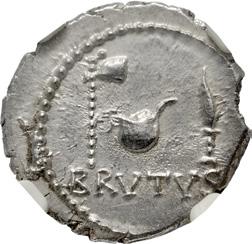
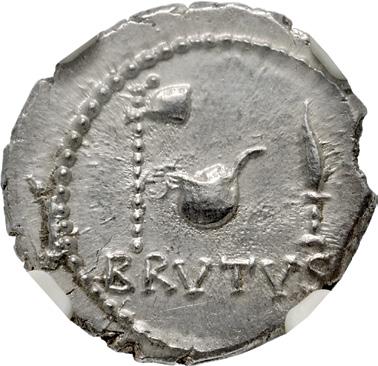

619. The Republicans. Brutus. Early 42 BC. AR Denarius (18mm, 3.41 g, 12h). Military mint, probably at Smyrna; P. Cornelius Lentulus Spinther, legatus. Emblems of the pontificate: securis, simpulum, and secespita; BruTuÍ below / Emblems of the augurate: capis and lituus; LeNTuLuÍ/ÍpiNT in two lines below. Crawford 500/7; CRI 198; Sydenham 1310; RSC 6; BMCRR East 80-1; Kestner 3770; RBW 1766. In NGC encapsulation 2491174-002, graded MS, Strike: 5/5, Surface: 4/5. ($1500)
The obverse depicts the symbols of the college of pontifices to which Brutus belonged, while the reverse bears the symbols of the priestly college to which P. Cornelius Lentulus Spinther was elected in 57 BC, namely, the augurate.


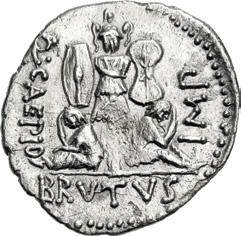

620. The Republicans. Brutus. Early summer 42 BC. AR Denarius (20mm, 3.45 g, 12h). Military mint traveling with Brutus in Lycia; Q. Caepius, legatus. Draped bust of Apollo right, hair in ringlets, wearing taenia and laurel wreath / Trophy composed of helmet, cuirass, and two shields, one with incurved sides; below, male and female captives seated at base, each resting head in their hand œ • CAep iO downward to left, BruTus in exergue, iÂp upward to right. Crawford 503/1; CRI 204; Sydenham 1293; RSC 8; BMCRR East 52; Kestner –; RBW –. Lightly toned, with some luster, scrapes and light porosity, some weakness on reverse, crystallization at edges. Good VF. Extremely rare, only three in CoinArchives. ($7500)


621. The Republicans. Brutus. Late summer-autumn 42 BC. AR Denarius (18mm, 3.60 g, 12h). Military mint traveling with Brutus and Cassius in western Asia Minor or northern Greece; P. Servilius Casca Longus, moneyer. Laureate and bearded head of Neptune right; trident below, CAÍCA upward to left, LONguÍ upward to right / Victory advancing right on broken scepter, holding palm frond in left hand over left shoulder and broken diadem bound with fillet in both hands; BruTuÍ upward to left, iÂp upward to right. Crawford 507/2; CRI 212; Sydenham 1298; RSC 3; BMCRR East 63-5; Kestner 3779; RBW 1780. Lightly toned, with golden red iridescence, minor pitting, small scrape on reverse. Good VF. ($1000)
From the CLA Collection. Ex CNG inventory 720323 (3 May 2000).
P. Servilius Casca Longus was one of the leading conspirators against Caesar and was actually the first to plunge his dagger into the dictator on the Ides of March, 15 March, 44 BC. He later joined Brutus in the East and was entrusted with the command of a fleet. He fought bravely at Philippi, but when it became clear that all was lost he emulated his commander by committing suicide. This remarkable type, issued in the months preceding Philippi, graphically symbolizes the anticipated defeat of the forces of tyranny which, in the view of the ‘liberators’, were aiming at the destruction of Rome’s republican constitution and its replacement by an autocratic form of government. It is ironic that while Casca’s denarius depicts Victory breaking the diadem of royal power, his aureus shows Brutus’ portrait surrounded by a similar symbol of regal or even divine status. The appearance of Neptune, god of the sea, is probably in celebration of Cassius’ naval exploits against the Rhodians.





622. The Republicans. Brutus. Late summer-autumn 42 BC. AR Denarius (17.5mm, 3.75 g, 12h). Military mint traveling with Brutus and Cassius in western Asia Minor or northern Greece; L. Plaetorius Cestianus, magistrate. Bare head of Brutus right; BruT above, iÂp to right, L • pLAeT • CeÍT around to left / Pileus between two daggers pointing downward; eiD • ÂAr below. Crawford 508/3; Campana, Eid Mar 40-1 (O2/R13); Cahn 13a-b; CRI 216; Sydenham 1301; RSC 15; BMCRR East 68-70; Kestner –; RBW –. Toned, with hints of iridescence, minor marks and scratches, scrapes on obverse, banker’s mark on reverse. Good VF. Very rare. The most famous of all Roman coins. This coin not plated in Campana. ($250,000)
From the Collection of a Connoisseur Classicist, purchased from Numismatica Ars Classica, early 1990’s.
Surely the most iconic and important coin associated with an event in ancient history, this denarius pointedly commemorates the assassination of Julius Caesar by depicting the perpetrator of the act (Brutus), by naming the date of the act (EID[ibus] MAR[tiis], and by displaying the instruments of the act (daggers) between the reason for the act (the pileus [freedman’s cap] as a symbol of liberty). Though many senators plotted against Caesar and are collectively represented by the two daggers, the portrait of Brutus alone emphasizes his primary role in the conspiracy.
The only securely identified portraits of Brutus occur on coins inscribed with his name; all others, whether on coins or other artifacts, are identified based on the three issues inscribed BRVTVS IMP (on aurei) or BRVT IMP (on denarii). A careful study of Brutus’ portraits by S. Nodelman segregates these inscribed portraits into three main categories: a ‘baroque’ style portrait on the aurei of Casca, a ‘neoclassical’ style on the aurei of Costa, and a ‘realistic’ style on the ‘EID MAR’ denarii, which Nodelman describes as “the soberest and most precise” of all.
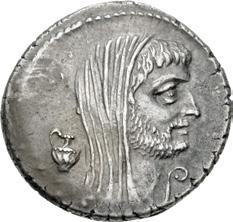


623. The Triumvirs. Mark Antony. April-May 44 BC. AR Denarius (19mm, 4.04 g, 3h). Rome mint; P. Sepullius Macer, moneyer. Veiled head right, wearing beard; capis to left, lituus to right / Desultor (horseman who leaps from one horse to another), wearing conical cap and holding whip in right hand, right on horseback, second horse at side in background; palm frond and wreath to left; p • ÍepuLLiuÍ above, [ÂACer below]. Crawford 480/22; Alföldi Type XXI, 50-1 (A9/R11); CRI 142; Sydenham 1077; RSC 74; BMCRR Rome 4178; Kestner –; RBW 1689. Mottled toning, off center on reverse. Good VF. ($2000)
Ex Artemide LIX (6 May 2023), lot 502.




624. The Triumvirs. Mark Antony. Summer 40 BC. AR Denarius (17mm, 3.82 g, 12h). Uncertain mint (Corcyra?). Bare head right; lituus to left / Caduceus between cornucopias, all set on globe; Â • ANT • if
above, iii
uir
C
below. Crawford 520/1; CRI 256; Sydenham 1189; RSC 66a; BMCRR East 114; Kestner –; RBW –. Lightly toned, minor deposits, area of weakness on reverse. EF. Excellent portrait. Extremely rare. ($4000)


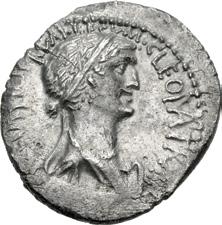
625. The Triumvirs. Mark Antony and Cleopatra. Autumn 34 BC. AR Denarius (18mm, 3.27 g, 12h). Alexandria mint(?). Bare head of Mark Antony right; Armenian tiara to left, ANTONi • ArÂe[NiA • DeuiCTA] around / Diademed and draped bust of Cleopatra right; at point of bust, prow right; CLeORATrAe re2iNAe • re2u • FiLiOru • re2u around. Crawford 543/1; CRI 345; Sydenham 1210; RSC 1; BMCRR East 179–81; cf. Kestner 3836; RBW 1832. Toned, with some luster, porosity, cleaning marks, flan crack, off center on obverse. Good VF. ($5000)
The consensus of opinion on the date and mint of this coin was relatively uniform until the publication by R. Newman, “A Dialogue of Power in the Coinage of Antony and Octavian” in AJN 2 (1990), pp. 37-64. Sear (CRI) follows Newman in calling it an issue from Alexandria struck for Antony’s Armenian triumph of the autumn of 34 BC, when the “celebrated and enigmatic” (per Sear) “Donations of Alexandria” took place. Newman states the minting of this coin “must have taken place in 34, the year of Antony’s Alexandrian triumph, since it would otherwise be without context.” The legends on this coin could be translated as “[coin] of Antony, with Armenia being Conquered, for Cleopatra, Queen of Kings and of her Sons, being Kings.” The Armenian crown behind Antony represents his victorious Roman army, the prow beneath Cleopatra (which appears on no other Roman coin of hers) stands for the mighty Egyptian fleet; combined they symbolize the full array of forces that Antony would soon marshal against Octavian.


626. The Triumvirs. Mark Antony. Autumn 32-spring 31 BC. AR Denarius (15mm, 3.89 g, 6h). Legionary type. Patrae(?) mint. Praetorian galley right; ANT Aug above, iii uir • r • p • C below / Aquila between two signa; Leg iii across lower field. Crawford 544/15; CRI 350; Sydenham 1217; RSC 28; BMCRR East 193; Kestner 3844; RBW 1839. Lustrous, a few scratches and die flaws. Choice EF. ($750)


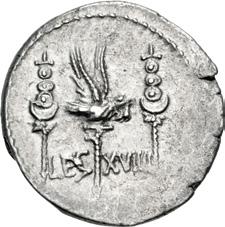
627. The Triumvirs. Mark Antony. Autumn 32-spring 31 BC. AR Denarius (18.5mm, 3.72 g, 8h). Patrae(?) mint. Praetorian galley right; ANT • Aug above, iii • uir • r • p • C below / Aquila between two signa; Leg xuiiii across lower field. Crawford 544/34; CRI 379; Sydenham 1241; RSC 54; RBW –; CNG 114, lot 697 (same dies; hammer $20,000). Toned, with underlying luster, area of weakness, edge mark. Good VF. Well detailed reverse. An extremely rare type with XVIIII, as opposed to the more frequently encountered LEG XIX. ($5000)
Not to be confused with a similar legion under the command of Octavian, this Antonian legion was either disbanded or incorporated into another legion after Actium. Antonian legionary denarii were hammered out in such great numbers that uniformity in die engraving suffered; hence some engravers chose different ways of depicting the same Roman numeral – XIX and XVIIII are both seen, although the longer form is considerably rarer.




628. The Triumvirs. Mark Antony. Summer 31 BC. AR Denarius (17.5mm, 3.88 g, 12h). Uncertain mint (Actium?). Bare head right; Â • ANTONiuÍ • Aug iÂp • iiii • COÍ • TerT iii • uir •
p
C / Victory standing left, holding wreath in extended right hand and cradling palm frond in left arm; all within wreath. Crawford 545/2; CRI 388; Sydenham 1211a; RSC 81; BMCRR East 228; Kestner –; RBW 1851. Toned, with some luster, faint hairlines. Superb EF. An outstanding strike. ($10,000)


629. The Triumvirs. Octavian. 42 BC. AR Denarius (19mm, 4.06 g, 12h). Rome mint. L. Livineius Regulus, moneyer. Bare head right, wearing slight beard; C • CAeÍAr • iii • uir • r • p • C around / Victory standing right, holding wreath in right hand and palm frond over left shoulder; reguLuÍ downward to left, L • LiuiNeiuÍ downward to right. Crawford 494/25; CRI 157; Sydenham 1107; RSC 443; BMCRR Rome 4260; Kestner 3731; RBW 1731. Toned, with light iridescence, minor marks. Good VF. ($500)
From the Michael Rogal Collection. Ex Triton XX (10 January 2017), lot 597; Goldman Collection (Triton XVI, 8 January 2013), lot 969; Tkalec (29 February 2008), lot 276.



630. The Triumvirs. Octavian, Divus Julius Caesar, and Agrippa. 38 BC. AR Denarius (19mm, 3.80 g, 3h). Military mint traveling with Agrippa in Gaul or Octavian in Italy. Laureate head of the deified Julius Caesar right, vis-à-vis bare head of Octavian left; DiuOÍ iuLiuÍ upward to left, Diui F downward to right / Â • AgrippA COÍ/DeÍig in two lines. Crawford 534/2; CRI 306; Sydenham 1330; RSC 129; BMCRR 100–1; Kestner –; RBW –. Deep cabinet tone, minor marks. Good VF. ($10,000)
Ex Alba Longa Collection (Áureo & Calicó 339, 14 November 2019), lot 1061 (hammer €15,000).
Marcus Agrippa was Octavian’s boyhood friend, lieutenant, and and eventual chosen heir, adopted by the then-known Augustus in 17 BC to ensure a smooth succession. Agrippa’s prominence in political affairs was emphasized in 13 BC, when two of the three moneyers included Agrippa on their coin types. Succession was not to be, however, as Agrippa died the following year.
This coin names Agrippa as “consul designate”, in anticipation of his consulship the following year. It was probably minted in Gaul under Agrippa, who was named governor of Transalpine Gaul in 39 or 38 BC. It was in the latter year, the year this coin was struck, that Agrippa put down an uprising of the Aquitanians.



631. The Triumvirs. Octavian. Autumn 30 BC. AR Denarius (19.5mm, 3.78 g, 1h). Uncertain mint in Italy (Rome?). Victory, draped, standing right on prow, holding palm frond over left shoulder in left hand and wreath in extended right hand / Octavian, holding reins in left hand and branch in right, driving triumphal quadriga right, the car ornamented with figures on its front and side panels; iÂp • CAeÍAr in exergue. CRI 416; RIC I 264; RSC 115; BMCRR Rome 4343-5 = BMCRE 617-9; BN 98-104. Toned, minor porosity, slight scrape on reverse. Near EF. ($1500)
Ex Triton XXI (9 January 2018), lot 684; Numismatica Ars Classica 100 (29 May 2017), lot 409; LHS 102 (29 April 2008), lot 333 (hammer 2,400 CHF).


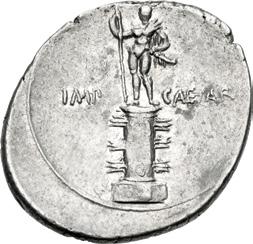
632. The Triumvirs. Octavian. Autumn 30-summer 29 BC. AR Denarius (22mm, 3.62 g, 2h). Uncertain mint in Italy (Rome?). Laureate head of Octavian, as Apollo, right / Rostral column ornamented with two anchors and six beaks of galleys, surmounted by a statue of Octavian, holding spear in right hand and parazonium in left; iÂp CAeÍAr across field. CRI 423; RIC I 271; RSC 124; BMCRR Rome 4349-51 = BMCRE 633-6; BN 68-71. Trace deposits and hairlines, residual luster. Near EF. ($1000)
Ex Classical Numismatic Group 123 (33 May 2023), lot 583.



633. The Triumvirs. Octavian. Autumn 30-summer 29 BC. AR Denarius (16.5mm, 3.81 g, 12h). Uncertain mint in Italy (Rome?). Laureate head of Apollo of Actium right, with features resembling Octavian / Octavian, as city founder, veiled and wearing priestly robes, holding whip in extended left hand and plow-handle in right, plowing right with yoke of oxen; iÂp • CAeÍAr in exergue. CRI 424; RIC I 272; RSC 117; BMCRR Rome 4363-5 = BMCRE 638-40; BN 92-6. Toned over lustrous surfaces, trace of die rust on obverse. EF. ($750)
This issue refers to the foundation of Nicopolis in Epirus by Octavian during the Actian campaign. This scene, in which the founder is plowing with oxen, refers to the Roman custom of fixing a boundary for a new city by marking it with a pomerium, or sacred furrow.




634. Augustus. 27 BC-AD 14. AV Aureus (19mm, 7.88 g, 7h). Uncertain Spanish mint (Colonia Patricia?). Struck 17-16
BC. S • P • Q • R • IMP CAESARI, bare head right / QVOD • VIAE • MVN • SVNT •, double triumphal arch placed on a viaduct; on arch, Augustus standing right in a biga of elephants, holding branch in right hand, crowned by Victory, who stands behind him. RIC I 140; Bahrfeldt 190/5 (same dies); Calicó 263 (same dies as illustration); BMCRE 432 = BMCRR Rome 4462 (same dies); BN 1261 (same dies); Adda –; Biaggi –; Jameson –; Mazzini –; CNR IV 165/1 (this coin). Lovely reddish tone, mount marks on edge. Near VF. Very rare and missing from most collections. An interesting countermark on the obverse, perhaps from the renaissance era, that lost its silver inlay, possibly from the Gonzaga/Este Collection. ($4000)
Ex Metropolitan Museum of Art Collection (Part I, Sotheby’s Zurich, 10 November 1972), lot 234; Joseph Grafton Milne Collection; H. Osborne O’Hagan Collection (Sotheby, Wilkinson & Hodge, 13 July 1908), lot 57; Sir Edward Bunbury Collection.




635. Augustus. 27 BC-AD 14. AV Aureus (20mm, 7.83 g, 6h). Uncertain Spanish mint (Colonia Patricia?). Struck 19-18 BC. CAESAR AVGVSTVS, bare head right / SIGNIS downward to left, RECEPTIS upward to right, Mars, helmeted, naked except for chlamys behind, standing left, head right, holding aquila in right hand and signum cradled in left over left shoulder. RIC I 80a; Calicó 268 (this coin illustrated); BMCRE –; BN 1095; Biaggi 140 (this coin); Mazzini 258 (this coin); CNR IV 173 (this coin). Good VF. Wonderful portrait of fine style. Extremely rare. ($15,000)
Ex MACM inventory MMoCA33C; Lanz 148 (with Numismatica Bernardi, 4 January 2010), lot 73; Gilbert Steinberg Collection (Numismatica Ars Classica & Spink Taisei, 16 November 1994), lot 152; Leo Biaggi de Blasys Collection, 140; Giuseppe Mazzini Collection (publ. 1957).


636. Augustus. 27 BC-AD 14. AR Denarius (18mm, 3.77 g, 6h). Uncertain Spanish mint (Colonia Patricia?). Struck circa 18 BC. CAESARI AVG[VST]O, laureate head right / S • P • Q • R • in exergue, triumphal quadriga right; the chariot is ornamented on side and with Victory at front, in it is an aquila and a miniature, galloping quadriga right. RIC I 108a; RSC 272; BMCRE 394 = BMCRR Rome 4430; BN 1179. Lightly toned and faint hairlines. Good VF. ($500)



637. Augustus. 27 BC-AD 14. AV Aureus (20mm, 7.85 g, 5h). Lugdunum (Lyon) mint. Struck 15-12 BC. ΛVGVSTVS
DIVI • F, bare head right / IMP • X in exergue, bull butting left, right forefoot raised, lashing his tail. RIC I 168; Lyon 20, 7 (D76/R78); Calicó 214 (this coin illustrated); BMCRE 457 = BMCRR Gaul 169 (same dies); BN 1388; Biaggi –. A few scratches and marks, traces of earthen deposits, flan flaw and die break on obverse, file cut, scrapes, and marks on edge. Near EF. ($7500)
Ex John Work Garrett Collection (Part I, Numismatic Fine Arts & Bank Leu, 16 May 1984), lot 708; T. Harrison Garrett (†1888) Collection.




638. Augustus. 27 BC-AD 14. AV Aureus (18.5mm, 7.89 g, 7h). Lugdunum (Lyon) mint. Struck 15 BC. ΛVGVSTVS
DIVI • F, bare head right / [I]MP • X across field, ΛCT in exergue, Apollo Citharoedus of Actium, wearing long drapery, standing facing, head left, holding plectrum in right hand and lyre in left. RIC I 170; Lyon 27; Calicó 215; BMCRE 459-60 = BMCRR Gaul 173-4; BN 1394-5; Adda 10; Biaggi 112; Mazzini 143; Künker 312, lot 2746 (same dies). Minor marks. Near EF. ($7500)
From the Georges Albert Haikel Collection. Ex Spink America (3 May 1995), lot 568.



639. Augustus. 27 BC-AD 14. AR Denarius (19mm, 3.80 g, 8h). Lugdunum (Lyon) mint. Struck 15 BC. ΛVGVSTVS
DIVI • F, bare head right / IMP • X in exergue, bull butting right, left foreleg raised, lashing his tail. RIC I 167a; Lyon 19; RSC 137; BMCRE 451-3 = BMCRR Gaul 163-5; BN 1373-82. Lustrous, light peripheral toning on obverse. EF. ($1000)
Ex Tauler & Fau 60 (24 June 2020), lot 134; Gorny & Mosch 261 (4 March 2019), lot 632.


640. Augustus. 27 BC-AD 14. AR Denarius (18mm, 3.57 g, 5h). Lugdunum (Lyon) mint. Struck 15 BC. ΛVGVSTVS
DIVI • F, bare head right / IMP • X in exergue, bull butting right, left foreleg raised, lashing his tail. RIC I 167a; Lyon 19; RSC 137; BMCRE 451-3 = BMCRR Gaul 163-5; BN 1373-82. Toned, hairline flan crack. In NGC encapsulation 6290949-004, graded Ch XF, Strike: 5/5, Surface: 5/5. ($1000)
From the Michael Rogal Collection. Ex Triton XXVII (9 January 2024), lot 652.

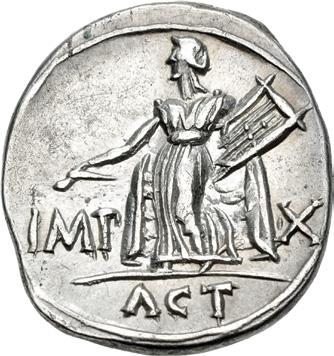

641. Augustus. 27 BC-AD 14. AR Denarius (20mm, 3.84 g, 8h). Lugdunum (Lyon) mint. Struck 15 BC. ΛVGVSTVS
DIVI • F, bare head right / IMP • X across field, ΛCT in exergue, Apollo Citharoedus of Actium, wearing long drapery, standing facing, head left, holding plectrum in right hand and lyre in left. RIC I 171a; Lyon 28/6 (D116/R123); RSC 144; BMCRE 461 = BMCRR Gaul 175; BN 1397 (same dies). Toned, minor marks, faint hairlines, trace of die rust on obverse. Good VF. ($750)
From the Collection of a Gentleman, Kent, England. Ex Morton & Eden 68 (10 June 2014), lot 76.


642. Augustus. 27 BC-AD 14. AV Aureus (19mm, 7.75 g, 6h). Lugdunum (Lyon) mint. Struck 2 BC-AD 12. CΛESΛR • ΛVGVSTVS DIVI • F • PΛTER • PΛTRIΛE, laureate head right / AVGVSTI • F • COS • DESIG • PRINC • IVVENT, C
• L • CAESARES • in exergue, Caius and Lucius Caesar, on left and right, standing facing, each togate and resting a hand on one of two shields set on ground between them; behind the shields, two spears; above, on left, simpulum right, and on right, lituus left. RIC I 206; Lyon 81; Calicó 176b; BMCRE 513-8; BN 1648-50; Biaggi 92-3; Mazzini 42. Hairlines, edge scrapes and filing, slight bend in flan. VF. ($3000)
Ex Roma XVI (26 September 2018), lot 655; Christophe Joron-Derem (23 March 2016), lot 48.




643. Augustus, with Tiberius as Caesar. 27 BC-AD 14. AR Denarius (18.5mm, 3.78 g, 3h). Lugdunum (Lyon) mint. Struck AD 13-14. CΛESΛR ΛVGVSTVS DIVI F PΛTER PΛTRIΛE, laureate head of Augustus right / TI CΛESΛR • ΛVG • [TR • P]OT • XV •, bare head of Tiberius right. RIC I 226; Lyon 88; RSC 2 (Tiberius and Augustus); BMCRE 507; BN 16824. Lightly toned, some faint hairlines and porosity, area of soft strike, die break on obverse, slightly off center on reverse. Near EF. Two excellent portraits. ($3000)
From the Collection of a Gentleman, Kent, England, purchased from Baldwin’s, 24 April 2014.



644. Augustus. 27 BC-AD 14. AR Denarius (18.5mm, 3.78 g, 9h). Lugdunum (Lyon) mint. Struck AD 13-14. [CAES] AR AVGVSTVS DIVI F PATER PA[TRIAE], laureate head right / TI CAESAR in exergue, AVG F TR POT [XV], Tiberius standing right, driving triumphal quadriga, holding eagle tipped scepter in left hand, laurel branch, and reins in right hand; all horses facing right. RIC I 222; Lyon 90; RSC 300; BMCRE 512; BN 1688-9; CNR VI 822 (this coin). Wonderful old cabinet tone, struck slightly off center. Good VF. ($750)
From the Collection of a Gentleman, Kent, England. Ex Spink 233 (2 December 2015), lot 554; Sir Charles Oman and son Collection (Part I, Christie’s, 2 July 1968), lot 54b (part of).




645. Augustus. 27 BC-AD 14. AR Denarius (18mm, 3.96 g, 5h). Rome mint; P. Petronius Turpilianus, moneyer. Struck 19/8 BC. • TVRPILIANVS III • VIR •, draped bust of Feronia right, wearing pearl necklace and stephane, above which is a row of berries; FE[RON] below bust / • CAESAR AVGVSTVS SIGN RECE, bareheaded Parthian kneeling on right knee right, extending in right hand a signum, to which is attached a vexillum marked with X, and holding out left hand below left knee. RIC I 288; RSC 484; BMCRE 15–7 = BMCRR Rome 4526-8; BN 127–37. In NGC encapsulation 4936333-008, graded Ch AU, Strike: 4/5, Surface: 5/5. ($3000)
Ex Classical Numismatic Group 121 (6 October 2022), lot 778; Ernst Justus Haeberlin Collection (Cahn [83], with A. Hess Nachf., 17 July 1933), lot 3237. Reportedly also ex “Mossberg” Collection (1946).


646. Augustus. 27 BC-AD 14. AR Denarius (20.5mm, 3.95 g, 8h). Rome mint; P. Petronius Turpilianus, moneyer. Struck 19/8 BC. P • PETRON • TVRPILI[AN III • V]IR •, draped bust of Feronia right, wearing pearl necklace and stephane, above which is a row of berries; FERO below bust / CAESAR AVGVS[TVS SIG]N RECE, bareheaded Parthian kneeling on right knee right, extending in right hand a signum, to which is attached a vexillum marked with X, and holding out left hand below left knee. RIC I 289 (R3); RSC 486; BMCRE p. 4, note *; BN 139. Attractive cabinet tone, small flan flaw on obverse. Good VF. Very rare. When Carradice and Buttrey published RIC II.1, they knew of only one example, in the Bibliothèque Nationale de France. ($750)
From the Collection of a Gentleman, Kent, England, purchased from Baldwin’s, 24 April 2014.



647. Augustus. 27 BC-AD 14. AR Denarius (20mm, 3.88 g, 9h). Rome mint; L. Mescinius Rufus, moneyer. Struck 16 BC. Laureate head right / L • MESCINI VS • RVFVS, Mars, wearing crested helmet, naked except for a cloak falling over his right arm, standing left on low pedestal, holding transverse spear in right hand and parazonium in left; S • P • Q • R/V • PR • RE/CAES in three lines on pedestal. RIC I 351; RSC 463a; BMCRE 86 = BMCRR Rome 4479; BN 331-6. Lightly toned, faint hairlines. Near EF. Well centered on a broad, round flan. ($1000)



648. Augustus. 27 BC-AD 14. AR Denarius (19mm, 3.79 g, 10h). Rome mint; L. Vinicius, moneyer. Struck 16 BC. Bare head right / [L •] VINICIVS in exergue, triumphal arch, surmounted by facing quadriga, in which Augustus stands, holding laurel branch in right hand and scepter in left; smaller arch on either side, surmounted by archer on left and by slinger on right; S • P • Q • R/IMP CAE in two lines on entablature of arch. RIC I 359; RSC 544; BMCRE 77-8 = BMCRR Rome 4477-8; BN 348-51; Elkins, Monuments Figure 57. Toned, banker’s mark and shallow scratch in field under tone on obverse. Good VF. Rare. ($1000)
From the Michael Rogal Collection. Ex Kallman Collection (Triton XX, 10 January 2017), lot 638; Richard Prideaux Collection (Triton XI, 8 January 2008), lot 782.
The reverse depicts the Parthian Arch. This coin solves an archaeological problem of the Arches in the Forum, where only one base has been found for the two arches built (the Actian and the Parthian). The Parthian Arch was the Actian Arch. Builders added one smaller arcade on each side of the existing Actian Arch which is quite recognizable as the central arcade of the new arch, with the quadriga on its top. The two side arcades support Parthian archers.
The transformation of the former Actian Arch may be explained by three factors. There was significant economy in just adding to the existing arch. Space in the Forum was limited. The Actian Arch hadn’t been welcomed or appreciated by the people of Rome. The “official” version behind Actium had been the declaration of war on Cleopatra, Queen of Egypt. This had not fooled the well-informed citizens and inhabitants of Rome, who knew that Mark Antony had been the actual enemy defeated. A triumphal arch celebrating a victory over other Roman citizens must have seemed inappropriate. Augustus seized the opportunity of making the controversial celebration of Actium disappear inside a consensual Parthian victory triple Arch.


649. Divus Augustus. Died AD 14. Æ Sestertius (33.5mm, 23.56 g, 12h). Rome mint. Struck under Tiberius, AD 35-36. DIVO AVGVSTO S P Q R, OB/ CIVES/ SER in three lines on shield within oak-wreath supported by two capricorns; globe below / TI CAESAR DIVI AVG F AVGVST P M TR P[OT] XXXVII around large S • C. RIC I 63 (Tiberius); BMCRE 10910 (Tiberius); BN 93-5 (Tiberius); CNR VI 927/2 (this coin). Green-brown patina, some porosity, small flan flaw on obverse. VF. ($750)
Ex Gorny & Mosch 276 (19 April 2021), lot 506; Bolaffi 33 (29 November 2018), lot 330; Dr. Giorgio Giorgi Collection (M. Ratto, 26 January 1955), lot 198.


650. Tiberius. AD 14-37. AR Denarius (18mm, 3.74 g, 10h). Lugdunum (Lyon) mint. Struck AD 15-16. TI CΛESΛR DIVI ΛVG F ΛVGVST[VS], laureate head right / TR PO[T XVII], IMP VII in exergue, Tiberius driving triumphal quadriga right, holding eagle-tipped scepter in left hand and branch in right. RIC I 4; Lyon 122; RSC 48; BMCRE 7-11; BN 5-8. Handsome gray and gold toning, struck slightly off center. Good VF. Rare. ($750)
From the Collection of a Gentleman, Kent, England. Ex Spink 233 (2 December 2015), lot 561; Classical Numismatic Group 76 (12 September 2007), lot 1349.
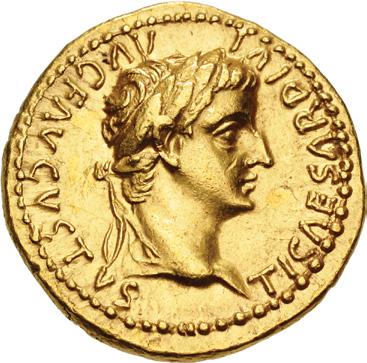



651. Tiberius. AD 14-37. AV Aureus (19.5mm, 7.78 g, 12h). “Tribute Penny” type. Lugdunum (Lyon) mint. Group 3, AD 18. TI CΛESΛR DIVI ΛVG F ΛVGVSTVS, laureate head right, one ribbon on shoulder / PONTIF MΛXIM, Livia (as Pax) seated right on chair, holding inverted spear and olive branch; ornate chair legs (simplified), triple line below. RIC I 27; Lyon 147; Calicó 305a; BMCRE 39-41 var. (ornate chair legs); BN 19 var. (double line below). Scratches, edge marks. Good VF. ($7500)
Ex MACM inventory MMoCA34C; Numismatica Ars Classica 52 (7 October 2009), lot 318.



652. Agrippina Senior. Died AD 33. Æ Sestertius (36.5mm, 29.57 g, 6h). Rome mint. Struck under Claudius, AD 42-43. AGRIPPINA
M
GERMANICI
around large
CAESARIS
draped bust right / TI
CLAVDIVS
C. RIC I 102 (Claudius); von Kaenel Type 78; BMCRE 219-23 (Claudius); BN 236-40 (Claudius). Light green-brown patina. Near EF. Wonderful portrait. ($1500)
Ex Numismatica Ars Classica 18 (29 March 2000), lot 431.



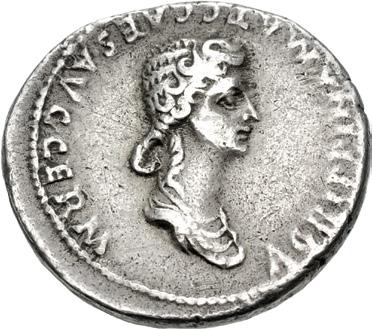
653. Gaius (Caligula), with Agrippina Senior. AD 37-41. AR Denarius (19.5mm, 3.60 g, 6h). Lugdunum (Lyon) mint.
Struck AD 40. C CAESAR AVG PON M TR POT III COS III, laureate head of Gaius (Caligula) right / AGRIPPINA MAT C CAES AVG GERM, draped small bust of Agrippina right. RIC I 22 (Rome mint); Lyon 179 (dies D–/R186 [unlisted obv. die]; RSC 6; BMCRE 23; BN 33 (same rev. die). Attractively toned, scratches and marks under tone, area of edge filing. VF. ($2000)
Ex Elm Street Collection (Triton XXVII – Session 6, 18 January 2024), lot 6034, purchased from James Beach, 28 April 2007.


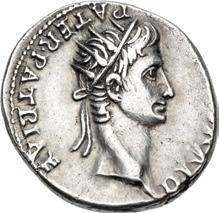

654. Gaius (Caligula), with Divus Augustus. AD 37-41. AR Denarius (17.5mm, 3.69 g, 3h). Lugdunum (Lyon) mint. Last emission, from 1 January AD 41. C CAESAR • AVG PON • M • TR • POT IIII • COS • IIII •, laureate head of Gaius (Caligula) right / DIVVS [• AVG •] PATER • PATRIAE, radiate head of Divus Augustus right. RIC I 31 (Rome); Lyon 185 (D–/R222 [unlisted obv. die]); RSC 8; BMCRE p. 150 note †; BN –. Toned. Near EF. Very rare, Lyon lists only one example (in the Ashmolean). Two excellent portraits. ($3000)
From the Collection of a Gentleman, Kent, England. Ex Spink 248 (25 September 2017), lot 79 (hammer £6,500).
Since Caligula was assassinated on 24 January AD 41, issues dated TR P IIII, which began on 1 January, are among the rarest for this emperor, since they were minted for less than a month.



655. Gaius (Caligula). AD 37-41. Æ Sestertius (35.5mm, 28.13 g, 6h). Rome mint. Struck AD 37-38. C • CAESAR • AVG • GERMANICVS • PON • M • TR • POT •, laureate head left / AGRIPPINA on left, DRVSILLA above, IVLIA on right, S C in exergue, Gaius’ three sisters standing facing: Agrippina (as Securitas), head right, holding cornucopia in right hand and leaning on column, and placing left hand on shoulder of Drusilla (as Concordia), head left, holding patera in right hand and cornucopia in left; on right, Julia (as Fortuna), head left, holding rudder in right hand and cornucopia in left. RIC I 33; BMCRE 36-7; BN 47-9. Brown patina, minor roughness, some smoothing in fields. VF. ($3000)
Ex Gilbert Steinberg Collection, purchased from Bowers and Ruddy Galleries, 21 May 1981.


656. Gaius (Caligula). AD 37-41. Æ As (29mm, 11.14 g, 6h). Rome mint. Struck AD 37-38. C • CAESAR • AVG • GERMANICVS • PON • M • TR • POT •, bare head left / VESTA above, S C across field, Vesta, veiled and draped, seated left on ornamental throne, holding patera in outstretched right hand and transverse scepter in left. RIC I 38; BMCRE 45-8; BN 54-71. Dark brown patina with touches of green, minor cleaning/smoothing marks. EF. Well struck. ($1000)
From the Michael Rogal Collection. Ex Triton XX (10 January 2017), lot 659; Heritage 3024 (18 April 2013), lot 24842; Stack’s (24 April 2008), lot 2283; Kroisos Collection (Stack’s, 14 January 2008), lot 2352.




657. Claudius. AD 41-54. AV Aureus (18.5mm, 7.68 g, 9h). Lugdunum (Lyon) mint. Struck AD 46-47. TI CLAVD CAESAR • AVG • P • M • TR • P • VI • IMP • XI, laureate head right / S P Q R/ P P/ OB • C • S in three lines within oak wreath. RIC I 40; von Kaenel Type 26 (unlisted dies); Lyon 50; Calicó 379a; BMCRE 42-4; BN 58; Biaggi 211; Mazzini 86. Lightly toned, hairlines. Good VF. ($10,000)
Ex MACM inventory MMoCA36C; CNG inventory 859164 (November 2009); A. Lynn Collection (Helios 4, 14 October 2009), lot 251.


658. Claudius. AD 41-54. Æ As (30.5mm, 9.58 g, 6h). Rome mint. Struck AD 41-42. TI CLAVDIVS CAESAR AVG P M TR P IMP, bare head left / LIBERTAS AVGVSTA, S C across field, Libertas, draped, standing facing, head right, holding pileus in right hand and extending left hand. RIC I 97; von Kaenel Type 62; BMCRE 145-6; BN 177-8. Even green-brown patina, lightly smoothed. EF. Powerful portrait. ($1000)
Ex Classical Numismatic Review XLVI.1 (Winter 2021), no. 559028; Classical Numismatic Group 115 (16 September 2020), lot 622.



659. Claudius. AD 41-54. AV Aureus (18mm, 7.81 g, 3h). Rome mint. Struck AD 46-47. TI CLAVD CAESAR • AVG • P • M • TR • P • VI IMP • XI, laureate head right / DE BRITANN on architrave, triumphal arch, surmounted by an equestrian statue of Claudius left, between two trophies. RIC I 33; von Kaenel Type 27 (V–/R522 [unlisted obv. die); Calicó 349; BMCRE 32-4; BN 54-6; Biaggi 201; Mazzini 17; SCBC 633; Elkins, Monuments Figure 75; CNR XIV 34/2 (this coin). VF. ($6000)
Ex Dix Noonan Webb 146 (25 April 2018), lot 19; A. L. Wade Collection (Glendining, 27 October 1971), lot 544; Seaby Coin & Medal Bulletin 554 (July 1964), no. AG1584; Seaby Coin & Medal Bulletin 542 (July 1963), no. G1532; G. R. Blake Collection; C. Anthony Collection.
During the reign of Claudius, Verica, king of the Atrebates and ally of Rome, was forced into exile by invasions of the Catuvellauni, a neighboring tribe to the east. This served as the pretense for the Claudian invasion of Britannia in AD 43, led by general Aulus Plautius, who subsequently served as governor of the region (the future emperor Vespasian also ranked among the commanders). While Claudius had some participation in the campaigns–bringing reinforcements and elephants to Camulodunum–and received a triumph after his return to Rome, he refused the title Britannicus. The success of the invasion was commemorated on various issues, including this aureus.




660. Claudius, with Agrippina Junior. AD 41-54. AR Denarius (19mm, 3.66 g, 6h). Rome mint. Struck AD 51. TI CLAVD CAESAR AVG GERM P M TRIB POT P P •, laureate head of Claudius right / ΛGRIPPINΛE ΛVGVSTΛE, draped bust of Agrippina right, wearing wreath of grain ears and hair in long plait taken up, two locks falling loosely down neck. RIC I 81; von Kaenel Type 50 (unlisted dies); RSC 4; BMCRE 75-6; BN 82-4. Toned, scratches and hairlines. Good VF. ($2000)
From the Collection of a Gentleman, Kent, England, purchased from Baldwin’s, 29 November 2013. Ex Harry N. Sneh Collection (Gemini IX, 9 January 2012), lot 263.
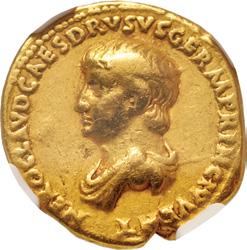

661. Nero. As Caesar, AD 50-54. AV Aureus (18mm, 7.60 g, 8h). Lugdunum (Lyon) mint. Struck under Claudius, AD 51. NERO CLAVD CAES DRVSVS GERM PRINC IVVENT, bareheaded and draped bust left / SA[CERD] COOPT IN OMN CONL SVPRA NVM EX S C, emblems of the pontificate: simpulum and lituus, above tripod and patera, respectively. RIC I 76 (Claudius); von Kaenel Type 52 (unlisted dies); Lyon 86 (D412/R– [unlisted rev. die]); Calicó 441b (same obv. die as illustration); BMCRE 84-6 (Claudius); BN 91-2 (Claudius). In NGC encapsulation 2491174-001, graded VF, Strike: 3/5, Surface: 2/5, lt. scratches. ($2000)


662. Nero. AD 54-68. AR Denarius (17.5mm, 3.34 g, 12h). Lugdunum (Lyon) mint. Struck AD 58-59. NERO • CAESAR • AVG
IMP •, youthful bare head right / PONTIF • [MAX] • TR
P
P •, EX
S C within oak wreath. RIC I 17; WCN 41; Lyon 17; RSC 211; BMCRE 20; BN –. Lightly toned, hairlines. Good VF. ($750)
From the Collection of a Gentleman, Kent, England, purchased from Baldwin’s, 14 May 2014; Numismatica Ars Classica 64 (17 May 2012), lot 2508; InAsta 13 (12 November 2005), lot 191.
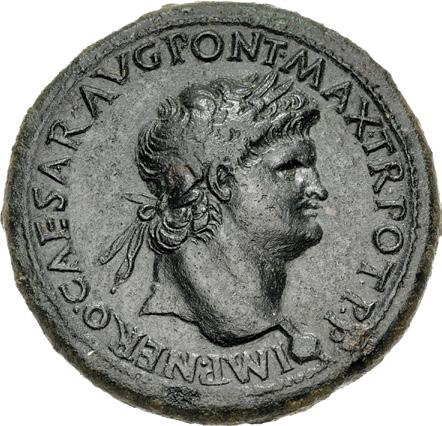

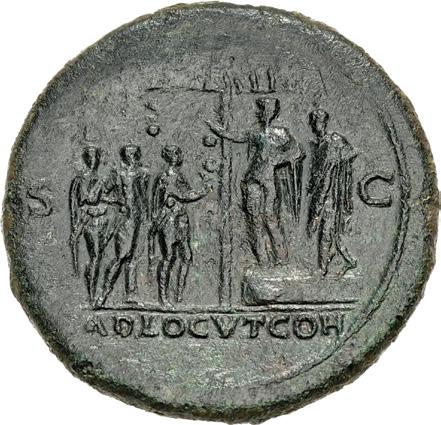
663. Nero. AD 54-68. Æ Sestertius (36.5mm, 25.61 g, 6h). Lugdunum (Lyon) mint. Struck AD 66. IMP • NERO •
CAESAR • AVG • PONT • MAX • TR • POT • P • P •, laureate head right; globe at point of neck / ADLOCVT COH in exergue, S C across field, Nero standing left with praetorian prefect on low platform to right, addressing three soldiers to left, standing right, the first two holding signa; the praetorian camp in the background. RIC I 490; WCN 437; Lyon 176/1a (D390/R412); BMCRE 304 var. (bust type); BN 132 var. (same); cf. Elkins, Monuments Figure 80 (for rev. type). Attractive dark green patina, smoothing, details enhanced. Good VF. Very rare architectural type on reverse, showing the Praetorian camp. ($3000)
The Praetorians were an elite unit of soldiers stationed in a purpose-built fortress in Rome. Composed of nine enlarged cohorts of 1,000 men apiece, for a total theoretical strength of 9,000, the Praetorian “Guard” served as the emperor’s personal fighting force both in Rome and on campaign. Praetorians received triple the pay of ordinary soldiers and had to serve only 16 years instead of the 20 required for regular legionaries. They were consequently greatly resented both by the regular soldiery and by the civilians of Rome, who they were often called upon to suppress. Estimates of their fitness as a fighting force in the field vary; they seem to have accounted themselves well enough in the campaigns of Trajan, Marcus Aurelius and Septimius Severus, but when called upon to fight regular units in Rome’s numerous civil wars, they almost always suffered defeat.


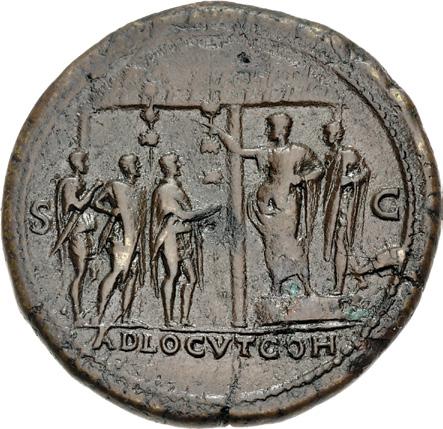
664. Nero. AD 54-68. Æ Sestertius (36.5mm, 28.74 g, 8h). Lugdunum (Lyon) mint. Struck AD 66. IMP • NERO • CAESAR • AVG • PONT • MAX • TR • POT • P • P •, laureate head left; globe at point of neck / ADLOCVT COH in exergue, S C across field, Nero standing left with praetorian prefect on low platform to right, addressing three soldiers to left, standing right, the first two holding signa; the praetorian camp in the background. RIC I 491; WCN 444; Lyon 183 (D395/R417); BMCRE 304; BN 132 (same dies); cf. Elkins, Monuments Figure 80 (for rev. type). Attractive medium brown surfaces with touches of red, a few minor pits. VF. Very rare architectural type on reverse, showing the Praetorian camp. ($2000)
From the Michael Rogal Collection. Ex Kallman Collection (Triton XX, 9 January 2017), lot 668; Classical Numismatic Group inventory 886135 (January 2011).



665. Nero. AD 54-68. AV Aureus (19mm, 7.67 g, 5h). Rome or Lugdunum (Lyon) mint. Struck AD 61-62. NERO • CAESAR • AVG • IMP, bare head right / PONTIF • MAX • TR • P VIII • COS IIII • P • P •, EX S C across field, Virtus, helmeted, in military dress, cloak over shoulders, standing left, right foot on helmet among shields, holding parazonium resting on right knee in right hand and long spear in left. RIC I 31; WCN 15; Lyon 31; Calicó 432; BMCRE 33-4; BN 42 (Lyon); Biaggi 235. Minor marks on obverse, edge scrape. Good VF. ($5000)
From the Michael Rogal Collection. Ex Continental Collection (Triton XX, 10 January 2017), lot 671; Giessener Münzhandlung 64 (11 October 1993), lot 343.
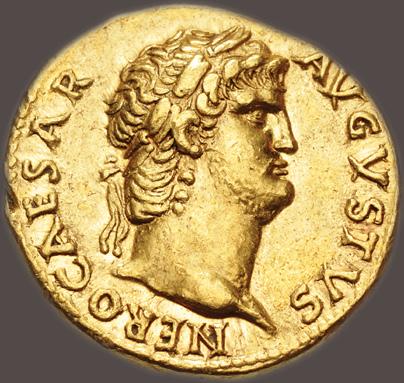



666. Nero. AD 54-68. AV Aureus (18mm, 7.33 g, 12h). Rome mint. Struck circa AD 64-66. NERO CAESAR AVGVSTVS, laureate head right / IANVM CLVSIT PACE P R TERRA MARIQ PARTA, closed doors of the Temple of Janus. RIC I 50 and 58; Calicó 409; BMCRE 64-6; BN 211-2; Biaggi 224; Elkins, Monuments Figure 76; Adda 30; Biaggi 224; Mazzini 114. Lustrous and attractive. Near EF. An interesting architectural reverse type with the closed doors of the Temple of Janus, sending the signal to the Roman people that there was no war. ($15,000)
Ex MACM inventory MMoCA37C; Classical Numismatic Group 82 (16 September 2009), lot 983; New York Sale XX (7 January 2009), lot 401.
The Temple of Janus was one of Rome’s most ancient centers of worship. It was said that Romulus had built it after he made peace with the Sabines, and that it was king Numa who decreed that its doors should be opened during times of war and shut during times of peace. In all of Roman history until the reign of Nero, the temple doors had been shut perhaps five or six times – once under king Numa (who originated the tradition), once at the end of the Second Punic War, three times under Augustus, and, according to Ovid, once under Tiberius.
In AD 65, when peace had been generally established in the Empire, Nero understandably requested the closing of the temple’s doors. He marked the event with great celebrations and trumpeted his policy of peace by issuing a large and impressive series of coins. The inscription on this issue announces “the doors of Janus have been closed after peace has been procured for the Roman People on the land and on the sea.” The doors of the temple probably remained closed for less than a year, being opened again with the onset of strife in Judaea in 66.




667. Nero. AD 54-68. AV Aureus (18mm, 7.33 g, 6h). Rome mint. Struck circa AD 64-65. NERO CAESAR AVGVSTVS, laureate head right / IVPPITER CVSTOS, Jupiter, bare to waist, with cloak around lower limbs, seated left on throne, holding thunderbolt in right hand and vertical scepter in left. RIC I 52; WCN 25; Calicó 412; BMCRE 67-73; BN 213-9; Adda 31; Biaggi 225-6; Mazzini 118; CNG 111, lot 667 (same dies). Good VF. Wonderful violet-red toning, characteristic of aurei from the Boscoreale Hoard of 1895. ($5000)
This reverse type commemorates the protection of Nero from the Pisonian Conspiracy. Events of the years AD 64-65 defined the subsequent reputation of Nero as a cruel and self-indulgent ruler. His “excesses” resulted in a conspiracy to overthrow and replace him with Gaius Calpurnius Piso. Among the conspirators were many high-ranking members of Nero’s court including Seneca the Younger, the poet Lucan, and Petronius, who called himself Nero’s “arbiter of elegance.” To Nero, the failure of a conspiracy made up of those so close to him could have been achieved only through divine intervention. As the king of the Gods oversaw the security of the Roman state, Nero believed it was Jupiter the Guardian (Custos) who had saved him from harm.



668. Nero. AD 54-68. AR Denarius (18.5mm, 3.01 g, 6h). Rome mint. Struck circa AD 67-68. IMP NERO CAESAR AVG P P, laureate head right / IVPPITER CVSTOS, Jupiter, bare to waist, with cloak around lower limbs, seated left on throne, holding thunderbolt in right hand and vertical scepter in left. RIC I 69; WCN 65; RSC 123; BMCRE 80; BN 239. Attractive even gray and iridescent toning. EF. ($1500)
Ex Peus 430 (27 April 2022), lot 198; Gorny & Mosch 228 (9 March 2015), lot 584.



669. Civil War. AD 68-69. AR Denarius (18mm, 3.75 g, 6h). ‘Augustus’ Group. Uncertain mint in Spain or Gaul. 3 April-mid June AD 68. Bare head of Augustus right / AVGVSTVS below, capricorn right, holding globe attached to rudder between front hooves; cornucopia above its back. RIC I 82; AM A2; RSC 21a; BMCRE 45-6; BN 48. Toned, light scratches and marks under tone. Good VF. Very rare. ($1000)
Ex Leu Numismatik AG Web Auction 18 (18 December 2021), lot 2663; Leu Numismatik AG Web Auction 16 (22 May 2021), lot 3346; Numismatica Ars Classica Spring Sale 2020 (25 May 2020), lot 829 corr. (misdescribed as a denarius of Augustus).


670. Civil War. AD 68-69. AR Denarius (17mm, 2.58 g, 9h). ‘S P Q R Group’. Uncertain mint in Gaul or Rhine Valley. Struck May/June-December AD 68. SΛLVS GENERIS up right, HVMΛNI down left, Victory standing left on globe, holding wreath in right hand and palm frond in left / S P Q R within oak wreath. RIC I 72; AM 77; RSC 420; BMCRE 34; BN 37. Toned, scratches under tone, minor flan flaw on reverse, shallow edge test cut. VF. ($750)
Ex Leu Numismatik 11 (14 May 2022), lot 234; Dipl.-Ing Christian Gollnow Collection (Leu Numismatik 9, 24 October 2021), lot 1090, purchased from Spink, 1976.

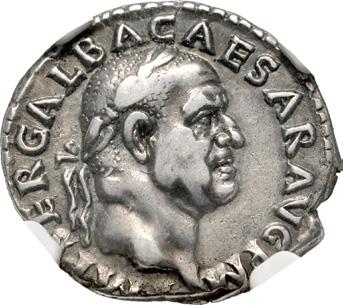

671. Galba. AD 68-69. AR Denarius (18.5mm, 3.50 g, 6h). Rome mint. Struck circa July AD 68-January AD 69. IMP SER GALBA CAESAR AVG P M, laureate head right / ROMA RENASCES, Roma, helmeted and in military dress, standing left, holding Victory on globe in right hand and transverse eagle-tipped scepter in left. RIC I 229; RSC 208; BMCRE p. 313, note †; BN 103. In NGC encapsulation 2491176-001, graded Ch VF★, Strike: 5/5, Surface: 4/5, Fine Style. ($1000)
Achieving the throne at age 70, Galba was a wizened Roman aristocrat whose sagging, craggy countenance could not have been more different than that of his predecessor, the bloated and dissolute Nero. Indeed, Galba seems to have deliberately promoted himself as a steely martinet who would restore Rome to proper Republican austerity.
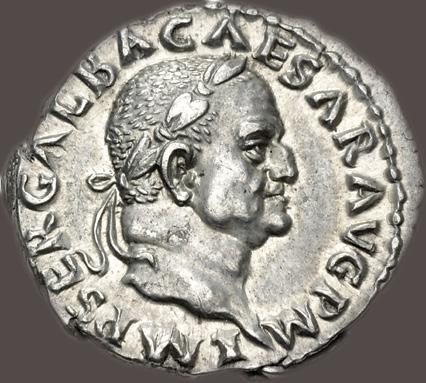
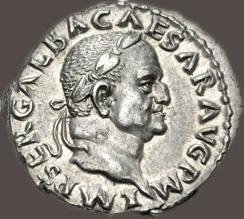


672. Galba. AD 68-69. AR Denarius (19mm, 3.41 g, 6h). Rome mint. Struck circa July AD 68-January 69. IMP SER GALBA CAESAR AVG P M, laureate head right / SALVS GEN HVMANI, female figure (Fortuna?), draped, standing left, right foot on globe, sacrificing out of patera in right hand over lighted and garlanded altar to left, and cradling upright rudder in left arm. RIC I 232; RSC 240; BMCRE 45; BN 104. Toned, with some luster, faint hairlines. EF. An expressive portrait. ($7500)



673. Galba. AD 68-69. AR Denarius (17.5mm, 3.51 g, 6h). Rome mint. Struck circa July AD 68-January AD 69. IMP SER GΛLBΛ CAESΛR ΛVG P M, laureate head right / SALVS GEN HVMANI, female figure (Fortuna?), draped, standing left, right foot on globe, sacrificing out of patera in right hand over lighted and garlanded altar to left, and cradling upright rudder upright in left arm. RIC I 232; RSC 240; BMCRE 45; BN 104. Iridescent tone, some faint hairlines, and a trace of die rust on obverse. Good VF. Wonderful portrait. ($1500)
Ex John L. Cowan Collection (Classical Numimatic Group 114, 14 May 2020), lot 770; CNG inventory 700995 (June 1997).



674. Otho. AD 69. AV Aureus (18.5mm, 7.25 g, 6h). Rome mint. Struck 15 January-8 March. IMP M OTHO CAESAR
AVG TR P, bare head right / SECV RI TAS P R, Securitas, draped, standing left, holding wreath in right hand and scepter in left. RIC I 7; Muona Group 1, Type 4A, Portrait Type A; Calicó 531b (same obv. die as illustration); BMCRE 13-5; BN 7-8; Biaggi 271; Jameson 56; Mazzini 16. Some minor smoothing in fields, edge scrape on obverse, light marks on reverse. VF. Well centered obverse shows full legend. Excellent Portrait. ($20,000)
From the Ramrodivs Collection. Ex Harlan J. Berk inventory cc72777 (ND); Gemini VIII (with Heritage, 14 April 2011), lot 293.
Marcus Salvius Otho was a minor functionary in the court of Nero, known more for his enthusiastic participation in the emperor’s revels than for any real competency. His one mistake was in introducing his beautiful wife Poppaea Sabina to his master. Very soon, Otho got the governorship of the remote province of Lusitania, and Nero got Poppaea. With Nero’s downfall, Otho aligned himself with his fellow governor Galba, fully expecting to be named the elderly emperor’s successor. When Galba designated Piso as his successor, the disappointed Otho joined the conspiracy that led to Galba’s assassination. Otho himself would perish three months later, by his own hand as the armies of Vitellius approached Rome.


675. Otho. AD 69. AR Denarius (17.5mm, 3.33 g, 5h). Rome mint. Struck 15 January–8 March. IMP M OTHO CAESAR AVG TR P, bare head right / SECV RI TΛS P R, Securitas, draped, standing left, holding wreath in right hand and scepter in left. RIC I 8; Muona Group 1, Type 4B, Portrait Type B; RSC 17; BMCRE 17-8; BN 10. Deeply toned. In NGC encapsulation 4170300-001, graded Ch VF, Strike: 5/5, Surface: 3/5, edge marks. ($1000)
Portrait



676. Otho. AD 69. AR Denarius (18mm, 3.44 g, 6h). Rome mint. Struck 15 January-8 March. IMP OTHO CAESAR AVG TR P, bare head right / SECVR I TAS P R, Securitas, draped, standing left, holding wreath in right hand and scepter in left. RIC I 10; Muona Group 2, Type 9B, Portrait Type D; RSC 15; BMCRE 19; BN 11-13. Attractively toned. VF. ($1000)
From the Collection of a Gentleman, Kent, England, purchased from Baldwin’s, 29 November 2013; Roma II (2 October 2011), lot 606; W. B. and R. E. Montgomery Collection (Heritage 3012, 2 January 2011), lot 24661.




677. Vitellius. AD 69. AV Aureus (18mm, 7.33 g, 6h). Rome mint. Struck circa late April-20 December. A VITELLIVS GERM IMP AVG TR P, laureate head right / PONT MAXIM, Vesta, veiled and draped, seated right on throne, holding patera in right hand and scepter in left. RIC I 106; Calicó 571; BMCRE 33; BN 70; Adda 46; Biaggi 282; Mazzini 71. Some shallow scratches, a couple of minor edge marks. Good VF. ($15,000)
Ex MACM inventory MMoCA40C; Künker 168 (12 March 2010), lot 7701; Künker 89 (8 March 2004), lot 2123.
The last of Nero’s immediate three successors, Vitellius was declared emperor by his troops while campaigning in lower Germania in January, AD 69. His reign was short lived however, as Vespasian was hailed emperor in Judaea only a few months later. Vitellius’ troops gave little resistance as Vespasian entered Italy. As Vespasian’s army approached Rome, Vitellius attempted to abdicate but was prevented by the Praetorians and his backers, who rioted and burned down the Temple of Jupiter. Vitellius was ultimately dragged out of his hiding place and brutally murdered, his body thrown down the Gemonian Stairs.
Judaea Capta Aureus



678. Vespasian. AD 69-79. AV Aureus (18mm, 6.99 g, 6h). “Judaea Capta” commemorative. Rome mint. Struck circa 21 December AD 69-early 70. IMP CAESAR VESPASIANVS AVG, laureate head right / IVDAEA in exergue, trophy; to right, Judaea, veiled and draped, seated right on ground in attitude of mourning, knees drawn up, head resting on left hand, which is propped on knees, right arm on lap. RIC II.1 1; Hendin 6492; Calicó 643; BMCRE 31-4; BN 20-2; Biaggi 324. Light graffito on reverse, a couple of tiny marks on edge. Good Fine. ($4000)



679. Vespasian. AD 69-79. AR Denarius (18mm, 3.48 g, 6h). “Judaea Capta” commemorative. Rome mint. Struck AD 72-73. [I]MP CAES VESP AVG P M CO[S IIII], laureate head right / VICTORIA AVGVSTI, Victory, draped, advancing right, holding palm frond in left hand over left shoulder and with right hand placing wreath on signum to right. RIC II.1 362; Hendin –; RSC 618; BMCRE 74-7; BN 60. Lightly toned, traces of deposits on reverse. Near EF. Strong portrait. ($750)
From the Michael Rogal Collection. Ex Dr. Jay M. Galst Collection (Triton XXV, 11 January 2022), lot 833; Classical Numismatic Group 49 (17 March 1999), lot 1509.
Metropolitan Museum of Art Collection




680. Divus Vespasian. Died AD 79. AV Aureus (18.5mm, 7.36 g, 6h). Rome mint. Struck under Titus, AD 80-81. DIVVS ΛVGVSTVS VESPΛSIΛNVS, laureate head right / E X above, round shield inscribed S C set low on column, on which stands an urn; laurel branch (tree) on either side. RIC II.1 358 (Titus); Calicó 630c (this coin illustrated); BMCRE 123-4 (Titus); BN 96-7 (Titus); Biaggi 319. Some faint hairlines, edge marks. Near EF. ($7500)
From the Georges Albert Haikel Collection. Ex Spink America (3 May 1995), lot 579; Numismatica Ars Classica 4 (27 February 1991), lot 341; Leu 33 (3 May 1983), lot 40; Metropolitan Museum of Art Collection (Part I, Sotheby’s Zurich, 10 November 1972), lot 272.


681. Titus. As Caesar, AD 69-79. Æ Sestertius (32mm, 26.94 g, 6h). “Judaea Capta” commemorative. Rome mint. Struck under Vespasian, AD 72. T CAES VESPASIAN IMP PON TR POT COS II, laureate head right / IVDAEA CAPTA, S C in exergue, palm tree; to left, Titus standing right, left foot on helmet, holding spear in right hand, cradling parazonium in left arm; to right, Judaea seated right on cuirass, in attitude of mourning. RIC II.1 422 (Vespasian); Hendin 6553; BMCRE 631-2 (Vespasian); BN 618 (Vespasian). Dark brown patina. In NGC encapsulation 4632936-001, graded Ch VF, Strike: 5/5, Surface: 3/5, lt. smoothing. The “Judaea Capta” issues of Titus are considerably rarer than those of his father Vespasian. ($3000)
Ex New York Sale XXX (9 January 2013), lot 288; Spink 25 (24 November 1982), lot 197.


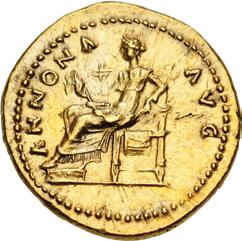
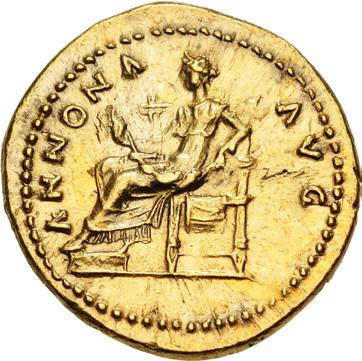
682. Titus. As Caesar, AD 69-79. AV Aureus (19.5mm, 7.38 g, 6h). Rome mint. Struck under Vespasian, AD 77-78. T CAESAR VESPASIANVS, laureate head right / ANNONA AVG, Annona seated left, holding open on her lap a bag of grain ears, the ends held in her hands. RIC II.1 971 (Vespasian); Calicó 726; BMCRE 316-8 (Vespasian); BN 278-9 (Vespasian); Biaggi 360; Jameson 70; Mazzini 16. Toned, hairlines. Near EF. ($10,000)
Ex MACM inventory MMoCA42C; Numismatica Ars Classica 52 (7 October 2009), lot 383; Leu 77 (11 May 2000), lot 539; Leu 2 (25 April 1972), lot 380.




683. Titus. AD 79-81. AR Denarius (17mm, 3.31 g, 6h). Rome mint. Struck 1 January-30 June AD 80. IMP TITVS CAES VESPASIAN AVG P M, laureate head right / TR P IX IMP XV COS VIII P P, elephant, wearing armor, walking left on exergual line. RIC II.1 115; RSC 303; BMCRE 43-6; BN 37-40. Lightly toned, a few light scratches. EF. ($1500)
The elephant on this issue represents one of the numerous species displayed in the newly constructed Flavian Amphitheater, better known today as the Colosseum, built by prisoners of the First Jewish War on the site of the Domus Aurea of Nero. Opened to the public during Titus’ rule, in AD 80, and commemorated by Martial in de Spectaculis, the Colosseum was welcomed with great fanfare and games. During the opening ceremonies a great number of animals, including elephants, were both exhibited and slaughtered.



684. Julia Titi. Augusta, AD 79-90/1. AR Denarius (19mm, 3.49 g, 5h). Rome mint. Struck under Titus, AD 80-81. IVLIA AVGVSTA TITI AVG[VSTI F •], diademed and draped bust right; hair in long plait / VENVS AVGVST, Venus, seen half from behind, naked to the hips, standing right, resting elbow on column, holding transverse scepter in left hand and crested helmet in extended right hand. RIC II.1 388 (Titus); RSC 14; BMCRE 141-3 (Titus); BN 106-7 (Titus). Toned, some faint hairlines under tone. Near EF. ($1000)
From the Collection of a Gentleman, Kent, England.


685. Julia Titi. Augusta, AD 79-90/1. Æ Dupondius (28mm, 13.33 g, 6h). Rome mint. Struck under Titus, AD 80-81. IVLIΛ IMP T • ΛVG • F AVGVSTA, draped bust right, wearing hair piled high in front and knotted low at back / VESTA in exergue, S C across field, Vesta, draped, seated left, holding palladium in right hand and transverse scepter in left. RIC II.1 397 (Titus); BMCRE 256 (Titus); BN 270 (Titus). Attractive dark green patina, smoothing, a few edge marks. Good VF. ($1000)




686. Domitian. As Caesar, AD 69-81. AV Aureus (19.5mm, 7.33 g, 6h). Rome mint. Struck under Vespasian, AD 76-77. CAESAR AVG F DOMITIANVS, laureate head right / COS IIII, cornucopia, upright, tied round with ribbons which hang down on left and right. RIC II.1 918 (Vespasian); Calicó 817a; BMCRE 196-7 (Vespasian); BN 175 (Vespasian; same dies); Adda 71; Biaggi 395; Jameson 79; Mazzini 46 (same rev. die). Near EF. Lustrous. ($5000)
From the Georges Albert Haikel Collection. Ex McLendon Collection (Christie’s, 12 June 1993), lot 111; Leu 28 (5 May 1981), lot 414.



687. Domitian. As Caesar, AD 69-81. AV Aureus (19mm, 7.45 g, 5h). Rome mint. Struck under Vespasian, AD 77-78. CΛESAR ΛVG F DOMITIΛNVS, laureate head right / COS V in exergue, Parthian kneeling right, extending left hand and holding out signum, with vexillum attached, in right. RIC II.1 959 (Vespasian); Calicó 819 (same rev. die as illustration); BMCRE 231-3 (Vespasian); BN 205-6 (Vespasian); Adda 72; Biaggi 396 (this coin); Jameson 80; Mazzini 48. Some faint hairlines. EF. ($7500)
From the Georges Albert Haikel Collection. Ex McLendon Collection (Christie’s, 12 June 1993), lot 112; Leo Biaggi de Blasys Collection.
This reverse type repeats an issue of Augustus struck by several moneyers circa 19/8 BC (RIC I 288) celebrating the recovery of the standards lost to the Parthians by Crassus in 53 BC at the battle of Carrhae. The return of the standards (SIGNIS RECEPTIS) featured prominently in Augustan propaganda as a diplomatic and military triumph. The Flavian rulers frequently reused Augustan imagery on their coinage, seeking to legitimize their dynasty by association.


688. Domitian. As Caesar, AD 69-81. AR Denarius (19mm, 3.11 g, 12h). Ephesus mint. Struck under Vespasian, AD 76. CAESAR AVG F DOMITIANVS, laureate head right / COS IIII across field, eagle standing facing, head right, on garlanded cippus, wings open. RIC II.1 1492 (Vespasian); RPC II 1466; cf. RIC II.1 pl. 80, 1493 (same obv. die but different rev. type). Areas of slight granularity, some shallow cleaning scratches on obverse. EF. Portrait of artistic merit. Rare. ($1000)
Ex Classical Numismatic Group 100 (7 October 2015), lot 1851.

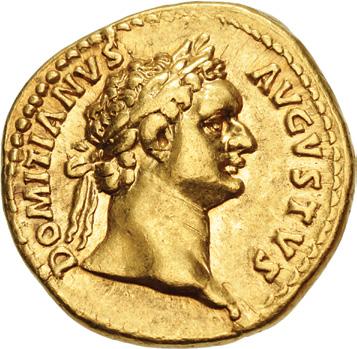

689. Domitian. AD 81-96. AV Aureus (19mm, 7.55 g, 6h). Rome mint. Struck AD 90-91. DOMITIANVS AVGVSTVS, laureate head right / GERMANICVS COS XV, Minerva, helmeted and draped, standing left, holding vertical spear in right hand and left hand on left hip, arm bent. RIC II.1 698 (R2); Calicó 839; BMCRE 173; BN 162; Biaggi 404; NAC 67, lot 142 (same dies). Some luster remains, some shallow scratches and faint hairlines on reverse. Good VF. Rare. ($3000)
Ex Roma XXVIII (5 July 2023), lot 571.




690. Domitian. AD 81-96. AV Aureus (19mm, 7.57 g, 6h). Rome mint. Struck AD 92-94. DOMITIANVS AVGVSTVS, bare head right / GERMANICVS above, COS XVI in exergue, Domitian standing left in slow triumphal quadriga, holding laurel branch in right hand and scepter in left; Victory left, crowning trophy, on side of chariot. RIC II.1 749; Calicó 853; BMCRE 213; BN 190; Mazzini 161 (same rev. die). A few shallow scratches, minor edge marks. Good VF. Rare. ($7500)
Ex MACM inventory MMoCA43C; Classical Numismatic Group 82 (16 September 2009), lot 1002.
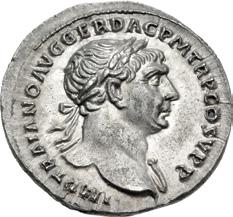


691. Trajan. AD 98-117. AR Denarius (19mm, 3.46 g, 6h). Rome mint. Struck circa AD 107. IMP TRAIANO AVG GER DAC P M TR P COS V P P, laureate bust right, slight drapery / S P Q R OPTIMO PRINCIPI, Aequitas, draped, standing left, holding scales in right hand and cornucopia in left. RIC II 169; Woytek 222b1 (same dies); Strack 101; RSC 462; BMCRE 167; BN 243-4. Attractive light tone, minor flan flaw and a couple of short, shallow scratches on reverse. Superb EF. Well struck on a round flan. ($750)
From the Michael Rogal Collection. Ex Triton XXVII (9 January 2024), lot 746; Numismatica Ars Classica 120 (6 October 2020), lot 748.



692. Trajan. AD 98-117. AV Aureus (19mm, 7.26 g, 7h). Rome mint. Struck circa mid AD 112-spring 113. IMP TRAIANVS AVG GER DAC P M TR P COS VI P P, laureate, draped, and cuirassed bust right / FORVM TRAIAN in exergue, Arcus Traiani (triumphal entrance) of the Forum Traiani: hexastyle building façade; surmounted by statue of facing chariot drawn by six horses between two figures flanking trophy on either side; four statues within arches below. RIC II 257; Beckmann, Early Group I, 15 (dies b2/F6); Woytek 409f; Strack 216; Calicó 1031 (same obv. die as illustration); BMCRE 509; BN 687 (same rev. die); Biaggi 494 (same obv. die); Elkins, Monuments Figure 123. VF. Historic architectural reverse. ($7500)
Ex MACM inventory MMoCA45C; Classical Numismatic Group 82 (16 September 2009), lot 1006.
Nearly every detail of Trajan’s Forum was intended as a celebration and aggrandizement of the emperor’s Dacian victory, so it is fitting that the forum’s entrance doubled as Trajan’s triumphal arch. In typical fashion, the arch is surmounted by a statuary group with figures of the emperor and Victory in a chariot. A large portion of the Forum survives to this day, containing multiple market stalls, indicating its function as the ancient Roman equivalent to a shopping mall.
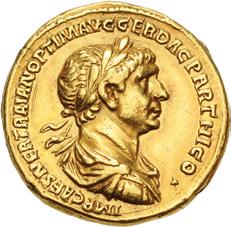


693. Trajan. AD 98-117. AV Aureus (18.5mm, 7.29 g, 6h). Rome mint. Struck 20 February-circa autumn AD 116. IMP CAES NER TRAIAN OPTIM AVG GER DAC PARTHICO •, laureate, draped, and cuirassed bust right / REGNA • AD SIGNATA, Trajan, bareheaded and in military dress, seated left on sella castrensis set on platform on right, holding out right hand; officers standing to left and right, the one on left holding spear; below, on the ground to left stand three kings, facing Trajan, the foremost holding out his right hand to receive a diadem. RIC II 367; Woytek 564f; Strack 250β; Calicó 1079; BMCRE 614-5; BN 862; Hunter 197; Adda –; Biaggi –; Jameson –; Mazzini –. Attractive reddish tone, some faint hairlines, flan flaw on reverse, areas of filing and scrapes on edge. VF. Die engraver’s circle still bold on obverse. Rare. Missing from most major private collections. ($4000)
From the Ramrodivs Collection. Ex Harlan J. Berk inventory cc77900; Archer M. Huntington Collection, HSA 1001.1.22269 (Numismatica Ars Classica 67, 17 October 2012), lot 313.
This attractive reverse composition shows Trajan assigning the kingdoms of Armenia, Parthia, and Mesopotamia to rulers in concert with his invasion in the East. Military gains were briefly made by Rome under Trajan, but most did not last.


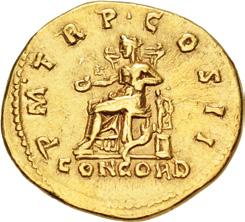

694. Hadrian. AD 117-138. AV Aureus (20mm, 7.08 g, 6h). Rome mint. Struck AD 118. IMP CAESAR TRAIAN HADRIANVS AVG, laureate, draped, and cuirassed bust right / P M TR P • COS II, CONCORD in exergue, Concordia, draped, seated left on throne, holding patera in extended right hand and resting left arm on statuette of Spes; cornucopia below throne. RIC II.3 107; Calicó 1205a (same dies as illustration); BMCRE 59-60 var. (bust type); Adda 143 (same dies); Mazzini 252 (same dies). Short scratch on reverse, a few minor edge marks. Good VF. ($3000)
Ex MACM inventory MMoCA46C; Lanz 145 (with Numismatica Bernardi, 5 January 2009), lot 97.
The theme of Concordia on this aureus is likely intended to smooth out relationships with the Roman Senate, which were strained at the time this coin was struck in mid-AD 118. Hadrian first arrived in Rome on July 9 of that year, nearly a year after his accession to the purple in August of 117, while he was commanding an army in Syria. In the interim, as Hadrian slowly made his way back to Rome, four important Senators of consular rank – Cornelius Palma, Publius Celsus, Avidius Nigrinus, and Lusius Quietus, a Moorish chieftain – had been put to death, allegedly for conspiring against the new ruler. Hadrian blamed these executions on the Praetorian Prefect Attianus, whom he induced to resign his post in AD 119. Relations with the Senate never fully recovered during Hadrian’s reign.



695. Hadrian. AD 117-138. AV Aureus (19mm, 7.27 g, 6h). Rome mint. Struck AD 118. IMP CAESAR TRAIAN HADRIANVS AVG, laureate, draped, and cuirassed bust right / P M TR P COS II, SΛLVS ΛVG in exergue, Salus, draped, seated left, holding patera in right hand, feeding serpent coiled around and rising from altar to left, resting left arm on chair. RIC II.3 137 (same dies as illustration); Strack 40γ1; Calicó 1368; BMCRE p. 250, note 84; Biaggi 654 var. (bust type). Shallow scratch on reverse. Good VF. ($4000)
Ex Roma XXIII (24 March 2022), lot 947.



696. Hadrian. AD 117-138. AR Denarius (19mm, 3.69 g, 6h). Rome mint. Struck AD 119-circa 120. IMP CAESAR TRAIAN H ADRIANVS AVG, laureate bust right with bare chest, slight drapery / P M TR P COS III, Aeternitas, draped, standing facing, head left, holding up head of Sol in right hand and head of Luna in left. RIC II.3 215; Strack 108; RSC 1114; BMCRE 162. Even light toning, underlying luster. Choice EF. Exceptional. ($500)
Ex Collection of a Perfectionist (Numismatica Ars Classica 106, 9 May 2018), lot 620.

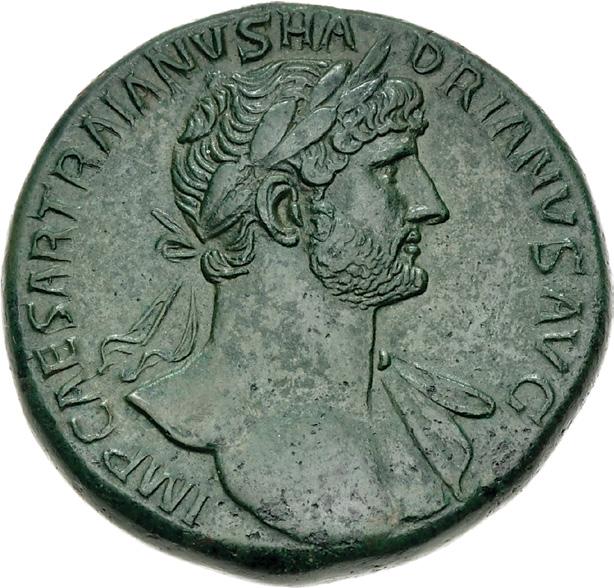

697. Hadrian. AD 117-138. Æ Sestertius (34mm, 27.86 g, 6h). Rome mint. Struck AD 119-circa mid 120. IMP CAESAR TRAIANVS HA DRIANVS AVG, laureate bust right with bare chest, slight drapery / PONT M A X T R POT COS III, S C in exergue, Roma, helmeted and draped, seated left on pile of arms, right foot on helmet, holding Victory in extended right hand and vertical spear in left; shield at side to right. RIC II.3 254; Strack 534; Banti 605; BMCRE 1148-9. Attractive enamel-like green patina, some smoothing. Near EF. A wonderful portrait. ($5000)
Ex Numismatica Ars Classica 52 (7 October 2009), lot 425; Tkalec (22 April 2007), lot 222.



698. Hadrian. AD 117-138. AV Aureus (18mm, 7.23 g, 6h). Rome mint. Struck circa late AD 120-121. IMP CAESAR TRAIAN HADRIANVS • AVG, laureate, draped, and cuirassed bust right / P M TR P COS III, Mars, in military dress, cloak over left arm, wearing crested helmet, standing facing, holding reversed vertical spear in right hand and resting left hand on shield set on ground to right. RIC II.3 319; Strack 94γ1; Calicó 1312; BMCRE 109; Adda 149; Biaggi 634; Mazzini 1071. Minor marks and small scratches. VF. ($3000)



699. Hadrian. AD 117-138. AV Aureus (18mm, 7.17 g, 6h). Rome mint. Struck circa late AD 121-123. IMP CΛESΛR TRΛIΛN HΛDRIΛNVS ΛVG, laureate, draped, and cuirassed bust right / P M TR P COS III, Hercules, naked, seated facing, holding club in right hand and distaff in left; shields to left, round shield in middle, cuirass to right. RIC II.3 508 (same rev. die as illustration); Strack 86γ1; Calicó 1318 (same rev. die as illustration); BMCRE 97 var. (break in obv. legend; same rev. die); Biaggi 636 (same rev. die). Toned. Good VF. ($5000)
Ex Triton XXII (7 January 2019), lot 1072; Triton XX (10 January 2017), lot 731.
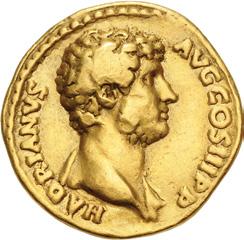
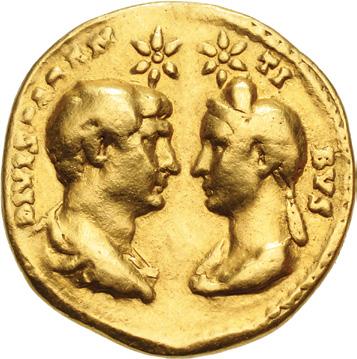

700. Hadrian, with Divi Trajan and Plotina. AD 117-138. AV Aureus (19.5mm, 6.98 g, 1h). Dynastic issue. Rome mint. Struck circa AD 130. HADRIANVS AVG COS III P P, rejuvenated, bareheaded bust right, slight drapery / DIVIS PAREN TI BVS, bareheaded, draped, and cuirassed bust of Trajan right confronting draped bust of Plotina left, wearing stephane and hair in queue; each with star above. RIC II.3 1419; Beckmann, Gold dies b15/DP1, e (this coin); Strack 354Δ0; Calicó 1417 (same dies as illustration); BMCRE 603 (same dies); Biaggi 567 (same dies); Mazzini 2 (same dies). Polished, hairlines, marks consistent with use in jewelry, flan slightly bent. Near VF. Very rare. ($7500)
From the Ramrodivs Collection. Ex Harlan J. Berk inventory cc78377 (ND); Robert O. Ebert Collection (Stack’s Bowers and Ponterio 174, 11 January 2013), lot 5035; Hausman Collection.



701. Hadrian. AD 117-138. Æ Sestertius (33mm, 28.80 g, 6h). “Travel series” issue (“Provinces cycle”) – Army / exercitus type. Rome mint. Struck circa AD 130-133. HADRIANVS AVG COS III P P, bareheaded and draped bust right / DISCIPLIN A[VG/ S] C in two lines in exergue, Hadrian advancing right, holding baton in left hand and leading a line of four soldiers, carrying vexillum between two signa. RIC II.3 1910 (R2); Strack 657ζ0; Banti 239 (this coin); BMCRE 1484. Brown patina, some pitting. VF. Rare. ($1000)
Ex Gadoury (16 November 2018), lot 106 (hammer €1500); Conte Alessandro Magnaguti Collection (Part III, Santamaria, 26 June 1950), lot 430.



702. Sabina. Augusta, AD 128-136/7. AR Denarius (19mm, 3.51 g, 6h). Rome mint. Struck under Hadrian, circa AD 133-135. SABINA AVGVSTA HADRIANI AVG P P, draped bust right, hair falling in plait down neck: hair waved at back and rises on top in crest over stephane above diadem / VES TA, Vesta, veiled and draped, seated left on throne, holding palladium on extended right hand and transverse scepter in left. RIC II.3 2545; Strack 375b; RSC 81; BMCRE 917 (Hadrian). Lightly toned and lustrous, die wear on reverse. EF. Wonderful portrait. ($750)
From the Michael Rogal Collection. Ex Triton XXVII (9 January 2024), lot 761; Berk BBS 113 (22 July 2003), lot 360.


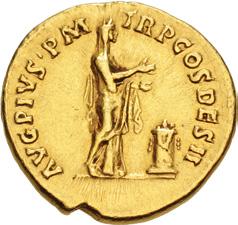
703. Antoninus Pius. AD 138-161. AV Aureus (19mm, 7.11 g, 6h). Rome mint. Struck AD 138. IMP T AEL CΛES HADRI ANTONINVS, bare head right / ΛVG PIVS • P M TR P COS DES II, Pietas, draped, standing right, holding acerra in left hand, raising right hand over lighted and garlanded altar to right. RIC III 13; Strack 19δ0; Calicó 1469 (same dies as illustration); BMCRE 28; Adda 173; Biaggi 697 (same dies). Minor deposits, light marks. Good VF. ($4000)
Ex Numismatik Naumann 113 (6 February 2022), lot 665; Dr. Hans Krähenbühl Collection (Leu Numismatik AG 8, 23 October 2021), lot 307.
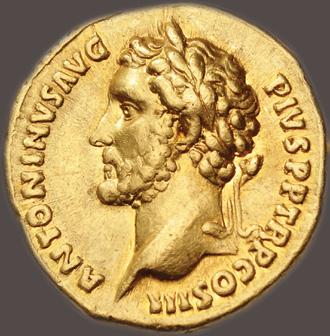


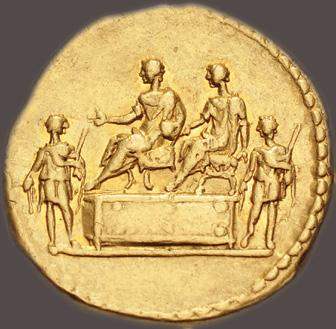
704. Antoninus Pius, with Marcus Aurelius as Caesar. AD 138-161. AV Aureus (18mm, 6.77 g, 6h). Rome mint. Struck AD 140. ANTONINVS AVG PIVS P P TR P COS III, laureate head left / Antoninus Pius and Marcus Aurelius, as Caesar, both togate, seated left on curule chairs on platform, each extending right hand, attended by two lictors on ground to left, looking right, and to right, looking left, respectively of the platform, each holding wand in right hand and fasces in left. RIC III –; Calicó 1734/1467a (for obv./rev. dies); BMCRE –; Adda -; Biaggi –; Jameson –; Mazzini –. Some underlying luster, faint hairlines, a few edge marks. Good VF. The anepigraphic reverse exhibits an artistic composition. Unique with laureate head left. None in CoinArchives. ($10,000)
This unique aureus features a heretofore unknown issue, struck from dies previously known for two separate aurei. The obverse die is from the rare issue that celebrates the association of Antoninus Pius with Marcus Aurelius as Caesar (Calicó 1734) dated to AD 140. The reverse is known only from a unique aureus in a private collection dated tentatively to AD 140-143. With the addition of this new unique aureus, the Calicó 1467a coin (unlisted in Cohen, BMCRE, and RIC) can more accurately be dated to AD 140, as it almost undoubtedly was struck alongside the Pius and Aurelius as Caesar issues, since they share die links. Thus, this unique aureus, alongside the Calicó 1467a coin, should be placed with the Antoninus Pius and Marcus Aurelius as Caesar aurei section of Calicó 1719-1735. Together, they constitute two supreme rarities with artistically composed anepigraphic reverses. Furthermore, these two coins are now better understood as deriving from the aurei emission of AD 140 and can be appropriately placed in that context.


705. Antoninus Pius. AD 138-161. Æ Sestertius (33mm, 23.43 g, 11h). Rome mint. Struck circa AD 141-143. ANTONINVS AVG PIVS P P TR P COS III, laureate head right / SA LVS AVG, S C across field, Salus, draped, standing left, feeding out of patera in right hand a serpent coiled around and rising from altar at left and holding vertical scepter in left hand. RIC III 635; Strack 854δ; Banti 340; BMCRE 1303. Brown patina. Near EF ($750)
Purchased by the consignor from Saslow Rare Coins, 1983.



706. Antoninus Pius. AD 138-161. AV Aureus (19mm, 7.22 g, 6h). Rome mint. Struck AD 147. ANTONINVS AVG PIVS P P, laureate and cuirassed bust right / TR PO T COS IIII, Roma, helmeted and draped, seated left on throne, holding palladium on extended right hand and vertical spear in left; round shield at side. RIC III 147d var. (bust type); Strack 143; Calicó 1658 (same dies as illustration); BMCRE 561 (same obv. die); Biaggi 766 (same dies); Mazzini 937 v. (same dies). Light reddish tone, minor edge marks. Near EF. ($5000)
Ex George W. La Borde Collection (Part III, Numismatica Ars Classica 105, 9 May 2018), 32; Classical Numismatic Group 91 (19 September 2012), lot 906; Numismatica Ars Classica 59 (4 April 2011), lot 1014; Gemini IV (8 January 2008), lot 426; Künker 27 (27 September 1994), lot 544; Schweizerischer Bankverein 33 (20 September 1993), lot 728.




707. Antoninus Pius. AD 138-161. AV Aureus (19mm, 7.26 g, 6h). Rome mint. Struck AD 148-149. ANTONINVS AVG PIVS P P TR P XII, laureate bust right, slight drapery on both shoulders / COS IIII, Aequitas, draped, standing left, holding scales in right hand and cornucopia in left. RIC III 177e var. (bust type); Calicó 1503; BMCRE 650; Adda 176; Biaggi 703; Gorny & Mosch 190, lot 499 (same dies). Edge marks. Near EF. High-relief portrait struck from dies of artistic merit. ($4000)
Ex MACM inventory MMoCA47C; Numismatica Ars Classica 52 (7 October 2009), lot 445.
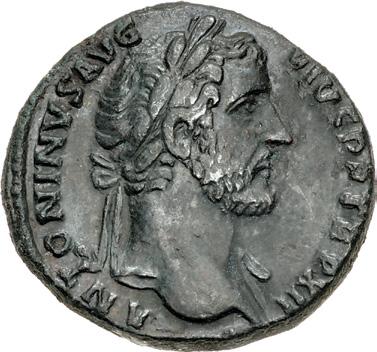

708. Antoninus Pius. AD 138-161. Æ Sestertius (31mm, 20.67 g, 12h). Rome mint. Struck AD 148-149. ANTONINVS AVG PIVS P P TR P XII, laureate bust right, slight drapery / TEMPORVM FELICITΛS, S C across lower field, COS II[II] in exergue, crossed cornucopias from which a grape bunch flanked by two grain ears hang, surmounted by busts of two boys, vis-à-vis. RIC III 857; Strack 1026δ; Banti 411; BMCRE 1827. Glossy dark green patina, smoothed, details strengthened. Near EF. ($1000)
From the Michael Rogal Collection. Ex William H. Whetstone Collection (Triton XXV, 11 January 2022), lot 915; Gorny & Mosch 240 (10 October 2016), lot 514.



709. Antoninus Pius. AD 138-161. AV Aureus (19mm, 7.20 g, 12h). Rome mint. Struck AD 150-151. ANTONINVS AVG PIVS P P TR P XIIII, laureate head right / LAETITIA CO S IIII, on left, Ceres, draped, standing right, holding two grain ears in right hand; on right, Proserpina, draped, standing facing, head left, holding pomegranate in left hand. RIC III 199c; Strack 224δ; Calicó 1556 (same dies as illustration); BMCRE 725; Biaggi 731 (same dies). Attractive light tone, lustrous. Near EF. ($6000)


710. Divus Antoninus Pius. Died AD 161. AR Denarius (19mm, 3.33 g, 5h). Consecration issue. Rome mint. Struck under Marcus Aurelius and Lucius Verus, AD 161. DIVVS ΛNTONINVS, bare head right / CONSECRΛTIO, Funeral pyre of four tiers, decorated with garlands, surmounted by facing quadriga. RIC III 436 (Aurelius); MIR 18, 27/4-10 (Aurelius); RSC 164; BMCRE 58-9. Lightly toned, underlying luster, traces of deposits. Choice EF. Well centered and struck with fresh dies. ($500)
From the Michael Rogal Collection. Ex Thomas A. Palmer Collection (Triton XXV, 11 January 2022), lot 920, purchased from Rick Ponterio, August 1989.



711. Marcus Aurelius. As Caesar, AD 139-161. AR Denarius (17mm, 3.30 g, 6h). Rome mint. Struck under Antoninus Pius, AD 147-148. AVRELIVS CAE SAR AVG PII F, bare head right / TR POT II COS II, Minerva, helmeted and draped, standing facing, head right, holding long scepter in right hand and resting left on shield set on ground to right. RIC III 438b (Pius); RSC 608; BMCRE 636-8 (Pius). Toned. Choice EF. Artistic portrait. ($500)
From the Michael Rogal Collection. Ex Dr. Patrick H. C. Tan Collection (Triton XX, 10 January 2017), lot 755; Edward Waddell Inventory 52248; Egon Beckenbauer Collection (Künker 257, 10 October 2014), lot 8537.




712. Marcus Aurelius. As Caesar, AD 139-161. AV Aureus (19mm, 7.26 g, 6h). Rome mint. Struck under Antoninus Pius, AD 159-160. ΛVRELIVS CΛES ΛVG P II F, bareheaded, draped, and cuirassed bust right / TR POT XIIII COS II, Mars, helmeted, naked but for cloak at back, advancing right, holding spear in right hand and trophy over left shoulder in left. RIC III 481b (Pius); Calicó 1975 (same obv. die as illustration); BMCRE 994, note (Pius); Biaggi 894 (same obv. die). Lustrous, minor scrape on obverse. Near EF. ($5000)
From the Michael Rogal Collection. Ex Classical Numismatic Group 100 (7 October 2015), lot 1891.



713. Faustina Junior. Augusta, AD 147-175. AV Aureus (20mm, 7.00 g, 6h). Rome mint. Struck under Antoninus Pius, circa AD 149. FAVSTINAE AVG PII AVG FIL, draped bust right, with hair bound in pearls at back of head / IV NO, Juno, diademed and draped, seated left on low seat, holding with right hand a child on her right knee and holding transverse scepter in left hand; to left, stands a child right, holding up two grain ears in right hand. RIC III 504 (Pius); Beckmann, Faustina, Group I (dies fa7/JS1); Calicó 2060 (same obv. die as illustration); BMCRE 1043 (same obv. die); Biaggi 930 (same obv. die). Tiny marks on obverse, minor edge marks. EF. Beautiful portrait, the same obverse die as the coin on the cover of Martin Beckmann’s book Faustina the Younger: Coinage Portraits, and Public Image ($5000)




714. Lucius Verus. AD 161-169. AV Aureus (18.5mm, 7.19 g, 6h). Rome mint. Struck under Marcus Aurelius and Lucius Verus, AD 161. IMP CΛES L ΛV REL VERVS ΛVG, bare head right / CONCORDIΛE ΛVGVSTOR, COS II in exergue, Lucius Verus and Marcus Aurelius, togate, standing facing each other, clasping right hands, each holding volumen in left hand. RIC III –; MIR 18, 4-12/10; Calicó 2110 (same dies as illustration); Adda 332 (this coin); Biaggi 948 (same dies). Lustrous. Superb EF. Boldly struck with fresh dies, a beautiful coin. ($10,000)
From the Georges Albert Haikel Collection. Ex Coin Galleries (10 February 1993), lot 13; Victor A. Adda (†1965) Collection (as Property of a Lady, Christie’s, 9 October 1984), lot 80; Prince Waldeck Collection (Münzhandlung Basel 8, 22 March 1937), lot 810.
Hadrian, childless and without either a successor or heir, chose Lucius Ceionius Commodus as his adopted son in AD 136, and renamed him as Lucius Aelius Caesar. Aelius was sent to the Roman province of Pannonia to serve as governor, where he died of tuberculosis in AD 138. Hadrian now made his second choice for his heir, Titus Aurelius Fulvus Boionius Antoninus. Hadrian actually wanted Marcus Aurelius to succeed him on the throne, but realized that Aurelius was far too young, so instead he went with the highly respected Antoninus. As a condition of his adoption, and to ensure an orderly line of succession, Antoninus Pius adopted both his nephew, Marcus Aurelius, and Aelius Caesar’s son, Lucius. The relatively young Lucius would change his name to Lucius Aelius Aurelius Commodus, but he would later drop Commodus and add Verus after ascending to the throne, along with his adoptive brother and co-ruler Marcus Aurelius. The present type depicts the two “brothers” and co-rulers clasping hands with an inscription noting the “harmony” between the two Augusti.

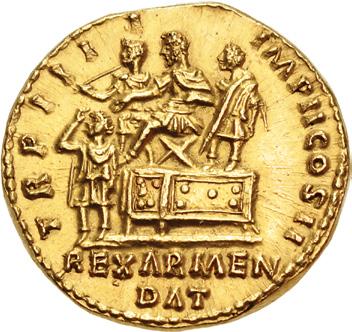

715. Lucius Verus. AD 161-169. AV Aureus (18.5mm, 7.32 g, 12h). Rome mint. Struck AD 164. • L • VERVS ΛVG ΛRMENIΛCVS, laureate, draped, and cuirassed bust right / TR P IIII IMP II COS II, REX ΛRMEN/ DΛT in two lines in exergue, Lucius Verus, in military dress, seated left on curule chair set on raised daïs; to left, a soldier, holding spear in right hand over right shoulder, looking left; on right, an officer standing left; in front of daïs to left, the Roman-appointed Armenian king, Sohaemus, standing left, raising right hand to head. RIC III 511 (Aurelius; same rev. die as illustration); MIR 18, 9212/37; Calicó 2151; BMCRE 300-301 var. (bust type; Aurelius and Verus); Adda 340 var. (bust type; same rev. die); Biaggi 956 var. (bust type; same rev. die); Mazzini 157 v. (same rev. die). Traces of deposits, edge marks. EF. ($6000)
From the Georges Albert Haikel Collection. Ex McLendon Collection (Christie’s, 12 June 1993), lot 150.

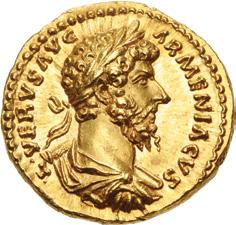
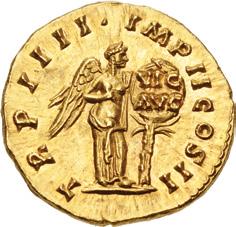

716. Lucius Verus. AD 161-169. AV Aureus (19mm, 7.18 g, 5h). Rome mint. Struck AD 164. • L • VERVS ΛVG ΛRMENIΛCVS, laureate, draped, and cuirassed bust right / TR P IIII • IMP II COS II, Victory, half draped, standing right, placing shield on palm tree inscribed VIC/ΛVG in two lines. RIC III 525 (Aurelius); MIR 18, 94-12/37; Calicó 2177 (this coin illustrated); BMCRE 296, note (Aurelius and Verus); Adda 344 (same dies); Biaggi 960 (same dies); Jameson 142 (same dies); Mazzini 247 v. and 247 v.* (same dies). Lustrous. Superb EF. ($10,000)
From the Georges Albert Haikel Collection. Ex McLendon Collection (Christie’s, 12 June 1993), lot 151; Santa Barbara Museum of Art Collection (Numismatic Fine Arts [I], 20 March 1975), lot 367.




717. Lucius Verus. AD 161-169. AV Aureus (19.5mm, 7.26 g, 6h). Rome mint. Struck under Marcus Aurelius and Lucius Verus, AD 164. • L • VERVS ΛVG ΛRMENIΛCVS, laureate and cuirassed bust right / TR P IIII • IMP II COS II, Hercules, naked, standing front, head right, wearing lion skin headdress and holding lion skin over left arm, holding up olive branch beside head in right hand and holding club in left. RIC III 517 (Aurelius); MIR 18, 77-12/35; Calicó 2172; BMCRE 281. Toned. EF. Lustrous. ($7500)
Ex MACM inventory MMoCA49C; Numismatica Ars Classica 52 (7 October 2009), lot 476.
As with most conflicts between Rome and Parthia, the great Eastern War of AD 161-166 was sparked by events in Armenia, the buffer between the two states. In AD 161, the Parthian king Vologases IV marched into Armenia and evicted its pro-Roman king, replacing him with his kinsman Pacorus. The Roman governor of Cappadocia marched into Armenia with a legion (perhaps the supposed ‘lost legion’ IX Hispana), but the Parthian general Chosroes surrounded the Romans and slaughtered them to a man, the worst military disaster to befall the Empire in nearly a century. The newly installed co-Emperors Marcus Aurelius and Lucius Verus responded by raising a massive expeditionary force and sending it east under Verus’ supposed command, but in reality commanded by the skilled general Avidius Cassius. After many months of preparation, the Romans invaded Armenia in 163, captured the capital of Artaxata and installed Sohaemus, a Roman citizen and Senator, on the throne. The Senate voted both Lucius Verus and Marcus Aurelius the title of Armeniacus, conqueror of Armenia, which is proudly displayed in its entirety on this gold aureus of AD 164.


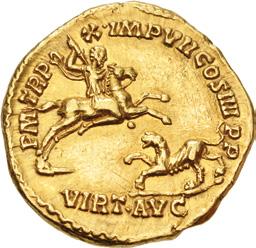

718. Commodus. AD 177-192. AV Aureus (20.5mm, 7.23 g, 6h). Rome mint. Struck AD 185. COMM • ANT AVG • P • BRIT, bareheaded, draped, and cuirassed bust right / P M TR P • X • IMP VII COS IIII P P, VIRT • AVG in exergue, Commodus, in short tunic, with cloak flying behind him, on horse rearing right, brandishing javelin in right hand at panther pacing left before him. RIC III 114; MIR 18, 666-2/18 corr. (TR P number); Calicó 2362 (this coin illustrated); BMCRE 168; Biaggi 1024 (this coin); Mazzini 956. Some scratches on reverse, edge scrapes and marks. Good VF. Very rare. ($10,000)
From the Georges Albert Haikel Collection. Ex McLendon Collection (Christie’s, 12, June 1993), lot 156; Leu 30 (28 April 1982), lot 392; Leo Biaggi de Blasys Collection; Niklovitz Collection (L. Hamburger [76], 19 October 1925), lot 1157; Prince Windisch-Graetz Collection.



719. Commodus. AD 177-192. AV Aureus (21mm, 7.30 g, 12h). Rome mint. Struck AD 185. COMM • ANT AVG • P • BRIT, bareheaded, draped, and cuirassed bust right / P M TR P X • IMP V II COS IIII P • P •, VIRT AVG in exergue, Commodus, in short tunic, with cloak flying behind him, on horse rearing right, brandishing javelin in right hand at panther pacing left before him. RIC III 114 (same dies as illustration); MIR 18, 666-2/18 corr. (TR P number); Calicó 2362 (same obv. die as illustration); BMCRE 168 (same dies); Biaggi 1024 (same obv. die); Mazzini 956 (same dies). Attractively toned, scrape on obverse. Near EF. Very rare. An impressive portrait. ($7500)
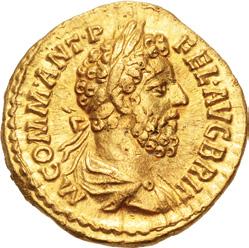


720. Commodus. AD 177-192. AV Aureus (20mm, 7.19 g, 11h). Rome mint. Struck AD 188. M COMM • ANT • P FEL
• AVG BRIT, laureate and draped bust right / P M TR P XIII • IM P VIII COS V P • P, Aequitas, draped, standing facing, head left, holding scales in right hand and cornucopia in left. RIC III 164 var. (bust type); MIR 18, 741-2/33; Calicó 2305; BMCRE 242 var. (same); Sincona 4, lot 4113 (same obv. die). Slight wave in flan. Good VF. ($6000)




721. Commodus. AD 177-192. AV Aureus (21mm, 7.24 g, 6h). Rome mint. Struck AD 188. M COMM • ANT • P • FEL
• AVG BRIT, laureate, draped, and cuirassed bust right / P M TR P XIII • IMP VIII COS V • P • P, Aequitas, draped, standing facing, head left, holding scales in right hand and cornucopia in left. RIC III 164 var. (bust type); MIR 18, 741-2/37; Calicó 2305 (same obv. die as illustration); BMCRE 242 var. (same); Adda 365 (same obv. die). Lustrous. EF. A bold and impressive portrait. ($10,000)
Ex MACM inventory MMoCA50C; Lanz 148 (with Numismatica Bernardi, 4 January 2010), lot 113.
The sole reign of Commodus, AD 180-192, is often viewed as the tipping point where the Roman Empire’s ascent ended and its long decline began. Commodus has thus been featured in novels, plays, and feature films, usually as a villain, most recently in the cinema epics “Fall of the Roman Empire” (1964), portrayed by Christopher Plummer, and “Gladiator” (2001), portrayed by Joaquin Phoenix. His actual persona, and the events of his 12-year sole reign, are far more complex and fantastical than depicted in either film. The son of the greatly revered “Philosopher Emperor” Marcus Aurelius (AD 161-180), Commodus was born “in the purple” in AD 161 and was raised in an almost monastically austere environment. Marcus raised him to the rank of Consul in January 177 and made him co-Augustus a few months later. He accompanied Marcus to the Danubian front on a strenuous military campaign against the Germanic tribes in 178; worn out by his exertions, Marcus died on 17 March AD 180. Freed of his dutiful father’s control, Commodus immediately cut a deal with the Germans and abandoned all further plans of military conquest. Returning to Rome, he plunged into sensual pursuits and left governing to a succession of favorites who plundered the public purse and aggrandized themselves. His lax rule soon led to plots against the regime, which were ruthlessly suppressed. Rejecting the intellectuality of his father, Commodus favored the physicality of the arena and fancied himself as a great athlete, hunter and gladiator. After the fall of his corrupt vizier Cleander in AD 190, Commodus took control of governmental affairs himself. Wealthy Romans in high positions were routinely executed so their estates could be confiscated to finance his orgy of self-indulgence. Still the Roman people seemed largely to enjoy his antics, and the legions remained loyal throughout. However, his close advisors began to fear for their own lives and ultimately arranged his death by strangulation at the hands of his wrestling instructor. The damage done by his 12 years of listless, corrupt rule was deep and lasting.
While Commodus continued and worsened the debasement of Roman silver coinage begun by his father, the gold coinage remained of high purity, weight and artistry. This beautiful aureus, struck at the mid point of his reign, depicts him as as a bearded philosopher-king much in the image of his father. The reverse evokes Aequitas, personification of equal justice, something in scarce supply during his reign.



722. Pertinax. AD 193. AR Denarius (18mm, 2.72 g, 6h). Rome mint. 2nd emission. IMP CAES P HELV PERTIN AVG, laureate head right / OPI DIVIN TR P COS II, Ops, draped, seated left on throne, holding two grain ears in right hand, left hand on seat of throne. RIC IV 8a; Lempereur Type 9, 467a (D173/R236 – this coin illustrated); RSC 33; BMCRE 19-20. In NGC encapsulation 4162265-001, graded XF, Strike: 5/5, Surface: 3/5. ($1000)
Ex Classical Numismatic Group Electronic Auction 296 (13 February 2013), lot 308.



723. Pertinax. AD 193. AR Denarius (18mm, 2.51 g, 6h). Rome mint. 2nd emission. IMP CAES P HELV PERTIN AVG, laureate head right / VOT DECEN TR P COS II, Pertinax, veiled and draped, standing front, head left, sacrificing out of patera in right hand over tripod to left, and holding volumen in left hand at side. RIC IV 13a; Lempereur Type 11, 642 (D240/R332); RSC 56; BMCRE 24. Toned, shallow file mark on edge. Near EF. Well struck for the issue. Exceptional portrait. ($1500)



724. Didius Julianus. AD 193. AR Denarius (17mm, 2.60 g, 12h). Rome mint. IMP CAES M DID IVLIAN AVG, laureate head right / RECTOR ORBIS, Didius Julianus, togate, standing left, holding globe in outstretched right hand and volumen in left. RIC IV 3; RSC 15; BMCRE 7-8. Toned, shallow scrape on obverse under tone. Near EF. An attractive example for issue. ($2000)
Ex MACM inventory MMoCA182C; A. Lynn Collection (Manhattan Sale I, 5 January 2010), lot 332; Classical Numismatic Group 53 (15 March 2000), lot 1612.
Didius Julianus was born to a wealthy family in AD 137, probably in Milan. He had a prominent government career, including several provincial governorships, in the reigns of Marcus Aurelius and Commodus. Though successful, he did not earn the respect of his fellow senators, who regarded him as a sensualist and a spendthrift. When the Emperor Pertinax was killed by the Praetorians after only a threemonth reign on March 28, AD 193, no ready successor was at hand. Pertinax’s father-in-law, Flavius Sulpicianus, entered the Praetorian camp and tried to get the troops to proclaim him emperor, but he met with little enthusiasm. Sensing an opportunity, Didius Julianus rushed to the camp and began to make cash promises to the soldiers from outside the wall. Soon the scene became an auction, with Sulpicianus and Julianus striving to outbid each other for the favor of the troops. When Sulpicianus reached 20,000 sesterces per soldier, Didius Julianus upped the bid by a whopping 5,000 sesterces, signaling with hand gestures. The emperorship was sold. Julianus was allowed into the camp and the Praetorians proclaimed him emperor. Confronted by the Praetorian swords, the Senate approved his elevation, but could not hide its disgust. Disturbances broke out throughout the city, and a crowd at the Colosseum loudly called for Pescennius Niger, governor of Syria, to march on Rome. Niger was not the only alternative. Two other provincial governors also declared themselves emperor: Clodius Albinus in Britain, and Septimius Severus in Pannonia. Severus, closest to Rome, immediately marshaled his troops and invaded Italy. Julianus at first tried negotiations, then sent assassins to kill Severus, to no avail. Julianus next tried to fortify Rome but the results were ineffective and ludicrous. With Julianus’ authority in Rome rapidly deteriorating, Severus sent messages to the Praetorians, who renounced their allegiance to Julianus. Seeing their cue, the Senators proclaimed Severus emperor and passed a death sentence on Julianus. On June 1, AD 193, a Praetorian officer found the cringing Julianus hiding in the palace and dispatched him, ending his pathetic 65-day reign.
The reverse of this attractive silver denarius depicts Julianus with the grandiose title “Rector Orbis,” or ruler of the world. In reality, his authority never extended far beyond the immediate environs of Rome.


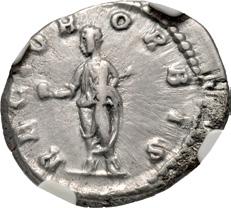
725. Didius Julianus. AD 193. AR Denarius (18mm, 2.85 g, 12h). Rome mint. IMP CAES M DID IVLIAN AVG, laureate head right / RECTOR ORBIS, Didius Julianus, togate, standing left, holding globe in outstretched right hand and volumen in left. RIC IV 3; RSC 15; BMCRE 7-8. In NGC encapsulation 2412974-015, graded XF, Strike: 4/5, Surface: 3/5. ($1000)



726. Julia Domna. Augusta, AD 193-217. AV Aureus (20mm, 7.27 g, 12h). Rome mint. Struck under Septimius Severus, circa AD 193-196. IVLIA DO MNA AVG, draped bust right / VENERI • VICTR, Venus Victrix, with drapery falling below hips, standing with back turned, head right, resting left arm on low column, holding apple in extended right hand and in left, palm frond sloped upward to left. RIC IV 536 (Septimius); Calicó 2641; BMCRE 48 (Wars of Succession; same obv. die); Adda 412 (same obv. die); Biaggi 1155; Jameson 173 (same obv. die); CNG 127, lot 564 (same dies). Attractively toned. EF. ($7500)
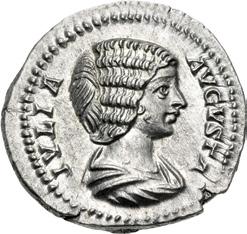


727. Julia Domna. Augusta, AD 193-217. AR Denarius (19.5mm, 3.40 g, 6h). Rome mint. Struck under Septimius Severus and Caracalla, circa AD 200-207. IVLIA AVGVSTA, draped bust right / CERERI FRVGIF, Ceres, draped, seated left, holding grain ears in right hand and long torch in left. RIC IV 546 (Septimius); RSC 14; BMCRE 10-13 (Septimius and Caracalla). Die breaks and minor flan flaws on the reverse. Superb EF ($500)
From the Michael Rogal Collection. Ex Rome on the Euphrates Collection (Triton XXV, 11 January 2022), lot 948.
Displayed at the “Villa to Grave” Roman exhibit at the Cedar Rapids Museum of Art September 2003-August 2005.
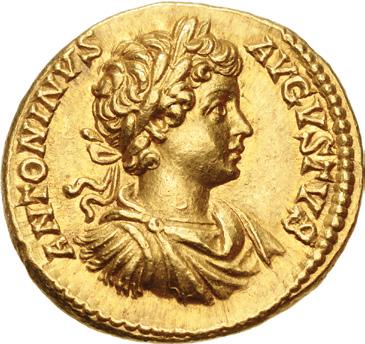



728. Caracalla. AD 198-217. AV Aureus (19.5mm, 7.18 g, 12h). Rome mint. Struck AD 199-201. ANTONINVS AVGVSTVS, laureate, draped, and cuirassed bust right / IVVEN TA IMPERII, Caracalla, in military dress, with cloak falling over left arm, standing left, holding Victory on globe right on extended right hand and reversed spear in left; to left, captive, wearing peaked cap and long robe, seated left on the ground, propping head on right hand, right arm bent and resting on right knee. RIC IV –; Calicó 2685 (this coin illustrated); BMCRE –; Biaggi 1178 (this coin). Small scrape on reverse. Near EF. Wonderful high-relief portrait. Very rare. ($10,000)
From the Georges Albert Haikel Collection. Ex McLendon Collection (Christie’s, 12 June 1993), lot 161; Leo Biaggi de Blasys Collection; Henry Platt Hall Collection (Part II, Glendining’s, 16 November 1950), lot 1709; Sir Arthur J. Evans Collection (Naville III, 16 June 1922), lot 95, acquired in Egypt, 1905.


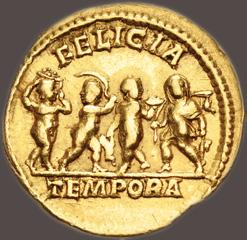

729. Caracalla. AD 198-217. AV Aureus (19.5mm, 7.23 g, 12h). Rome mint. Struck AD 205-206. ANTONINVS PIVS AVG, laureate and draped bust right / FELICIA above, TEMPORA in exergue, the Four Seasons, dancing and showing their attributes: from left to right, Spring carries a basin on his head, Summer holds a sickle in right hand above his head, Autumn holds a hare and a tray full of fruit, Winter wears a hood over his head and holds a bird which he has just captured, probably a wild duck. RIC IV 126; Calicó 2672 (this coin illustrated); BMCRE p. 207, note *; Adda –; Biaggi 1176 var. (bust type); Jameson –; Mazzini –. Scratch on obverse. VF. Extremely rare. None in CoinArchives, missing from most collections. ($20,000)
From the Georges Albert Haikel Collection. Ex Spink America 8232 (7 December 1995), lot 2215.
This charming reverse depicts Spring, Summer, Autumn, and Winter in the guise of young boys at play, with each season bearing some symbol of its gift to mankind. Although a common motif in Roman sculpture and painting, its appearance on coinage is rare, recurring from time to time on issues from the 2nd century until the Tetrarchic period.
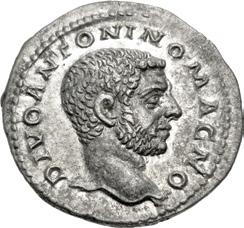
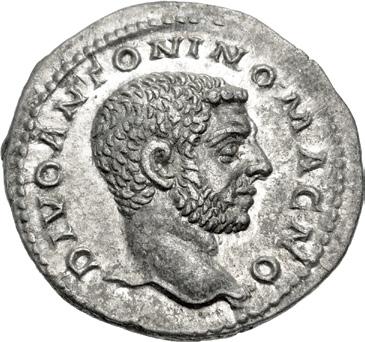

730. Divus Caracalla. Died AD 217. AR Denarius (19mm, 3.12 g, 12h). Consecration issue. Rome mint. Struck under Elagabalus, AD 218-219. DIVO ANTONINO MAGNO, bare head right / CONSECRATIO, eagle standing left on globe, head right, with wings spread. RIC IV 717 (Severus Alexander); Thirion 500; RSC 32; BMCRE 7 (Elagabalus). Toned, slightly granular surfaces. Near EF. Rare and attractive for issue. ($1500)
From the Michael Rogal Collection. Ex Triton XX (10 January 2017), lot 803.



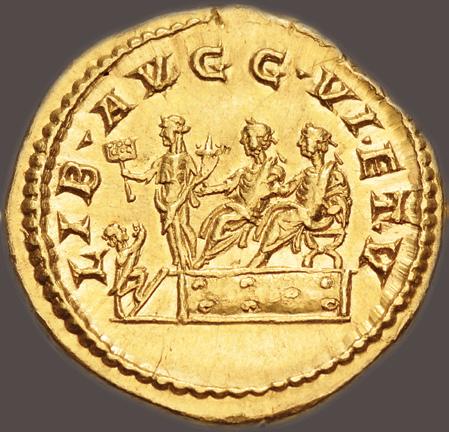
731. Geta. AD 209-211. AV Aureus (20.5mm, 7.52 g, 6h). Rome mint. Struck AD 211. P SEPT GETA PIVS AVG BRIT, laureate and bearded bust right, slight drapery / LIB • AVGG • VI • ET • V, distribution scene: Caracalla and Geta, togate, seated left on on curule chairs on platform, extending right hands, to left stands Liberalitas, draped, holding abacus in right hand and cornucopia in left; to left, citizen, togate, standing right, setting one foot on steps to platform and holding out fold of toga with both hands. RIC IV 87 corr. (rev. legend) var. (bust type); Calicó 2889 (same obv. die as illustration); BMCRE 64 var. (same); Adda –; Biaggi 1250 var. (same); Jameson 198 var. (same); Mazzini 70 var. (same). Faint hairlines, minor marks. Near EF. Very rare with slight drapery. ($25,000)
From the Georges Albert Haikel Collection. Ex Dr. Anton C. R. Dreesmann Collection (Part I, Spink London 1238, 13 April 2000), lot 16; Sternberg XIX (18 November 1987), lot 729.




732. Elagabalus. AD 218-222. AV Aureus (21mm, 6.45 g, 12h). Rome mint. Struck AD 220-221. IMP ANTONINVS PIVS AVG, laureate and cuirassed bust right / P M TR P III COS III P P, Elagabalus, laureate and togate, standing in triumphal quadriga left, holding up branch in right hand and transverse scepter in left; small star, high in left field. RIC IV 35c; Thirion 159; Calicó 3011 (same obv. die as illustration); BMCRE 182 (same obv. die); Adda –; Biaggi –; Jameson –; Mazzini –. Lustrous. Near EF. Rare, missing from most collections. ($10,000)
From the Georges Albert Haikel Collection. Ex Dr. Anton C. R. Dreesmann Collection (Part I, Spink, 13 April 2000), lot 18 (reverse illustrated on front cover); Sternberg XIX (18 November 1987), lot 741.


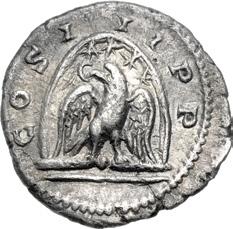
733. Elagabalus. AD 218-222. AR Denarius (18.5mm, 2.54 g, 12h). Antioch. Struck AD 219-220. IMP ANTO NINVS AVG, laureate and draped bust right / COS I II P P, eagle, wings spread and head left, standing half-right on thunderbolt before Stone of Emesa, holding wreath in beak; five stars above. RIC IV 176; Thirion 336; RSC 26; BMCRE p. 584, * = Arnold 252; Triton XXI, lot 798 (same dies). Toned, slightly granular surfaces, shallow cleaning marks, hairline flan crack. Good VF. Very rare. Only three others in CoinArchives. ($5000)
At the age of fourteen, Varius Avitus Bassianus (Elagabalus) inherited the office of high priest of the sun-god Elagabalus at Emesa in Syria. The cult of his sun god was represented by a sacred stone, and in AD 219 when he moved from Emesa to Rome, he took the stone, probably a meteorite, with him. This coin type commemorates this event. During his reign, Elagabalus devoted his efforts to the promotion of his cult god, building a lavish temple to house the stone.




734. Severus Alexander. AD 222-235. AV Aureus (21mm, 6.48 g, 5h). Rome mint. 1st emission, early AD 222. IMP C M AVR SEV ALEXAND AVG, laureate, draped, and cuirassed bust right / P M TR P C OS P P, Salus, draped, seated left on throne, feeding from patera in right hand serpent coiled around and rising from altar to left, and resting left arm, elbow bent, on side of throne. RIC IV 13; BMCRE 32; Calicó 3085; Adda –; Biaggi –; Jameson –; Mazzini –; Gorny & Mosch 207, lot 666 (same rev. die). Lustrous, minor hairlines. EF. Very rare and missing from most collections. ($5000)



735. Orbiana. Augusta, AD 225-227. AR Denarius (17.5mm, 3.24 g, 12h). Rome mint. Special marriage emission of Severus Alexander, AD 225. SALL BARBIA ORBIANA AVG, draped bust right, wearing stephane / CONCORDI A AVGG, Concordia, draped, seated left, holding patera in right hand and double cornucopia in left. RIC IV 319 (Alexander); BMCRE 287-9 (Alexander); RSC 1. Toned. In NGC encapsulation 8209274-015, graded AU, Strike: 5/5, Surface: 4/5. ($750)
Ex Brian Henry Grover Collection (Roma E-Sale 72, 25 June 2020), lot 1204 (hammer £1900).



736. Gordian I. AD 238. AR Denarius (19mm, 2.36 g, 12h). Rome mint. Struck 1-22 April. IMP M ANT GORDIANVS
AFR AVG, laureate, draped, and cuirassed bust right / SECVRITAS AVGG, Securitas, draped, seated left on throne, holding scepter in right hand, fold of drapery over left arm. RIC IV 5; BMCRE 11; RSC 10. Toned. In NCG encapsulation 4277292001, graded AU, Strike: 5/5, Surface: 3/5. ($2000)



737. Gordian II. AD 238. AR Denarius (19.5mm, 2.78 g, 6h). Rome mint. Struck 1-22 April. IMP M ANT GORDIANVS
AFR AVG, laureate, draped, and cuirassed bust right / VIRTVS AVGG, Virtus, helmeted and in military attire, standing left, resting right hand on shield set on ground to left and holding reversed spear in left. RIC IV 3; BMCRE 30; RSC 14. Toned. NGC photo certification 4165633-003, graded VF, Strike 5/5, Surface 2/5. ($2000)
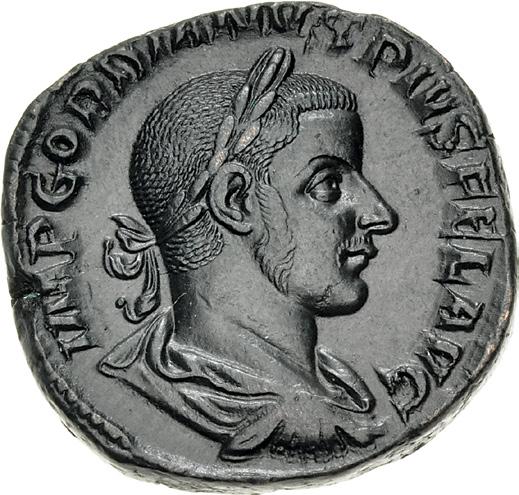



738. Gordian III. AD 238-244. Æ Sestertius (28mm, 18.63 g, 12h). Rome mint, 6th officina. 12th emission, mid-late AD 243. IMP GORDIANVS PIVS FEL AVG, laureate, draped, and cuirassed bust right / MARTEM PROPVGNATOREM, Mars, wearing helmet and military attire, advancing right, holding transverse spear in right hand and shield in left; S C across lower field. RIC IV 333; Banti 53. Beautiful dark brown patina, some doubling, gentle smoothing. EF. An incredibly bold strike with magnificent detail. ($1000)
Ex MACM inventory MMoCA77C; Classical Numismatic Group 84 (5 May 2010), lot 1242.



739. Jotapian. Usurper, circa AD 248-249. Antoninianus (21mm, 4.37 g, 12h). Nicopolis in Seleucia mint. IMP M F RV IOTAPIANVS, radiate and cuirassed bust right / VIC TORIA AVGV, Victory, draped, advancing left, holding wreath in right hand and palm frond in left. RIC IV 2c; Bland, Jotapian 3 (dies I/ii); RSC 2. Toned, typical rough surfaces, some deposits. VF. Well struck for the issue. Excellent portrait. ($3000) Jotapian († AD 249) led a short-lived revolt in Syria while Philip I was still emperor. Little is known of Jotapian’s background. It was said that he boasted of a relationship to Severus Alexander, and his unusual name, although otherwise unknown for a man, is attested in its feminine form “Jotape” in the royal houses of Commagene and Emesa. The revolt was brief, and the crude style proves that the revolt was geographically confined, for Jotapian plainly did not control a major Roman mint. His head was brought to Rome and shown to Trajan Decius “as was customary, although Decius had not asked for it” (Aur. Vict., Caes. 29.4).


740. Trajan Decius. AD 249-251. Æ Double Sestertius (31.5mm, 25.30 g, 11h). Rome mint, 5th officina. 2nd-3rd emissions, late AD 249-mid 250. [IMP] C M Q TRAIANVS DECIVS AVG, radiate and cuirassed bust right / V[ICT]O[RIA AV]G, S C across field, Victory, draped, advancing left, holding wreath in right hand and palm frond in left. RIC IV 126a; Banti 29 (this coin illustrated); Gnecchi III 6, pl. 161, 4. Dark green-brown patina, chipping at edge. Near EF. ($750)
Purchased by the consignor from Harlan J. Berk.




741. Postumus. Romano-Gallic Emperor, AD 260-269. AV Aureus (20mm, 5.66 g, 12h). Trier mint. 4th emission, circa mid AD 262-mid 263. IMP C POSTV MVS • P • F • AVG, laureate, draped, and cuirassed bust right / HERC DEVS ONIENSI, Hercules, nude, standing right, right hand resting on hip, left hand holding lion skin and long club which rests on rock. RIC V.4 195/5 (this coin cited and illustrated); Schulte 37 (dies Av 24/Rv 25 [unlisted die combination]); Calicó –; Adda 513 (same rev. die). Lustrous, a few marks, light edge marks. Near EF. Extremely rare.
($30,000)
Ex Leu Numismatik AG 1 (25 October 2017), lot 341.
By AD 260, Rome had divided her military forces between the eastern deserts, where Valerian campaigned against the Sasanians, and the forests of Germania, where Gallienus was engaged with Alemanni, Franks, and Jugunthi. While the war in the east went poorly for the Empire, the army met with success in the north as Postumus and his troops crushed a Jugunthian army returning from raiding Italy. The troops were ordered to deliver the spoils to the emperor, but refused, raising Postumus to the purple. Rather than claiming the entirety of Roman dominion as his own, the usurper instead consolidated his territory and focused his efforts on controlling Germania, Gaul, Britain, and Hispania. This tactic proved successful. Postumus reigned in Gaul for eight years, duplicating Roman governmental structures such as the senate and the office of consul and securing his borders from both barbarians and Rome until 269, when he was assassinated at Mogontiacum (Mainz) amidst internal unrest.




742. Postumus. Romano-Gallic Emperor, AD 260-269. Denarius (19mm, 2.81 g, 12h). Offstrike from aureus dies. Trier mint. 8th emission, circa early-circa mid AD 268. POSTVMVS PIVS FELIX AVG, laureate and cuirassed bust of Postumus right, seen from front, with fold of drapery on left shoulder, jugate with the laureate head of Hercules / HERCVLI PISAEO, Hercules, nude, standing left, seen from behind, brandishing long-handled ax with both hands; water jar (for cleansing the Augean stables) at his feet to left. RIC V. 4 362 (this coin cited and illustrated); cf. Schulte 135 (for rev. type); RSC 134 var. (bust left). Darkly toned, pososity, flan crack. VF. Unique. This coin shares a reverse die with the aureus of the same type (RIC V.4 364/1). ($5000)
Ex Jacquier 42 (16 September 2016), lot 583 (hammer €9,000).
Hercules, the son of Zeus and Alcmene, endured the jealousy and hatred of Hera, the sister and wife of Zeus. Hera made Hercules insanely mad, leading him to kill his wife, six of his own children, and two of his brothers, mistaking them for his enemies. Overcome with remorse, Hercules went to Delphi and sought guidance from the Oracle. Aware that Hera wanted nothing more than to kill Hercules, the Oracle required that Hercules serve Eurystheus, King of Mycenae, for twelve years. The king demanded that Hercules complete a series of impossible labors, sometimes called the “twelve impossible tasks,” to make atonement for his actions and be rewarded with immortality. The Twelve Labors of Hercules required extraordinary physical strength and clear mental acumen to achieve.
Cleansing the Augean Stables was the Fifth of the Twelve Labors of Hercules. For decades the stables of King Augeas had gone uncleaned, building up filth upon filth. His task was to clean these vast stables. Hercules diverted waters of two nearby rivers, effectively cleaning all the stables in a single day.
On the reverse of the coin celebrating this feat is the legend HERCVLI PISAEO, “To the Pisan Hercules”: Hercules called Pisan from Pisa, the name of the area around Olympia where he was especially worshipped.



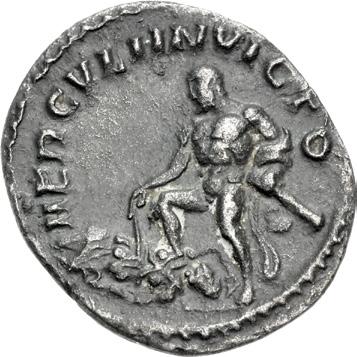
743. Postumus. Romano-Gallic Emperor, AD 260-269. Denarius (19mm, 2.28 g, 12h). Trier mint. 8th emission, circa early-circa mid AD 268. POSTVMVS PIVS FELIX AVG, laureate and cuirassed bust of Postumus right, seen from front, with fold of drapery on left shoulder, jugate with the laureate head of Hercules / HERCVLI INVICTO, Hercules, nude, standing left, holding club in left hand, lion skin over left arm, right foot on Hippolyta (Queen of the Amazons) lying on the ground, taking her girdle from right hand. RIC V.4 373/12 (this coin cited); Schulte 143 (dies Av 83/Rv 98); RSC 123. Darkly toned, porous surfaces, deposits, hairline flan crack. VF. Very rare. This coin shares a reverse die with the aureus of the same type (RIC V.4 374/1). ($7500)
Ex Peus 417 (2 November 2016), lot 613 (hammer €17,000).
The Ninth Labor of Hercules required him to obtain the golden, magic girdle of Ares, worn by Hippolyta, queen of the Amazons. Various versions of the story exist, but the most generally accepted version is that Hercules, after defeating the Amazons, killed Hippolyta, removed her girdle (symbol of her power), thus completing his assigned task.
On the reverse of this coin the legend HERCVLI INVICTO is found, meaning “To the unconquered Hercules.” This same legend is found on other Hercules types of Postumus, such as the Cretan bull and the Nemean lion.
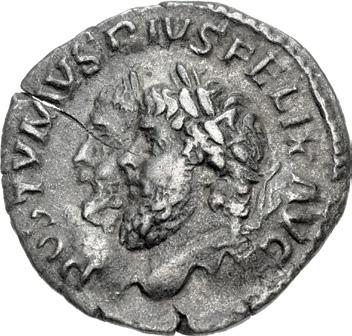



744. Postumus. Romano-Gallic Emperor, AD 260-269. Denarius (19mm, 2.60 g, 12h). Trier mint. 8th emission, circa earlycirca mid AD 268. POSTVMVS PIVS FELIX AVG, laureate head of Postumus left, jugate with the head of Hercules / HERCVLI ROM, Hercules, nude, seen from behind, head left, holding club (whose tip is resting on the ground) in right hand, lion skin over left arm, facing the tree of the Hesperides; at left, three Hesperides, draped, fleeing to the left. RIC V.4 380/3 (this coin cited); Schulte 149c (this coin cited); RSC 135 var. (busts right). Darkly toned, light porosity, flan crack. VF. Very rare. This coin shares an obverse die with the following aurei: (RIC V.4 352/1, 361/1, and 366/1). ($7500)
Ex Jacquier 42 (16 September 2016), lot 584 (hammer €16,000); Dr. Theodor Voltz Collection (Münzen und Medaillen AG 81, 18 September 1995), lot 313.
Because he had been assisted in completing some of his earlier tasks, Hercules was compelled to undergo two more labors. The first of these, labor eleven, was to steal the Golden Apples of the Hesperides, nymphs who lived in a grove at the far western edge of the world. Hercules tricked the Titan Atlas, whose task it was to hold up the heavens, to retrieve the apples in return for holding up the heavens while he did so. Having accomplished the task, Atlas was reticent to give up his freedom, and told Hercules that he would take back the apples to Mycenae. Once again, Hercules tricked the Titan, requesting that Atlas hold the heavens, while Hercules adjusted his cloak to be more comfortable.
On the reverse of this coin the legend HERCVLI ROM, “To the Roman Hercules”: Hercules stands by the tree laden with the golden apples of the Hesperides, nymphs who were known as daughters of the evening, three of whom stand near him.

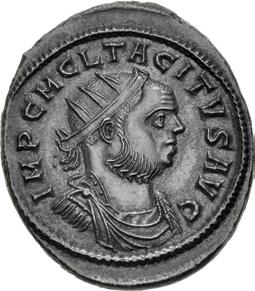


745. Tacitus. AD 275-276. Antoninianus (20.5mm, 4.86 g, 6h). Ticinum mint, 6th officina. 2nd emission, early-June AD 276. IMP C M CL TACITVS AVG, radiate, draped, and cuirassed bust right / SECVRIT PERP, Securitas, draped, standing left, legs crossed, placing right hand on head and resting left arm on column to right; Ч. RIC V Online 3381; RIC V 163; BN 1708-9. In NGC encapsulation 6830026-001, graded MS★, Strike: 5/5, Surface: 5/5. ($1000)
Ex Brian Henry Grover Collection (Roma E-Sale 72, 25 June 2020), lot 1359, purchased from B. Carter, 1964.


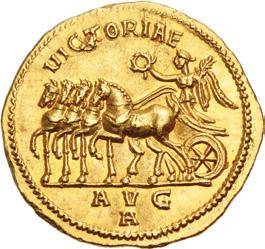
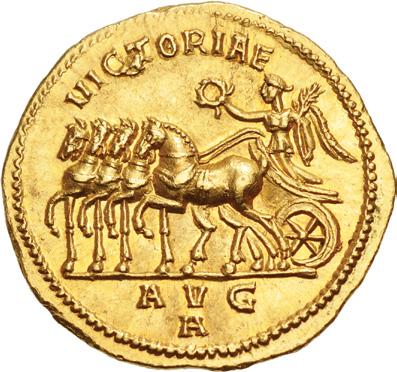
746. Probus. AD 276-282. AV Aureus (20.5mm, 6.36 g, 11h). Antioch mint. 2nd emission, AD 280. IMP C M AVR PROBVS AVG, laureate, draped, and cuirassed bust right / VICTORIAE, Victory in triumphal quadriga left, holding wreath in right hand and palm frond in left; AVG/ A in two lines in exergue. RIC V 916; Pink VI/1, p. 40; Calicó 4224; Adda 525 (same obv. die); Biaggi 1629 (same obv. die); Jameson 294 (same obv. die). Minor marks. EF. ($10,000)
From the Georges Albert Haikel Collection. Ex Dr. Anton C. R. Dreesmann Collection (Part I, Spink London 1238, 13 April 2000), lot 57; Sternberg XVIII (20 November 1986), lot 641.
Marcus Aurelius Probus was one of a series of tough Balkan military men who rescued the Roman Empire from certain destruction in the late third century. He was the son of a peasant gardener who entered the army as a teenager and rose steadily through the ranks. By AD 276, he had achieved command of the Roman field armies in Syria and Egypt and was well-positioned to seize the throne when the elderly emperor Tacitus died. His reign was one of constant, frenetic military activity, racing from one frontier to the other to confront and defeat enemy invaders or internal usurpers.



747. Divus Nigrinian. Died circa AD 284. Antoninianus (22.5mm, 4.28 g, 12h). Rome mint. 5th emission of Carinus, mid November AD 284. DIVO NIGRINANO, radiate head right / CONSECRATIO, eagle standing facing, head left, wings spread; KAA. RIC V 472; Pink VI/2, p. 38. Dark olive-brown patina with some verdigris. Near EF. A very attractive example in hand. ($1000)
Ex MACM inventory MMoCA170C, purchased from Ian Roper Coins and Antiquities, 26 June 2009; Baldwin’s 57 (23 September 2008), lot 201; Numismatic Fine Arts XXVII (4 December 1991), lot 178.



748. Julian of Pannonia. Usurper, AD 284-285. Antoninianus (22mm, 3.91 g, 12h). Siscia mint, 1st officina. Struck December AD 284. IMP C M AVR IVLIANVS P F AVG, radiate, draped, and cuirassed bust right / VICT ORI A AVG, Victory, draped, advancing left, holding wreath in extended right hand and cradling palm frond in left arm; S|A//XXI. RIC V 5; Pink VI/2, p. 49; Venèra 4397. Attractive dark olive brown-green patina, area of deposits. Good VF. ($2000)
Ex MACM inventory MMoCA210C; Baldwin’s 57 (23 September 2008), lot 202.
Marcus Aurelius Sabinus Iulianus, was a corrector in Northern Italy under Carus. In AD 284, during the struggles surrounding the succession between Carinus and Diocletian, Julian usurped imperial authority in Pannonia for a brief period and began issuing coins from Siscia. Carinus marched from his base in Britain to deal with the usurpation, dispensing with Julianus early in AD 285 near Verona.



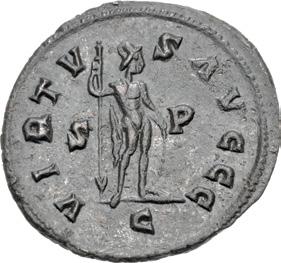
749. Diocletian. AD 284-305. Antoninianus (22mm, 4.48 g, 6h). ‘C’ mint. Struck under Carausius, circa AD 286-circa 293. IMP C DIOCLETIANVS AVG, radiate and cuirassed bust right / VICTO R I A AVGGG, Victory, draped, advancing left, holding wreath in outstretched right hand and palm frond held in left arm; S|P//C. RIC V.5 3591 (forthcoming); cf. RIC V 29 (for similar issue); Bourne 143. Dark brown patina, a couple of die breaks, spot of minor cleaning scratches. EF. ($750)
750. Diocletian. AD 284-305. Antoninianus (22.5mm, 4.16 g, 7h). ‘C’ mint. Struck under Carausius, circa AD 286-circa 293. IMP C DIOCLETIANVS P AVG, radiate and cuirassed bust right / VIRTV S AVGGG, Virtus, helmeted and nude but for chlamys draped over shoulders, standing right, holding reversed spear in right hand and resting left hand on shield set on ground to right; S|P//C. RIC V.5 3593 (forthcoming); RIC V 30 var. (bust type); Bourne 147. Attractive even dark olive brown-green patina, minor pit. EF. Extremely rare. ($750)


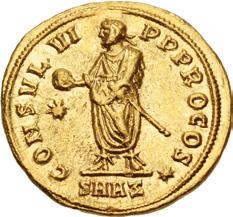

751. Diocletian. AD 284-305. AV Aureus (18.5mm, 5.30 g, 6h). Consular issue. Antioch mint. Struck circa AD 296-circa 299/302. DIOCLETIA NVS AVGVSTVS, laureate head right / CONSVL VI P P PROCOS d, Diocletian standing left, laureate and togate, holding globe in outstretched right hand and short scepter in left; d|–//SMA%. Cf. RIC VI 13 and 22 (for similar issues of COS VI and COS VII respectively); cf. Lukanc p. 226, 15 and 18 (same); cf. Depeyrot 12/1 and 16/1 (same); cf. Calicó 4440 and 4441 (same); cf. Biaggi 1699 and 1700 (same); Mazzini –. Some luster. Near EF. Extremely rare and unpublished variety. ($6000)
Ex MACM inventory MMoCA52C; Classical Numismatic Group 121 (6 October 2022), lot 945; Classical Numismatic Group 82 (16 September 2009), lot 1062.
While the mint mark with the star at end of the legend paired with SMAΣ is known for Diocletian during his sixth consulship (RIC VI 13), the addition of the star in the left field (RIC VI 22) is known only for the seventh consulship. On this coin, one finds the far rarer mint mark of RIC 22 paired with the reverse legend of Diocletian’s sixth consulship of AD 296-297.




752. Maximianus. First reign, AD 286-305. AV Aureus (18mm, 5.54 g, 12h). Treveri (Trier) mint. 4th emission, mid-late AD 295. MAXIMI ANVS P F AVG, laureate head right / VIRTVTI AVG•G•, Hercules, nude, raising club held in right hand and grasping the Erymanthian boar by the scruff in his left hand and holding it slung over his left shoulder; PT. RIC VI 25; Zanchi & Estiot 78b (MAX 24/R 36 – this coin); Depeyrot 1D/7; Calicó 4755; Biaggi –; Mazzini –. Lightly toned, lustrous, a few minor marks. Near EF. Extremely rare. An outstanding example of this issue that is rarely seen at auction. A total of seven examples known, of which four are in museum collections. The first-cited Cohen coin derives from a line drawing in Caylus (1760, no. 1028), the whereabouts of which are unknown. ($10,000)
Ex Peus 355 (27 April 1998), lot 1043; Tkalec (25 October 1996), lot 261.
During his rule, emperor Maximianus adopted the sobriquet ‘Herculius’ or ‘Hercules’ and consequently associated himself with the Demigod, utilizing Herculean iconography throughout his reign while his senior partner Diocletian associated himself with Jupiter and did likewise on his coinage. On this impressive run of seven aurei of Maximianus, one finds three of the twelve labors of Hercules depicted on the reverse in vivid detail in addition to other Herculean iconography such as the lion skin headdress. Represented on these aurei are the 1st, 3rd, and 4th labors. Additionally, Hercules’ battle with the centaur Nessus is also recounted. This battle would ultimately result in Hercules’ death. As Nessus was ferrying Hercules’ wife Deianeira over the river Evenus, he assaulted her, sparking a battle between the Centaur and the Demigod. Hercules slew Nessus with an arrow tipped with the poisonous blood of the Lernaean Hydra from his second labor. As he was dying, Nessus convinced Deianeira to take some of his blood, infected with the Hydra’s poison. With this blood, Deianeira later accidentally killed Hercules upon growing suspicious of his faithfulness to her by lacing his robe with it, not realizing its fatal potency.
Five of these seven aurei are extremely rare examples. Furthermore, some of them are the finest known specimen of these very difficult and desirable issues. This selection of aurei affords a rare opportunity to acquire outstanding specimens of these wonderful Hercules reverse types of Maximianus Hercules.

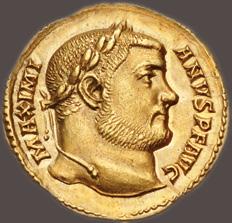


753. Maximianus. First reign, AD 286-305. AV Aureus (18.5mm, 5.19 g, 6h). Treveri (Trier) mint. Struck March AD 302. MAXIMI ANVS P F AVG, laureate head right / HERCVLI CON SERVATORI, head of Hercules right, wearing lion skin; TR. RIC VI 46; Depeyrot 7A/1; Calicó 4654 (this coin illustrated); Biaggi 1813 = Beaurains 255 = A. Baldwin Brett, “The Aurei and Solidi of the Arras Hoard” in NC 1933, p. 311, 90 (3) (this coin); Mazzini –. Attractively toned, a few light marks. EF. Extremely rare. This coin erroneously cited twice in two separate entries in Depeyrot’s 2004 corpus. ($20,000)
From the Georges Albert Haikel Collection. Ex Dr. Anton C. R. Dreesmann Collection (Part I, Spink, 13 April 2000), lot 78; Numismatic Fine Arts XVI (2 December 1985), lot 536; Leo Biaggi de Blasys Collection; Henry Platt Hall Collection (Part II, Glendining, 16 November 1950), lot 1983; R. Ratto (2 April 1923), lot 398; 1922 Arras – Beaurains Hoard.
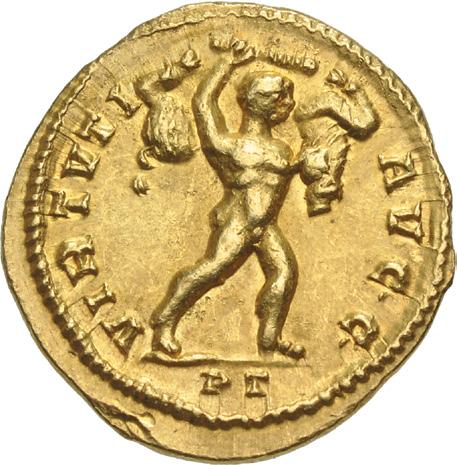










754. Maximianus. First reign, AD 286-305. AV Aureus (17.5mm, 5.27 g, 6h). Treveri (Trier) mint. Struck 20 November AD 303. MAXIMIA NVS P F AVG, laureate head right / HERCVLI CONSER AVGG ET CAESS NN, Hercules, nude but for quiver strapped across right shoulder and lion skin draped over left shoulder, standing facing, head left, resting right hand on club set on ground to left and holding bow in left hand; TR. RIC VI 43; Depeyrot 10B/4; Calicó 4651 (same dies as illustration); Beaurains 348 (this coin); Biaggi 1783 (same dies); Mazzini 234 (same dies). Wonderful deep golden orange toning, a few light scratches and a tiny scuff on reverse. Near EF. ($7500)
Ex Münzen und Medaillen AG XIX (5 June 1959), lot 260; 1922 Arras – Beaurains Hoard.

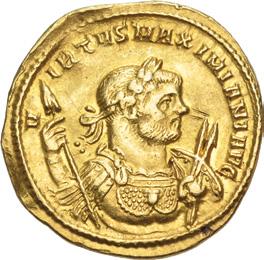

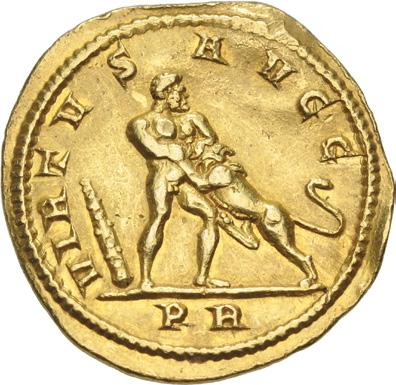
755. Maximianus. First reign, AD 286-305. AV Aureus (21mm, 5.01 g, 12h). Rome mint. Struck AD 287. V IRTVS MAXIMIANI AVG, laureate, draped, and cuirassed half-length bust right, holding hasta in right hand and two spicula in left; shield on left shoulder; gorgoneion aegis on cuirass / VIRTVS AVGG, Hercules, nude, standing right, strangling the Nemean lion to right with both hands; his club set on ground to left. RIC V 500; Depeyrot 4A/5 corr. (also without rev. legend break); Calicó 4733 (no illustration); Biaggi –; Mazzini –. Toned, marks, a pair of small digs. Good VF. Extremely rare. The fourth known. ($5000)
This extremely rare early pre-reform aureus featuring a magnificent martial bust of Maximianus is known from precious few specimens. The corpus of which is as follows:
1) BM 1900,1105.3 (same dies) [this coin also illustrated on pl. XII, 2 of Alföldi, Festival and in Ute Schillinger-Häfele, Consules • Augusti • Caesares. Datierung von römischen Inschriften und Münzen, pl. 7, 58].
2) Heritage NYINC Signature Sale 3071 (6 January 2019), lot 32234; Paul Tinchant Collection [“Richard J. Graham”] (J. Schulman, 4 June 1966), lot 2219; Ars Classica XVII (3 October 1934), lot 1834; 1922 Arras – Beaurains Hoard (no. 140).
3) The present specimen. Triton XXVIII, lot 755.
4) RIC V 500 = Cohen 591 = Caylus (1760) no. 1029 (illustrated from a line drawing of the reverse with the VIRTV S AVGG legend break).
The present coin was struck from the same dies as the BM coin, though from a later die state. These two coins feature an unbroken reverse legend whereas the Beaurains coin and the presumed Caylus specimen (whereabouts unknown) have a reverse legend break of V - S. Maximianus’ elaborate suit of armor and weaponry displayed on the obverse portrait of this remarkable aureus illustrate the revolution in Roman arms and tactics that had rescued the empire from destruction in the later third century AD. The Roman army had suffered numerous catastrophic defeats between AD 232 and 268, both to the rampant Sasanian Persians in the east and the Germanic tribes along the RhineDanube frontier, that had caused the Empire’s dismemberment and a death-spiral of usurpation and civil war. Starting with the Battle of Naissus in AD 268 or 269 under Gallienus or Claudius II (the historical record is oddly unclear for such an important event), the Roman army swiftly regained the initiative, enabled by a newfound tactical flexibility and a spate of technological innovations in armor and weaponry. On this aureus, Maximian wears a metal cuirass with a scaly adornment evoking the protective aegis of Athena. He carries a thrusting spear or hasta in his right hand; on his left shoulder he sports an oval cavalry shield, and in his left hand he clutches two lightweight javelins with barbed heads. This type of hand-thrown missile was called a spiculum and augmented or replaced the heavier pilum which had been a staple of Roman arms for more than four centuries. Roman soldiers also carried smaller fletched and weighted darts called plumbata clipped to their inside of their shields. Both infantry and cavalry also received archery training. Thus, on command, the Romans could fill the air with deadly missiles, forcing their enemies to duck and cover and softening them up for a decisive charge. Heavy cavalry also began to play a much greater tactical role than in previous centuries, serving as a kind of quick reaction force. The new emphasis was on speed, maneuverability, and striking power at a distance. These innovations are often credited to the era’s “Soldier Emperors” themselves, but they were surely the work of the larger professional officer class, many hailing from the Danubian provinces that had become the Empire’s prime recruiting grounds. The military reform movement gained momentum during the troubled reign of Gallienus (AD 253-268) and came into full fruition under his successors, Claudius II (AD 268-270), Aurelian (AD 270-275), and Probus (AD 276-282). By the early joint reign of Diocletian and Maximian, Rome’s enemies had been pushed back, its breakaway states restored to central rule, the Germanic raiders ejected, and the frontiers mostly secured, gaining the Empire a new centuries-long lease on life.


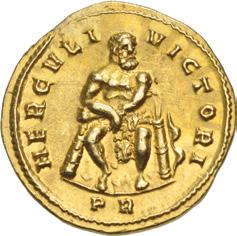
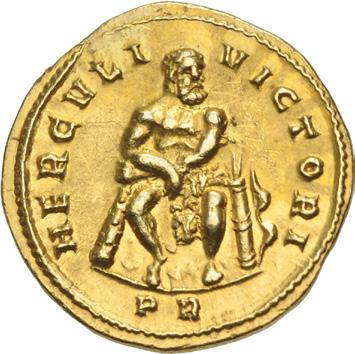
756. Maximianus. First reign, AD 286-305. AV Aureus (18.5mm, 5.04 g, 12h). Rome mint. Struck AD 293-294. MAXIMIA NVS P F AVG, laureate and cuirassed bust right / HERCVLI VICTORI, Hercules, nude, seated facing on rocks, head slightly right, holding lion skin draped across waist in left arm and resting right arm and left hand on club set on ground to left; to right, quiver with arrows and bow; PR. RIC VI –; Depeyrot 5B/6; Calicó 4681 (same dies as illustrated example); Biaggi 1793 (same dies); Mazzini –. Toned, with underlying luster, graffiti, hairlines on reverse. EF. Rare. ($7500)
Ex Gorny & Mosch 195 (7 March 2011), lot 483 (hammer €12,500); Rauch 85 (26 November 2009), lot 908; Rauch 83 (14 November 2008), lot 426; Leu 53 (21 October 1991), lot 329; Deceased Nobleman (Sotheby’s Zurich, 28 November 1986), lot 122.

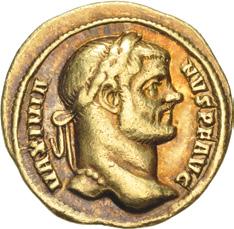


757. Maximianus. First reign, AD 286-305. AV Aureus (18.5mm, 5.20 g, 12h). Rome mint. Struck AD 294. MAXIMIA NVS P F AVG, laureate head right / VIRT VS AVG G, Hercules, nude, standing right, restraining the Ceryneian Hind, struggling to right, with his left knee placed upon its lowered hind quarters and grappling it by the antlers in both hands; his club resting on ground by his right foot; PR. RIC VI –; Depeyrot 6/11 (this coin cited); Calicó 4735a (this coin cited and illustrated); Beaurains 157 (this coin); Biaggi –; Mazzini –. Vibrant old collection toning. VF. Extremely rare. ($5000)
Ex Münz Zentrum 66 (26 April 1989), lot 1445 (illustrated on the cover); Münzen und Medaillen AG 44 (15 June 1971), lot 125; Conte Alessandro Magnaguti Collection (Part IV, Santamaria, 23 October 1950), lot 523; J. Schulman (17 May 1938), lot 1557; 1922 Arras –Beaurains Hoard.



758. Maximianus. First reign, AD 286-305. AV Aureus (18.5mm, 5.44 g, 12h). Rome mint. Struck AD 294. MAXIMIA NVS P F AVG, laureate head right / VIR TVS AVG G, Hercules, nude but for lion skin draped across left shoulder, standing right, grabbing the centaur Nessus by the hair with his left hand and brandishing club in right hand; Nessus struggling against Hercules to right; PROM. RIC VI –; Depeyrot 9/15; Calicó 4740 (this coin cited and illustrated); Adda 549 (this coin); Biaggi –; Mazzini –. Toned, a few faint marks. Near EF. Extremely rare. Only one cited by Depeyrot. This coin the second known. A wonderful reverse composition recounting Hercules’ battle with Nessus. ($10,000)
Ex Rauch 90 (4 June 2012), lot 883 (hammer €32,000); Gilbert Steinberg Collection (Numismatica Ars Classica, 16 November 1994), lot 752; Victor A. Adda (†1965) Collection (as Property of a Lady, Christie’s, 9 October 1984), lot 147, purchased from E. Bourgey; possibly 1922 Arras – Beaurains Hoard (not recorded in Bastien and Metzger; however, purchased from Bourgey [who owned a portion of the hoard] along with other aurei and multiples confirmed to be from Beaurains).
The first group from this outstanding collection appeared in Triton XXVII followed by highlight selections in CNG 126 and 127 as well as Electronic Auctions. This is a subsequent offering of coins from this very impressive collection of British issues which includes a plethora of outstanding examples and incredible rarities of the Romano-British usurpers Carausius and Allectus. These coins are almost exclusively extremely rare or very rare. Furthermore, many unique coins are being offered here as well. Consequently, headers denoting rarity have been forgone in this section. Classical Numismatic Group would once again like to extend our sincere thanks to Dr. Sam Moorhead for the updated forthcoming RIC V.5 reference numbers and rarity information for these coins.


759. Carausius. Romano-British Emperor, AD 286-293. Antoninianus (24.5mm, 3.29 g, 7h). Londinium (London) mint. IMP CARAVSIVS P F AVG, radiate and cuirassed bust right / MARS V LTOR, Mars, helmeted and wearing military attire, advancing right, holding transverse spear in right hand and shield on left arm; B|E//WLXXI. RIC V.5 2100 (forthcoming; this coin cited and illustrated); RIC V 89 (this coin cited; cites Webb); P. Webb, “The Reign and Coinage of Carausius” in NC 1907, 115 (this coin cited; cites Selborne); CHRB III, 20150 (this coin illustrated on pl. 7) = Lord Selborne, “On a Hoard of Roman Coins Found at Blackmoor, Hants” in NC 1877, p. 144, 75 and pl. I, 14 (this coin). Dark brown patina, light roughness. VF. Unique. The only example noted in RIC V.5. ($750)
From the Dr. Malcolm Lyne Collection, purchased from David Miller, 16 February 2012. Ex Blackmoor Hoard of Third Century Roman Bronze Coins (Christie’s, 9 December 1975), lot 204; Blackmoor, Selborne, October 1873 Hoard (IRBCH 914).
The ‘M’ in the usual MLXXI mint mark was accidentally inverted on the die that was used here. This coin is one of only twenty-four to be illustrated in Selborne’s original 1877 article with a line drawing out of the entire hoard of 29,802 coins.


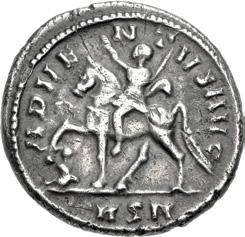
760. Carausius. Romano-British Emperor, AD 286-293. AR Denarius (20mm, 4.42 g, 12h). ‘RSR’ mint. IMP CARAVSIVS P F AVG, laureate, draped, and cuirassed bust right / ADVE N T VS AVG, Carausius, wearing military attire, on horseback riding left, raising right hand and holding transverse scepter in left; bound seated captive to lower left; RSR. RIC V.5 26 (forthcoming); RIC V 535; RSC 5; Shiel p. 99, 4. Toned, slight die wear, minor old scratches and marks. Good VF. Very rare. Eleven examples noted in RIC V.5. ($4000)
From the Dr. Malcolm Lyne Collection. Ex Numismatica Ars Classica 40 (16 May 2007), lot 835.

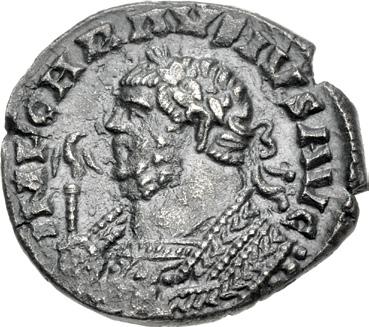

761. Carausius. Romano-British Emperor, AD 286-293. AR Denarius (19.5mm, 2.61 g, 12h). ‘RSR’ mint. IMP CARAVSIVS AVG, laureate and trabeate bust left, holding eagle-tipped scepter in right hand / CONCORDIA MI LITVM, Concordia, draped, standing right, holding long vertical scepter in left hand, clasping right hands with Carausius, wearing military attire, standing left, holding spear in left hand; RSR. RIC V.5 63 (forthcoming; this coin cited and illustrated); RIC V –; RSC –; Shiel –. Toned, find patina, slight roughness, minor area of weakness. VF. Unique. The only example noted in RIC V.5. ($3000)
From the Dr. Malcolm Lyne Collection, purchased from Spink, 15 February 2005.



762. Carausius. Romano-British Emperor, AD 286-293. AR Denarius (18mm, 4.24 g, 6h). ‘RSR’ mint. IMP CAR[AVSIVS P F] AV, laureate and draped bust right / EXPECTATE VENI, Britannia, draped, standing right, holding standard in left hand and clasping right hands with Carausius, wearing military attire and holding spear in left hand, standing left; RSR. RIC V.5 68 (forthcoming); RIC V 555; RSC 37; Shiel p. 105, 35. Toned, a few minor old marks and scratches under tone, die shift on obverse. Good VF. Very rare. Eleven examples noted in RIC V.5. The die shift causing the middle portion of the obverse legend to be somewhat blundered. ($3000)
From the Dr. Malcolm Lyne Collection, purchased from Baldwin’s 7 April 2003.
Carausius Invictus



763. Carausius. Romano-British Emperor, AD 286-293. AR Denarius (19mm, 3.35 g, 1h). ‘RSR’ mint. IMP CARAVS INVICTVS A, laureate and draped bust right / EXPECTATE V INI, Britannia, draped, standing right, holding standard in left hand and clasping right hands with Carausius standing left, holding scepter in left hand; RSR. RIC V.5 75 (forthcoming; this coin cited and illustrated); RIC V – but cf. 554 (for similar issue); RSC – but cf. 39 (same); Shiel – but cf. p. 104, 30 (same). Toned, light cleaning scratches. Good VF. Unique. The only example noted in RIC V.5. With a very interesting obverse legend. ($3000)
From the Dr. Malcolm Lyne Collection. Ex Áureo & Calicó 361 (18 February 2021), lot 167.


764. Carausius. Romano-British Emperor, AD 286-293. AR Denarius (19mm, 4.70 g, 6h). ‘RSR’ mint. IMP CARAVSIVS P F AVG, laureate, draped, and cuirassed bust right / ORIE NS AVG, Sol, radiate and nude but for chlamys draped over shoulders, standing slightly right, head left, raising right hand and holding globe in left; RSR. RIC V.5 107 (forthcoming); RIC V 570; RSC 74 (same dies as illustration); Shiel p. 110, 63-4 (same dies as illustrated examples on pl. K). Toned, porosity, light cleaning scratches, slightly off center on reverse. VF. Extremely rare. Only four examples noted in RIC V.5. An excellent example for this difficult issue. ($2500)
From the Dr. Malcolm Lyne Collection. Ex Gordon S. Parry Collection (Classical Numismatic Group 79, 17 September 2008), lot 1218; New York Sale I (3 December 1998), lot 350.
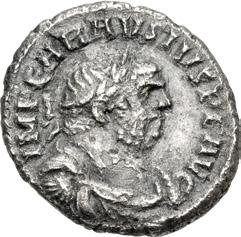


765. Carausius. Romano-British Emperor, AD 286-293. AR Denarius (18.5mm, 3.76 g, 6h). ‘RSR’ mint. IMP CARAVSIVS P E AVG, laureate, draped, and cuirassed bust right / ROMANO RENOVA, She-wolf standing right, head facing, suckling the twins (Romulus and Remus); RSR. RIC V.5 139 (forthcoming); RIC V 572; RSC 90; Shiel p. 113, 80 (same rev. die as illustration on pl. L). Toned, light roughness, cleaning scratches. VF. Extremely rare. Only two examples noted in RIC V.5. This coin shares a reverse die-link with an aureus in the Bibliothèque nationale (RIC V.5 6). ($2000)
From the Dr. Malcolm Lyne Collection, purchased from David Miller, 25 November 2011.


766. Carausius. Romano-British Emperor, AD 286-293. AR Denarius (17mm, 2.91 g, 12h). ‘RSR’ mint. [IMP] CARAVSIVS P F AVG, laureate, draped, and cuirassed bust right / TEMP ORVM FELICI[T], Felicitas, draped, standing left, holding long caduceus in right hand and cornucopia in left; RS[R]. RIC V.5 151 note (forthcoming; this coin cited and illustrated); RIC V –; RSC –; Shiel –. Lightly toned, scratches and marks, doubling on reverse, edge chipping. VF. Extremely rare reverse type. ($2000)
From the Dr. Malcolm Lyne Collection. Ex Dix Noonan Webb 143 (12 December 2017), lot 1666.



767. Carausius. Romano-British Emperor, AD 286-293. AR Denarius (19mm, 4.46 g, 6h). ‘RSR’ mint. IMP CARAVSIVS P F AVG, laureate and draped bust right / VIRT CARAVSI AVG, lion walking left, holding thunderbolt in its mouth; RSR. RIC V.5 166 (forthcoming); RIC V –; RSC –; Shiel –. Toned, minor marks and old scrape under tone. VF. Extremely rare. Only three examples noted in RIC V.5. ($5000)
From the Dr. Malcolm Lyne Collection. Ex Künker 312 (8 October 2018), lot 2991 (hammer €9,000).


768. Carausius. Romano-British Emperor, AD 286-293. Antoninianus (19.5mm, 3.86 g, 12h). ‘RSR’ mint. IMP CARAVSIVS P F AV, radiate, draped, and cuirassed bust right / ADVENTVS AVG, Carausius on horseback riding left, raising right hand and holding transverse scepter in left; RSR. RIC V.5 586 (forthcoming; this coin cited and illustrated); RIC V –. Dark green patina, light roughness and cleaning scratches. VF. Unique. The only example noted in RIC V.5. ($500)
From the Dr. Malcolm Lyne Collection. Ex Freeman & Sear MBS 8 (5 February 2003), lot 482.
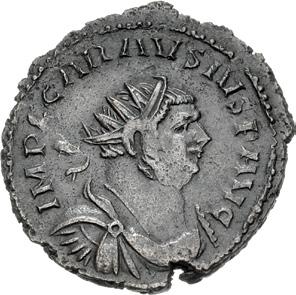


769. Carausius. Romano-British Emperor, AD 286-293. Antoninianus (24.5mm, 3.99 g, 6h). ‘C’ mint. IMP C CARAVSIVS P AVG, radiate, draped, and cuirassed bust right / CONSERVATOR AVG, Neptune seated left on rock, holding anchor set on ground to left in right hand and cradling trident in left arm; C. RIC V.5 2329 (forthcoming); cf. RIC V 214 (for similar issue). Dark brown patina, light roughness. Good VF. Extremely rare. Only three examples noted in RIC V.5. ($1000)
From the Dr. Malcolm Lyne Collection, purchased from David Miller, 16 February 2012.
Ex 1873 Blackmoor Hoard – First Published in NC 1877 – Illustrated in RIC V.5
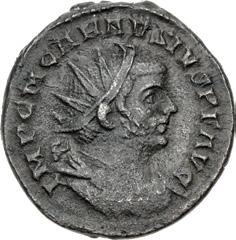


770. Carausius. Romano-British Emperor, AD 286-293. Antoninianus (19mm, 3.81 g, 6h). ‘C’ mint (?). IMP C M CARAVSIVS P F AVG, radiate and draped bust right / MONIT[A AVG] [sic], Moneta, draped, standing left, holding scales in extended right hand and cornucopia in left; QΓ (?) or C (?). RIC V.5 (2447) note (forthcoming; this coin, illustrated); RIC V 292 (this coin cited; cites Webb; attributed to the ‘C’ mint); P. Webb, “The Reign and Coinage of Carausius” in NC 1907, 343 (this coin cited; cites Selborne; attributed to the ‘C’ mint); CHRB III, 20305 corr. (mint mark and rev. legend; this coin; attributed to the uncertain mint) = Lord Selborne, “On a Hoard of Roman Coins Found at Blackmoor, Hants”, in NC 1877, p. 144, 80 (this coin; attributed to the London mint). Dark brown patina. VF. Unique. The only example noted in RIC V.5. Published first in the 1877 NC and subsequently in: NC 1907, RIC V 1933, CHRB III 1982, and in the forthcoming RIC V.5. ($750)
Ex Dr. Malcolm Lyne Collection, purchased from Spink, 15 October 2003; Blackmoor, Selborne, October 1873 Hoard (IRBCH 914).
This unique antoninianus of Carausius has caused catalogers over the last 150 years some difficulty to classify appropriately due to its enigmatic mint mark. From the desirable 1873 Blackmoor Hoard, which contained 545 coins of Carausius, this coin was among the few selected by Lord Selborne for publication in his NC 1877 article since the type was unpublished in the then recently released Volume VII of Cohen’s Monnaies Romaine (1868). There, Selborne read the mint mark as QL and consequently attributed the coin to the London mint. However, while a mint mark is present on the coin, it is difficult to read fully and appears most closely to an OΓ insofar as it is intelligible.
Appearing next in Percy Webb’s comprehensive Carausius catalog for the 1907 NC, the coin is there cataloged on page 200 as no. 343. Without further explanation, Webb placed the coin with the ‘C’ mint and simply cited Selborne while additionally providing the coin’s diameter. Webb repeated this cataloging for his portion of the old RIC V.2 in 1933.
The coin next appears in Roger Bland’s 1982 CHRB III. Norman Shiel provided the cataloging for the Carausius and Allectus portion of the catalog and he cataloged the coin on page 71 as no. 20305 alongside the “unmarked series.” However, while providing the full details for the coin, makes no mention of the letters in the exergue. He places the coin next to 20305A which is Selborne’s Blackmoor Hoard no. 79 which features the same reverse legend error of MONITA for MONETA as the present coin. Since the 20305A coin does belong to the unmarked series, this makes logical sense, however, Shiel does err in failing to note the exergue letters on the present specimen.
Consequently, this same coin has been cataloged at three different mints by the respective authors of the reference material and authorities on the subject: Selborne at London, Webb at the ‘C’ mint, and Shiel at the unmarked British mint. Where to most accurately catalog the coin today is somewhat a matter of perspective. Bringing the coin up to date, Dr. Moorhead has elected to footnote the coin next to the retrograde ‘C’ mint MONETA issues in the forthcoming RIC V.5. Though Dr. Moorhead’s no. 2447 is in parentheses to denote that the coin is unclear.
While this specific coin has caused catalogers some consternation over the last century and a half, this phenomenon is simply reflective of the reality and challenges of cataloging the fascinating coinage of the British usurper Carausius as a whole. While Carausius’ intricate and complex monetary policy is much better understood now than it was in the latter half of the 19th century, there are simply going to be some coins that are more difficult to attribute with high confidence. Dr. Moorhead’s Roman Imperial Coinage V.5 will provide a wealth of information on the subject and is highly anticipated. As for this coin, it features an outstanding pedigree to 1873, has been published five times, is illustrated in the forthcoming RIC V.5, and is unique.



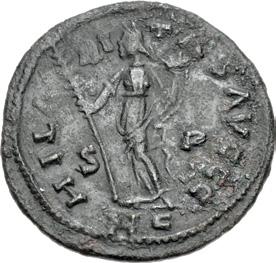
771. Carausius. Romano-British Emperor, AD 286-293. Antoninianus (23mm, 3.79 g, 6h). ‘C’ mint. IMP C CARAVSIVS P AVG, radiate and draped bust right / ADVENTVS AVG, Carausius on horseback riding left, raising right hand and holding transverse scepter in left; to lower left, bound captive seated left, head right; SCC. RIC V.5 2979 (forthcoming); cf. RIC V 190 (for reverse type). Dark green patina with some toned residual silvering, slight roughness, faint scratches, minor die wear on obverse. Good VF. Extremely rare. Only two examples noted in RIC V.5. The reverse well struck. ($500)
From the Dr. Malcolm Lyne Collection, purchased from Spink, 3 July 2006.
772. Carausius. Romano-British Emperor, AD 286-293. Antoninianus (21.5mm, 4.02 g, 6h). ‘C’ mint. IMP C CARAVSIVS P AVG, radiate, draped, and cuirassed bust right / HILA RI TAS AVGGG, Hilaritas standing left, draped, holding long palm frond in right hand and cornucopia in left; S|P//MC. RIC V.5 3215 (forthcoming); RIC V –; Bourne 163. Dark green-brown patina with some red, minor roughness and cleaning scratches. VF. Extremely rare. Only four examples noted in RIC V.5. Bourne cited one example in the British Museum (1983,0335.2; same dies). ($500)
From the Dr. Malcolm Lyne Collection, purchased from Spink, 13 September 2002.


773. Carausius. Romano-British Emperor, AD 286-293. Antoninianus (22.5mm, 3.99 g, 6h). ‘C’ mint. IMP C CARAVSIVS AVG, radiate, draped, and cuirassed / VIRTV S AVGGG, Virtus standing right, nude but for helmet and chlamys draped over shoulders, holding reversed spear in right hand and resting left hand on shield set on ground to right; S|P//MC. RIC V.5 3232 (forthcoming); RIC V –; Bourne –. Dark green patina with some brown, light roughness. Good VF. Extremely rare. Only two examples noted in RIC V.5. Formerly unlisted with this mint mark in the old RIC V and as recently as Bourne (2009). ($500)
From the Dr. Malcolm Lyne Collection, purchased from Baldwin’s, 26 September 2002.



774. Carausius. Romano-British Emperor, AD 286-293. AR Denarius (18mm, 2.70 g, 1h). Uncertain mint. INP CARAV[SIV]S P A, laureate, draped, and cuirassed bust right / [...]INIVS AG [sic], Carausius on horseback riding left, wearing military attire, raising right hand and holding scepter in left, trampling captive with hands bound behind his back below. RIC V.5 223 (forthcoming; this coin cited and illustrated); RIC V –; RSC –; Shiel –. Toned, marks, residual find patina. Good VF. Unique. The only example noted in RIC V.5. The reverse appears to be an ADVENTVS AVG derivative. ($3000)
From the Dr. Malcolm Lyne Collection. Ex Timeline Auctions (14 March 2013), lot 74.


775. Carausius. Romano-British Emperor, AD 286-293. AR Denarius (18.5mm, 2.13 g, 6h). Uncertain mint. IMP CARAVSIVS P F AVG, laureate, draped, and cuirassed bust right / I II O CARAVSIIO II II, Uncertain figure, draped, standing left, dropping incense into lighted altar set on ground to left with right hand. RIC V.5 247 (forthcoming; this coin cited and illustrated); RIC V –; RSC –; Shiel –. Toned, find patina, striking fractures, cleaning scratches. Near VF. Unique. The only example noted in RIC V.5. ($750)
From the Dr. Malcolm Lyne Collection. Ex Dr. J. S. Vogelaar Collection (Spink London 194, 26 March 2008), lot 1151; reportedly found in Norfolk.


776. Carausius. Romano-British Emperor, AD 286-293. Æ Denarius (19.5mm, 2.85 g, 6h). Uncertain mint. IMP [C] ARAVSIVS P F A, laureate, draped, and cuirassed bust right / F OR TVNA V, Fortuna, draped, standing left, holding scales in extended right hand and cornucopia in left. RIC V.5 317 (forthcoming; this coin cited and illustrated); RIC V –; RSC –; Shiel –. Dark find patina, light roughness. Good Fine. Unique. The only example noted in RIC V.5. ($750)
From the Dr. Malcolm Lyne Collection. Ex Dix Noonan Webb 146 (25 April 2018), lot 48, purchased from Baldwin’s, October 1971. Ex 1873 Blackmoor Hoard – Published in RIC and NC




777. Carausius. Romano-British Emperor, AD 286-293. Antoninianus (19.5mm, 2.94 g, 9h). Uncertain mint. IMP [...] VSIVS P F AV, radiate, draped, and cuirassed bust right / [A]DVEN T VS, Carausius on horseback riding left, raising right hand and holding transverse scepter in left, trampling captive with hands bound behind his back below to left; thunderbolt in exergue. RIC V.5 747 (forthcoming; this coin cited and illustrated); RIC V 1075 (this coin cited; cites Selborne); P. Webb, “The Reign and Coinage of Carausius” in NC 1907, 1210 (this coin cited; cites Selborne); CHRB III, 20263 (this coin, illustrated on pl. 8); Malcolm Lyne, “Some New Coin Types of Carausius and Allectus and the History of the British Provinces: AD 286-296” in NC 2003, p. 159 and pl. 27, 19 (this coin). Dark green-brown patina. VF. Unique. Overstruck on an INVICTVS type of Victorinus. The thunderbolt misdescribed by Webb and the authors of RIC but correctly identified and confirmed to be the same coin by Bland and Shiel in CHRB. Perhaps belonging to a continental mint, attributed by some to Rotomagus (Rouen). ($750)
From the Dr. Malcolm Lyne Collection, purchased from Spink, 15 February 2002. Ex Blackmoor Hoard of Third Century Roman Bronze Coins (Christie’s, 9 December 1975), lot 251; Blackmoor, Selborne, October 1873 Hoard (IRBCH 914).


778. Carausius. Romano-British Emperor, AD 286-293. Antoninianus (20.5mm, 2.57 g, 3h). Uncertain mint. IMP CARAVSIVS P F AVG, radiate and draped bust right / MO[N]ET[...], Moneta standing left, draped, holding scales in right hand and cornucopia in left. Cf. RIC V.5 1171 (forthcoming). cf. RIC V 855. Dark green-brown patina. Near VF. Overstruck on a LAETITIA (holding wreath and rudder set on globe) issue of Claudius II Gothicus with large parts of the undertype visible on both obverse and reverse. ($500)
From the Dr. Malcolm Lyne Collection, purchased from David Miller, 10 June 2018.

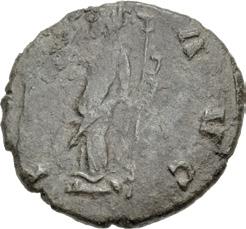
779. Carausius. Romano-British Emperor, AD 286-293. Antoninianus (19mm, 4.08 g, 6h). Uncertain mint. VIC TORIA CARAVSI A, radiate and cuirassed bust right, holding spear over right shoulder in right hand / PA X AVG, Pax, draped, standing left, holding olive branch and vertical scepter. RIC V.5 1273 (forthcoming); RIC V – but cf. 786 (cites Webb; for same obv. die); P. Webb, “The Reign and Coinage of Carausius” in NC 1907, 883 (cites Selborne; same); cf. CHRB III, 20281 (same) = Blackmoor Hoard of Third Century Roman Bronze Coins (Christie’s, 9 December 1975), lot 262 corr. (obv. legend; same); cf. CNG 457, 445 (same); cf. R. Bourne, “Opuscula carausiana,” in Yorkshire Numismatist 4 (2012), pp. 1-3, no. 1-5 (same). Greenbrown patina, light roughness. VF. Extremely rare issue from a very rare obverse die. Only four examples noted in RIC V.5. ($500)
From the Dr. Malcolm Lyne Collection, purchased from David Miller, 29 March 2011.
A very rare obverse legend, known from very few examples from the same obverse die. Bourne knew of five coins in his 2012 article that share this obverse die across three types: Laetitia (2), Fortuna (2), and CONCOR MIL AETERN(?) (1). The CNG Electronic Auction 457 example in 2019 added one additional specimen to the Fortuna reverses. Additionally, the CNG 571, 1153 example may add a Virtus reverse. There are finally four examples noted in RIC V.5 (including this coin) with the Pax reverse (another being CNG 571, 1151 correction). Thus the number of reverse types rises to four or five and the corpus of known examples from this very rare and desirable obverse legend stands at approximately eleven examples.

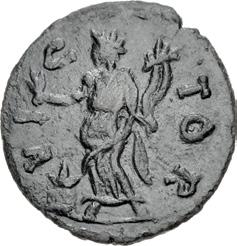

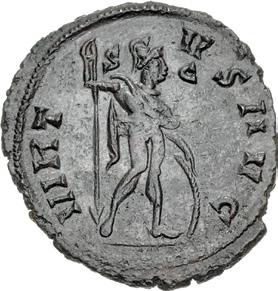
780. Carausius. Romano-British Emperor, AD 286-293. Antoninianus (18.5mm, 2.67 g, 12h). Uncertain mint. IMP CARAVSIVS P F G, radiate, draped, and cuirassed bust right / VI C TOR, Uncertain figure standing left, draped, holding flower in outstretched right hand and cornucopia in left, lighted altar at feet to left. RIC V.5 1667 (forthcoming; this coin cited and illustrated); RIC V –. Glossy black patina. VF. Unique. The only example noted in RIC V.5. Interesting with these legends and with the retrograde S’s. Similar to CNG 575, lot 677. ($500)
From the Dr. Malcolm Lyne Collection, purchased from David Miller, 23 July 2013.
781. Carausius. Romano-British Emperor, AD 286-293. Antoninianus (22.5mm, 4.31 g, 6h). Uncertain mint. IMP C CARAVSIVS P AVG, radiate, draped, and cuirassed bust right / VIRT VS AVG, Virtus standing right, nude but for helmet and chlamys draped over shoulders, holding reversed spear in right hand and resting left hand on shield set on ground to right; S|C//–. RIC V.5 3471 (forthcoming); RIC V 529 var. (obv. legend). Dark brown patina, faint cleaning scratches. Near EF. Extremely rare. Only five examples noted in RIC V.5. ($500)
From the Dr. Malcolm Lyne Collection, purchased from Spink, 3 July 2006.

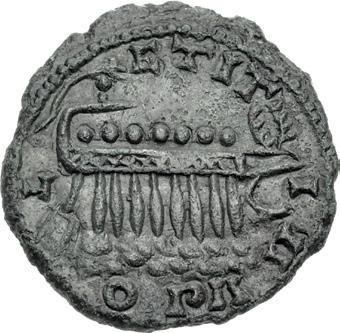

782. Carausius. Romano-British Emperor, AD 286-293. Antoninianus (17.5mm, 2.85 g, 6h). Rotomagus (Rouen) mint. IMP C CARAVSIVS AVG, radiate, draped, and cuirassed bust right / L ETIT I A, galley right with gubernator and seven rowers; wreath on prow; waves below; OPA. RIC V.5 368 (forthcoming; this coin cited and illustrated); cf. RIC V 648-9 (for similar issues; same rev. die as illustrated example of 648); Malcolm Lyne, “Some New Coin Types of Carausius and Allectus and the History of the British Provinces: AD 286-296” in NC2003, p. 158 and pl. 26, 13 corr. (rev. legend; this coin). Attractive dark green patina, light roughness and cleaning scratches. Near EF. Unique. The only example noted in RIC V.5. Webb and Lyne both misread an additional A in the reverse legend - as in - LAETITIA rather than LETITIA. There is no initial A, however, as is evidenced by this very high grade example.. ($750)
From the Dr. Malcolm Lyne Collection. Ex Spink Numismatic Circular CVIII (June 2000), no. 2280. 780


783. Carausius. Romano-British Emperor, AD 286-293. Antoninianus (19.5mm, 2.56 g, 11h). Rotomagus (Rouen) mint. IMP C CARAVSIVS AVG, radiate and draped bust right / SALV S AVG, Salus, draped, standing left, dropping incense into lighted altar set on ground to left with right hand and holding [cornucopia] in left. RIC V.5 432 (forthcoming; this coin cited and illustrated); RIC V –; CHRB III, 20261 (this coin, illustrated on pl. 8); Malcolm Lyne, “Some New Coin Types of Carausius and Allectus and the History of the British Provinces: AD 286-296” in NC 2003, p. 159 and pl. 27, 18 (this coin); Lord Selborne, “On a Hoard of Roman Coins Found at Blackmoor, Hants,” in NC 1877, p. 150, 125 (this coin). Dark olive green-brown patina, hard green deposits, countermarked. VF. Overstruck on an uncertain earlier Antoninianus. ‘P’ countermark applied later over the issue of Carausius. See Dr. Lyne’s article for further discussion. Unique. The only example noted in RIC V.5. ($500)
From the Dr. Malcolm Lyne Collection. Ex Spink Numismatic Circular CVIII (June 2000), no. 2282; Blackmoor Hoard of Third Century Roman Bronze Coins (Christie’s, 9 December 1975), lot 249; Blackmoor, Selborne, October 1873 Hoard (IRBCH 914).


784. Allectus. Romano-British Emperor, AD 293-296. PB Antoninianus Trial Strike (28x39mm, 34.74 g). IMP C ALLECTVS P F AVG, radiate, draped, and cuirassed bust right / Blank. Tan and dark brown surfaces, fractures in metal. VF. A very interesting and incredibly rare item. The diameter of the antoninianus 18mm. ($1500)
From the Dr. Malcolm Lyne Collection. Ex Roma E-Sale 21 (31 October 2015), lot 864 (hammer £2,400), reportedly found in County Durham.
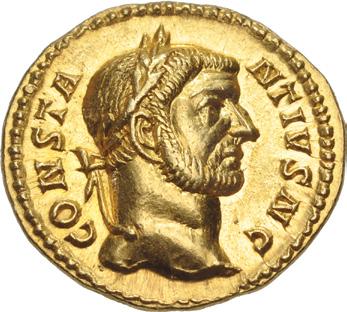



785. Constantius I. As Caesar, AD 293-305. AV Aureus (18.5mm, 5.13 g, 6h). Treveri (Trier) mint. 2nd emission, early AD 294. CONSTA NTIVS N C, laureate head right / VIRTVS AVG•G•, Hercules, nude, standing right, restraining the Ceryneian Hind, struggling to right, with his left knee placed upon its lowered hind quarters and grappling it by the antlers in both hands; TR. RIC VI 85; Zanchi & Estiot 33a (CCL 8/R 14 – this coin); Depeyrot 3A/3; Calicó 4878 (illustrated from a line drawing). Lustrous, light edge bump. Superb EF. Extremely rare. The finest of the five known. ($10,000)
Ex Peus 355 (27 April 1998), lot 1045A.
Flavius Valerius Constantius was a native of Naissus in modern Serbia. He found escape from his low social standing in the Roman army and rose steadily through the ranks. Along the way, he took a local barmaid named Helena as his common-law wife and she bore him a son, Constantine, probably in AD 273 or 274. By AD 284, Constantius had been made military governor of Dalmatia. He supported Diocletian’s bid for power and was rewarded with a series of important posts in the new regime. In March of AD 293, Diocletian and Maximian appointed him Caesar of the West and charged him with restoring Britain and northern Gaul, then under the separatist rule of the usurper Carausius, to Roman control. Constantius spent three years in careful preparations and launched his invasion in mid-AD 296, achieving complete surprise and total victory. He won the reputation of a just and compassionate ruler during his years as Caesar. With Diocletian’s retirement in AD 305, Constantius became Augustus of the West and technically the senior ruler, but Galerius was clearly dominant. Constantius even had to request that Galerius release his son Constantine from serving in the eastern court so that the young officer could assist in an upcomming British campaign. The two were reunited in early 306 and campaigned jointly against the Picts, winning Constantius the title “Britannicus Maximus.” But Constantius fell seriously ill that summer and died on July 25. The army immediately acclaimed Constantine as Emperor, launching the career of one of Rome’s greatest rulers.
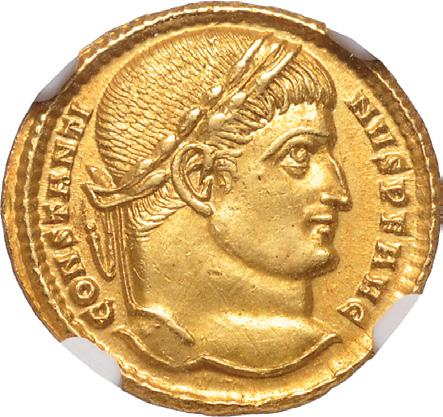



786. Constantine I. AD 307/310-337. AV Solidus (18mm, 4.33 g, 12h). Ticinum mint. Struck AD 315. CONSTANTI NVS P F AVG, laureate head right / VIRTVS AVGVSTI N, Constantine, wearing military attire and paludamentum billowing behind him, on horseback galloping right, raising right hand and holding shield on left arm; three enemies impaled with spears strewn about below; SMT. RIC VII 35; Depeyrot 12/12; Biaggi –; Mazzini –. Toned. In NGC encapsulation 2113106062, graded Ch AU★, Strike: 5/5, Surface: 4/5. Extremely rare. One of two known, this coin the far superior example. The Laffranchi Collection example, cited in RIC, is the other, which is also the example sold by Rollin & Feuardent in 1909. A wonderful reverse composition. ($15,000)
Ex MDC Monaco 11 (21 April 2023), lot 402; Nomisma S.p.a. 34 (28 April 2007), lot 372; Giessener Münzhandlung 48 (2 April 1990), lot 961.



787. Constantine I. AD 307/310-337. AV Solidus (21mm, 4.52 g, 12h). Nicomedia mint, 2nd officina. Struck AD 335. Rosette-diademed head right, eyes to God / VICTORIA CONSTANTINI AVG, Victory, draped at waist, seated right on cuirass, supporting shield set on left knee with left hand and inscribing VOT/ XXX on it in two lines with stylus held in right hand; to right, small nude genius standing left supporting the shield with both hands; an additional shield resting beside the cuirass to left; SMNC. RIC VII 175; Depeyrot 44/1; Biaggi 2025 var. (officina); Mazzini 617. Toned, slightly wavy flan, minor marks and edge marks, faint hairlines. Near EF. Rare. ($5000)
From the Ramrodivs Collection. Ex Harlan J. Berk inventory cc77864 (24 October 2012); Classical Numismatic Auctions XX (25 March 1992), lot 902.



788. Magnentius. AD 350-353. AV Solidus (21.5mm, 4.63 g, 6h). Treveri (Trier) mint. 1st emission, 18 January-27 February AD 350. IM CAE MAGN ENTIVS AVG, bareheaded, draped, and cuirassed bust right / VICTORIA ‘ AVG ‘ LIB ‘ ROMANOR, Victory, draped, cradling palm frond in left arm, standing right, and Libertas, draped, holding transverse vindicta in left hand, standing left, both draped and together holding a trophy set on long staff between them with their right hands; TR. RIC VIII 247; Bastien 7; Depeyrot 8/1; Biaggi 2197; Mazzini 46v. Toned, with some luster, minor scratches and marks. Good VF. ($3000)
From the Ramrodivs Collection. Ex Berk BBS 185 (9 July 2013), lot 32.
Born around A.D. 303 to a British father and Frankish mother, Flavius Magnus Magnentius showed enough talent to rise high in the Roman army. In the 340s, the western emperor Constans appointed Magnentius as commander in his personal guard. Whatever Magnentius’ merits, gratitude was not among them, for in January AD 350, he staged a successful coup deposing his benefactor. Constans, who had made himself unpopular with the army, attempted to flee to his brother Constantius II, emperor of the East, but was captured and executed. After securing control of Italy, Magnentius attempted to negotiate with Constantius, but the eastern emperor would hear none of it. Taking a year to marshal his forces, Constantius struck in the summer of AD 351, but Magnentius defeated his initial thrust into Italy and went on the offensive, seizing the strategic town of Siscia and forcing a major engagement in the Balkans. The clash at Mursa on September 28, AD 351 proved one of the costliest battles in Roman history, leaving the ground strewn with 55,000 dead. Magnentius fared much the worse and retreated into Gaul. Constantius took his time in pursuit, invading Italy the following year and methodically tightening the noose around Magentius, who was forced to take refuge in the city of Lugdunum. Rather than surrender, Magnentius fell on his sword in August of AD 353. Although a usurper, Magentius had a long-lasting impact on the Roman Empire through the agency of his young widow, Justina, who later married Valentinian I and became a lynchpin in future dynastic politics.


789. Vetranio. AD 350. AR Siliqua (19mm, 3.16 g, 12h). Siscia mint. D N VETRA NIO P F AVG, laureate, draped, and cuirassed bust right / VICTORIA AVGVSTORVM, Victory, draped, advancing left, holding palm frond in right hand and trophy over left shoulder in left hand; SISe. RIC VIII 265; RSC 9a. Toned, flan crack, minor scratches. Near EF. Very rare. An excellent siliqua. ($1000)




790. Julian II. AD 360-363. AV Solidus (20.5mm, 4.19 g, 6h). Sirmium mint. Struck AD 361-363. FL CL IVLIA NVS PP AVG, pearl-diademed, draped, and cuirassed bust right / VIRTVS EXERCI TVS ROMANORVM, soldier, helmeted and wearing military attire, advancing right, head left, holding trophy over left shoulder in left hand and dragging kneeling captive to left by the hair with right hand; dSIRM դ . RIC VIII 96; Depeyrot 21/1; Biaggi 2219; Mazzini 78. Toned, minor spot of die rust on obverse, edge filing. EF. Struck from detailed dies. ($10,000)
Ex Collection of a Perfectionist (Leu 93, 10 May 2005), lot 144; Tkalec (23 October 1992), lot 497.
Julian II, also known as the Apostate, Philosopher, or Hellene, ranks as one of the more controversial Roman emperors, as his attempt to stand against the rising tide of Christianity makes him a villain to some and a hero to others. On the numismatic front, his adoption of a long “philosopher’s beard” on his coin portraits was an innovation that had not been seen for more than a century. It struck his subjects as a quaint affectation and was ridiculed by some, to which Julian responded with a satyrical pamphlet called Misopogon, or “Beard Hater,” while in residence at Antioch.



791. Arcadius. AD 383-408. AV Solidus (20.5mm, 4.47 g, 6h). Constantinople mint, 10th officina. Struck AD 397-402. D N ARCADI VS P F AVG, pearl-diademed, helmeted, and cuirassed bust facing slightly right, holding spear over shoulder in right hand and shield decorated with horseman motif on left shoulder / CONCORDI A AVGG, Constantinopolis, helmeted and draped, enthroned facing, head right, right foot on prow, holding long scepter in right hand and, in left hand, holding Victory on globe left who holds wreath in extended left hand and palm frond in right arm; I//CONOB. RIC X 7; Depeyrot 55/1; Biaggi –; Mazzini –. Toned, with some luster, marks, trace die rust on obverse. EF. ($1000)
From the Michael Rogal Collection. Ex Triton XXVI (10 January 2023), lot 869.



792. Arcadius. AD 383-408. AV Solidus (19.5mm, 4.45 g, 6h). Constantinople mint. Struck AD 402. D N ARCADI VS P F AVG, pearl-diademed, helmeted, and cuirassed bust facing slightly right, holding spear over right shoulder in right hand and shield decorated with horseman motif on left shoulder / NOVA SPES REIPVBLICAE, Victory, draped at waist, seated right on cuirass, supporting shield set on left knee with left hand and inscribing XX/ XXX in two lines on it with stylus held in right hand; CONOB. RIC X 23; Depeyrot 54/1; Biaggi –; Mazzini –. Toned. In NGC encapsulation 6708929-014, graded MS, Strike: 5/5, Surface: 4/5, light marks. From a very scarce one-year issue. ($1000)
Ex Dr. Michael Rogers Collection (Part III, Stack’s Bowers Galleries, 14 August 2023), lot 50164; A North American Collection (Triton XI, 8 January 2008), lot 1021; William H. Williams Collection (Triton VI, 14 January 2003), lot 1127.


793. Honorius. AD 393-423. AV Solidus (20.5mm, 4.48 g, 6h). Constantinople mint. Struck AD 395-402. D N HONORI VS P F AVG, pearl-diademed, helmeted, and cuirassed bust facing slightly right, holding spear over right shoulder in right hand and shield decorated with horseman motif on left shoulder / CONCORDI A AVGG, Constantinopolis, helmeted and draped, enthroned facing, head right, right foot on prow, holding scepter in right hand and, in left hand, holding Victory on globe left who holds wreath in extended right hand and palm frond in left arm; CONOB. RIC X 8; Depeyrot 55/2; Biaggi –; Mazzini 3 var. (officina). Toned. In NGC encapsulation 6708929-006, graded Ch AU, Strike: 5/5, Surface: 4/5. Very rare without officina letter. ($1000)
Ex Dr. Michael Rogers Collection (Part III, Stack’s Bowers Galleries, 14 August 2023), lot 50166; Triton XI (8 January 2008), lot 1031.



794. Contorniates. Late 4th century AD. Æ Contorniate (35mm, 28.16 g, 12h). Bust of Omphale left, wearing Hercules’ lion skin, resting club on raised right arm / Hercules, nude, standing right, restraining the centaur Nessus with his left knee placed upon Nessus’ lowered hind quarters and grabbing him by the hair with his left hand while brandishing club in right hand; Nessus struggling against Hercules to right with his left hand raised; tree to left. Cf. Alföldi, Kontorniat pp. 86-7, 66 and pl. 23, 9-11 (for type and similar Omphale obverses) and pl. 19, 3 (for similar reverse). Dark brown surfaces with some green and red, scratches, tooling on obverse. Good VF. Extremely rare. A wonderful pairing with an equally interesting obverse and reverse composition. ($3000)
Ex Numismatica Ars Classica 100 (29 May 2017), lot 726 (hammer CHF 7,500 – there Omphale misidentified as Hercules).

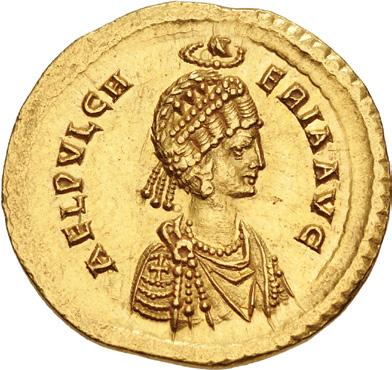

795. Aelia Pulcheria. Augusta, AD 414-453. AV Solidus (21.5mm, 4.49 g, 12h). Constantinople mint, 2nd officina. Struck under Theodosius II, AD 422-423. AEL PVLCH ERIA AVG, pearl-diademed and draped bust right, wearing earring and necklace; being crowned by manus Dei above / VOT XX MVLT XXX, Victory, draped, standing left, holding long jeweled cross in right hand and fold of drapery in left; B//CONOB. RIC X 220; Depeyrot 74/3; Biaggi –; Mazzini –. Toned and lustrous, light circular marks, a couple of thin die breaks on reverse. Superb EF. Very rare issue. Extremely rare from this officina. An incredibly early and vibrant strike with parts of the die engraver’s centering circles still visible on both the obverse and reverse. ($5000)
The sister of Emperor Theodosius II, Aelia Pulcheria, was a major force in the life of the young emperor. Governing him as a young man until he came of age, Pulcheria prepared the emperor for his duties and served as a constant guiding voice and counselor to him. Present throughout his accomplishments and major events, Pulcheria eventually emerged the victor in the rivalry that developed between her and her brother’s wife, Aelia Eudocia, who was consequently dismissed from court. While she was a teenager, Pulcheria took a vow of virginity which she maintained until her death. This dedication to God inspired some of Theodosius’ imperial propaganda during wars with the Sasanian Persians, and the Romans considered Pulcheria’s pious dedication of her virginity to be a source of blessing upon the Empire from God. Theodosius died unexpectedly after being mortally injured during a hunting accident in AD 450. Upon his death, Pulcheria was tasked with appointing his successor. She chose a man of Roman stock, though not of nobility, named Marcian. She married the new emperor on the condition that he not make her violate her vow of virginity, to which Marcian agreed. This unconventional marriage was made possible by church officials, who sponsored the agreement and decreed that God approved of the union and arrangement.



796. Jovinus. Usurper, AD 411-413. AR Siliqua (15.5mm, 1.46 g, 6h). Treveri (Trier) mint. D N IOVIN VS P F AVG, pearl-diademed, draped, and cuirassed bust right / VICTORI A AVGG, Roma seated left on stylized cuirass, holding Victory on globe right in right hand and reversed spear in left; Victory holding wreath in right hand; TRMS. RIC X 1710; King, Fifth, cuirass style 15; RSC 4†a. Toned, with some iridescence, struck slightly off center, flan crack, light porosity, residual find patina and light cleaning scratches. VF. Rare. ($750)
Ex Heritage Europe 60 (17 November 2018), lot 2996.



797. Galla Placidia. Augusta, AD 421-450. AV Solidus (21.5mm, 4.46 g, 6h). Constantinople mint, 10th officina. Struck under Theodosius II and Valentinian III, AD 423-425. AEL PLACI DIA AVG, pearl-diademed and draped bust right, wearing earring and necklace; being crowned by manus Dei above / VOT XX MVLT XXX, Victory, draped, standing left, holding long jeweled cross in right hand and fold of drapery in left; d in upper left field; I//CONOB. RIC X 230; Depeyrot 75/4; Biaggi –; Mazzini –. Toned, slight doubling, spot of die rust on obverse. Near EF. Extremely rare from this officina, with fewer than twenty known of all. An excellent example for this very difficult issue. ($5000)
Galla Placidia, daughter of Theodosius I, was born in AD 392. Following the siege of Rome in 408-410, the princess was captured by Visigothic armies under Alaric and his successor Ataulf, whom she later married. This marriage failed to produce the intended Romano-Gothic dynasty, as Ataulf was murdered after only a short time in power. By 416 Galla had been restored to the Roman court in the west.
Galla continued to be involved in court politics and, in 417, married Constantius III, then magister militum. She bore a son, the future Valentinian III. Unfortunately, her husband’s reign as co-emperor with Honorius was cut short by his untimely death. For a time, the widow remained on friendly terms with the emperor, but by 423, Galla and her son had fled to Constantinople and the court of Theodosius II. She would return to the Italian peninsula at the head of a large army in 424 to overthrow Johannes, who had been raised to the purple following the death of Honorius, after which Galla ruled in the west as regent to her son, Emperor Valentinian III.
Despite her major role in the political affairs of the early 5th century, Galla’s true passion was for the Church. She tolerated neither heretics nor non-believers in her government and was involved in the construction of numerous churches and chapels. Among these works was the San Giovanni Evangelista in Ravenna, built in fulfillment of a vow made when Galla and her children were caught in a storm on the Adriatic during their flight from Italy. Galla Placidia died in AD 450, her mausoleum is now a UNESCO World Heritage Site.


798. Valentinian III. AD 425-455. AV Solidus (21mm, 4.47 g, 6h). Constantinople mint, 9th officina. Struck AD 430440. D N VALENTIN IANVS P F AVG, pearl-diademed, helmeted, and cuirassed bust facing slightly right, holding spear over right shoulder in right hand and shield decorated with horseman motif on left shoulder / VOT XXX MVLT XXXX, Constantinopolis, helmeted and draped, seated left, right foot on prow, holding globus cruciger in right hand and transverse scepter in left; shield beside throne to right; d to right; Θ//CONOB. RIC X 260; Depeyrot 81/2; Biaggi –; Mazzini –. Toned, with some luster, a couple minor marks at edge, light hairlines on obverse. EF. Very rare. ($750)
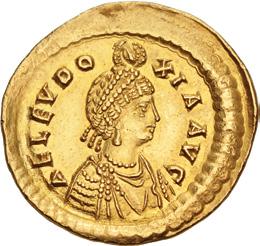


799. Licinia Eudoxia. Augusta, circa AD 439-490. AV Solidus (21.5mm, 4.48 g, 6h). Constantinople mint. Struck under Theodosius II and Valentinian III, AD 439-440. AEL EVDO XIA AVG, pearl-diademed and draped bust right, wearing earring and necklace; being crowned by manus Dei above / IMP • XXXXII • COS XVII • P • P •, Constantinopolis, helmeted and draped, seated left, holding globus cruciger in extended right hand and transverse scepter in left, right foot on prow; d to left; shield beside throne to right; COMOB. RIC X 306; Depeyrot 84/5; Biaggi –; Mazzini –. Attractively toned, slight doubling. EF. Very rare. A particularly high grade example. ($5000)
Licinia Eudoxia was the only surviving child of the Eastern Roman Emperor Theodosius II, and in 424 AD, at the age of two, was betrothed to her four-year-old cousin, the future Emperor of the Western Roman Empire Valentinian III, in order to reunify the two halves of the Roman world. Their marriage produced two daughters but was abruptly terminated when Valentinian was killed by two Scythians, Optelas and Thraustelas, at the behest of the usurper Petronius Maximus. After buying off the military and palace officials, Maximus cemented his claim to the throne by forcibly marrying Eudoxia only a few days after her husband’s murder. At least one historian theorized that Maximus’ marriage to Eudoxia was motivated by revenge against the late Valentinian in return for the Emperor’s rape of Maximus’ first wife. Maximus also married his son Palladius to Eudoxia and Valentinian’s daughter Eudocia, thereby severing her engagement to Huneric, the son of the Vandal king Gaiseric.
Deeply unhappy, Eudoxia somehow managed to contact Gaiseric to beseech him to depose Maximus. The Vandals successfully besieged Rome and carried Eudoxia off to Carthage, along with her daughters; Maximus perished amidst the siege and his body thrown into the Tiber. In 462 AD, after seven years in Carthage, Eudoxia and her daughter Placidia were ransomed by Leo I and moved to Constantinople, while Eudocia remained in Carthage and married Huneric as her parents had originally intended. The rest of Eudoxia’s life passed unrecorded; even her exact date of death is unknown.

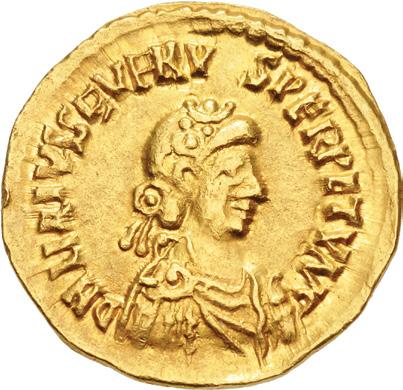

800. Libius Severus (Severus III). AD 461-465. AV Solidus (21.5mm, 4.42 g, 12h). Mediolanum (Milan) mint. Struck AD 462-465. D N LIBIVS SEVERV S PERPETV åG, rosette-diademed, draped, and cuirassed bust right / VICTORIΛ ΛVGGG, Severus, wearing crown and military attire, standing facing, placing right foot on human-headed serpent coiled below, holding long cross in right hand and Victory on globe left in left hand; Victory holding palm frond in right arm and wreath in left hand; M|D//COMOB. RIC X 2723; Toffanin 523/2; Lacam Type A, Variety A and pls. XCIV (first and second illustrations) and 17, 47 and 52 (same dies); Depeyrot 27/3; Biaggi 2372 (same rev. die); Mazzini –. Toned, slight die wear, minor edge mark, tiny die breaks on reverse. Good VF. Very rare. ($3000)
From the Wayne Scheible Collection.

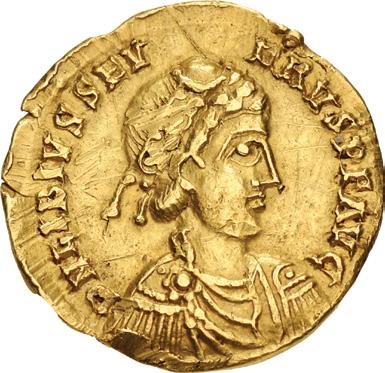
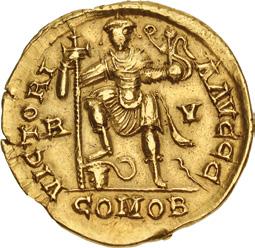
801. Libius Severus (Severus III). AD 461-465. AV Solidus (21mm, 4.34 g, 6h). Ravenna mint. D N LIBIVS SEV ERVS P F AVG, rosette-diademed, draped, and cuirassed bust right / VICTORI A AVGGG, Severus, wearing crown and military attire, standing facing, placing right foot on human-headed serpent coiled below, holding long cross in right hand and Victory on globe left in left hand; Victory holding palm frond in right arm and wreath in left hand; R|V//COMOB. RIC X 2718; Ranieri 155; Lacam Type A and pl. 16, 19; Depeyrot 24/2; Biaggi –; Mazzini 8. Toned, graffiti, scrapes, scratches, edge marks. VF. Very rare. ($2000)




802. Romulus Augustus. AD 475-476. AV Tremissis (14mm, 1.47 g, 6h). Mediolanum (Milan) mint. D N ROMVLVS AGVSTVS P F åG, pearl-diademed, draped, and cuirassed bust right / Cross within wreath; COMOB. RIC X 3419; Lacam Type 1, pls. CLXXXV (first and second illustrations) and 48, 34-5 (same dies); Depeyrot 43/2 corr. (obv. legend); Toffanin 541/1; Biaggi –; Mazzini –. Toned, trace deposits. EF. Very rare. An excellent example of this desirable issue struck from fresh dies. From an earlier die state than the examples illustrated by Lacam. ($40,000)
The task of ruling the Western Roman Empire in the late fifth century AD was devoid of the glory that once accompanied the office. Gone were the days of conquest and firm imperial power. In their place were consistent threats on the Empire’s crumbing borders, a corrupt bureaucracy, and the ever-present threat of violent insurrection and usurpation. During this fraught time in Rome, on 31 October AD 475, a new emperor was proclaimed — Romulus Augustus.
Romulus was the young son of the Western Empire’s magister militum, Orestes, who had deposed the Emperor Julius Nepos via military coup. Nepos fled to Dalmatia in exile, while the rogue Orestes elected to put Romulus, about 14 years old, on the throne. With his son as his puppet, Orestes went about his own agenda while trying to fulfill the expected functions of government in Italy, which was largely all that remained of the Western Roman Empire. Unfortunately for Orestes and Romulus, the presence of the Eastern Roman Empire, far more wealthy and powerful, could not be ignored. To gain legitimacy, they needed the recognition of Constantinople. Unfortunately for them, the Eastern Empire was undergoing its own ruling crisis between the rival emperors Zeno and Basiliscus, and both claimants still considered the exiled Julius Nepos as the legitimate western ruler.
Nepos wielded no real power in exile, leaving Romulus Augustus as the de facto emperor in the west. However, his time was destined to be short. Early in AD 476, a group of barbarian foederati, mercenaries in Rome’s employ, demanded a third of the arable land in Italy in payment for their services. Orestes refused their demands. Led by one Odovacer, the mercenaries marched on Ravenna. Orestes and his personal guard tried to stop them, but he was defeated and killed at Ticinum. On 4 September AD 476, Odovacer seized Ravenna. Young Romulus, alone and friendless, sat on the throne wearing his diadem and purple cloak, holding the imperial scepter and orb, awaiting his fate. Odovacer elected to spare his life, but ordered that he hand over the ruling regalia and forced him sign an instrument of abdication, which he sent on to Zeno in Constantinople. Romulus Augustus, whose name combined those of the first king and emperor of Rome, had reigned just under 11 months. Odovacer proclaimed himself King of Italy and informed Zeno that he would rule as viceroy of the Eastern Roman emperor; Zeno politely insisted that Julius Nepos was still the legitimate Augustus of the West. Nepos, however, never set foot in Italy again and was murdered in AD 480, eliminating the last legitimate Western Roman ruler.
Romulus who had survived his own overthrow was sent to the countryside to live out his days on a yearly pension of 6,000 solidi. He was still alive in AD 507 when he had a brief correspondence with Theodoric the Great, who had replaced Odovacer as king.
The sad episode of Romulus Augustus is considered by most historians to mark the end of the Western Roman Empire. The famous historian Edward Gibbon popularized this verdict in his monumental History of the Decline and Fall of the Roman Empire. Gibbon had this to say of the unremarkable, but historic Romulus Augustus. “The son of Orestes assumed and disgraced the names of Romulus Augustus; but the first was corrupted into Momyllus, by the Greeks, and the second has been changed by the Latins into the contemptible diminutive Augustulus. The life of this inoffensive youth was spared by the generous clemency of Odoacer; who dismissed him, with his whole family, from the Imperial palace, fixed his annual allowance at six thousand pieces of gold, and assigned the castle of Lucullus, in Campania, for the place of his exile or retirement.” Ultimately, due to the brief nature of his reign, the coinage of Romulus Augustus is quite rare and highly sought after for its historical significance. This example is a particularly excellent and high grade specimen.
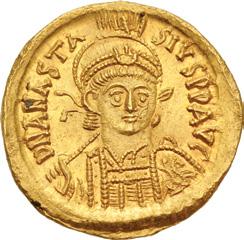


803. Anastasius I. 491-518. AV Solidus (19.5mm, 4.46 g, 6h). Constantinople mint, 3rd officina. Struck 492-507. D N
ANASTA SIVS PP AVG, helmeted and cuirassed bust facing slightly right, holding spear over right shoulder in right hand and shield decorated with horseman motif on left shoulder / VICTORI A AVGGG, Victory, draped, standing left, holding long jeweled cross in right hand; d to right; Γ//CONOB. DOC (3c); MIBE 4a; SB 3. Toned, minor hard deposits, minor cleaning scratches, light die rust on obverse. EF. ($750)


804. Anastasius I. 491-518. AV Solidus (20.5mm, 4.47 g, 7h). Constantinople mint, 9th officina. Struck 507-518. D N
ANASTA SIVS PP AVG, helmeted and cuirassed bust facing slightly right, holding spear over right shoulder in right hand and shield decorated with horseman motif on left shoulder / VICTORI A AVGGG, Victory, draped, standing left, holding long staff surmounted by reversed Christogram in right hand; d to left; Θ//CONOB. DOC 6b; MIBE 6a; SB 4. Toned. In NGC encapsulation 2400569-004, graded MS, Strike: 5/5, Surface: 4/5. From an exceptionally scarcer issue with the reversed Christogram than the usually encountered SB 3 (long cross) and 5 (reversed staurogram). ($1000)



805. Justinian I. 527-565. AV Solidus (20mm, 4.45 g, 6h). Constantinople mint, 10th officina. Struck 527-537. D N IVSTINI ANVS PP AVG, helmeted and cuirassed bust facing slightly right, holding spear over right shoulder in right hand and shield decorated with horseman motif on left shoulder / VICTORI A AVGGG, Angel, draped, standing facing, holding long cross in right hand and globus cruciger in left; d to right; I//CONOB. DOC 3i; MIBE 5; SB 137. Toned and lustrous, light scratches. Superb EF. ($750)
Purchased by the consignor from Antiqua, 2007.


806. Tiberius III (Apsimar). 698-705. AV Solidus (19.5mm, 4.41 g, 6h). Constantinople mint, 1st officina. D τIЬЄRI ЧS PЄ AV, crowned and cuirassed facing bust, holding transverse spear in right hand and shield decorated with horseman motif on left shoulder / VICTORIA AVςЧ, cross potent set on three steps; A//CONOB. DOC (1a); MIB 1; SB 1360. Toned and lustrous, slightly clipped, light hairlines. EF. ($750)
Ex Leu 91 (10 May 2004), lot 859.


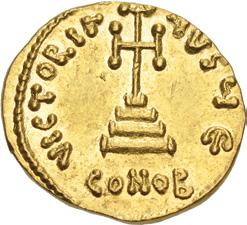
807. Tiberius III (Apsimar). 698-705. AV Solidus (19.5mm, 4.44 g, 7h). Constantinople mint, 5th officina. D τIЬЄRI ЧS PЄ AV, crowned and cuirassed facing bust, holding transverse spear in right hand and shield decorated with horseman motif on left shoulder / VICTORIA AVςЧ, cross potent set on three steps; Є//CONOB. DOC (1d); MIB 1; SB 1360. Lustrous. Superb EF. ($1000)
Ex Tkalec (7 May 2009), lot 220.

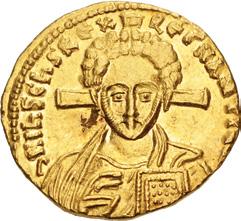


808. Justinian II, with Tiberius. Second reign, 705-711. AV Solidus (19.5mm, 4.47 g, 6h). Constantinople mint. Struck 705-711. ∂ N IҺS CҺS RЄX RЄΓNANTIЧM, draped and nimbate facing bust of Christ Pantokrator, raising right hand in benediction and holding Gospels in left / [...]RIЧS PP ´, crowned facing half-length busts of Justinian and Tiberius, both wearing chlamys, holding cross potent set on two steps between them with right hands. DOC 2a; MIB 2a; SB 1414. Small metal flaw on obverse. EF. ($1500)
Ex Numismatic Fine Arts I (20 March 1975), lot 439.



809. Philippicus (Bardanes). 711-713. AV Solidus (19.5mm, 4.36 g, 6h). Constantinople mint, 2nd officina. D N FI[LЄPPIC]ЧS MЧL TЧS AN, crowned facing bust, wearing loros, holding globus cruciger in right hand and eagle-tipped scepter in left / [VICT]ORIA AVςЧ, cross potent set on three steps; B//CONOB. DOC 1b; MIB 1; SB 1447; cf. CNG 123, 744 (same obv. die). Lightly toned, with some luster, lightly clipped, a couple spots of weakness, trace die rust and slight clashing on obverse, slight doubling and light hairlines on reverse. EF. From the obverse die with the less frequently found spelling of Philippicus’ name with two P’s rather than the more prevalently encountered spelling with just one. This coin from an earlier obverse die state than the CNG 123 coin. ($1000)
Ex Economopoulos Numismatics inventory 12002614 (ND).
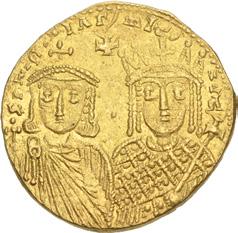

810. Constantine VI & Irene, with Leo III, Constantine V, and Leo IV. 780-797. AV Solidus (19mm, 4.49 g, 6h). Constantinople mint. Struck circa 790-circa 792. SIҺInI nI ΛΓ´ mIτ´ AVτ, crowned facing half-length busts of Constantine VI, wearing chlamys, holding globus cruciger in right hand, and Irene, wearing loros, holding cruciform scepter in left hand; cross above, • between / SVҺIRI ҺI ΛΓ´ mI´ AVτOЧ, Constantine V, Leo III, and Leo IV seated facing, each wearing crown and chlamys, wide suppedion beneath them. Cf. DOC 2 (for issue without die pairing error); Füeg Ir.4.11/Ir.4.3 (obv./rev.); cf. SB 1592/1591 (for obv./rev. type). Lightly toned, small edge scuff. Good VF. Extremely rare error with these dies paired together. Both sides with legends for Irene only. Only two noted in Füeg’s corpus. This example the third known and the only example without weakness on the obverse making the full legend readable for the first time. ($750)



811. Constantine VI & Irene. 780-797. AV Solidus (21.5mm, 4.43 g, 6h). Constantinople mint. Struck 792-797. IRIҺH
AΓOVSτ[I], crowned facing bust of Irene, wearing loros, holding globus cruciger in right hand and cruciform scepter in left / COҺSτAҺ τ[IҺ]OS ЬAS´, crowned facing bust of Constantine, wearing chlamys, holding globus cruciger in right hand and akakia in left; Θ at end of legend. DOC 3a; Füeg 5.A; SB 1594. Toned, with some luster, minor doubling, areas of weakness, a couple of minor marks, thin die break and faint hairlines on reverse. Near EF ($1500)



812. Irene. 797-802. AV Solidus (20mm, 4.37 g, 6h). Constantinople mint. ЄIRInH ЬASILISSH, crowned facing bust, wearing loros, holding globus cruciger in right hand and cruciform scepter in left / • ЄIRIҺH ЬASILISSH , crowned facing bust, wearing loros, holding globus cruciger in right hand and cruciform scepter in left. DOC 1a; Füeg 1.C.1; SB 1599. Toned, with some luster, a couple of spots of weakness, die cud and minor die rust on obverse, doubling on reverse. Near EF. ($1500)
From the Ramrodivs Collection. Ex Harlan J. Berk inventory cc70053 (ND).



813. Nicephorus I. 802-811. AV Solidus (20mm, 4.48 g, 6h). Constantinople mint. Struck 802-803. ҺICI FOROS ЬASILЄ´, crowned facing bust, wearing chlamys, holding cross potent in right hand and akakia in left / IҺSЧS XRIS τЧS ҺICA, cross potent set upon three steps; X at end of legend. DOC 1b; Füeg 1.B; SB 1603. Lightly toned and lustrous, a few minor marks. EF. Well centered. ($1000)


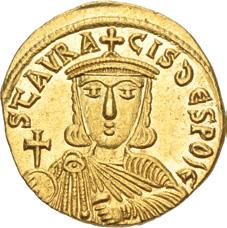

814. Nicephorus I, with Stauracius. 802-811. AV Solidus (18mm, 4.39 g, 6h). Constantinople mint. Struck 803-811.
• ҺICI FOROS ЬASILЄ´, crowned facing bust of Nicephorus, wearing chlamys, holding cross potent in right hand and akakia in left / SτAVRA CIS ∂ЄSPO´, crowned facing bust of Stauracius, wearing chlamys, holding globus cruciger in right hand and akakia in left; Є at end of legend. DOC 2a; Füeg 2.B.2; SB 1604. Lightly toned, with some luster, lightly clipped, minor die breaks and die rust on obverse, a few light scratches and slightly off center on reverse. EF. Well struck. ($1000)
Nicephorus’ career came to an abrupt end at the battle of Pliska on 26 July 811 during his Bulgarian campaign. The initial campaign was a rousing success, and the battle came immediately after the sack of Pliska (the Bulgarian capital) by Byzantine forces. The Bulgarian Khan Krum attempted to sue for peace after the disastrous loss of his capital city, but Nicephorus, confident from his great victory refused and planned to retake all of Bulgaria. While the Byzantines were plundering the city, Krum blocked their exit from the valley with traps and fortifications including a wooden palisade. Nicephorus was unwilling to assault the newly-constructed battlements and elected to set up camp. This proved unwise. The Bulgarians spent the next few days across in their camp rattling their shields in an effort to intimidate the Byzantine forces. By the time the two armies met in battle, the Byzantine army’s morale had evaporated. Despite the Byzantine’s possessing superior numbers, the army was completely routed by the Bulgarian Khanate. Very few members of the approximately 30,000 strong Byzantine army escaped the slaughter. Emperor Nicephorus himself was slain and his son and successor Stauracius received a serious wound to his spine which left him partially paralyzed. Theophanes the Confessor summarized the aftermath in his Chronographia as follows: “Among the victims were... the patrician Romanus, who was strategos of the Anatolics, and many protospatharioi and spatharioi, the commanders of the tagmata, including the domestic of the excubitors and the drungarios of the Imperial Watch, the strategos of Thrace, many officers of the themata, and an infinite number of soldiers so that the flower of Christendom was destroyed... May not Christians experience another time the ugly events of that day for which no lamentation is adequate” (Theophanes, 491).
Nicephorus’ body was not recovered, and Theophanes records that the Khan Krum “cut off the head of Nikephoros and for several days hung it on a pole so as to exhibit it to the tribes that came before him... After that, he bared the skull, reveted it on the outside with silver and, in his pride, made the chieftains of the Sklavinians drink from it” (Theophanes, 491-2). This follows the ancient Skythian custom recorded by Herodotus in The Histories Book 4.65. Thus ended the reign of Nicephorus and Stauracius.




815. Michael III “the Drunkard”, with Theodora and Thecla. 842-867. AV Solidus (21mm, 4.29 g, 6h). Constantinople mint. Struck 842-circa 843. + ΘЄO∂O RA ∂ЄSPVҺA, crowned facing half-length bust of Theodora, wearing loros, holding patriarchal globus cruciger in right hand and cruciform scepter in left / • mIXHL S Θ ЄCLA, crowned facing half-length figures of Michael, wearing chlamys, holding globus cruciger in right hand, and Thecla, to right, wearing loros, and holding patriarchal cross in right hand and akakia in left. DOC 1b; Füeg 1.D.12 (same rev. die as illustrated example); SB 1686. Toned, minor doubling, overstruck, clipped, minor marks and die marks. Good VF. Very rare. A pleasing and clear example for the type. This reverse die known from only a single example in the Füeg corpus. ($7500)
Michael III was only two years old when his father Theophilus died in 842. His mother Theodora as regent was the effective ruler of the empire, and the first coinage of his reign gives her prominence on the obverse. Michael was generally kept in the background, even overshadowed on the coins by his sister Thecla such as on this early solidus issue. With Michael in isolation, Theodora maintained the empire with the assistance of her brothers, Bardas and Petronas, along with Theoktistos, the logothete of the dromos. During Theodora’s regency, she brought an end to the second iconoclastic controversy and demonstrated herself as an effective and capable ruler. In a typical example of Byzantine family intrigue, Theoktistos moved against Bardas, who in turn conspired with the young emperor in 856 to remove his mother’s regency and eliminate Theoktistos. Theoktistos was ultimately killed and Theodora was removed from power and confined to a convent. The conspiracy continued and Bardas was murdered in 865 by Basil, an ambitious court official who befriended Michael and soon became coemperor. Basil proceeded to promptly eliminate his benefactor shortly thereafter.
Although Michael was given the unflattering epithet the “Drunkard,” this smear on his name was perpetuated by Basil to justify his seizure of power. Michael appears to have been a conscientious ruler and capable military leader, his fatal failing being that he was too easily swayed by his unscrupulous associates.



816. Leo VI the Wise, with Constantine VII. 886-912. AV Solidus (19.5mm, 4.41 g, 6h). Constantinople mint. Struck 908-912. + IҺS XPS RЄX RЄ Ų NANTIЧm, Christ Pantokrator enthroned facing on suppedion, armrests with eight pellets, draped and nimbate, raising right hand in benediction and holding Gospels in left / LЄOҺ ЄT COҺS†AҺ†´ AЧ ŲŲ ´ ROm´, crowned facing figures of Leo, holding globus cruciger in right hand, and Constantine, holding globus cruciger in left hand, both wearing loros decorated with a cross at end and together holding patriarchal cross between them with left and right hands respectively. DOC 2; Füeg 3.A.1 (same rev. die as illustrated example); SB 1725. Toned, light scuffs, spots of slight tooling on obverse. EF. ($2500)
Rare First Solidus Issue of Constantine VII and Romanus I



817. Constantine VII Porphyrogenitus, with Romanus I. 913-959. AV Solidus (18.5mm, 4.39 g, 6h). Constantinople mint. Struck 920-921. +IҺS XPS RЄX RЄςNANτIЧM *, Christ Pantokrator enthroned facing on suppedion, draped and nimbate, raising right hand in benediction and holding Gospels in left / COҺSτAҺτ´ CЄ ROMAҺ´ AЧPP´ Ь´, crowned facing busts of Constantine and Romanus, both wearing loros and together holding patriarchal cross between them with right and left hand respectively. DOC 3; Füeg 3; SB 1741. Toned, trace deposits, a few minor die breaks on obverse. Good VF. Rare. ($1500)
Constantine VII’s time as emperor had a very complex path to his eventual sole reign. Following the death of his uncle Alexander, Constantine began his reign under the regency of the Patriarch of Constantinople, Nicolas Mystikos. However, Nicolas’ regency was short-lived. After the Tsar of Bulgaria, Symeon, appeared outside Constantinople with a massive army, Nicolas capitulated to the Bulgarians’ demands and granted them numerous concessions. This lack of strength by Nicolas led to a palace revolt in which Nicolas’ regency was removed and replaced with that of Constantine’s mother, Zoe Karbonopsina. This change in government led Symeon to invade the Byzantine empire and lay waste to numerous provinces. His destructive campaign was eventually stymied by the capable general Romanus Lecapenus. Upon Romanus’ initial victories, he assumed the regency from Zoe, whom he forced into a convent. Romanus additionally married his daughter Helena to Constantine. In December of 920, Romanus assumed the title of co-Augustus and, though he did not depose Constantine, he kept all the power for himself. Romanus and Symeon continued to war against each other until Symeon’s death in 927. Symeon’s death seriously diminished the Bulgarians’ power and Romanus was free to turn his attention towards matters of state.
Between 921 and 945, Romanus elevated three of his sons as co-Augustus: Christopher, Stephen, and Constantine. All the while, the former senior Augustus Constantine VII was completely sidelined for over thirty years (Romanus officially displaced Constantine as senior Augustus around 921). However, matters eventually changed when Stephen and Constantine turned on their father and deposed him in December 944. This was precipitated by Romanus drafting a will in which he intended to leave Constantine VII as sole Augusutus following his death. Constantine VII seized his chance and in turn successfully deposed Stephen and Constantine that following January. Finally, in the thirty-first year of his reign, Constantine VII was free of his domineering associates and became sole Augustus. Later that year, he added his own son Romanus II as co-Augustus. Constantine reigned for an additional fourteen years after he finally deposed the Lecapeni before dying in 959 after reigning for a total of forty-six years. This issue was struck during the brief one-year period in which Romanus I had assumed the title of Augustus but before he began elevating his own sons which accounts for the rarity of this difficult issue.



818. Romanus III Argyrus. 1028-1034. AR Miliaresion (24.5mm, 2.65 g, 7h). Constantinople mint. Struck circa 1030. + ΠΑΡΘЄΝЄ CΟΙ ΠΟΛVΑΙΝЄ, the Theotokos Hodegetria, wearing tunic and maphorion, standing facing on suppedion, holding the Holy Infant with left hand and resting right hand on breast; M and Θ, both with macron above, flanking across upper field / ΟC ΗΛΠΙΚЄ ΠΑΝ ΤΑ ΚΑΤΟPΘΟΙ, crowned facing figure of Romanus, standing facing on suppedion, wearing loros, holding long patriarchal cross in right hand and patriarchal globus cruciger in left. DOC (3b.1); SB 1822. Toned, flan crack, scratches and marks. Good VF. Very rare. ($3000)
Ex Triton XXIV (19 January 2021), lot 1194.



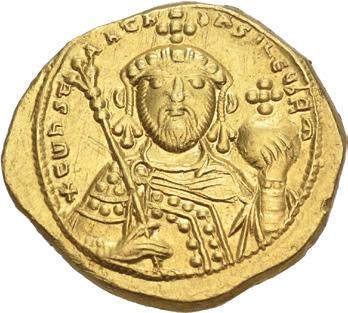
819. Constantine IX Monomachus. 1042-1055. AV Tetarteron (18.5mm, 4.03 g, 6h). Constantinople mint. +IҺS XIS RЄX RЄςNANTIҺm, facing bust of Christ Pantokrator, draped and nimbate, raising right hand in benediction and holding Gospels in left / + CωҺSτ AҺτҺ BASILЄЧS Rm, crowned facing bust of Constantine, wearing jeweled chlamys, holding scepter surmounted by trefoil in right hand and globus cruciger in left. DOC 5a; Füeg II 5.A.2; SB 1832. Toned, minor scratches and marks, edge marks; minor die break, tiny lamination, and light scuff on reverse. Good VF. ($750)

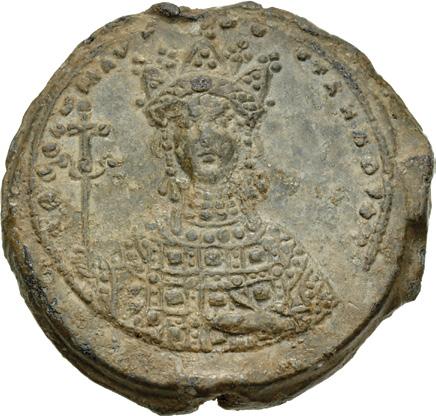
820. Theodora. 1055-1056. PB Seal (36mm, 39.03 g, 12h). + ЄMMΛ NOVHΛ, facing bust of Christ Pantokrator, draped and nimbate, raising right hand in benediction and holding Gospels in left; IC XC, both with macron above, flanking / + ΘЄOΔωPΛ ΛVΓ OVCTΛ H ПOPΦV, half-length facing bust of Theodora, wearing ornate crown and jeweled loros, holding jeweled cruciform scepter with tendril ornament in right hand and resting left hand on breast. BLS I 82 var. (rev. legend); DOCBS 6, –. Even tan patina. Good VF. Extremely rare. Very clear and wonderfully complete. An excellent and impressive imperial seal of the venerable Theodora. ($3000)
From the Jonathan Kern Collection. Ex Peter J. Merani Collection (Triton XXIV, 19 January 2021), lot 238; Gemini IV (8 January 2008), lot 541.


821. Ekdikoi of the Hagia Sophia. Circa 12th century. PB Seal (55mm, 107.50 g, 12h). The Theotokos, wearing tunic and maphorion and Justinian I, wearing crown and loros, both nimbate, supporting between them a model of the Hagia Sophia held in both hands; [+VΠЄPAΓ]IA Θ[Є]O TOKЄ ROHΘЄI around, H/A/[Γ/I]/A C/O/Φ/I/A down central field / – • – / + TOIC ΘЄ/OCЄRЄCTA/TOIC ΠPЄC/RVTЄPOIC/ KAI ЄKKΛH/CЄKΔIK´/ – • – in eight lines. BLS II 65. Tan-brown patina, light roughness, a couple of minor stress cracks on reverse. VF. ($1500)
Ex Classical Numismatic Group 121 (6 October 2022), lot 1145; Classical Numismatic Group 108 (16 May 2018), lot 780.
The ekdikoi were a college of priests responsible for the administration of holy sites, who additionally carried out a judicial function. In this capacity, accused criminals who sought asylum in churches would be judged by them. The office was established by Justinian I (527-565), but it did not acquire a real presence in the administration of church affairs until later in the 11th century.


822. Theodore Comnenus-Ducas. As emperor of Thessalonica, 1225/7-1230. AR Trachy (31mm, 4.30 g, 6h). Thessalonica mint. Struck circa 1227. IAΓ/IOC/Θ - PH/TH/CA in two columnar groups flanking, the Theotokos standing facing, orans, wearing tunic and maphorion; m ΘV, both with macron above, flanking head; no sigla / ΘЄOΔωPOC ΔЄCΠO OΛΓIOC Δ[IM], facing figures of Theodore, wearing crown and loros, resting right hand on chest, and St. Demitrius, nimbate and wearing military attire, together holding the city walls of Thessalonica between them; Theodore supporting city walls with left hand, St. Demitrius holding city walls in both hands; above, manus Dei crowning Theodore. DOC 2c var. (obv. legend); CLBC 12.1.2 var. (sigla); LBC 321 var. (same); SB 2159. Toned, minor deposits, extensive hairlines. EF. Very well struck from wonderfully detailed dies. ($1000)



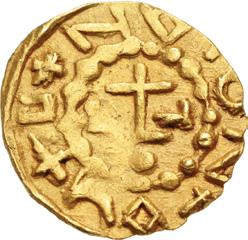
823. MEROVINGIANS, Frise. Circa 630/40-635/45. AV Tremissis (14mm, 1.24 g, 6h). Pol Series II, Classes 2-3. • nʽ ม to left, e© ม to right, pearl-diademed and draped bust left / ม ²n ม ƩƩ ม ƌ² ม n⌴ , Latin cross set on base, itself set on globe; ъ and ƺ flanking upright. NM 8; Belfort 5434; Prou 1239 = Collection Amécourt 639; Stahl, Merovingiens 324; MEC 1, –. Toned, area of weakness on reverse. VF. Rare. ($1500)
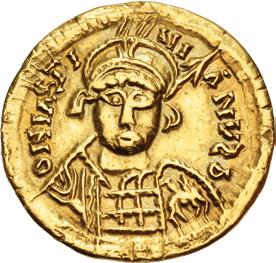


824. MEROVINGIANS, Pseudo-Imperial coinage. Mid 6th century. AV Solidus (23mm, 4.33 g, 6h). Imitating a 1st officina Constantinople mint issue of the Byzantine emperor Justinian I (527-565). Uncertain Frankish mint. ĕ n Ʃ©⌽ͿƩ nƩ ©nѝ˝ P , pearl-diademed, helmeted, and cuirassed bust facing slightly right, holding spear over shoulder in right hand and shield decorated with horseman motif in left / ѝƩ⌐Ϳ⌴ʽ Ʃ © ©ѝ⌐⌐⌐ , Victory standing left, holding staurogram cross in right hand; star to left; V // ⌐⌴n⌴B . NM –; Belfort –, but cf. 5251-2 (for type); MEC 1 –, but cf. 177 for type [attributed to the Burgundians]; Chwartz II, lot 174 = Collection N.K., lot 730 = Boutin 1064 (this coin). Lightly toned, hint of deposits, evidence of having been placed in a bezel. Good VF. Extremely rare. ($1000)
From the Ramrodivs Collection. Ex Berk BBS 189 (25 March 2014), no. 40; Bernard Chwartz Collection (Part II, Alde/Crinon 39, 14 June 2010), lot 174; Collection N. K. (Bourgey, 27 October 1992), lot 730.




825. MEROVINGIANS, Quentovic. Circa 585-675. AV Tremissis (13mm, 1.31 g, 9h). Dutta, moneyer. ๘ XƩXVVƩ⍛⌴˞ , diademed head right; two pellets below / ๘ ⌴V˶˶© ©©⌴Ve˶© (sic), cross pattée; ©X© below. NM 9; Lafaurie, VVic, Type IXc, 83-5; 87-8 (same obv. die); Belfort 2198; Prou 1141; EMC 2011.0127 = Coin Register 2011, 47 (this coin). Earthen deposits in devices, obverse struck with rusty die. Good VF. ($750)
Ex Classical Numismatic Group 123 (23 May 2023), lot 827; found near Ipswich, 2011.




826. MEROVINGIANS, Uncertain. Circa 630-645. AV Tremissis (15mm, 1.23 g, 6h). n ç ⌴ ˶²⍛ , pearl-diademed and draped bust left / ม ©Ʃ∂Ƀ˞ [...]ç © , Latin cross pommée; ⍛ and ± flanking base. NM –; cf. Belfort 1750 (for obv.); Prou –; MEC 1, –. Toned, traces of deposits, areas of peripheral flat strike, creased and straightened. Fragile. Good VF. Very rare. ($1500)




827. CAROLINGIANS. Charlemagne (Charles the Great). As Charles I, King of the Franks, 768-814. AV Tremissis (19mm, 1.04 g, 6h). Lucca mint. Struck after the defeat of Desiderius in 774. Ŋ⌦მ¬ѝƟ • ¬ѝƟ • ¬ • ⌦ѝïმ¬ •, six-rayed star; small leaves between rays; • in ѝ s and ï in legend / ĕ n æ±ʽ VǮVs ⎁ģҕ , facing half-length bust. Rossini –; Bernareggi –; Bernareggi, Tremissi –; Bernareggi, Moneta, –; Depeyrot 515B = CNI XI 2 = E&S p. 35, 96; cf. Gariel 172 = Kluge 199; BMC Vandals –; Arslan –; MEC 1, –. Deposits, some weakness with worn dies. Near VF. Extremely rare. ($30,000)
Ex Numismatica Genevensis SA 16 (14 November 2022), lot 314.
The only gold coin to bear a portrait of Charlemagne.
Following Charlemagne’s conquest of the Lombardic kingdom in 774 a short lived issue of gold tremisses was struck at a range of mints across northern Italy in his name. These rare coins are all of the same star / cross potent type of the defeated Desiderius except for an extremely rare issue at Lucca that remarkably depicts the King of the Franks on the reverse. Rossini records only six specimens of the portrait issue, four of which are damaged and incomplete. Only one other example has previously appeared at auction. That coin, from the Adams collection (Triton XIX, lot 2207), realized $180,000 in 2016.


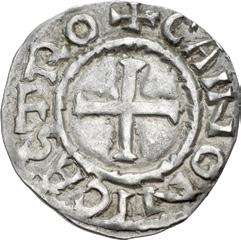
828. CAROLINGIANS. temp. Robert I. King of West Francia, 922-923. AR Denier (20mm, 1.35 g, 5h). Crinon Group 1, Series 1, Variety 1. Chinon mint. ˶Vʼ⌴⎴ to right, diademed and mantled bust right / ส ⍛©Ʃ⎴⌴⎴Ʃ ⍛²S˶ʼ⌴ , cross pattée; pellet in first quarter. P. Crinon, Catalogue, p. 73, 1-4/2 (same dies); Poey d’Avant 1670; Fécamp pl. XIV = P. Crinon, “À propos de deniers inédits de Blois (Xe siècle): le monnayage à la tête dans les domaines de Thibaud de Tours et Thibaud Ier (durant les deux premiers tiers du Xe s.)” in BSFN 48.1 (January 1993), p. 469; CNG Inv. 956854 (same obv. die). Iridescent tone, hint of deposits. Good VF. ($1000)




829. ‘Abbasid Caliphate. al-Mu’tamid. AH 256-279 / AD 870-892. AV Dinar (26mm, 4.87 g, 6h). Citing the heir al-Mufawwid ‘Ala Allah and the vizier Sa’id b. Makhlad as dhu’l-wizaratayn (the holder of the two offices). al-Rahba mint. Dated AH 270 (AD 961/2). AGC I 176 – (mint unlisted); Album 239.3; Zeno –. Lightly toned, light die rust, slight double strike and peripheral die weakness. Good VF. An extremely rare mint. ($5000)
End of Session 3
Session 4 – Wednesday, January 15, 2025 — 2 PM



830. ALBANIA, Kingdom. Zog I. 1928-1939/1946. AV 100 Franga Ari Prova (34mm, 32.28 g, 6h). Rome mint. Dated 1929 R. ZOG · I · MBRET · I · SHQIPTARVE, bare head left within wreath / · ALBANIA ·, crowned double-headed eagle facing with wings spread; FR A 100 flanking; PROVA 1929 R below. Montenegro 16; KM Pr39; Friedberg 10. In NGC encapsulation 6891676-006, graded MS 62. ($7500)
From the Alexander Christopher Collection.
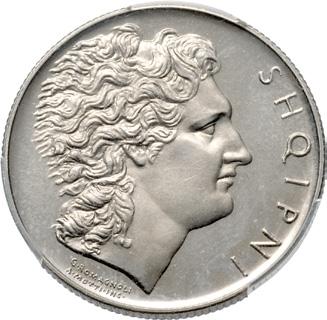


831. ALBANIA, Kingdom. Zog I. 1928-1939/1946. NI Lek (26mm, 6h). London mint. Dated 1931 L. Diademed head of Alexander the Great right / Alexander the Great on horseback right, holding reins and raised sword. KM 5. In PCGS encapsulation 49770293, graded PR 66 CAM. ($1000)



832. ALBANIA, Kingdom. Zog I. 1928-1939/1946. NI Half Lek (24mm, 6h). London mint. Dated 1931 L. Mantled coat-of-arms surmounted by winged cap / Hercules wrestling Nemean lion. KM 13. In PCGS encapsulation 49770294, graded PR 65 CAM. ($750)

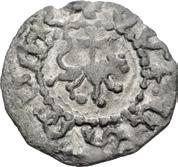


833. ARMENIA, Cilician Armenia. Royal. Smpad. 1296-1298. AR Quarter Tram (15mm, 0.48 g, 12h). Lion advancing right; long cross over shoulder / Lis. AC 411 (Half Tram). Lightly toned. Good VF. ($500)

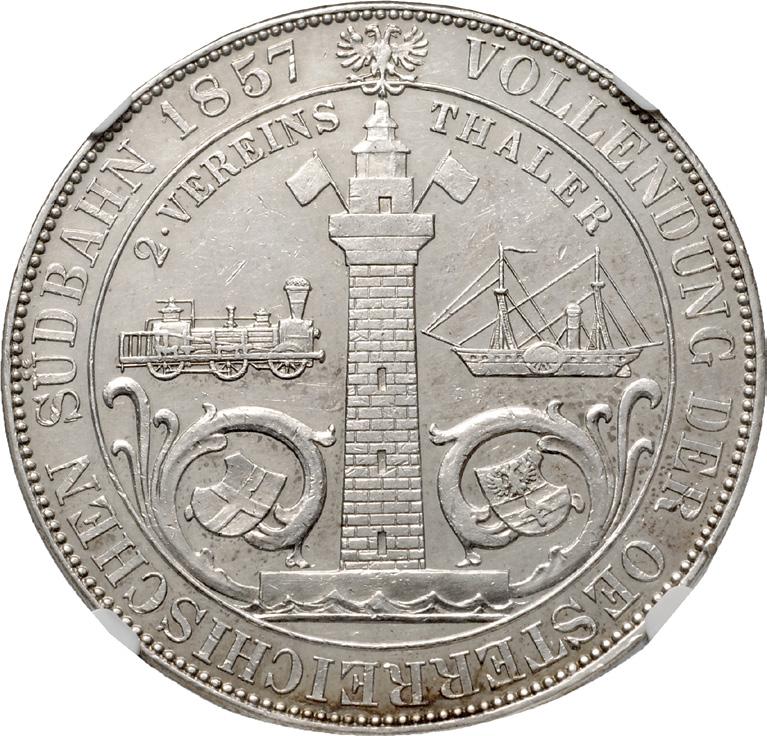

834. AUSTRIA, Austrian Empire. Franz Josef I. 1848-1867. AR Doppeltaler (41mm, 12h). Commemorating the opening of the Vienna-Trieste railroad. Wien (Vienna) mint. Dated 1857 A. Laureate head right / Tower; steam engine and paddlewheel steamship flanking; below each, two coats-of-arms within floral sprays. Herinek 821v; Davenport 20; KM 2246.1. In NGC encapsulation 3593726-001, graded AU 58. ($3000)
Though discussions of a rail connection from the capital to the Empire’s main seaport of Trieste were begun as early as 1829, the initial work would not begin until 1839. The line would ultimately be completed in 1857 with the construction of the final section through the Karst Plateau.


835. AUSTRIA, Gurk (Bishophric). Franz Xaver von Salm-Reiffescheid. 1782-1822. AR Taler (40mm, 12h). Wien (Vienna) mint. Dated 1801. Mantled bust right, wearing zuchetto / Crowned and mantled coat-of-arms surmounted by tasseled gallero; crossed sword and crozier in background. Davenport 40; KM 2. Lustrous. In NGC encapsulation 2610194-004, graded MS 63. ($1000)


836. AUSTRIA, Nostitz-Rieneck (County). Anton Johann. 1683-1736. AR Taler (41mm, 29.26 g, 12h). Nürnberg mint. Dated 1719. Armored bust right / Crowned coat-of-arms with griffin supporters, surmounted by swan with wings spread, head left. Davenport 1191; KM 6. Old cabinet toning with hints of luster. In NGC encapsulation 6928237-003, graded AU 55. Rare. ($3000)
From the Alexander Christopher Collection.


837. AUSTRIA, Olmütz (Archbishophric). Rudolf von Hapsburg-Lothringen. 1819-1831. AR Taler (41mm, 27.96 g, 12h). Vienna mint. Dated 1820. Mantled bust left, wearing zucchetto / Coat-of-arms surmounted by tasseled gallero, mitre, and crown; crossed crozier and sword in background. Davenport 41; KM 494. Toned. In NGC encapsulation 6924407-009, graded MS 64. ($1000)
From the Alexander Christopher Collection.



838. AUSTRIA, Salzburg (Prince-Archbishophric). Matthüas Lang von Wellenberg. 1519-1540. AR 2 Guildiner (47mm, 52.91 g, 12h). Dated 1538 (in Roman numerals). Bust left, wearing biretta and cowl / Coat-of-arms surmounted by tasseled gallero; crossed scepter and crozier in background. Zöttl 192; Probszt 201; Davenport 8164. Old cabinet toning, a few scattered marks and edge marks. Near EF. ($3000)
From the Alexander Christopher Collection.
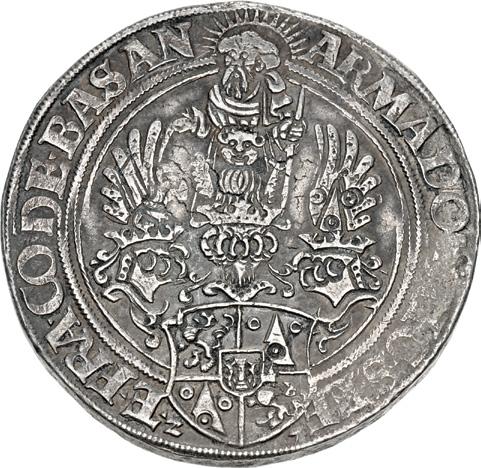

839. AUSTRIA, Schlick (County). Stephan, Burian, Heinrich, Hieronymous, and Lorenz. 1516-1526. AR Taler (40mm, 28.90 g, 10h). In the name of Ferdinand I, as King of Bohemia. Joachimstal (Jáchymov) mint; mm: cross over crescent. Dated 1527. Three coats-of-arms surmounted by ornately crested helmets / Crowned lion rampant left. Davenport 8148. Toned, areas of weak strike, scattered marks and scratches, edge marks. VF. ($1500)
From the Alexander Christopher Collection.



840. AUSTRIA, Windischgrätz (County). Leopold Victor Johann. 1727-1746. AR Taler (42mm, 29.19 g, 12h). Wien (Vienna) mint. Dated 1732 B. Armored and draped bust right / Coat-of-arms surmounted by three ornately crested coats-ofarms; canine supporters. Davenport 1202; KM 5. Lustrous, hairlines, scratch. AU. ($1500)
From the Alexander Christopher Collection.




841. BULGARIA, Principality. Ferdinand I. 1887-1908. Proof AV 20 Leva (20mm, 6.45 g, 6h). Kremnitz mint. Dated 1894 KБ. Bare head left / Crowned coat-of-arms. CBC p. 16; KM 20; Friedberg 3. In NGC encapsulation 6891729-001, graded PF 66 Ultra Cameo. Rare. Top Pop. The finest graded by either NGC or PCGS. ($15,000)
From the Alexander Christopher Collection.


842. BULGARIA, Principality. Ferdinand I. 1887-1908. Uniface Pattern CU 5 Leva (36.5mm). Kremnitz mint. Die by A. Scharff. Struck 1892. ФЕРДИНАНДЪ
bare head left; K · В · below / Blank. Unpublished in the standard references. In PCGS encapsulation 27541552, graded SP 62 BN. Extremely rare. ($5000) Ex Macho & Chlapovič 25 (7 May 2021), lot 388; Macho & Chlapovič 5 (16 November 2013), lot 412.



843. BULGARIA, Tsardom. Ferdinand I. 1908-1918. AR 50 Stotinki (18mm, 6h). Kremnitz mint. Dated 1913. Bare head left / Denomination within wreath. CBC p. 26; KM 30. Iridescent toning. In PCGS encapsulation 42272263, graded MS 66+. ($750)



844. CANADA, Province of Lower Canada. Montreal. R.W. Owen Ropery. CU Halfpenny Token (27mm, 7.67 g, 12h). Struck 1824. Ship under sail right / R · W · OWEN/ MONTREAL/ ROPERY within braided rope border. Charlton LC-18; Breton 564. Green-brown surfaces, some roughness. Good VF. Not suitable for encapsulation. Extremely rare. ($5000)
From the Alexander Christopher Collection.
Shortly after this token was issued, R.W. Owen sold his business to J.A. Converse, whose steam-powered production facilities were far superior. As such, this token is extremely rare and extraordinarily difficult to acquire in any grade.




845. CAMBODIA, Siamese-Vietnamese Protectorate. Ang Duong. 1845-1859. AR Fuang – 1/8 Tical (13mm, 1.94 g, 12h). Udong mint. Struck 1847. Hamsa bird standing left / Façade of the Palace of Angkor. Mitchiner, Non-Islamic 3039; KM 33. Deeply toned. In NGC encapsulation 6928251-010, graded MS 63. ($1500)
From the Norman Frank Collection.


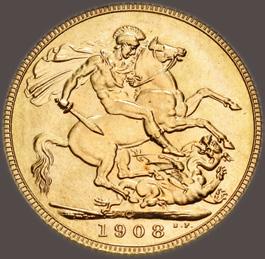

846. CANADA. Edward VII. 1901-1910. Specimen AV Sovereign (22mm, 7.99 g, 12h). Ottawa mint. Dated 1908 C. Bare head right / St. George on horseback rearing right, holding reins and sword and slaying dragon to lower right. Charlton p. 244; Bull, Gold 1903; Marsh 183; SCBC 3970. In NGC encapsulation 6928237-001, graded SP 65. Very rare – only 636 struck. A key date of the Canadian sovereign series. ($10,000)
Ex Charles L. Ruby Collection (Part II, Superior, 17 June 1974), lot 1167.
This wonderful specimen sovereign (called a ‘satin proof’ in Bull) is one of a very limited number struck by the Ottawa mint in its first year of operation. As Ottawa was legally considered a branch of the Royal mint in London, it was required to strike sovereigns on demand. Canada had it’s own decimal currency, including gold five and ten dollar coins struck from 1912 to 1914, and the sovereign never regularly circulated in the country. The sovereigns that were struck from 1909 to 1919 were mostly ordered by companies for export purposes.



847. CANADA. George V. 1910-1936. AV Sovereign (22mm, 7.99 g, 12h). Ottawa mint. Dated 1913 C. Bare head left / St. George on horseback rearing right, holding reins and sword and slaying dragon to lower right. Charlton p. 244; Bull, Gold 1909; Marsh 222; SCBC 3997. In NGC encapsulation 6924407-005, graded MS 62. ($1500)

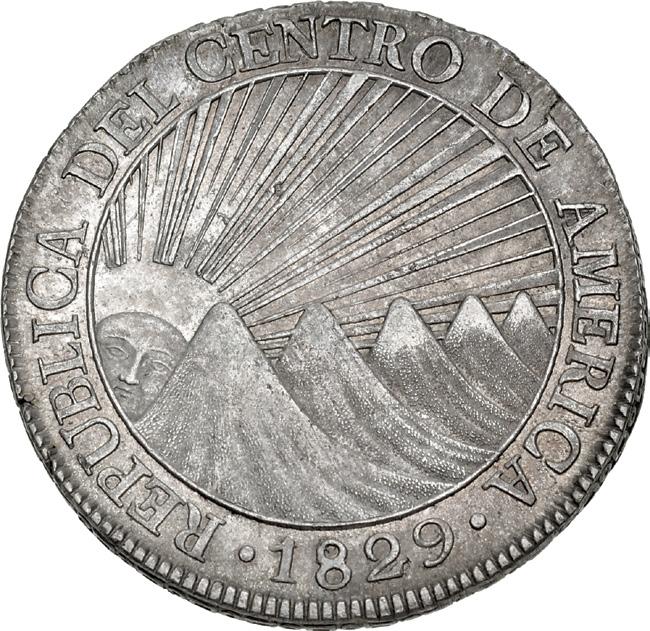

848. CENTRAL AMERICAN REPUBLIC, Federal coinage. 1823-1838/1841. AR 8 Reales (38mm, 26.92 g, 12h). Nueva Guatemala mint. Dated 1829 NG M. Sun rising over mountains / Ceiba tree. Stickney C92; KM 4. Toned with underlying luster. In NGC encapsulation 6898712-006, graded MS 63. Top Pop ($1500)
From the Alexander Christopher Collection.

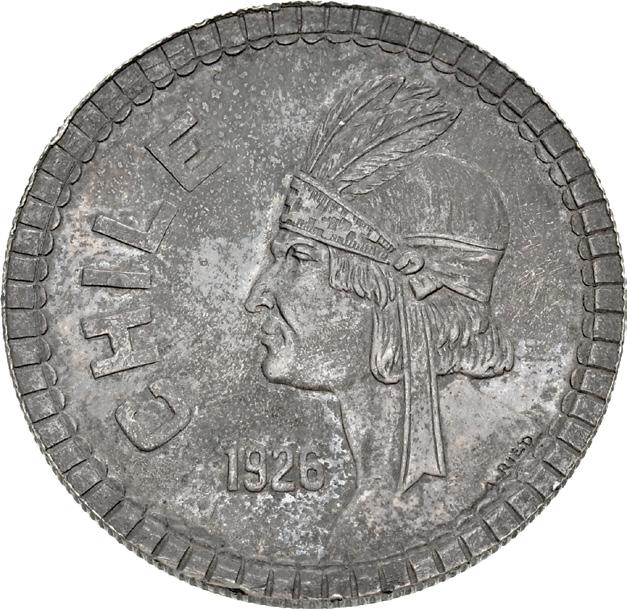

849. CHILE, Republic. 1818-present. Pattern AR 5 Pesos (37mm, 24.79 g, 6h). Santiago mint. Dated 1926 So. CHILE, native bust left, wearing feathered headdress; in right field, [072] effaced from die / Star; 5 above, CINCO PESOS below; all within wreath of brugmansia (angel’s trumpet); So below. KM Pn45. Toned. In NGC encapsulation 6924486-015, graded AU 58. ($1000)
From the Alexander Christopher Collection.
The wreath on the reverse of this pattern is not the normal laurel or oak wreath, but rather appears to be made of a brugmansia, also known as the ‘angel’s trumpet’ due to its distinct trumpet-shaped flowers. The brugmansia, native to South America, is among the most toxic of ornamental plants.



850. CHILE, Republic. 1818-present. Pattern AR Peso (27mm, 9.27 g, 6h). Santiago mint. Dated 1926 So. CHILE, native bust left, wearing feathered headdress / Star; 1 above, UN PESO below; all within wreath of brugmansia (angel’s trumpet); So below. KM Pn38. Iridescent toning. In NGC encapsulation 6924486-016, graded MS 63. ($1000)
From the Alexander Christopher Collection.


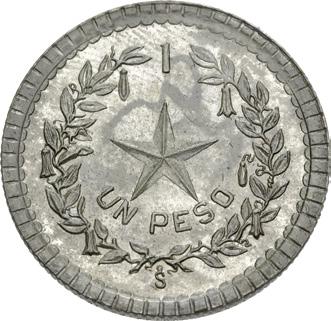
851. CHILE, Republic. 1818-present. Pattern AR Peso (27mm, 8.96 g, 6h). Santiago mint. Dated 1926 So. CHILE, native bust left, wearing feathered headdress; 072 (fineness) to right / Star; 1 above, UN PESO below; all within wreath of brugmansia (angel’s trumpet); So below. KM Pn39. Lightly toned. In NGC encapsulation 6924486-017, graded UNC Details, cleaned. ($750)
From the Alexander Christopher Collection.


852. CHINA, Qīng dynasty. Wénzōng (Xiánfēng). AD 1851-1861. Æ 1000 Cash (62mm, 108.10 g, 12h). Board of Revenue mint. Cast March-August 1854. Xian Feng Yuan Bao in Hànzì characters / Dang Qian (Value One Thousand) in Hànzì characters and boo chiowan in Manchu script. Hartill 22.714. Brown surfaces, scattered bumps, marks, and scratches, central hole slightly smoothed. VF. An exceptionally heavy example, with this type normally weighing from 60-85 g. Rare thus. ($2500)


853. CHINA, Qīng dynasty. Wénzōng (Xiánfēng). AD 1851-1861. Æ 50 Cash (42mm, 37.37 g, 12h). Prince Qìng Hui (Board of Revenue) mint. Cast May-August 1854. Xian Feng Zhong Bao in Hànzì characters / Dang wushi (Value Fifty) in Hànzì characters and boo chiowan in Manchu script; crescent and pellet flanking dang. Hartill 22.716. Brown surfaces with traces of red cinnabar and shimmering mineral residue remain on reverse, some edge damage. Good VF. Intricately engraved for later use as a charm, indicative of the contemporary popularity of the type. ($750)


854. CHINA, Qīng dynasty. Wénzōng (Xiánfēng). AD 1851-1861. Æ 100 Cash (71mm, 187.2 g, 12h). Fuzhou mint in Fujian province. Cast circa 1853-1855. Xian Feng Tong Bao in Hànzì characters / Yi Bai (One hundred [cash]) in Hànzì characters and boo fu in Manchu script. Hartill 22.785. Brown surfaces, usual scattered marks and scratches. Good VF. An attractive example. ($1500)


855. CHINA, Qīng dynasty. Wénzōng (Xiánfēng). AD 1851-1861. Æ 100 Cash (71mm, 198.5 g, 12h). Fuzhou mint in Fujian province. Cast circa 1853-1855. Xian Feng Tong Bao in Hànzì characters / Yi Bai (One hundred [cash]) in Hànzì characters and boo fu in Manchu script. Hartill 22.785. Brown surfaces, usual scattered marks and scratches. VF. ($1000)
From the Drewry Family Collection, purchased from George Watson, January 1994.


856. CHINA, Qīng dynasty. Wénzōng (Xiánfēng). AD 1851-1861. Æ 50 Cash (56mm, 96.48 g, 12h). Fuzhou mint in Fujian province. Cast circa 1853-1855. Xian Feng Zhong Bao in Hànzì characters / Wu Shi (Fifty [cash]) in Hànzì characters and boo fu in Manchu script. Hartill 22.794. Brown surfaces, usual scattered marks and scratches. VF. ($1000)
From the Drewry Family Collection, purchased from George Watson, January 1994.
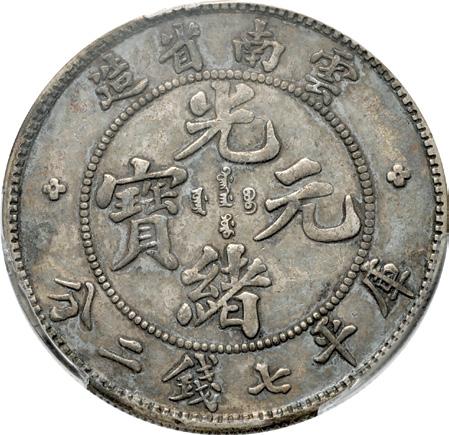

857. CHINA, Qīng dynasty. Provincial issues. Yúnnán. AR 7 Mace 2 Candareens – Dollar (38mm, 12h). Kūnmíng mint. Struck 1907. Legend in Hànzì characters / Dragon flying facing. L&M 418; KM (Y) 254. Toned. In PCGS encapsulation 31772825, graded XF 40. ($1000)


858. CHINA, Qīng dynasty. Provincial issues. Fèngtiān. AR 7 Mace 2 Candareens – Dollar (38mm, 12h). Fèngtiān mint. Dated RY 24 of Dézōng (Guāngxù) (AD 1898). Dragon flying facing around central pearl; stylized clouds around; wide mustache variety / Denomination at center in Hànzì characters; legend in English and Manchu script around. Pointed Yī in denomination. L&M 471; KM (Y) 87. Toned. In PCGS encapsulation 89293789, graded VF Details, repaired. ($2000)
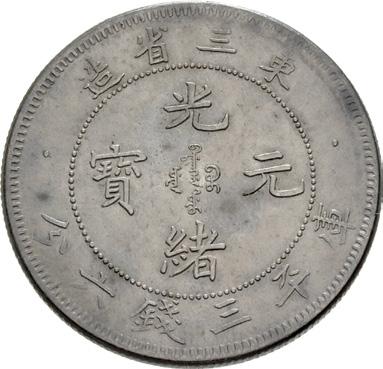

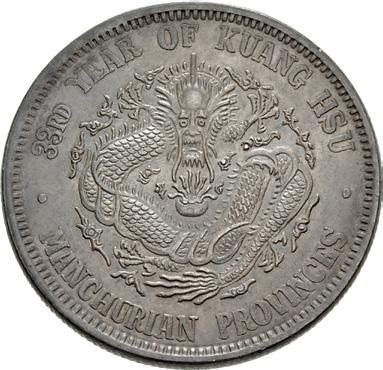
859. CHINA, Qīng dynasty. Provincial issues. Mǎnzhōu (Manchuria). AR 3 Mace 6 Candareens – 50 Cents (32mm, 13.23 g, 12h). Fèngtiān mint. Dated RY 33 of Dézōng (Guāngxù) (AD 1907). Legend in Hànzì characters / Dragon flying facing around flaming pearl; stylized clouds around. L&M 488; KM (Y) 211. Toned. In NGC encapsulation 6929824-001, graded AU 58. ($4000)
From the Drewry Family Collection. Ex H. Christensen 90 (4 October 1985), lot 54.

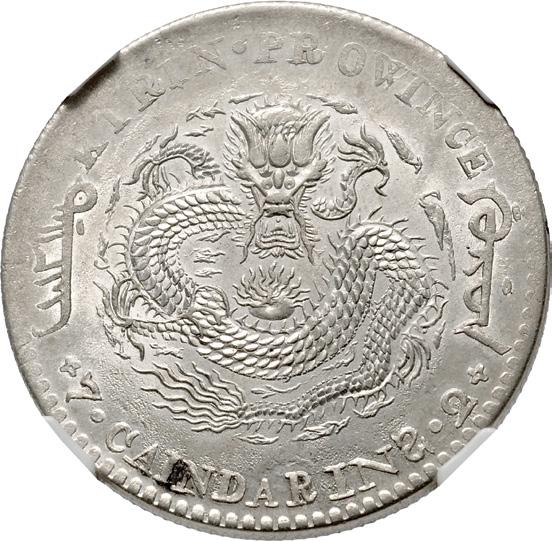

860. CHINA, Qīng dynasty. Provincial issues. Jílín. AR 7 Mace 2 Candareens – Dollar (37mm, 11h). Jílín mint. Dated Ganzhi year Xinchou (AD 1901). Legend in Hànzì around taijitu (yinyang) / Dragon flying facing around central flaming pearl; stylized clouds around. L&M 536; KM (Y) 183a.1. In NGC encapsulation 3478851-004, graded MS 61. ($5000)



861. CHINA, Republic of China. Yuán Shìkăi. President, 1912-1915. AR Dollar (39mm, 26.76 g, 12h). Tiānjīn Central mint. 1918 restrike of a 1914 issue. Uniformed bust facing, wearing plumed kepi / Legend in Hànzì within wreath. L&M 858; KM (Y) 322.1. In PCGS encapsulation 50741197, graded AU Details, tooled. ($3000)
From the Alexander Christopher Collection.




862. CHINA, Empire of China. Yuán Shìkăi. 1915-1916. AR Dollar (38mm, 26.83 g, 12h). Tiānjīn Central mint. 1919 striking of a 1916 issue. Uniformed bust facing, wearing plumed kepi / Dragon flying left, holding spear and bundle of arrows. L&M 942; KM (Y) 663. In PCGS encapsulation 50741198, graded MS 63. ($40,000)
From the Alexander Christopher Collection.
After the Xinhai Revolution, a compromise was reached, leading to the abdication of Puyi - the last emperor of the Qing Dynasty. Yuan Shikai was subsequently appointed as the Provisional President of the Republic of China by the Nanking Senate. In October of the following year, Yuan was elected as the first formal President and took office in Beijing. In May of the third year of the Republic (1914), the new government issued the “Republic Commemorative Dollar,” designed by Luigi Giorgi. The coin’s obverse featured Yuan Shikai wearing a plumed hat and dressed in a Military uniform. This finely crafted coin was well-received by the public.
In the fifth year of the Republic (1916), Yuan Shikai sought to restore the monarchy and proclaim himself emperor. The Minister of Finance, Zhou Xuexi, ordered the minting of a ten-yuan commemorative gold coin to raise funds and invited supporters to purchase it. The obverse design was a smaller version of Yuan Shikai’s portrait from the “fat man dollar” coin, while the reverse depicted a flying dragon. The dragon had two wings on its back, and its claws held a compass and five arrows, symbolizing the emperor ruling facing south and the unity of the five races. The inscriptions “Empire of China” and “Hongxian Era” appeared on the top and bottom, with “Ten” and “Yuan” on the sides.
When the Tianjin Mint hired Giorgi, his duties included teaching staff to design drawings and engrave dies. During his time there, six students were selected by the mint to learn from him, studying dies that Giorgi had already engraved. In the eighth year of the Republic (1919), Li Boqi, who was then working at the Tianjin Mint, saw that one of the students, Tang Shangjin, had skillfully reproduced Giorgi’s flying dragon die. Impressed by his work, Li instructed him to remove the “Ten Yuan” denomination and engrave a new flying dragon die, and then combine it with the obverse die of Yuan Shikai’s portrait from the 1914 Republic Commemorative Dollar. This resulted in the minting of a small batch of gold and silver coins for private gifting and orders to special VIPs, which was a common practice of the mint since the Imperial era. For more information, see: Sun Hao, Silver & Gold Coins of China, 1838-1949 (Shanghai Science and Technology Press, 2016), p. 199-201. The type is very popular among all interested in Chinese numismatics and 20th century coinage in general.



863. CHINA, Republic of China. General issues. 1912-1949. AR Dollar (38mm, 12h). Central mint at Shànghǎi. Dated year 10 of the Republic (AD 1921). Bust of Yuán Shìkăi left / Denomination within wreath. “t” in Nián character. L&M 79; KM (Y) 329.6. Lustrous. In PCGS encapsulation 50777883, graded MS 65. ($4000)




864. CHINA, Republic of China. General issues. 1912-1949. Pattern AR Yuan – Dollar (38mm, 12h). Běiyáng Arsenal (Tiānjīn) mint. Dated year 12 of the Republic (AD 1923). Dragon and phoenix atop symbol of longevity / Denomination within wreath. Small characters. L&M 81; KM (Y) 336. In NGC encapsulation 6922995-002, graded AU Details, cleaned. ($15,000)



865. CHINA, Republic of China. Provincial issues. Gānsù. 1912-1949. Fantasy AR Dollar (38mm, 12h). Dated year 17 of the Republic (AD 1928). Facing bust of Sūn Yìxiān (Dr. Sun Yat-sen) / Radiant star. Cf. L&M 618 (for original); cf. KM (Y) 410 (same). In NGC encapsulation 6922995-003, graded MS 61. Very rare, ironically more so than the original. ($5000)



866. CHINA, Republic of China. Provincial issues Guìzhōu. 1912-1949. AR Dollar (38mm, 12h). Chéngdū mint. Dated year 17 of the Republic (AD 1928). Automobile left on roadway; below, grass arranged to spell the name Zhou Xicheng Two leaf variety / Legend in Hànzì characters around central pearl. L&M 609; KM (Y) 428. In PCGS encapsulation 50671184, graded VF Details, repaired. Rare and popular. ($5000)
The famous “Kweichow Auto Dollar” is among the most popular twentieth century coins among collectors. The obverse depicts an automobile, possibly representing the first to be imported into China, a 1926 Hudson Motors Super Six owned by the Guìzhōu warlord Zhou Xicheng. Zhou had undertaken a number of infrastructure improvements in the province, including roads and other construction projects. The grass on the obverse is arranged such that, when oriented correctly, it spells the name Zhou Xicheng.
The First Set of Modern Gold Commemoratives Issued by the PRC








867. CHINA, People’s Republic of China. 1949-pres. Proof AV 400 Yuan Set. Commemorating the 30th Anniversary of the People’s Republic. Běijīng mint. Dated 1949 and 1979. Includes: Tiananmen. KM 4 // People’s Heroes Monument. KM 5 // Chairman Mao Memorial Hall. KM 6 // Great Hall of the People. KM 7. For set: KM PS1. Proof. In original case of issue. Four (4) coins in lot. ($3000) From the Drewry Family Collection.


868. CHINA, Foreign Enclaves. Hong Kong. Victoria. Queen of Great Britain, 1837-1901. AR Dollar (38mm, 12h). Hong Kong mint. Dated 1868. Crowned head left within border / Legend in Hànzì on floral quadrilobe; all within border. Pridmore 3; KM 10. Toned. In PCGS encapsulation 50670826, graded AU 50. The final year of production at the Hong Kong mint. ($2000) Extremely Rare Gold Ingot From the Nanking Cargo (1752 Geldermalsen Wreck)




869. CHINA, Sycee. Qīng dynasty, circa 1750. AV 10 Tael Ingot (24x10x116mm, 379.0 g). “Hershey bar” shape. 两十 (Shi liang) engraved on back, 十 (shi) engraved on one side, 田 (tian) stamped on one side. Cf. Album 30 (18 January 2018), lot 1779 (for same type). EF. Extremely rare. ($30,000)
Ex Nanking Cargo (1752 Geldermalsen Wreck, Christie’s Amsterdam, 28 April 1986). Extremely Rare Dated Fangcaoding Sycee


870. CHINA, Sycee. Yúnnán province Qīng dynasty, Wénzōng (Xiánfēng), AD 1851-1861. AR 10 Tael (50x44x21mm, 334.7 g). Fangcaoding (Square trough ingot) type. Dated RY 2 (AD 1852/3). Upper stamp: Xian Feng Er Nian (Year 2 of Xianfeng). Right stamp: Bai Jing Ke. Cf. BMC, Sycee type LVIII-LXII (for similar shape, but with various stamps). Toned. In GBGC encapsulation 1610073145, graded AU 55. Extremely rare. ($2000)




871. COLOMBIA, Colonial. Felipe V. King of Spain, first reign, 1700-1724. AV 2 Escudos (20mm, 6.71 g, 3h). Cob issue. Nuevo Reino (Santa Fé de Bogotá) mint; Buenaventura de Arce, assayer. Struck 1700-1715. Crowned coat-of-arms / Cross potent within ornate double linear quadrilobe. Restrepo M80.4; cf. Calicó y Trigo 375; KM 17.1; Friedberg 8. Usual areas of flat strike. AU. Though the date and assayer name are off-flan, the king’s ordinal is evident on the obverse. ($1500)
From the Georges Albert Haikel Collection. Ex 1715 ‘Plate Fleet’ (with Cobb Coin Company ticket no. NCB3475MO and plastic I.D. tag no. 3475).
The 1715 Treasure Fleet was a Spanish fleet returning with some of the wealth from its colonies in the Americas to Spain. A hurricane sank most of the ships in the fleet (eleven of the twelve ships) in the early morning of 31 July 1715 near present-day Vero Beach, Florida.


872. COLOMBIA, Colonial. Carlos IV. King of Spain, 1788-1808. AV 8 Escudos (35mm, 12h). Nuevo Reino (Santa Fé de Bogotá) mint. Dated 1795 (NR) JJ. Armored and draped bust right / Crowned coat-of-arms within Collar of the Order of the Golden Fleece. Calicó, Onza 1289; KM 62.1; Friedberg 51. In NGC encapsulation 4494331-001, graded MS 61. ($2000)
Ex Heritage 3072 (15 January 2019), lot 35944; Sincona 46 (14 May 2018), lot 703.




873. COLOMBIA, United States of Colombia. 1863-1886. Proof Pattern AR Decimo (17mm, 2.35 g, 12h). Bogotá mint. Dated 1874. ESTADOS UNIDOS DE COLOMBIA, head of Liberty left, wearing fillet engraved LIBERTAD; 1874 over stars below / G. 2,500 UN DECIMO LEI 0,835, coat-of-arms over crossed flags surmounted by eagle facing with wings spread, head right, clutching wreath in beak. KM –. Iridescent toning. In NGC encapsulation 6924486-018, graded PF 65. Rare. Top Pop ($1500)
From the Alexander Christopher Collection.








874. COLONIAL AFRICA, British. Gold Coast. George III. King of Great Britain, 1760-1820. AR Proof Set. Soho (Birmingham) mint. Dated 1796. Coat-of-arms / Crowned GR cypher over wreath. PARLIMENT in legend. AR Trade Ackey. Vice 1A; KM Tn6. In NGC encapsulation 6906866-008, graded PF 65 // AR Half Trade Ackey. Vice 4A; KM Tn4. In NGC encapsulation 6924407-013, graded PF 63 // AR Quarter Trade Ackey. Vice 7A; KM Tn2. In NGC encapsulation 6924407014, graded PF 64 Cameo // AR Trade Taku. Vice 9A; KM Tn1. In NGC encapsulation 69244074-015, graded PF 64. All in NGC encapsulation. Four (4) coins in lot. ($7500)
From the Drewry Family Collection. Ex Coinhunter (C.E. Bullowa, 18 September 1984), lot 485-487.
In October 1796, the Committee of the Company of Merchants Trading to Africa ordered five hundred pounds sterling worth of silver tokens to be struck for circulation in west Africa. Dies were prepared by Küchler and the shipment was sent to Africa later that year. In September 1801, the committee placed a second order of the same quantity, though with reduced silver standard of .890. The two issues share the same 1796 date, though the first issue misspells the word PARLIMENT in the obverse legend. Proofs of the first issue are extremely rare, with only 22-25 specimens being struck for collectors between 1796 and 1799. While the two issues of the Trade Taku cannot be visually distinguished, the specimen offered here is clearly a part of an original proof set of first issue coins.



875. COLONIAL AFRICA, British. Gold Coast. George III. King of Great Britain, 1760-1820. Proof AR Trade Ackey (31mm, 13.69 g, 12h). Birmingham (Thomason’s) mint. Dated 1818. Laureate head right / Coat-of-arms with native African supporters. Vice 3A; KM 9. Toned. In NGC encapsulation 6928246-013, graded PF 64. Rare. ($1500)
From the Alexander Christopher Collection.



876. COLONIAL AFRICA, British. Sierra Leone. Sierra Leone Company. 1791-1807. Proof AR Dollar (35mm, 5h). Soho (Birmingham) mint. Dated 1791, though struck 1793. Lion advancing slightly left, head facing / Clasped hands. Vice 2A; KM 6. Toned. In NGC encapsulation 6906866-007, graded PF 62. Very rare – only 40 proofs struck. ($4000)
From the Drewry Family Collection. Ex Coinhunter (C. E. Bullowa, 18 September 1984), lot 498.


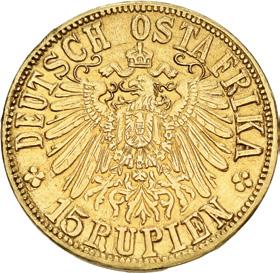
877. COLONIAL AFRICA, German. German East Africa. Wilhelm II. 1888-1918. AV 15 Rupien (22mm, 7.29 g, 12h). Tabora mint. Dated 1916 T. Elephant advancing slightly right / Crowned eagle facing with wings spread, head left; coatof-arms on breast. Jaeger 728b; KM 16.1; Friedberg 1. In NGC encapsulation 6906596-006, graded AU 58. ($2000)
From the Drewry Family Collection. Ex World-Wide Coins of California (James F. Elmen) VII (2 February 1985), lot 272.
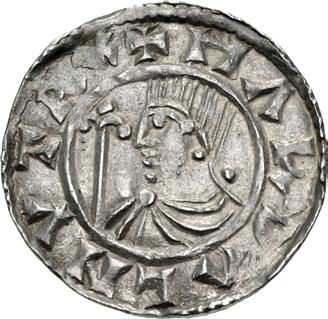

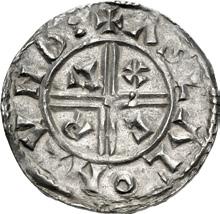

878. DENMARK. Hardeknud (Knud III, the Hardy). 1035-1042. AR Penny (18mm, 1.09 g, 6h). Crux type. Lund mint; Aslac, moneyer. Struck circa 1040-1042. ม H©ʽዝ©ün⎍Ϳ ʽᛸ , Draped bust left; trefoil-tipped scepter to left / ม ©S⌦©ü ɭn ⌦⎍nዝ Ḧ , voided short cross; ü – ʼ – ⎍ – ҟ in quarters. Becker, Coinages, dies H1/52; Becker Collection 23 (same dies); Hauberg 7; Hede –. Light golden toning, small peck on reverse. Choice EF. A superb example with lustrous surfaces. The most elegant and refined dies for all of Harthacnut’s Danish coinage. Very rare. ($3000)
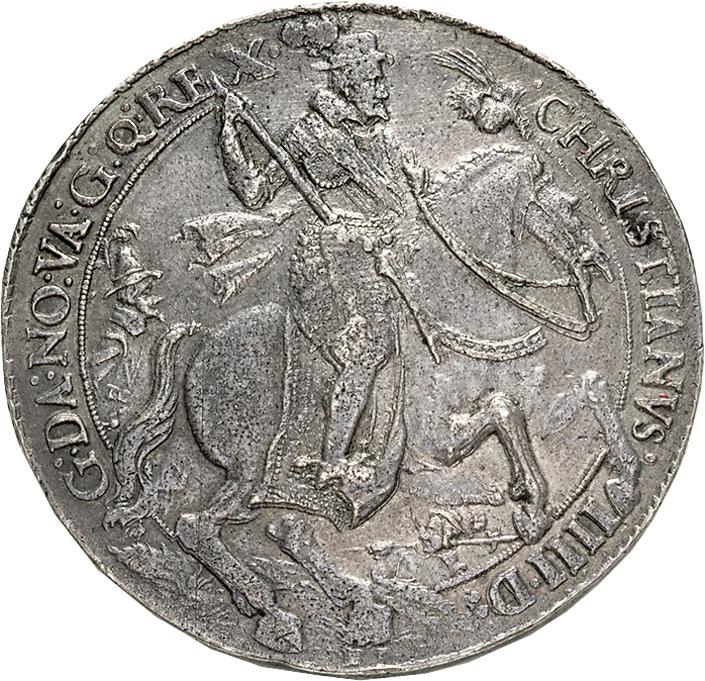

879. DENMARK. Christian IV. 1588-1648. AR Breddalere – 2 Speciedaler (57mm, 58.55 g, 12h). Helsingør (Elsinore) mint. Struck 1607-1614. Christian on horseback right, holding reins and baton; figure in background to left; below, forepart of soldier left, holding pike over shoulder / Crowned coat-of-arms with wildmen supporters. Schou 20; Hede 63D; Davenport 529; KM 147. Toned, rough and porous, hairlines, scratches, edge slightly filed, chased. Good VF. ($3000)
From the Alexander Christopher Collection.


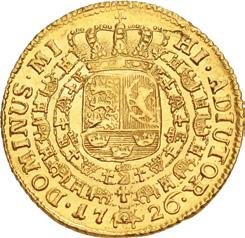

880. DENMARK. Frederik IV. 1699-1730. AV Ducat (20mm, 3.47 g, 12h). København (Copenhagen) mint. Dated 1726. Armored and draped bust right / Crowned and collared coat-of-arms. Schou 1; Hede 16B; KM; Friedberg 224. In NGC encapsulation 6931384-007, graded AU 58. Very rare. Only three in CoinArchives. Top Pop ($3000)
From the Drewry Family Collection. Ex El Dorado (14 July 1984), lot 19.


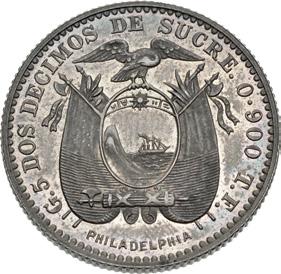

881. ECUADOR, Republic. 1830-pres. AR 2 Decimos (23mm, 5.01 g, 12h). Philadelphia mint. Dated 1895 TF. Head of Antonio José de Sucre left / Eagle standing right, wings spread, atop coat-of-arms sent on fasces; flags behind. KM 51.4. Deep iridescent toning. In NGC encapsulation 6928251-001, graded PF 63. Top Pop ($1000)
From the Alexander Christopher Collection.
882. EGYPT, Ottomans. Isma’il. As khedive, AH 1284-1296 / AD 1867-1879. AV 500 Qirsh – Beşyüz kuruşluk (37mm, 42.60 g, 12h). Misr (Cairo) mint. Dually dated AH 1277 and RY 11 of Abd al-’Aziz (AD 1872). Toughra of Abd al-’Aziz; floral spray to right; 500 sh in Arabic (value) below / zarb/fi/misr in Arabic in three lines; AH date below; RY above be of zarb Damalı 32-MS-A1-11; Sultan –; Pere –; KM 265 corr. (date); Friedberg 16. In NGC encapsulation 6929996-003, graded AU 58. Rare. A mintage of 200 specimens recorded. ($7500)
From the Collection of an Alexandrine Numismatist, formed before 1955.
Isma’il Pasha was the Khedive or viceroy of Egypt beginning in 1867. He proceeded to heavily invest in Egypt’s infrastructure, including the Suez Canal, and other internal reforms and improvements. Combined with the crippling costs of an unsuccessful war with Ethiopia, Egypt became insolvent and the financial situation became dire enough that Great Britain and France decided to depose Isma’il Pasha in 1879.
883. EGYPT, Ottomans. Isma’il. As khedive, AH 1284-1296 / AD 1867-1879. AV 500 Qirsh – Beşyüz kuruşluk (37mm, 42.59 g, 12h). Misr (Cairo) mint. Dually dated AH 1277 and RY 15 of Abd al-’Aziz (AD 1876). Toughra of Abd al-’Aziz; floral spray to right; 500 sh in Arabic (value) below / zarb/fi/misr in Arabic in three lines; AH date below; RY above be of zarb. Damalı 32-MS-A1-15; Sultan –; Pere –; KM 265 corr. (date); Friedberg 16. In NGC encapsulation 6929996-004, graded MS 62. Extremely rare. A mintage of only 56 specimens recorded. ($10,000)
From the Collection of an Alexandrine Numismatist, formed before 1955.
884. EGYPT, Ottomans. Isma’il. As khedive, AH 1284-1296 / AD 1867-1879. AV 500 Qirsh – Beşyüz kuruşluk (37mm, 42.45 g, 12h). Misr (Cairo) mint. Dually dated AH 1293 and RY 1 of Abdul Hamid II (AD 1876). Toughra of Abdul Hamid II; floral spray to right; 500 sh in Arabic (value) below / zarb/fi/misr in Arabic in three lines; AH date below; RY above be of zarb. Damalı 34-MS-A1-1; Sultan –; Pere 973; KM 286; Friedberg 17. In NGC encapsulation 6929996-005, graded AU 58. Extremely rare. ($6000)
From the Collection of an Alexandrine Numismatist, formed before 1955.
885. EGYPT, Ottomans. Isma’il. As khedive, AH 1284-1296 / AD 1867-1879. AV 500 Qirsh – Beşyüz kuruşluk (37mm, 42.35 g, 12h). Misr (Cairo) mint. Dually dated AH 1293 and RY 6 of Abdul Hamid II (AD 1882). Toughra of Abdul Hamid II; floral spray to right; 500 sh in Arabic (value) below / zarb/fi/misr in Arabic in three lines; AH date below; RY above be of zarb Damalı 34-MS-A1-6; Sultan –; Pere –; KM 286; Friedberg 17. In NGC encapsulation 6929996-005, graded AU DETAILS, edge damage. Extremely rare. A mintage of only 5 to 10 specimens recorded. ($5000)
From the Collection of an Alexandrine Numismatist, formed before 1955.










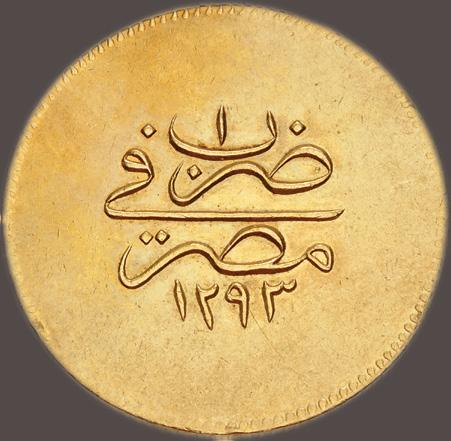




886. EGYPT, Kingdom. Faruq. AH 1355-1371 / AD 1936-1952. Proof AV 500 Piastres (37mm, 42.50 g, 12h). Royal Wedding issue. The Royal Mint. Dually dated 1938 (in Eastern Arabic numerals) and AH 1357 (but struck 1939). Uniformed bust facing, head left; PM at base of bust / Denomination and dates within ornate floral border. KM 373; Friedberg 35. In NGC encapsulation 6929996-001, graded PF 62. ($3000)
From the Collection of an Alexandrine Numismatist, formed before 1955.


887. FRANCE, Royal. Jean II le Bon (the Good). 1350-1364. AV Franc à cheval (29mm, 3.85 g, 4h). Authorized 5 December 1360. Jean, crowned and in full armor, left on caparisoned horse, holding sword / Cross tréflée and feuillue; at center, pellet within quadrilobe; all within quadrilobe, trefoil fleurée at end of each arc; trilobe in spandrels. Duplessy 294; Ciani 361; Friedberg 279. In NGC encapsulation 6865696-041, graded MS 63. ($2000)



888. FRANCE, Royal. Jean II le Bon (the Good). 1350-1364. AV Franc à cheval (29mm, 3.65 g, 7h). Authorized 5 December 1360. Jean, crowned and in full armor, left on caparisoned horse, holding sword / Cross tréflée and feuillue; at center, pellet within quadrilobe; all within quadrilobe, trefoil fleurée at end of each arc; trilobe in spandrels. Duplessy 294; Ciani 361; Friedberg 279. EF. ($1500)
Ex Karl Stephens FPL 148 (October 2004), no. 148.



889. FRANCE, Royal. Jean II le Bon (the Good). 1350-1364. AV Florin d’or (21mm, 3.48 g, 2h). Montpellier mint; mm: helmet. Authorized 21 February 1360. Ornate lily of Florence / St. John the Baptist standing facing, holding long cross and raising hand in benediction. Scarfea, Imitazione 706; Duplessy 346; Ciani 362; Friedberg 282. In NGC encapsulation 6865696-048, graded AU 58. ($750)



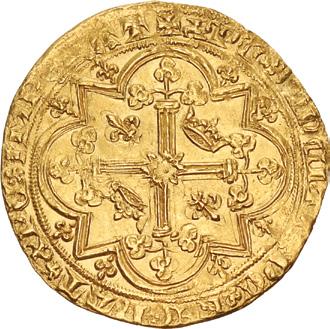
890. FRANCE, Royal. Charles V le Sage (the Wise). 1364-1380. AV Franc à pied (28mm, 3.81 g, 4h). Authorized 20 April 1365. King standing facing within Gothic arch; semé of seven lis to left and right, holding sword and main de Justice / Cross tréflée; in center of cross, pellet within angled quadrilobe; lis in first and fourth quarters, crown in second and third; all within angled quadrilobe; lis in spandrels. Duplessy 360; Ciani 457; Friedberg 284. In NGC encapsulation 6532187-045, graded MS 64. ($1500)
891. FRANCE, Royal. Charles V le Sage (the Wise). 1364-1380. AV Franc à pied (28mm, 3.82 g, 7h). Authorized 20 April 1365. King standing facing within Gothic arch; semée of seven lis to left and right, holding sword with annulet pommel, and main de Justice / Cross tréflée; in center of cross, pellet within angled quadrilobe; lis in first and fourth quarters, crown in second and third; all within angled quadrilobe; lis in spandrels. Duplessy 360A; cf. Ciani 458-60; Friedberg 284. In NGC encapsulation 6532187-038, graded MS 63. ($1000)



892. FRANCE, Royal. Louis XV le Bien-Aimé (the Well-Beloved). 1715–1774. AV Louis d’or à la croix (24mm, 9.78 g, 12h). Lyon mint; différents: eagle’s head/flame. Dated 1718 D. Laureate head right / Coat-of-arms on the Order of SaintEsprit. VG 336; Duplessy 1633; KM 438.6; Friedberg 453. In NGC encapsulation 6906700-002, graded MS 62. Free from the haymarking usually seen on this two-year type. ($1500)
From the Drewry Family Collection. Ex World-Wide Coins of California (James F. Elmen) XXVI (17 November 1994), lot 17.



893. FRANCE, Royal. Louis XV le Bien-Aimé (the Well-Beloved). 1715–1774. AV Louis d’or au bandeau (24mm, 8.16 g, 6h). Paris mint; différent: fox. Dated 1756/5 A. Head left, hair tied in bandeau / Crown over two coats-of-arms. VG 341; Duplessy 1643; KM 513.1 (overdate not noted); Friedberg 464. In NGC encapsulation 6916566-003, graded MS 66. Top Pop ($2000)


894. FRANCE, Royal. Louis XVI. 1774–1793. AR Écu – 6 Livres (38mm, 29.57 g, 7h). Constitutional issue. Paris mint; différents: leopard/lyre. Dated L’An 4 and 1792 A. Head left, hair tied in ribbon / Winged genius of France standing right, inscribing tablet set on column; to left, fasces surmounted by cap; to right, rooster standing left. VG 55; Duplessy 1718; Ciani 2238; KM 615.1. Full frosty luster. In NGC encapsulation 6906700-010, graded MS 63. ($1000)
From the Alexander Christopher Collection.


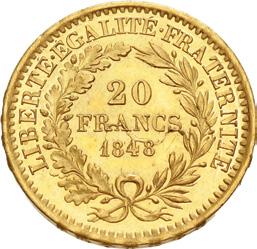
895. FRANCE, Second Republic. 1848-1852. AV Essai de 20 Francs (21mm, 6.44 g, 6h). Paris mint. By Tournier. Dated 1848. REPUBLIQUE FRANÇAISE, head of Marianne right, wearing wreath of laurel, oak, and grain ears / LIBERTÉ · EGALITÉ · FRATERNITÉ, 20/ FRANCS/ 1848 within wreath. Edge: in relief, DIEU PROTÈGE LA FRANCE. Mazzard 1263; KM –. In NGC encapsulation 6924486-005, graded MS 64+. ($3000)
From the Alexander Christopher Collection.
With the foundation of the second Republic in 1848 came a need for new, Republican currency. The government invited a number of artists to submit designs for the new coinage. Numerous patterns were struck with types displaying a number of skilled portraits, making this an exciting area for the modern collector to explore.
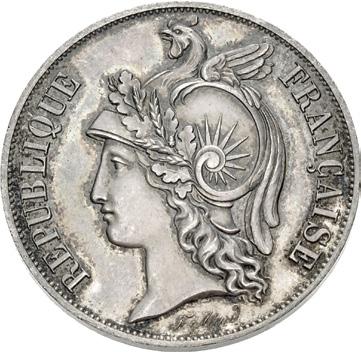


896. FRANCE, Second Republic. 1848-1852. AR Essai de 10 Centimes (31mm, 10.01 g, 5h). Paris mint. By Alard. Dated 1848. REPUBLIQUE FRANÇAISE, head of Marianne left, wearing rooster-crested helmet and wreath of laurel, oak, and grain ears / LIBERTÉ EGALITÉ FRATERNITÉ, 10/ CENTIMES/ 1848 within wreath. Edge: plain. Mazzard 1302b; KM –. Richly toned. In NGC encapsulation 6924486-006, graded MS 64. Top Pop. ($500)
From the Alexander Christopher Collection.


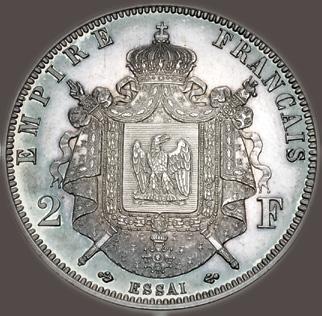

897. FRANCE, Second Empire. Napoléon III. 1852-1870. Proof AR Essai de 2 Francs (25mm, 10.06 g, 6h). Paris mint. Dies by Barré. Struck 1860. NAPOLEON EMPEREUR, bare head left; below, ESSAI between two anchors / EMPIRE FRANCAIS, Crowned, collared, and mantled coat-of-arms over crossed scepters; below, ESSAI between two anchors. Mazzard 1654; KM –. Deep iridescent cabinet toning. In NGC encapsulation 6916539-002, graded PF 63. Extremely rare –only one specimen in CoinArchives. Top Pop ($10,000)
From the Alexander Christopher Collection.
Elected by a popular vote in 1848, Napoléon III who was the nephew and heir of Napoléon I, initiated a coup d’état three years later, eventually proclaiming himself as the Emperor of the French. During his reign, he attempted to restore France’s position as a world power following the limitations imposed from the Napoleonic Wars. Tensions with the neighboring German states led to war after a Hohenzollern candidature for the vacant Spanish throne. This ensuing conflict exposed Napoléon’s poor tactical skills, and he was captured at the Battle of Sedan in 1870. Two days later, he and his government were deposed, replaced by the newly-formed Third Republic. The German states’ successes in the war led to the birth of the German Empire and a foreshadowing of future regional conflicts.



898. FRANCE, Second Empire. Napoléon III. 1852-1870. Proof AR Essai de Franc (22mm, 5.01 g, 6h). Paris mint.
Dies by Barré. Dated 1861 E. NAPOLEON III EMPEREUR, laureate head left; E below / EMPIRE FRANÇAIS, Crowned, collared, and mantled coat-of-arms over crossed scepters; 1 1 flanking; below, 850 M 1861 (two anchors). Mazzard 1670a; KM –. Deep cabinet toning. In NGC encapsulation 6916539-001, graded PF 64. Top Pop. ($1500)
From the Alexander Christopher Collection.


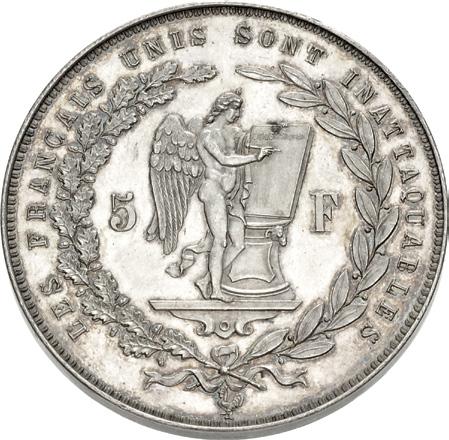
899. FRANCE, Third Republic. 1870-1940. AR Essai de 5 Francs (38mm, 26.22 g, 6h). Struck 1870s. REPUBLIQUE FRANÇAISE, bust of Léon Gambetta facing slightly left; below, triangle, clasped hands, and rooster / LES FRANÇAIS UNIS SONT INATTAQUABLES, winged genius of France standing right, inscribing tablet set on column; 5 F flanking; all within wreath of oak and laurel; rooster below. Mazzard 2337; KM –. Toned. In NGC encapsulation 6924486-011, graded MS 63. ($750)
From the Alexander Christopher Collection.
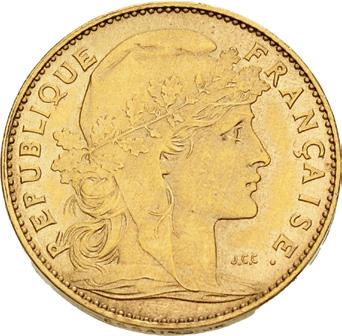
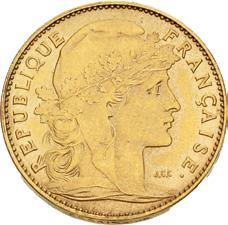


900. FRANCE, Third Republic. 1870-1940. Matte Proof AV Essai de 10 Francs Piefort (19mm, 6.44 g, 6h). Paris mint. By J.C. Chaplain. Dated 1899. REPUBLIQUE FRANÇAISE, head of Marianne right, wearing Liberty cap and oak wreath / LIBERTÉ · EGALITÉ · FRATERNITÉ, rooster standing left; 10 FCS across field; 1899 in exergue. Mazzard 2117; KM Pn100. In NGC encapsulation 6924486-012, graded PF 64. ($2000)
From the Alexander Christopher Collection.

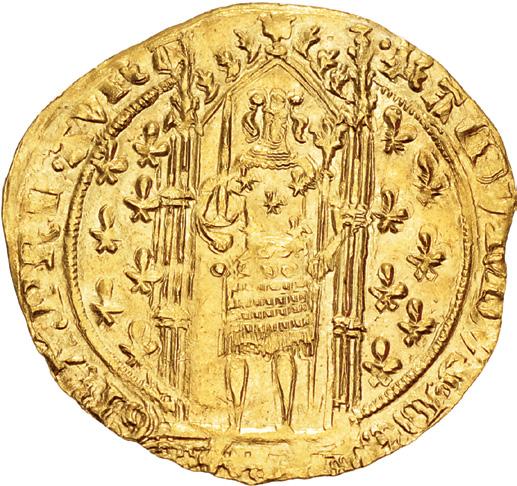

901. FRANCE, Provincial. Orange (Principality). Raymond V. 1340-1393. AV Franc à pied (28mm, 3.65 g, 8h). Raymond standing facing within Gothic arch; semé of seven lis to left and right, holding sword and lis-tipped scepter / Cross tréflée; in center of cross, pellet within angled quadrilobe; lis in first and fourth quarters, crown in second and third; all within angled quadrilobe; lis in spandrels. Duplessey, Féodales 2078; Friedberg 190. Lustrous. EF. ($1000)
Ex Karl Stephens FPL 125 (October 2000), no. 254.



902. GERMANY, Eichstätt (Bishophric). Sede Vacante. 1790. AR Doppeltaler (53mm, 56.04 g, 12h). Dated 1790 W. Empty throne on pedestal below baldachin in throne room; above, patron saints Willibald and Walburgis in clouds below streaming eye of God / Oak tree with shields on branches, each inscribed with the name of a member of the college of canons of Eichstätt, before city scene. Cahn 148; KM 90; Davenport 2212. Toned. In NGC encapsulation 6928245-001, graded MS 65. ($3000)
From the Alexander Christopher Collection.


903. GERMANY, Hamburg (Free & Hanseatic City). AV Dukat (22mm, 10h). Dated 1494. Half-length figure of Madonna right, holding infant Christ, over coat-of-arms; all within mandorla / Madonna standing right, holding infant Christ; all within mandorla. Levinson I-362a; Gaedechens 85; Friedberg –. In PCGS encapsulation 83400009, graded MS 62. ($1000)
From the Robert Levinson Collection.


904. GERMANY, Kirchberg (County) & Weißenborn (Lordship). Kajetan Josef Fugger von Zinnenberg-Adlshofen & Johann Karl Alexander Fugger von Wörth-Nordendorf. 1720-1791 & 1706-1784. AR Taler (41mm, 12h). In the name of Josef II, Holy Roman Emperor. München (Munich) mint. Dated 1781. Coat-of-arms surmounted by two ornately crested helmets / Crowned double-headed eagle facing with wings spread, holding sword and scepter; globus cruciger on breast. Davenport 2252; KM 1. Toned. In NGC encapsulation 173916-008, graded MS 65. Top Pop ($3000)
From the Alexander Christopher Collection.
The Fugger family began their rise to prominence as successful weavers in Augsburg. After several generations, the family developed into a powerful force in the world of banking and trading. Around 1473, the Fuggers began a long and profitable relationship with the Habsburg dynasty by serving as financiers for the royal family’s political and military ventures. In 1530, in recognition of their rise as a noble family, they received titles to the towns of Kirchberg and Weißenborn. They were later given the right to mint their own coinage.


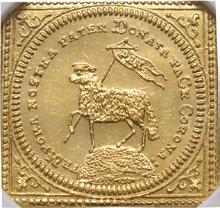

905. GERMANY, Nürnberg (city). AV Dukat Klippe (18x18mm, 12h). Dated 1700 (in chronogram), though a 17551764 restrike. Three coats-of-arms surmounted by eagle standing left with wings spread, head right / Agnus dei advancing left, holding banner. Kellner 74; KM 258; Friedberg 1886. In NGC encapsulation 6648582-006, graded MS 64. ($5000)



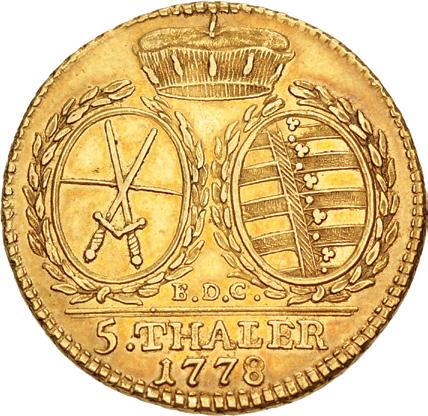
906. GERMANY, Sachsen (Duchy & Electorate). Friedrich August III. Elector, 1763-1806. AV August d’or – 5 Taler (23mm, 6.64 g, 12h). Dresden mint. Dated 1778 EDC. Head right / Two wreathed coats-of-arms; elector’s cap above. Kahnt 1038 var. (mintmark); KM –; Friedberg 2876. In NGC encapsulation 6931384-008, graded AU 58. Extremely rare. Only one example of this date in CoinArchives. Top Pop, with none other graded at either NGC or PCGS. ($4000)
From the Drewry Family Collection. Ex Harmer & Rooke (7 June 1989), lot 122.

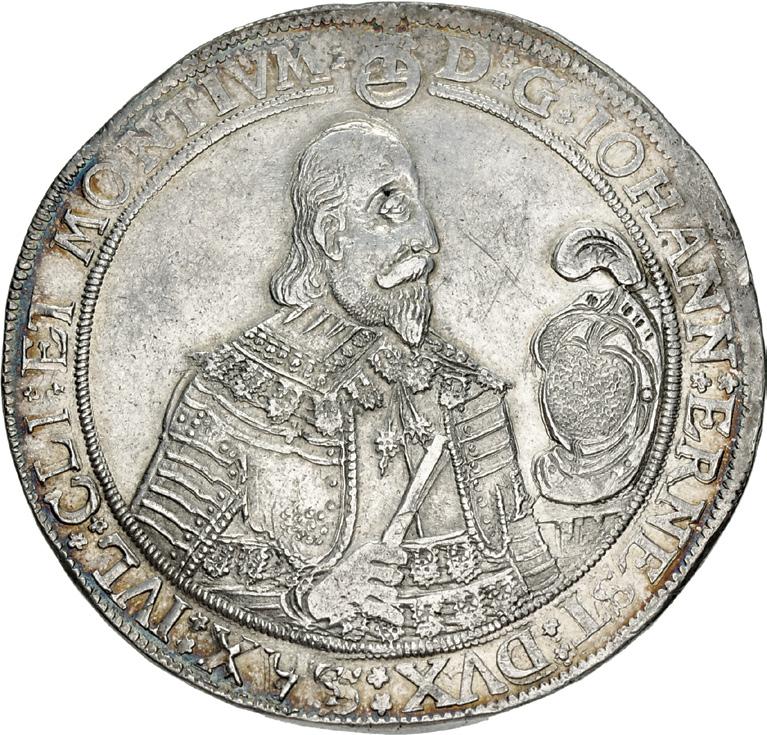

907. GERMANY, Sachsen-Coburg-Eisenach (Duchy). Johann Ernst I. 1633-1638. AR Taler (41mm, 29.09 g, 5h). Coburg mint. Dated 1636 EFS. Armored bust right, wearing ruff, holding baton and plumed helmet / Coat-of-arms surmounted by six ornately crested helmets. KOR 338.1; Davenport 7437 (Saxe-Gotha); KM 169 (Saxe-Old-Gotha). In PCGS encapsulation 49713783, graded AU Details, cleaned. ($1000)
From the Alexander Christopher Collection.



908. GERMANY, Schlesien-Liegnitz-Brieg (Duchy). Georg Wilhelm. 1672-1675. AR 1¼ Taler (53mm, 33.86 g, 12h). On his death. Brieg (Brzeg) mint. Dated 21 November 1675. Armored and draped bust facing slightly right / Biographical legend in 16 lines. Davenport 488; KM 536. Toned. In NGC encapsulation 6898663-001, graded MS 62. Rare. ($5000)
From the Alexander Christopher Collection.


909. GERMANY, Schwarzenberg (Principality). Johann Adolf. 1646-1683. AR Taler (44mm, 29.00 g, 12h). Wien (Vienna) mint. Dated 1682. Armored and draped bust right / Collared coat-of-arms surmounted by elector’s cap. Davenport 7699; KM 5. Toned. In NGC encapsulation 2156453-001, graded MS 63. Rare. ($3000)
From the Alexander Christopher Collection.



910. GERMANY, Württemberg-Öls (Duchy). Silvius Friedrich. 1664-1697. AR Taler (46mm, 28.33 g, 12h). Öls mint. Dated 1674 SP. Armored and draped bust right / Coat-of-arms surmounted by four ornately crested helmets. Davenport 7887; KM 11. Toned. In NGC encapsulation 2156453-002, graded AU 58. ($6000)
From the Alexander Christopher Collection.




911. GERMANY, German Empire. General issues. AR Mark (23mm, 5.51 g, 12h). Stuttgart mint. Dated 1905 F Crowned eagle facing with head left, wings spread; collared coat-of-arms on breast / Denomination and date within wreath. Jaeger 17; KM 14. In NGC encapsulation 6931384-010, graded UNC Details, removed from jewelry. Extremely rare. A key date for the modern German series. Only a handful struck. ($7500)
From the Alexander Christopher Collection.



912. GERMANY, Saarland Protectorate. 1947-1956. Essai AV 100 Franken (24mm, 11.39 g, 6h). Paris mint; différents: cornucopia and wing. Dated 1955. Coat of arms over stylized gear / Denomination. Jaeger 804; Friedberg –; KM E7. In NGC encapsulation 6924407-008, graded MS 67+. Top Pop ($3000)
From the Alexander Christopher Collection.




913. GREECE, First Hellenic Republic. Ioannis Antonios Kapodistrias. Governor, 1828-1831. Pattern CU 10 Lepta (34mm, 15.81 g, 6h). Aegina mint. Dated 1828. ΕΛΛΗΝΙΚΗ
phoenix rising from flames, head upturned to left, with wings spread; rays to upper left, long cross above
1828 ·, 10/ ΛEΠTA within wreath of palm frond and oak branch. Chase 161b-A.a; Divo –; Karamitsos –; KM Pn4. In NGC encapsulation 6917299-002, graded MS 64 BN. Extremely rare variety with five-pointed stars in legend. Top Pop ($15,000)
From the Alexander Christopher Collection.
This coin, bearing five-pointed stars on the obverse rather than the usual six, is considered to be an extremely rare pattern, struck for presentation to Kapodistrias and the National Assembly for their approval. It is so rare as to be termed “uncollectable” by Chase.



914. GUATEMALA, Republic. 1839-pres. AR Quetzal (39mm, 33.30 g, 6h). Philadelphia mint. Dated 1925. Scroll surmounted by quetzal left over rifles crossed in saltire; all within wreath / Column surmounted by quetzal left. Stickney 261; KM 242. Toned. In NGC encapsulation 6906596-015, graded MS 61. ($3000)
From the Alexander Christopher Collection.


915. HUNGARY, Holy Roman Empire. Lipót I. 1657-1705. AR Taler (43mm, 28.08 g, 12h). Körmöcbánya (Kremnitz) mint. Dated 1661 KB. Laureate, draped, and armored bust right; coat-of-arms to left, Madonna holding infant Christ in clouds to right / Crowned double-headed eagle facing with wings spread, holding sword and scepter, crowned and collared coat-ofarms on breast. Huszár 1367; Davenport 3255; KM 170.1. Deeply toned, hairlines, spot of discoloration. EF. ($750)
From the Alexander Christopher Collection.




916. INDIA, Medieval (Southern Deccan). Chalukyas of Kalyana. Uncertain ruler. Circa 973-1068 or later. AV Pagoda (14.5mm, 3.99 g, 6h). Boar/Temple type. Caparisoned boar standing left within ornate frame / Elaborately decorated temple entrance. Cf. Mitchiner, South I, 267 (Jayashima II; for type, but uninscribed); Adams –; Album 32, lot 1757. Lightly toned, hint of deposits, struck with rusty dies, hint of clipping. Good VF. Extremely rare type with the boar left. ($2500)


917. INDIA, Islamic Sultanates. Malwa. ‘Ala al-din Mahmud I. AH 839-873 / AD 1436-1469. AV Tanka (29.5mm, 11.07 g, 9h). Hadrat Shadiabad mint. Dated AH 841 (AD 1438/9). al-sultan al-‘zam legend / sikandar al-thani legend. CIS M21; Rajgor Type 3064. In NGC encapsulation 6922485-013, graded MS 63. ($1500)

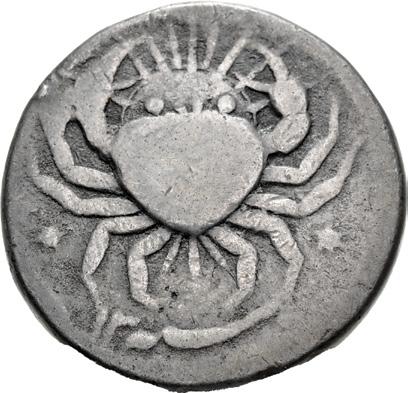

918. INDIA, Mughal Empire. Nur al-Din Muhammad Jahangir. AH 1014-1037 / AD 1605-1627. AR Rupee (18mm, 10.63 g, 11h). Zodiac Type (month of Tir), Class A. Ahmadabad mint. Dually dated AH 1027 and RY 13 (22 June-23 July AD 1618). Constellation of Karkata/Kalakang (Cancer the Crab): crab, seen from above; radiate sun behind; stars flanking lower legs; sanat 13 (regnal year 13) in Persian in exergue / dar Ahmadabad ra dad zewar Jahangir Shah Akbar Shah (at Ahmadabad received as ornament from Jahangir Shah [son of] Akbar Shah) in Persian; AH date in exergue. Liddle Type S-184; BM 370-1; IMC (Wright) 633; Hull 1475; SACPM (KM) 150.10. In NGC encapsulation 6929824-005, graded Fine Details, edge filing. A rare and popular type. ($2000)
From the Alexander Christopher Collection.
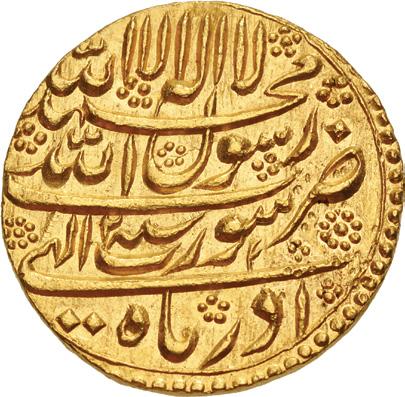



919. INDIA, Mughal Empire. Shihab al-Din Muhammad Shah Jahan. AH 1037-1068 / AD 1627-1658. AV Mohur (24mm, 10.94 g, 1h). Surat mint. Dated Azar Ilahi year 2 (23 November-21 December AD 1628). Kalima, mint formula, Ilahi month and year, and mint formula / Couplet citing Shah Jahan. M.K. Hussain, “Gold Coins of Shahjahan from River Bordi,” JNSI Vol. 1, Part II (December 1977), 3; Wright –; Hull –; KM 255.6; CNG 91, lot 1302 (same dies). In NGC encapsulation 6931384-004, graded MS 63. ($2000)
From the Drewry Family Collection, purchased from William B. Warden, Jr., 1992.


920. INDIA, Independent States. Mysore. Tipu Sultan. AH 1197-1202 / AD 1787-1799. AR Haidari – Double Rupee (35mm, 22.80 g, 12h). Patan (Seringapatan) mint. Triply dated RY 8, cyclic year 38, and AH 1198 (AD 1788). Couplet citing the religion of Ahmad being illumined by the victory of Haidar; mint formula, cyclical date and AH date below / Couplet citing titles of Tipu Sultan; RY year below. Henderson 41; Moin Type 1; KM 127. In NGC encapsulation 6929824-004, graded AU 55. ($2000)
From the Alexander Christopher Collection.
Tipu succeeded his father Haidar Ali in 1782, and in 1784 concluded a peace treaty with the British, on unusually favorable terms. Tipu had been one of the very few Indian commanders to defeat a British army in the field, but he realized he needed more time to build up his army. In the same year he declared himself Sultan, ending the pretense of supporting the figurehead Wodeyar monarch. Tipu was only buying time until he felt himself strong enough to confront the British, and in 1789 he broke the peace by invading Travancore. The Mysore armies once again proved no match for European troops, and Lord Cornwallis defeated Tipu at Seringapatam in 1792, forcing Tipu to cede half his kingdom. Hostilities commenced again in 1799, with the British bringing more troops fresh from the Egyptian campaign, and Tipu was killed at the second battle of Seringapatam May 4 1799. Despite his eventual defeat, Tipu offered the strongest native opposition to British expansion in India.




921. INDIA, Princely States. Kishangarh. Yaghyanarayan Sing. 1926-1938. AV Mohur (18mm, 10.94 g, 11h). Citing George V King of the United Kingdom and Emperor of India, 1911-1936. qaiser-e-hind King George V in Persian / Maharaja Yaghyanarayan Singh Bahadur in Persian and Jhar. SACPM (Y) 8. In NGC encapsulation 6929824-003, graded MS 61. ($750)



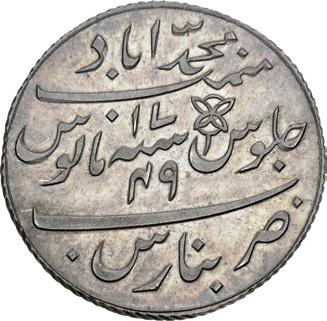


922. INDIA, Colonial. British India. Bengal Presidency. 1651-1835. Proof AR Rupee Pattern denomination set. Benares mint. Dually dated AH 1229 and RY 17/49 (Struck 1815). All coins: Persian couplet citing Shah ‘Alam II; fish (with barbels) and sun symbols, no differentiating marks / Mint and RY date formula; flower symbol. Edge: \\\\\. Includes the following:
1) Proof AR Rupee Pattern (27mm, 11.34 g, 12h). CEEIC 7.142; Pridmore 291; KM –. In NGC encapsulation 6928251-013, graded PF 65.
2) Unfinished Proof AR Half Rupee Pattern (21.5mm, 5.67 g, 12h). CEEIC 7.143; Pridmore 292; KM –. In NGC encapsulation 6928251-014, graded PF 64.
3) Unfinished Proof AR Quarter Rupee Pattern (21.5mm, 2.83 g, 12h). CEEIC 7.144; Pridmore 293; KM –. In NGC encapsulation 6928251-015, graded PF 65.
All NGC graded. ($4000)
From the Drewry Family Collection. Ex Stack’s (22 October 1985), lot 1650.
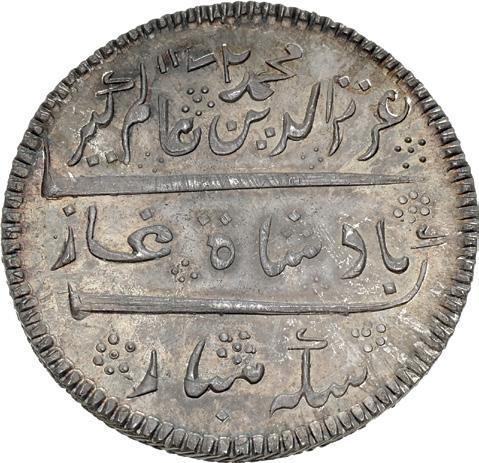


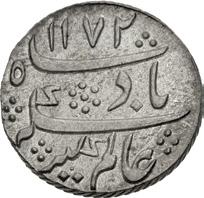


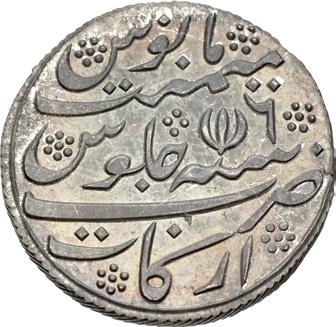
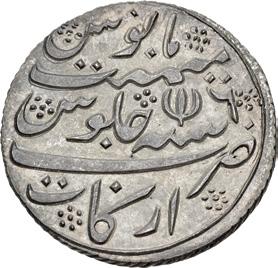


923. INDIA, Colonial. British India. Madras Presidency. AR Milled Rupee specimen denomination set. Mughal type. In the name of ‘Alamgir II (AH 1167-1173 / AD 1754-1759). Madras mint. Dually dated AH 1172 and RY 6 (Struck 1807). All coins: Persian couplet citing Alamgir II; AH date above / Mint and RY date formula; lotus symbol. Edge: /////. Includes the following:
1) AR Double Rupee (40mm, 24.04 g, 12h). CEEIC 3.338; Pridmore 245; KM 404.2. In NGC encapsulation 6898664-001, graded MS 64. Overstruck on a Spanish Colonial 8 Reales. Top Pop
2) AR Rupee (26mm, 12.08 g, 11h). CEEIC 3.344; Pridmore 247; KM 403. In NGC encapsulation 6898664-002, graded MS 65. Top Pop.
3) AR Half Rupee (22mm, 5.99 g, 11h). CEEIC 3.348; Pridmore 248; KM 401. In NGC encapsulation 6898664-003, graded MS 64. Top Pop.
4) AR Quarter Rupee (17mm, 3.03 g, 12h). CEEIC 3.350; Pridmore 249; KM 400. In NGC encapsulation 6898664-004, graded MS 65. Top Pop
5) AR Eighth Rupee (16mm, 1.47 g, 12h). CEEIC 3.351; Pridmore 250; KM 408. In NGC encapsulation 6898664-005, graded MS 64. Top Pop
All NGC graded and Top Pop. ($10,000)
From the Alexander Christopher Collection. Ex Fred Pridmore Collection (Part II, Glendining, 18 October 1982), lot 410.



924. INDIA, Colonial. British India. Madras Presidency. 1653-1835. AR Half Pagoda (36.5mm, 21.27 g, 12h). Second issue. Madras mint. Struck 1808-1812. Gōpuram (temple porch or entrance) set on ground; nine stars to left, nine to right; all within buckled garter inscribed HALF PAGODA and nim hun phuli (half a flower, or star, pagoda) in Persian / Vishnu, holding sword in hand, standing facing, rising from lotus; floral and pellet design to left and right; all surrounded by triple-pelleted border; star above; all within swallowtail banner inscribed arai pu vara kun in Tamil and ara pu vara hun (half a flower, or star, pagoda) in Telegu; no stop in legend. CEEIC 3.124 (dies J/VIII); Pridmore 171A; KM 353. In NGC encapsulation 6924407011, graded AU 53. ($1000)
From the Alexander Christopher Collection.

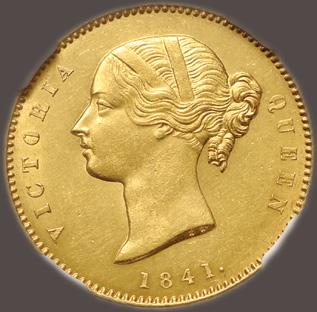


925. INDIA, Colonial. British India. Victoria. Queen of the United Kingdom of Great Britain and Ireland, 18371901. AV Mohur (25mm, 12h). East India Company Type II, Variety 1 issue. Calcutta mint. Dated 1841 (but struck 1850/1).
VICTORIA QUEEN, young head left; date below, no serif on crossbar of 4; incuse W. W. on truncation of neck / EAST INDIA COMPANY, lion advancing left; palm tree behind; in exergue, ONE MOHUR above, yek ashrafi (= one ashrafi) in Persian. UCI 3.7; Pridmore 22; Friedberg 1595a. In NGC encapsulation 4863667-080, graded MS 62. ($15,000)



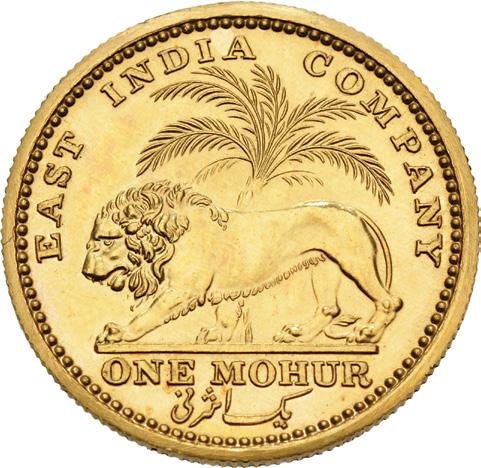
926. INDIA, Colonial. British India. Victoria. Queen of the United Kingdom of Great Britain and Ireland, 1837-1901. Restrike Proof AV Mohur (25mm, 11.66 g, 12h). East India Company Type II, Variety 1 issue. Calcutta mint. Dated 1841 (but struck 1850/1). VICTORIA QUEEN, young head left; date below, no serif on crossbar of 4; incuse W. W. on truncation of neck / EAST INDIA COMPANY, lion advancing left; palm tree behind; in exergue, ONE MOHUR above, yek ashrafi (= one ashrafi) in Persian. UCI 3.8; Pridmore 23; Friedberg 1595b. In NGC encapsulation 6903643-014, graded PF 63. ($7500)
From the Samuel K. Clark Collection.



927. INDIA, Colonial. British India. Victoria. Queen of the United Kingdom and Ireland, 1837-1901. AV Mohur (25mm, 12h). Calcutta mint. Dated 1862. VICTORIA QUEEN, crowned younger bust left; no V at truncation of bust / ONE/MOHUR/–/INDIA/1862 in five lines; all within ornate floral border. UIC 4.1; Pridmore 1; Friedberg 1598. In NGC encapsulation 2007973-011, graded MS 61. ($3000)



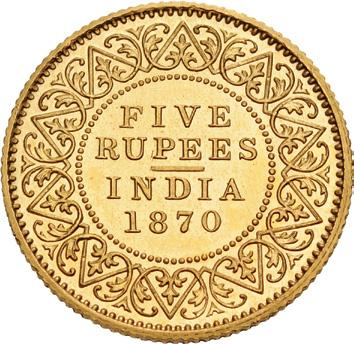
928. INDIA, Colonial. British India. Victoria. Queen of the United Kingdom, 1837-1901. AV Restrike Proof 5 Rupees (20mm, 3.90 g, 12h). Calcutta mint. Dated 1870. VICTORIA QUEEN, crowned young bust left; C.M on truncation of bust / FIVE/RUPEES/–/INDIA/1870 in five lines; all within ornate floral border. UIC 4.23; Pridmore 40; Friedberg 1600a. In NGC encapsulation 6931384-011, graded PF 62. ($2500)
From the Drewry Family Collection. Ex Edmonton Sale (Bowers and Merena, 19 March 1993), lot 2518.
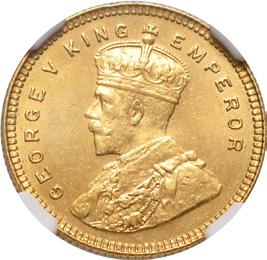


929. INDIA, Colonial. British India. George V. King of the United Kingdom and Emperor of India, 1910-1936. AV 15 Rupees (22mm, 12h). Bombay mint. Dated 1918. GEORGE V KING EMPEROR, crowned bust left / 15/RUPEES/–/ INDIA/1918 in five lines; all within ornate floral border. UIC 8.1; Pridmore 25; Friedberg 1608. In NGC encapsulation 4861262-054, graded MS 63. ($3000)




930. INDIA, Colonial. British India. George VI. King of the United Kingdom, 1936-1952 and Emperor of India, 19361947. Proof AR Rupee Restrike (31mm, 11.65 g, 12h). Calcutta mint. Dated 1938. GEORGE VI KING EMPEROR ·, crowned head left; long trefoils in crown / · ONE ·/· RUPEE ·/· INDIA ·/– 1938 –/(yek rupiya in Persian) five lines; all within ornate floral border; Edge: |||||. UCI 9.7; Pridmore 231; KM 554. In NGC encapsulation 6924407-010, graded PF 64. ($750)
From the Alexander Christopher Collection.
931. IRAN, Qajars. Nasir al-Din Shah. AH 1264-1313 / AD 1848-1896. CU 50 Dinar Pattern (23mm, 6h). Dated AH 1281 (1864). Radiant sun; crown above; all within laurel and oak wreath; AH date below wreath ties / raj-malik Iran and denomination separated by line; within wreath; mint name below wreath ties. KM Pn3. In NGC encapsulation 3830633-008, graded AU 58 BN. WINGS approved. ($750)


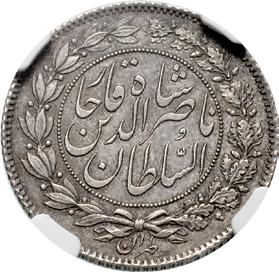
932. IRAN, Qajars. Nasir al-Din Shah. AH 1264-1313 / AD 1848-1896. AR 1000 Dinar Pattern (23mm, 6h). Tehran mint. Dated AH 1281 (1864). Persian lion and sun (Šir-o Xoršid); crown above, denomination below; all within laurel and oak wreath; AH date below wreath ties / al-sultan Nasir al-Din Shah Qajar in three lines within wreath; mint name below wreath ties. KM Pn9. In NGC encapsulation 4861363-004, graded MS 61. ($1000)



933. ITALY, Firenze. Republic. 1189-1532. AV Fiorino d’oro (20mm, 3.52 g, 11h). Cappone di Recco di Cappone, mintmaster. 1st semester, 1342. Ornate lily of Florence / St. John the Baptist standing facing, holding long cross. MIR 9/29 Bernocchi 1495; Friedberg 275. EF. ($1000)
Ex Künker 383 (17 March 2023), lot 2222; Classical Numismatic Group inventory 937978 (February 2009); Numismatica Ars Classica 50 (15 November 2008), lot 58.



934. ITALY, Genova. Simone Boccanegra. Doge, first tenure, 1339-1344. AV Genovino (21mm, 3.54 g, 10h). Stylized castle surrounded by alternating rosettes and pointed trilobes; all within tressure of eight arches; stars in spandrels; segno: A / Cross pattée surrounded by alternating rosettes and pointed trilobes; all within tressure of eight arches; stars in spandrels. MIR 28; cf. MEC 12, 269-270 (for type); Friedberg 354. Lustrous, edge bump, slightly double struck. EF. ($750)
Purchased by the consignor from Jonathan Kern.


935. ITALY, Milano (Duchy). Filippo II di Spagna. 1554-1598. AR Mezzo scudo (33mm, 10h). Milano mint. Crowned, armored, and draped bust right, wearing ruff / Crowned coat-of-arms. MIR 311/2; Crippa 21. Toned. In NGC encapsulation 4484741-004, graded AU 50. ($750)



936. ITALY, Savoia (Duchy). Emanuele Filiberto. 1553-1580. AR Lira (33mm, 12.41 g, 4h). Chambéry mint. Dated 1562 P. Armored bust right, wearing ruff / Legend in two lines within wreath. MIR 506d. Toned with hints of luster. EF. ($2000)
From the Alexander Christopher Collection.



937. ITALY, Toscana (Grand Duchy). Cosimo III de Medici. 1670-1723. AR Pezza Della Rosa (42mm, 25.91 g, 7h). Livorno mint. Dated 1701. Crowned coat-of-arms / Rose bush. MIR 66/7; Davenport 1499; KM 15.3. Toned. In NGC encapsulation 6898707-010, graded AU 58. ($1500)
From the Alexander Christopher Collection.
The longest-reigning Grand Duke in the history of Toscana, Cosimo III was born to Ferdinando II de’ Medici and Vittoria della Rovere. At the behest of his mother, he was raised with a religiously-oriented education, ultimately serving as the catalyst to the reactionary policies made throughout his reign. Poor management of the grand duchy, however, left Toscana in a fledgling economic state upon Cosimo’s death and his son and successor, Gian Gastone, served as the final member from the de’ Medici family.



938. ITALY, Venezia (Venice). Jacopo Contarini. 1275-1280. PB Seal – Bulla (42mm, 45.66 g, 12h). Doge standing right, head facing, receiving banner from St. Mark, standing facing before throne and holding gospel / IACOBVS/ COTARЄNO/ DI : GRA : VЄNЄT/IЄ DALMATIЄ/ ATQ · CHRO/ DVX. Gamberini 47. Exquisitely preserved with a trace of the original string. EF. Unparalleled style and detail in the faces of the two figures. Extremely rare in this remarkable condition, particularly for such an early seal. ($1000)
Form the Jonathan Kern Collection, purchased August 1975. Ex Radford Stearns Collection.



939. ITALY, Kingdom of Italy. Vittorio Emanuele III. 1900-1946. AR 5 Lire (35mm, 6h). Rome mint. Dated 1914 R. Uniformed bust right / Italia standing left in quadriga rearing left, holding olive branch and round shield. MIR 1136a; KM 56. Toned. In NGC encapsulation 2903210-004, graded MS 61. ($3000)



940. LIECHTENSTEIN, Principality. Joseph Wenzel. 1748-1771. AR Taler (41mm, 28.05 g, 11h). Wien (Vienna) mint. Dated 1758. Armored and collared bust right / Crowned and collared coat-of-arms with cherub supporters. Davenport 1579; KM (C) 2. Toned with underlying luster. In NGC encapsulation 6898643-002, graded MS 62. An attractive example with significant eye appeal. ($3000)
From the Alexander Christopher Collection.
Joseph Wenzel was an extremely successful general across several wars. He participated in the Austro-Turkish War alongside Prince Eugene of Savoy and also took part in the War of Polish Succession again alongside Prince Eugene. He was made Generalissimo of Italy during the War of Austrian Succession and resoundingly crushed the combined French and Spanish armies during the Battle of Piacenza in 1746. He also reorganized the Austrian artillery service and served as a diplomat for various Austrian missions. He assumed the position of regent in 1745 for an heir who was only eight years of age and took over as Prince of Lichtenstein in 1748 and ruled until his death in 1772.



941. LOW COUNTRIES, Ariën-aan-de-Leie (Airé). AR 50 Sols (30x28mm, 14.69 g). War of the Spanish Succession issue. Besieged by the Austrian and English troops under the command of John Churchill, 1st Duke of Marlborough and François-Eugène de Savoie. Dated 1710. Crowned coat-of-arms / Blank. Korchnak 9; Mailliet pl. I, 5; KM 16.1 (French States). Toned. Good VF. ($500)
Ex Libertas Collection, purchased October 1980.
Throughout its history, the town of Ariën-aan-de-Leie was besieged numerous times. During the War of the Spanish Succession, the Alliance forces, under the command of John Churchill, 1st Duke of Marlborough and François-Eugène de Savoie laid siege to the town with Marlborough’s headquarters near the Priory of St. Andrew. After a siege of two months, the Marquis de Goesbriand, governor of the town, surrendered, handing over the city keys to Marlborough.


942. LOW COUNTRIES, Vlaanderen (Flanders [County]). Lodewijk II van Male. 1346-1384. AV Gouden Flandres (29.5mm, 4.15 g, 5h). Gand (Ghent) mint. Struck 1369-1370. Lodewijk standing facing within Gothic canopy, holding sword and shield decorated with coat-of-arms; crested helmet to left / Cross fleurée and feuillue; lion rampant in central quadrilobe; ō L ¥ D in quarters; all within quadrilobe with trefoils in spandrels. Elsen 36; Delmonte, Or 464; De Mey, Flanders 204; Vanhoudt G2612; Friedberg 161. In PCGS encapsulation 50433362, graded UNC Details, cleaned. ($2000)


943. LOW COUNTRIES, Republic of the Seven Netherlands (Dutch Republic). West Friesland. 1581-1795. AR Piedford Dukaton (46mm, 65.52 g, 11h). Dated 1666. Knight on horseback galloping right, holding sword and reins; coatof-arms below / Crowned coat-of-arms within leonine supporters. P&W Wf28.1; CNM 2.46.38; Delmonte, Argent 1019a; Davenport A4939; KM P11. Iridescent toning, slightly double struck, hairlines. EF. ($1500)
From the Alexander Christopher Collection.




944. LOW COUNTRIES, Republic of the Seven Netherlands (Dutch Republic). Zeeland. 1581-1795. AR Piedfort Dubbele daalder van 10 schelling – Double Taler (44mm, 62.82 g, 3h). Dated 1687. Knight standing left, head right, holding sword; crowned coat-of-arms to lower left / Seven entwined coats-of-arms. P&W Ze59.3; CNM 2.49.67; Delmonte, Argent 1074a; Davenport A4973; KM P23. Old collection toning. In NGC encapsulation 6917297-001, graded MS 66. Top Pop. Very rare, particularly so in this stunning high grade. ($10,000)
From the Alexander Christopher Collection.


945. MALAY ARCHIPELAGO, Islamic Sultanates. Raja Bendaharas of Pahang. Tun Ahmad. AH 1279-1298 / AD 1863-1881. Tin Tampang – 1/25 Dollar (82x77mm, 64.81 g). Conical pyramid with flared base; crude Yew Lee Kong Si in Hànzì at crown, crude Jawi inscription around, floral ornaments in corners. SS 14. Lustrous. EF. A high grade example with exceptional metal quality. ($750)
From the Norman Frank Collection.




946. MALAY ARCHIPELAGO, Colonial. Netherlands East Indies. Dutch East India Company. 1602-1799. AR Ducatoon (44mm, 32.67 g, 12h). Dordrecht mint in Holland. Dated 1739. Knight on horseback right, holding sword and reins; crowned coat-of-arms below / Crowned coat-of-arms with crowned leonine supporters; below, VOC monogram within ornate frame. Edge: reeded. Scholten 28b; Delmonte, Argent 1061; Davenport 417; KM 71. Richly toned. In NGC encapsulation 6898643-003, graded MS 64. Top Pop. A superb example with exceptional eye appeal. ($15,000)
From the Alexander Christopher Collection.


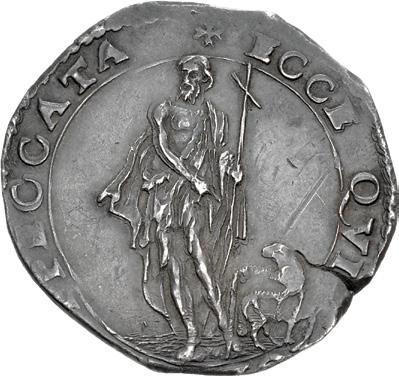
947. MALTA, Sovereign Military Order of Malta. Jean de Valette. Grandmaster, 1557-1568. AR 4 Tarì (32mm, 10.85 g, 7h). Fort St. Angelo (Birgu) mint. Coat-of-arms / St. John the Baptist standing facing, holding long cross; to right, agnus Dei standing right, head left. Gatt 06-4T-38X26; Restelli & Sammut 9-10; Schembri 3. Richly toned, flan cracks, scratches. Near EF. Rare. ($1500)
Ex J. Eric Engstrom Collection.
Jean Parisot de Valette, after whom the capital of the Knights of Malta was named, served the Order both on Rhodes, when he was a young man, and was the 6th Grandmaster of the Knights of Malta. He was a man of considerable military skill and daring. From his appointment in 1537 as Governor of Tripoli to his time as a galley slave to the Barbary pirates, Valette demonstrated his abilities and, in 1557, was appointed Captain General of the Order’s galleys, a prestigious post. In this office, he earned a reputation as one of the great Christian commanders of the age. Described as a “very handsome man, speaking several languages fluently including Italian, Spanish, Greek, Arabic and Turkish,” Vallette’s reign was spent in almost continuous warfare with the Ottomans. During the Great Siege of Malta (1565), he ordered the defense of the city, holding out successfully against the Ottomans (including the Janissaries) until relief arrived. This victory increased the renown of the Order in Europe (thereby gaining new recruits), but Vallette refused to accept a cardinalship from the Pope, preferring to retain the Order’s sovereignty. The following year, Vallette began the construction of his new capital on the site of the former Fort St. Elmo. He died, however, before the work was completed.
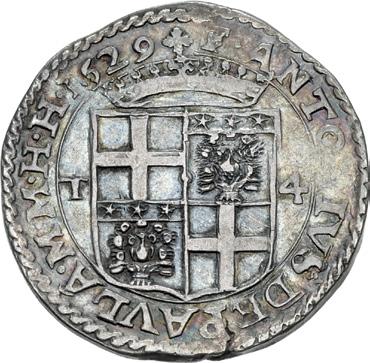


948. MALTA, Sovereign Military Order of Malta. Antoine de Paule. Grandmaster, 1623-1636. AR 4 Tarì (31mm, 10.40 g, 9h). Valleta mint. Dated 1629. Crowned coat-of-arms / Head of St. John the Baptist on platter. Gatt 13-4T-66X62; KM 48. Iridescent toning, edge splits, late die state. VF. ($1000)
From the Drewry Family Collection. Ex Stanley Gibbons Collection (Part II, NASCA, 7 December 1981), lot 4430.



949. MALTA, Sovereign Military Order of Malta. Emmanuel Pinto. Grandmaster, 1741-1773. AV 10 Scudi (23mm, 7.82 g, 6h). Second coinage. Valletta mint. Dated 1762. Crowned coat-of-arms within wreath / St. John standing facing, holding banner; at feet, agnus Dei standing right, head left. Gatt 25-10S-21N21; Restelli & Sammut 45; Schembri 5; KM 270; Friedberg 36. Wiped. Near EF. ($750)
Ex J. Eric Engstrom Collection.



950. MALTA, Sovereign Military Order of Malta. Emmanuel de Rohan. Grandmaster, 1775-1797. AV 10 Scudi (15mm, 8.32 g, 6h). Valetta mint. Dated 1778. Armored bust right / Crown over two coats-of-arms. Gatt 27-10A-10N/11; KM 310; Friedberg 44. Lustrous, a few faint scratches and hairlines. AU. ($1500)
From the Drewry Family Collection. Ex Coin Galleries (24 February 1984), lot 812.


951. MEXICO, Colonial. Carlos III. King of Spain, 1759-1788. AR 8 Reales (37mm, 12h). Columnario type. Mexico City mint. Dated 1761 Mo MM. Crowned coat-of-arms; cross between HI / Crowned hemispheres between crowned pillars ornamented with banners; all set on waves. Yonaka, Mexico M8-61d; Gilboy M-8-39a; BW 28.4; KM 105. In NGC encapsulation 3356414-001, graded AU 55. ($600)



952. MEXICO, War of Independence. Insurgent countermarked issues. José María Liceaga. AR 2 Reales (27mm, 2h). Struck circa 1813. J · M · L/ S · У · in two lines; flag above, crossedolive branch and palm frond below, all in rough circular countermark on an 1811 Zacatecas Royalist 2 Reales. For c/m: BW 105.9; KM 261.5. For host: BW 72.1; KM 186. Toned. In NGC encapsulation 6930280-001, graded VF Details, cleaned. C/s: XF Strong. Extremely rare. ($3000)
From the Alexander Christopher Collection.
José María Liceaga was a trained doctor who served in the Spanish Army, rising to the rank of Lieutenant General. At the outbreak of the War of Independence in 1810, he joined Miguel Hidalgo, and after his death went on to serve with Ignacio López Rayón and José María Morelos. He served as a member of the Congress of Anáhuac from 1813-1815. Liceaga would be assassinated by a deserter in 1817.

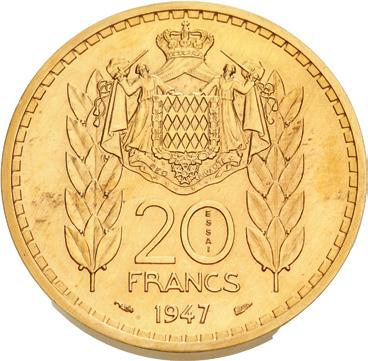
953. MONACO. Louis II. 1922-1949. Piedfort AV Essai de 20 Francs (30mm, 37.56 g, 12h). Paris mint; différents: cornucopia and wing. Dated 1947. Uniformed bust left / Crowned, collared, and mantled coat-of-arms with supporters; flanked by upright olive branches. KM PE5. In NGC encapsulation 6917297-005, graded UNC Details, rev spot removed. Extremely rare – mintage of only 16 examples. ($2000)
From the Alexander Christopher Collection. Ex Palace Collections of Egypt (King Farouk – Sotheby’s, 24 February 1954), lot 1108 (part of).


954. MONACO. Louis II. 1922-1949. Piedfort AV Essai de 10 Francs (25mm, 26.84 g, 1h). Paris mint; différents: cornucopia and wing. Dated 1946. Uniformed bust left / Crowned, collared, and mantled coat-of-arms with supporters; flanked by upright olive branches. KM PE4. In NGC encapsulation 6917297-006, graded MS 63. Extremely rare – mintage of only 16 examples. Top Pop ($1500)
From the Alexander Christopher Collection. Ex Palace Collections of Egypt (King Farouk – Sotheby’s, 24 February 1954), lot 1108 (part of).


955. MONACO. Louis II. 1922-1949. Piedfort AV Essai de 5 Francs (31mm, 47.17 g, 12h). Paris mint; différents: cornucopia and wing. Dated 1945. Bare head left / Crowned, collared, and mantled coat-of-arms with supporters. KM PE3. In NGC encapsulation 6917297-003, graded MS 65. Extremely rare – mintage of only 16 examples. ($2500)
From the Alexander Christopher Collection. Ex Palace Collections of Egypt (King Farouk, Sotheby’s, 24 February 1954), lot 1108 (part of).




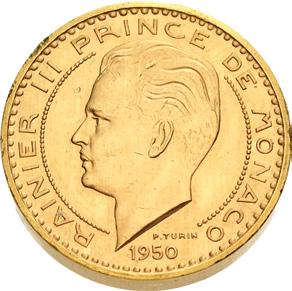



956. MONACO. Rainier III. 1949-2005. Set of four (4) AV Piedfort Essais. Paris mint; différents: cornucopia and wing. Dated 1950. Includes: (a) Piedfort AV Essai de 100 Francs (50.96 g). VG 142; KM PE9a. In NGC encapsulation 6917297-004, graded MS 62 // (b) Piedfort AV Essai de 50 Francs (40.88 g). VG 141; KM PE8a. In NGC encapsulation 6924486-002, graded MS 63 // (c) Piedfort AV Essai de 20 Francs (28.95 g). VG 140; KM PE7a. In NGC encapsulation 6924486-003, graded MS 63 // (d) Piedfort AV Essai de 10 Francs (20.96 g). VG 139; KM PE6. In NGC encapsulation 6924486-004, graded MS 65. All NGC graded. Only 325 struck of each denomination. Four (4) coins in lot. ($4000)
From the Alexander Christopher Collection.








957. MONACO. Rainier III. 1949-2005. Set of four (4) AV Essais. Paris mint; différents: cornucopia and wing. Dated 1950. Includes: (a) AV Essai de 100 Francs (25.52 g). VG 142; KM E33. In NGC encapsulation 6909515-001, graded MS 65. Top Pop // (b) AV Essai de 50 Francs (20.51 g). VG 141; KM E32. In NGC encapsulation 6909515-002, graded MS 64 // (c) AV Essai de 20 Francs (14.49 g). VG 140; KM E29. In NGC encapsulation 6909515-003, graded MS 65 // (d) AV Essai de 10 Francs (10.51 g). VG 139; KM E26. In NGC encapsulation 6909515-004, graded MS 64. All NGC graded MS 64 or MS 65. Only 500 struck of each denomination. Four (4) coins in lot. ($4000)
From the Alexander Christopher Collection.



958. NEW ZEALAND. George V. 1910-1936. Proof AR Crown (38mm, 28.27 g, 12h). Commemorating the Silver Jubilee. London mint. Dated 1935. Crowned and mantled bust left / Maori chief Tāmati Waka Nene, holding taiaha and standing right, shaking hands with Captain William Hobson, Lieutenant-Governor of New Zealand; crown behind; WAITANGI in exergue. KM 6. Lightly toned. In NGC encapsulation 6906596-003, graded PF 63. Rare – only 468 proofs struck. The key to the New Zealand series. ($2000)
From the Drewry Family Collection. Ex Bowers & Merena (23 June 1986), lot 1338.



959. NORWAY. Kristian IV. 1588-1648. AR Daler (40mm, 28.90 g, 1h). Christiana mint. Dated 1638. Crowned and armored bust right, wearing ruff / Crowned lion rampant left, holding ax. ABH 38; Davenport 3534; KM 12. Toned. In NGC encapsulation 6931384-002, graded AU 58. ($2000)
From the Drewry Family Collection. Ex El Dorado (14 July 1984), lot 154.
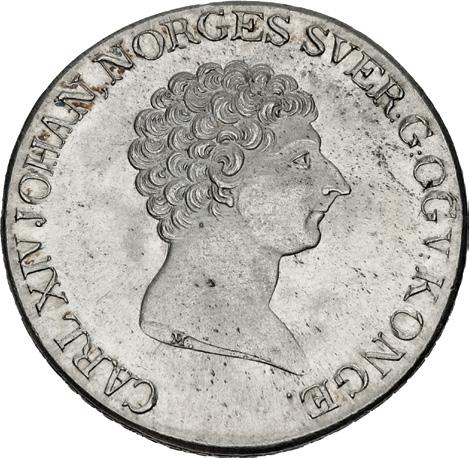


960. NORWAY. Karl III Johan. 1818-1844. AR Speciedaler (38mm, 28.89 g, 12h). Kongsberg mint. Dated 1821. Bare head right / Crowned coat-of-arms. ABH 2; Davenport 240; KM 290. Lightly toned, lustrous. In NGC encapsulation 6898643008, graded MS 63. ($3000)
From the Alexander Christopher Collection.



961. PARAGUAY, Republic. 1811-pres. Pattern CU Peso (37mm, 19.99 g, 6h). Buenos Aires(?) mint. Dated 1888 REPUBLICA DEL PARAGUAY, star within wreath; 1888 below / * PAZ Y JUSTICIA * UN PESO 9 DOS FINO, lion seated facing with liberty cap on pole behind. KM Pn39. Lustrous. In NGC encapsulation 6924486-001, graded PF 63 RD. Extremely rare. ($1500)
From the Alexander Christopher Collection.



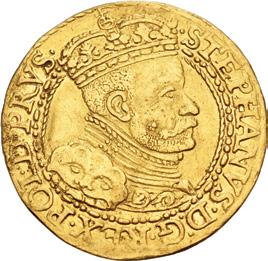


963. POLAND, Monarchy. Stefan Batory. 1576-1586. AV Dukat (22mm, 3.48 g, 6h). Gdansk (Danzig) mint. Dated 1586. Crowned and armored bust right / Coat-of-arms with leonine supporters. Dutkowski & Suchanek 137III; Kopicki 7452; Friedberg 3. Edge marks, scrape. VF. ($2000)
Ex Karl Stephens FPL 93 (March 1995), no. 6502.



964. POLAND, Monarchy. Stanislaw August Poniatowski. 1764-1795. AR Dwuzłotówka – 8 Groszy (29mm, 9.40 g, 12h). Warszawa (Warsaw) mint. Dated 1785 EB. Bare head right / Crowned coat-of-arms within wreath. Kopicki 2415; MP 1222c; KM 198.1. Toned. In NGC encapsulation 6909478-014, graded MS 63. Top Pop. ($1000)
From the Alexander Christopher Collection.



965. POLAND, Monarchy. Stanislaw August Poniatowski. 1764-1795. AR Talar – Taler (41mm, 27.53 g, 12h). The ‘Targowica’ Taler and the Constitution of 3 May 1791. Warszawa (Warsaw) mint. Dated 3 May 1791, 5 October 1792, and 1793. EXEMPLUM POSTERITATI GRATITUDO, CIVIBUS/ QUORUM PIETAS/ CONIURATIONE DIE III/ MAI MDCCXCI OBRUTAM/ ET DELETAM/ LIBTERAT/TE POLONA TUERI/ CONABATUR RESPU/BLICA RESUR/ GENS within wreath; star above / 10 1/16 EX MARCA PURA COLONIENSI 1793, DECRETO/ REIPUBLICÆ NEXU/ CONFEDERATIONIS IUNCTÆ/ DIE V XBRIS MDCCXCII/ SANDISLAO AUGUSTO/ REGNANTE. Kopicki 2486; MP 1232; Davenport 1622; KM 214. Lightly toned, hairlines, some residue. AU. ($2000)
From the Alexander Christopher Collection.
On 3 May 1791, a new constitution was promulgated that reorganized the Polish-Lithuanian Commonwealth as a constitutional monarchy, investing greater power in the Great Sejm (parliament). Reactionaries both within the Commonwealth and without responded with hostility. On 27 April 1792, a group of Polish and Lithuanian aristocrats met in St. Petersburg with the support of Catherine the Great to establish a confederation to fight against the new constitution. The new confederation was proclaimed in the town of Targowica on 14 May 1792, giving the group their name. Within days, Russian armies marched into Poland. The forces of the Commonwealth were ultimately defeated, resulting in the Second Partition of Poland and the loss of more than half of the Commonwealth’s territory to Prussia and Russia.




966. ROMANIA, Principality. Carol I. As Domnitor, 1866-1881. AV 20 Lei (21mm, 6.44 g, 6h). Bucharest mint. Dated 1870 C. Bare head left / Denomination and date within wreath. MBR 24; KM 7; Friedberg 2. In NGC encapsulation 6890893008, graded MS 64. Very rare. Mintage of 5000. ($15,000)
From the Alexander Christopher Collection.



967. ROMANIA, Kingdom. Carol I. 1881-1914. AV 25 Lei (29mm, 8.09 g, 12h). Commemorating the 40th Anniversary of his Rule. Brussels mint. Dated 1866 and 1906. Bust left, wearing military uniform / Crowned eagle facing with wings spread, head left, holding swords in talons and cross in beak; ribbon across breast. MBR 81; KM 38; Friedberg 7. In NGC encapsulation 6890893-006, graded MS 64. ($3000)
From the Alexander Christopher Collection.
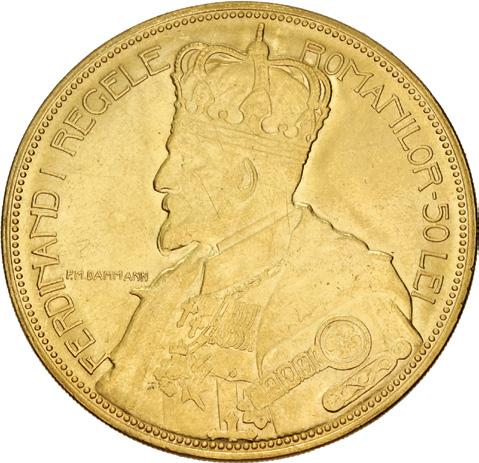

968. ROMANIA, Kingdom. Ferdinand I, with Maria. 1914-1927. AV 50 Lei (39mm, 16.13 g, 12h). Coronation. Dated 1922. Crowned and mantled bust of Ferdinand left / Crowned bust of Maria right. MBR 90; KM (X) M3; Friedberg 11. In NGC encapsulation 6890893-003, graded MS 62. ($5000)
From the Alexander Christopher Collection.

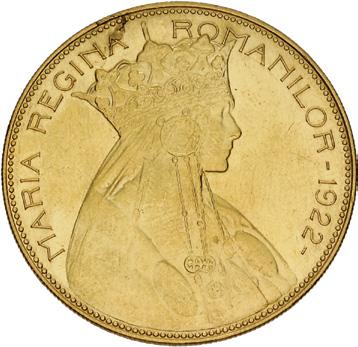
969. ROMANIA, Kingdom. Ferdinand I, with Maria. 1914-1927. AV 25 Lei (29mm, 8.06 g, 12h). Coronation. Dated 1922. Crowned and mantled bust of Ferdinand left / Crowned bust of Maria right. MBR 89; KM (X) M2; Friedberg 12. In NGC encapsulation 6890893-004, graded MS 63. Top Pop. ($4000)
From the Alexander Christopher Collection.


970. RUSSIA, Empire. Petr I Alexeyevich Velikiy (Peter the Great). 1682-1725. AR Rouble (42mm, 27.18 g, 11h). Krasny (Red) mint. Dated 1705 (in OCS numerals). Armored bust right / Crowned double-headed eagle facing with wings spread, holding scepter and globus cruciger; crown above. Diakov 4; Bitkin 798; KM 122.2. Toned. In NGC encapsulation 6928246-003, graded VF Details, cleaned. ($1500)
From the Alexander Christopher Collection.



971. RUSSIA, Empire. Petr I Alexeyevich Velikiy (Peter the Great). 1682-1725. AR Rouble (42mm, 12h). Kadashevsky mint. Dated 1707 H (in OCS numerals). Laureate, draped, and armored bust right / Crowned double-headed eagle facing with wings spread, holding scepter and globus cruciger; crown above; ҂АѰЗ (date) below. Diakov 2; Bitkin 184; KM 130.1. Toned. In NGC encapsulation 6906866-005, graded AU 53. ($7500)
From the Alexander Christopher Collection.

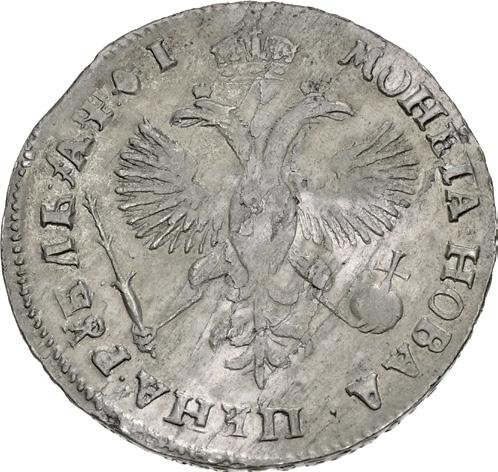
972. RUSSIA, Empire. Petr I Alexeyevich Velikiy (Peter the Great). 1682-1725. AR Rouble (40mm, 28.32 g, 12h). Kadashevsky mint. Dated 1719 (in OCS numerals). Laureate, draped, and cuirassed bust right / Crowned double-headed eagle holding sword and globus cruciger; crown above. Diakov 16; cf. Bitkin 311-5; KM 157.3 (this coin illustrated). In NGC encapsulation 6931384-001, graded AU Details, cleaned. ($1000)
From the Drewry Family Collection. Ex Paul A. Dahlman Estate (Kurt R. Kreuger, 27 November 1986), lot 1345.
Rare Ivan VI Rouble




973. RUSSIA, Empire. Ivan VI Antonovich (Ioann III). 1740-1741. AR Rouble (40mm, 12h). St. Petersburg mint. Dated 1741 СПБ. Laureate and draped bust right / Crowned double-headed eagle facing with wings spread, holding scepter and globus cruciger; collared coat-of-arms on breast; crown above. Diakov 6; Bitkin 21; KM 207.2. Toned with hints of luster. In NGC encapsulation 6906892-001, graded AU 58. Rare. ($10,000)
From the Alexander Christopher Collection. Diakov notes that Ivan’s successor, Yelizaveta Petrovna (Elizabeth), “considered the destruction of Ioann III coins to be one of her objectives.” 665,000 roubles of Ivan’s coins were returned and melted or restruck. (Diakov p. 123)
Pattern Rouble Novodel


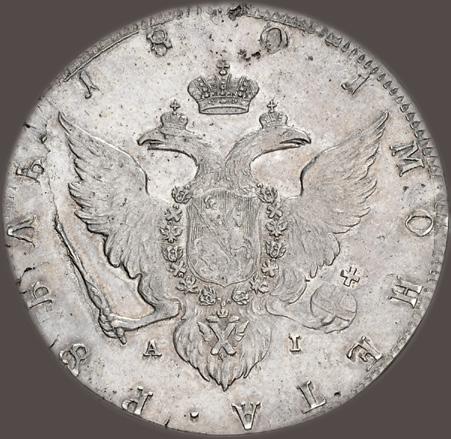

974. RUSSIA, Empire. Aleksandr I Pavlovich. 1801-1825. Pattern AR Rouble Novodel (37mm, 19.87 g, 12h). Bank (St. Petersburg) mint. Dated 1801 СПБ
bare head right; СПБ below / МОНЕТА · РoБЛЬ · 1801, Crowned double-headed eagle facing with wings spread, holding scepter and globus cruciger; collared coat-of-arms on breast; crown above; A I flanking tail. Edge: plain. Bitkin H645; cf. KM Pn52. Toned. In NGC encapsulation 6917299-001, graded UNC Details, rev spot removed. ($15,000)
From the Alexander Christopher Collection. Ex Irving Goodman Collection (Superior, 11 February 1991), lot 700.




975. RUSSIA, Empire. Aleksandr I Pavlovich. 1801-1825. AR Poltina (26mm, 10.22 g, 12h). St. Petersburg mint. Dated 1810 СПБ ФГ. Crowned double-headed eagle facing with wings spread, holding scepter and globus cruciger; collared coat-of-arms on breast; crown above / Crowned denomination within wreath. Bitkin 141; KM (C) 129. In NGC encapsulation 6906684-009, graded MS 61. Rare. ($7500)
From the Alexander Christopher Collection.



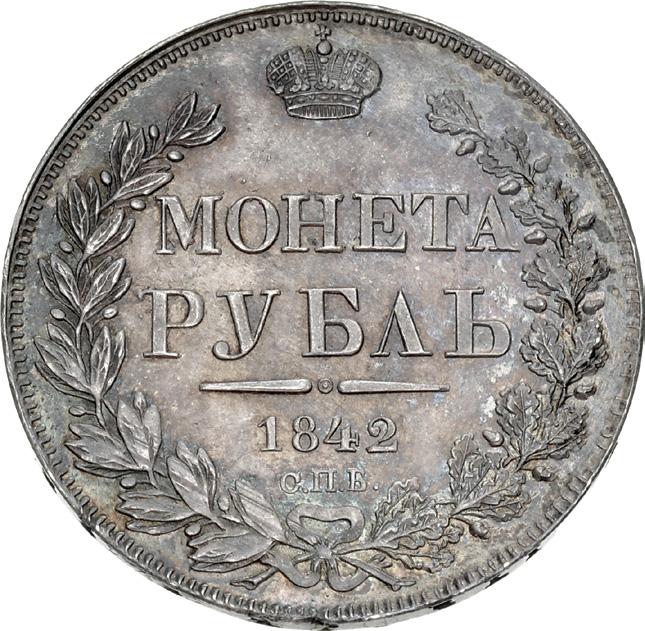
976. RUSSIA, Empire. Nikolai I Pavlovich. 1825-1855. AR Rouble (35mm, 20.40 g, 11h). St. Petersburg mint. Dated 1842 СПБ АЧ. Crowned double-headed eagle with wings spread, collared coat-of-arms on breast, coat-of-arms on wings, holding scepter and globus cruciger / Crown above denomination and date within wreath. Bitkin 196; KM (C) 168.1. Toned. In NGC encapsulation 6928246-006, graded MS 64+. ($2000)
From the Alexander Christopher Collection.
Poltina




977. RUSSIA, Empire. Nikolai I Pavlovich. 1825-1855. Proof AR Poltina (28mm, 10.36 g, 12h). St. Petersburg mint. Dated 1855 СПБ HI. Crowned double-headed eagle facing with wings spread, holding scepter and globus cruciger; collared coat-of-arms on breast, additional coats-of-arms on wings; crown above / Crowned denomination and date within wreath. Bitkin 235 (Nikolai I) and 49 (Aleksandr II); KM (C) 167.1. Iridescent toning. In NGC encapsulation 6906684-011, graded PF 64. Top Pop. ($10,000)
From the Alexander Christopher Collection. This identical type continued to be struck under Aleksandr II until 1858.


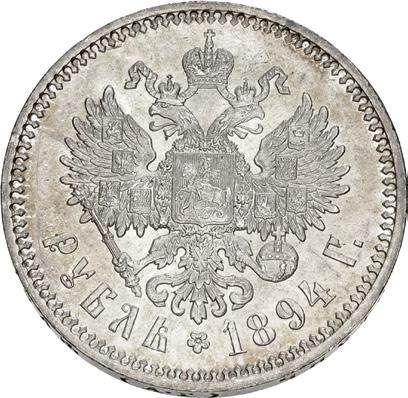
978. RUSSIA, Empire. Aleksandr III Aleksandrovich. 1881-1894. AR Rouble (33mm, 20.02 g, 12h). St. Petersburg mint. Dated 1894 АГ. Bare head right / Crowned double-headed eagle facing, holding scepter and globus cruciger; collared coat-of-arms on breast, coats-of-arms on wings; crown above. Bitkin 78; KM (Y) 46. Light golden toning with underlying luster. In NGC encapsulation 6928246-002, graded MS 64. ($2000)
From the Alexander Christopher Collection.



979. RUSSIA, Empire. Nikolai II Aleksandrovich. 1894-1917. AR Rouble (34mm, 12h). Commemorating the Unveiling of the Alexander II Memorial in Moscow. St. Petersburg mint. Dated 1898 АГ. Bare head of Aleksandr II left / View of the Moscow memorial. Bitkin 323; KM (Y) 61. Iridescent toning. In NGC encapsulation 6929381-001, graded MS 65 PL. Rare. A stunningly high grade example, with only one graded higher by NGC. ($10,000)
From the Alexander Christopher Collection.
The Aleksandr II memorial in Moscow was completed in 1898 to honor the late Tsar Aleksandr II Nikolaevich, who was assassinated in 1881 by a socialist bomb. The monument would be demolished by Stalin in 1931, before ultimately being restored in 2005.
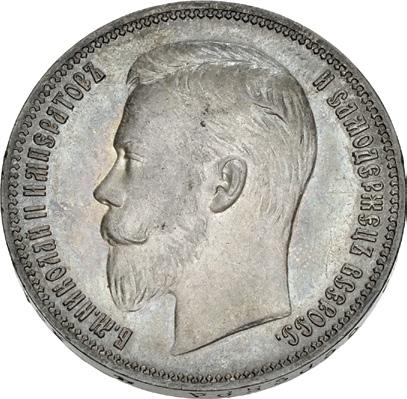

980. RUSSIA, Empire. Nikolai II Aleksandrovich. 1894-1917. AR Rouble (33mm, 12h). St. Petersburg mint. Dated 1910 ЭБ. Bare head left / Crowned double-headed eagle facing, holding scepter and globus cruciger; collared coat-of-arms on breast, coats-of-arms on wings. Bitkin 64; KM (Y) 59.3. Iridescent toning. In NGC encapsulation 6928237-005, graded AU 58. ($750)
From the Alexander Christopher Collection.


981. SAUDI ARABIA, Kingdom (Sa’ud). temp. ‘Abd al-’Aziz. AH 1350/1-1373 / AD 1932-1952. AV 4 Pounds (31mm, 31.96 g, 12h). Philadelphia mint. Struck 1945-1946. Facing eagle with shield on breast / Weight and fineness in three lines. KM 34; Friedberg 190. In NGC encapsulation 6906596-004, graded MS 61. 0.9419oz AGW ($1500)
From the Drewry Family Collection. Ex Stack’s (21 September 1994), lot 1227; Bowers & Merena (26 March 1984), lot 3035 (part of).


982. SPAIN, Kingdom. Felipe II el Prudente. 1556-1598. AR 8 Reales (40mm, 12h). Segovia mint; mm: aqueduct. Dated 1586. Crowned coat-of-arms. PILIPPVS in legend / Quartered coat-of-arms of Spain within polylobe. Calicó y Trigo 173; ME 3961. In NGC encapsulation 6972001-001, graded AU 55. Extremely rare variety misspelling the King’s name. ($1500)
Ex Spink 251 (27 March 2018), lot 709.




983. SPAIN, Kingdom. Felipe III (II of Aragon) el Piadoso. 1598-1621. AR 8 Reales (39mm, 28.10 g, 11h). Zaragoza mint. Dated 1610 CA. Crowned coat-of-arms; VIII (mark of value) to right / Coat-of-arms surmounted by cross. Calicó y Trigo – (but cf. 203-4 for 1611 date); ME – (cf. 4891-2 for same); KM – (cf. 18.1-.2 for same). Toned. In NGC encapsulation 6917303-013, graded XF 45. Extremely rare. An unrecorded date for the series. Top Pop ($5000)
From the Gerald F. Borrmann (Northern California Gentleman) Collection.


984. SPAIN, Kingdom. Felipe IV el Grande. 1621-1665. AR 8 Reales (41mm, 27.24 g, 12h). Segovia mint; mm: aqueduct. Dated 1632 R. Crowned coat-of-arms / Quartered coat-of-arms of Spain within polylobe. Calicó y Trigo 570; ME 6285; KM 111. Toned, hairlines. AU. ($750)


985. SPAIN, Kingdom. Amadeo I. 1871-1873. Proof AR 5 Pesetas (36mm, 24.95 g, 6h). Madrid mint. Dated 1871 SDM (18 71 en estrellas). Bare head left / Crowned coat-of-arms flanked by Pillars of Hercules. Calicó y Trigo 5; ME 17447; KM 666 (no proofs listed). Deep blue-gray toning. In NGC encapsulation 6898643-007, graded PF 62. Extremely rare in proof. ($1500)
From the Alexander Christopher Collection.



986. SWEDEN. Erik XIV. 1560–1568. AR 3 Mark (42mm, 30.78 g, 7h). Stockholm mint. Dated 1562. Crowned coatof-arms / View of Stockholm; above, radiant scepter descending from clouds. Delzanno 19; Antell 521; Davenport 8703. Toned, deposits, edge marks. Good VF. Popular city view type. ($1500)
From the Drewry Family Collection. Ex C. Whyte 14 (15 August 1986), lot 396.


987. SWEDEN. Karl XII. 1697–1718. CU 2 Daler Plate (23x22.5cm, 2.3 kg). Avesta mint. Dated 1710. Center stamp: (lis) 2 (lis)/ DALER/ Sölf : Myt/ (crossed arrows). Four stamps in corners: (rosette) CAROLUS · XII · D : G : SVE : GOT : WAN : REX · around crown, below, 1710 ·. Delzanno 155; Tingström, Plate p. 275, A/1; KM PM 43. Brown patina with some green. EF. ($1000)


988. SWEDEN. Fredrik I. 1720–1751. CU 2 Daler Plate (18x17.5cm, 1.5 kg). Avesta mint. Dated 1729. Center stamp: 2 / DALER/ SILF : MYNT/ (crossed arrows). Four stamps in corners: Crowned FRS, 1729 below. Delzanno 239; Tingström, Plate p. 300, A/10; KM PM71. Brown and green surfaces, some deposits and corrosion indicative of sea salvage. Near EF. ($1000)
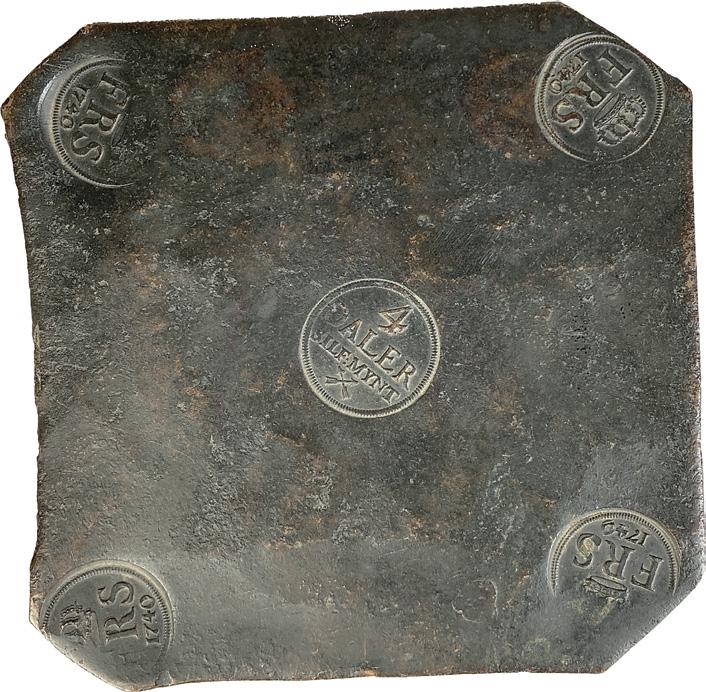

989. SWEDEN. Fredrik I. 1720–1751. CU 4 Daler Plate (21.5x22cm, 3.1 kg). Avesta mint. Dated 1740. Center stamp: 4 / DALER/ SILF : MYNT/ (crossed arrows). Four stamps in corners: Crowned FRS, 1740 below. Delzanno 217; Tingström, Plate p. 296, A/21; KM PM74. Brown surfaces. Good VF. ($1000)



990. SWITZERLAND, Canton of Basel. Basel AR Doppeltaler (50mm, 56.18 g, 12h). Struck after 1700. Coat-of-arms within decorative border, surounded by eight coats-of-arms divided by floral decorations / View of the city over the Rhine. HMZ 2-77b; Davenport 1741; KM 71. Toned. In NGC encapsulation 6928245-003, graded MS 62. ($3000)
From the Drewry Family Collection. Ex El Dorado (14 September 1985), lot 228; Schweizerischer Bankverein 10 (27 January 1981), lot 133.


991. THAILAND (SIAM), Kingdom of Sukothai. 1238-1361. Silver Plated PB 25 Tamlung – 100 Baht (70x65x55mm, 1.5 kg). Punched with various wheel, elephant, and dot-in-triangle stamps. Cf. Mitchiner, Non-Islamic 2699 (for 50 Tamlung); cf. Heritage 3077, lot 38114 (12.5 Tamlung). Toned. VF. Extremely rare. Heavier than the largest Thai baht in CoinArchives. ($3000)
From the Norman Frank Collection.


992. THAILAND (SIAM), Kingdom of Sukothai. 1238-1361. Silver Plated PB 6¼ Tamlung – 25 Baht (48x38x33mm, 378.5 g). Punched with various wheel, elephant, and dot-in-triangle stamps. Cf. Mitchiner, Non-Islamic 2699 (for 50 Tamlung); cf. Heritage 3077, lot 38114 (12.5 Tamlung). Toned. VF. Very rare. ($1000)
From the Norman Frank Collection.
Unpublished Transylvanian Multiple
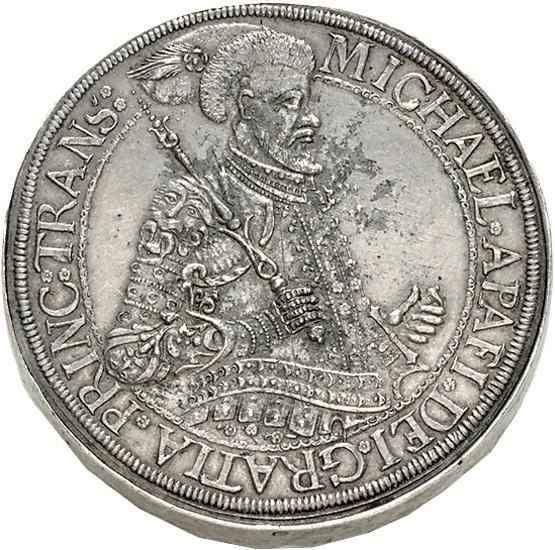



993. TRANSYLVANIA, Principality. Mihály Apafi I. 1662-1690. AR 3 Taleri (44mm, 88.54 g, 12h). Gyulafehérvár (Karslburg / Alba Iulia) mint. Dated 1683 AI. Half-length armored bust right, holding scepter over shoulder and resting hand on hilt of sword, wearing short brimmed fur cap with feather / Crowned coat-of-arms. Cf. Resch 247 (Taler); cf. MBR 2622 (Taler); cf. MNB 206 (Taler; same dies); cf. KM 492 (Taler) and A492 (dated 1681). Toned. Near EF. Extremely rare and apparently unpublished. ($5000)

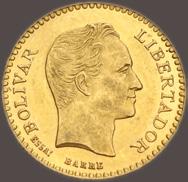


994. VENEZUELA, Republic. 1830-pres. AV Venezolano Essai (15mm, 1.51 g, 6h). Paris mint. Dies by Barré. Dated 1875. BOLÍVAR LIBERTADOR, bare head of Simón Bolívar right; ESSAI to lower left / · ESTADOS UNIDOS DE VENEZUELA · G 1.6129 · 1875 · LEI 900, coat-of-arms surmounted by crossed cornucopias; olive branch and palm frond flanking, all set on ribbon inscribed INDEPEND LIBERTAD 5 DE JUNO 1811 28 DE MARZO 1864 DIOS Y FEDON. Edge: reeded. KM EA18. In NGC encapsulation 6917297-002, graded PF 62. Extremely rare. Top Pop ($20,000)
From the Alexander Christopher Collection.
While a few examples of the larger 5, 10, and 20 Venezolano essais of 1875 have appeared on the market, none of this type have been offered since the John Jay Pittman Collection (David Akers, 9 August 1999), lot 3690 (hammer $18,400). The example offered there suggested there were perhaps only 5 known examples in total. A gilt copper uniface trial strike is also known: Heritage 3033 (8 August 2014), lot 23413 (hammer $75,000)



995. VIETNAM (ANNAM), Nguyễn dynasty. Thánh Tổ (Minh Mạng). 1820-1841. AR Philong – 7 Tìên (39mm, 27.03 g, 12h). ‘Dragon’ type. Dated RY 15 (AD 1834/5). Ming Mang Bao Thong in Han-nom characters around central radiant sun / Dragon flying left; clouds around; Muoi Lam (date) below. Schroeder 183; BN, Vietnamiennes Supp. 403; KM 195. Toned. In PCGS encapsulation 50722814, graded AU Details, repaired. ($1000)
From the Drewry Family Collection. Ex Galerie des Monnaies of Geneva (10 June 1978), lot 2837.



996. VIETNAM (ANNAM), Nguyễn dynasty. Thánh Tổ (Minh Mạng). 1820-1841. AR Philong – 7 Tìên (39mm, 12h). ‘Dragon’ type. Dated RY 15 (AD 1834/5). Ming Mang Bao Thong in Han-nom characters around central radiant sun / Dragon flying left; clouds around; Muoi Lam (date) below. Schroeder 183; BN, Vietnamiennes Supp. 403; KM 195. In PCGS encapsulation 50671182, graded AU Details, cleaned. ($1000)


997. VIETNAM (ANNAM), Nguyễn dynasty. Hiến Tổ (Thiệu Trị). 1841-1847. AR 7 Tìên (51mm, 27.23 g, 12h). Thiu Tri Thong Bao in Han-nom characters around central radiant sun / Two dragons flying upward; flaming pearl above, cloud below. Schroeder 238; BN, Vietnamiennes Supp. 447; KM 238. Toned. In NGC encapsulation 6928245-005, graded AU Details, plugged. ($1000)
From the Drewry Family Collection. Ex H. Christensen 88 (7 September 1984), lot 737.



998. VIETNAM (ANNAM), Nguyễn dynasty. Dực Tông (Tự Đức). 1847-1883. AR 3 Tìên (40mm, 13.10 g, 12h).
Tu Duc Thong Bao in Han-nom characters / Two dragons flying upward; flaming pearl above, cloud below. Schroeder 347; BN, Vietnamiennes –; Thierry, Extrême –; KM 435. Toned. In PCGS encapsulation 50723184, graded AU Details, chopmark. ($750)
From the Drewry Family Collection. Ex H. Christensen 90 (4 October 1985), lot 4.
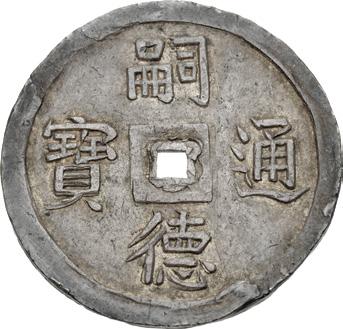

999. VIETNAM (ANNAM), Nguyễn dynasty. Dực Tông (Tự Đức). 1847-1883. AR 2 Tìên (27mm, 7.47 g, 12h). Tu Duc Thong Bao in Han-nom characters / Su Dan Phu Tho in Han-nom characters. Schroeder 351B; cf. BN, Vietnamiennes Supp. 498-9; Thierry, Extrême –; KM 423. Toned. In PCGS encapsulation 50722818, graded AU 58. ($750)
From the Drewry Family Collection. Ex H. Christensen 90 (4 October 1985), lot 8.




1000. CHINA, temp. Qīng dynasty. Tiānjīn Provisional Government 1900-1902. AV Medal (52mm, 12h). By J. Chevet. Struck by Tenshodo, Tokyo. Dated 1900 and 1902. · GOUVERNEMENT PROVISOIRE DISTRICT DE TIENTSIN · 19001902, enamelled crossed flags of Germany, the United States, France, Britain, Italy, Japan, and Russia, all tied by ribbon engraved PAX LABOR / Legend in two lines in Hànzì characters. L&M 1108. In PCGS encapsulation 46265008, graded MS 63. Extremely rare example with original case (slightly damaged). ($50,000)
From 1899 to 1901, the Boxer Rebellion raged across northern China. Led by the Society of Righteous and Harmonious Fists, the rebels violently opposed the influence of western colonial powers and their Christian missionaries. The Qing government itself soon came to support the Boxers. In response, an eight-nation multinational coalition invaded the country, with Germany, Japan, Russia, Britain, France, the United States, Italy, and Austria-Hungary all supporting the action.
On July 14, 1900, Tiānjīn was occupied by the eight-nation alliance, seizing control from the Boxers. To manage the city, a “Temporary Administration of Local Affairs” – also refereed to as the Tiānjīn Provisional Government – was set up in the former governor’s office. During its brief existence, the Tiānjīn Provisional Government struck a series of rare commemorative medals, with this particular type issued in gold, silver, and copper. Records indicate that twelve specimens were made in gold, but only two or three have thus far appeared in auctions. Tiānjīn would be administered by the Provisional Government until it was returned to Qing control on 15 August 1902.
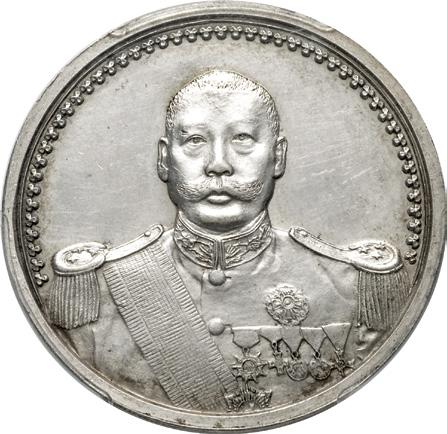

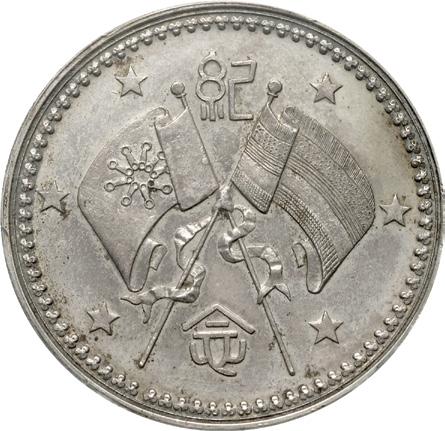
1001. CHINA, Republic of China. General issues Cáo Kūn. President, 1923-1924. AR Medal (35mm, 12h). Inauguration. Tiānjīn Central (Tientsin) mint. Struck 1923. Facing uniformed bust of Cáo Kūn / Crossed flags; stars around.L&M 960. In PCGS encapsulation 50680934, graded AU Details, cleaned. ($3000)

of Lot 1002


1002. FRANCE, Third Republic. Charles Lindbergh, American aviator. 1902-1974. AV Medal (67.5mm, 190 g, 12h). The First Solo Transatlantic Flight. Paris mint. By G. Prudhomme. Dated 1927. ★ CHARLES ★ A ★ LINDBERGH ★ NEW YORK ★ PARIS ★, bust right; ÆTATIS/ SVÆ/ XXV / · ALARVM · REMIGIO · IVNCTA · PRIMVM · OCEANI · LITTORA MCMXXVII, map of Lindbergh’s transatlantic flight; U.S.A., New York, PARIS, AFRIQVE and ATLANTIQUE labeled. Edge: (cornucopia) 3 OR. Wonderful matte surfaces. As struck. In original case of issue. Extremely rare. The sole example known in gold and possibly the specimen presented to or intended for Lindbergh himself. ($10,000)
From the Drewry Family Collection. Ex Wayte Raymond Collection (Part II, NASCA, 6 June 1978), lot 2374.
In the early 1920s, a number of famous aviators were competing to win the Orteig Prize, sponsored by New York hotelier Raymond Orteig and to be awarded to whoever successfully completed the first nonstop Transatlantic Flight from New York to Paris. Several lost their lives while attempting the feat.
At the time, Charles Lindbergh was working as a civilian flight instructor and airmail pilot. He was also a reserve officer in the Missouri National Guard. Lindbergh managed to secure a bank loan to finance the purchase of a custom built monoplane form the Ryan Aircraft Company of San Diego, California, soon to be christened the Spirit of St. Louis. Lindbergh made his attempt on the morning of 20 May 1927, taking off from Roosevelt Field on Long Island en route to Le Bourget Aerodrome outside of Paris. Heavily laden with fuel, the aircraft was barely able to clear the runway. Lindbergh flew for thirty-three and a half hours straight, contending with turbulence, ice, and lack of sleep along the way. At 10:22 PM on 21 May, the Spirit of St. Louis finally touched down in Paris to massive crowds. Lindbergh claimed the Orteig Prize and lasting international fame.
The medal offered in this lot is the sole example known in gold. It was in all likelihood presented to Lindbergh himself.





1003. GERMANY, Regensburg (city). AR Medal – Schautaler (41mm, 38.27 g, 12h). Peace of Westphalia. By U. Gravenauer and H.S. Federer. Dated 1649. * SANCTA COLIMBA ORBI CONSERUA MVNERA PACIS *, Noah’s Ark left on waves; above, rainbow and dove flying left, holding olive branch in beak; coat-of-arms below / 1649/ * FRIDEN */ DANKHFESTES/ GEDACHTNUS/ DER STATT REG/ENSPVRG DEN/ 16 8 BRIS */ ·S·P·Q·R· within wreath. Dethlefs & Ordelheide 160; cf. KM 119 (for similar gold dukat). Toned. In NGC encapsulation 6898643-001, graded MS 65. ($4000)
From the Alexander Christopher Collection.
In 1648, the Thirty Years’ War, which had been one of the longest and most destructive of European conflicts and involved most of the states of continental Europe, was concluded in a series of treaties signed throughout the year. Largely a religious war, it pitted Catholics, led by the Holy Roman Empire, the Catholic League, and the Spanish Empire, against the coalition of Protestant states and allies of central Europe and England, led by Sweden under its warrior-king, Gustavus II Adolphus.
Although known collectively as the Peace of Westphalia, because the treaties were signed in two Westphalian towns (Münster and Osnabrück) over the year 1648, the peace consisted of three separate signings. The first, signed on 30 January between Spain and the Dutch Republic, ended the Eighty Years’ War (1568-1648). On 24 October, two further and complementary treaties were signed: one at Osnabrück between The Holy Roman Empire (and its allies) and Sweden (and its allies); the other, commemorated by this medal, between The Holy Roman Empire and France. The treaties were the result of a large diplomatic congress and resulted in a new central European political order. Known later as Westphalian sovereignty, it created the notion of the sovereign state – the first step in the concept of the modern nation-state.


1004. GERMANY, Sachsen (Duchy & Electorate). Friedrich August II. Elector, 1733-1763. AR Medal (64mm, 116.2 g, 12h). On the Vikariat. By H.F. Wermuth. Dated 1741. (rosette) D. G. FRID. AVG. REX POL. DVX SAX. ARCHIMARESCHALL. ET ELECTOR, Friedrich August on horseback right, holding sword and reins / PRO LEGIS DEFENSIONE • /, open book inscribed AU/REA BUL/LA set on table; to right arm holding sword and emerging from cloud; in MDCCXLI • in exergue. Toned, marks, hairlines. EF. A popular type. ($2000)
From the Drewry Family Collection. Ex El Dorado 9 (14 September 1985), lot 116.
This medal commemorates the “Vikariat,” or the brief interregnum following death of the Holy Roman Emperor and the election of his successor. Medals and coins on this subject were often issued in the German territories of the Empire.



1005. GUATEMALA, Colonial. Fernando VII. King of Spain, 1808-1833. AR 2 Reales Medal (27mm, 7.39 g, 12h). Proclamation of the Constitution of Cádiz in Guatemala. Nueva Guatemala mint. Dated 24 September 1812. ★ POR LA CONSTITUCION POLITICA DE LAS ESPAÑAS, JUSTICIA and EQUIDAD in radiant open book / ★ LA CIUD · DE GUATEM · 24 · DE SEPT · DE 1812 ·, crowned coat-of-arms of Guatemala. Stickney M33; Prober 210. Iridescent toning. In NGC encapsulation 6928251-008, graded MS 63. Top Pop ($1000)
From the Alexander Christopher Collection.
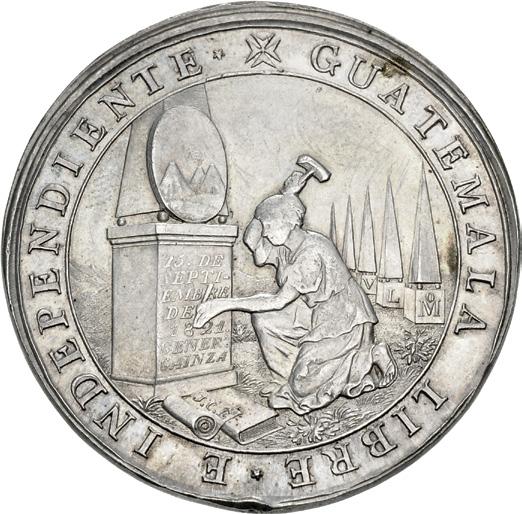


1006. GUATEMALA, Provisonal Advisory Junta. September 1821-January 1822. AR Medal (43mm, 43.42 g, 12h). Declaration of Independence. Nueva Guatemala mint. By José Casildo España. Dated 15 September 1821. + GUATEMALA LIBRE * INDEPENDIENTE *, youth kneeling left, engraving base of obelisk 15 DE/ SEPTI–/ EMBRE/ DE/ 1821/ GENERL/ GAINZA; to lower left, scroll and book; to right, row of columns engraved Mo, L, and V / + EL LIBRE OFRECE PAZ * PERO EL SIERVO JAMAS *, winged Genus right, holding olive branch and separating globes depicting the unclasped hands of the Old and New Worlds. Stickney M51; Prober, Guatemala 230; Fonrobert 7206. Toned, lightly polished, hairlines, edge bumps. Near EF. Rare. Only 100 examples struck in silver. ($1500)
From the Drewry Family Collection. Ex NASCA 58 (10 December 1985), lot 5893.
On the 15th of September 1821, in response to events in Mexico, a group of Guatemalan representatives met in Nueva Guatemala. Led by the governor general, Gambino Gainza, the representatives quickly agreed to follow the path of independence and, that same day, the Captaincy General of Guatemala issued a manifesto declaring their independence from the Spanish crown. A second manifesto was published the following day, organizing a Provisional Advisory Junta to govern until elections could be held.
Among the articles of the second manifesto was one ordering the creation of this medal to commemorate the province’s new independence. Proclamation medals had long been struck in Spanish territories to announce the coronation of a new monarch. This medal represents the earliest continuation of the practice into the republican period. As one of the first republican proclamation medals, the engraver was forced to quickly develop a new iconographic vocabulary. On the obverse, España depicts a youthful figure engraving an obelisk, emblematic of the work needed to establish a new government, while in the background march a row of other obelisks representing the other Spanish possessions. The reverse is even more dramatic. The engraver shows the twin globes of the new and old worlds, long a common symbol of the Spanish empire, but here being physically pulled apart. On each globe is a now-unclasped hand, with the two worlds still reaching out towards one another.
St. Petersburg Technological Institute – Gold Prize Medal




1007. RUSSIA, Empire. Aleksandr II Nikolaevich. 1855-1881. AV Medal (35mm, 43.90 g, 12h). St. Petersburg Technological Institute – Prize medal. By V. Alexeev. Б. М. АЛЕКСАНДРЪ II ИМПЕРАТОРЪ И САМОДЕРЖЕЦЪ ВСЕРОСС, bare head left / * ЗА ОТΛИЧНЬIЕ УСПѣХИ, С.П.Б./ ТЕЖНОΛОГИЧ./ ИНСТИТУТЪ; all within wreath. Diakov 646.2. In NGC encapsulation 6931380-001, graded MS 62. Rare. Top Pop. The only graded example, none at PCGS or in Coin Archives. ($10,000)
From the Drewry Family Collection. Ex Superior 912 June 1978), lot 1231.


1008. RUSSIA, Empire. Aleksandr II Nikolaevich. 1855-1881. AR Medal (78mm, 215.8 g, 12h). Monument to Aleksandr II in Moscow. By A. Griliches. Dated 17 April 1818, 1 March 1881, 1893, and 1898. AЛEKCAHДPЪ II ИMПEPATOPЪ И CAMOДEPЖEЦЬ BCEPOCCIЙCKIЙ/ POДИЛCЯ 17 AПPѣЛЯ 1818 ГOДA CKOHЧAЛCЯ 1 MAPTA 1881 ГOДA, bare head of Aleksandr II left / ИMПEPATOPOMЪ AЛEKCAHДPOMБ III ИMПEPATOPOMЪ HИKOЛAEMЬ II/ ЗAЛOЖEHЪ BЪ1893 ГOЛУ, view of the monument; BЪ KPEMЛѣ MOCKOBCKOMЪ below. Diakov 1261.1. Toned, hairlines, marks. Near EF. Rare. ($1500)
From the Drewry Family Collection. Ex Galerie des Monnaies of Geneva (10 June 1978), lot 3361.


1009. SWEDEN. AV Medal (26mm, 20.30 g, 12h). Nobel Nominating Committee – Sveriges Riksbank Prize in Economic Sciences. By G. Svenson-Lundqvist. Dated 1968, this medal struck 1975. SVERIGES RIKSBANK TILL ALFRED NOBELS MINNE 1968, bare head of Alfred Nobel left; cross cornucipias below / KUNGLIGA VETENSKAPSAKADAMIEN, radiant star surrounded by three crowns with larger crown above. All on textured surface. Edge hallmarks: SPORR 23K A10. In NGC encapsulation 4624989-003, graded MS 67. ($1000)
This medal was presented to members of the nominating committee for the Sveriges Riksbank Prize in Economic Sciences, also known as the Nobel Prize in Economics. The prize in 1975 was won by Drs. Leonid Kantorovich and Tjalling C. Koopmans, for contributions to the theory of optimum allocation of resources.
Notes in italics from Kenneth W. Harl




1010. ANGLO-SAXON, Kings of Kent. Ecgberht. Circa 765-785. AR Penny (16mm, 1.23 g, 10h). Canterbury mint; Udd, moneyer. Struck circa 776-circa 784. ม ቤŻቹቡቤቿቦታ around R / ኂቺቺ within pelleted rectangle; above and below, 1 between spiral and triple pellet ornaments. Chick 87j (this coin); SCBI 67 (BM), 664 (same dies); North 200; SCBC 874. Toned, slight die rust. Good VF. Very rare. ($5000)
Purchased from J. Linzalone. Ex Dix Noonan Webb 30 (16 July 1997), lot 90 (front and back cover coin).
The kings of Kent had close ties to the Frankish court ever since Æthelberht (589-616) received St. Augustine and his forty Benedictine monks and converted to Christianity in 597. Hence, the Kings of Kent were likely the first to adopt the new hammered technology for striking pennies in manner of the deniers of the Carolingian kings.
Ecgberht, King of Kent (765-785) issued many charters and struck the first hammered pennies in England. He fought King Offa of Mercia at the Battle of Otford in 776, and so resisted efforts of Offa to subject Kent. Offa, however, subjected Kent in 785-796. This silver penny is a very important and historical coin.




1011. ANGLO-SAXON, Kings of Kent. Eadberht Praen. Circa 796-798. AR Penny (18mm, 1.34 g, 12h). Three-line type. Canterbury mint; Æthelmod, moneyer. Struck 796-797/8. ዞ¥ዝ / ዛዞ¥ʽ h/ ReX in three lines; triple pellet to lower left / /©/ /Ȯ/ /©/ / 1 ® Ḧዞ⌦ɭ / ዦḦɭḦዝ/ in three lines; triple pellet to lower left. Naismith C2d = EMC 1985.0071 = Blackburn & Bonser, “Single Finds of Anglo-Saxon and Norman Coins – 2,” in BNJ 55 (1985), 71 (this coin); SCBI 67 (BM), 665-6; North 203; SCBC 875. Toned. VF. Very rare. ($7500)
Purchased from J. Linzalone, October 2002. Ex Derek Chick Collection. Found at West Hythe, Kent, 1955.
Eadberht Praen of Kent (796-798) rebelled from the Mercian hegemony with the backing of Charlemagne, but King Coenwulf invaded Kent and re-imposed Mercian rule. Eadberht Praen was captured, deposed, and blinded. Coenwulf, promising to reform the English church, secured from Pope Leo III – who crowned Charlemagne Holy Roman Emperor in 800 – a bull of excommunication of Eadberht Praen.


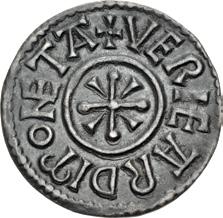

1012. ANGLO-SAXON, Kings of Kent. Cuthred. 798-807. AR Penny (19mm, 1.35 g, 8h). Cross-and-wedges type. Canterbury mint; Wærheard, moneyer. Struck circa 805-807. ม
diademed bust right / ม
, cross pommée, wedges in angles. Naismith C35.1o (this coin); SCBI 67 (BM), 695 (same dies); North 211; SCBC 877. Deep cabinet toning. Good VF. Rare and with an exceptional pedigree. ($5000)
Purchased from J. Linzalone, December 1996. Ex J.P. Linzalone Collection (Stack’s, 7 December 1994), lot 2327; B.R. Noble Collection (Glendining, 11 December 1975), lot 362; Clonterbrook Trust (Glendining, 7 June 1974), lot 1; R.C. Lockett Collection (Part IV, Glendining, 26 April 1960), lot 3546; Glendining (16 November 1937), lot 295.
Cuthred, King of Kent (798-807) succeeded as a vassal of his older brother Coenwulf, King of Mercia. During his reign, the Archbishopric of Canterbury regained its status of primate of England, which had earlier been transferred to the Archbishop of Lichfield by Offa.


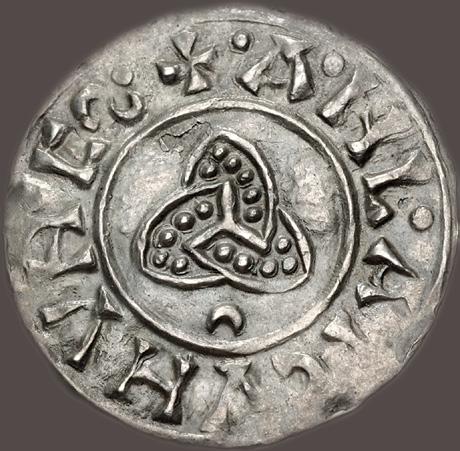





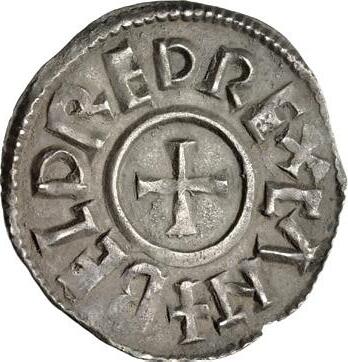



1013. ANGLO-SAXON, Kings of Kent. Baldred. 823/4-825/6. AR Penny (19mm, 1.33 g, 9h). Canterbury mint; Tidbeorht, moneyer. Struck 823/4-825/6. ม ዛዞ⌦ዝʼዞዝ ʼዞҟ ü¨ ñ, short cross / ม Ϳዢዝዛዞ¥ʼዡͿ , cross pattée with one limb fourchée. Naismith C65.2e corr. (this coin; further pedigree erroneous); SCBI 67 (BM), 729 (same rev. die); North 213; SCBC 880. Toned. Good VF. Rare. ($3000)
Purchased from J. Linzalone, May 2001. Ex Numismatic Circular CI.1 (February 1993), no. 121.
Baldred, King of Kent (823-826) seized the throne of Kent after King Ceolwulf I of Mercia, who had ruled Kent directly, was deposed by Beornwulf in 823. Baldred was the last Kentish to strike coins. He was defeated and deposed by King Ecgberht of Wessex. Kent was henceforth incorporated into Wessex.




1014. ANGLO-SAXON, Archbishops of Canterbury. Æthelheard. 792/3-805. AR Penny (18mm, 1.42 g, 9h). With Coenwulf as King. Canterbury mint. Struck 797/8-805. ม
, barred B ʒ in pelleted circle / ม üℽዞn⎍⎍⌦/ዟ ʼዞҟ , M in pelleted circle. Naismith C22.1p (this coin); SCBI 67 (BM), 751-2; North 232; SCBC 886. Toned, faint porosity. Good VF. Very rare. ($3000)
Purchased from Spink, March 2001. Ex Spink Numismatic Circular CVI.10 (December 1998), no. 7275.
Aethelheard, Archbishop of Canterbury (792/3-805), was appointed by King Offa of Mercia but, upon Offa’s death, was exiled by King Eadberht Praen of Kent. Aethelheard was restored to his see in 803 and died as revered defender of the rights of the English church.
The mint at Canterbury struck pennies in the names of both the reigning dominant king and the archbishop in an arrangement in which crown and church shared the profits of coining.



1015. ANGLO-SAXON, Archbishops of Canterbury. Ceolnoth. 833-870. AR Penny (21mm, 1.21 g, 12h). Inscribed Cross type. Canterbury mint; Hebeca, moneyer. Struck circa 854-864. ม üዞɭ⌦nɭ
, tonsured and draped facing bust / ม
n ዞ Ϳ ¨ arranged on limbs of, and around, beaded cross. Naismith C154k = SCBI 20 (Mack), 667 (this coin); North 245; SCBC 894. Rich old cabinet toning, minor edge chip. Near EF. Rare. ($3000)
Purchased from Spink, December 1976. Ex R.P. Mack Collection (Part I, Glendining, 18 November 1975), lot 97; R.C. Lockett Collection (Part IV, Glendining, 26 April 1960), lot 3555; Frank McClean [“Astronomer”] Collection (Sotheby, Wilkinson, & Hodge, 13 June 1906), lot 128; H. Durden Collection (Sotheby, Wilkinson, & Hodge, 20 December 1892), lot 21.
Ceolnoth, Archbishop of Canterbury (833-870) labored to protect the integrity and interests of the English Church in the clash between Mercia to Wessex. He would also be forced to deal with the destruction wrought by the Viking Great Army (865-878).

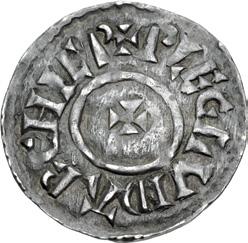
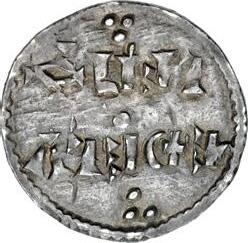
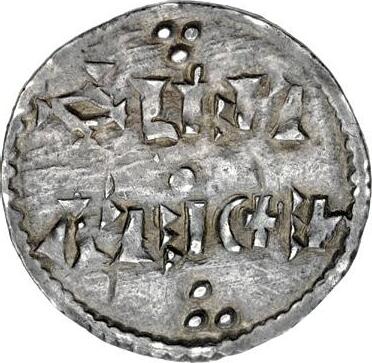
1016. ANGLO-SAXON, Archbishops of Canterbury. Plegmund. 890-914. AR Penny (21mm, 1.41 g, 6h). Contemporary imitation of a Circumscription cross/Horizontal-Trefoil 1 (HT 1) type. Uncertain mint in East Anglia. Struck circa 918-924. ม ዩ⌦ዞűዦ⎍ ë aያ⌐ዢ⌐ዩ , small cross pattée / ®T ዞ⌦⎍ / ⌦ዟ ዦℽ in two lines; three crosses pattée between, trefoils above and below. SCBI 20 (Mack), 671 (this coin); BMC 79 (Plegmund); North 253 (Plegmund); SCBC 900 (Plegmund). Old collection toning. VF. Extremely rare. ($2500)
Ex Numismatic Circular CVIII.3 (June 2000), no. 2293; L. Stack (Sotheby’s, 22 April 1999), lot 266; R.P. Mack Collection, no. 671 (not in Glendining’s sales).
Plegmund, Archbishop of Canterbury (890-914), a noted scholar, shared with King Alfred the Great a commitment to promoting letters and reorganizing ecclesiastical and monastic institutions severely disrupted by the Viking attacks.




1017. ANGLO-SAXON, Kings of Mercia. Offa. 757-796. AR Penny (16mm, 1.13 g, 5h). Light coinage, non-portrait type. Canterbury mint; Eoba, moneyer. Struck circa 785-792/3. ∂ ዟ R Ȯ in angles of a beaded long cross with limbs terminating in As, saltire at center / ģ ∂ ዛ ¥ . Chick 103c = SCBI 20 (Mack), 550 (this coin); North 261; SCBC 904. Deeply toned, flan crack, slightly irregular flan. VF. Exceptionally good metal for an Offa penny. Extremely rare. ($1000)
Ex Classical Numismatic Review XXIV.1 (Fall/Winter 1999), no. 131; L. Stack Collection (Sotheby’s, 22 April 1999), lot 269; R.P. Mack Collection; R.C. Lockett Collection (Part IV, Glendining, 26 April 1960), lot 3573; H.C. Miller (Thomas Elder, 26 May 1920), lot 22.
Offa, King of Mercia (757-796), one of the greatest of Anglo-Saxon Kings, made Mercia the leading power among the English kingdoms. He is remembered for the construction of Offa’s Dyke to mark the border with the Welsh. Offa’s pennies, among the most beautiful of the AngloSaxon coinage, promote the king as a veritable Roman emperor.
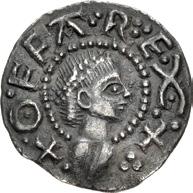


1018. ANGLO-SAXON, Kings of Mercia. Offa. 757-796. AR Penny (16mm, 1.22 g, 5h). Light coinage, portrait type. London mint; Æthelweard, moneyer. Struck circa 785-792/3. /ม/ ∂/ዟዟ¥ ḨʽḨ ዞ/ҏ Ḩ , diademed heart-shaped bust right / /ģč/ Ḩዢ⌦Ḩ ⎍¥ /⌦čḦ , divided by four jewel-like lobes; the inner circle contains a cross botonnée with four petals in saltire. Chick 10d = SCBI 30 (American), 187 = SCBI 20 (Mack), 562 (this coin); North 310; SCBC 905. Old cabinet toning. Good VF. Rare. ($3000)
Purchased from J. Linzalone, December 1995. Ex E.M. Norweb Collection (Part IV, Spink 59, 17 June 1987), lot 1175; Spink Numismatic Circular LXXIX.11 (November 1971), no. 10434; R.P. Mack Collection; V.J.E. Ryan Collection (Part II, Glendining, 22 January 1952), lot 614; A. Mann Collection (Sotheby, Wilkinson, & Hodge, 29 October 1917), lot 133; J. Cove Jones Collection (Sotheby, Wilkinson, & Hodge 6 February 1911), lot 284; T. Thomas Collection (S. Leigh Sotheby & Co., 23 February 1844), lot 134.



1019. ANGLO-SAXON, Kings of Mercia. Cynethryth. Wife of Offa, 757-796. AR Penny (17mm, 1.19 g, 10h). Light coinage, portrait type. Canterbury mint; Eoba, moneyer. Struck circa 784/5. Draped bust right; to left, Latin cross with pellets in angles; Ḩ Ḩ ģ/ℽ/ዛḦ⌃ around / ม ü/Ŋ⌭/⌓ D /⎀Ŋ/ D / ⎀⌓ŻƗ ñ / around M in pelleted circle. Chick 143; SCBI 67 (BM), 657-8; North 339; SCBC 909. Find patina, porosity, marks. VF. Very rare. ($2000)
Purchased from J. Linzalone, December 1999.
Cynethryth, the wife of King Offa of Mercia, was the first and only Anglo-Saxon queen to have her name and image placed on coins. While it has been suggested that these coins were inspired by the appearance of the empress Irene on Byzantine issues, the profile portrait harks back to coinage of Roman augustae. Many details of Cynethryth’s life, such as the date of her marriage, are unknown. She appears to have been active in political affairs until Offa’s death. After her husband’s passing, she became abbess of the monastery of Cookham, where she remained until her death sometime after 798. Cynethryth appears in the hagiography of St. Aethelbert, where she is portrayed as a jealous villain who incites Offa to kill the saint.



1020. ANGLO-SAXON, Kings of Mercia. Coenwulf. 796-821. AR Penny (19mm, 1.33 g, 10h). Cross-and-wedges type. Canterbury mint; Eaba, moneyer. Struck 805-circa 810. ม üɭዞn⎍⎍⌦ዟ
M, diademed bust right / ม ዞ¥ዛ¥ ȮɭnዞͿ¥ , cross pattée with wedges in angles. Naismith C25c (this coin); SCBI 67 (BM), 135; North 344; SCBC 915. Deeply toned. Good VF. Rare. ($3000)
Ex Classical Numismatic Group 38 (6 June 1996), lot 1747.
Coenwulf, King of Mercia (796-821), son of the leading Merican noble Cuthberht and a distant kinsman of Offa, succeeded to the throne when Offa’s only son Ecgfrith prematurely died after a reign of only six months. He reasserted Mercian control over Kent and restored Archbishop Aethelheard to his see of Canterbury.

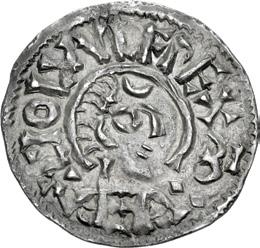


1021. ANGLO-SAXON, Kings of Mercia. Ceolwulf I. 821-823. AR Penny (21mm, 1.36 g, 9h). Portrait type. Rochester mint; Ealhstan, moneyer. Struck circa 810-821. ม üዢɭ⌦⎍⎍⌦ዟ ʼዞҟ M, diademed bust right / ม ዞ©⌦ዡͿ©n Ȯɭnዞ , large Ϳ¥ monogram; pellets around. Naismith R6.1a = SCBI 20 (Mack), 591 (this coin); North 376; SCBC 925. Old cabinet toning. Good VF. Extremely rare. ($6000)
Purchased from J. Linzalone, May 2001. Ex Spink Numismatic Circular XCIX.2 (March 1991), no. 6817; Spink Numismatic Circular XCVIII.9 (November 1990), no. 6817; R.P. Mack Collection; R.C. Lockett Collection (Part I, Glendining, 6 June 1955), lot 380; Lord Grantley Collection (Part III, Glendining, 22 March 1944), lot 587; Sir John Evans Collection; 1874 Delgany Hoard (IBCH 177).
Ceolwulf, King of Mercia (821-823), younger brother of Coenwulf, proved unequal to the task of maintaining the Mercian hegemony over the English south of the Humber River. He was overthrown by Beornwulf.
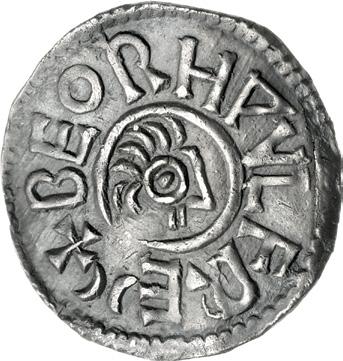



1022. ANGLO-SAXON, Kings of Mercia. Beornwulf. 823-825. AR Penny (20mm, 1.33 g, 12h). Mint in East Anglia (Ipswich?); Eadnoth, moneyer. ม ዛዞɭʼዡዩ⎍⌦ዟ ʼዞ-, , bust right / ม ዞ²ዝዡɭዩ ȮɭዡዞͿ , cross-crosslet. Naismith E23a = SCBI 67 (BM), 272 (same dies); North 397; SCBC 929. Toned, bent, faint porosity. VF. Very rare. ($5000)
Purchased from J. Linzalone, April 2000.
Beornwulf, King of Mercia (823-825), a usurper of obscure background, witnessed the collapse of the hegemony of Mercia. He fell in battle in East Anglia. Thereafter, Mercian kings ruled as regional monarchs and were often subject to the hegemony of the Kings of Wessex.

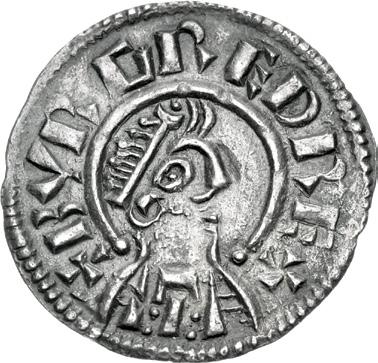

1023. ANGLO-SAXON, Kings of Mercia. Burgred. 852-874. AR Penny (21mm, 1.20 g, 12h). Lunette type. London mint; Wine, moneyer. Phase IIa, struck circa 858/60-866. ม ዛ⎍ʼűʼዞዝ ʼዞม , diademed and draped bust right / ม ⎍⎍ዢnዞ across central field; ዦɭn ዞͿ¥ in lunettes above and below. MacKay H1.34 (dies O2/R2; this coin); cf. SCBI 20 (Mack), 629 (for similar); North 426; SCBC. Old cabinet toning. Good VF. ($1000)
Ex Classical Numismatic Group inventory 712662 (Febraury 2000); L. Stack (Sotheby’s, 22 April 1999), lot 331. Burgred, King of Mercia (852-874), son-in-law of King Aethelwulf of Wessex, faced internal rebellions, raids by the Welsh, and the invasion of the Viking Great Army in 867. He was rescued by his brother-in-law Aethelred I of Wessex. In 874, Burgred, driven into exile by the Vikings, abdicated and retired to Rome. His successor Ceolwulf agreed to partition the kingdom with the Viking invaders.



1024. ANGLO-SAXON, Kings of Mercia. Burgred. 852-874. AR Penny (20mm, 1.25 g, 6h). Lunette type. London mint; Berhthelm, moneyer. Phase III, struck circa 868/70-874. ዛ⎍ʼűʼዞዝ ʼዞ M, diademed and draped bust right / ዛዞʼዡͿ H ⌦ across central field; ዦɭዡ ዞͿ⌃ in lunettes above and below. MacKay H11 (dies –/R2; unrecorded obv. die); SCBI –; North 423; SCBC 942B. Old cabinet toning. Near EF. Rare moneyer. ($1000)
Purchased from Spink, July 1969.




1025. ANGLO-SAXON, Kings of East Anglia. Eadwald. Circa 796-800. AR Penny (19mm, 1.38 g, 9h). Three-line type. Mint in East Anglia (Ipswich?); Eadnoth, moneyer. Struck 796-circa 800. ቤ¥ቺќ between two pelleted lines; ¥ቢቺ above, ʼቤҏ below; all within border of pellets / Long beaded cross with E AD И ◊Ð in quarters; all within quatrefoil. Naismith E2.1d = SCBI 20 (Mack), 673 (same dies); BMC –; North 432; SCBC 947. Find patina, some porosity, scattered marks. VF. Very rare. ($4000)
Purchased from M. Vosper, March 2001.
Eadwald, King of East Anglia (ca. 796-798) briefly reasserted the independence of East Anglia after the death of King Offa of Mercia. He is known only from his coins. King Coenwulf restored Mercian control over East Anglia, which held from 798 to 826.




1026. ANGLO-SAXON, Kings of East Anglia. Æthelstan I. Circa 827-845. AR Penny (20mm, 1.38 g, 8h). Non-portrait type. Mint in East Anglia (Ipswich?); Æthelhelm, moneyer. Struck circa 837/8-845. ม ¥ዞ î ዞ⌦ӲͿ¥n ˃ዞҟ , cross pattée with wedges in angles / ม ¥ዞ î ዞ⌦ዡዞ⌦ ó ó ɭ , cross pattée with wedges in angles. Naismith E42.1f (this coin); SCBI 9 (Ashmolean), 59; North 445; SCBC 951. Peripheral toning. Good VF. Rare. ($1500)
Ex M. Vosper FPL 108 (August 1999), no. 57.
Aethelstan, King of East Anglia (825-845) led the revolt that defeated King Beornwulf and ended the Mercian rule over East Anglia.




1027. ANGLO-SAXON, Kings of East Anglia. Æthelweard. Circa 845-855. AR Penny (21mm, 1.34 g, 2h). Mint in East Anglia (Ipswich?); Twicga, moneyer. ม ዞ î ዞዥVVዞ¥ያዝ
, ‘Omega cross’ in beaded circle / ม ͿʍƗüŲ/¥ ⍫ɭዧ , cross pattée with pellets in angles; all within beaded circle. Naismith E53.1a = Pagan, Coinage p. 70, IV, 1 = SCBI 16 (Norweb), 109 (this coin); North 454; SCBC 953. Mottled golden toning. Good VF. Very rare. With an exceptional pedigree. ($4000)
Ex Spink Numismatic Circular CVII.8 (October 1999), no. 3845; L. Stack Collection (Sotheby’s, 22 April 1999), lot 345; E.M. Norweb Collection (Part III, 19 November 1986), lot 768; Spink Numismatic Circular LXIII.10 (October 1955), no. RCL51; R.C. Lockket Collection (Part I, Glendining, 6 June 1955), lot 415; G.J. Bascom Collection (Sotheby, Wilkinson, & Hodge, 15 June 1914), lot27; A.B. Richardson Collection (Sotheby, Wilkinson, & Hodge, 22 May 1895), lot 21; R. Marsham Collection (Sotheby, Wikinson, & Hodge, 19 November 1888), lot 89.
Aethelweard, King of East Anglia (845-855) does not appear in the Anglo-Saxon Chronicle and is known only from his coins. He appears to have ruled East Anglia independent of the control of either Mercia or Wessex.




1028. ANGLO-SAXON, Kings of East Anglia. Edmund. 855-869. AR Penny (21mm, 1.31 g, 12h). Mint in East Anglia (Ipswich?); Beornferth, moneyer. Struck 855-circa 862. ม ⌓¥ĕዦѝnĕ ˌ⌓ҏ ¥n , cross on base with crosses emanating diagonally from sides / B⌓ɭˌn⌓⌓ˌ î Ȳɭ , cross pattée; pellets in angles. Naismith 56.1v (same dies); SCBI 67 (BM), 930-4; North 459; SCBC 955. Iridescent toning with faint luster, slightly wavy. Near EF. Rare. ($1500)
Purchased from J. Linzalone.
Edmund “the Martyr,” King of East Anglia (855-869) was the last Anglo-Saxon to rule that kingdom. In 865, he was compelled to yield to the demands of the Viking Great Army which wintered in East Anglia and invaded Northumbria the following year. When the Vikings returned in 869, Edmund attempted to oppose the invaders. Though he was defeated and likely slain in battle, legends quickly began to circulate that he had been captured and martyred by the heathens. His remains were translated to Bury-Saint-Edmunds during the reign of King Aethelstan of Wessex.



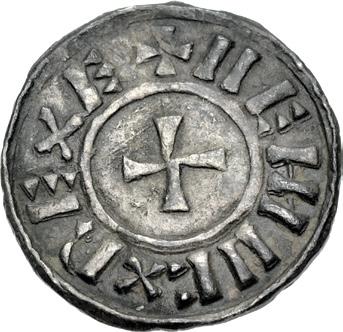
1029. ANGLO-SAXON, Anglo-Viking (Danish East Anglia). St. Edmund memorial coinage. Circa 895-918. AR Penny (19mm, 1.57 g, 4h). Mint in East Anglia (Ipswich?); Heming, moneyer. ส ˟æዞ
ʼዞҟ ዞ , short cross. Blunt, St. Edmund, obv. die 1; SCBI 9 (Ashmolean), 109 (same dies); BMC 428 (same dies); North 483; SCBC 960. Old cabinet toning, slightly wavy flan, some doubling on obverse. VF. Extremely rare variety. ($1500)
Purchased from J. Linzalone.
In 878, King Alfred the Great defeated the Viking Great Army at Edington. The Danish sea king Guthrum submitted to baptism and concluded the Treaty of Wedmore which defined the limits of the Danelaw. Those Danes settling in East Anglia struck coins in honor of the martyred King Edmund, whom they likely viewed as a protective spirit of their new homeland.
Since the discovery of the first example of this variety in the great 1840 Cuerdale Hoard, numismatists have speculated on the meaning of the unusual reverse legend. Rather than naming the moneyer, as is normal on this and most ninth century Viking and Saxon issues, this coin appears to name a king: Heming (Old English) or Hemmingr (Old Norse).
Blunt, in his analysis of the St. Edmund series, records seven examples from three obverse and two reverse dies. To this should be added coins naming “Hamin” with the title moneyer, of which this cataloger has found six examples from two obverse and three reverse dies. The dies of the REX group have significantly degraded legends, while the MON group are clearly better formed and engraved. Also of note, though of unknown significance, both obverse dies associated with the MON group exhibit pellet marks, a feature lacking on the three dies of the REX group.
Although no direct link has been found between the two groups, considering that the St. Edmund series as a whole exhibits a great amount of copying and corruption of the legends, the rare HEMNC REX variety should likely be considered a degeneration of the more standard HAMIN MON legend. Yet, while unlikely, the possibility that Heming was an otherwise-unknown Viking ruler in East Anglia cannot be fully eliminated. As Blunt notes, “Alfred, on his St. Edmund coins, placed his name on what one assumes to be the reverse and one must not be too ready to reject entirely the possibility that we have here the name of a Danish ruler” (p. 244).

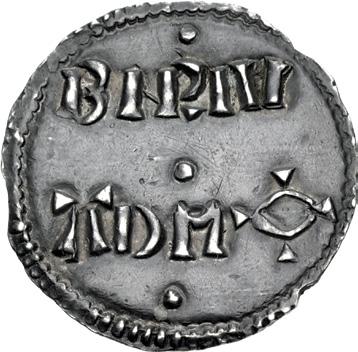
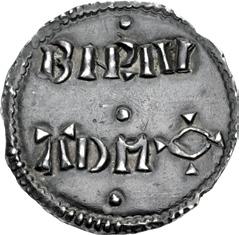
1030. ANGLO-SAXON, Anglo-Viking (Danish Northumbria). Imitations of Alfred the Great. Circa 885-915. AR Penny (20mm, 1.40 g, 12h). Beornweald, moneyer. ⌃üዢዞዝ ม ʏዞม ዝ!ℽʼℽ , small cross pattée / ዛɚዢ⎍ / ¨ዝ ዦℽ in two lines; pellets between. SCBI 4 (Copenhagen), 91 corr. (attribution); cf. BMC 63 (Plegmund); North 475/1; SCBC 966. Old cabinet toning, a few faint marks. EF. ($2000)
Purchased from J. Linzalone, October 2009. Ex Spink 175 (28 September 2005), lot 1314; Spink 16 (9 July 1981), lot 461; P.W.P. CarlyonBritton Collection (Part III, Sotheby, Wilkinson, & Hodge, 11 November 1918), lot 1623.
In the southern regions of the kingdom of Northumbria, where Danes settled in great numbers, the little known Viking kings Cnut and Siefred introduced the hammered silver penny in place of the copper stycas struck by last Anglo-Saxon kings ruling from York. They also coined pennies in imitation of the those of Alfred the Great, such as this example.
The selection of pennies offered in the auction also includes issues with iconography praising Saint Peter, patron of York, and patriarchal crosses (lots 1031 and 1035). The exceeding rare coin of Ragnald (lot 1036) depicts the hand of God and, on the reverse the monogram of Charlemagne. The Danes in the Great Army had earlier plundered the Carolingian Empire and received many Carolingian deniers in tribute or Danegeld. The iconography of these coins document how the ever pragmatic Danes respected the religious beliefs of their English subjects and power of the Archbishops of York. Within two generations, the Danish settlers in the Danelaw transformed themselves from Vikings into Christian landowners.



1031. ANGLO-SAXON, Anglo-Viking (Danish Northumbria). Cnut & Siefred (Sigeferth). Circa 900. AR Penny (18mm, 1.31 g, 5h). Class IIId/Siefredus type. York mint. æ n ⎍Ḷ ͿḶ ʼ ҟ arranged around inverted patriarchal cross with pellets in angles / ๘ ⎄ዢ ዞዟ ʼዞዝ ⎍⎄ , short cross pattée with pellets in first and fourth quarters. SCBI 29 (Merseyside), 365-6 var. (ornaments in obv. legend); BMC 1018/1019-22 (or obv./rev.); North 504; SCBC 996. Old cabinet toning. Good VF. ($1500)
Purchased from York Coins, August 2006. Ex W.C. Boyd Collection (Baldwin’s 42, 26 September 2005), lot 774, purchased from W.S. Lincoln, April 1903.




1032. ANGLO-SAXON, Anglo-Viking (Danish Northumbria). Cnut & Siefred (Sigeferth). Circa 900. AR Penny (18mm, 1.45 g, 5h). Class VIc/‘Mirabile fecit’ type. York mint. ม
, cross pattée; pellets in first and fourth quarters /
ዞæ Ḧ/Ḧ , inverted patriarchal cross, four pellets around upper crossbar. SCBI 29 (Merseyside), 393 (same dies); BMC 1060 var. (rev. legend ornaments); North 512; SCBC 1000. Old cabinet toning, scrape. VF. ($1000)
Purchased from York Coins, August 2006. Ex W.C. Boyd Collection (Baldwin’s 42, 26 September 2005), lot 775, purchased from W.S. Lincoln, April 1903.


1033. ANGLO-SAXON, Anglo-Viking (Danish Northumbria). Cnut. Circa 900-905. AR Penny (20mm, 1.15 g, 6h). Class Is/Ebraice Civitas type. York mint. æ n ⎍ Ϳ ʼḶ ዞḶ ҟ arranged around inverted patriarchal cross with pellets in upper angles / ๘ ዞዛ Ḷ ዢ©ዢ Ḷ æዞ æዢ⎍ , short cross pattée with pellets in first and fourth quarters. SCBI 29 (Merseyside) 214-5 (same rev. die); BMC 893; North 497; SCBC 991. Old cabinet toning, obverse double struck. Good VF. ($1500)
Purchased from J. Linzalone. Ex Keith Smalley Collection (Spink 219, 24 September 2013), lot 115.



1034. ANGLO-SAXON, Anglo-Viking (Danish Northumbria). Cnut. Circa 900-905. AR Penny (19mm, 1.47 g, 2h). Class IIe/Cunneti type. York mint. æ n ⎍ Ϳ ʼḶ ዞḶ ҟḶ arranged around inverted patriarchal cross with pellets in upper angles / ๘ æ⎍Ƀ
, short cross pattée with pellets in second and third quarters. SCBI 29 (Merseyside), 330 (same obv. die); cf. BMC 966 (for similar); North 501; SCBC 993. Richly toned, peck mark. Good VF. ($750)
Purchased from J. Linzalone, June 1980.



1035. ANGLO-SAXON, Anglo-Viking (Danish Northumbria). St. Peter coinage. Circa 905-919. AR Penny (19mm, 1.44 g, 10h). Swordless type, heavy issue. York mint. Struck circa 905-circa 910. ⎄æዢ ዩዞ / ˶ʼዢ ዦ in two lines; pellets above and below, pellet between two lozenges between / ม ዞዛɭʼ©æዢ æዢ⎍ , small cross pattée. SCBI 29 (Merceyside), 417 var. (rev. legend); BMC 1132; North 551; SCBC 1006. Old cabinet toning. Near EF. ($1000)
Purchased from York Coins, August 2006. Ex John Jordan Collection (Triton II, December 1998), lot 1261.




1036. ANGLO-SAXON, Anglo-Viking (Hiberno-Norse Northumbria). Ragnald. Circa 919-920/1. AR Penny (19mm, 1.10 g, 2h). York mint. ม ʼ⍇æዢዢ˶ዢ , open hand / ม ዞዢɭʼ⍇æዢዢ , crude Karolus monogram. EMC 2002.0298 (this coin, since chipped); Blunt & Stewart 5 = SCBI 4 (Copenhagen), 624 (same rev. die); BMC 1084 var. (legends); North 531; SCBC 1010. Find patina, chipped. VF. Extremely rare – only three in CoinArchives, all chipped. ($6000)
Purchased from J. Linzalone, November 2009. Found in Lincolnshire, 2002.
Between 919 and 954, the pagan Hiberno-Norse Kings attempted to forge a kingdom that straddled the Irish Sea, uniting Dublin and York. These Norwegians minted extraordinary pennies depicting pagan symbols, including the sword of Odin and Hammer of Thor (lot 1037), the raven of Odin (lot 1038), struck by Analf Guthfrithsson (Old Norse Olaf Guthfrithson), and the triquetra banner (lot 1039) struck by Anlaf Curaran Sithricsson (Old Norse Olaf Kvaran Sigtryggson).

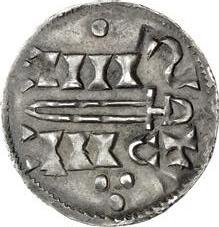

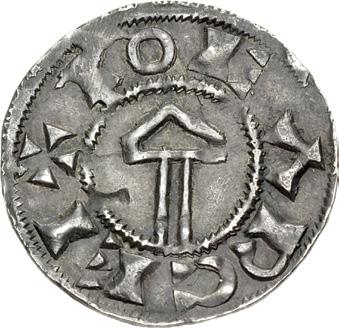
1037. ANGLO-SAXON, Anglo-Viking (Hiberno-Norse Northumbria). St. Peter coinage. Circa 921-927. AR Penny (19mm, 1.23 g, 3h). Sword type, heavy issue. York mint. Struck circa 905-circa 910. c ዢዢዢ˝ /c ዢዢæ˶ in two lines, voided sword and cross between; pellet above, triple pellet below / ม ዢɭዞ ©ʼæዞዢ , voided hammer. Stewart & Lyon 35 (this coin); SCBI 29 (Merseyside), 430-1 var. (legends); BMC –; North 556; SCBC 1015. Rich old cabinet toning. VF. Very rare type and an extremely rare variety. The sole example recorded by Stewart & Lyon. ($7500)
Ex R. Schraeder (Classical Numismatic Group 78, 14 May 2008), lot 2133; Classical Numismatic Auctions XX (25 March 1992), lot 1200; B. Bird Collection (Glendining, 20 November 1974), lot 81; Lord Grantley Collection (Part III, Glendining, 22 March 1944), lot 965.
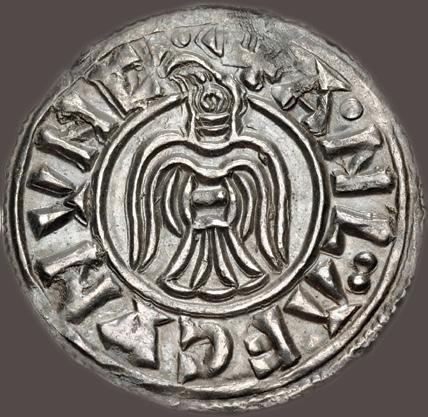



1038. ANGLO-SAXON, Anglo-Viking (Hiberno-Norse Northumbria). Anlaf Guthfrithsson. 939-941. AR Penny (20mm, 1.23 g, 1h). York mint; Athelferd, moneyer. ม ²/n⌦//©ዟ æ⎍n⎍næ / , raven with wings displayed, head left / ม ²/ T ዞ⌦/ ዟዞʼዝ ዦዢዡዞ˶ , small cross pattée. CTCE group IV; cf. SCBI 34 (BM), 1237-43 (for type); North 537; SCBC 1019. Toned. EF. Very rare. ($15,000)
Purchased from J. Linzalone. Ex St. James 24 (23 September 2013), lot 9.
A remarkable coin struck by Anlaf in York, after he seized the Northumbrian kingdom on the death of Aethelstan in 939. Described by Grierson’s protégé Mark Blackburn as ‘one of the most dramatic coin designs in the English series,’ on the obverse we find a raven with outstretched wings, a classic Viking symbol. This symbolism could, according to Blackburn, dually also serve in a Christian context. For, “the raven is [also] associated with Saint Oswald (a Northumbrian royal saint) ... [Thus one] can speculate whether the designers were subtly appealing to a dual audience.”



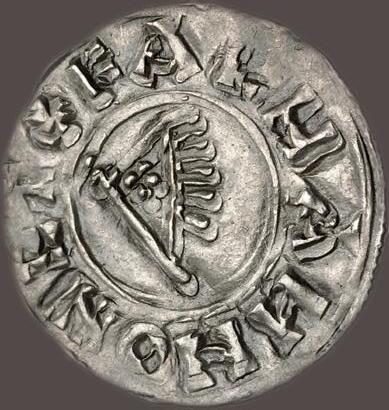
1039. ANGLO-SAXON, Anglo-Viking (Hiberno-Norse Northumbria). Anlaf Sithtricsson (Cuaran). First reign, 941944/5. AR Penny (19mm, 1.10 g, 5h). Triquetra type. York mint; Farmann, moneyer. ม ²/n⌦/²ዟ æ⎍n⎍næ˝ / , triquetra; crescent below / ม ዟ²ʼዡ²Ƀ ዡɭɃዞ˶ , fringed triangular standard bearing ‘X’ on cross-tipped pole. CTCE Group V; cf. SCBI 34 (BM), 1248-52 (for type); North 540; SCBC 1020. Toned, double struck. Good VF. Very rare. An unrecorded variety with the crescent on obverse. ($10,000)
Purchased from J. Linzalone.
Anlaf Cunran, better known by his Norse name Olaf Kvaran, was driven out of York by the adventurer Erik the Bloodax, the son of King Harald Finehair of Norway. Olaf Kvaran thereafter ruled as King of Norse Dublin where (945-980). In the confusing fighting over York between these pagan Hiberno-Norse and the Christian Kings of Wessex, the Danish settlers eventually came to realize that they had far more in common with their fellow Christian English neighbors than they did with the Norwegian interlopers. So, in 955, the Danes of York accepted as their king, Eadwig of Wessex.




1040. ANGLO-SAXON, Kings of Wessex. Ecgberht. 802-839. AR Penny (20mm, 1.44 g, 9h). DOROB-C type. Canterbury mint; Oba, moneyer. Struck circa 828-839. ม ዞüűዛዞ©ʼ
, diademed and draped bust right / ม ɭዛ© ዦɭnዞͿ© , Dorob(ernia) C(ivitas) monogram. Naismith C85d = SCBI 16 (Norweb), 130 (this coin); North 573; SCBC 1035. Toned. Good VF. Rare. A superb example with an extensive pedigree. ($6000)
Ex Davissons 15 (29 March 2001), lot 178; J.P. Linzalone Collection (Stack’s, 7 December 1994), lot 2346; E.M. Norweb Collection (Part I, Spink 45, 13 June 1985), lot 43; H.C. Curwen Collection (Glendining, 30 September 1959), lot 82; R.C. Lockett Collection (Part III, 4 November 1958), lot 2688; Spink Numismatic Circular XXX.11-12 (November-December 1922), no. 11954; Spink Numismatic Circular XXVI.11-12 (November-December 1918), no. 67287 (’a perfect coin’); E.W. Rashleigh Collection (Sotheby, Wilkinson, & Hodge, 21 June 1909), lot 202; Earl of Pembroke († 1733) Collection (S. Leigh Sotheby, 31 July 1848), lot 36.
Ecgberht (802-839), King of Wessex was driven into exile by Offa, but in 802 returned from the Frankish court to regain his throne. He ended the Mercian hegemony and made Wessex the leading kingdom in England.

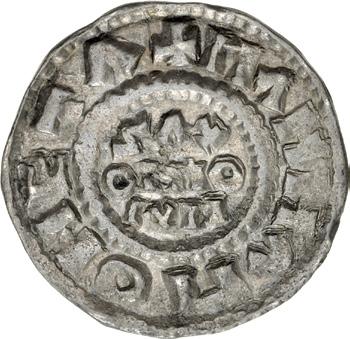

1041. ANGLO-SAXON, Kings of Wessex. Æthelwulf. 839-858. AR Penny (20mm, 1.38 g, 8h). Saxoniorvm type. Canterbury mint; Manna, moneyer. Struck 839-circa 844. ม ዞ T ዞ⌦⎍⎍⌦/ዟ ʼዞҟ , cross pattée over cross pattée in saltire / ม ዦ©nn© ዦɭnዞͿ© , Ӳ©ҟ / ɭnዢɭ / ʼ⎍ዦ in three lines. Naismith C100m; SCBI 67 (BM), 1102; North 596; SCBC 1044. Toned. Good VF. Rare. ($2500)
Ex Classical Numismatic Group inventory 712908 (Spring 1999); L. Stack Collection (Sotheby’s, 22 April 1999), lot 393; Glendining (27 May 1987), lot 362.
Aethelwulf (839-858), King of Wessex and son of Ecgberht, sealed a marriage alliance with King Burgred of Mercia, which later proved decisive in checking the Viking Great Army. A pious man, he not only consolidated royal power, but also managed to make a pilgrimage to Rome in 855-856. He willed to his sons Æthelbald (858-860) and Æthelberht (860-865) the Kingdoms of Wessex and Kent, respectively. The realms were united on Aethelbald’s premature death.



1042. ANGLO-SAXON, Kings of Wessex. Æthelwulf. 839-858. AR Penny (21mm, 1.32 g, 12h). First Portrait type. Canterbury mint; Osmund, moneyer. Struck circa 844-849. ม ዞ/ T ዞ⌦⎍/⎍⌦ዟ ʼዞ , diademed and draped bust right / ม ɭӲዦ⎍ዡዝ
H Ϳ© , cross pattée over cross pattée in saltire. Naismith C116.1b = SCBI 16 (Norweb), 136 (this coin); North 612; SCBC 1047. Old cabinet toning, minor deposits. VF. Rare. ($3000)
Ex Classical Numismatic Group inventory 712907 (Spring 1999); L. Stack Collection (Sotheby’s, 22 April 1999), lot 396; E.M. Norweb Collection (Part IV, Spink 59, 17 June 1987), lot 136; A.S. Napier Collection (Sotheby, Wilkinson, & Hodge, 3 August 1916), lot 87.




1043. ANGLO-SAXON, Kings of Wessex. Æthelwulf. 839-858. AR Penny (22mm, 1.27 g, 3h). DORB/CANT type. Rochester mint; Manning, moneyer. Struck circa 849-854. ม ዞ T ዞ⌦ม⎍⎍⌦ዟ
, DOR–B– arranged in circle / ม ዦ¥nnዢnü ዦɭɉͿ¥ , CANT– monogram. Naismith R35c corr. (photos for R36 swapped with R35) = SCBI 16 (Norweb), 131 (this coin); North 614; SCBC 1049. Old cabinet toning. Good VF. Rare. ($3000)
Ex J. Jordan Collection (Triton II, 1 December 1998), lot 1261; E.M. Norweb Collection (Part I, 13 June 1985), lot 46, purchased from Spink, May 1980; H.C. Curwen Collection (Glendining, 30 September 1959), lot 84; R.C. Lockett Collection (Part III, Glendining, 4 November 1958), lot 2694; H.C. Miller (Thomas Elder, 26 May 1920), lot 62; Frank McClean [“Astronomer”] Collection (Sotheby, Wilkinson, & Hodge, 13 June 1906), lot 143; H. Montagu Collection (Sotheby, Wilkinson, & Hodge, 18 November 1895), lot 471; W. Brice Collection (purchased en bloc by H. Montagu, 1887); J.B. Bergne (Sotheby, Wilkinson & Hodge, 20 May 1873), lot 140.




1044. ANGLO-SAXON, Kings of Wessex. Æthelwulf. 839-858. AR Penny (21mm, 1.26 g, 3h). Inscribed Cross type. Canterbury mint; Wærmund, moneyer. Struck circa 854-858. ม ¨ዞ T ዞ⌦⎍⎍⌦ዟ ʼዞҟ , draped bust right / ม ⎍ዞʼዦ⎍ nዝ ዦɭ n ዞ ˸ ¨ arranged on limbs of, and around, beaded cross. Naismith C148c = SCBI 20 (Mack), 718 (this coin); North 618; SCBC 1051. Toned. Near EF. ($3000)
Ex Classical Numismatic Group inventory 712659 (Spring 1999); L. Stack Collection (Sotheby’s, 22 April 1999), lot 399; Spink Numismatic Circular XCI.2 (March 1983), no. 1040; R.P. Mack Collection, purchased from Spink, 1955; Duke of Argyll Collection.
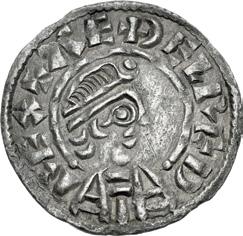


1045. ANGLO-SAXON, Kings of Wessex. Æthelred I. 865/6-871. AR Penny (20mm, 1.07 g, 4h). Lunettes type. Canterbury mint; Leofing, moneyer. Struck circa 867-871. ม ¨ዞ
diademed and draped bust right / ⌦ዢ¨ዛዢ
across central field; ዦɭn ዞ˸¨ in lunettes above and below. Lyons & MacKay, Group 2, Ae2.83 (dies B/b; this coin); SCBI 67 (BM), 1344-5; North 622; SCBC 1055. Old cabinet toning. Good VF. Rare. ($4000)
Purchased from James King, May 1977. Ex Clonterbrook Trust (Glendining, 7 June 1974), lot 29; R.C. Lockett Collection (Part IV, 26 April 1960), lot 3628; Spink Numismatic Circular XXVI.7-8 (July-August 1918), no. 64610; W.M. Maish Collection (Sotheby, Wilkinson & Hodge, 25 March 1918), lot 23.
Aethelred I (865/6-871), King of Wessex, was the third son of Aethelwulf and successor to his older brother Aethelberht. He fought heroically against the Danish Great Army in 870-871. Despite his victory over the Danes at Reading, he suffered two subsequent defeats and died, leaving to his brother Alfred the crown and the negotiations necessary to buy off the Viking invaders with the payment of Danegeld.

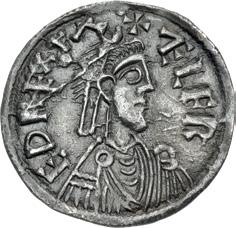


1046. ANGLO-SAXON, Kings of Wessex. Alfred the Great. 871-899. AR Penny (19mm, 1.47 g, 2h). Cross and Lozenge type. Winchester(?) mint; Dunna, moneyer. Struck circa 875-880. ม ® ⌦ዟʼ ዞዝ ʼዞҟ Ӳ¨ , diademed and draped bust right / ዝ⎍n n¨ / ዦɭn ዞ˸¥ , cross pattée within lozenge over long beaded cross; crossbars at lozenge ends. Watlington Hoard 171 (dies Clo113/CLr127); Blackburn & Keynes 42-3 var. (legends); SCBI 67 (BM), 1430 var. (same); North 629; SCBC 1058. Deep cabinet toning, scratch. Near EF. Extremely rare. Only two known to Blackburn & Keynes in 1998, with an additional two in the Watlington Hoard. ($15,000)
Purchased from J. Linzalone, April 2000. Ex Patrick Finn inventory, 1990s.
Alfred the Great (871-899), King of Wessex, succeeded his brother Aethelred I and bought a respite so that he could strengthen Wessex against future Danish attacks. He is the only English monarch to ever earn the epithet “the Great.” Alfred implemented legal, administrative, and military reforms that ensured that his successors would unite all England and end the Danish threat. A scholar, he translated into English Boethius’ Consolation of Philosophy and, in tandem with his biographer Bishop Asser, sponsored a general revival of letters and arts in England. In 878, he negotiated the Treaty of Wedmore dividing England into an expanded Kingdom of Wessex and the Danelaw. In 880, Alfred recaptured London, and in celebration struck splendid pennies bearing the city’s monogram.
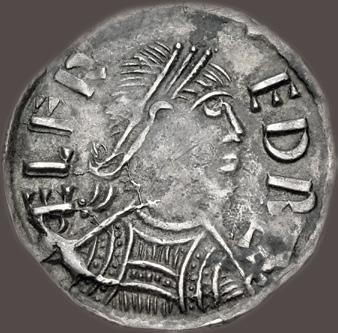



1047. ANGLO-SAXON, Kings of Wessex. Alfred the Great. 871-899. AR Penny (19mm, 1.60 g, 12h). London monogram type. London mint; Tilwine, moneyer. Struck circa 880. ® ዥዟያ ዞዝ ያዞҢ , diademed and draped bust right / ͻዢዥ⌓ќዢɉ
above and below Londonia monogram flanked by small crosses pattée. Mackay, London B3, 10.3 (dies O3/R9; this coin); SCBI 20 (Mack), 737 (same dies); BMC 116; North 646; SCBC 1062. Toned. Good VF. Very rare. ($10,000)
Ex Classical Numismatic Review XVIII.4 (Fourth Quarter 1993). no. 346; T.E. Nield Collection (Glendining, 8 September 1993), lot 421; Spink Numismatic Circular XCIV.5 (June 1986), no. 3970; H.A. Parsons (Glendining, 11 May 1954), lot 134.
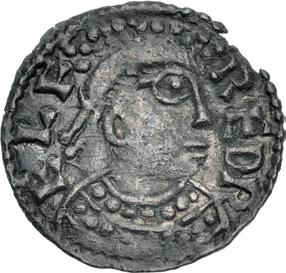



1048. ANGLO-SAXON, Kings of Wessex. Alfred the Great. 871-899. AR Halfpenny (15mm, 0.52 g, 8h). London monogram type. London mint. Struck circa 880. ዞዥዟ ያዞዝ ያ , diademed and draped bust right; row of pellets above / Londonia monogram; small crosses above and below; pellet to left. Cf. MacKay, London Ie, unlisted dies; cf. SCBI 42 (South-Eastern), 758 (for similar); North 645; SCBC 1063. Deeply toned, edge chip. Near EF. Very rare. ($2500)
Purchased from J. Linzalone, December 1996. Ex J. Linzalone Collection (Stack’s, 7 December 1994), lot 2354.



1049. ANGLO-SAXON, Kings of Wessex. Alfred the Great. 871-899. AR Penny (20mm, 1.49 g, 12h). Two-line (’Guthram’) type (BMC xiv). Winchester dies; Æthelræd, moneyer. Struck circa 880-899. ©ዞ⌦ ዟʼዞ ዝ ʼዞҟ , small cross pattée / ®T ዞʼ / ዞዝ ዦɭ in two lines; three crosses between. SCBI 26 (East Anglia), 66 (same dies); North 639; SCBC 1067. Richly toned. Good VF. Rare. ($3000)
Purchased from C.H. Wolfe, August 1975. Ex Lord Grantley Collection (Part III, 22 March 1944), lot 1011; J.G. Murdoch Collection (Sotheby, Wilkinson & Hodge, 11 May 1903), lot 90; H. Montagu Collection (Sotheby, Wilkinson, & Hodge, 18 November 1895), lot 560; R.W. MarshamTownsend Collection (Sotheby, Wilkinson, & Hodge, 19 November 1888), lot 150.
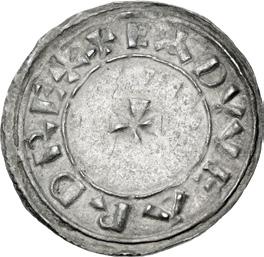

1050. ANGLO-SAXON, Kings of Wessex. Edward the Elder. 899-924. AR Penny (22mm, 1.61 g, 5h). Small cross/ Horizontal-Pellet 1 (HP 1) type (BMC ii). Wessex dies; Ragnulf, moneyer. Middle period II, circa 910-915. ม ዞ²ዝ⎍⎍ዞ²ʼዝ ʼዞҟ , small cross pattée / ʼ ® űዞn / ⎍⌦ዟ ዦ∂ in two lines; three crosses between. CTCE 248iii = Vatican Hoard 325 (possibly this coin?); North 649; SCBC 1087. Toned. Good VF. ($1000)
Edward the Elder (899-924), King of Wessex was the son of Alfred the Great. It was under him that the Anglo-Saxons initiated their reconquest of the Danelaw. He incorporated East Anglia, and in 918, united the crowns of Mercia and Wessex into the nucleus of the future Kingdom of England. Edward is remembered as valiant king and warrior with little interest in the scholarly pursuits of his father.

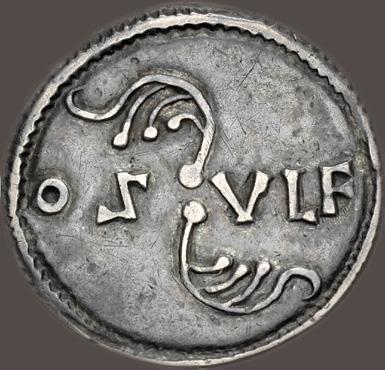

1051. ANGLO-SAXON, Kings of Wessex. Edward the Elder. 899-924. AR Penny (21mm, 1.57 g, 6h). Botanical type (BMC ix). Mercian Northwest dies; Asulfr, moneyer. Middle period I, circa 910-915. ม ዞ©ዝ⎍⎍ዞ©ʼዝ ʼዞҟ , small cross pattée / Two branches; ɭӲ ⎍⌦ዟ across field. CTCE 329c (this coin); SCBI –; BMC 105; North 659; SCBC 1079. Old cabinet toning. VF. Extremely rare – one of only four listed in CTCE. ($15,000)
Purchased from J. Linzalone. Ex L. Stack Collection (Sotheby’s, 22 April 1999), lot 454; P. Nelson Collection; Lord Grantley Collection (Part III, 22 March 1944), lot 1011; H. Montagu Collection (Sotheby, Wilkinson, & Hodge, 18 November 1895), lot 591; W. Brice Collection (collection acquired en block by Montagu in 1887); E. Wigan Collection (acquired by Rollin & Feuardent in 1872); Joseph Barratt Collection; T. Dimsdale Collection (Sotheby, 6 July 1824), lot 607.
Under Edward the Elder, a limited number of coins were struck that stand out from the usual cross or two line types generally in vogue at the time. Usually depicting a tower (or possibly a church or reliquary) or a botanical design, the exact reason for these charming types is today unknown. Regardless, they are justifiably popular among collectors and would form the centerpiece of any collection of 10th century English coins.
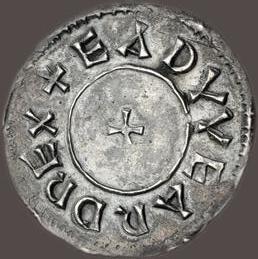


1052. ANGLO-SAXON, Kings of Wessex. Edward the Elder. 899-924. AR Penny (22mm, 1.55 g, 2h). Church tower type (BMC ix). Mercian Northwest dies; Eadmund, moneyer. Middle period I, circa 910-915. ม ዞ²ዝ⎍⎍ዞ²ʼዝ
, small cross pattée / Façade of a Saxon church tower (or reliquary?); EA DV/M ND in two lines across field. CTCE 320k (this coin); SCBI 4 (Copenhagen), 687; BMC 109; North 666; SCBC 1083. Toned, a few faint deposits. Near EF. Extremely rare. ($10,000)
Ex Classical Numismatic Review XX.2 (Summer 1995), no. 832; Spink Numismatic Circular XC.9 (November 1982), no. 8139.



1053. ANGLO-SAXON, Kings of Wessex. Edward the Elder. 899-924. AR Penny (22mm, 1.56 g, 3h). Botanical type (BMC ix). Mercian West dies; Heremod, moneyer. Middle period II, circa 910-915. ม ዞ²ዝ⎍⎍ዞ²ʼዝ ʼዞҟ , small cross pattée / Flower with arching leaves set on groundline terminating in rosettes; in exergue, ዡዞʼዞዦɭዝ over rosette. CTCE 341c = Blunt & Stewart B5 (this coin); SCBI 9 (Ashmolean), 314; cf. BMC 102 (for similar); North 658; SCBC 1078. Old collection toning. Near EF. Extremely rare – only four specimens listed in CTCE, plus three more in EMC. ($15,000)
Purchased from J. Linzalone. Ex L. Stack Collection (Sotheby’s, 22 April 1999), lot 457; Sotheby’s (28 May 1987), lot 331; Samuel Birchall of Leeds Collection (1761-1814); 1807 Bossal Hoard.



1054. ANGLO-SAXON, Kings of Wessex. Æthelstan. 924-939. AR Penny (23mm, 1.62 g, 6h). Small cross/HorizontalTrefoil 1 (HT 1) type (BMC i). North-Eastern I dies; Winele, moneyer. ®T ዞ⌦ӲͿ²n ʼዞҟ , small cross pattée / ዩዢnዞ / ⌦ዞ ዦɭ in two lines; three crosses between, trefoil above and below. Blunt, Aethelstan 408; SCBI 34 (BM), 234-6; North 668; SCBC 1089. Richly toned. VF. ($1000)
Purchased from C. Wolfe, April 1975.
Aethelstan (924-939), King of Wessex, succeeded his father Edward the Elder. Aethelstan was the first king of Wessex to style himself on his coins rex totius Britanniae – “King of all Britain” – after King Constantine II of Alba (Scotland), King Hywel Dda of Deheubarth (Wales), Earl Ealdred of Bamburgh (Northumbria), and King Owain of Strathclyde all accepted Aethelstan as their overlord at Eamont on 12 July 927.


1055. ANGLO-SAXON, Kings of Wessex. Æthelstan. 924-939. AR Penny (23mm, 1.47 g, 6h). Circumscription Cross type (BMC v). Chester mint; Paulus, moneyer.
, small cross pattée / ม
, small cross pattée. Blunt, Aethelstan 150; SCBI 34 (BM), 63 (same dies); North 672; SCBC 1093. Old collection toning, a few light scratches. Good VF. ($2000)
Ex A.F. Lovejoy Collection (Stack’s, 2 December 1997), lot 1431; Massachusetts Historical Society/Adams Family Collection (Stack’s, 5 March 1971), lot 844.



1056. ANGLO-SAXON, Kings of Wessex. Æthelstan. 924-939. AR Penny (21mm, 1.22 g, 7h). ‘Church’ type (BMC iv). York mint; Adalbert, moneyer. ²ዞዝዞӲͿ²n ʼҟ (three triangles), small cross pattée / Steep-roofed building on ground line; ዦɭ n flanking, ²ዝዞ⌦ዛዞʼͿ over trefoil in exergue. Blunt, Aethelstan 439 (this coin illustrated); SCBI –; North 683; SCBC 1100 (plate coin in previous editions). Deeply toned. VF. Extremely rare. ($7500)
Ex M.A. Sinton Collection (Triton III, 30 November 1999), lot 1477; P. Finn FPL (Winter 1994/95), no. 47; R.C. Lockett Collection (Part IV, Glendining, 26 April 1960), lot 3683; L.E. Bruun Collection (Sotheby & Co., 14 May 1925), lot 93; P.W.P. Carlyon-Britton Collection (Sotheby, Wilkinson, & Hodge, 19 November 1913), lot 377.
The Tower type of Aethelstan is unparalleled in his coinage. Christopher Blunt posited that it may have been an ecclesiastical issue, struck for Hrothweard, Archbishop of York, between Aethelstan’s capture of the city in 927 and the Archbishop’s death in 931. If this is the case, the tower on the reverse is likely to be a depiction of York Minster.
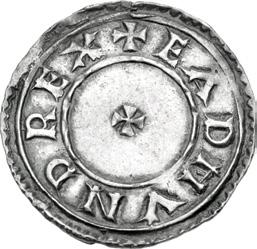


1057. ANGLO-SAXON, Kings of Wessex. Eadmund. 939-946. AR Penny (21mm, 1.61 g, 9h). Horizontal-Trefoil 1 (HT 1) type (BMC i). Winchester(?) mint; Otic, moneyer. ม ዞ²ዝዦ⎍nዝ ʼዞҟ , small cross pattée / ɭͿዢüม / ዦɭnዞ in two lines; three crosses between, trefoil above and below. CTCE 74; SCBI 34 (BM), 328-9; North 688; SCBC 1105. Toned. Near EF. ($1000)
Ex Seaby Coin & Medal Bulletin 685 (September 1975), no. H5179.
Edmund (939-946), the son of Edward the Elder and his third wife, Queen Eadgifu, succeeded his half-brother and issued numerous charters and three law codes. He faced challenges from the Hiberno-Norse sea kings of Dublin who battled to secure York.




1058. ANGLO-SAXON, Kings of Wessex. Eadred. 946-955. AR Penny (21mm, 1.33 g, 3h). Bust Crowned (BC) type (BMC v). Mint in East Anglia(?); Æthelweard, moneyer. ม
, crowned and draped bust right / ม © T ዞ⌦Vዞʼ T ዦɭɉͿ© , small cross pattée. CTCE 235; SCBI 34 (BM), 695; North; SCBC. EF. Rare. ($5000)
Ex Classical Numismatic Group 36 (5 December 1995), lot 1454.
Eadred (946-955), King of Wessex, succeeded his older brother Edmund, but he suffered from ill health and failed to regain control of York from the Hiberno-Norse.

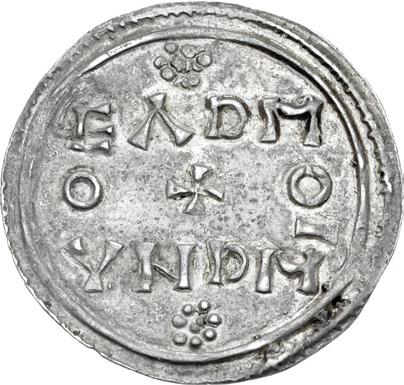

1059. ANGLO-SAXON, Kings of Wessex. Eadred. 946-955. AR Penny (22mm, 1.42 g, 4h). Horizontal-Rosette 2 (HR 2) type (BMC i). Mint in the northwest(?); Eadmund, moneyer. ม ዞ©ዝʼዞዝ ʼዞҟ , small cross pattée / ዞ©ዝዦ / ⎍nዝ ዦɭ in two lines; cross pattée flanked by annulets between, rosettes above and below. CTCE 192; SCBI 34 (BM), 651 (same dies); North 708; SCBC 1113. Old cabinet toning. Good VF. ($1000)
Purchased from F. Weber, December 1974.



1060. ANGLO-SAXON, Kings of Wessex. Eadwig. 955-959. AR Penny (21mm, 1.45 g, 2h). Horizontal-Trefoil 1 (HT 1) type (BMC i). York mint; Heriger, moneyer. ม ዞ©ዝዩዢű ʼዞม O, small cross pattée / H ʼዢű / ዞʼ ዦɭ in two lines; three crosses between, quatrefoil above, trefoil below. CTCE; SCBI 34 (BM), 793 (same dies); North 724; SCBC 1122. Richly toned. Good VF. ($2500)
Ex Coin Galleries (17 April 1975), lot 1482.
Eadwig All-Fair (955-959), son of King Edmund and his first wife Aelfgifu and great-grandson of Alfred the Great, was proclaimed king of all England at his accession on 23 November 955.



1061. ANGLO-SAXON, Kings of All England. Edward the Martyr. 975-978. AR Penny (2020mm, 1.42 g, 3h). Sole type (BMC i). Derby mint; Grimm, moneyer. ม ዞ©ዝዩ©ʼዝ ʼዞҟ nű⌦ j, diademed and draped bust left / ม
, small cross pattée. Jonsson p. 131-2; SCBI –; BMC –; Hild –; North 763; SCBC 1142. Old cabinet toning. EF. Extremely rare. Jonsson records only a single example, likely this coin. ($6000)
Ex R.C. Lockett Collection (Part IV, Glendining, 6 April 1960), lot 3715, purchased from Spink; Barnardiston Collection (dispersed 1930).
Edward the Martyr (975-978), King of England, was the elder son of King Eadgar (959-978), an effective ruler and patron of monastic reform. Edward succeeded to the throne at the age of thirteen or fourteen and was murdered under obscure circumstances. His half-brother and successor Aethelred II (978-1016) was widely believed to have been involved in the crime.




1062. CELTIC, Atrebates & Regni. Uninscribed. Circa 50-40 BC. AV Stater (17mm, 5.74 g, 3h). Climping type. Devolved head of Apollo with floral scepter bisecting laurel; wings flanking scepter head, crescent face to lower left, harp shape to lower right / Horse left; sea-horse shapes and pellets-in-annulets around. Bean –; ABC 524; Van Arsdell –; SCBC 33A. Minor traces of die rust. EF. An unusually well centered and struck example. Very rare. ($2000)



1063. CELTIC, Atrebates & Regni. Commius. Circa 45-30 BC. AV Stater (16mm, 5.48 g, 12h). Commios Muzzles type (Atrebatic C). Devolved head of Apollo right, with two ‘hidden face’ motifs / Celtic horse right; remains of charioteer’s arms above, wheel below; COÂ-ÂiOÍ along right edge from below. Sills, Divided Kingdoms: The Iron Age Gold Coinage of Southern England (Alysham, Norfolk, 2017) p. 329 (this coin cited) = CCI 12.0344 (this coin); Bean COM1-3; Van Arsdell 350-1; ABC 1022; SCBC 65. Minor edge splits, some obverse die wear. VF. ($750)
Ex Heritage 231917 (25 April 2019), lot 64001; Künker 312 (8 October 2018), lot 1683; Chris Rudd eAuction 157 (18 March 2018), lot 11; Matthew Rich Collection (Dix Noonan Webb 97, 7 December 2011), lot 67, purchased from Chris Rudd, November 1998.

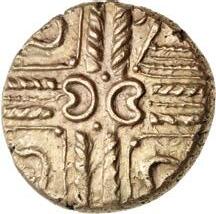


1064. CELTIC, Trinovantes & Catuvellauni. Uninscribed. Circa 60-20 BC. AV Stater (18mm, 5.49 g, 6h). Middle Whaddon Chase, Pole Wheel type (Trinovantian E). Mint in the Essex area. Devolved head of Apollo right in the shape of crossed wreaths; opposed crescents at center; pellet in arc in three quarter, cloak in one / Horse right with two annulets on body; wheels above and below, uncertain W-shaped ornament above, pellets-in-annulets around. ABC 2240; Van Arsdell 1491-1; SCBC 32. Small scuff. EF. Very rare. Finer and with a superior strike to the ABC plate coin. ($1000)



1065. CELTIC, Trinovantes & Catuvellauni. Uninscribed. Circa 60-20 BC. AV Stater (17mm, 5.55 g, 12h). Middle Whaddon Chase, Curved Wreath type (Trinovantian E). Devolved head of Apollo right in the shape of crossed wreaths, one curved, opposed crescents at center / Horse leaping right; solid crescents and pellets above, pellet-in-annulet below. ABC 2445; Van Arsdell 1493-1; SCBC 32. Minor marks. EF. ($1000)
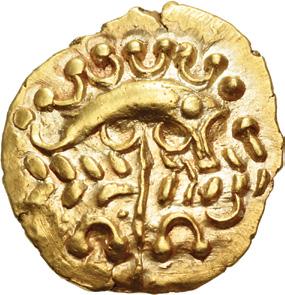



1066. CELTIC, North-Eastern series (‘Corieltauvi’). Uninscribed. Circa 60-20 BC. AV Quarter Stater (15mm, 1.41 g, 6h). Unpublished scyphate type. Schematic boar right over celticized wreath; two torques below / Celticized horse right; pellets-in-annulets around. Unpublished and unique. A few minor marks. EF. ($5000)
Found near Wragby, Lincolnshire, June 2022.
The designs on this unique and newly discovered quarter stater display influence from both the Corieltauvian scyphate issues, which used the boar-type on the obverse, and the early North-East coast staters, with a horse design on the reverse.




1067. ANGLO-SAXON, Continental Sceattas. Circa 715-800/20. AR Sceatt (11mm, 1.05 g, 9h). Series X, type 31. Ribe mint. ‘Wodan’ head facing; pellet above, short cross pommée to left and right / Fantastic creature flying left, head right, with tail coiled leftward; short cross below head. Abramson 104.10; MEC 8 Series X; North 116; SCBC 797. Toned. Near EF. ($1500)
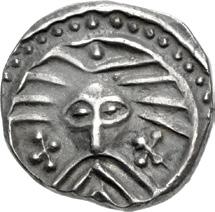



1068. ANGLO-SAXON, Continental Sceattas. Circa 715-800/20. AR Sceatt (12mm, 1.04 g, 12h). Series X, type 31. Ribe mint. ‘Wodan’ head facing; pellet above, short cross pommée to left and right / Fantastic creature flying left, head right, with tail coiled leftward; three pellets below head. Abramson 104.10; MEC 8 Series X; North 116; SCBC 797. Toned, die rust on reverse. Good VF. ($1000)




1069. ANGLO-SAXON, Secondary Sceattas. Circa 725-730. AR Sceatt (12mm, 1.14 g, 7h). Type 30b. Mint in the east Midlands. ‘Wodan head’, with long beard, facing; crosses flanking beard / Two figures standing facing; long cross pommée between, smaller cross pommée to either side, two pellets above and below. Abramson 105.70; MEC 8 Series FBa; North 171; SCBC 835. Toned. EF. ($1000)


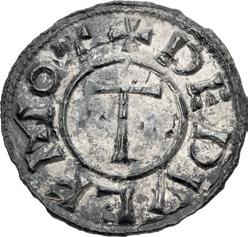

1070. ANGLO-SAXON, Anglo-Viking (Hiberno-Norse Northumbria). Sihtric Caech. 920/1-927. AR Penny (20mm, 1.20 g, 6h). Sword/Hammer type. Uncertain Southumbrian mint, possibly Lincoln; Tidwulf, moneyer. ⎄ዢ˸ʼ / ዢæ ʼዞҟ in two lines; sword between / ม ዝዞዝ⎍⌦ዟ ዦɭ˸ , upright hammer. Cf. Blackburn, Supp. –; SCBI –; North –; SCBC 1013. Toned, deposits. EF. Exceptionally well struck for the series. Extremely rare. ($7500)
The 910s saw the Anglo-Saxons under Edward the Elder reconquer most of the Danelaw south of the river Humber, with Ragnall, the Danish king of Northumbria, even submitting to the English. After Ragnall’s death, Sihtric Caech, former King of Dublin, arrived in York to take the throne of Northumbria. Sihtric would renege on his predecessor’s agreement, raiding into the southern territories. This coin, struck south of the Humber, possibly at Lincoln, is a numismatic tie to the uncertain period, and the last Viking coin struck in southern England.

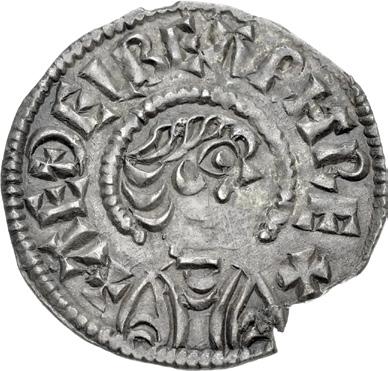

1071. ANGLO-SAXON, Kings of Wessex. Æthelberht. 858-865/6. AR Penny (21mm, 1.20 g, 3h). Inscribed Cross type. Canterbury mint; Hunræd, moneyer. Struck circa 858-864. ม ¨ዞ
, diademed bust right / ม
n ዞ ˸ ¨ arranged on limbs of, and around, beaded cross. Naismith C192j (this coin?); SCBI 67 (BM) 1270; North 620; SCBC 1053. Richly toned, minor edge chip. Good VF. ($1000)
Ex Classical Numismatic Group Electronic Auction 466 (22 April 2020), lot 671. Possibly ex Lord Grantley Collection (Part III, Glendining, 22 March 1944), lot 987 (part of).

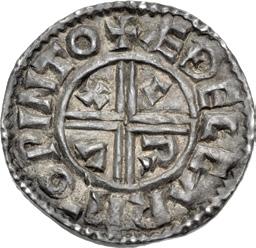
1072. ANGLO-SAXON, Kings of All England. Æthelred II. 978-1016. AR Penny (20mm, 1.67 g, 9h). Crux type (BMC iiia, Hild. C). Winchester mint; Æthelgar, moneyer. Struck circa 991-997. ม ®T ዞ⌦ʼዞዝ ʼዞҟ ©nű⌦ j, draped bust left; trefoil-tipped scepter to left / ม ®T ዞ⌦ű©ʼ ዦ!ɭ ዩዢn˸ɭ , voided short cross; ü ʽ ⎍ ҟ in quarters. Harvey 301e (dies A/a) = SCBI 20 (Mack), 888 (this coin); North 770; SCBC 1148. Toned, a few peck marks. Good VF. ($500)
Ex R.P. Mack Collection (Glendining, 23 March 1977), lot 122; Duke of Argyll Collection.



1073. ANGLO-SAXON, Kings of All England. Edward the Confessor. 1042-1066. AR Penny (17mm, 1.02 g, 9h).
Facing Bust/Small Cross type (BMC xiiia, Hild. Ac var.). London mint; Godric, moneyer. Struck circa 1062-1065. ม ዞዝዩ©ʼዝ ʼዞҟ ©n , crowned facing bust / ม űɭዝʼዢü ɭn ⌦⎍nዝ Ḧ , small cross pattée; opposed crescents in quarters. Freeman 489 (this coin cited); SCBI –; North 830 var. (annulet on rev.); SCBC 1183 var. (same). Old cabinet toning. Good VF. Extremely rare variety. ($500)
Ex William J. Conte Collection (Classical Numismatic Group 60, 22 May 2002), lot 2282; Baldwin’s 18 (12 October 1998), lot 1749; John D. Brand Collection; R.C. Lockett Collection (Part I, Glendining’s, 6 June 1955), lot 852; P.W.P. Carlyon-Britton Collection (Part II, Sotheby, Wilkinson, & Hodge, 20 November 1916), lot 1168c.



1074. NORMAN. William I ‘the Conqueror’. 1066-1087. AR Penny (19mm, 1.37 g, 2h). Profile Right type (BMC vii). Bristol mint; Beorhtweard, moneyer. Struck circa 1080-1083. ม ዩዢ⌦⌦ዞ⌦ዦ ʼዞҟ , crowned bust right, holding scepter /
ɭn ዛʼዢü , cross pattée, with annulet at center and voided trefoil in each quarter. SCBI 20 (Mack), 1397 (this coin); BMC –; North 847; SCBC 1256. Toned, flip-over double strike. VF. ($750) Ex Spink Numismatic Circular CVIII.2 (April 2000), no. 1462; R.P. Mack Collection, purchased from Baldwin’s, 1962.



1075. NORMAN. William II Rufus. 1087-1100. AR Penny (20mm, 1.09 g, 2h). Profile type (BMC i). Ipswich mint; Leofwine, moneyer. Struck circa 1086-1089. ม ዩዢ⌦⌦ዞ⌦ዦ
, crowned bust right, holding sword / ม
cross pattée, with annulet at center; all over cross fleurée in saltire. Sadler III 952 var. (dies 1/–; unlisted rev. die); SCBI 11 (Stockholm), 152 (same obv. die); BMC –; North 851; SCBC 1258. Toned, broken and repaired. Good VF. ($1500)



1076. PLANTAGENET. Edward III. 1327-1377. AV Half Noble (25mm, 3.68 g, 5h). Fourth coinage, Treaty period, Series A (Transitional). Tower (London) mint. Struck 1361. Edward standing facing in ship, holding sword and shield; ornaments 1-1-1-1, ropes 3/3, quatrefoils 4/3, lis 3 / Voided short cross potent over cross fleurée; in each angle, crown over lion passant over annulet; at center, E within quadrilobe; all within polylobe, with trefoils in spandrels. Lawrence dies m/7; Doubleday 187/173 (for obv./rev. dies); Schneider 65 corr. (same dies); North 1223; SCBC 1500. Small scrape, slightly wavy flan. VF. Rare. ($1500)
Ex Classical Numismatic Group 93 (22 May 2013), lot 1876.
Commonly known as the ‘cursing Half Noble’ on account of the reverse legend which reads, ‘O Lord, rebuke me in Thine anger’ due to the erroneous omission of the Latin word ‘ne,’ which negates the rebuke and would correctly read ‘O Lord, do not rebuke me in Thine anger.’


1077. PLANTAGENET. Edward III. 1327-1377. AV Half Noble (36mm, 3.70 g, 10h). Fourth coinage, Treaty B period, Group b. Tower (London) mint. Struck 1361-1369. Edward standing facing in ship, holding sword and shield; ornaments -1111, ropes 3/2, quatrefoils 3/2, lis 4 / Voided short cross potent over cross fleurée; in each angle, crown over lion passant over voided trefoil; at center, E within quadrilobe; all within polylobe, with trefoils in spandrels. Lawrence 1; Doubleday 237–40; Schneider 88–9; North 1239; SCBC 1507. Slightly wavy flan. EF. ($1500)


1078. LANCASTER. Henry VI. First reign, 1422-1461. AV Noble (33mm, 4h). Contemporary imitation. Group 2c. Uncertain mint in the Low Countries, copying London. Henry standing facing in ship, holding sword and shield; annulet at hilt; ornaments: 1-1-1; quatrefoils: 2/1 / Voided short cross potent over cross fleurée; in each angle, crown over lion passant over trefoil; at center, h within angled quadrilobe; all within polylobe, with annulet and trefoils in spandrels. Schneider 833 (same dies); cf. North 1414 (for official issue); SCBC 1801. In NGC encapsulation 1729756-002, graded XF 45, (there as an official Henry VI issue, SCBC 1799). ($2000)
Ex Stack’s Bowers Galleries (22 August 2022), lot 32013.




1079. LANCASTER. Henry VI. First reign, 1422-1461. AV Half Noble (26mm, 3.48 g, 2h). Annulet issue. Tower (London) mint. Struck 1422-circa 1430. Henry standing facing in ship, holding sword and shield; annulet to left of hand; ornaments: 1-1-1; quatrefoils: 3/3; f type 1 and N type 1 / Voided short cross potent over cross fleurée; in each angle, crown over lion passant over trefoil; at center, ƌ within angled quadrilobe; all within polylobe, with annulet and trefoils in spandrels. Whitton, Heavy 3b; cf. Schneider 293 (for type); North 1417; SCBC 1805. Richly toned. In PCGS encapsulation 49713784, graded MS 63. Well struck on a neat, round flan. ($4000)
Ex Dr. Baumhauer Collection; UBS 55 (16 September 2002), lot 3541.



1080. YORK (Restored). Richard III. 1483-1485. AR Groat (25mm, 2.74 g, 8h). Type 2b. London (Tower) mint; im: boar’s head 2. Struck 20 July 1483 to June 1484. Crowned facing bust within tressure of arches; lis at lower cusps / Long cross pattée; triple pellets in quarters. Winstanley 5; MEG type 2b; North 1679; SCBC 2156. Toned, a few scuffs and marks, slightly wavy flan and ragged edge. VF. Rare. ($2000)
From the Alexander Christopher Collection.
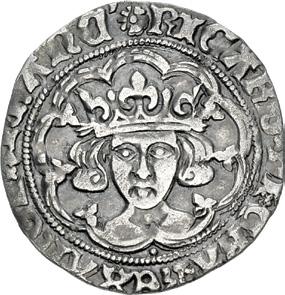
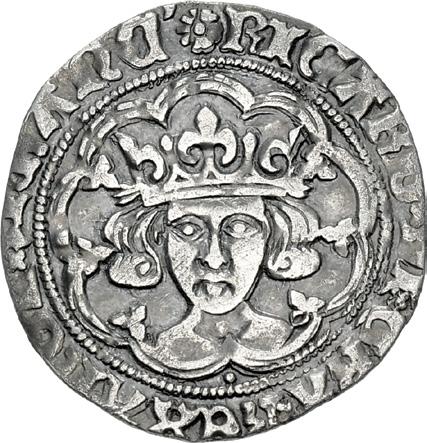

1081. YORK (Restored). Richard III. 1483-1485. AR Groat (24mm, 2.78 g, 2h). Type 3. London (Tower) mint; im: halved sun and rose 2. Struck circa June 1484-22 August 1485. Crowned facing bust within tressure of arches; lis at lower cusps, pellet below / Long cross pattée; triple pellets in quarters. Winstanley 13; MEG type 3; North 1680; SCBC 2158. Toned. Good VF. Rare. ($1500)



1082. TUDOR. Edward VI. 1547-1553. AR Halfgroat (20mm, 1.24 g, 12h). First period. Canterbury mint; im –. Struck April 1547-January 1549. Crowned and mantled bust right; EDOARD / CIVI TAS CAN TON, coat-of-arms over long cross fourchée. North 1897; SCBC 2459. Toned, slightly wavy with area of weakness at center, slight double strike. Near VF. ($750)
From the Alexander Christopher Collection.
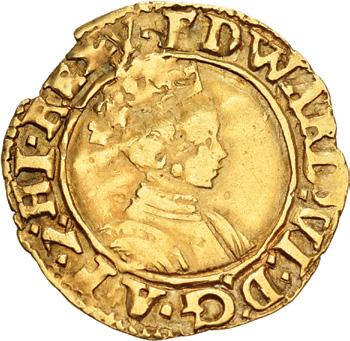



1083. TUDOR. Edward VI. 1547-1553. AV Halfcrown (19mm, 1.44 g, 2h). Second period. Southwark mint; im: Y. Struck January 1549-April 1550. Crowned and armored bust right / Crowned coat-of-arms. Schneider –; North 1916; SCBC 2444. Edge chip, wavy flan, a few marks. Near VF. Very rare. ($2000)
Ex Spink Numismatic Circular C.1 (February 1992), no. 100; D. Dupree Collection.



1084. TUDOR. Philip & Mary. 1554-1558. AR Shilling (30mm, 6.15 g, 6h). Tower (London) mint; im –. Dated 1554. Confronted busts of Philip, armored, and Mary, veiled; crown above. Full titles / Crowned coat-of-arms; X II (mark of value) flanking crown. North 1967; SCBC 2500. Deeply toned, slight double strike. Good VF. ($2000)
From the Alexander Christopher Collection. Ex Coin Galleries (15 November 1989), lot 1116.



1085. TUDOR. Elizabeth I. 1558-1603. AR Crown (42mm, 29.59 g, 6h). Seventh issue. Tower (London) mint; im: 1. Struck 1601-1602. Crowned and draped bust (9A) left, wearing ruff, holding lis-tipped scepter and orb / Coat-of-arms over long cross fourchée. Barr/Cooper dies B/2a; BCW 1-1/1-a1; North 2012; SCBC 2582. Toned, minor marks, scratches, hairlines. Good VF. ($3000)
From the Alexander Christopher Collection.


1086. STUART. Charles I. 1625-1649. AR Crown (45mm, 30.16 g, 2h). Group IV, type 4. Tower (London) mint; im: sun. Struck under Parliament, 1645-1646. Charles on horseback left, holding reins and sword / Coat-of-arms. Cooper, Silver dies XXIV/XXXVIII; Brooker 273 (same dies); North 2198; SCBC 2761. Richly toned, a few scattered marks, minor edge bumps. Good VF. ($2000)
From the Alexander Christopher Collection.



1087. STUART. Charles I. 1625-1649. AR Pound (49mm, 120.5 g, 10h). Declaration type. Shrewsbury mint. Dated 1642. Charles on horseback left, holding sword and reins, trampling pile of arms on ground; plume to right / RELIG : PROT : LEG/ANGL : LIBER : PAR; above, three plumes over ·XX· (mark of value), 1642 below. Morrieson, Shrewsbury B/3; Brooker 797 (same dies); North 2362; SCBC 2918. Toned, edge bumps, scratches and marks. VF. ($7500)


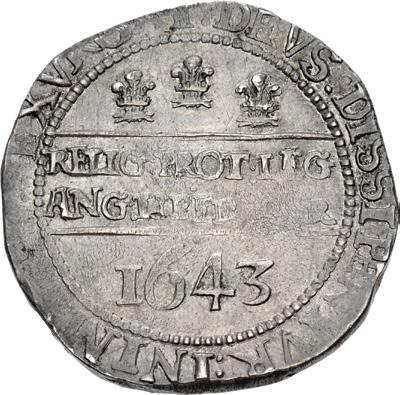
1088. STUART. Charles I. 1625-1649. AR Halfcrown (32mm, 14.29 g, 6h). Declaration type. Oxford mint; im: plumes/–. Dated 1643. Charles on horseback riding left, holding sword and reins; plumes to right / RELIG : PROT : LEG/ANG : LIBER : PAR in two lines between parallel lines; three plumes above; 1643 below. Bull, Oxford 601F; Bull 602/3; Brooker 888-90 (same obv. die); North 2413; SCBC 2954. In NGC encapsulation 6874768-004, graded AU 55. Much as struck. ($2000)
Ex M. Bull Collection; Spink Numismatic Circular CXIV.4 (August 2006), no. HS2555.
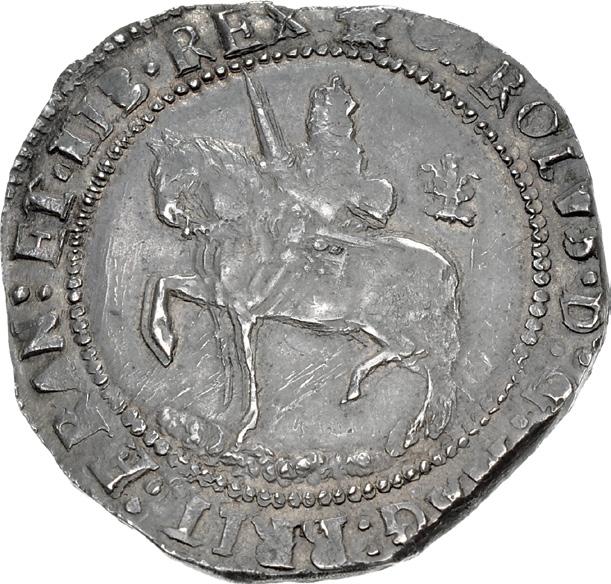



1089. STUART. Charles I. 1625-1649. AR Halfcrown (34mm, 14.27 g, 1h). Declaration type. Oxford mint; im: plumes/–. Dated 1646. Charles on horseback riding left, holding sword and reins; plumes to right / ·:· EXVRGΛT ·:· DEVS · DISSIPEN · INIMISI, RELIG · PROT LEG/ ANG · LIBER PΛR in two lines between parallel lines; three plumes above; ·1·6·4·6·/ · OX · below. Bull, Oxford 625D; Bull 632/2E (this coin cited); Brooker 920 (same dies); North 2433; SCBC 2961. Richly toned, slightly soft in center of reverse. Near EF. Unusual legend error. ($2000)
Ex M. Bull Collection; R. Richardson FPL (2004), no. 44.




1090. STUART, Siege money. Pontefract. 1648-1649. AR Shilling (32x32mm, 5.59 g, 12h). In the name of Charles II. Dated 1648. CAROL’ : II : D : G : MAG : BR · ET : H : REX, crown; below, HANC : DE/VS : DEDIT/ I648 in three lines / POST : MORTEM : PATRIS : PRO : FILIO, castle gateway with flag; OBS to left, P C above, cannon protruding to the right. Hird 282 (same dies); Brooker 1235 (same dies); North 2649; SCBC 3151. Toned. In PCGS encapsulation 34361173, graded VF Details, plugged. ($2000)
Ex Heritage 3071 (6 January 2019), lot 30550; J.J. North Collection; David Hess FPL 2-67 (February 1967), no. 270.
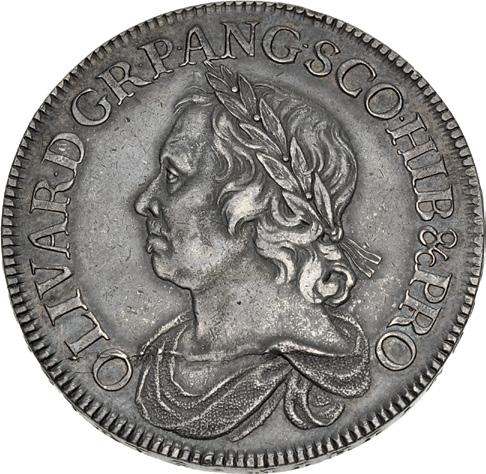


1091. COMMONWEALTH. Oliver Cromwell. Lord Protector, 1653-1658. AR Crown. Blondeau’s mint, Drury House, London. Dies by Thomas Simon. Dated 1658/7. Lessen E12; Bull 240; ESC 10; SCBC 3226. Toned. In NGC encapsulation 6898643-005, graded AU 53. ($3000)
From the Alexander Christopher Collection.
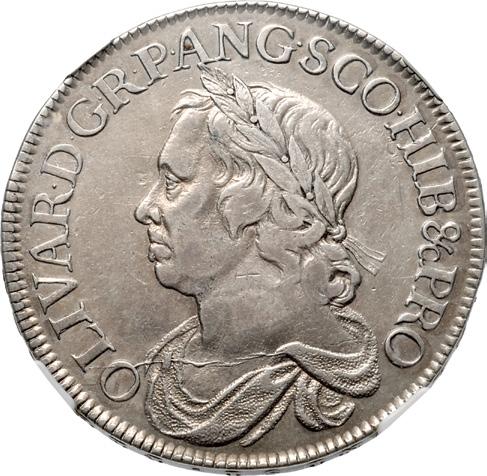


1092. COMMONWEALTH. Oliver Cromwell. Lord Protector, 1653-1658. AR Crown. Blondeau’s mint, Drury House, London. Dies by Thomas Simon. Dated 1658/7. Lessen E12; Bull 240; ESC 10; SCBC 3226. In NGC encapsulation 4157451007, graded XF 40. ($2000)



1093. COMMONWEALTH. Oliver Cromwell. Lord Protector, 1653-1658. AR Halfcrown. Blondeau’s mint, Drury House, London. Dies by Thomas Simon. Dated 1658. Lessen I26; Bull 242; ESC 447; SCBC 3227A. Toned. In NGC encapsulation 6898712-012, graded AU 53. ($2000)
From the Alexander Christopher Collection.
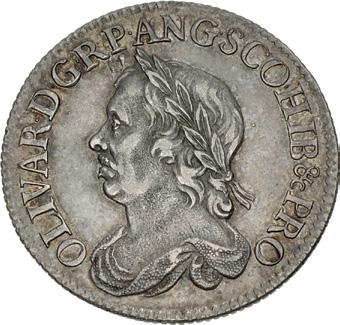

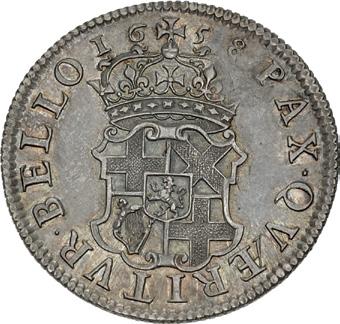
1094. COMMONWEALTH. Oliver Cromwell. Lord Protector, 1653-1658. AR Shilling. Blondeau’s mint, Drury House, London. Dies by Thomas Simon. Dated 1658. Lessen J28; ESC 1005; North 2745; SCBC 3228. Toned. In NGC encapsulation 6898674-002, graded AU 53. ($2000)
From the Alexander Christopher Collection.

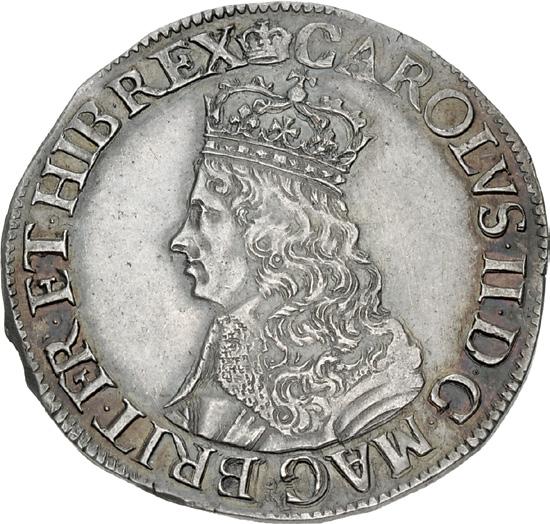

1095. STUART. Charles II. 1660-1685. AR Shilling (30mm, 5.96 g, 2h). First hammered issue. Tower (London) mint; im: crown. Struck November 1660-October 1661. Crowned bust left / Coat-of-arms over short cross moline. Bull, Silver 272; ESC 1010; North 2762; SCBC 3308. Iridescent toning, a few faint scratches. EF. With a finer strike and portrait than the specimen in Cope Part I (hammer 4750 CHF). ($3000)
From the Alexander Christopher Collection.




1096. STUART. Charles II. 1660-1685. AV Broad (30mm, 8.92 g, 6h). Tower (London) mint. Dated 1662. Laureate, draped, and cuirassed bust left / Crowned coat-of-arms. Lessen, Simon’s G.3/3; Bull, Gold 166; SCBC 3337A. In NGC encapsulation 6909359-009, graded AU 58. Rare. ($7500)
From the Drewry Family Collection. Ex Davissons FPL 1994-2 (September 1994), no. 9; Strauss Collection (Sotheby’s, 26 May 1994), lot 168; Lady & Sir G.E. Duveen Collection (Glendining, 29 September 1964), lot 56.




From the Alexander Christopher Collection.
1098.





1099.
From the Alexander Christopher Collection.
and RY


From the Michael Casick Collection of British Coins, purchased from J. Hanna, September 2008.




1101. STUART (ORANGE). William III & Mary. 1688-1694. AV 5 Guineas. Dated 1693 Elephant & Castle. Second busts. Bull, Gold 351; SCBC 3423. In NGC encapsulation 6917299-003, graded AU Details, spot removed. ($10,000)
From the Drewry Family Collection. Ex Bowers & Merena (17 September 1984), lot 5025.
In 1660, the Royal African Company was given a monopoly of English trade in West Africa with the particular aim of exploiting the gold fields of the upper Gambia River. Coins were struck at the Royal Mint with gold from these endeavors, bearing the Company’s badge of an elephant and castle (sometimes an elephant only) under the effigy of the monarch. Initially these issues were so plentiful that the new milled gold issues were given the popular name – Guinea. After 1689, the Company lost it’s monopoly and in the 18th Century elephant and castle coins were issued more infrequently. The Royal Africa Company was dissolved in 1752.



1102. STUART. Anne. 1702-1714. AV Guinea. Dated 1713. Post-Union issue. Second bust. Bull, Gold 477; Spink 3574. Lustrous, hairlines. AU. ($2000)
Form the Drewry Family Collection. Ex Davissons BBS (6 March 1985), lot 403.


1103. STUART. Anne. 1702-1714. AR Crown. Dated 1703 VIGO and RY TERTIO. Pre-Union issue. First bust. Bull 1340; ESC 99; SCBC 3576. Toned, edge bumps. Good VF. ($1500)
From the Michael Casick Collection of British Coins, purchased from Weiss Collectibles, November 1997.


1104. STUART. Anne. 1702-1714. AR Crown. Dated 1708 and RY SEPTIMO. Post-Union issue. Second bust, roses and plumes. Bull 1347; ESC 108; SCBC 3602. Toned. In NGC encapsulation 3354689-015, graded AU 55. ($1000)
From the Michael Casick Collection of British Coins, purchased from Atlas Numismatics, June 2012.



1105. HANOVER. George II. 1727-1760. AR Crown. Dated 1751 and RY V. QVARTO. Old head. Bull 1671; ESC 128; SCBC 3690. Toned. In NGC encapsulation 6904463-003, graded MS 63. Top Pop ($3000)
From the Alexander Christopher Collection.

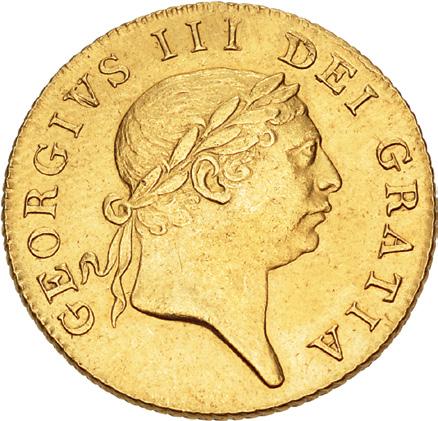

1106. HANOVER. George III. 1760-1820. AV Guinea. Dated 1813. Early coinage. Sixth bust. Military type. Bull, Gold 737; SCBC 3730. Hairlines, scratch. AU. ($2500)


1107. HANOVER. George III. 1760-1820. AR Dollar. Struck 1797. Oval countermark on a Chilean, Santiago Portraittype 8 Reales dated 1795 So DA. Bull 1853; ESC 134; SCBC 3765A. Deeply toned, a few scratches, small flan flaw at edge. Host Good VF. Countermark: Good VF. Rare undertype. ($1000)
From the Alexander Christopher Collection.
In the late 18th century, the circulating coinage in Britain was in a pathetic state. Counterfeit coins, both in copper and silver, were the rule, rather than the exception. The Royal mint, rather than competing with the flood of false issues, simply shut its doors.
In 1788, industrialist Matthew Boulton stepped in to attempt to reform the copper coinage where the government would not. A wealthy industrialist and partner of the steam-engine inventor James Watt, Boulton had made his fortune manufacturing other small metallic objects. Using the steam technology at his disposal, he created the first modern mint at Soho in Birmingham. Yet Boulton was initially unable to obtain a patent to strike coinage and instead opened his mint to merchants. The vast majority of provincial tokens struck in England at this time originated from the Soho mint.
Meanwhile, the Bank of England endeavored to stabilize the silver coinage. Taking Spanish eight reales coins, they stamped on them a small image of King George, valuing them at a dollar of five shillings. This simple solution did not fare well with the public, as they were extremely easy to counterfeit. The failed issue spawned a popular nursery rhyme, “The Bank to make their Spanish dollars pass/Stamped the head of a fool on the head of an ass.” The Bank soon turned to Boulton and his steam presses. By 1805, fully struck dollars from the Soho mint could be seen in change.


1108. HANOVER. George III. 1760-1820. AR Dollar. Dated 1804. No stop after REX. Bull 1951; ESC 164; SCBC 3768. Toned. In NGC encapsulation 1907924-007, graded MS 62. ($750)
From the Michael Casick Collection of British Coins, purchased from Atlas Numismatics, May 2006.


1109. HANOVER. George III. 1727-1760. Proof Patttern CU Dollar (40mm, 6h). Soho (Birmingham) mint. Dies by C.H. Küchler. Dated 1804. GEORGIUS III DEI GRATIA REX, laureate, draped, and cuirassed bust right / BANK OF ENGLAND, Britannia seated left, holding olive branch and spear, and leaning upon Union shield; cornucopia below; beehive in background to left; all within garter surmounted by mural crown; 1804 below. Thick flan. L&S 79; Bull 1956; ESC 164A; cf. SCBC 3768 (for regular silver striking). In NGC encapsulation 6635638-002, graded PF 62 BN. Wonderful chocolate brown surfaces. Rare. ($1000)




From the Alexander Christopher Collection.


From the Alexander Christopher Collection.



Form the Drewry Family Collection. Ex Smythe 198 (11 May 2000), lot 1813.









1115. HANOVER. Victoria. 1837-1901. Proof AR Crown. Dated 1847 and RY UNDECIMO. Gothic type. Edge lettering, struck en medaille. Bull 2571; ESC 288; SCBC 3883. In NGC encapsulation 6889970-002, graded Proof AU Details, cleaned. ($2000)




1116. HANOVER. Victoria. 1837-1901. Proof AR Crown. Dated 1847 and RY UNDECIMO. Gothic type. Plain edge, n over inverted n in UNITA. Struck in pure silver. Bull 2577; ESC 291B; SCBC 3883. Toned. In NGC encapsulation 6898643004, graded PF 62. ($10,000)
From the Alexander Christopher Collection.
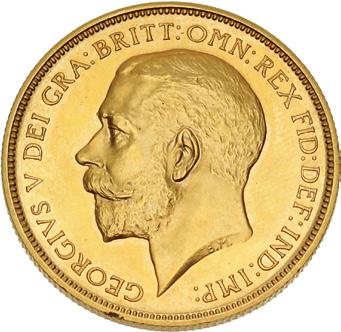

1117. WINDSOR. George V. 1910-1936. Proof AV 2 Pounds. Dated 1911. Edge: milled. W&R 415; Bull, Gold 1431; SCBC 3995. In NGC encapsulation 6909359-011, graded PF 63. ($2000)
Form the Drewry Family Collection. Ex Smythe 198 (11 May 2000), lot 1820.
















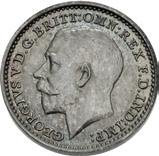


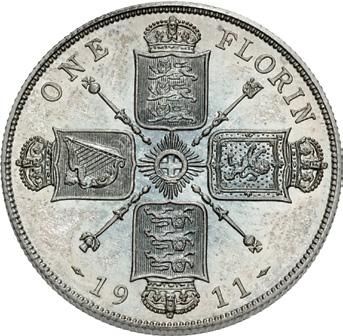




1118. WINDSOR. George V. 1910-1936. Proof Set. Dated 1911. Includes: AV 5 Pounds. In NGC encapsulation 6890874012, graded PF 64 // AV 2 Pounds. In NGC encapsulation 6890874-013, graded PF 64 // AV Sovereign. In NGC encapsulation 6890874-010, graded PF 66 Cameo // AV Half Sovereign. In NGC encapsulation 6890874-014, graded PF 65 // AR Halfcrown. In NGC encapsulation 6890874-008, graded PF 65 // AR Florin. In NGC encapsulation 6890874-06908067-007, graded PF 65 // AR Shilling. In NGC encapsulation 6890874-006, graded PF 65 // AR Sixpence. In NGC encapsulation 6890874-005, graded PF 66 // AR Maundy Fourpence. In NGC encapsulation 6890874-003, graded PF 65 // AR Maundy Threepence. In NGC encapsulation 6890874-004, graded PF 66 // AR Maundy Twopence. In NGC encapsulation 6890874-002, graded PF 66 // AR Maundy Penny. In NGC encapsulation 6890874-001, graded PF 65. SCBC PS11. All NGC graded. The silver all handsomely toned. Twelve (12) coins in lot. An attractive, high grade set. ($15,000)
From the Alexander Christopher Collection.








1119. WINDSOR. George VI. 1936-1952. Proof Set. Dated 1937. Includes: AV 5 Pounds. In NGC encapsulation 6890866-009, graded PF 62 // AV 2 Pounds. In NGC encapsulation 6890866-012, graded PF 63 // AV Sovereign. In NGC encapsulation 6890866-010, graded PF 64 Cameo // AV Half Sovereign. In NGC encapsulation 6890866-007, graded PF 62. SCBC PS15. All NGC graded. Four (4) coins in lot. ($6000)



1120. SCOTLAND. Mary. 1542-1567. AR Testoon (28mm, 5.82 g, 1h). Third period, first widowhood. Edinburgh mint. Dated 1561. Bust left, wearing close cap and fillet / Crowned coat-of-arms; crowned Ms flanking. Burns 2-3 (fig. 897); SCBI 58 (Edinburgh), 1149-51; SCBC 5422. Toned, some porosity and scattered marks. Near VF. Rare. ($5000)
From the Alexander Christopher Collection.



1121. IRELAND, Hiberno-Norse. Sihtric III Olafsson. Circa 995-1036. AR Penny (19mm, 1.19 g, 8h). Phase II coinage. Imitating Long Cross type of Æthelred II. Dublin mint; ‘Færemin,’ moneyer. Struck circa 1015-1035. ม Ӳዢዡ˸ʼዞ ʼዞม ዝӎ , draped bust left; cross pattée to right / ม ዟ ® ʽዞዦዢ n ዦณ∂ ዝӎዟ⌦ዢ , voided long cross, with pellet at center and triple-crescent ends; pellets in quarters. SCBI 8 (BM), 64-6; SCBI 22 (Copenhagen), 59; SCBI 32 (Ulster), 54 (same dies); D&F 23; SCBC 6122. Old cabinet toning, reverse double struck. Near EF. Interesting short obverse legend. ($1000)




1122. IRELAND. James II. 1685-1691. Proof AR Halfcrown. ‘Gunmoney’ coinage. Dublin mint. Dated May 1690. Withers 26/28; Timmins TB30sM-2B; SCBC 6580B9. Toned. Proof. Extremely rare – only five specimens seen by Withers. ($3000)
From the Drewry Family Collection. Ex Norman Applebaum Collection (Superior, 11 December 1992), lot 1520, purchased from C.J. Denton, October 1975.


1123. IRELAND. George III. 1760-1820. Proof AR Dollar. Soho (Birmingham) mint. Dated 1804. D&F 616; SCBC 6615. Iridescent toning. In NGC encapsulation 6931384-005, graded PF 62. ($1500)
From the Drewry Family Collection. Ex Norman Applebaum Collection (Superior, 11 December 1992), lot 1547.


1124. IRELAND, Countermarked coinage. Kilkenny. Castle Comer Colliery. AR Dollar (39.5mm, 25.91 g, 11h). Countermarked circa 1804-1806 by Anne, Countess of Ormonde. PAYABLE · AT · CASTLE · COMER · COLLIERY · around 5s,,5d within a tuliped oval border; all within serrated oval cartouche on a Mexican 1804 Mo TH 8 Reales. W.A. Seaby, “Castle Comer Tokens: An Inquiry” in BNJ 34 (1965), pl. XV, 12-4; Manville 108; KM 145.4. Toned. VF. Very rare. Only seven examples recorded by Manville with this host coin. ($5000)
From the Drewry Family Collection. Ex Norman Applebaum Collection (Superior, 11 December 1992), lot 1561.



1125. ANGLO-GALLIC. Henry VI. 1422-1461. AV Salut d’or (27mm, 3.42 g, 7h). Second type. Rouen mint; im: leopard. Étienne Marcel, mintmaster. Second issue, 1433-1444. The Annunciation: the Virgin standing right, receiving tablet inscribed ¥ѝĚ from the Archangel Gabriel standing left; heavenly light above, two coats-of-arms below; pellet-in-annulet under last letter of legend / Latin cross, with lis to left, lion passant guardant to right, and ƌ below; all within polylobe, with lis in each point; pellet-in-annulet under last letter of legend. AGC 386F, 1/b; Schneider 111-2; SCBC 8164. VF. ($1000)
Ex Classical Numismatic Group 93 (22 May 2013), lot 1896.



1126. ANGLO-GALLIC. Henry VI. 1422-1461. AV Salut d’or (27mm, 3.42 g, 7h). Second type. St. Lô mint; im: lis. Struck 1422-1449. The Annunciation: the Virgin standing right, receiving tablet inscribed ¥ѝĚ from the Archangel Gabriel standing left; heavenly light above, two coats-of-arms below / Latin cross, with lis to left, lion passant guardant to right, and ƌ below; all within polylobe, with lis in each point. AGC 387A, 1/a; Schneider 118 (same obv. die); SCBC 8164. A few faint scratches, scrapes. Good VF. ($1000)
Ex Stack’s (2 February 1968), lot 792.
My father, Garth R. Drewry, started collecting coins in 1948 – a large cent – in the summer between college and medical school. He started with ancient coins – some denarii – in 1967, inspired by his love of history and the classical world. My mother taught ancient history and for several years he would buy large lots of unidentified ancient bronze coins, pick out some for himself, and give her the rest to distribute to her students – there is still at least one box of “student coins”. He loved the Roman Provincial series, which before the internet and pre-RPC required a large reference library. He also had the phone numbers and addresses of dealers and scholars he met over the years at coin shows and on the fairly regular family trips to classical sites. I remember him reciting the Roman emperors from Augustus to Constantine to me when I was young; I only recited Augustus to Trajan Decius to my children, although once when we were visiting he overheard me and continued the list when I stopped.
He sold his collection twice. The star piece from his 1971 sale, an Alexandria tetradrachm of Pertinax Caesar and Titiana, is now in the British Museum (BM 1977,0301.1). He started collecting again almost immediately, concentrating on Roman provincial coins, but branching out into other areas he found interesting. Honestly, there were very few things he did not find interesting and he enjoyed learning the intricacies of a new field. As always, he tried for better than average condition in general and great condition in areas of real focus, though as with ancients, rarity sometimes trumped condition.
He sold almost all of the ancient coins and some British hammered coins in 2005-2007 through CNG - he had been a customer of CNG and some of its predecessor companies for many years. He was pleased when I mentioned seeing some of his coins come up at auction again or get mentioned in academic papers.
And that, some people thought, was the end of it.
But it wasn’t the end – there were still all the other “interesting” things, and the collecting urge faded slowly – his desk had a stash of old film cannisters filled with coins he had set aside on the various trips he and my mother had taken with and without children – something he did for many decades.
The first coin my father gave me was from a trip he and my mother took to the Bahamas, and on our first family vacation to the (pre-decimalization) UK we spent each evening trying to find the oldest/best condition coin in our pocket change. He and I started visiting FUN in Orlando and dealers in London together around the time I started to help him with cataloguing his acquisitions. He would sometimes ask me what I thought of particular lots before making his decision.
Eventually, my son George was exposed to some of the remaining collection, discovered that he too is a numismatist, and helped sort and roughly organize things. Though there are some common trends across the generations, each generation also has its own preferences and quirks.
I broadly understood the size of the collection, and getting part of it ready for sale was initially quite daunting. However, my father was a meticulous record keeper. He catalogued almost everything (description, where and when he bought it, other provenance, sometimes his own research, and his catalogue number) in a series of looseleaf notebooks, and then wrote the number and as much of the information as would fit onto a tag for the coin. Fortunately, the notebooks survive, and very few pieces have lost their tags. He was interested in provenance and historical collections, especially when the coin came with the original collectors’ tags, rather than just a mention in a catalogue entry. He was quite pleased when he acquired a coin from the Sir Arthus Evans collection by way of the Knobloch collection. His notes now form part of a coin’s pedigree, and I have seen coins recently that are flagged, for example, as Mabbott/Drewry, Virzi/Drewry, Knobloch/Drewry, Lindgren/Drewry, Burstein/Drewry, Burstein/Lindgren/Drewry, and just plain Drewry. There are even coins out there with the original ticket from Seaby or Spink or Baldwin’s with his notes added.
I learned a lot from reading and helping fill those notebooks. I never did persuade him to move to a computerized system, which may have been all for the best, given the ephemeral nature of software file formats over the past 35 years. I did both Classics and Computer Science in college (I couldn’t decide between them), and while my inner computer geek would like the convenience of a database or at least a spreadsheet, my inner Classicist is quite happy with paper – it’s easy to read a 400 year old book or a thousand year old manuscript, but the odds are against accessing a 30 year old computer file.
Deciding which pieces should find new homes prompted lots of reminiscences, many of them prompted by the coins rather than being about them. There are definite subcollections – thalers and thaler-like pieces; British coronation medals; coins of the Knights of St John of Jerusalem, Rhodes, and Malta; trade tokens from several countries; academic prize medals; and medals related to explorers. Some things are less cohesive - British coins, older proofs from smaller countries, minor silver coins of the Holy Roman Empire, early 20th century China, some colonial US pieces – and we also discovered many surprises, all of them, as he would say, interesting. We hope that the coins in this and subsequent sales give other collectors the same pleasure they have given our family over the past 60 years.
Raymond Drewry


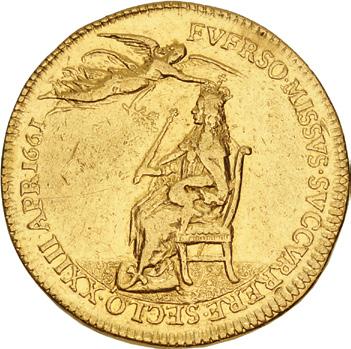

1127. STUART. Charles II. 1660-1685. AV Medal (29mm, 13.21 g, 3h). Coronation. By T. Simon. Dated 23 April 1661. CAROLVS · II · D · G ANG · SCO · FR · ET HI · REX, crowned and mantled bust right, wearing Collar of the Order of the Garter / EVERSO · MISSVS · SVCCVRRERE · SECLO · XXIII · APR · I66I, Charles enthroned left, being crowned by Victory flying to right from above. MI 472/76; Eimer 221. In NGC encapsulation 6906580-004, graded AU Details, removed from jewelry. ($2500)
From the Drewry Family Collection. Ex Lepczyk 58 (27 July 1984), lot 712.



1128. STUART. Charles II. 1660-1685. AV Medal (56mm, 122.7 g, 12h). The Treaty of Breda – Showing Dominion Over the Seas. By J. Roettier. Struck 1667. * CAROLVS · SECVNDVS · DEI · GRATIA · MAG · BRI · FRAN · ET · HIB · REX, laureate head right / FAVENTE DEO, Britannia seated left on seashore, holding spear and resting hand on shield, viewing fleet under sail left; personification of the sun above; BRITANNIA in exergue. Edge: (rose) CAROLVS SECVNDVS PACIS ET IMPERII RESTITVOR AVGVSTVS (star stops). MI 535/186; Eimer 241. Polished, marks and scratches. VF. Very rare. In modern case. ($7500)
From the Drewry Family Collection. Ex Superior (6 February 1978), lot 1069.
Signed at the Dutch city of Breda on 31 July 1667, the Treaty of Breda brought the Second Anglo-Dutch War (1665-1667) to a hasty end due to the invasion of the Southern Netherlands by Louis XIV. Prompted by Michiel de Ruyter’s successful ‘Raid on the Medway’ a little more than a month earlier, which gave the Dutch control of the seas around the southern coast of England, the English quickly sued for peace. Under the terms of the treaty, the Dutch East India Company secured its control of the East Indies and the lucrative worldwide trade in nutmeg. They also gained concessions to the English Navigation Acts, which now allowed them to import German goods into England. In the long term, however, the treaty provided England with the opportunity to expand its overseas empire in North America. The unwillingness of the Dutch to recover Nieuw-Nederland, taken by the English in 1664 (its restoration had been an English concession to peace), now gave England full control of several new colonies (New York, New Jersey, Delaware, and Pennsylvania), as well as the city of Nieuw-Amsterdam - now renamed New York City. The restoration of Acadia by the English to the French foreshadowed the series of wars that would be fought between the two powers for dominance in the North American theater, culminating in the French and Indian War (1754-1763).




1129. STUART. James II. 1685-1688. AV Medal (35mm, 21.30 g, 12h). Coronation. By J. Roettier. Dated 23 April 1685. IACOBVS · II · D · G · ANG · SCO · FR · ET · HI · REX, laureate and draped bust left / A · MILITARI · AD · REGIAM ·, laurel wreath upon cushion; above, hand bearing crown emerging right from the heavens; in two lines in exergue, INAVGVRAT · 23 · AP/1685. MI 605/5; Eimer 273. In NGC encapsulation 6906709-001, graded MS 61 PL. Rare in gold. Top Pop ($20,000)
From the Drewry Family Collection. Ex World-Wide Coins of California (James F. Elmen) XXIX (16 May 1996), lot 156.



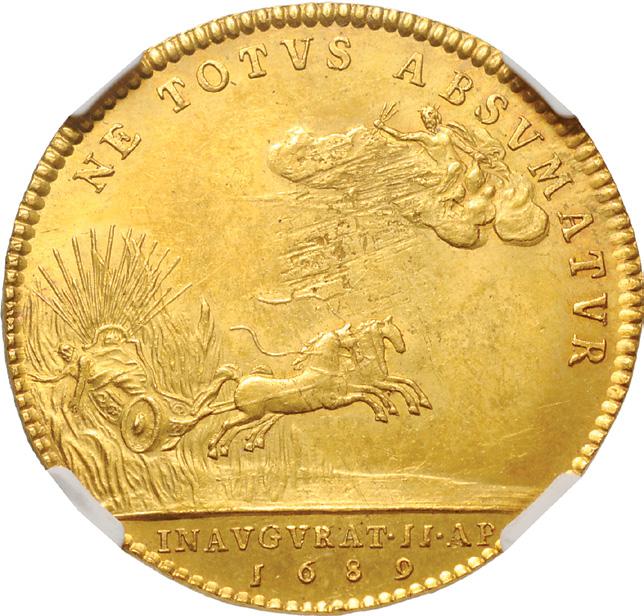
1130. STUART (ORANGE). William III & Mary. 1688-1694. AV Medal (35mm, 18.55 g, 12h). Coronation. By J. Roettier. Dated 2 April 1689. GVLIELMVS · ET · MARIA · REX · ET · REGINA ·, draped busts right of William, laureate and armored, and Mary / NE TOTVS ABSVMATVR, Jupiter seated right among the clouds with an eagle, hurling thunderbolts downward toward Phaethon, escaping from chariot advancing right; in two lines in exergue, INAVGVRAT · II · AP/1689. MI 662/25; Eimer 312a. In NGC encapsulation 6906709-003, graded MS 63. ($20,000)
From the Drewry Family Collection. Ex H. Christensen 84 (9 September 1983), lot 468.




1131. STUART. Anne. 1702-1714. AV Medal (35mm, 18.60 g, 10h). Coronation. By J. Croker. Dated 23 April 1702. ANNA · D · G · MAG · BR · FR · ET · HIB · REGINA ·, draped bust left / VICEM GERIT · ILLA · TONANTIS ·, Anne (as Pallas-Athena) standing right, holding shield and hurling thunderbolt at two-headed and four-armed serpentine monster (James ‘III’ and Louis XIV) to right, holding rocks and clubs; in two lines in exergue, INAVGVRAT · XXIII · AP/MDCCII ·. MI 228/4; Eimer 390. In NGC encapsulation 6906709-005, graded MS 62. ($15,000)
From the Drewry Family Collection. Ex World-Wide Coins of California (James F. Elmen) XXIX (16 May 1996), lot 158.




1132. HANOVER. George I. 1714-1727. AV Medal (35mm, 22.04 g, 12h). Coronation. By J. Croker. Dated 20 October 1714. GEORGIVS · D : G · MAG · BR · FR · ET · HIB · REX ·, laureate, draped, and armored bust right / George seated right on throne, being crowned by Britannia standing left, holding spear and shield; in two lines in exergue, INAVGVRAT · XX · OCT ·/ MDCCXIIII ·. MI 424/9; Eimer 470. In NGC encapsulation 6906709-004, graded UNC Details, cleaned. ($5000)
From the Drewry Family Collection. Ex World-Wide Coins of California (James F. Elmen) XXIX (16 May 1996), lot 159.




1133. HANOVER. George II. 1727-1760. AV Medal (35mm, 22.23 g, 12h). Coronation. By J. Croker. Dated 11 October 1727. GEORGIVS · II · D : G · MAG · BR · FR · ET · HIB · REX ·, laureate, draped, and armored bust left / VOLENTES · PER · POPULOS ·, George seated right on throne, being crowned by Britannia standing left, cradling cornucopia in elbow and leaning upon fasces to right; in two lines in exergue, CORON · XI · OCTOB ·/MDCCXXVII ·. MI 479/4; Eimer 510. In NGC encapsulation 6906709-002, graded MS 63. ($15,000)
From the Drewry Family Collection. Ex World-Wide Coins of California (James F. Elmen) XXIX (16 May 1996), lot 160.

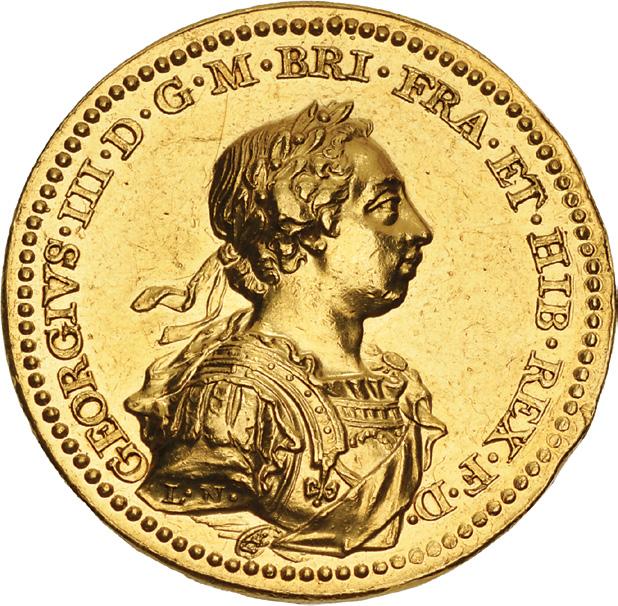

1134. HANOVER. George III. 1760-1820. AV Medal (35mm, 22.65 g, 6h). Coronation. By L. Natter. Dated 22 September 1761. GEORGIVS · III · D · G · M · BRI · FRA · ET · HIB · REX · F · D ·, laureate, draped, and armored bust right / PATRIAE · OVANTI, George seated left on throne, holding scepter and being crowned by Britannia standing right; shield and trident to left, crowned lion and orb to right; in two lines in exergue, CORONAT · XXII · SEPT/MDCCLXI. BHM 22; Eimer 694. In NGC encapsulation 6906580-005, graded AU Details, cleaned. ($2000)
From the Drewry Family Collection. Ex Wayte Raymond Collection (Part III, NASCA, 14 August 1978), lot 1761.

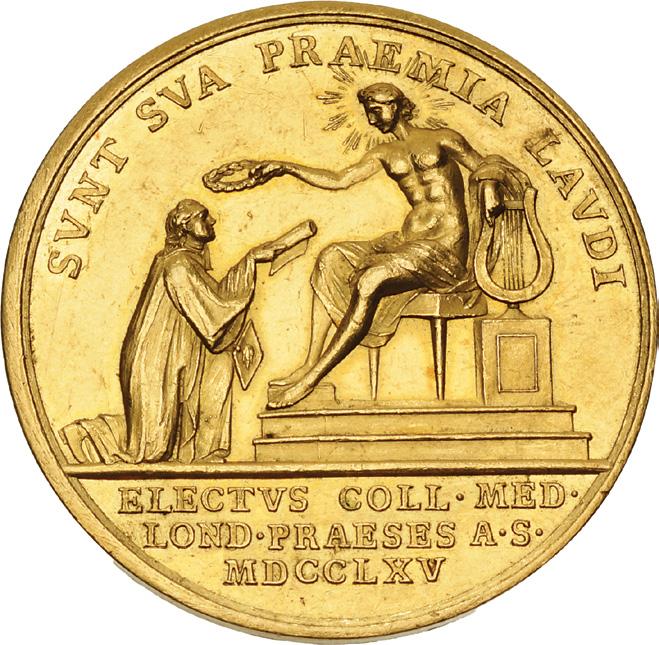

1135. HANOVER. Sir William Browne, President of the College of Physicians. 1692-1774. AV Medal (37mm, 35.99 g, 12h). Cambridge University – William Browne Prize for Classical Odes and Epigrams. By L. Pingo. Dated 3 January 1692 and 1765, though issued throughout the 19th century. ESSE ET VIDERI, draped bust left; below, D · GVLIELMVS BROWNE, EQVES ·/ NAT · III · NON · IAN · A · MDCXVII · / SVNT SVIA PRAEMIA LAVDI, Brown kneeling left, presenting scroll to and being crowned by muse seated left, resting arm on lyre; in exergue, ELECTVS COLL · MED ·/ LOND · PRASES A · S ·/ MDCCLXV. Edge: plain. BHM 92; Eimer 711. In NGC encapsulation 6909383-002, graded MS 60. ($3000)
From the Drewry Family Collection. Ex Lepczyk 55 (25 November 1983), lot 776.




1136. HANOVER. George IV. 1820-1830. AV Medal (34mm, 31.34 g, 12h). Coronation. By B. Pistrucci. Dated 19 July 1821. GEORGIUS IIII D · G · BRITANNIARUM REX F · D ·, laureate head left / PROPRIO JAM JURE ANIMO PATERNO ·, George seated left on throne, being crowned by Victory to right; to left, Britannia, Hibernia, and Scotia standing right; in exergue in three lines, INAUGURATUS/DIE · JULII · XIX/ANNO · MDCCCXXI. BHM 1070; Eimer 1146a. In NGC encapsulation 6906580-003, graded MS 60. ($6000)
From the Drewry Family Collection, purchased from J. Lepczyk, 5 January 1984.




1137. HANOVER. William IV, with Adelaide. 1830-1837. Proof AV Medal (33mm, 27.52 g, 12h). Coronation. By W. Wyon, after F. Chantrey. Dated 8 September 1831. WILLIAM THE FOURTH CROWNED SEP: 8 1831, head of William right / ADELAIDE. QUEEN CONSORT. CROWNED SEP: 8 1831, diademed head of Adelaide right. BHM 1475; Eimer 1251. In NGC encapsulation 6906580-002, graded PF 62 Ultra Cameo. ($10,000)
From the Drewry Family Collection. Ex Stack’s (4 March 1988), lot 2055.


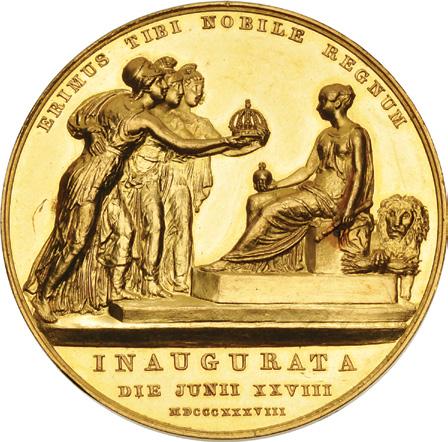

1138. HANOVER. Victoria. 1837-1901. AV Medal (36mm, 30.46 g, 12h). Coronation. By B. Pistrucci. Dated 28 June 1838. VICTORIA D. G. BRITANNIARUM REGINA F. D., draped bust left, wearing bandeau / ERIMUS TIBI NOBILE REGUM, Victoria seated left on throne, holding scepter and orb, and receiving crown from Britannia, Hibernia, and Scotia standing to left; to far right, lion standing facing, with forepaw resting upon thunderbolt; in three lines in exergue, INAUGURATA/ DIE JUNII XXVIII/ MDCCCXXXVIII. BHM 1801; Eimer 1315. In NGC encapsulation 6906580-007, graded MS 61. ($10,000)
From the Drewry Family Collection. Ex NASCA (16 July 1979), lot 1915.


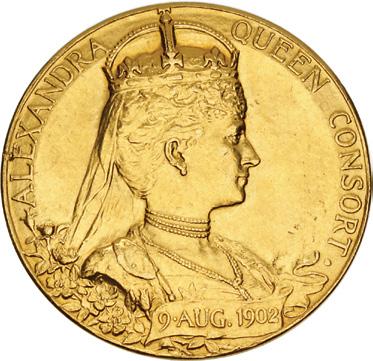

1139. SAXE-COBURG-GOTHA. Edward VII, with Alexandra. 1901-1910. AV Medal (31mm, 17.16 g, 12h). Coronation. By G.W de Saulles. Dated 9 August 1902. EDWARD VII CROWNED 9 · AUGUST 1902, crowned and mantled bust right, wearing collar / ALEXANDRA QUEEN CONSORT, crowned and veiled bust right, flowers behind; below, banner inscribed 9 · AUG · 1902. BHM 3737; Eimer 1871b. In NGC encapsulation 6906580-001, graded UNC Details, cleaned. ($1500)
From the Drewry Family Collection. Ex Davissons FPL (Fall 1989), no. 36.



1140. WINDSOR. George V, with Mary. 1910-1936. AV Medal (31mm, 16.43 g, 12h). Coronation. By B. Mackennal. Dated 22 June 1911. GEORGE V CROWNED JUNE 22 1911, crowned and mantled bust, wearing collar; before, orb atop ribbon / QUEEN MARY JUNE 22 1911, crowned and mantled bust left; roses below. BHM 4022; Eimer 1922b. In NGC encapsulation 6906580-006, graded MS 61 Matte. ($1500)
From the Drewry Family Collection. Ex World-Wide Coins of California (James F. Elmen) XXIX (16 May 1996), lot 166.


1141. WINDSOR. Edward VIII. As Prince of Wales, 1911-1936. AV Medal (29mm, 30.65 g, 12h). Official Investiture. By W. Goscombe John. Dated 13 July 1911. INVESTITVRE · OF · EDWARD · PRINCE · OF · WALES · K · G, crowned and robed bust facing slightly left, wearing Chain of the Garter; CARN – – ARVON/IVLУ · XIII MCMXI in two lines across field / · ARWISGIAD · IORWERTH · TУWУSOG · CУMRU · M · G ·, view of Caernarfon Castle, seen from Afon Seiont, at dawn with rays in background; above, crowned plumes within Garter; in exergue, Y Ddraig Goch (Welsh Dragon). Giordano CM23d; BHM 4079; Eimer 1925. Matte surfaces. UNC. In original case of issue. Very rare, with a mintage of only 129 examples in gold. ($2000)
From the Alexander Christopher Collection.
1142. WORLD. Austria & Hungary. Lot of two-hundred-seventeen (217) silver and base metal issues. Includes: various. Mostly 20th century issues. About 1/4 base metal and 3/4 silver. The silver includes many larger denominations; mostly 0.925. Many commemoratives. About a third with collector tickets. Average Near EF - UNC, many attractively toned, a few details, a few with pvc deposits. LOT SOLD AS IS, NO RETURNS. Two-hundred-seventeen (217) coins in lot. ($2000)
From the Alexander Christopher Collection.
1143. WORLD. Germany. Lot of one-hundred-sixty-eight (168) silver and base metal issues. Includes: various. Mostly late 19th-mid/late 20th centuries issues. About half silver and half base metal. Average Good VF - UNC, many attractively toned, a few details. LOT SOLD AS IS, NO RETURNS. One-hundred-sixty-eight (168) coins in lot. ($1500)
From the Alexander Christopher Collection.
1144. WORLD. Germany. Lot of sixty-five (65) mostly silver larger denomination issues. Includes: various. Mostly 19th-20th centuries issues. Most with collector tickets. Average Good VF - UNC, many attractively toned, a few details. LOT SOLD AS IS, NO RETURNS. Sixty-five (65) coins in lot. ($2000)
From the Alexander Christopher Collection.
1145. WORLD. Ireland. Lot of one-hundred-twenty-nine (129) silver and base metal issues. Includes: various largely 20th century Republic of Ireland silver and base metal issues (117) // lot also includes: one (1) Ireland. Edward I. AR Penny // four Irish (4) tokens // one (1) Hibernia Æ Halfpenny // one (1) Gunmoney Æ Shilling // three (3) British AR Bank Tokens // one (1) Ireland. George III. CU Farthing // and one (1) Italy. Lombardy-Venetia. 1852. CU 3 Centesimi. Average Good VF - UNC, many toned. LOT SOLD AS IS, NO RETURNS. One-hundred-twenty-nine (129) coins in lot. ($1000)
From the Alexander Christopher Collection.
1146. WORLD. Israel. Lot of two-hundred-fifty (250) silver and base metal issues. Includes: various base metal coins and tokens (119) // 1996. 30 New Sheqalim (2) [one with original box] // various dates of mostly 0.9 silver 5 Lirot (55) // various silver issues (74) [a few with original boxes]. A total of over 120 oz silver. Average Good VF - UNC, some attractively toned. LOT SOLD AS IS, NO RETURNS. Two-hundred-fifty (250) coins in lot. ($2000)
From the Alexander Christopher Collection.
1147. WORLD. Portugal. Lot of one-hundred-fourteen (114) silver and base metal issues. Includes: various mostly 19th-20th centuries Portuguese and Portuguese Colonial issues. Some silver. Average VF - UNC, a few details. LOT SOLD AS IS, NO RETURNS. One-hundred-fourteen (114) coins in lot. ($2000)
From the Alexander Christopher Collection.
1148. WORLD. South Africa. Lot of one-hundred-seventy-four (174) silver and base metal issues. Includes: British Administration (80) // Independent (94). A large portion silver. Average Good VF - UNC, many attractively toned, a few details. LOT SOLD AS IS, NO RETURNS. One-hundred-seventy-four (174) coins in lot. ($1000)
From the Alexander Christopher Collection.
1149. WORLD. Miscellaneous. Lot of two-hundred-seventy-four (274) mostly African silver and base metal issues. Includes: various countries, dates, denominations, and issues. Mostly 20th century issues. Lot includes two (2) antique bracelets. Average Good VF - UNC. LOT SOLD AS IS, NO RETURNS. Two-hundred-seventy-four (274) coins in lot. ($750)
From the Alexander Christopher Collection.
1150. BRITISH. Milled. Lot of fifty-seven (57) mostly silver issues. Includes: various mostly 19th-20th centuries issues. A minority base metal. Many smaller denominations. Average Good VF - UNC, many attractively toned, a few details, one damaged. LOT SOLD AS IS, NO RETURNS. Fifty-seven (57) coins in lot. ($1000)
From the Alexander Christopher Collection.
1151. MIXED. Islamic – World. Lot of one-hundred-forty-seven (147) silver, copper, and bronze issues. Includes: various Islamic and Islamic World issues. Most with collector tickets. Average Fine - EF. LOT SOLD AS IS, NO RETURNS. One-hundred-forty-seven (147) coins in lot. ($1000)
From the Alexander Christopher Collection.
Our thanks to Sammy Berk of New World Cartographic for assistance cataloging these lots.

1152. Hartmann Schedel. Liber Chronicarum (Nuremberg Chronicle). (Anton Koberger, 1493). Folio (18x12”). Contemporary blind-stamped calfskin cover with modern, specially prepared slip-case. Latin text. Condition as in photos, likely some restoration to cover, some damp staining is apparent on either side of each page throughout much of the book. See online listing for additional images. ($50,000)
From the Gerald F. Borrmann (Northern California Gentleman) Collection.
This is a very fine example of the Latin edition of the Nuremberg Chronicle, (a.k.a. Liber Chronicarum), published in 1493 by Anton Koberger, with text by Hartmann Schedel. Arguably the most historically significant printed books of the incunabula period and the history of literature, this monumental presents a detailed historical narrative with an extensive series of over 1,800 woodcut illustrations. The Chronicle covers the history of the world from the biblical creation story to the present day of the late 15th century.
Some noteworthy engravings include a map of the known world (prior to the knowledge of discovery by Christopher Columbus) based on Ptolemaic geography with images of mythical humanoid creatures believed to inhabit the far reaches of the planet; panoramic views of important cities that include Nuremberg, Rome, Venice, Florence, and Jerusalem; biblical scenes and historical figures derived from the Old Testament, classical antiquity, and medieval history; and in the end of the book, dramatic woodcut scenes depicting the apocalypse and the final judgment day.
The Nuremberg Chronicle serves as a milestone in the transition from medieval manuscript culture to the age of the printed book, encapsulating Renaissance humanist interest in history, geography, and cosmology. The Nuremberg Chronicle is a historic treasure from the early days of printing that reflects the worldview of late medieval and early Renaissance Europe, including its religious, scientific, mythical beliefs, and attempts to illustrate world history and geography.

Detail of Lot 1152

Detail of Lot 1152

Detail of Lot 1152




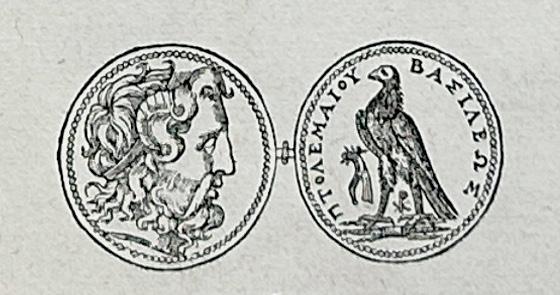
1153. Abraham Ortelius. Parergon sive Veteris Geographiae Aliquot Tabulae. (Antwerp, 1609). Folio (18x12”).
Calfskin with gilt lettering and armorial stamp on cover. 38 double-page engraved maps and plates. Bound with Nomenclator Ptolemaicus (Antwerp, 1603). Condition as in photos. See online listing for additional images. ($30,000)
From the Gerald F. Borrmann (Northern California Gentleman) Collection.
Parergon sive Veteris Geographiae Aliquot Tabulae by Abraham Ortelius, first published in 1595, this example in 1609, is a landmark atlas that showcases Renaissance-era cartography with a focus on classical history geography of the ancient world. This work is considered one of Ortelius’ most significant contributions, as it provides a comprehensive view of historical and mythical geography based on ancient sources. The 1609 edition is identified by the title page featuring classical figures holding globes, symbolizing the atlas’s focus on the geographical knowledge of antiquity.
The “Parergon” contains a series of maps and engravings that depict the ancient world, including maps based on the travels of famous figures like Homer, Virgil, St. Paul, Alexander the Great, and several biblical narratives. Some maps portray regions as they were understood in ancient times, such as the Roman Empire, Greece, Southern Asia, and Egypt. Others are dedicated to specific events or journeys from classical literature, including the wanderings of Aeneas and the voyages of Odysseus. Several pages include images of ancient coinage and imagery of significance to the study of classics. Ortelius meticulously compiled these maps using sources from classical geographers, historians, and scholars, including Ptolemy (circa 100–170 AD), Strabo (circa 64 BC–24 AD), Arrian (circa 86 – 160 AD), and Pliny the Elder (circa 23–79 AD) among others.
Abraham Ortelius (1527–1598) was a Flemish cartographer and geographer, widely celebrated as the creator of the first modern atlas, Theatrum Orbis Terrarum (Theater of the World), published in 1570. Born in Antwerp, Ortelius began his career as a map colorist and engraver before becoming a prominent map dealer. His contributions to mapping and atlases, what we refer to a modern geography, left a lasting impact on the history of cartography. His collaboration with many of the leading scholars of his time helped foster an expansive network of knowledge exchange throughout Europe and played a key role in laying the foundation for the age of enlightenment and discovery that would follow in the 17th and 18th centuries.
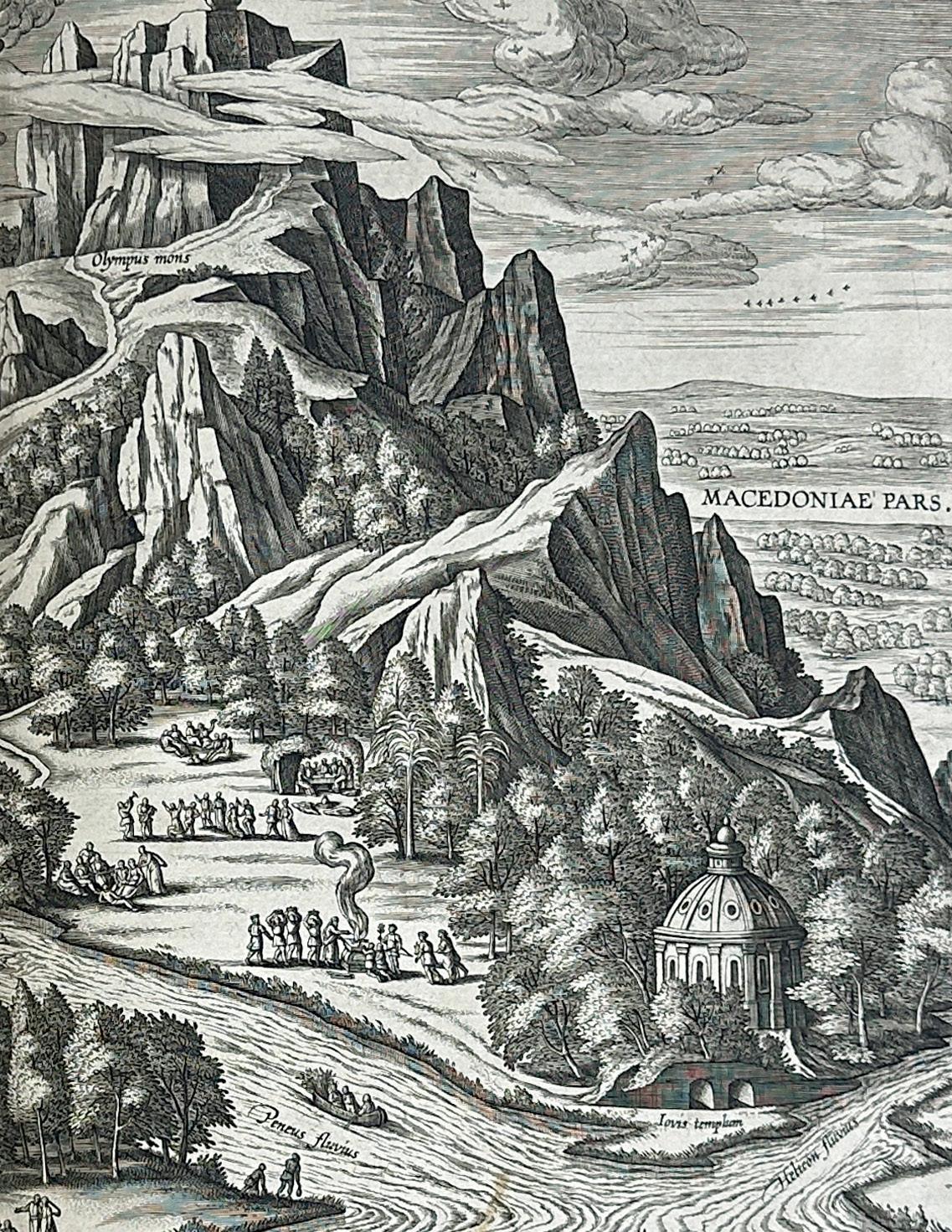
Detail of Lot 1153

Detail of Lot 1153

Detail of Lot 1153

1154. Ten (10) vellum leaves from the St. Albans Abbey Bible. (Paris, circa 1330). (294x199mm) Bound in a custom modern cover of soft yellow with the title “A Fragment of a French Bible MS c. 1300” gilt-stamped on the spine and front cover, and housed in a fitted black cloth slipcase. Each page containing 46 lines of Gothic script in double columns, with rich illuminations in blue, red, and gold leaf. Isaiah 58:8 to Isaiah 61:3. Condition as in photos. The manuscript shows typical agerelated undulation in the vellum, but remains well-preserved. See online listing for additional images. ($10,000)
From the Gerald F. Borrmann (Northern California Gentleman) Collection. Ex Mark Lansburgh Collection; Sotheby’s (6 July 1964), lot 239.
This lot presents a striking section of illuminated manuscript leaves from a 14th century Bible commissioned by Richard de Bury, noted author of the Philobiblon, and gifted to St. Albans Abbey by Michael Mentmore, who passed in 1349 due to the Black Death. Originally bound in a 16th-century St. Albans binding, the manuscript included flyleaves specifically related to St. Albans, suggesting a continued reverence and historical connection to the abbey. After being separated, the leaves resurfaced at a Sotheby’s auction in 1964, a testament to its enduring significance.
This exquisite work showcases a striking use of blue, pink, and gold borders, each enriched with forked stems that unfurl into intricate leaves in hues of gold, orange, and blue. The two-line initials are rendered in radiant colors against a burnished gold ground, while the headings feature a running line in blue or gold with elegant calligraphic flourishes. Each leaf measures 294 x 199 mm, with 46 lines of Gothic script arranged in double columns.
Notable features in the illustrations include rich ivy-leaf borders and figures carefully depicted within the initials. The style reflects the “Pucelle” Parisian school of illumination, noted for its delicate ivy-leaf borders, and the vibrant, nuanced palette of red, blue, and gold—a testament to the high quality of medieval Parisian craftsmanship.
One scene within the initial letters portrays a doctor in a blue robe tending to a crowned figure, perhaps symbolizing an important biblical event or a significant patron of the time. In another illustration, two scholars are depicted studying together, reflecting the monastic dedication to learning and preservation of knowledge.
Throughout the manuscript, lively marginalia animate the pages, featuring human figures in various playful or symbolic poses, which may represent social or moral commentary typical of the era. The borders themselves are alive with flourishes and filigree, framing the dense, meticulously scribed text with elegance.
End of Session 4
Banti
Please refer to our online bibliography at www.cngcoins.com for a complete listing of specialized and general references used, and abbreviations.
A. Banti. I grandi bronzi imperiali. 9 Vols. Florence. 1983-1986.
BMC Various authors. Catalogue of Greek Coins in the British Museum. 29 Vols. London. 1873-1927.
BMCRE
H. Mattingly et al. Coins of the Roman Empire in the British Museum 6 Vols. London. 1932-1962.
BN J. Giard. Bibliothèque Nationale, catalogue des monnaies de l’empire romain. 3 Vols. Paris. 1976-present.
Bodenstedt
Boehringer
F. Bodenstedt. Die Elektronmünzen von Phokaia und Mytilene. Tübingen. 1981.
E. Boehringer. Die Münzen von Syrakus. Berlin and Leipzig. 1929. Bopearachchi
O. Bopearachchi. Monnaies Gréco-Bactriennes et Indo-Grecques. Paris. 1991. Depeyrot
G. Depeyrot. Les monnaies d’or (Diocletian à Constantin I, Constantin II à Zenon). Wetteren. 1995-1996. Calicó
X. Calicó. The Roman avrei catalogue. 2 Vols. Barcelona. 2002.
CNS R. Calciati. Corpus Nummorum Siculorum: la monetazione di bronzo. 3 Vols. Italy. 1983-87. Crawford M. Crawford. Roman Republican Coinage. 2 Vols. Cambridge. 1974.
CRI
Fischer-Bossert
D. Sear. The History and Coinage of the Roman Imperators 49-27 BC. London. 1998.
W. Fischer-Bossert. Chronologie der Didrachmenprägung von Tarent 510-280 v.Chr. Berlin 1999. Flament
Hendin
HN Italy
C. Flament. Le monnayage en argent d’Athènes. De l’époque archaïque à l’époque hellénistique (c. 550-c. 40 av. J.-C.). Lovainla-Neuve. 2007.
D. Hendin. Guide to Biblical Coins. 6th Edition. New York. 2021.
N.K. Rutter, ed. Historia Numorum. Italy London. 2001.
Kumar S. Kumar. Treasures of the Gupta Empire. A Catalogue of Coins of the Gupta Dynasty. San Francisco. 2017.
Meshorer
Y. Meshorer. A Treasury of Jewish Coins from the Persian Period to Bar Kokhba. Jerusalem. 2001.
MK R. Göbl. Münzprägung des Kušanreiches. Vienna. 1984.
MIR R. Göbl, et al. Moneta Imperii Romani. 5 Vols. Vienna. 1984-present.
Price M.J. Price. The Coinage in the Name of Alexander the Great and Philip Arrhidaeus London. 1991.
Prieur
M. Prieur. A type corpus of the Syro-Phoenician tetradrachms and their fractions from 57 BC to AD 253. Lancaster. 2000.
RIC H. Mattingly, et al. The Roman Imperial Coinage. 10 Vols. London. 1923-1994.
RPC A. Burnett, et al. Roman Provincial Coinage 9 Vols. London and Paris. 1992-present.
RSC D. Sear, et al. Roman Silver Coins. 5 Vols. London. 1978-1987.
SC A. Houghton & C. Lorber. Seleucid Coins: A Comprehensive Catalog. 2 Parts. Lancaster. 2002 and 2008. Sellwood D. Sellwood. An Introduction to the Coinage of Parthia 2nd edition. London. 1980.
SNG ANS Sylloge Nummorum Graecorum, American Numismatic Society. New York. 1969-present.
SNG BM Black Sea Sylloge Nummorum Graecorum, British Museum, 1: The Black Sea. London. 1993.
SNG Copenhagen Sylloge Nummorum Graecorum, Danish National Museum. Copenhagen. 1942-1979.
SNG BN Sylloge Nummorum Graecorum, Cabinet des Médailles, Bibliothèque Nationale. Paris. 1993-2001.
SNG Kayhan Sylloge Nummorum Graecorum, Turkey 1: The Muharrem Kayhan Collection Istanbul. 2002.
SNG Levante Sylloge Nummorum Graecorum, Switzerland; E Levante - Cilicia. Bern. 1986.
SNG Lloyd Sylloge Nummorum Graecorum, Lloyd Collection. London. 1933-1937.
SNG Lockett Sylloge Nummorum Greacorum, Lockett Collection London. 1938-1949.
SNG München Sylloge Nummorum Graecorum, München Staatlische Münzsammlung. Berlin. 1968-present.
SNG von Aulock Sylloge Nummorum Graecorum, Sammlung Hans Von Aulock. Berlin. 1957-1968. Starr C. Starr. Athenian coinage 480-449 BC London. 1970.
Svoronos J. Svoronos.
Athens. 1904-08.
Traité E. Babelon. Traité des monnaies grecques et romaines. 9 Vols. Paris. 1901-1932.
Weidauer L. Weidauer. Probleme der frühen Elektronprägung. Fribourg. 1975.
Album S. Album. A Checklist of Popular Islamic Coins. 3rd ed. Santa Rosa. 2011. Biaggi E. Biaggi. Monete e zecche medievali italiane dal seculo VIII al seculo XV. Torino. 1992. Bitkin V. Bitkin. Composite Catalogue of Russian Coins. 2 vols. Kiev. 2003. BMC Vandals W. Wroth. Catalogue of the Coins of the Vandals, Ostrogoths and Lombards and of the Empires of Thessalonica, Nicaea and Trebizond in the British Museum. London. 1911. (Reprinted as Western and Provincial Byzantine Coins in the British Museum.)
CIS S. Goron and J.P. Goenka. The Coins of the Indian Sultanates. New Delhi. 2001. CNI Corpus Nummorum Italicorum. 20 Vols. Rome. 1910-1943. Davenport J.S. Davenport. Various works on European crowns.
ESC H.A. Seaby & P.A. Rayner. The English Silver Coinage from 1649. London. 1992. Friedberg R. Friedberg. Gold Coins of the World. 8th ed. Clifton. 2009.
KM C.L. Krause & C. Mishler. Standard Catalogue of World Coins Krause Publications. Iola. Levinson R.A. Levinson. The Early Dated Coins of Europe. Clifton, NJ. 2007. Lunardi G. Lunardi. Le monete delle repubblica di genova. Genoa. 1975.
MEC P. Grierson & M. Blackburn. Medieval European Coinage Cambridge. 1986.
MIB W. Hahn. Moneta Imperii Byzantini. 3 Vols. Vienna. 1973-81.
MIBE W. Hahn and M.A. Metlich. Money of the Incipient Byzantine Empire. Vienna. 2000.
MIR Various. Monete Italiane Regionali. 5 Vols. Pavia. ND.
NM G. Depeyrot. Le numéraire mérovingien. 5 vols. Wetteren. 1998-2001.
North J.J. North. English Hammered Coinage. 2 Vols. London. 1963, 1975.
SB D. Sear, et al. Byzantine Coins and Their Values. 2nd edition. London. 1987.
SCBC Standard Catalogue of British Coins. London. Annually.
SCBI Various authors. Sylloge of the Coins of the British Isles.


















